Fine Netsuke & Sagemono


AUCTION
Friday, 28 April 2023



Fine Netsuke & Sagemono Tel +43 1 532 04 52 Fax +20 E-mail office@zacke.at www.zacke.at AUCTION Friday, 28 April 2023, 1 pm CET CATALOG NE0423 EXHIBITION 24-27 April 10 am - 6 pm as well as by appointment 28 April 10 am - 1 pm GALERIE ZACKE Sterngasse 13 1010 VIENNA AUSTRIA
IMPORTANT INFORMATION
According to the general terms and conditions of business of Galerie Zacke Vienna, Founded 1968, SZA Versteigerungen & Vertriebs GmbH, 1010 Wien, online at www.zacke.at
ABSENTEE BIDDING
Absentee bids are carried out under the regulations of the terms of business of Galerie Zacke, SZA Versteigerungen & Vertriebs GmbH, which requires written submission of your purchase limit. Orders without purchase limits cannot be processed. Only the submitted lot number of the auction lot is binding for the processing of the absentee bid. The place of jurisdiction is Vienna, Austrian Law and Austrian jurisdiction are exclusively applicable for all legal questions arising from the business relationship. Absentee bids for this auction will be accepted until the day of auction by 10:00 a.m. We regret that absentee bids received after the time stated above will not be processed until after the auction.
PLEASE SEND ABSENTEE BIDS FOR THIS AUCTION TO:
Fax: +43 1 532 04 52 20 or

Email: office@zacke.at or
Mail: Galerie Zacke, Sterngasse 13, 1010 Wien, Austria, Europe
WE ACCEPT THE FOLLOWING METHODS OF PAYMENTS:
• Cash
• Certified or personal check
• Bank transfer (please inquire to receive our bank account information)
• Credit card (Visa, MasterCard, Amex)
TELEPHONE BIDDING
It is generally possible to bid by telephone during the auction. Please fill out the absentee bidding form enclosed in this catalog and include your telephone number at which you can be reached during the auction. In the “bid in euro” column please write “TEL” and then send us the completed absentee bidding form. Galerie Zacke will call you on the day of the auction, on the telephone number provided, 5 lots before the lot you are bidding on and the bidding will commence at the starting price, as stated in the catalog. If Galerie Zacke cannot reach you during the auction, Galerie Zacke will bid up to the estimate on your behalf.
ESTIMATES AND STARTING PRICES
The auction will begin with the starting price and written bids will be accepted only with a minimum amount equivalent to the starting price.
SHIPPING AND TRANSPORT INSURANCE
For domestic shipping Galerie Zacke (hereinafter called “the company”) charges in average Eur 15,- to Eur 50,- per item, depending on size and weight. These fees cover the costs of packing and shipping. Fees for bulky or fragile items, or international shipping will be quoted upon request.
The purchased goods are transported at the risk of the customer following handover of the packaged item to the post office or another carrier which the customer agrees to through his/her submission of the purchase order. According to the specific wish of the customer, the auctioned goods may be insured for the value of the purchase price (highest bid and all surcharges). This insurance fee is 3% of the purchase price. For any lots with a purchase prices exceeding EUR 350,- the transport insurance will be automatically arranged by the company if it does not expressively receive the purchaser’s written denial of this service and signed waiver of claims. Payments due to the company under the insurance contract will be charged to the customer. The company is also entitled to assign claims under the insurance contract to the customer providing the terms of the insurance contract do not prevent this.
In any case, the company is only required to make payment to the customer specifically if payment has effectively been received from the insurance company.
COLOR AND CONDITION
Auction lots will be exhibited for viewing prior to the auction, thus offering all interested customers the opportunity to examine the quality and condition of the works exhibited. The catalog illustrations are intended to assist customers during such preview. In illustrations, printed colors do not correspond exactly to the originals. The printed catalog images are not representative for the condition of the illustrated pieces. Hidden flaws and damages are indicated in the condition report. The illustrations in our online catalogs can be strongly magnified, so that most damages and restorations are well recognizable.
ENDANGERED SPECIES / CITES INFORMATION
Some items in this catalog may for example consist of ivory, rhinoceros-horn, tortoise shell, or some types of tropical wood, and are subject to the Convention on International Trade in Endangered Species of Wild Fauna and Flora [CITES]. Such items are marked with the symbol Ɏ on www.zacke.at and may only be exported outside the European Union after an export permit in accordance with CITES has been granted by the Austrian authorities. We would like to inform you that such licenses are typically not granted. For objects which have a low ivory content or have been proven beyond doubt to be in the EU before 1982, please contact our office for more information on how to obtain a CITES license.
COMPLAINTS
At its auctions, Galerie Zacke sells consigned lots on behalf of third-party consignors. For this reason, any complaints related to purchased lots must be in accordance with §32-48 of the general terms and conditions of business of Galerie Zacke, which can be found on www.zacke.at
IMPORTANT INFORMATION
Whenever making a bid, whether personally or via an agent, in writing, online, telephone, or in any other way, the bidder fully and unconditionally accepts the Terms of Auction, the ‘Important Information’ section in the auction catalog, the Terms and Conditions (AGB) of Galerie Zacke, §1-50, the Fee Tariff, and the Bidding Increments table, all as published on www.zacke.at on the day of the auction
THE ART LOSS REGISTER
All items starting above 2.000,- EUR have been checked by the Art Loss register.

PLEASE RAISE MY BID BY ONE BIDDING INCREMENT (ca. 10%) IF NECESSARY
IMPORTANT NOTICE:
Bids do not include buyer’s premium and VAT. Margin taxation applies. Items with added VAT are marked in the online catalog.
TELEPHONE BIDS:
ABSENTEE BIDDING FORM
FOR THE AUCTION Fine Netsuke & Sagemono NE0423
ON DATE 28 APRIL 2023, AT 1:00 PM CET
PLEASE CALL ME WHEN A HIGHER BID THAN MINE HAS BEEN RECEIVED
If you like to bid by telephone, please state ‘TEL’ in the ‘BID IN EURO’ column instead of a Euro amount. Galerie Zacke will call you on the day of the auction, on the telephone number provided, 5 lots before the lot you are bidding on and the bidding will commence at the starting price, as stated in the catalog. If Galerie Zacke cannot reach you during the auction, Galerie Zacke will bid up to the estimate on your behalf.
TERMS OF PAYMENT, SHIPPING AND COLLECTION:
NAME
With the signature on this form, the client instructs the auctioneer to bid on his behalf. The Euro amount up to which the auctioneer shall bid on behalf of the client is either stated in this form or will be communicated to the auctioneer via telephone during the auction. All absentee bidding shall be governed by the terms and conditions [AGB] of Galerie Zacke. The client agrees with his signature that he has read, understood and fully accepted the AGB of Galerie Zacke. Galerie Zacke, founded 1968, is a registered brand of SZA Versteigerungen & Vertriebs GmbH, Vienna, Austria.
CREDIT CARD PAYMENT
PLEASE CHECK THE DESIRED CARD
COLLECTION BY CLIENT WITH PAYMENT ON THE PREMISES IN CASH, BY CERTIFIED CHEQUE OR CREDIT CARD
INVOICE PAYMENT
VIA BANK WIRE AFTER RECEIPT OF INVOICE SHIPPING AFTER RECEIPT OF PAYMENT
EXPRESS PARCEL SERVICE
REQUIRED (ACCORDING TO TERMS AND CONDITIONS OF GALERIE ZACKE)
SHIPPING INSURANCE
REQUIRED (ACCORDING TO TERMS AND CONDITIONS OF GALERIE ZACKE)
GALERIE ZACKE Sterngasse 13, 1010 Vienna, Austria
Email: office@zacke.at
Tel: +43-1-532 04 52
Fax: +43-1-532 04 52 20
NAME
ADDRESS CARD NUMBER
EXPIRY DATE
IMPORTANT NOTICE:
Whenever making a bid, whether personally or via an agent, in writing, online, telephone, or in any other way, the bidder fully and unconditionally accepts the Terms of Auction, the ‘Important Information’ section in the auction catalog, the Terms and Conditions (AGB) of Galerie Zacke, §1-48, the Fee Tariff, and the Bidding Increments table, all as published on www.zacke.at on the day of the auction.
ADRESS CITY, COUNTRY POSTCODE PHONE NUMBER
EMAIL DATE & SIGNATURE
CODE
NR. LOT TITLE BID IN EURO
PHONE
SECURITY
LOT
MY
NUMBER
MASTERCARD VISA AMEX
ABSENTEE BIDDING FORM FOR THE AUCTION Fine Netsuke & Sagemono NE0423
ON DATE 28 APRIL 2023, AT 1:00 PM CET
Further images of all lots at www.zacke.at
BID IN
LOT NR. LOT TITLE
EURO
VISIT US IN VIENNA
AUCTION EXHIBITION

Open for Viewing 24-27 April 2023
Monday through Friday from 10 AM to 6 PM, as well as by appointment
Our gallery and auction showroom is located in the heart of Vienna’s First District and has been specially designed to provide a seamless auction and exhibition experience.

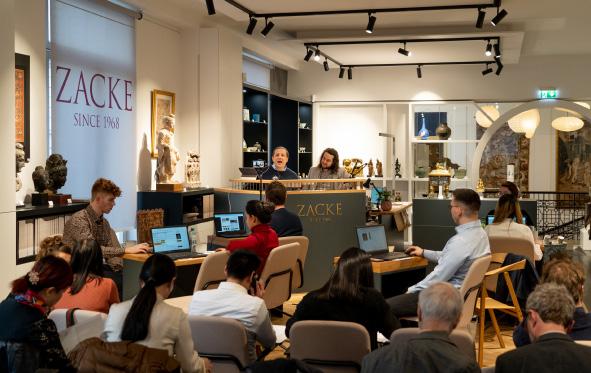
JOIN US LIVE
on 28 April 2023, at 1 PM CET in our auction room or bid online at Zacke Live with the advantage of our premium buyer’s terms without any additional online bidding fees. Registration required: www.zacke.at
How to Find Us
Our new address is Sterngasse 13, 1010 Vienna. We’re located in the heart of Vienna’s iconic first district, only a seven-minute walk away from the Stephansdom. Our new gallery is easily reachable by public transport or car.
SalztorgasseSalztorbrücke
Salzgries ObereDonaustr.
Wipplingerstr.Sterngasse
Marc-Aurel-Str.
HoherMarkt
Rotenturmstr.
Schwedenplatz
Stephansplatz
Bäckerstr.
Wollzeile
Schulerstr.
U1
U4 U1 U3
Graben
IVORY
Unsigned Japan, 17th-18th century, Edo period (1615-1868)
Published: Sagemonoya (2022) A Selection of Netsuke & Sagemono from the Collection of Georgina & Gabor Wilhelm, p. 45, no. 66.
Powerfully carved, facing ahead with open mouth, the tail curled beneath and the wings drawn into the sides for compactness, the large himotoshi through the mouth and the underside. The ivory bearing a rich, smooth, deep honey-brown patina.
LENGTH 7.3 cm
Condition: Good condition, appealingly worn, expected age cracks, minor losses and chips which have smoothened over time. The netsuke re-purposed as a small handle, likely over 100 years ago.
Provenance: The Gabor Wilhelm Collection, Paris.
Literature comparison: Compare three similar examples illustrated in Joly, Henri L. (1966) The W. L. Behrens Collection, Part 1, Netsuke, pl. XXVI, no. 1449 (in stag antler), and pl. XXVII, nos. 1524 and 1525 (in ivory).
AUCTION COMPARISON
Compare a closely related ivory netsuke of a dragon-fish, with similar sinuous body, expression, and scales, exhibiting less wear but otherwise near-identical, formerly in the Meinertzhagen and Winkworth collections, at Sotheby’s, The Carlo Monzino Collection of Netsuke, Inro and Lacquer, 21 June 1995, London, no. 148 (sold for 43,300 GBP).

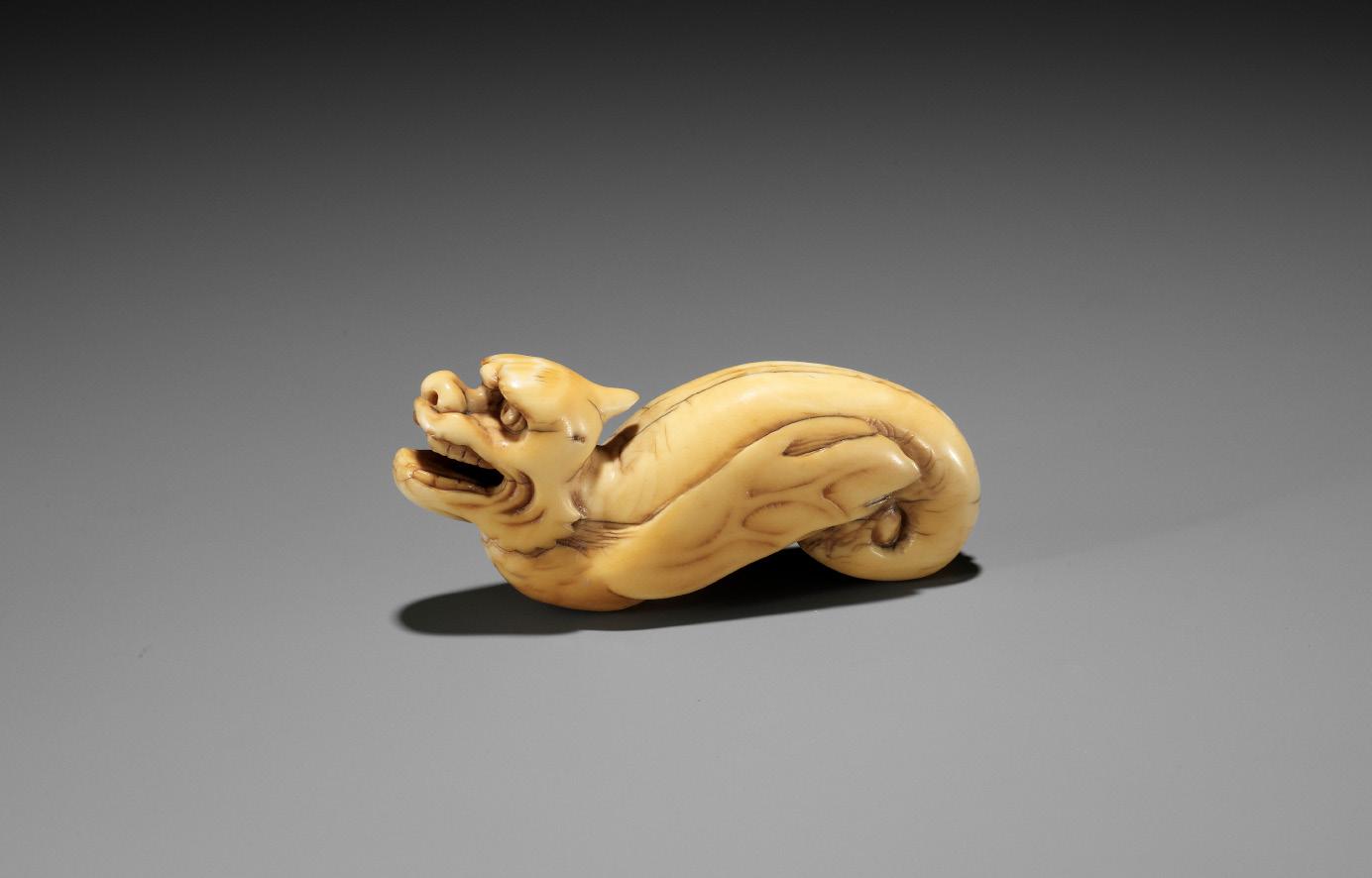

Estimate EUR 4,000
Starting price EUR 2,000
6
1 A RARE
NETSUKE OF A WINGED DRAGON-FISH (MAKATSUGYO)
A LARGE AND RARE IVORY TOBORI NETSUKE OF A MYTHICAL BEAST
Unsigned Japan, 17th century, Edo period (1615-1868)
Published: Sagemonoya (2022) A Selection of Netsuke & Sagemono from the Collection of Georgina & Gabor Wilhelm, p. 44, no. 64.
Boldly carved as a one-horned mythical beast standing foursquare atop a shaped base, its long tail furcated in neatly incised scrolling strands with one swept up to its side, the feet with further ‘winged swirls’, its mane and beard boldly carved with further curls. The ivory bearing a superb, deep honey-brown patina.
HEIGHT 6.5 cm
Condition: Good condition, appealingly worn, expected age cracks, many losses and chips, most which have smoothened over time. Provenance: The Gabor Wilhelm Collection, Paris.
While Gabor Wilhelm suggests the mythical being can be identified as a kaichi (xiezhi), a divine beast from Chinese mythology which symbolizes justice and fairness, the mythical creature is rather difficult to positively identify as it also shares characteristics with a kirin and a luduan.
These type of tobori (Chinese carvings) belong to earliest type of netsuke known. They were either carved in China and re-purposed as netsuke in Japan or carved in Japan using Chinese source materials.
AUCTION COMPARISON
Compare a Chinese ivory seal with a mythical beast finial at Bonhams, 21 December 2011, San Francisco, lot 8549 (sold for 6,875 USD). Compare an ivory seal netsuke of a hakutaku at Bonhams, 15 May 2014, London, lot 14 (sold for 7,500 GBP).
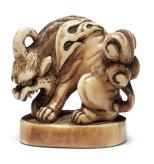
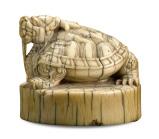


Estimate EUR 3,000
Starting price EUR 1,500
7 2
A RARE IVORY NETSUKE OF AN ACTOR IN THE ROLE OF THE FOX PRIEST (HAKUZOSU)
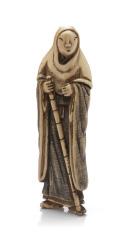
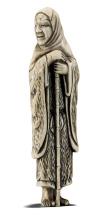

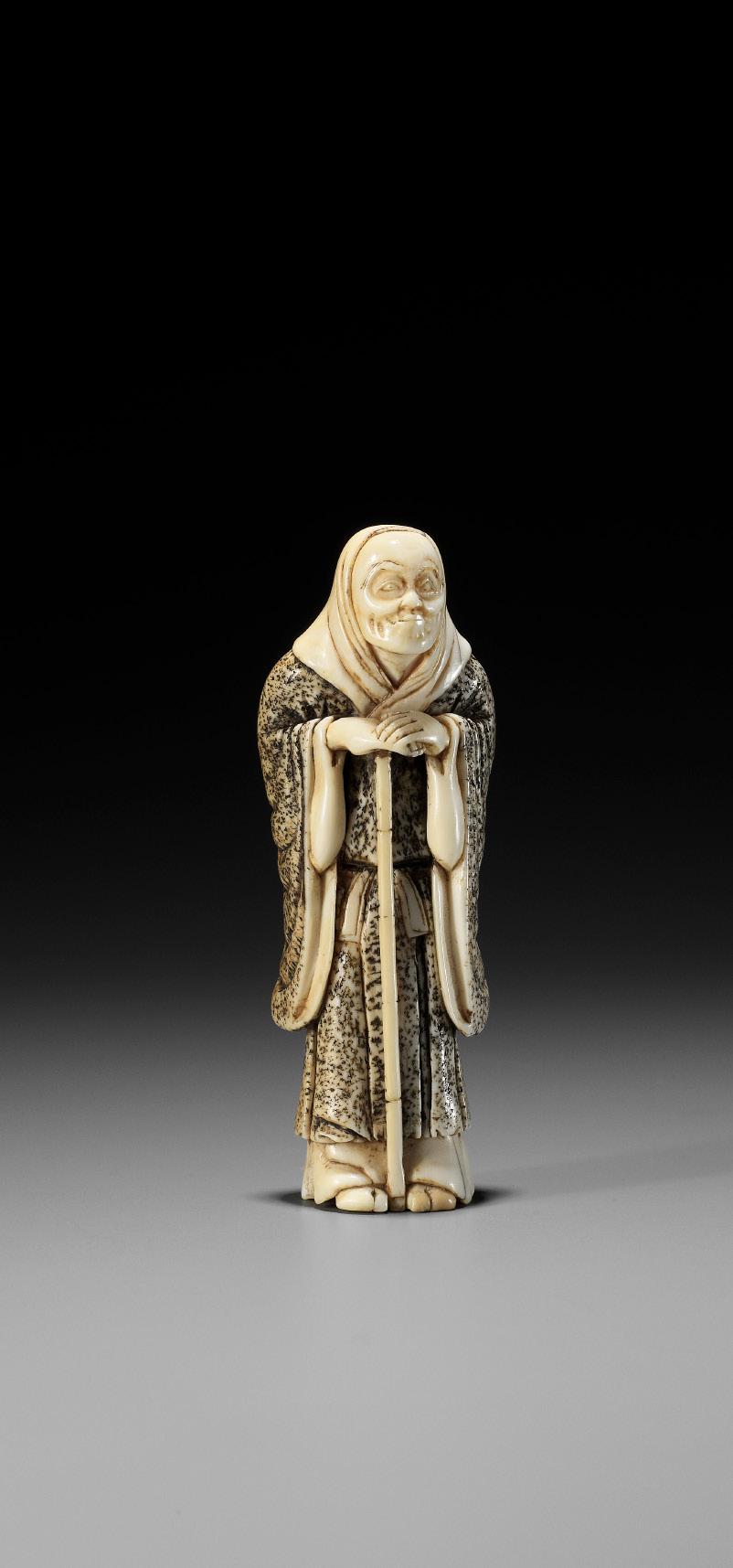
Unsigned Japan, 18th century, Edo period (1615-1868)
Published: Sagemonoya (2022) A Selection of Netsuke & Sagemono from the Collection of Georgina & Gabor Wilhelm, p. 76, no. 123
Finely carved to depict an actor in the role of Hakuzosu wearing a mask of an old man. He is almost entirely clothed in a smooth hood and stippled robe with wide sleeves and well-carved folds, with only the face, the hands leaning on the cane, and the feet wearing tabi (socks) visible. The underside and back with chimney himotoshi. The ivory bearing a fine patina.
HEIGHT 9.6 cm
Condition: Very good condition, appealingly worn, expected age cracks, the lower edge of the robe with a smoothened chip.
Provenance: The Gabor Wilhelm Collection, Paris.
Hakuzosu is the name of a popular kitsune character who shapeshifted into a priest in the Kyogen play Tsurigitsune (lit. ‘fox catching’). Kitsune (foxes) are creatures imbued with magical powers and are known to have the ability of shapeshifting. They are also believed to be animated by the devils.
LITERATURE COMPARISON
Compare a closely related ivory netsuke illustrated in Yoshida, Yukari / Kurstin, Joseph (Winter 1997) Tidbits & Answers, International Netsuke Society Journal, Vol. 17, No. 4, p. 11.
MUSEUM COMPARISON
Compare a related ivory netsuke of a fox priest, dated 18th century, formerly in the collection of Raymond Bushell and now in the Los Angeles County Museum of Art, accession number AC1998.221.5.
AUCTION COMPARISON
Compare a closely related ivory netsuke, 9.4 cm high, also dated 18th century, at Galerie Zacke, Fine Netsuke & Sagemono, 25 September 2020, Vienna, lot 11 (sold for 6,320 EUR).
Estimate EUR 5,000
Starting price EUR 2,400
8 3
A GOOD IVORY NETSUKE OF A DANCING KITSUNE
Unsigned Japan, 18th century, Edo period (1615-1868)
Published: Sagemonoya (2022), The Gabor and Georgina Wilhelm Collection, p. 77, no. 125.
Carved as a kitsune (fox), raising its forepaws dynamically in a dancing posture, the tail turned upwards, the mouth slightly opened showing teeth and tongue and smiling enigmatically. Excellent, generously excavated himotoshi to the back. The ivory bearing a stunning, deep-yellow patina.
HEIGHT 6.3 cm
Condition: Good condition. Some old, smoothed-out, nondistracting chips. Several natural age cracks and general wear. Provenance: The Gabor Wilhelm Collection, Paris.
AUCTION COMPARISON
Compare to a related ivory netsuke of dancing kitsune sold at Zacke, Fine Netsuke & Sagemono, 4 November 2022, Vienna, lot 220 (sold for 4,420 EUR).
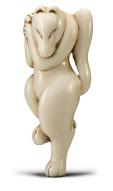


Estimate EUR 4,000
Starting price EUR 2,000
9 4
A RARE MARINE TOOTH NETSUKE OF KIYOHIME


Unsigned Japan, 18th century, Edo period (1615-1868)
The serpentine, wrathful monster Kiyohime tightly wrapped around the Dojo-ji bell, her snake-like tail encircling the top and her body surmounting the bell, the face with an enigmatic smile, holding a striker and a loose strand of her long, finely incised hair. Very large himotoshi through the side of the bell. The marine tooth bearing a beautiful lustrous polish.
HEIGHT 6 cm
Condition: Very good condition, some natural age cracks and few inlaid nerve channel plugs.
In this tragic story, Kyohime fell in love with a Buddhist monk named Anchin but was rejected. In despair she pursues the monk and transforms herself into a Hannya-like demon with a snake body and horned head. The pursued Anchin hides under a temple bell. When she discovers him there, she wraps her snake body around the bell and the glow of her passion melts the metal and burns the monk hiding in the bell.
Estimate EUR 2,000
Starting price EUR 1,000
10 5
6
ISSAI: A RARE NARWHAL TUSK NETSUKE OF KADORI MYOJIN TAMING THE NAMAZU

 By Ogawasara Issai, signed Issai 一齋 Japan, Wakayama, 18th century, Edo period (1615-1868)
By Ogawasara Issai, signed Issai 一齋 Japan, Wakayama, 18th century, Edo period (1615-1868)
Superbly carved from a circular cross-section of a narwhal tusk as Kadori Myojin, clad in a fundoshi, placing his gigantic hyotan (double gourd) on a namazu, trying to tame the mythical catfish. The namazu’s eyes are inlays black wood. The typical outer bark-like rind is visible on the edges of the netsuke and the other side shows the typical beautiful marbling and striations of this coveted material. Himotoshi through the underside and inside of the namazu and signed underneath ISSAI.
LENGTH 4.6 cm
Condition: The right arm restored. Some tiny repairs and losses to exposed areas. Otherwise, fine condition with minor wear and few natural age cracks.
Provenance: From the collection of the German conductor Ferdinand Leitner (1912–1996), purchased from Kunsthaus Lempertz, Cologne, in 1972 (copy of the original invoice available).
Leitner studied under Franz Schreker, Julius Prüwer, Artur Schnabel and Karl Muck. Among his more than 300 recordings is a celebrated recording of Ferruccio Busoni’s Doktor Faust. He also conducted the Berlin Philharmonic for Wilhelm Kempff’s 1961 cycle of Beethoven’s piano concertos.

Ogawasara Issai, mentioned in the Soken Kisho of 1781, was said to be one of the most famous carvers of his time, his work much in demand and difficult to obtain even during his lifetime. His works are rarely signed and he excelled in the use of marine and narwhal tusk.
Legend has it that certain types of catfish (namazu) are responsible for the earthquakes that plague the islands of Japan. When aroused, these creatures would contort their bodies in such a way that gigantic tremors shook the area for miles and miles. The Shinto deity Kadori Myojin usually attempts to prevent such catastrophes with the help of his magic gourd.
Estimate EUR 2,500
Starting price EUR 1,200
11
The German conductor Ferdinand Leitner (1912-1996) rehearsing with the Bamberg Symphony orchestra
7 A VERY RARE IVORY NETSUKE OF A MERMAN
Unsigned Japan, 18th century, Edo period (1615-1868)
Finely carved as a merman, half man and half fish, depicted in motion, swimming through water, one hand touching his tail fin, which curls underneath and is held close to the body for compactness, and the other hand holding a branch of coral before him. The scales are meticulously rendered, formed by large, connected half-circles and the long hair, which flows down the shoulders and arms, is neatly incised. Natural himotoshi between the arm and body. The ivory bearing a beautifully lustrous patina, the details are stained with sumi (ink).
LENGTH 5.3 cm
Condition: Very good condition with minor wear, few natural age cracks and natural imperfections.
LITERATURE COMPARISON
Compare to a closely related wood netsuke of a mermaid with tama, exBehrens collection, illustrated in Barry Davies Oriental Art (2002) Netsuke and Inro from European Collections, no. 137.
AUCTION COMPARISON
Compare to a closely related wood netsuke of a merman with tama, at Bonhams, The Harriet Szechenyi Sale of Japanese Art, 8 November 2011, London, lot 62 (sold for 4,375 GBP).

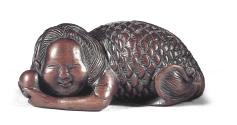

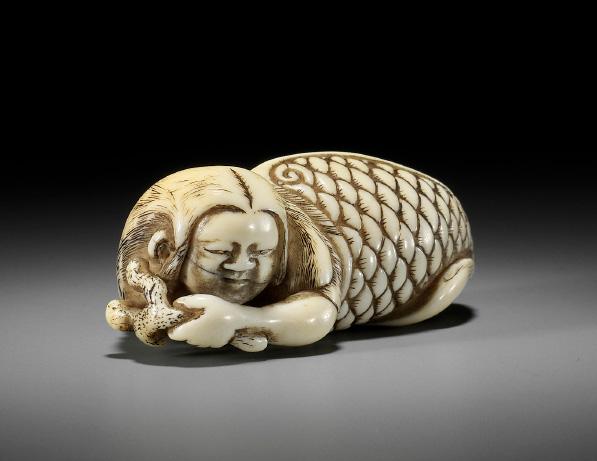

Estimate EUR 4,000
Starting price EUR 2,000
12
AN EARLY WOOD NETSUKE OF MERMAID (NINGYO) BLACKENING HER TEETH (OHAGURO)


Unsigned Japan, 18th century, Edo period (1615-1868)
A rather unusual netsuke carved as mermaid with plump cheeks and bawdy open-mouthed smile appearing like the Shinto goddess Okame, boldly carved with her scaly body curled to one side as she paints her teeth with a small brush. Her cheerful face with narrowed eyes, a wide nose, plump cheeks, and full lips is very finely carved while the rest of the composition has an appealingly rustic appearance. Her braided hair is elegantly flowing along her back, the underside with her breasts and the very large himotoshi. The wood with a fine, smooth patina.
LENGTH 6.4 cm
Condition: Very good condition, appealingly worn, few tiny nicks. Provenance: Ex-collection Teddy Hahn, Darmstadt, sold at Bonhams, 8 November 2018, London, lot 31. A noted private collection, USA, acquired from the above.
Ohaguro (lit. ‘black teeth’) is the name given in Japan to the custom of blackening one’s teeth with a solution of iron filings and vinegar. It was especially popular between the Heian and Edo periods, from the 10th century until the late 19th century, but the opening of the country to Western customs during the Meiji period led to its gradual disappearance. It was a tradition practiced mainly by married women and some men, almost always members of the aristocracy and samurai. In addition to Japanese society’s preference for black teeth, it was also considered beneficial to health, as it prevented tooth decay by acting as a dental sealant.
AUCTION COMPARISON
Compare a related wood netsuke of Okame as a mermaid by Shugetsu, also from the Teddy Hahn collection, at Zacke, Fine Netsuke & Sagemono, 29 October 2021, Vienna, lot 167 (sold for 6,067 EUR).

Estimate EUR 3,000
Starting price EUR 1,500
13
8
9 AN EARLY WOOD NETSUKE OF A SNAKE



AND FROG
Unsigned Japan, late 18th century, Edo period (1615-1868)
Boldly carved as a snake consuming a helpless frog, one of its limbs caught in the serpent’s mouth, the snake’s body coiled in three layers, intricately carved with extensive openwork forming natural himotoshi, the nicely worn wood of an attractive color, with a warm, smooth patina.
LENGTH 4.4 cm
Condition: Very good condition, appealingly worn.
The netsuke depicts the sansukumi motif, meaning ‘mutual control’. The snake will consume the frog, however there is a catch – the frog has already eaten a poisonous snail, so too the snake must perish.
LITERATURE COMPARISON
Compare to a closely related wood netsuke of a snake with frog in Barry Davies Oriental Art, Netsuke from the Teddy Hahn Collection, London, 1996, pp. 80-81, no. 110.
AUCTION COMPARISON
Compare to a closely related wood netsuke of a snake with frog at Zacke, Fine Netsuke, Sagemono & Okimono, 2 November 2019, Vienna, lot 115 (sold for 4,550 EUR).
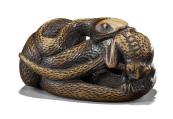
Estimate EUR 2,000 Starting price EUR 1,000
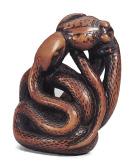
14
10 AN EARLY WOOD NETSUKE DEPICTING ONIWAKAMARU BATTLING THE


Well carved to depict the young Benkei standing over the huge carp, grabbing it by the gills and standing on its fins, wearing only a loincloth, his muscular body boldly carved and eyes inlaid, the fish detailed with round eyes and large scales, the underside with two himotoshi, one of which is surrounded by a neatly incised whirl.
LENGTH 4.5 cm
Saito
Oniwakamaru on a Carp, Tsukioka

Yoshitoshi (1839-1892), LACMA accession no.
M.84.31.43
Condition: Very good condition, attractively worn, one minor age crack, few tiny nicks. Superb, smooth patina with a nice feel. Provenance: A noted private collection, USA.The back of one of Kintaro’s legs with an old label with a typewritten inscription, ‘II7’. Oniwakamaru or ‘young devil child’ was the nickname given to the young warrior monk Musashibo Benkei (1155-1189) because of his enormous strength and violent nature. This netsuke shows the young boy attacking and slaying the giant red carp that swallowed his mother.
Estimate EUR 2,000
Starting price EUR 1,000
15
GIANT CARP
Unsigned Japan, 18th century, Edo period (1615-1868)
GYOKUSEN: A SUPERB WOOD NETSUKE OF TWO AMOROUS SKELETONS

 By Gyokusen, signed Gyokusen 玉仙 Japan, 18th to early 19th century, Edo period (1615-1868)
By Gyokusen, signed Gyokusen 玉仙 Japan, 18th to early 19th century, Edo period (1615-1868)
Intricately carved as two skeletons in a final loving embrace, one seated on the other’s lap, wrapping the legs around their lover’s lower back, the skulls cheek to cheek with the mouths connected in a kiss, further detailed with deep eye and ear sockets, superbly incised and finely stained ribs, and curved spines. Several natural himotoshi due to the openwork. Signed to the soles of the kneeling figure’s feet GYOKUSEN.

HEIGHT 5.1 cm
Condition: Good condition, minor wear, one leg with an old restoration.
Provenance: Ex-collection Joe Kurstin. Dr. M. Joseph ‘Joe’ Kurstin (1931-2021) was a prominent Miami ophthalmologist who arguably built one of the greatest netsuke collections of all time. He was known by netsuke and inro lovers worldwide and made many lifelong friends in this tight-knit community. He published several books and articles on the subject and generously lent his collection for exhibitions at the Yale University Gallery, Museum of Fine Arts, Boston, Epcot Center at Disney World, and The Tobacco and Salt Museum, Tokyo.
While similar examples exist of skeletons interacting with each other, the position of the present two skeletons appears to be unique. Furthermore, similar examples are usually quite rough, while the present carving is exceptionally fine with superb detailing to the rib cages.
LITERATURE COMPARISON
Compare a related wood netsuke of two skeletons in an embrace, dated 18th century, formerly in the collection of Albert Brockhaus (Index no. 2096, purchased in 1912), at Kunsthandel Klefisch, 12 September 1992, Cologne, lot 302.
Estimate EUR 5,000
Starting price EUR 2,400

16 11
Elena and Joseph Kurstin
AN UNUSUAL TALL WOOD NETSUKE OF MYTHICAL CREATURE
Unsigned
Japan, 18th century, Edo period (1615-1868)
A somewhat grotesque wood netsuke of a long-limbed kappa-like monkey, its entire body covered in fur, using one of its long arms to cover its crotch, the other reaching over its shoulder. The creature’s enigmatic express is enhanced by the large glaring eyes inlaid with pale horn rings. One large himotoshi through the back, the other opening in-between the legs.
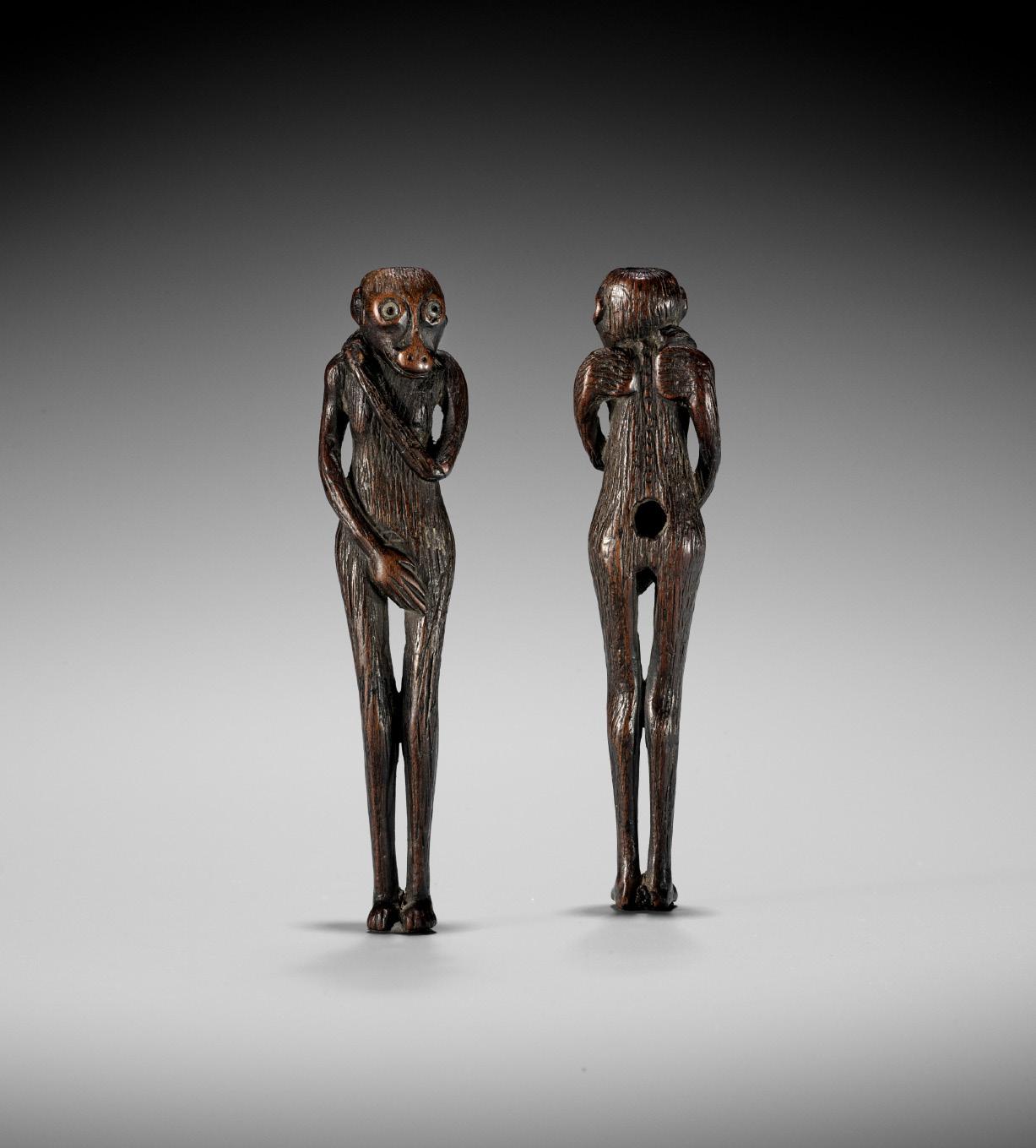
HEIGHT 10 cm
Condition: Some old damages with associated old repairs.
The creature depicted in this netsuke is highly unusual. Though it appears to be closest to a monkey imitating Ashinaga and Tenaga, the recessed area on the cranium indicates a kappa.
Estimate EUR 2,000
Starting price EUR 1,000
17 12
A SUPERB WOOD NETSUKE OF SHOKI AND ONI
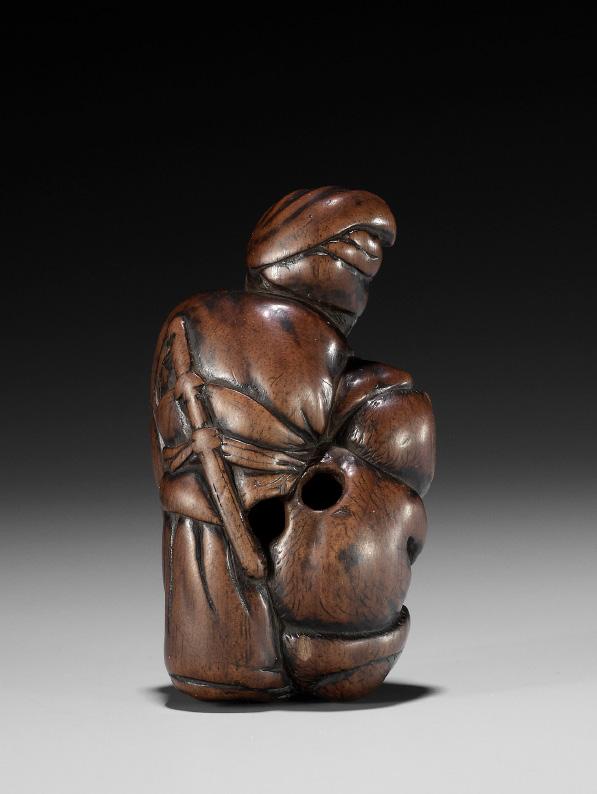

Unsigned Japan, early 18th century, Edo period (1615-1868)
A remarkably rustic and boldly executed carving, depicting what appears to be the demon queller Shoki, shown here in a very unusual manner, wearing a turban-like cap, his expression one of satisfaction as he stands next to a large grimacing oni which is clutching Shoki’s long sleeve, the demon queller’s sword still sheathed and tied to his back. The back with two generously excavated himotoshi. A highly unusual netsuke of striking and original design, bearing a superb aji.
HEIGHT 6.6 cm

Condition: Good condition, appealingly worn, few minor age cracks, tiny nicks here and there, one tiny chip near the himotoshi.
Provenance: Ex-collection Teddy Hahn, Darmstadt. Theodor “Teddy” Hahn was a wellknown and respected collector of netsuke and other Asian works of art. After spending time in museums to study the early cultures of the world, finding particular interest in their sculptures, he began collecting, remarking, “I somehow knew it would have a profound influence on my life. How right I was. And how happy I have been.” Teddy Hahn was a passionate collector of snail netsuke, arguably building the greatest collection of snail netsuke ever assembled.
Estimate EUR 6,000
Starting price EUR 3,000
18 13
Teddy Hahn (1933-2012)

AN EXCEPTIONAL AND RARE WOOD NETSUKE OF RYO TOHIN TAUNTING A DRAGON
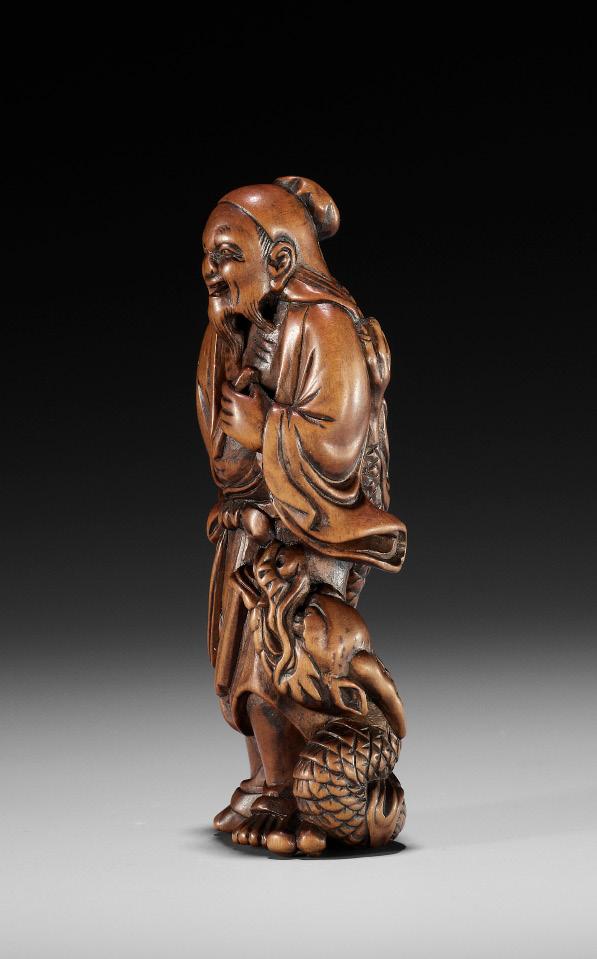

Unsigned Japan, 18th century, Edo period (1615-1868)
Finely carved with the immortal standing with one hand held behind his back, the other holding the tip of a ken sword. He is wearing long flowing robes with skillfully carved and darkly stained folds, opening in front to reveal his ribs and belly. His well-carved face with a cheerful expression as he laughs at the two-horned three-clawed dragon sinuously writhing around his body, looking up toward the sword tip. The back with asymmetrical himotoshi.
HEIGHT 8.7 cm
Condition: Very good condition, appealingly worn, one foot with old restoration to the toes.
Provenance: Ex-collection Joe Kurstin. Dr.

M. Joseph ‘Joe’ Kurstin (1931-2021) was a prominent Miami ophthalmologist who arguably built one of the greatest netsuke collections of all time. He was known by netsuke and inro lovers worldwide and made many lifelong friends in this tight-knit community. He published several books and articles on the subject and generously lent his collection for Elena and Joseph Kurstin
exhibitions at the Yale University Gallery, Museum of Fine Arts, Boston, Epcot Center at Disney World, and The Tobacco and Salt Museum, Tokyo.
Ryo Tohin is the Japanese name for the Daoist immortal Lü Dongbin, one of the Eight Immortals in Chinese mythology. He is often pictured riding on a cloud or a dragon as a reference to the legend that Ryo Tohin used his famous sword to subdue a dragon. He is also frequently depicted crossing water on his sword. The present netsuke depicts him holding the tip of a ken sword, which relates to depictions of male dragons with tail tips in the form of swords or spears. It thus appears that the immortal has stolen the tip of the dragon’s tail and is now taunting the beast with it. It is also interesting to note that the immortal’s right hand is not seen, shrouded in his robe behind his back, and perhaps he is also hiding a tama pearl from the poor dragon.
LITERATURE COMPARISON
Compare a painted wood netsuke by Shuzan, depicting the same subject, described as “a warrior holding a gem in the left hand, a sword in the right, defying a dragon”, illustrated in Joly, Henri L. (1966) The W. L. Behrens Collection, Part 1, Netsuke, pl. XIII, no. 675.

Estimate EUR 25,000
Starting price EUR 12,000
20 14

A GOOD WOOD NETSUKE OF SHOKI


Unsigned Japan, 18th century, Edo period (1615-1868)
The demon queller raising one foot and unsheathing his sword, striking a powerful stance, his face with a grim expression framed by wild, flowing hair and beard, the eyes inlaid in bone with black pupils. One can only fear for the oni that Shoki has spotted, although in netsuke art it is usually Shoki who draws the short straw. Shoki’s windswept robe with long upwards flaring sleeves is particularly well carved. Large himotoshi to the back, the wood bearing a fine patina.
HEIGHT 8.2 cm
Condition: Very good condition with minor wear and few traces of use.
Estimate EUR 4,000
Starting price EUR 2,000
22 15
A FINE WOOD NETSUKE OF TOBOSAKU SENNIN
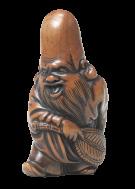

Unsigned Japan, 18th century, Edo period (1615-1868)
Tobosaku (Dongfang Shuo) standing on one leg, the other dynamically raised, holding a leafy peach branch in one hand, wearing a loosely-fitted and elaborately flowing robe, his expression superbly carved. The wood bearing a superb patina. Very large himotoshi through the back. The carving is stylistically reminiscent of the celebrated Osaka artist Tsuji.
HEIGHT 6.7 cm
Condition: Very good condition with minor surface wear and fine, dark patina.
AUCTION COMPARISON
Compare to a wood netsuke of Fukurokuju, by Tsuji, at Bonhams, Fine Netsuke from a French Private Collection, 4 November 2020, London, lot 23 (sold for 18,812 GBP).
Estimate EUR 3,000
Starting price EUR 1,500
16

A SUPERB TALL WOOD NETSUKE OF SEIOBO



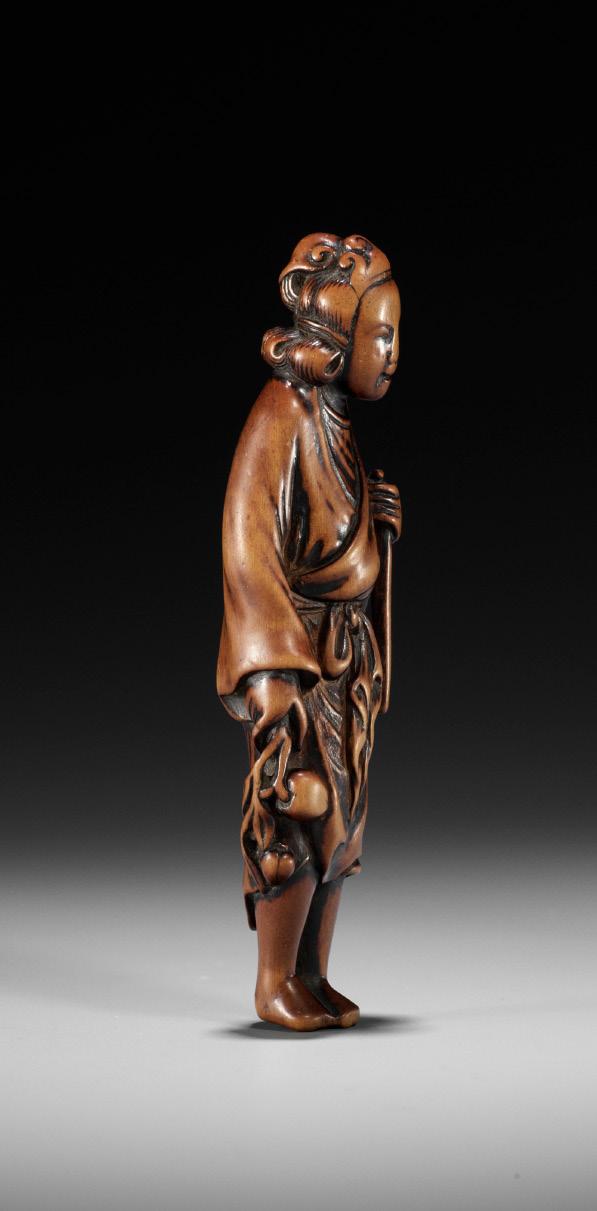
Unsigned Japan, 18th century, Edo period (1615-1868)
The Queen Mother of the West standing and holding a peach branch and a scythe, her expression gracious and benevolent, wearing an ornate headdress, her finely carved, tied hair forming curls in the back. Her loosely fitted robe is finely carved and tied at the waist, with downward flowing bands in the front and with long, draping sleeves, one of which forms one himotoshi, the other large cord hole in the back. The wood bearing a beautiful, dark patina.
HEIGHT 9.9 cm
Condition: Very good condition, minor typical wear to exposed areas. Beautiful patina.
Provenance: A noted private collection, USA, purchased from Bonhams, Netsuke from a European Private Collection, 8 May 2016, London, lot 146.
AUCTION COMPARISON
Compare to a related wood netsuke of Seiobo, by Hasegawa Ikko, dated to the early 19th century, at Zacke, Fine Netsuke & Sagemono, 16 April 2021, Vienna, lot 173 (sold for 9,150 EUR). Another related wood netsuke of Seiobo was sold at Bonhams, Fine Netsuke from a French Private Collection, 4 November 2020, London, lot 19 (sold for 7,312 GBP).
Estimate EUR 6,000
Starting price EUR 3,000
25 17

A MASTERFUL AND VERY RARE LACQUERED WOOD NETSUKE OF IZUMO NO OKUNI


Unsigned Japan, 18th century, Edo period (1615-1868)
Published:

Stern, Harold P. (1972) The Magnificent Three: Lacquer, Netsuke, and Tsuba; Selections from the Collection of Charles A. Greenfield, New York, Japan Society, no.13 (unillustrated).

Kurstin, Joseph & Lorin, Gilles (2006) The Peacock’s Feather, Gentlemen’s Jewelry of Old Japan, no. 9. Yoshida, Yukari & Kurstin, Joseph, Questions & Answers (2007) International Netsuke Society Journal (INSJ) vol.27, no.1, p.12, fig.3.
Exhibited:
Japan House Gallery, New York, 1972.
Morikami Museum and Japanese Gardens, Delray Beach, Florida, January 10-March 18, 2007.
Izumo no Okuni, the foundress of the kabuki theatre, depicted here dancing elegantly, one hand touching her head and the other holding a fan, an eboshi placed in a peculiar position on her head, a long katana and a set of shide (Shinto ritual paper streamers) thrust in her obi (sash), visible in the back. Her expression is carved sensitively, signifying her beauty which she was famous for, and her kimono is adorned with various mon-roundels and neatly engraved patterns. The well-toned wood is superbly polished and lacquered in gold, the surface beautifully worn with a dark, warm patina. Asymmetrical himotoshi through the back, above and below the katana.
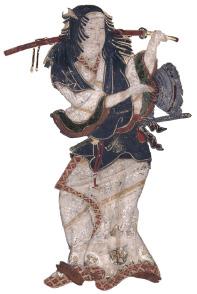
HEIGHT 8.2 cm
Condition: Very good condition, the gold lacquer beautifully worn. Provenance: Ex-collection T. Tsuruoka and Charles A. Greenfield. Ex-collection Joe Kurstin. Dr. M. Joseph ‘Joe’ Kurstin (1931-2021) was a prominent Miami ophthalmologist who arguably built one of the greatest netsuke collections of all time. He was known by netsuke and inro lovers worldwide and made many lifelong friends in this tight-knit community. He published several books and articles on the subject and generously lent his collection for exhibitions at the Yale University Gallery, Museum of Fine Arts, Boston, Epcot Center at Disney World, and The Tobacco and Salt Museum, Tokyo.
As Joe Kurstin writes in INSJ vol. 27, no. 1, the subject was identified by Yukari Yoshida. Izumo no Okuni (15721610) is credited as being the foundress of the kabuki theatre. She was a shrine virgin (miko) of Izumo Taisha Shrine and was well known for her skills in dancing and acting, as well as for her great beauty. It was the custom of the time to send priests and miko out to solicit contributions for the shrine and thus she was sent to Kyoto to perform sacred dances and songs. Her original and exotic style of dance, known for its sultriness and sexual innuendo, became hugely popular and was labeled Kabuki, which derived from a 16th century colloquial expression, She is thought to have begun performing her new art style of kabuki theatre in the dry riverbed of the Kamo River in Kyoto. Okuni’s troupe quickly gained immense popularity, and were known for their performers, who were often lower-class women Okuni had recruited to act in her all-female theatre group.
Estimate EUR 15,000
Starting price EUR 8,000
27 18
Izumo no Okuni, excerpt from a Byobu screen, 17th century, Kyoto National Museum
Elena and Joseph Kurstin
A POWERFUL TALL IVORY NETSUKE OF A TARTAR ARCHER


Unsigned Japan, 18th century, Edo period (1615-1868)
Published: Sagemonoya (2022), The Gabor and Georgina Wilhelm Collection, p. 10, no. 5.
The Mongolian archer standing tall, wearing a typical conical hat, his robes engraved with ornate cloud and wave designs, his mouth agape as he faces to the left, drawing his bow and preparing to shoot his readied arrow. The reverse shows the finely carved quiver with further elaborate designs and the large and generously excavated himotoshi. Superb, deep honey patina.
HEIGHT 9.2 cm
Condition: Restoration to one foot. Few natural age cracks and minor wear to sumi-stained details. Overall good condition.
Provenance: The Gabor Wilhelm Collection, Paris.
AUCTION COMPARISON
Compare with a closely related ivory netsuke at Bonhams, Fine Japanese Art, 12 May 2016, lot 245 (part lot, sold for 4,375 GBP).

Estimate EUR 5,000
Starting price EUR 2,400
28 19
AN UNUSUAL WOOD NETSUKE DEPICTING KINKO SENNIN WITH A BRUSH AND FISH

Unsigned Japan, late 18th to early 19th century, Edo period (1615-1868)
The immortal Qin Gao standing and holding a fish with horninlaid eyes and an inlaid brush in his hands, his elegant Chinese robes flowing with finely carved and darkly stained folds, his expressively carved face with a cheerful expression, the mouth wide open, his hair and long chin beard neatly incised, the back with two asymmetrical himotoshi, the larger of which is generously excavated to accommodate the knot.

Condition: Excellent condition with minor wear.
The present netsuke is unusual as Kinko Sennin is usually depicted seated atop a giant fish. The Daoist sage spent the first 200 years of his life painting fish and would never harm or eat them out of respect. He was invited by the Dragon King to be his guest, so Kinko told his students he would return and rode the fish under the water into the river kingdom. Upon returning he meet Kannon, who gave him a scroll teaching the Buddhist way of protecting all life.

Estimate EUR 3,000
Starting price EUR 1,500
29 20
HEIGHT 8.1 cm
Kinko Sennin reading a scroll, Sesson Shukei, 16th century
21
A SUPERB IVORY NETSUKE OF A FISHERMAN CARRYING A BOY, ATTRIBUTED TO GECHU



Attributed to Gechu, unsigned Japan, 18th century, Edo period (1615-1868)
Published: Sagemonoya (2022) A Selection of Netsuke & Sagemono from the Collection of Georgina & Gabor Wilhelm, p. 31, no. 45.
Exquisitely carved as a fisherman clad only in a leafy skirt, carved in elegantly flowing, neatly incised strands, standing on one foot in a dynamic pose, carrying a small boy on his back, the child wearing a short robe and holding on to his father’s beard and head. Both father and son show elated expressions as they are clearly having a lot of fun in this joyful moment, although the fisherman must be in pain as the boy tugs on his long chin beard. The fisherman with the mouth wide open, showing tongue and teeth, and large eyes inlaid with dark horn. One of the strands of the straw skirt forms the cord attachment. The ivory with a superb, rich, honey-yellow patina.
HEIGHT 8 cm
Condition: Good condition, appealingly worn, minor age cracks, the fisherman’s left foot restored.
Provenance: The Gabor Wilhelm Collection, Paris.
Gechu is a somewhat enigmatic carver of netsuke, in that little is known of him, including his residence. For many years he has been thought to have lived in Osaka, mainly based upon the similarity of his work to that of Risuke Garaku of that city. Recently it has been suggested by Alain Ducros that he may well have been domiciled in Satsuma Province on the island of Kyushu, see Ducros, Alain (Summer 2016) Satsuma Ivory Netsuke, International Netsuke Society Journal, Vol. 36, No. 2, p. 20-29. This type of netsuke is typically unsigned but can be confidently attributed to Gechu, or at the very least a close follower. Note the dynamism of the carving and the excellent facial expression marked by characteristically large inlaid eyes, which is quite unique and gives the face a foreign if not otherworldly appearance.
LITERATURE COMPARISON
Compare a related ivory netsuke by Gechu of a sennin with similarly large inlaid eyes, illustrated in Lazarnick, George (1981) Netsuke & Inro Artists, and How to Read Their Signatures, vol. I, p. 399.
Estimate EUR 8,000
Starting price EUR 4,000
30

A SUPERB IVORY NETSUKE OF A SARUMAWASHI, ATTRIBUTED TO GECHU


Attributed to Gechu, unsigned Japan, Osaka, 18th century, Edo period (1615-1868)
Published: Sagemonoya (2022) A Selection of Netsuke & Sagemono from the Collection of Georgina & Gabor Wilhelm, p. 16, no. 17.
Powerfully carved as a standing monkey trainer, holding his cane in his right hand, wearing a robe with finely incised folds, a small woven basket tied to his belt, his large bag tied around his neck, his monkey seated on his shoulder, wearing a patterned robe and striking an amusing pose with both hands touching his face, the monkey trainer with an equally humorous expression with the mouth wide open, their eyes inlaid in dark horn. The back with two asymmetrical himotoshi placed at angle. The ivory with a superb, honey-golden patina. This type of netsuke is typically unsigned but can be confidently attributed to Gechu, or at the very least a close follower.
HEIGHT 8.2 cm
Condition: Good condition, appealingly worn, fine age cracks, the feet and a section of the cane are repaired. Provenance: The Gabor Wilhelm Collection, Paris.
Gechu is a somewhat enigmatic carver of netsuke, in that little is known of him, including his residence. For many years he has been thought to have lived in Osaka, mainly based upon the similarity of his work to that of Risuke Garaku of that city. Recently it has been suggested by Alain Ducros that he may well have been domiciled in Satsuma Province on the island of Kyushu (Alain Ducros, Satsuma Ivory Netsuke, INSJ, Vol. 36, no. 2, Summer 2016, pp. 20-29). In the same article by Mr. Ducros there is a similar ivory netsuke of a foreign-looking sarumawashi (fig. 13.).
AUCTION COMPARISON
Compare a related ivory netsuke of a Chinese sarumawashi, most likely by the same hand, dated 18th century, at Christie’s, Fine Netsuke formerly in the Albert Brockhaus Collection, 25 November 1980, London, lot 95 (illustrated in color on the frontispiece). This netsuke is also illustrated in Joly, Henri L. (1966) The W. L. Behrens Collection, Part 1, Netsuke, pl. XVII, no. 812.

Estimate EUR 4,000
Starting price EUR 2,000
32 22

23
A SUPERB WOOD NETSUKE OF A MULE AND GROOM

Unsigned
Japan, 18th century, Edo period (1615-1868)
Published: Rutherston & Bandini (2011) The Sheila M. Baker Collection of Japanese Netsuke and Inro, no. 17.

Exhibited: Frankfurt Museum für Kunstgewerbe in 1991. The netsuke is illustrated in an article on the exhibition by I. Schaarschmidt-Richter titled Von der Großen Kunst der Kleinen Dinge.
A remarkably large, boldly carved, and humorous wood netsuke depicting a man crouching below his mule and lifting the animal’s hindleg to remove a stone from one hoof. The man’s expression is amusingly crafted, aware of his precarious situation, as the mule tenses up, its ears pricked and mouth opened with agitation, presumably about to start kicking about. The eyes of the mule are inlaid in bone with black wood pupils. The well-toned wood is pleasingly worn with a beautiful patina. Natural himotoshi.
HEIGHT 5 cm, LENGTH 5.4 cm
Condition: Very good condition with typical surface wear and traces of use. Beautiful patina.
Provenance: Sotheby’s, Fine Japanese Works of Art, 23 June 1982, London, lot 520. Ex-collection Sheila M. Baker. Sold through Rutherston & Bandini. Ex-collection Teddy Hahn, Darmstadt.
Theodor “Teddy” Hahn was a well-known and respected collector of netsuke and other Asian works of art. After spending time in museums to study the early cultures of the world, finding particular interest in their sculptures, he began collecting, remarking, “I somehow knew it would have a profound influence on my life. How right I was. And how happy I have been.”
Estimate EUR 5,000
Starting price EUR 2,400
34

A FINE WOOD NETSUKE OF A GRAZING HORSE


Unsigned Japan, 18th century, Edo period (1615-1868)
The horse depicted in a typical posture with neatly incised hairwork, its head lowered towards the ground, the long, twisting neck with a finely carved mane, a saddle wrapped to the body with a cloth tied with a ribbon. The well-carved tail sweeps around the back below the beautifully excavated, asymmetrical himotoshi. The well-toned wood bearing a fine, dark patina.
HEIGHT 5.4 cm
Condition: One hoof with an old repair. Otherwise very good condition with minor expected wear.
AUCTION COMPARISON
Compare to a closely related wood netsuke of a grazing horse with a similar saddle cloth, at Zacke, Fine Netsuke & Sagemono, 22 April 2022, Vienna, lot 33 (sold for 4,803 EUR).

Estimate EUR 3,000
Starting price EUR 1,500
36 24
ISSAI: A CHARMING WOOD NETSUKE OF THREE HORSES
 By Issai, signed Issai 一哉 Japan, 19th century, Edo period (1615-1868)
By Issai, signed Issai 一哉 Japan, 19th century, Edo period (1615-1868)
A charming wood netsuke of three horses, one with its head down grazing, and another looking back while the third horse is delicately licking its body, the entire composition set on a shaped base. The details, such as tussled manes and bushy tails are finely incised. Singular himotoshi to the underside and signed within an oval reserve ISSAI.

LENGTH 4.1 cm
Condition: Excellent condition with minor wear and a fine, dark patina.
Estimate EUR 1,500
Starting price EUR 800
37 25

SHUZAN: AN EXCEPTIONAL WOOD NETSUKE OF A SNAIL ACROBAT

 By Shuzan, signed Shuzan 周山 Japan, late 18th to early 19th century, Edo period (1615-1868)
By Shuzan, signed Shuzan 周山 Japan, late 18th to early 19th century, Edo period (1615-1868)
Published: Bandini, Rosemary (2013) In a Nutshell, A Loan Exhibition of Japanese Netsuke from European Collections, p. 82, no. 161.
A very unusual and humorous twist to the classic netsuke subject of a snail emerging from a shell – here the snail’s long and fleshy body loops over the shell, forming an arch, its anthropomorphic head upside down, the two antennae touching the shell, the mouth with a smile and the two eyes staring at the viewer, as if seeking some kind of acknowledgment of this incredible feat. The shell shows a clever arrangement of stippled markings to the smoothly polished, spiraling surface. The eyes of the snail are inlaid in dark horn. One large himotoshi to the underside of the shell, the other large opening ‘natural’ through the side. The dark-reddish wood bearing a superb, unctuous patina. Signed SHUZAN.
This remarkably striking and possibly unique design is executed here in a bold manner, while still retaining a high degree of delicacy and imbued with a healthy dose of humor - all the hallmarks of what makes a netsuke truly special.

HEIGHT 3.7 cm, LENGTH 4.6 cm
Condition: Very good condition, minor typical wear including some light surface scratches and tiny nicks. One eye is likely replaced, but invisible to the naked eye. Beautiful patina.
Provenance: Ex-collection Teddy Hahn, Darmstadt. Theodor
“Teddy” Hahn was a well-known and respected collector of netsuke and other Asian works of art. After spending time in museums to study the early cultures of the world, finding particular interest in their sculptures, he began collecting, remarking, “I somehow knew it would have a profound influence on my life. How right I was. And how happy I have been.” Teddy Hahn was a passionate collector of snail netsuke, arguably building the greatest collection of snail netsuke ever assembled.
Estimate EUR 8,000
Starting price EUR 4,000
39 26
AN IVORY NETSUKE OF HOTEI AND DAIKOKU WRESTLING
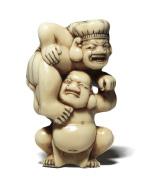


Unsigned Japan, 18th century, Edo period (1615-1868)
Published: Sagemonoya (2022), The Gabor and Georgina Wilhelm Collection, p. 23, no. 32.
The lucky gods Hotei and Daikoku clad only in a fundoshi (loincloth), the two grimacing combatants locked in a fierce sumo battle, Hotei lifting Daikoku over his back, about to perform the shumokuzori (backwards body drop) and win the match. The carving is remarkably three-dimensional, and the expressions are masterfully crafted, framed by thick pendulous earlobes. . Beautiful, deep honey patina. Natural himotoshi through Daikoku’s left leg and Hotei’s back.
HEIGHT 6 cm
Condition: Hotei’s two feet are restored. Otherwise, fine condition with few natural age cracks.
Provenance: The Gabor Wilhelm Collection, Paris.
This representation of a wrestling match between Hotei and Daikoku also illustrates the victory of the spiritual (Hotei) over financial luck (Daikoku).
MUSEUM COMPARISON
Compare to a closely related ivory netsuke of Hotei and Daikoku wrestling in the collection of The British Museum, accession no. 1945,1017.596.
Estimate EUR 2,500
Starting price EUR 1,200
40 27
OKAKOTO: AN IVORY NETSUKE OF HOTEI WITH KARAKO
By Okakoto, signed Okakoto 岡言 Japan, Kyoto, late 18th century, Edo period (1615-1868)
29
A GOOD KYOTO SCHOOL IVORY NETSUKE OF SHOKI, ATTRIBUTED TO OKATOMO

Attributed to Yamaguchi Okatomo, unsigned Japan, Kyoto, 18th century, Edo period (1615-1868)
Expressively carved, the demon queller grabbing his wide-brimmed hat, suspecting an oni hiding there, and unsheathing his sword in retaliation, his face marked by wildly flowing beard and intense gaze, the eyes inlaid in dark horn. Large generously excavated himotoshi through the back, the ivory bearing a super, deep-yellow patina.
HEIGHT 7.4 cm
Condition: Good condition with old wear and age cracks. Provenance: From an old Austrian private collection.
MUSEUM COMPARISON
Compare to a closely related ivory netsuke of shoki and oni, by Okatomo, in the collection of The British Museum, accession no. F.693.
AUCTION COMPARISON
Compare to a related ivory netsuke of Shoki and oni, Kyoto school, at Zacke, Fine Netsuke & Sagemono, 16 April 2021, Vienna, lot 42 (sold for 2,928 EUR).





Estimate EUR 1,500
Starting price EUR 800
Published: Sagemonoya (2022) A Selection of Netsuke & Sagemono from the Collection of Georgina & Gabor Wilhelm, p. 21, no. 27.
Smiling and facing ahead, supporting a small boy on his back with characteristic hair tufts inlaid in dark horn, the lucky god’s loose robe belted at the waist, baring his chest and distended stomach, holding a fan in his left hand, the ears with long pendulous lobes, two asymmetrical himotoshi to the back, beside the signature OKAKOTO within a rectangular reserve. The ivory bearing a rich, honey-yellow patina.
HEIGHT 6.7 cm
Condition: Very good condition, appealingly worn, few fine age cracks.
Provenance: The Gabor Wilhelm Collection, Paris.
AUCTION COMPARISON
Compare a related netsuke by Okanobu at Bonhams, The Bluette H. Kirchhoff Collection of Netsuke and Sagemono, 16 September 2009, New York, lot 2003 (sold for 5,368 USD), and another by Okakoto at Zacke, Fine Netsuke & Sagemono, 16 April 2021, Vienna, lot 41 (sold for 2,440 EUR).
Estimate EUR 2,000
Starting price EUR 1,000
41
28
A RARE IVORY NETSUKE OF SHIRO
Unsigned
Japan, late 18th century, Edo period (1615-1868)
Published: Rutherston & Bandini (2013) Japanese Netsuke, no. 4.



Depicting Emma-o’s attendant Shiro, who was sent to steal Daikoku’s bag of rice, being attacked with a branch of holly by one of the lucky god’s rats. Shiro is shown here in a cowering posture, biting into his folded arms in front of him, signifying his defeat. He has long hair, large horns and wears a tiger skin loincloth. The underside shows the very large, generously excavated himotoshi, and a gorgeous, rich honey-yellow patina.
LENGTH 4.7 cm
Condition: Very good condition with minor wear and few age cracks. Provenance: A private collection, purchased from Zacke, Fine Netsuke & Sagemono, 16 April 2021, Vienna, lot 13 (sold for 5,490 EUR).
Estimate EUR 4,000
Starting price EUR 2,000
30
GYOKUZAN: AN IVORY NETSUKE OF A KIRIN
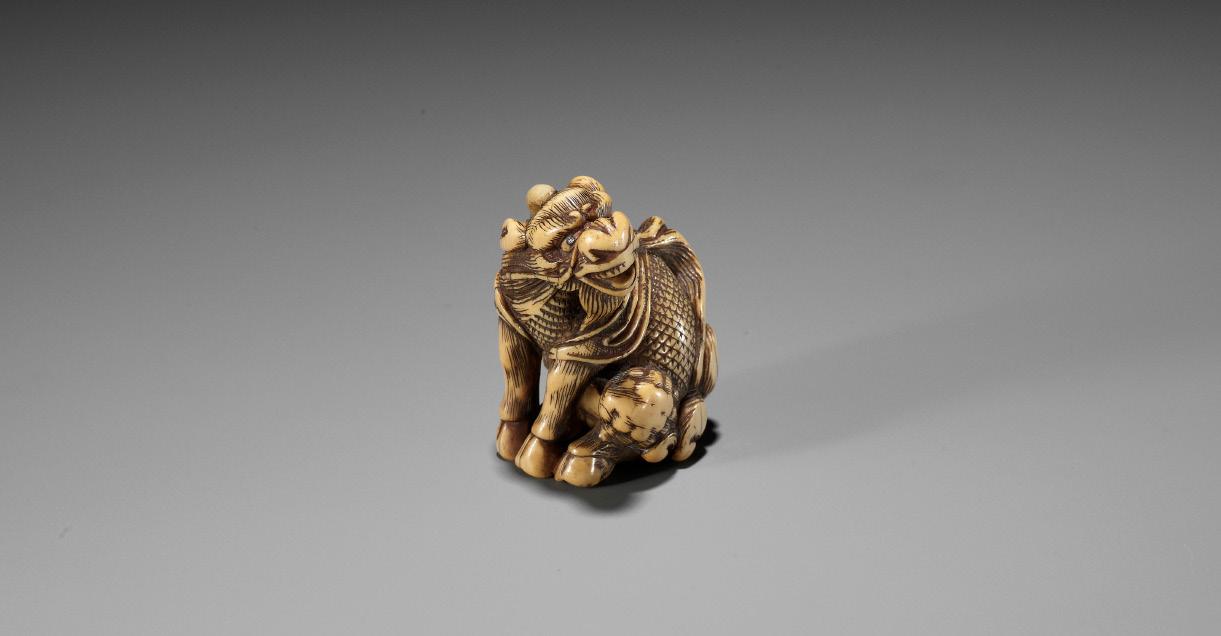
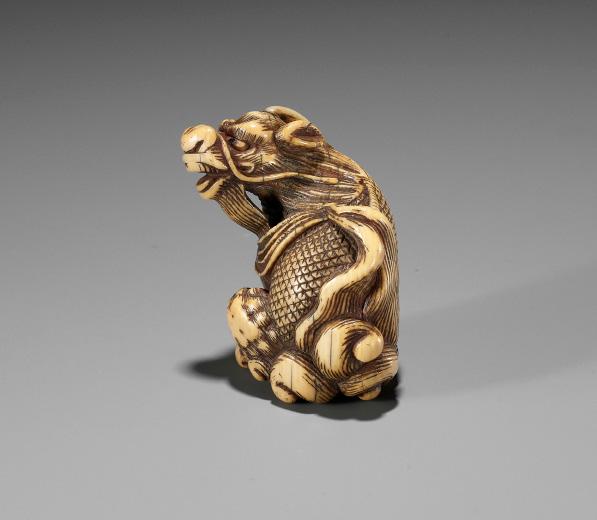 By Gyokuzan, signed Gyokuzan 玉山 Japan, Kyoto, late 18th century, Edo period (1615-1868)
By Gyokuzan, signed Gyokuzan 玉山 Japan, Kyoto, late 18th century, Edo period (1615-1868)
Finely carved seated on its haunches, the head raised and turned to one side, the mouth agape showing teeth and tongue, the plumage, mane, beard, tail, and flames all meticulously incised and darkly stained, the muscles subtly carved, the hooves well detailed, the belly and back with the himotoshi, the eyes inlaid with ebony, one haunch signed GYOKUZAN.
HEIGHT 3.8 cm
Condition: Good condition, minor wear, expected age cracks, the horn repaired.
Provenance: British private collection.
The Kirin is derived from the Chinese mythical beast Qilin, one of the four divine creatures, the others being the dragon, phoenix, and turtle. The Japanese Kirin is something of wild mythical fantasy – its most characteristic feature is of course the horn, as it is also called the Japanese unicorn. It has four legs with hooves and the hindlegs are covered with very well-expressed fatty tissue, like that of a shishi. The rest of the body is covered in dense plumage, like that of a phoenix.
AUCTION COMPARISON
Compare a related ivory netsuke of a shishi by Gyokuzan, with a very similar signature, at Koller, 27 March 2010, Zurich, lot
280. Compare a related ivory netsuke of a shishi by Mitsuharu at Bonhams, 12 November 2008, London, lot 422 (sold for 4,200 GBP). Compare a closely related ivory netsuke of a kirin, described as “style of Mitsuharu”, at Bonhams, 19 March 2013, New York, lot 2145 (sold for 12,500 USD).




Estimate EUR 3,000
Starting price EUR 1,500
43 31
TOMOTADA: A SUPERB IVORY NETSUKE OF A RECUMBENT COW
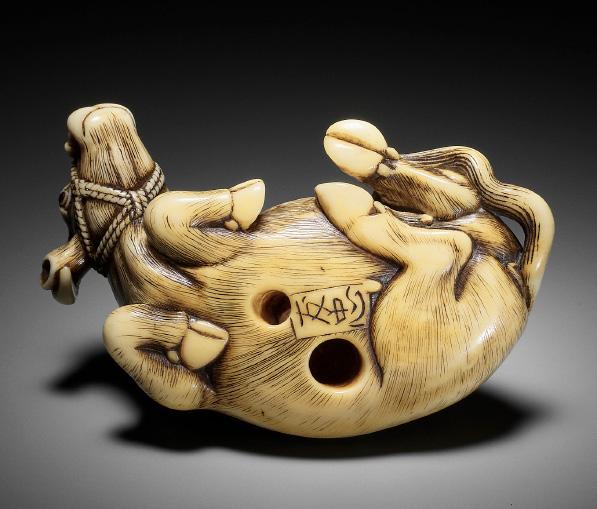 By Izumiya Tomotada, signed Tomotada 友忠 Japan, Kyoto, 18th century, Edo period (1615-1868)
By Izumiya Tomotada, signed Tomotada 友忠 Japan, Kyoto, 18th century, Edo period (1615-1868)
A large and bulky ivory netsuke of a recumbent cow raising her head to the left and tilting it ever so slightly, her neck musculature tensing a little as a result. The sensitively crafted animal has a curious expression, the eyes inlaid in dark buffalo horn. The fur is very neatly incised and worn in all the right places, the yellowish ivory gleaming with patina throughout the composition. The thick horns and rope halter, which passes through the nose ring and swirls around up over the animal’s back, are both expertly carved. The underside shows the beautifully carved legs which are drawn underneath the body for compactness and the generously excavated himotoshi placed at angle and formed by one larger and one smaller hole. The signature TOMOTADA within a rectangular reserve touching the himotoshi, exactly as it should.

LENGTH 7 cm
Condition: Very good condition with typical wear, age cracks, and traces of use. Tiny chip to one ear.
A masterful and remarkably sculptural rendition of a very classic subject by Tomotada, which is somewhat overlooked by collectors and experts alike as there are many copies. The present carving, however, is certainly by this artist mentioned in the Soken Kisho of 1781 and regarded as the founder of the ‘Kyoto school’.
AUCTION COMPARISON
Compare to a closely related ivory netsuke of a cow raising its head, by Tomotada, at Bonhams, The Julius & Arlette Katchen Collection of Fine Netsuke Part II, 10 May 2017, London, lot 52 (sold for 149,000 GBP). Compare particularly the underside, signature and himotoshi.
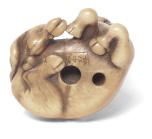
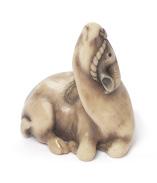

Estimate EUR 10,000
Starting price EUR 5,000
44
32
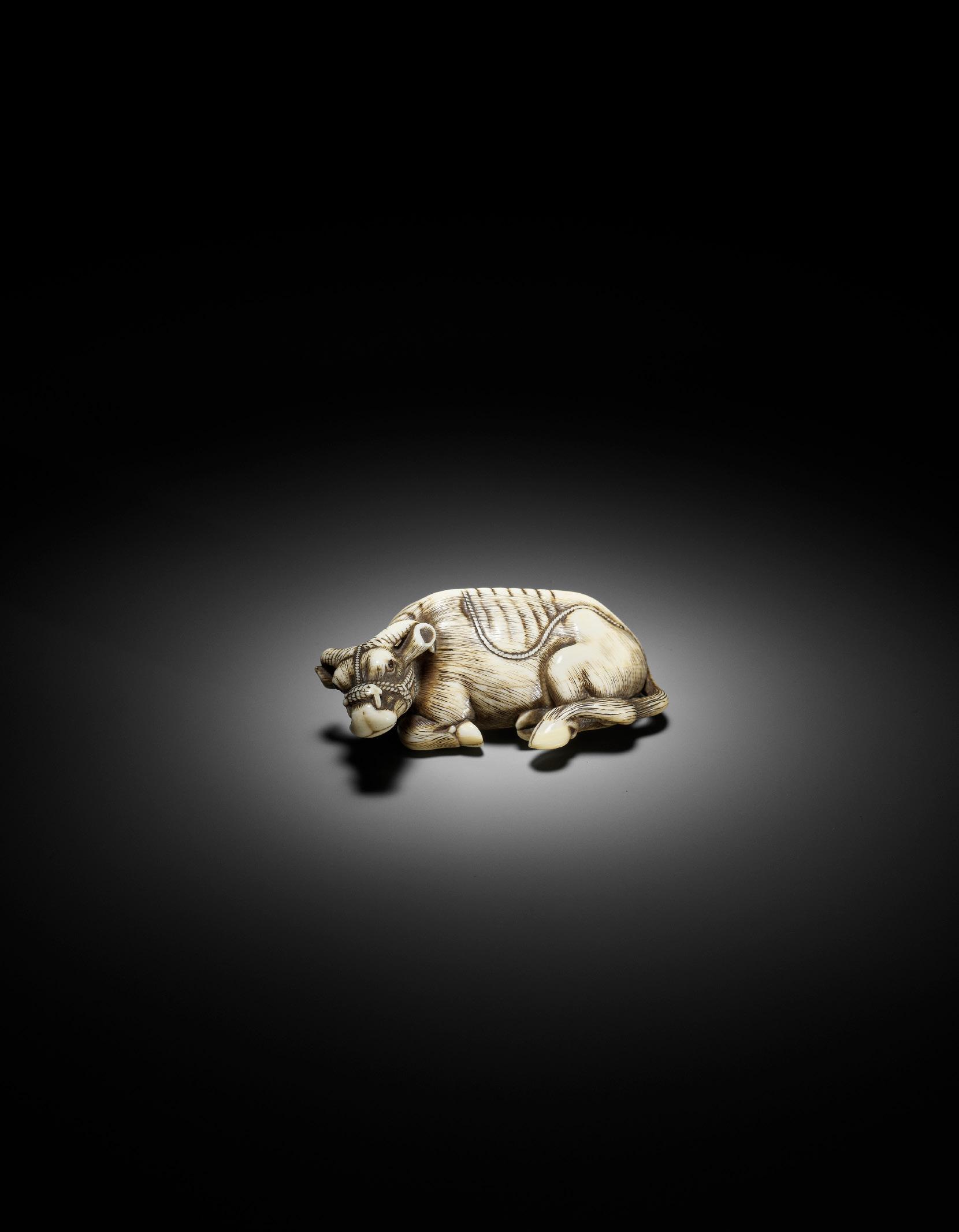
AN IVORY NETSUKE OF A PRANCING SHISHI
Unsigned Japan, Kyoto, late 18th century, Edo period (1615-1868)
Published:
Gabor Wilhelm (Spring 2002) On the Continent, International Netsuke Society Journal, Vol. 22, No. 1, p. 48. Sydney L. Moss Ltd. (2004) Outside the Box, p. 56, no. 25.
An exquisitely carved ivory netsuke of a shishi with its rump in the air, turning to snarl at its own tail. The eyes are inlaid in dark horn and there is a loose ball in its mouth. The low relief, well-polished lumpy excrescences to brow and haunches contrast nicely with the high relief whorls and curls of mane and tail, and with the deeply patinated smooth rounded surfaces of the body and legs. The carving is deep and bold throughout, and features some delicate textural stippling on the pads of the large feet. The himotoshi is cleverly positioned, with the larger of the two holes issuing through the rear legs. The ivory with a fine, honey-yellow patina.
LENGTH 4.2 cm
Condition: Very good condition, appealingly worn, few minor age cracks.
Provenance: Rossini, Paris, 3 December 2001, lot 2. Sydney L. Moss Ltd., London, 2004. French private collection, acquired from the above.
One curious aspect of this shishi netsuke is that it is slightly off balance when resting on all four legs, turning as if in surprise and shock at the sight of its own, admittedly rather scary tail rising up threateningly behind it. The animal appears to be in immediate danger of toppling over as it turns. This oddity is explained by a most unusual aspect: the beast is also designed to sit up on its rear legs with forepaws in the air, at which point it turns to look back on a level, horizontal plane and is a thoroughly coherent sculpture, with more movement and originality than most.

The carving shares stylistic elements with both Tomotada and Mitsuharu of Kyoto, while the inherent wit of the carving is reminiscent of the Osaka school.
AUCTION COMPARISON
Compare to a related ivory netsuke of a shishi, by Tomoharu, at Bonhams, Netsuke from a European Private Collection, 8 May 2016, London, lot 79 (sold for 6,250 GBP).



Estimate EUR 6,000
Starting price EUR 3,000
46 33

MASATOMO: A RARE IVORY NETSUKE OF A HARE WITH MUSHROOM
 By Masatomo, signed Masatomo 正友 Japan, Kyoto, c. 1800, Edo period (1615-1868)
By Masatomo, signed Masatomo 正友 Japan, Kyoto, c. 1800, Edo period (1615-1868)
Published:
Joly, Henri (1975) Catalogue of the H. Seymour Trower Collection of Japanese Art, no. 204 (unillustrated).
Bulletin Franco-Japonais (2002) no. 78, p. 2. Wilhelm, Gabor (2002) Bulletin Franco-Japonais, no. 79, p. 42. Wilhelm, Gabor (Spring 2003) On the Continent, International Netsuke Society Journal, Vol. 23, No. 1, p. 18.
Well carved as a rabbit seated on its haunches and nursing a mushroom between its front paws, the animal detailed with oval eyes inlaid with pale buffalo horn, long floppy ears, and a short curled tail, the fur neatly incised and darkly stained, the underside of the mushroom cap with incised radial gills creating an appealing contrast to the smooth cap and stem, the underside with asymmetrical, generously excavated himotoshi, the right haunch with the signature within a shaped reserve MASATOMO.
LENGTH 5.2 cm
Condition: Very good condition, minor wear, few minor age cracks.
Provenance: Ex-collection H. Seymour Trower (recorded in Henri Joly’s catalog, no. 204). Piasa, 23 October 2002, Paris, lot 235 (sold for 8,200 EUR). French private collection, acquired from the above.
MUSEUM COMPARISON
Compare a related ivory netsuke of a hare with mushroom by Okatomo, dated late 18th to early 19th century, in the Museum of Fine Arts, Boston, accession number 47.925.


Estimate EUR 6,000
Starting price EUR 3,000
48 34

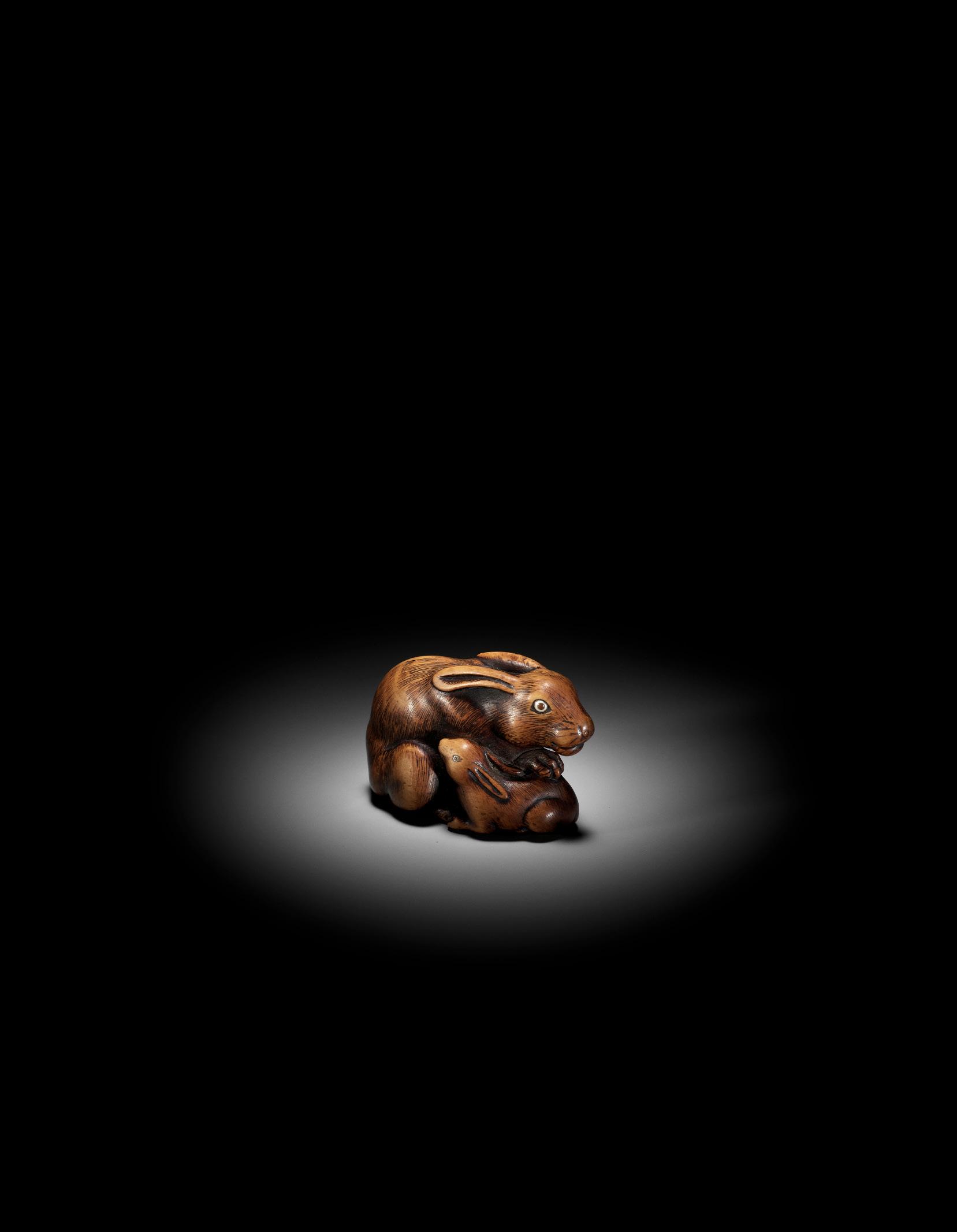
35
YAMAGUCHI OKATOMO: A SUPERB WOOD NETSUKE OF A HARE AND YOUNG



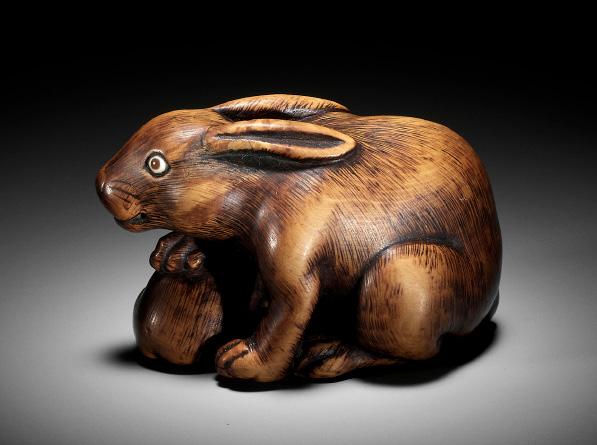
 By Yamaguchi Okatomo, signed Okatomo Japan, Kyoto, late 18th century, Edo period (1615-1868)
By Yamaguchi Okatomo, signed Okatomo Japan, Kyoto, late 18th century, Edo period (1615-1868)
Published:
Bushell, Raymond (1971) Collector’s Netsuke, p. 32, no. 24. Wilhelm, Gabor (1988) Netsuke Kenkyukai Society Journal, p. 42 and 44.

Wilhelm, Gabor (1989) Bulletin Franco-Japonais, p. 22.
Sydney L. Moss (1989) Japanese Netsuke: Serious Art. Outstanding Works Selected from American Collections, no. 10. Birch, Michael (Summer 1989) Netsuke Kenkyukai Society Journal, p. 26, fig. 3.
Superbly carved as a rabbit and young huddled close together, the mother resting a paw protectively on the back of the buck leveret, which is snuggling to its mother’s side. Their fur and other details are neatly incised and darkly stained for effect. Their eyes are double-inlaid with bone and pupils of reddish, mid-toned translucent buffalo horn. The underside is well detailed with the animals’ paws and genitals, with many natural himotoshi due to the openwork.
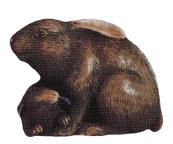
LENGTH 5.2 cm
Condition: Very good condition with minor expected wear and few minuscule age cracks. Tiny old repair to the edge of the left ear. Provenance: Ex- collection B.K. Denton, Yokohama and St. Louis, 1971. St. James’ Gallery, Zurich, 1988. Sydney L. Moss Ltd., London, 1989. European collection, acquired from the above. Sydney L. Moss Ltd., London, 2005. French private collection, acquired from the above.
Okatomo’s later animals, at the end of the 18th century, are
AN EXCEPTIONAL AND LARGE WOOD NETSUKE OF A SNAKE, ATTRIBUTED TO OKATOMO

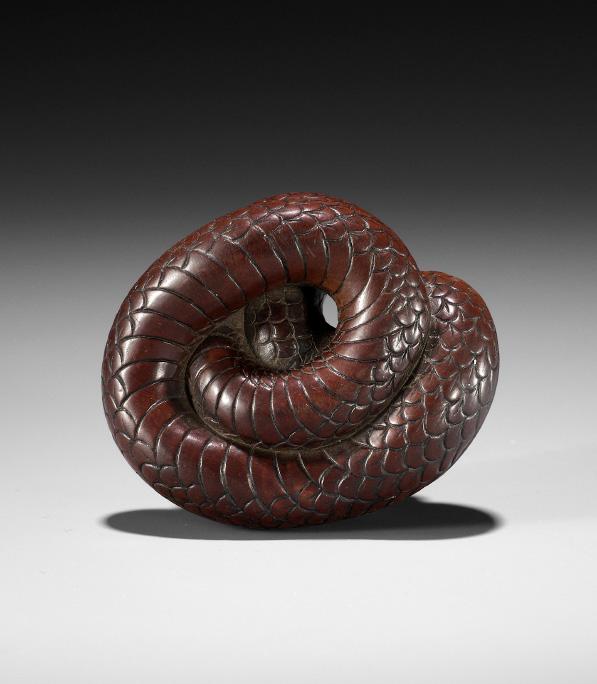

Attributed to Yamaguchi Okatomo, unsigned Japan, Kyoto, late 18th century, Edo period (1615-1868)
A remarkably bulky and powerfully executed sculptural masterpiece – the snake coiling around itself, its body entirely naturalistically represented, varying in thickness, covered almost entirely in boldly incised scales. The majestic reptile’s large head is resting at the top of the composition, its eyes inlaid with dark horn pupils, its tongue extended and slithering down along the tail. Natural himotoshi. Unsigned, however confidently attributed to the Kyoto master Yamaguchi Okatomo, the manner of the expression and inlaid eyes idiosyncratic of this celebrated artist. The well-toned wood bearing a fine patina.
SIZE 3 x 4.2 x 4.9 cm
Condition: Excellent condition, minor wear. Fine, dark patina. Provenance: Ex-collection Joe Kurstin. Dr. M. Joseph ‘Joe’ Kurstin (1931-2021) was a prominent Miami ophthalmologist who arguably built one of the greatest netsuke collections of all time. He was known by netsuke and inro lovers worldwide and made many lifelong friends in this tight-knit community. He published several books and articles on the subject and generously lent his collection for exhibitions at the Yale University Gallery, Museum of Fine Arts, Boston, Epcot Center at Disney World, and The Tobacco and Salt Museum, Tokyo.
Snakes from the Kyoto school are to be considered extremely rare. Only one other netsuke depicting a snake is recorded by Okatomo (see Museum comparison), however the present netsuke is the only one carved from wood. There are no recorded examples from other members of the Oka-school, such as from Okakoto or Okatori.
LITERATURE COMPARISON
Compare to a related wood netsuke of a coiled snake by Tomotada illustrated in Meinertzhagen, Frederick / Lazarnick, George (1986) MCI, Part B, p. 916.
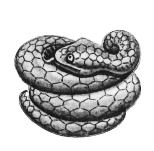
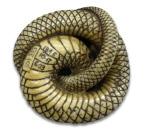

MUSEUM COMPARISON
Compare to a closely related ivory netsuke, signed Okatomo, in the collection of The British Museum, accession no. 1945,1017.603.
Compare the manner of the head, inlaid eyes and the manner of the scales, which are more elaborate on the present wood netsuke, however show the same incised line at the intersection point of the individual scales.
Estimate EUR 20,000
Starting price EUR 10,000

52 36
Elena and Joseph Kurstin
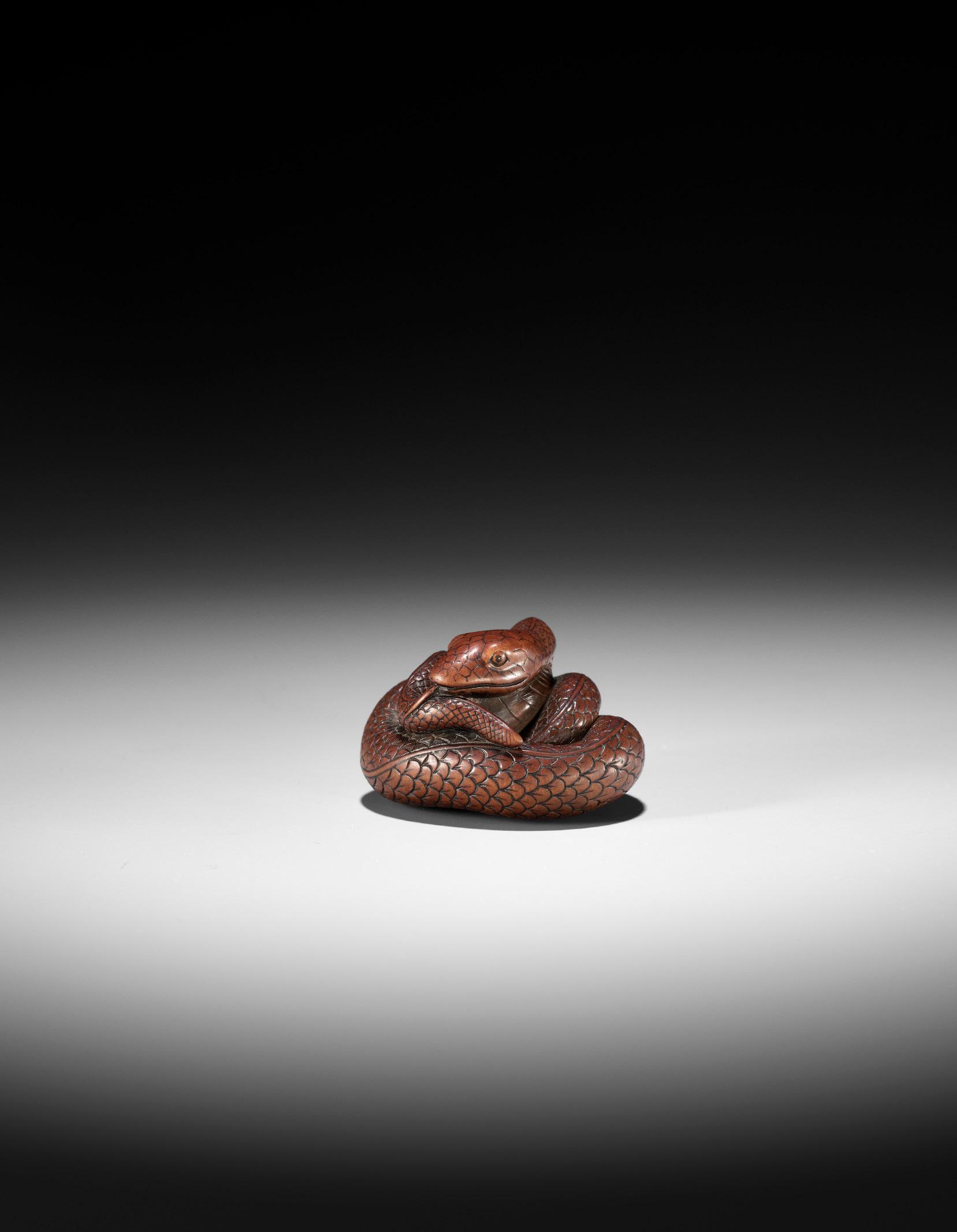
AN IVORY NETSUKE OF A COILED SNAKE, ATTRIBUTED TO OKATOMO



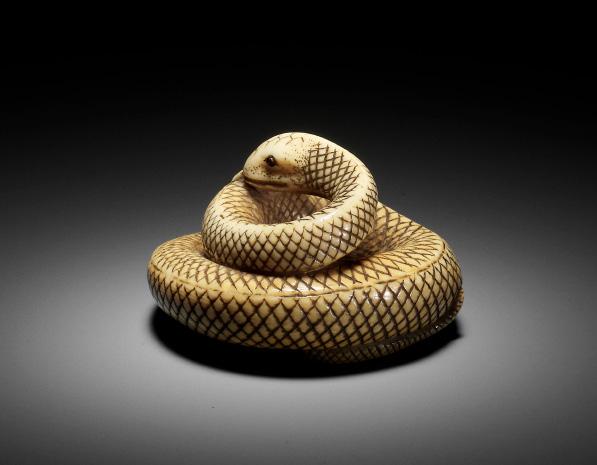

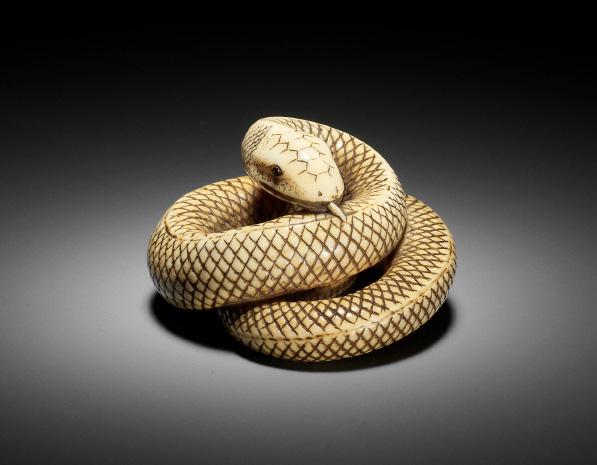
Attributed to Yamaguchi Okatomo, unsigned Japan, Kyoto, late 18th to early 19th century, Edo period (16151868)
Published: Sydney L. Moss Ltd. (2004) Outside the Box: Further Explorations in Japanese Netsuke and Lacquer, 2004, pp. 46-47, no. 20.
A finely carved ivory netsuke of a snake neatly coiled upon itself with its head resting on its body, the flickering tongue extending from its mouth, the tail sweeping in an elegant sinuous fashion to provide the natural himotoshi, the eyes inlaid with dark horn. The scales are neatly incised and darkly stained, the head is further detailed with subtle stippling. The surface has an attractive pale yellow glossy patina, shading low on the body and underneath to a matte reddish tone.
LENGTH 4 cm
Condition: Very good condition, appealingly worn, few minor age cracks.
Provenance: Sydney L. Moss Ltd, London, 2004. French private collection, acquired from the above.
MUSEUM COMPARISON
Compare a closely related ivory netsuke of a coiled snake by Yamaguchi Okatomo in the British Museum, registration number 1945,1017.603. This netsuke is also illustrated in Meinertzhagen, Frederick / Lazarnick, George (1986) MCI, Part B, p. 621, where Frederick Meinertzhagen describes it as a “wonderfully fine snake netsuke, rather cruder than is usually the case with Okatomo’s work, but absolutely real and alive and intensely attractive.” It was also included in the Red Cross exhibition in 1915, illustrated as no. 188, pl. LI.
Estimate EUR 8,000
Starting price EUR 4,000
37
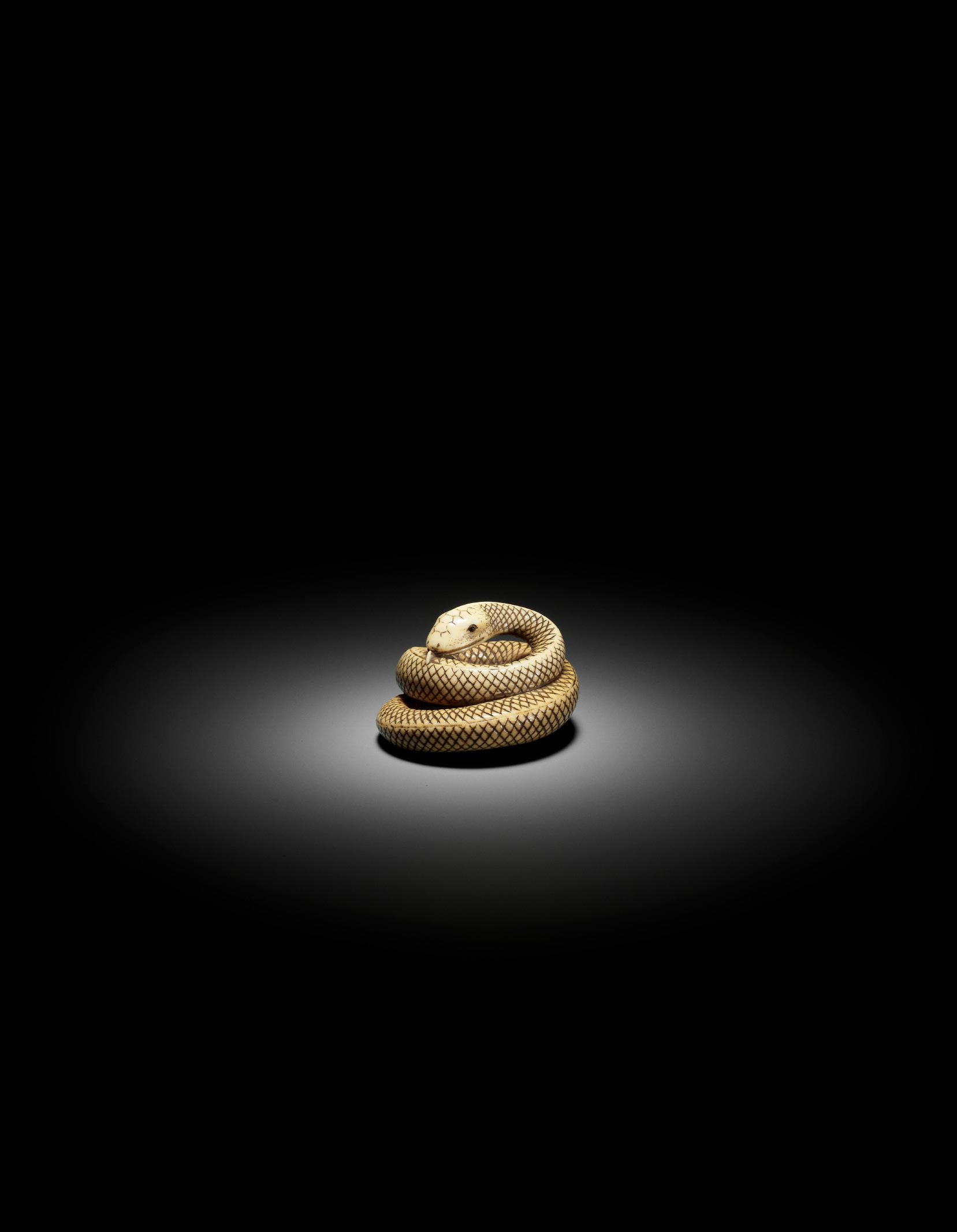
OKATOMO: A SUPERB IVORY NETSUKE OF A RAT WITH EDAMAME BEAN POD
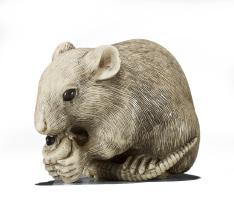

 By Yamaguchi Okatomo, signed Okatomo 岡友 Japan, Kyoto, late 18th to early 19th century, Edo period (1615-1868)
By Yamaguchi Okatomo, signed Okatomo 岡友 Japan, Kyoto, late 18th to early 19th century, Edo period (1615-1868)
Finely carved, with particular attention devoted to the neatly incised fur coat, the rat shown with its head lowered, the eyes inlaid in reddish horn, the two front paws firmly pressed down against a smoothly polished edamame bean pod while its left hind paw scratches its ear. The facial features are achieved with an extraordinary sense of naturalism, which without a doubt can only be achieved through close examination of animals, which Okatomo must have practiced, as all of his animal netsuke seem to possess a “soul”. The well-carved tail curls around to the underside, forming the cord attachment, and the signature is located in a rectangular reserve OKATOMO.
LENGTH 3.9 cm
Condition: A tiny chip to one ear and a small repair to the edge of the right hind paw and tip of the tail. Otherwise in fine condition with typical wear and natural age cracks. Fine, yellowish patina.
AUCTION COMPARISON
Compare to a closely related ivory netsuke of a rat gnawing at a candle by Okatomo’s younger brother Okatori, measuring 3.9 cm in length, at Zacke, Fine Netsuke & Sagemono, 16 April 2021, Vienna, lot 46 (sold for 13,420 EUR).

Estimate EUR 8,000
Starting price EUR 4,000
56 38
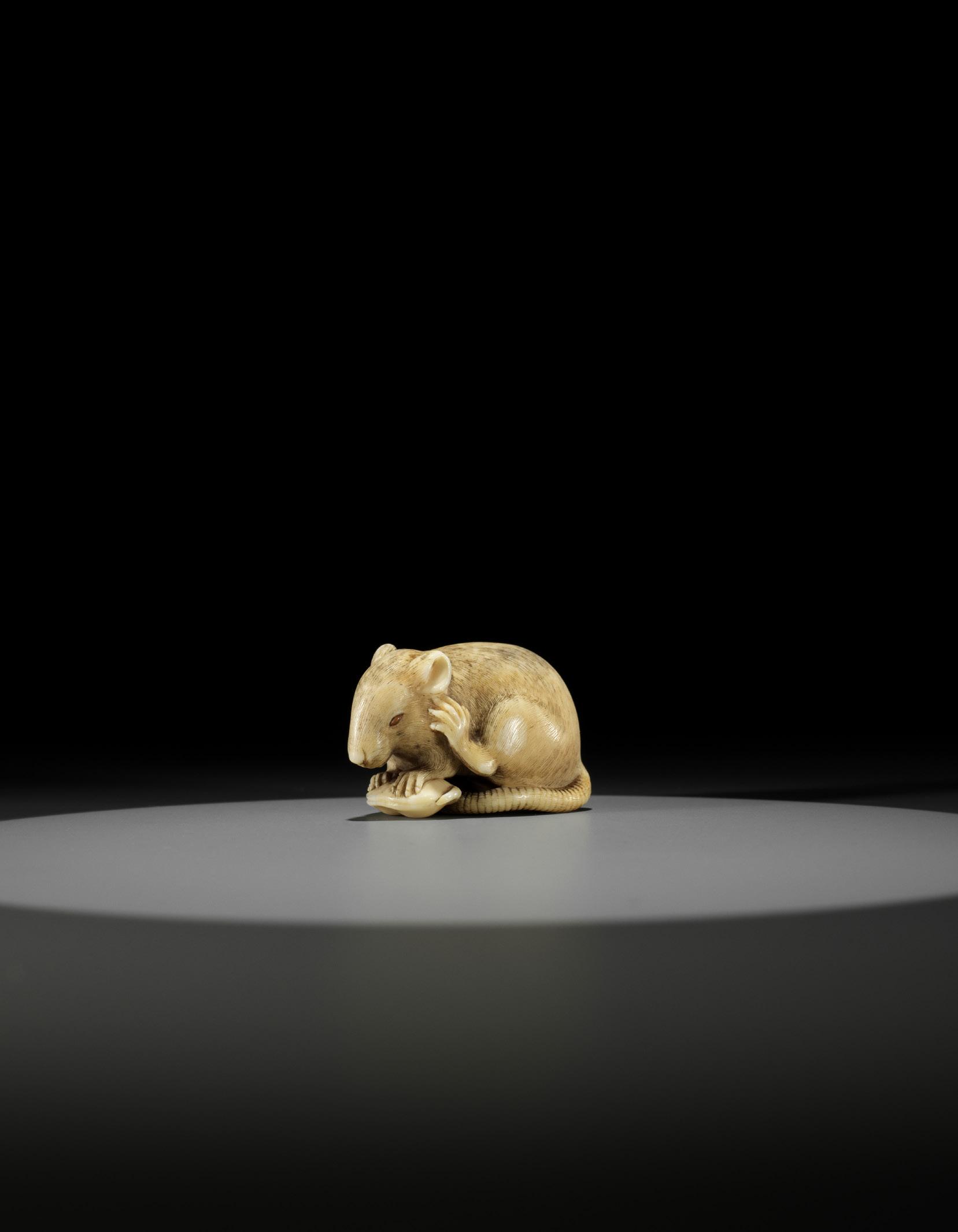
39 A FINE KYOTO SCHOOL IVORY NETSUKE OF A RAT


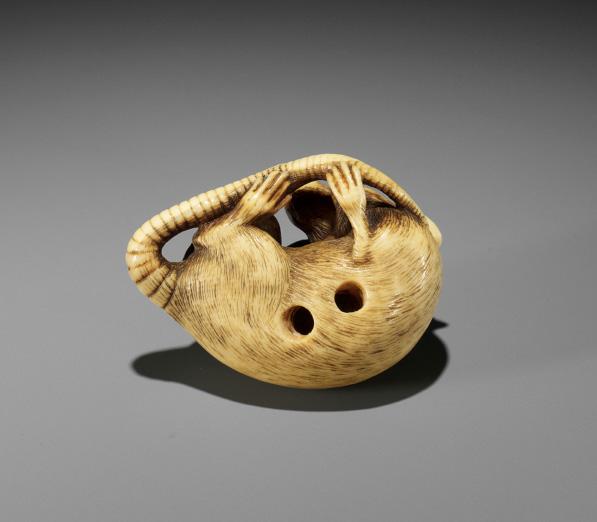
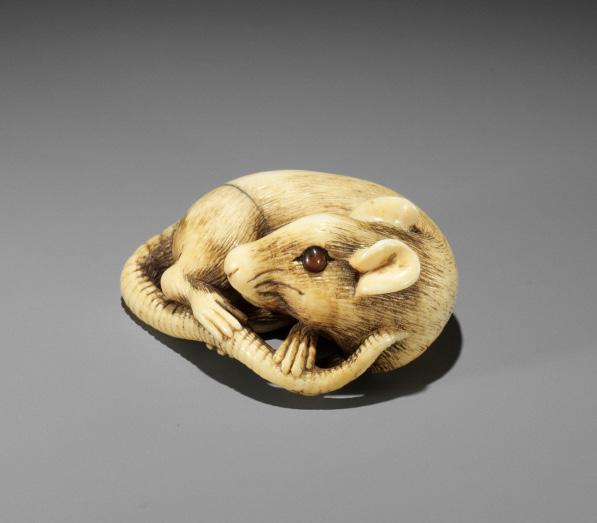
Unsigned Japan, Kyoto, late 18th to early 19th century, Edo period (16151868)
Published: Sagemonoya (2022), The Gabor and Georgina Wilhelm Collection, p. 52, no. 78.
The reclining rat with finely incised fur coiling around itself, grabbing its finely carved tail with all four paws as it turns and lifts its head curiously, the ears in an alert position and the glaring eyes inlaid in reddish horn. Two himotoshi through the underside. Unsigned, however stylistically close to Masanao of Kyoto, the ears in particularly reminiscent of his carvings of rats.
LENGTH 4.1 cm
Condition: The left ear restored. Otherwise good condition with an excellent patina and few age cracks.
Provenance: The Gabor Wilhelm Collection, Paris.
LITERATURE COMPARISON
Compare to a related ivory netsuke of a rat, signed Masanao, illustrated on the same page as the present netsuke in Sagemonoya (2022), The Gabor and Georgina Wilhelm Collection, p. 52, no. 76.
Estimate EUR 4,000
Starting price EUR 2,000
58
40 A GOOD KYOTO SCHOOL IVORY NETSUKE OF A RAT

Unsigned Japan, Kyoto, late 18th century, Edo period (1615-1868)
An exceptionally carved ivory netsuke of appealingly compact form depicting a rat (nezumi) with its head lowered and tongue stretched out to lick its tail, with one hind paw and both front paws placed on the well-carved tail which curls around in front of the animal. The hairwork is minutely incised, darkly stained, and characteristically worn for a late 18th century Kyoto-school work. Note the large ears and nose with incised whiskers. The eyes are large inlays of lustrous black buffalo horn. The underside shows the left hindleg neatly tucked underneath the body, flanked by two himotoshi.

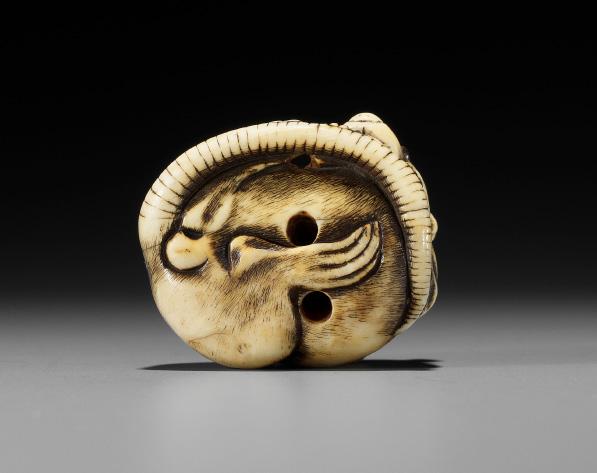

LENGTH 3.8 cm
Condition: Excellent condition, minor wear, expected age cracks. Provenance: Sotheby’s, Highly Important Netsuke, Inro, Ojime, 8 January 1981, Honolulu, lot 16. Sotheby’s, 11 April 1985, New York, lot 11. Formerly with Grace Tsumugi, London.
AUCTION COMPARISON
Compare a closely related Kyoto-school ivory netsuke of a rat, 4.7 cm long, also dated late 18th century, at Galerie Zacke, Fine Netsuke & Sagemono, 25 September 2020, Vienna, lot 48 (sold for 5,056 EUR). Also compare a closely related Kyoto-school ivory netsuke of a rat, 5.2 cm long, dated 18th-19th century, at Bonhams, 20 March 2012, New York, lot 2110 (sold for 8,750 USD).
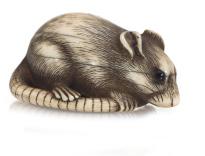
Estimate EUR 4,000
Starting price EUR 2,000
59
41 TOMOTADA: AN IVORY NETSUKE OF A DOG WITH BALL



Signed Tomotada 友忠 Japan, Kyoto, 18th century, Edo period (1615-1868)
The dog (inu) wearing a collar with bell and protectively holding a large ball between its paws, its face with a charming expression, the eyes inlaid in reddish horn. The details, such as the curling tail and pronounced spine and rib cage, are finely carved. The ivory bearing a beautiful, warm yellowish patina, clearly loved and handled by several generations. Large himotoshi underneath and to the side. Signed TOMOTADA within a rectangular reserve under the left hind paw.
LENGTH 4.1 cm
Condition: Good condition with several age cracks. Attractively worn with a fine patina.
AUCTION COMPARISON
Compare to a closely related ivory netsuke of a female dog and pup, signed Tomotada, at Zacke, Fine Netsuke & Sagemono, 29 October 2021, Vienna, lot 52 (sold for 5,688 EUR).
Estimate EUR 4,000
Starting price EUR 2,000
60
OKATORI: A FINE IVORY NETSUKE OF A MONKEY WITH A PEACH

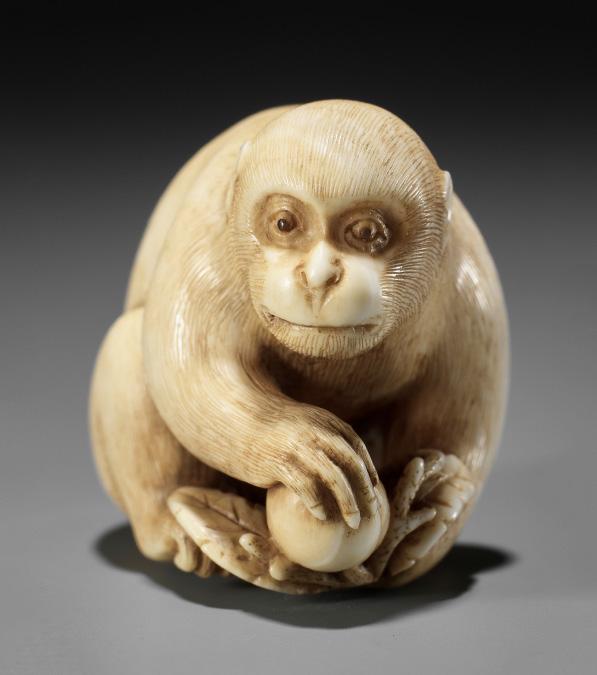 By Yamaguchi Okatori, signed Okatori 岡隹 Japan, Kyoto, early 19th century, Edo period (1615-1868)
By Yamaguchi Okatori, signed Okatori 岡隹 Japan, Kyoto, early 19th century, Edo period (1615-1868)
Finely carved as a seated monkey leaning forwards, holding in one hand a leafy peach branch, the other hand fondling the fruit, the face with a fine expression, the pupils inlaid in dark horn, the fur and other details neatly incised. Natural himotoshi between the monkey’s limbs and branch, the underside with the signature OKATORI within a rectangular reserve. The ivory bearing an attractive yellowish hue and a fine patina.
LENGTH 3.7 cm
Condition: Excellent condition, minor wear, few faint age cracks.
AUCTION COMPARISON
Compare to a closely related ivory netsuke of a monkey with loquats, by Okatori, at Zacke, Fine Netsuke & Sagemono, 22 April 2022, Vienna, lot 46 (sold for 6,320 EUR).

Estimate EUR 4,000
Starting price EUR 2,000
61 42
KAIGYOKUSAI MASATSUGU: A SUPERB IVORY NETSUKE OF A PUPPY WITH TOY DOG
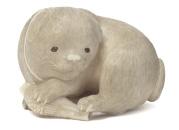

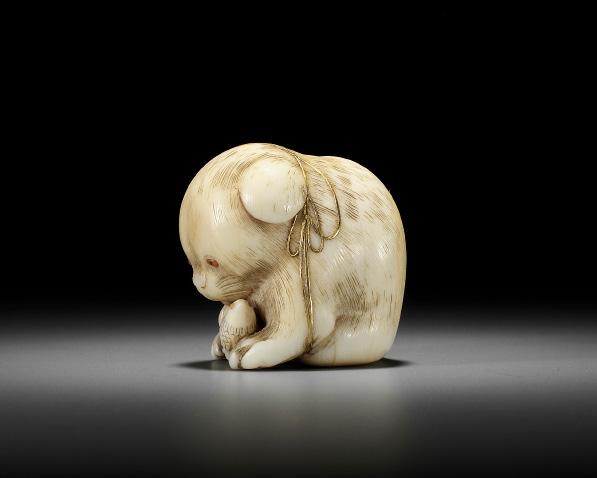
 By Kaigyokusai Masatsugu (1813-1892), signed Kaigyoku 懐玉 with seal Masatsugu 正次 Japan, Osaka, second half of 19th century
By Kaigyokusai Masatsugu (1813-1892), signed Kaigyoku 懐玉 with seal Masatsugu 正次 Japan, Osaka, second half of 19th century
Superbly carved as a puppy seated on its haunches and playing with a toy bird, the four paws close together, its head lowered. The eyes are inlaid in tortoiseshell with dark horn pupils. The puppy is so engrossed in the toy that it does not appear to notice the string, executed in gold lacquer, wrapped around its body. The animal is further detailed with subtly carved raised whiskers, floppy ears, and a curved tail which is raised in excitement. The hairwork is slightly worn, revealing the beautifully gleaming ivory underneath, however what remains of the hairwork is truly a spectacular sight, especially when viewed under a magnifying glass – not a single stroke is misplaced, each minutely incised line complements the other perfectly, adding to the sublime color, gleam, and overall feel of the material. The piece is truly a joy to handle, much owed to the compact design of the netsuke, which is ideally shaped. The underside with the himotoshi, one of which is obscured by a paw, the same haunch incised with the signature KAIGYOKU within a polished reserve and the seal MASATSUGU within a polished and incised square reserve.
LENGTH 2.8 cm
Condition: Professionally restored to the right front paw and to the separately carved and inset toy bird which has been previously lost. The gold lacquered string is original to the composition and has been repaired as well. Minor typical wear to hairwork.
Kaigyokusai only chose the best pieces of ivory for his carvings, this being pure white tokata ivory, which the artist has lightly stained yellow.
LITERATURE COMPARISON
Compare a related ivory netsuke by Kaigyokusai Masatsugu depicting the same subject, illustrated in Hurtig, Helen (December 1978) Animals of the Oriental Zodiac, INCS Journal, Vol. 6, No. 3, p. 48. Another closely related ivory netsuke by Kaigyokusai Masatsugu is illustrated in Davey, Neil K. (1974) Netsuke: A comprehensive study based on the M.T. Hindson Collection, p. 53, no. 126, and in Lazarnick, George (1981) Netsuke & Inro Artists, and How to Read Their Signatures, vol. 1, p. 563.
AUCTION COMPARISON
Compare a closely related ivory netsuke of a puppy with a toy bird, by Kaigyokusai Masatsugu, at Bonhams, The Julius and Arlette Katchen Collection of Fine Netsuke Part II, 10 May 2017, London, lot 129 (sold for 30,000 GBP).

Estimate EUR 15,000
Starting price EUR 8,000
62 43

44 MASAHIRO: AN OSAKA SCHOOL IVORY NETSUKE OF THE LUNAR HARE

By Masahiro, signed Masahiro 正廣 Japan, Osaka, mid-19th century, Edo period (1615-1868)
The lunar hare armed with a large mochi pestle leaning against a large, moon-shaped sphere, standing on a cloud-base issuing from the moon, with further swirling clouds carved in relief against the surface of the smoothly polished sphere. The rabbit’s eyes are inlaid in amber. Large, asymmetrical himotoshi through the moon and signed underneath MASAHIRO – widely regarded as the most talented pupil of the famous Osaka netsukeshi Ohara Mitsuhiro (1810-1875).
LENGTH 4.4 cm
Condition: Very good condition. Several natural age cracks. Provenance: French private collection, purchased from Galerie Yamato, Paris, 2001.
This popular motif originates in China, where the rabbit is often portrayed as a companion of the Moon goddess Chang’e, constantly pounding the elixir of life for her. In the Japanese variation, the lunar hare is often seen pounding mochi.
Museum comparison: A closely related ivory netsuke, by Masahiro, formerly in the Trumpf collection, is in the collection of the Linden Museum, Stuttgart, accession no. OA 18784.
AUCTION COMPARISON
Compare to a closely related ivory netsuke, by Shigemasa, sold at Bonhams, The Harriet Szechenyi Sale of Japanese Art, 8 November 2011, London, lot 132 (sold for 2,250 GBP). Also compare to another closely related ivory netsuke, by Masahiro, at Van Ham, Asian Art, 9 June 2016, Cologne, lot 2400 (sold for 3,354 EUR).

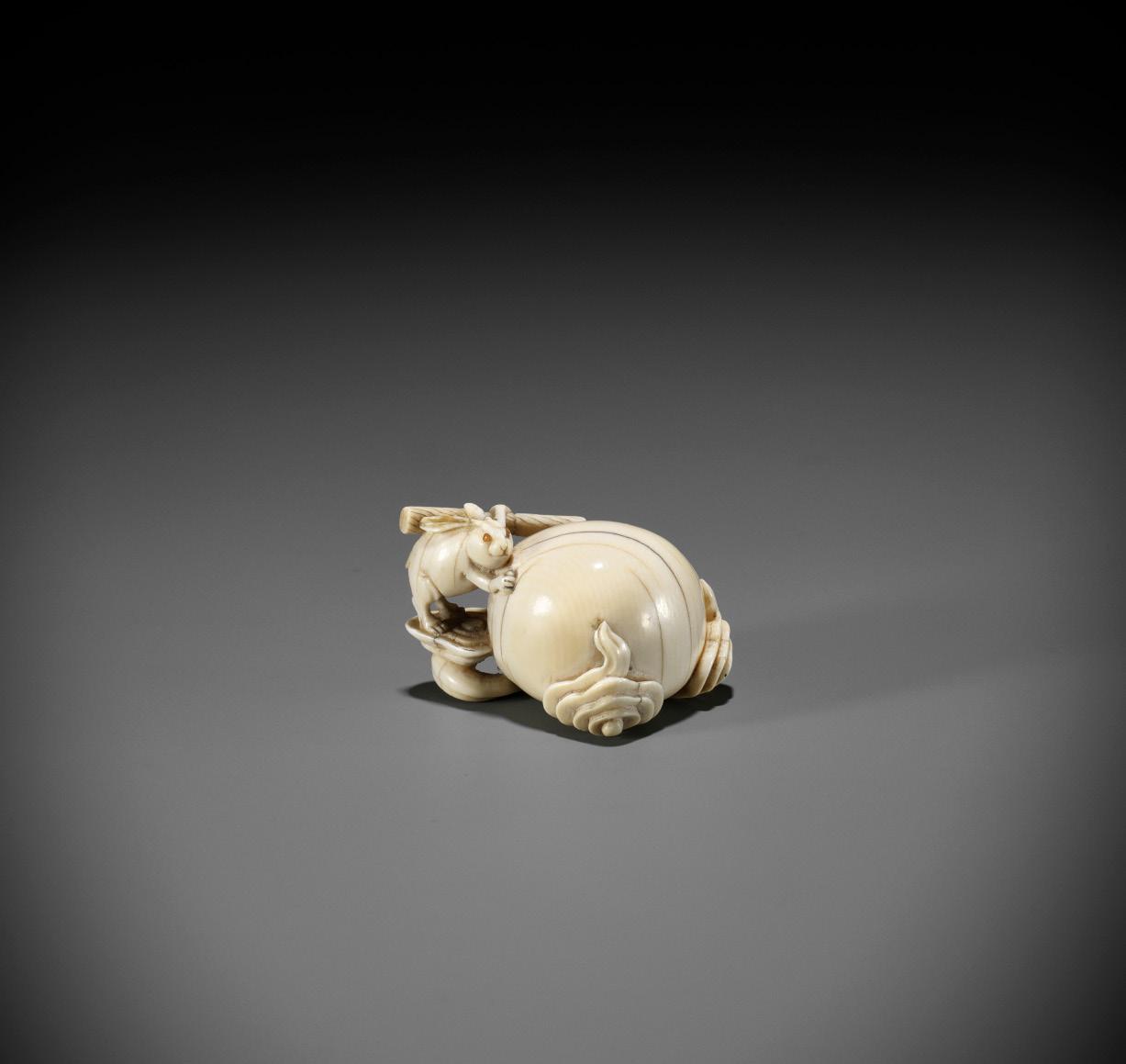
Estimate EUR 2,500
Starting price EUR 1,200
64
DOSHO: AN IVORY MANJU NETSUKE OF TWO SUMO WRESTLERS
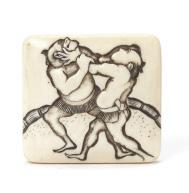 By Dosho,
By Dosho,
signed
Dosho 道笑 saku 作 Japan, Osaka, mid-19th century, Edo period (1615-1868)
Published:
Lazarnick, George (1981) Netsuke & Inro Artists, and How to Read Their Signatures, vol. 1, p. 358 Atchley, Virginia / Davey, Neil (2006) The Virginia Atchley Collection of Japanese Miniature Arts, p. 148, no. N201.
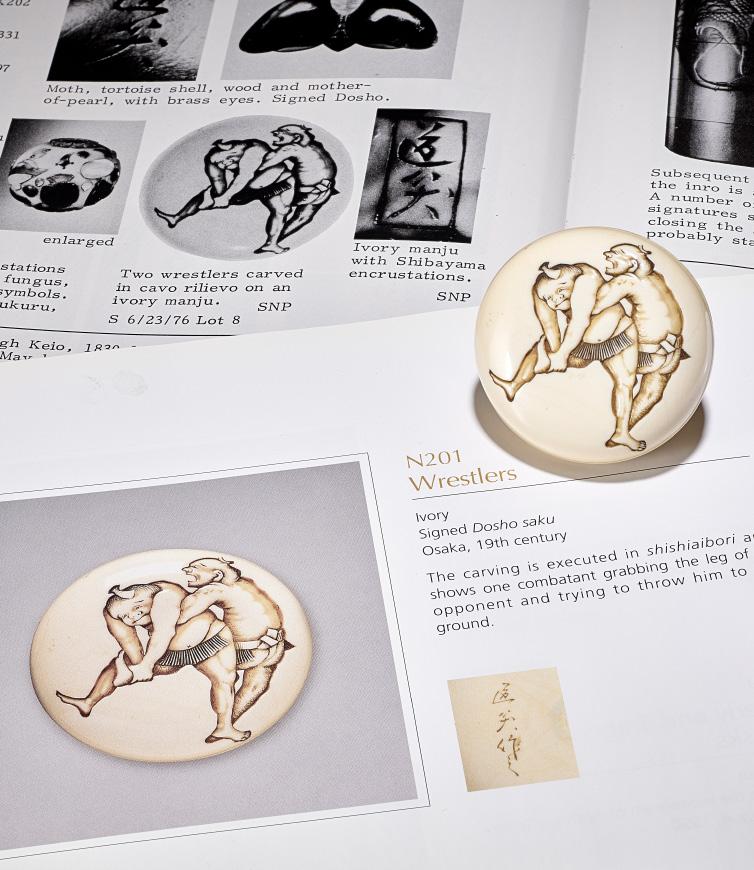
Finely carved in shishiaibori with two sumo wrestlers, one screaming in agony as his opponent wraps both hands around his ankle, each with neatly incised hair and subtly carved muscular bodies, the details further heightened by skillful staining. The reverse with a central himotoshi and the signature DOSHO saku [made by Dosho].
DIAMETER 5 cm
Condition: Very good condition, minor wear, few small age cracks, tiny nibbles to edges.
Provenance: Ex-collection Virginia Atchley.
AUCTION COMPARISON
Compare a related ivory manju netsuke by Doshosai, dated 19th century, at Bonhams, The Edward Wrangham Collection of Japanese Art Part IV, 6 November 2013, London, lot 79 (sold for 1,875 GBP).
Estimate EUR 2,000
Starting price EUR 1,000
46
MITSUHIRO: AN IVORY NETSUKE OF A FLY ON A BIWA (LOQUAT)

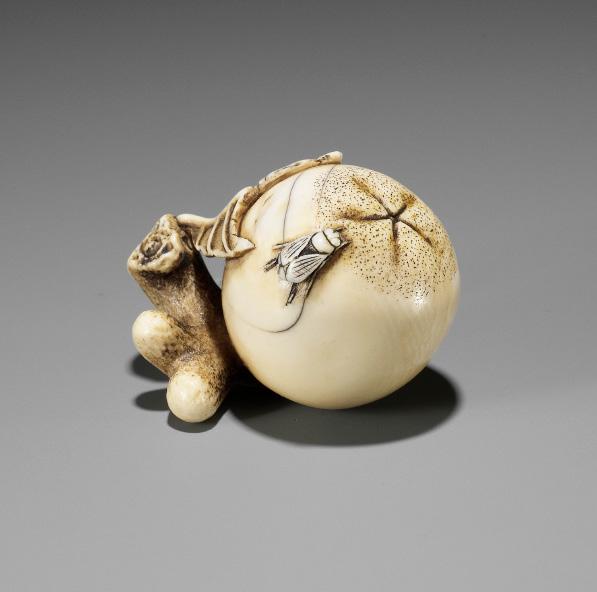
Naturalistically carved and finely stained to depict a loquat borne on a gnarled branch further issuing a half-eaten leaf, a fly on the skin of the fruit. The branch signed within a gourd-shaped reserve MITSUHIRO with a kakihan. Fine, honey-yellow patina.
LENGTH 4.2 cm
Condition: Very good condition, minor wear, expected age cracks.
This subject was favored by Mitsuhiro due to its tactile nature. The design is recorded in Mitsuhiro / Mikoshiba, Misao (transl.) (2001) Takarabukuro: A Netsuke Artist Notebook, p. 129, no. 156, where Mitsuhiro notes: “showing a leaf and a fruit. A short branch is curved to hold a cord. Ishime finished should be used. An exact copy made to look old”.
AUCTION COMPARISON
Compare a near identical netsuke by Mitsuhiro, also signed with a kakihan and showing the same half-eaten leaf, at Sotheby’s, 18 November 1974, London, lot 128 (sold for hammer price 1,700 GBP). This netsuke is also illustrated in Barry Davies Oriental Art (1998) The Robert S. Huthart Collection of Non-Iwami Netsuke, p. 87, no. 62.
Estimate EUR 1,500
Starting price EUR 800
65
45
By Ohara Mitsuhiro (1810-1875), signed Mitsuhiro 光廣 with kakihan Japan, Osaka, mid-19th century, Edo period (1615-1868)
HIDEMASA: A FINE IVORY NETSUKE OF IKKAKU CARRYING THE PRINCESS SENDARAMO
 By Hidemasa, signed Hidemasa 秀正 Japan, Osaka, first half of 19th century, Edo period (1615-1868)
By Hidemasa, signed Hidemasa 秀正 Japan, Osaka, first half of 19th century, Edo period (1615-1868)
Published: Sagemonoya (2022), The Gabor and Georgina Wilhelm Collection, p. 21, no. 26.
The one-horned rishi Ikkaku tilting his head in laughter, carrying the beautiful princess Sendaramo (also known as the Lady of Benares) on his back, who lifts her billowing scarf which twists and turns around the composition, forming the cord attachment in the back. The ivory is lightly stained, the expressions are comical and animated, and the elaborated robes of the pair are incised with ornate, scrolling patterns. Signed to the back HIDEMASA.
HEIGHT 5.9 cm
Condition: Very good condition with typical surface wear. One tiny, old chip to one toe of Ikkaku.
Provenance: The Gabor Wilhelm Collection, Paris.
The subject is derived from the Noh play Ikkaku Sennin, written by Komparu Zembo Motoyasu (1453-1532). Ikkaku Sennin, the onehorned rishi, once slipped on a hill near Benares and in his anger captured the dragon kings and kept them from letting rain fall from the sky. He is then seduced by a beautiful lady from Benares and eventually loses all his power, thus freeing the dragon kings and ending a terrible drought.
MUSEUM COMPARISON
A closely related ivory netsuke depicting the same subject, by Hidemasa, is in the collection of the Los Angeles County Museum of Art (LACMA), accession number M.91.250.114.


Estimate EUR 4,000
Starting price EUR 2,000
66 47
AN EARLY IVORY NETSUKE OF TAIRA NO TADAMORI CAPTURING THE OIL THIEF



Unsigned Japan, 18th century, Edo period (1615-1868)
Published: Sagemonoya (2022) A Selection of Netsuke & Sagemono from the Collection of Georgina & Gabor Wilhelm, p. 35, no. 51.
Dynamically and powerfully carved to depict Taira no Tadamori grabbing the oil thief Abura Bozu from behind atop a shaped base. Tadamori’s expression is fierce, expecting an evil demon, while he grabs the oil thief by the arm, who is holding an ewer. Abura Bozo’s expression is surprised, one foot lifted – he is caught red-handed. Unbeknownst to Tadamori the man is nothing but a poor old soul, stealing a tiny bit of oil from the many lamps in the forest near the Yasaka no Yashioro temple. This mishap is masterfully depicted in this netsuke. The base with a central himotoshi. The garment folds are expertly carved. The ivory with a rich, honey-yellow patina.
HEIGHT 4.4 cm
Condition: Very good condition, minor wear, few fine age cracks. Provenance: The Gabor Wilhelm Collection, Paris.
MUSEUM COMPARISON
Compare a related ivory netsuke depicting the same subject in the Metropolitan Museum of Art, accession number 10.211.1116.
Estimate EUR 4,000
Starting price EUR 2,000
67 48
A FINE OSAKA SCHOOL IVORY NETSUKE OF A PUPPY PLAYING WITH A SANDAL (WARAJI)

Unsigned Japan, Osaka, late 18th to early 19th century, Edo period (1615-1868)
Finely carved to depict a puppy licking a sandal at its feet, with three paws placed on the sandal, the fourth neatly carved to the underside, the puppy well detailed with eyes inlaid in red buffalo horn, finely incised and darkly stained fur, floppy ears, and a collar tied around its neck. Natural himotoshi. The underside with two generously excavated himotoshi. Fine, honey-yellow patina.
LENGTH 4.8 cm
Condition: Excellent condition, minor wear, expected age cracks.
AUCTION COMPARISON
Compare to a related ivory netsuke of a puppy, by Garaku, at Bonhams, The Harriet Szechenyi Sale of Japanese Art, 8 November 2011, London, lot 160 (sold for 5,625 GBP).
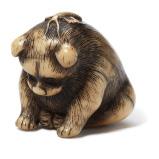
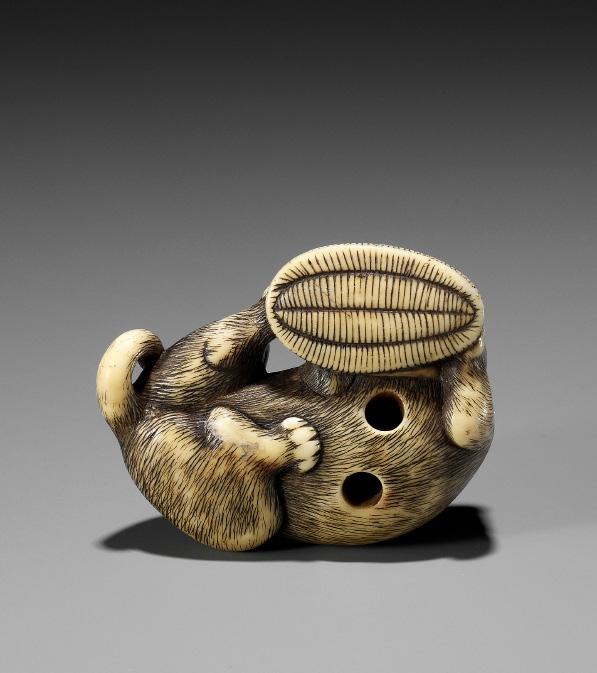
Estimate EUR 2,500
Starting price EUR 1,200
68 49
Finely carved to depict a fisherman sitting on top of his catch, a giant carp with horn-inlaid eyes flapping its tail fin as it struggles to free itself. The fisherman is dressed in a straw skirt and a patterned robe, his face well-detailed with a cheerful expression. The fish with neatly incised scales and stippled head, enhances with sumi (ink), which is typical for the Osaka school. The fish’s body with asymmetrical himotoshi centered by the incised signature MASAMINE.
LENGTH 4.1 cm
Condition: Excellent condition with minor wear.
Provenance: Silvia Soler, Barcelona, 2008. Dutch private collection, acquired from the above. Collection Prof. Dr. Henk C. Hoogsteden, Rotterdam, acquired from the above. A copy of the original invoice from Silvia Soler, stating a purchase price of 4,000 EUR, accompanies this lot.
Masamine’s netsuke are often attractively carved in good detail, the designs original, suggesting an independent craftsman. See Meinertzhagen, Frederick / Lazarnick, George (1986) MCI, Part A, p. 432.
AUCTION COMPARISON
Compare a closely related unsigned ivory netsuke of a fisher with carp, Osaka school, at Van Ham, Asian Art, 9 June 2016, lot 2376 (sold for 9,675 EUR).



Estimate EUR 3,000
Starting price EUR 1,500
69
50 MASAMINE: A FINE OSAKA SCHOOL IVORY NETSUKE OF A FISHERMAN STRUGGLING WITH A HUGE CARP
By Masamine, signed Masamine 正峯 Japan, Osaka, mid-19th century, Edo period (1615-1868)
A beautifully compact and finely stained wood netsuke of a tortoise retracted almost entirely within its shell. The carving is treated with remarkable naturalism, the individual domed panes of the creature’s carapace, as well as other subtle peculiarities, are executed with extreme precision. The head, with large inlaid eyes of dark horn, peeks out ever so slightly. The underside shows the well-carved limbs which are treated with fine stippling, and the irregularly shaped underside of the carapace. Two himotoshi underneath and signed TOYOMASA – likely an early work by this celebrated artist.
LENGTH 4.5 cm
Condition: Excellent condition, minor expected wear. Beautiful, deep patina.
Provenance: A noted private collection, USA.
LITERATURE COMPARISON
Compare to a closely related wood netsuke of a tortoise, by Toyomasa, illustrated in Chappell, Sharon / Welch, Matthew (1999) Netsuke: The Japanese Art of Miniature Carving, p. 98, no. 140.
AUCTION COMPARISON
Compare to a wood netsuke of a tortoise, executed in a different style, by Toyomasa, at Bonhams, The Harriet Szechenyi Sale of Japanese Art, 8 November 2011, London, lot 222 (sold for 6,875 GBP).



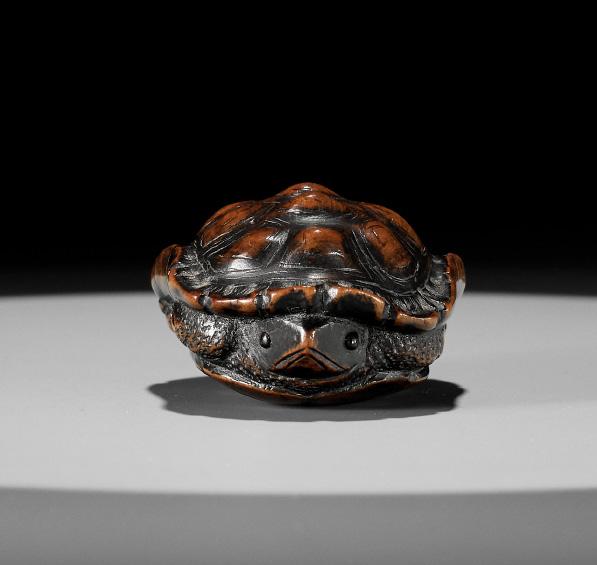

Estimate EUR 10,000
Starting price EUR 5,000
70
51 TOYOMASA: A SUPERB WOOD NETSUKE OF A TORTOISE
By Naito Toyomasa (1773-1857), signed Toyomasa 豊昌 Japan, Sasayama, Tanba Province, early 19th century, Edo period (1615-1868)
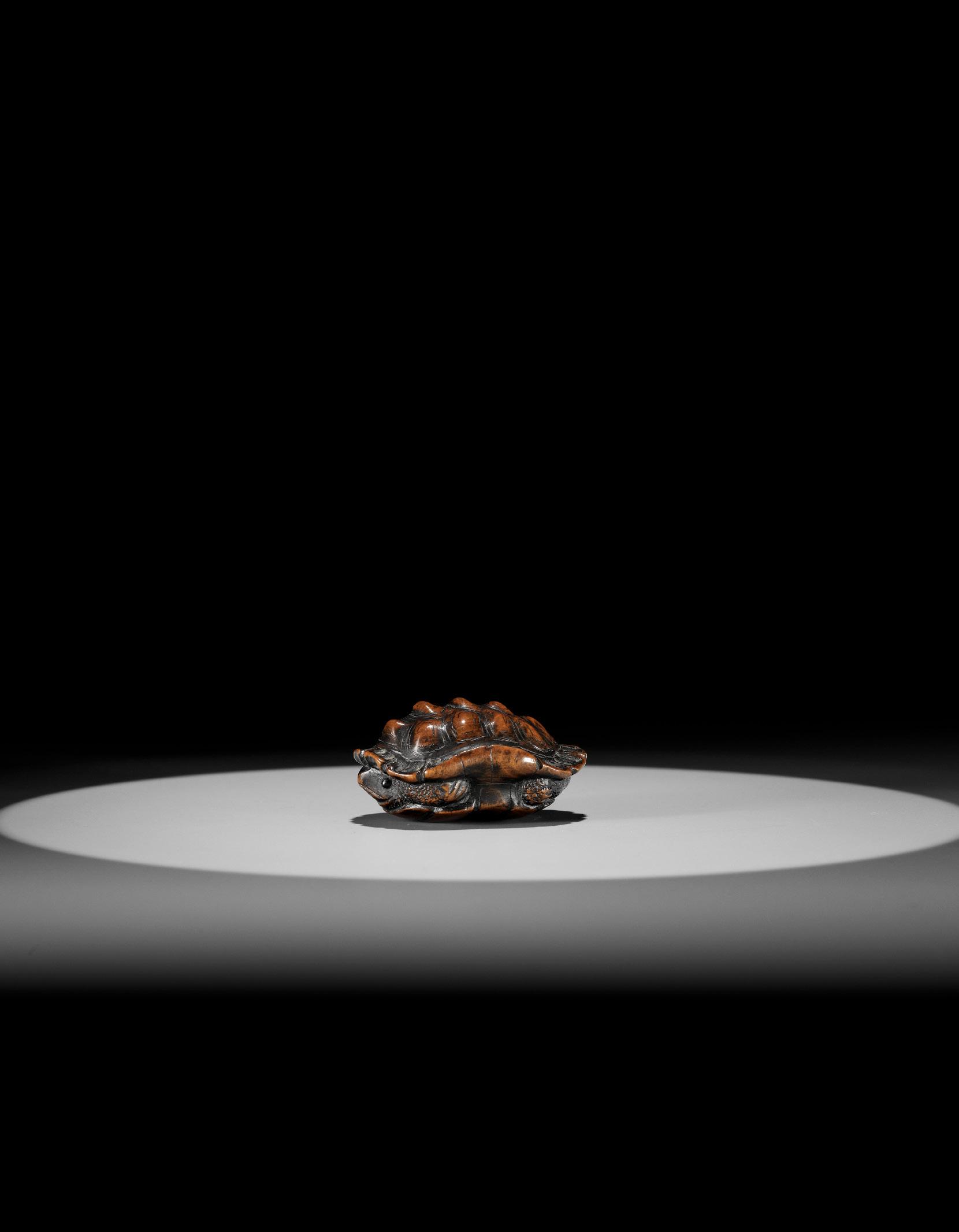
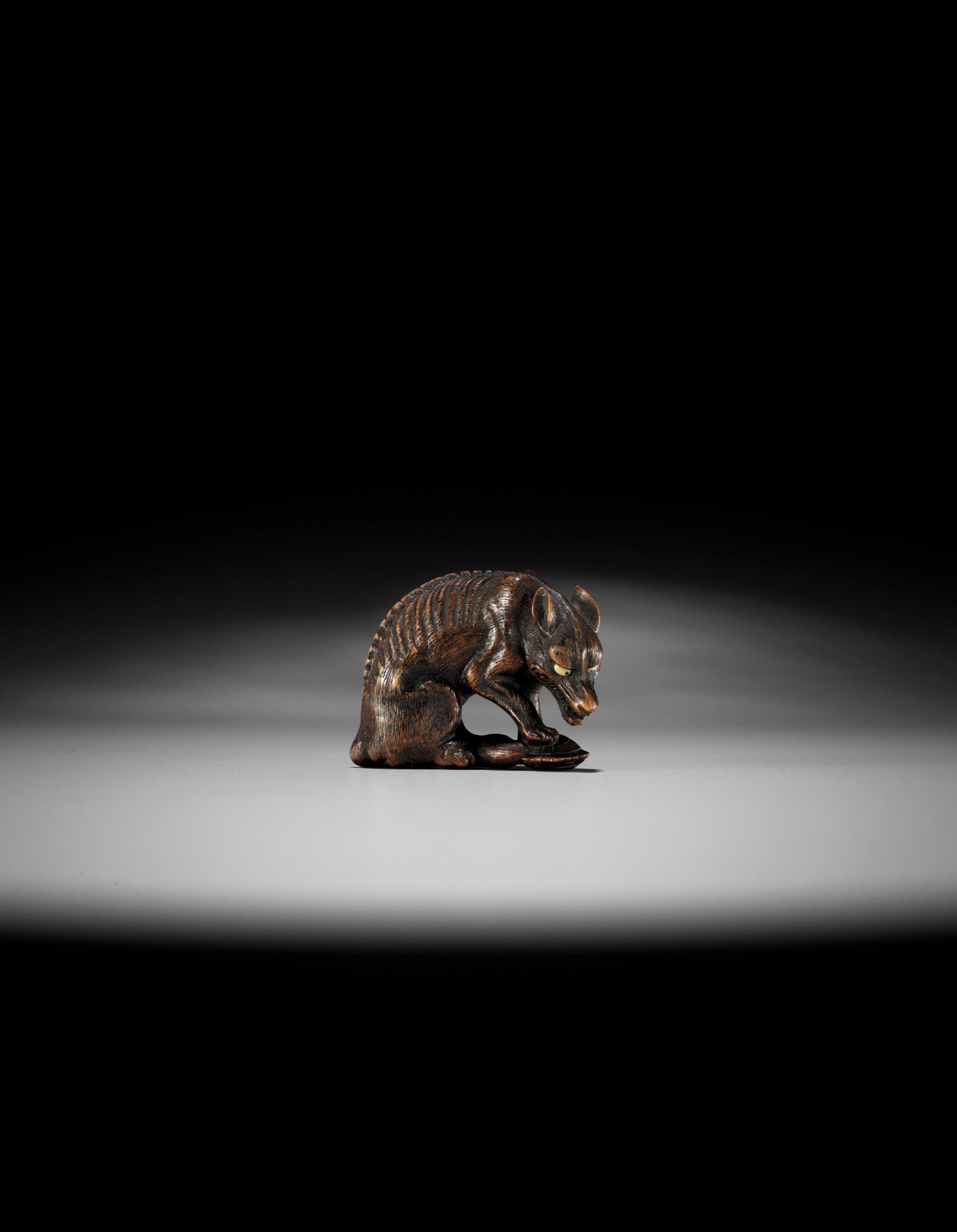
A SUPERB TOYOMASA SCHOOL WOOD NETSUKE OF AN EMACIATED WOLF WITH TORTOISE
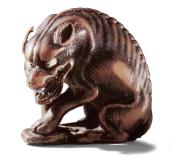



School of Naito Toyomasa (1773-1856), unsigned
Japan, Sasayama, Tanba Province, 19th century
Very finely carved as a voracious, emaciated wolf, or yama-inu (mountain dog), its head lowered as it salivates over a small tortoise which has retracted into its shell. The artist strikes a delicate balance between dramatic effect, humor, and anatomical precision, the yama-inu being depicted not in a realistic manner but rather in an exaggerated, dramatical parody, while the bones and musculature are carved with remarkable naturalism. The eyes are inlaid in stained bone with incised, dark pupils. Natural himotoshi. The work is unsigned, however contributed to the school of Naito Toyomasa (1773-1856) and most likely by his son Toyomasa II (Toyoyo, 1811-1883), who frequently signed his works using his father’s go (art name).
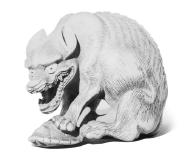
LENGTH 4.3 cm
Condition: Excellent condition, minor wear.
LITERATURE COMPARISON
Compare to a closely related wood netsuke, signed Toyomasa, illustrated in Zacke (1987)
Japanische Netsuke aus dem 18. und 19. Jahrhundert Inro und andere Sagemono Sammlung
Marcel Lorber, no. 120. Another closely related wood netsuke, signed Toyomasa, is illustrated in Zacke (1998) Netsuke – Sammlung

Pingotti, no. 117.
MUSEUM COMPARISON
Compare to a closely related wood netsuke, signed Toyomasa, in the Seattle Museum of Art, accession no. 33.476.
Estimate EUR 8,000
Starting price EUR 4,000
73 52
TOYOMASA: A SUPERB WOOD NETSUKE OF A HATCHING TENGU (TENGU NO TAMAGO)

 By Naito Toyomasa (1773-1857), signed Toyomasa 豊昌 Japan, Sasayama, Tanba Province, c. 1840, Edo period (1615-1868)
By Naito Toyomasa (1773-1857), signed Toyomasa 豊昌 Japan, Sasayama, Tanba Province, c. 1840, Edo period (1615-1868)
Published:
Eskenazi (1978) Eighteenth to Twentieth Century Netsuke, p. 27, no. 27 and illustrated in the Eskenazi advert on the back cover of the International Netsuke Collectors Society Journal, Vol.5, No. 4. Sydney L. Moss Ltd. (2006) More Things in Heaven and Earth, no. 48.
Finely carved as a tengu emerging from its egg, the left wing already spread over the outside of the shell, pulling itself out of the egg with skeletal fingers, the opening surrounded by neatly incised and darkly stained ‘cracks’, the eyes inlaid in mid-toned buffalo horn with drilled pupils, its prominent beak is open. The attractive grain of the wood is plainly visible on the smoothly polished surface of the shell. The tengu’s long hair, plumage, and the webbing of its wings are masterfully incised and stained for effect. The underside with the himotoshi and the signature TOYOMASA.
HEIGHT 4.6 cm
Condition: Very good condition, minor wear, the underside with few light surface scratches.
Provenance: Ex-collection Edward Wrangham. Eskenazi, London, 1978. Italian private collection, acquired from the above. Sydney L. Moss Ltd., London, 2005. French private collection, acquired from the above.
This remarkable netsuke is certainly one of the finest and largest examples from the series of hatching tengu carved by the celebrated Tanba master Naito Toyomasa (1773-1857).

Literature comparison: Compare a related wood netsuke of Tengu no Tamago by Naito Toyomasa, illustrated in Meinertzhagen, Frederick / Lazarnick, George (1986) MCI, Part B, p. 950, and another illustrated in Davey, Neil K. (1974) Netsuke: A comprehensive study based on the M.T. Hindson Collection, p. 240, no. 744.
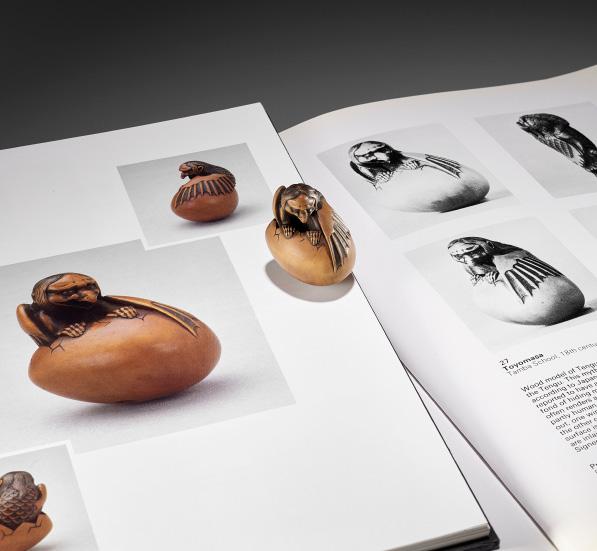
AUCTION COMPARISON
Compare a related wood netsuke of Tengu no Tamago by Naito Toyomasa, 4.1 cm wide, dated 19th century, at Bonhams, Netsuke from the Collection of Joseph and Elena Kurstin, 16 December 2022, New York, lot 61 (sold for 40,695 USD).

Estimate EUR 15,000
Starting price EUR 8,000
53


NAITO TOYOMASA: A SUPERB WOOD NETSUKE OF A MONKEY SCRATCHING ITSELF
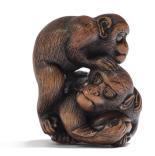




 By Naito Toyomasa (1773-1857), signed Toyomasa 豊昌 Japan, Sasayama, Tanba Province, c. 1840, Edo period (1615-1868)
By Naito Toyomasa (1773-1857), signed Toyomasa 豊昌 Japan, Sasayama, Tanba Province, c. 1840, Edo period (1615-1868)
Powerfully carved as a monkey sitting on one buttock and scratching the other, the eyes typically inlaid in pale translucent horn, the fur finely incised and darkly stained, natural himotoshi between the legs and between the left arm and leg. Signed underneath the left leg within an oblong reserve TOYOMASA.
HEIGHT 3.9 cm
Condition: Some old repairs to the fingers. Otherwise fine condition with minor wear.
Provenance: European private collection. Réne Scholten, acquired from the above in 2001. Scholten Japanese Art, New York, 2008. Sydney L. Moss Ltd., London, 2009. French private collection, acquired from the above.
LITERATURE COMPARISON
Compare a closely related wood netsuke of a seated monkey by Toyomasa illustrated in Kurstin, Joseph & Lorin, Gilles (2006) The Peacock’s Feather, Gentlemen’s Jewelry of Old Japan, no. 40.
AUCTION COMPARISON:
A related wood netsuke by Toyomasa of two monkeys fighting over a peach was sold at Tessier Sarrou, Arts D’ Asie, 13 December 2021, Paris, lot 60 (sold for 160,000 EUR). For a related wood netsuke by Toyomasa of three monkeys fighting over a peach see Bonhams, The Harriet Szechenyi Sale of Japanese Art, 8 November 2011, London, lot 155 (sold for 85,250 GBP).
Estimate EUR 20,000
Starting price EUR 10,000
77 54
55 TOYOSHIMA: A FINE WOOD NETSUKE OF A MONKEY EMERGING FROM A PEACH

 By Toyoshima, signed Toyoshima 豊嶋 Japan, Sasayama, Tanba Province, late 19th century
By Toyoshima, signed Toyoshima 豊嶋 Japan, Sasayama, Tanba Province, late 19th century
Intricately carved as a worm-eaten peach that has split open to one side, a monkey using the gnarled stem to pull himself out of the giant fruit, the stem finely stippled and issuing leaves with veins which are neatly incised to the top and raised in ukibori to the undersides. The peach with two asymmetrical himotoshi, the larger of which is generously excavated to accommodate the knot, and the signature TOYOSHIMA – the artist is a rarely encountered artist from the Tanba school.
LENGTH 3.6 cm
Condition: Good condition, minor wear, small chip to one leaf, minor age cracks.
AUCTION COMPARISON
Compare a related wood netsuke by Toyoshima of a dragon in a mikan, 4.1 cm wide, at Lempertz, 9 June 2017, Cologne, lot 552 (sold for 2,356 EUR). Also compare a related wood netsuke of an immortal emerging from a peach, by Toyomasa, at Bonhams, Fine Japanese and Korean Art, 20 March 2019, New York, lot 273 (sold for 7,575 USD).
Estimate EUR 3,000
Starting price EUR 1,500
78
TOYOMASA: A FINE WOOD NETSUKE OF A DRAGON IN A MIKAN

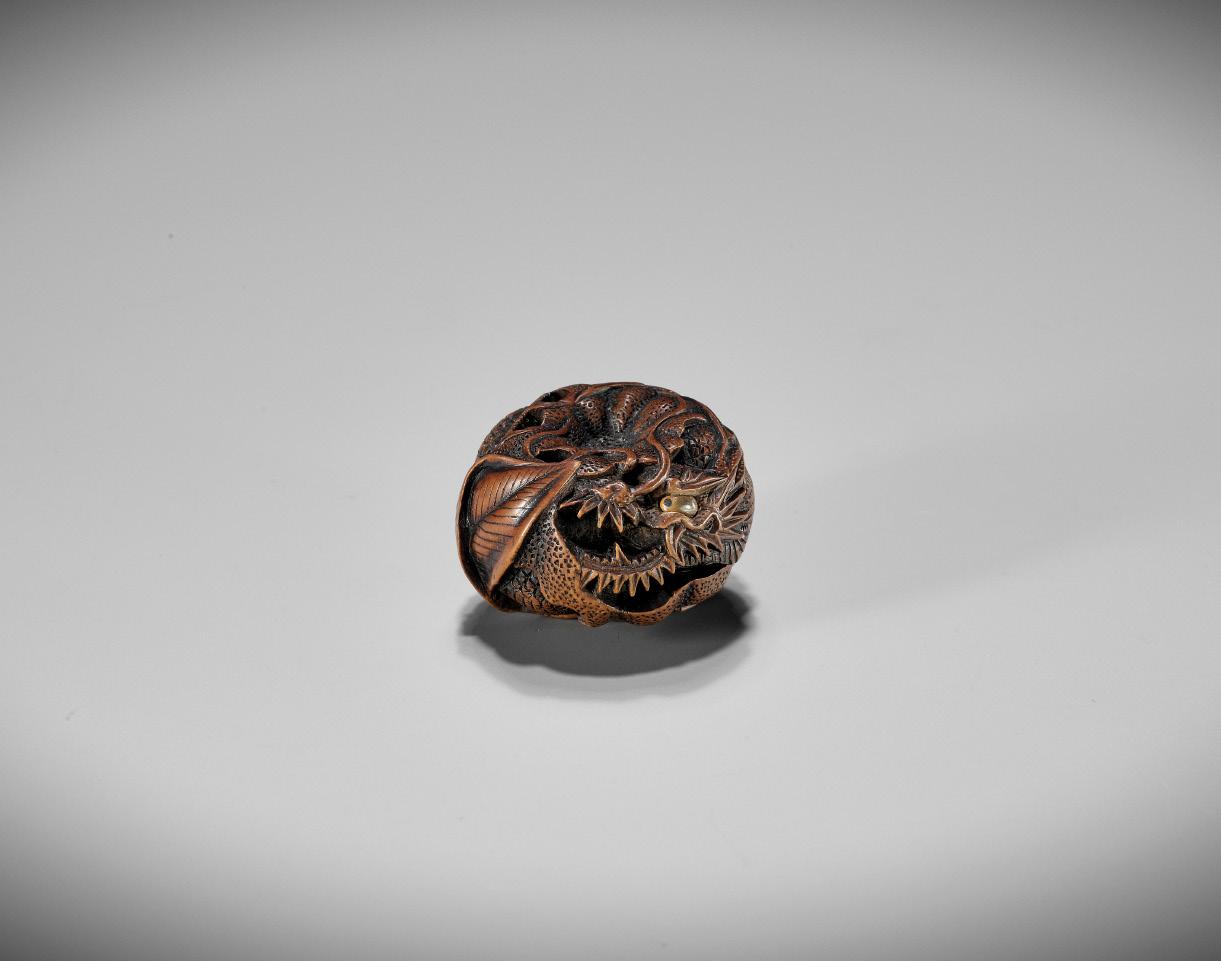 By Naito Toyomasa (1773-1857), signed Toyomasa 豊昌 Japan, Sasayama, Tanba Province, 19th century, Edo period (1615-1868)
By Naito Toyomasa (1773-1857), signed Toyomasa 豊昌 Japan, Sasayama, Tanba Province, 19th century, Edo period (1615-1868)
A finely carved wood netsuke depicting a dragon inside a mikan (tangerine) with crisply carved scales, large antler-like horns and flaming whiskers. The dragon is bursting through the soft flesh of the mikan, forming a dramatic, dynamic, and compact composition. The visible eye is inlaid in pale, translucent horn. Himotoshi through the stem which issues a large leaf with finely worked ukibori veins. Signed within an oval reserve TOYOMASA.
LENGTH 3.5 cm
Condition: Excellent condition, minor wear.
Provenance: A noted private collection, USA.
This popular model was carved by several members of the Tanba school and was likely utilized to test the skill of a pupil as it exhibits a remarkable number of carving techniques and textures such as sukashibori (openwork) and ukibori. The present netsuke is certainly one of the better examples of this model and is very likely by the master himself.
AUCTION COMPARISON
Compare to a closely related wood netsuke of a dragon in a mikan, signed Toyomasa, at Lempertz, The Kolodotschko Collection of Netsuke II, 6 December 2014, Cologne, lot 838 (sold for 2,604 EUR).
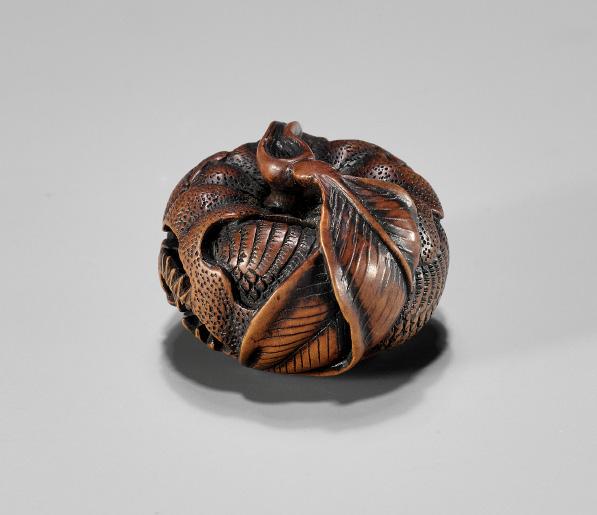
Estimate EUR 2,500
Starting price EUR 1,200
79
56
57 TOYOKAZU: A FINE TANBA SCHOOL
Superbly carved as a seated shishi turning its head curiously, the face with a prominent reishi nose and large inlaid eyes of pale translucent horn with dark pupils. The details are very finely carved – the mythical lion dog has a thick bushy tail, curling mane, and finely incised fur, accentuated with black staining for effect, as is typical for the Tanba school artist. Natural himotoshi, the signature TOYOKAZU within an oval reserve.

LENGTH 3.9 cm
Condition: Very good condition with minor wear and traces of use. The left eye with a small chip.
Provenance: Ex-collection Nelson and Happy Rockefeller. Nelson Aldrich Rockefeller (1908-1979) was an American businessman and politician who served as the 41st vice president of the United States from 1974 to 1977.

Portrait of Nelson and Happy Rockefeller. Courtesy of the Rockefeller Archive Center
Shugasai Toyokazu is widely regarded as the most accomplished pupil of Naito Toyomasa (1773-1856).
AUCTION COMPARISON
Compare to a closely related wood netsuke of two shishi, by Toyokazu, at Zacke, Fine Netsuke & Sagemono, 29 October 2021, Vienna, lot 82 (sold for 6,320 EUR).

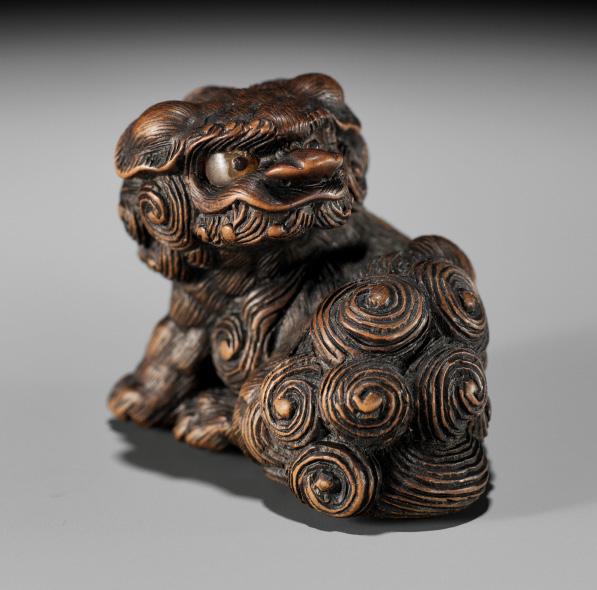
Estimate EUR 4,000
Starting price EUR 2,000
80
WOOD NETSUKE OF A SHISHI
By Shugasai Toyokazu, signed Toyokazu 豊一 Japan, Sasayama, Tanba province, mid-19th century, Edo period (1615-1868)
A FINE TANBA SCHOOL WOOD NETSUKE OF A RECUMBENT BOAR



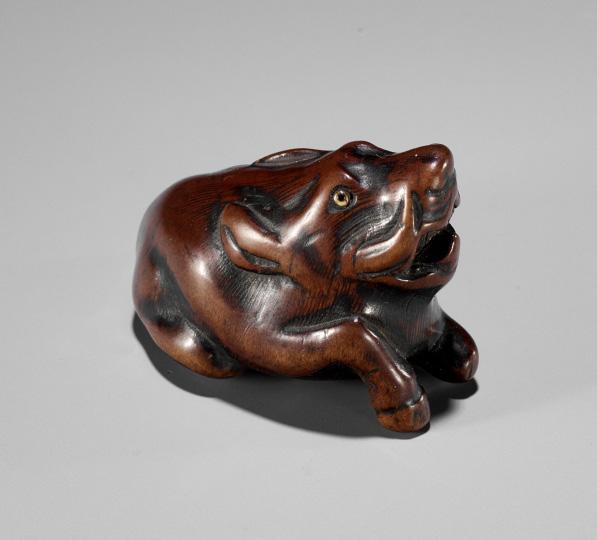
Unsigned Japan, Tanba province, late 18th to early 19th century, Edo period (1615-1868)
The baying animal depicted in a reclining posture, its legs held close to the body or tucked underneath for compactness, the hairwork finely incised and beautifully worn. The eyes are double inlays of pale and dark horn. Large, asymmetrical himotoshi underneath. The wood bearing a beautiful, unctuous, chocolate-brown patina.
LENGTH 4.7 cm
Condition: Very good condition with minor surface wear and traces of use, including some wear inside the himotoshi. One eye is replaced.
LITERATURE COMPARISON
The present netsuke belongs to a group of expressive wood boar netsuke which are attributed to the early production of the Tanba school, whose founder was Naito Toyomasa (1773-1856). Compare to an unsigned wood netsuke of a boar illustrated in color in Lazarnick, George (1981) Netsuke & Inro Artists, and How to Read Their Signatures (LNIA), Vol. 1, p. 70.
AUCTION COMPARISON
Compare to a closely related wood netsuke by Tsunenori, Tanba province, at Zacke, Fine Netsuke & Sagemono, 4 November 2022, Vienna, lot 41 (sold for 9,750 EUR).
Estimate EUR 3,000
Starting price EUR 1,500
81 58
GYOKUMIN: A FINE AND RARE NAGOYA SCHOOL WOOD NETSUKE OF RAIJIN CUTTING A CUCUMBER
By Gyokumin, signed Gyokumin 玉珉 and kakihan Japan, Nagoya, late 18th to early 19th century, Edo period (1615-1868)
Published: Meinertzhagen, Frederick / Lazarnick, George (1986) MCI, Part A, p. 97 (unillustrated).
A remarkably bold and compact netsuke, the darkened wood bearing a superb, unctuous patina, the thunder god Raijin seated before his taiko drum, one leg folded underneath, the other supporting the drum, and cutting a cucumber issuing a cloud-like vine. Raijin, dressed only in a tiger skin loincloth, is depicted in a typical manner with two horns, pronounced musculature, and long finely carved hair terminating in curls on his back. The eyes are inlaid in dark horn and the studs on the drum are inlaid in pale horn. The underside with generously excavated himotoshi and signature within an oval reserve GYOKUMIN and kakihan.

HEIGHT 4 cm
Condition: Very good condition, the surface beautifully worn. No notable damages.
Provenance: Formerly collection Henri T. Reiss, sold at Glendinning & Co., February 1918, London, lot 200 (part lot).
The subject is highly unusual, the thunder god here engaging in the business of a kappa. Fuld’s Netsuke and Ojime Index lists only one other netsuke depicting this subject, which is by the Asakusa artist Eisai, sold at Sotheby’s in 1980.
Estimate EUR 3,000
Starting price EUR 1,500
59
MASASADA: A POWERFUL WOOD NETSUKE OF RAIJIN WITH DRUM



 By Masasada (Masakazu), signed Masakazu 昌貞 Japan, probably Tanba, early 19th century, Edo period (1615-1868)
By Masasada (Masakazu), signed Masakazu 昌貞 Japan, probably Tanba, early 19th century, Edo period (1615-1868)
A powerful wood netsuke of the thunder god Raijin squatting, wearing a large drum strapped to his back and holding a geta with both hands in front of him. The oni-like deity is portrayed with boldly carved musculature and well-defined anatomy. In contrast, his facial features are humoristic, animated and imbued with originality and character – very typical for this rare artist. Raijin has inlaid horns, teeth and fangs, and the studs on the drum and his eyes are inlaid in dark wood. Good himotoshi through the deity’s back and underside and the signature in a rectangular reserve underneath - MASAKAZU, however the artist is known as Masasada 昌貟
LENGTH 3.4 cm
Condition: Very good condition with minor wear including some tiny nicks and a small loss to one inlay of the drum.
Provenance: Collection Prof. Dr. Henk C. Hoogsteden, Rotterdam, purchased from Nohara Japanese Art, Belgium.
LITERATURE COMPARISON
For a similar model of a Raijin see Meinertzhagen, Frederick / Lazarnick, George (1986) MCI, Part A, p. 430. For a discussion on the artist see International Netsuke Society Journal, Vol. 30, no. 3, pp. 22-26, where Jay Hopkins suggests that the artist is probably of Tanba origin.
AUCTION COMPARISON
A closely related wood netsuke, by Masasada, was sold at Zacke, Fine Netsuke & Sagemono, 25 September 2020, Vienna, lot 93 (sold for 5,688 EUR).
Estimate EUR 5,000
Starting price EUR 2,400
83 60
61
HOMIN: A GOOD WOOD NETSUKE OF RAIJIN WITH BATHING WOMAN



By Homin, signed Homin 法眠 Japan, early 19th century, Edo period (1615-186)
Boldly and amusingly carved as Raijin, having descended to earth on a cloud, resisting the advances of a young woman sitting in a tub, who is trying to drag him down to her, while he makes a gesture with his finger in his mouth akin to a fishhook, perhaps knowing that he will not be able to resist much longer. The details are finely incised and darkly stained. Note the beautifully carved, wispy cloud which partially engulfs the tub. The underside with two himotoshi and signed HOMIN within a rectangular reserve.
HEIGHT 4.2 cm
Condition: Very good condition, appealingly worn.
Provenance: Old private collection in Berlin, Germany. Kunsthandel Klefisch, 6 December 1997, Cologne, lot 303. German private collection, acquired from the above.
AUCTION COMPARISON
Compare a closely related wood netsuke by Sensei, 4.3 cm high, dated c. 1800, at Galerie Zacke, Fine Netsuke & Sagemono, 29 October 2021, Vienna, lot 131 (sold for 4,803 EUR).
Estimate EUR 3,000
Starting price EUR 1,500
84
A POWERFUL NAGOYA SCHOOL WOOD NETSUKE OF A RAIJIN DISCHARGING A STORM




Published: Aalderink Oriental Art (1985) The Buzaglo Collection of Fine Netsuke, Exhibition catalog, no. 250.
A remarkably powerful and well-sized netsuke, depicting the onehorned thunder god sitting on a large, wispy cloud, his thunder drum with drumsticks strapped to his back, looking downwards at a pouch from which he pulls the wind out. His expression, with inlaid pupils of dark horn, is quite amusing as he is lamenting over yet another day at work. The wood of a beautiful dark-brown tone and bearing a fine patina. Natural himotoshi and signed to the side of the horn-studded drum KOICHI.
HEIGHT 3.3 cm, LENGTH 4 cm
Condition: Good condition with some old chips, few nicks here and there, and age cracks. Beautiful, deep patina.
Provenance: Collection Sylvain Buzaglo (1908-1967), Amsterdam.
MUSEUM COMPARISON
Compare a related wood netsuke of Raiden by Tomokazu, in the Ashmolean Museum, Oxford, accession number EA1956.1721.
AUCTION COMPARISON
Compare to a wood netsuke depicting the same subject, by Nanmusai, at Zacke, Fine Japanese Art, 2 December 2022, Vienna, lot 211 (sold for 4,160 EUR).
Estimate EUR 2,500
Starting price EUR 1,200
85
62
By Koichi, signed Koichi 光一 Japan, Nagoya, early 19th century, Edo period (1615-1868)
MASATOSHI: A FINE NAGOYA SCHOOL WOOD NETSUKE OF A COWERING ONI DURING SETSUBUN

 By Masatoshi, signed Masatoshi 正利 Japan, Nagoya, first half of 19th century, Edo period (1615-1868)
By Masatoshi, signed Masatoshi 正利 Japan, Nagoya, first half of 19th century, Edo period (1615-1868)
The muscular oni cowered into a ball, forming a compact composition, trying to avoid the beans being thrown at him during the oni-yarai ceremony on Setsubun day. The three beans on his back are inlaid in light-stained wood. The underside shows the finely carved face with a grim expression and the two superbly carved feet forming the cord attachment. Signed within a rectangular reserve on the loincloth MASATOSHI.
LENGTH 3.2 cm
Condition: Excellent condition, minor wear. Fine patina. Provenance: Collection Prof. Dr. Henk C. Hoogsteden, Rotterdam, purchased at Lempertz, The Kolodotschko Collection of Netsuke II, 6 December 2014, Cologne, lot 773.
AUCTION COMPARISON
Compare to a closely related wood netsuke by Masakazu at Lempertz, The Kolodotschko Collection of Netsuke IV, 5 December 2015, Cologne, lot 709 (sold for 2,480 EUR).


Estimate EUR 2,000
Starting price EUR 1,000
86 63
MASAKAZU: A WOOD NETSUKE OF A COWERING ONI DURING SETSUBUN
 By Masakazu, signed Masakazu 正一 Japan, Nagoya, first half of 19th century, Edo period (1615-1868)
By Masakazu, signed Masakazu 正一 Japan, Nagoya, first half of 19th century, Edo period (1615-1868)
The oni cowering underneath a kasa (straw hat) trying to shield himself from a barrage of roasted beans being thrown at him during the oni-yarai ceremony on Setsubun day. His attempt is somewhat futile as one of the beans has hit his head, two further ones being carved on top of the hat. The worn kasa is executed with intricate detail and the body of the oni underneath shows extremely fine carving with powerfully accentuated muscles and a neatly incised tiger skin loincloth. The visible eye is inlaid in bone. ‘Natural’ himotoshi through the limbs and signed MASAKAZU within a polished reserve.
LENGTH 3.4 cm
Condition: Excellent condition, minor wear. Fine patina.
Provenance: From the collection of the German conductor Ferdinand Leitner (1912–1996), purchased from Kunsthandel Klefisch, Cologne, in 1978. Leitner studied under Franz Schreker, Julius Prüwer, Artur Schnabel and Karl Muck. Among his more than 300 recordings is a celebrated recording of Ferruccio Busoni’s Doktor Faust. He also conducted the Berlin Philharmonic for Wilhelm Kempff’s 1961 cycle of Beethoven’s piano concertos.

AUCTION COMPARISON
Compare to a near-identical wood netsuke by Masakazu sold at Zacke, Fine Netsuke & Sagemono, 16 April 2021, Vienna, lot 139 (sold for 3,172 EUR).




Estimate EUR 2,000
Starting price EUR 1,000
The German conductor Ferdinand Leitner (1912-1996) rehearsing with the Bamberg Symphony orchestra
87
64
65 MASANAO: A RARE WOOD NETSUKE OF AN ONI TRAPPING SHOKI
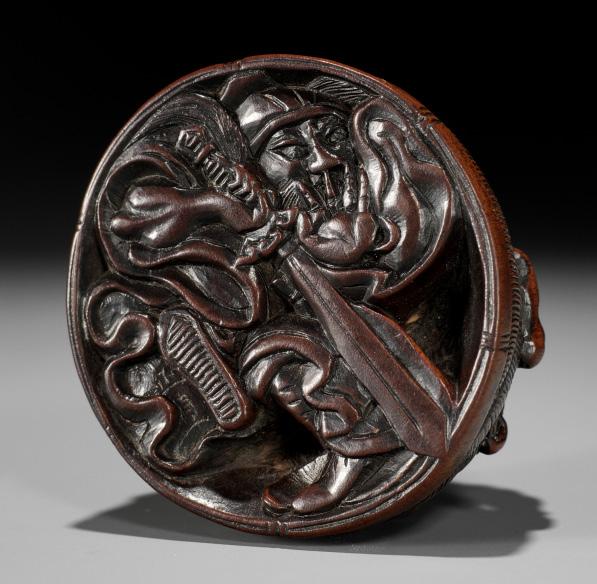
By a member of the Masanao family, signed Masanao 正直 Japan, Yamada, Ise Province, 19th century, Edo period (1615-1868)
Finely carved, the oni spread out over a neatly detailed straw basket, peering backwards, the pupils minutely inlaid in dark horn at the corners of the eyes, the mischievous devil pressing his weight down in an effort to contain the demon queller Shoki who is trapped underneath. Shoki in return tries to push himself off the ground, sword drawn, his scabbard piercing through to the other side. The himotoshi are cleverly integrated into the design, underneath Shoki’s feet, and the signature is located within a fold of the robe – MASANAO.
LENGTH 3.9 cm
Condition: Very good condition, minor wear. Fine, dark patina. Provenance: Collection Prof. Dr. Henk C. Hoogsteden, Rotterdam, purchased from Paul Rutten Asiatic & Tribal Art, Amsterdam, in 2010.
The subject appears to be unrecorded for the Masanao family and is usually associated with Kano Tomokazu of Gifu.
AUCTION COMPARISON
A related wood netsuke by Tomokazu was sold at Zacke, Fine Netsuke, Sagemono & Okimono, 27 April 2019, Vienna, lot 266 (sold for 12,640 EUR). Another related wood netsuke by Masakazu was sold at Zacke, Fine Japanese Art, 27 May 2022, Vienna, lot 237 (sold for 6,952 EUR).




Estimate EUR 3,000
Starting price EUR 1,500
88
66
AN INLAID WOOD NETSUKE OF A RECLINING ONI AT SETSUBUN
Unsigned Japan, 19th century, Edo period (1615-1868)
A finely carved and darkly stained wood netsuke of a terrified demon sprawling on the ground, attempting to shield itself from being pelted by beans, three of which have hit him, inlaid in bone. The oni’s face is well detailed with dark-inlaid eyes below raised brows, the horns poking through the neatly incised curled hair, the mouth wide open in an agonized scream revealing tongue and teeth. The demon is wearing an incised lower garment, similarly detailed shin guards, and a shawl tied around his waist and shoulder, a buckle in front is inlaid with stag antler petals encircling a coral bead. Himotoshi to the side of the lower garment and the right leg.


LENGTH 5.4 cm
Condition: Excellent condition with minor wear.
Provenance: Galerie Yamato, Paris, 2004. French private collection, acquired from the above.
A classic subject, interpreted here in an unusual way.
The Setsubun festival is celebrated during the first day of spring and includes the rite of oni-yarai or mame-maki, where roasted beans are thrown at oni to rid the coming year of any demons and disease-bringing spirits.
Estimate EUR 2,500
Starting price EUR 1,200
89
MASAKAZU: A SUPERB NAGOYA SCHOOL WOOD NETSUKE OF KIYOHIME
By Masakazu, signed Masakazu 正一 Japan, Nagoya, first half of 19th century, Edo period (1615-1868)
The vengeful monster Kiyohime depicted here in humanoid form with long flowing hair, leaning against the Dojo-ji bell, hunched forwards with a menacing expression, one hand grasping the double-dragon handle of the temple bell, the other holding a striker. The details are superbly carved, the bell is adorned with raised studs and minutely carved rain dragons, and the reddish cherry wood bears a fine patina. Himotoshi through the bell and signed underneath MASAKAZU.
HEIGHT 4 cm
Condition: Excellent condition, minor wear.
Provenance: Ex-collection Collection Prof. Dr. Henk C. Hoogsteden, Rotterdam, purchased at Lempertz, The Papp Collection of Netsuke, 16 June 2018, Cologne, lot 1052. Formerly collection Papp, collection no. 449, purchased from Helmut Laudenbach, Berg, January 1989.
In this tragic story, Kyohime fell in love with a Buddhist monk named Anchin but was rejected. In despair she pursues the monk and transforms herself into a Hannya-like demon with a snake body and horned head. The pursued Anchin hides under a temple bell. When she discovers him there, she wraps her snake body around the bell and the glow of her passion melts the metal and burns the monk hiding in the bell.
LITERATURE COMPARISON
Compare to a closely related wood netsuke of Kiyohime, by Masakazu, depicted in a similar posture, illustrated in Eskenazi (1997) Japanese Netsuke, Ojime and Inro from the Dawson Collection, pp. 24-25, no. 25. Another closely related wood netsuke of Kiyohime, by Masakazu, depicted in a different posture, is illustrated in Jirka-Schmitz Patrizia, The World of Netsuke, The Werdelmann Collection at the Museum Kunst Palast Düsseldorf, p. 83, no. 263.
Museum comparison: Compare to a closely related wood netsuke of Kiyohime, depicted in a similar posture as the present netsuke, by Tadatoshi, late 18th century, Nagoya, at the Walters Art Museum, accession number 61.236.

AUCTION COMPARISON
Compare to a related wood netsuke, by Tametaka, depicting Kiyohime in a similar posture, at Zacke, Fine Netsuke & Sagemono, 4 November 2022, Vienna, lot 57 (sold for 6,175 EUR).



Estimate EUR 4,000
Starting price EUR 2,000
90 67


TAMETAKA: A SUPERB WOOD MASK NETSUKE OF A SHISHI
 By Tametaka, signed Tametaka 爲隆 with kakihan Japan, Nagoya, late 18th century, Edo period (1615-1868)
By Tametaka, signed Tametaka 爲隆 with kakihan Japan, Nagoya, late 18th century, Edo period (1615-1868)
Published: Sydney L. Moss Ltd. (2004) Outside the Box: Further Explorations in Japanese Netsuke and Lacquer, 2004, p. 34-35, no. 13.
Superbly carved, the scowling face with a hinged jaw opening to reveal the tongue and sharp teeth, the eyes with pupils inlaid in dark horn below furrowed brows, the broad nose with deeply hollowed nostrils, the neatly incised mane falling in heavy curls over the back of the head, the chin beard similarly carved, the forehead with eleven distinct star-shaped whorl designs, the underside with three square apertures, presumably a feature of the temple sculpture from which this netsuke is derived, forming the cord attachment behind the signature TAMETAKA with a kakihan.
LENGTH 4.2 cm
Condition: Very good condition with minor wear, few tiny nicks to the back, the underside with few microscopic chips near the hinge. Provenance: Max Rutherston, London, 2004. European collection P. Jacquesson, acquired from the above.
The Shishi mask originated in the rites of exorcism of Japanese protohistory. The original Japanese mask was absorbed into dance and drama in the seventh and eighth centuries when Gigaku and Bugaku were introduced from the Asian mainland. Unlike most masks, Shishi masks enjoyed an unrestricted and natural development, free of the shackles imposed by the prototypes. The shishi masked dance (shishimai) is performed to ward off disease and calamity. It originated as a religious ceremony but the excitement of the dance, the music, and the rhythms increased over the centuries, so that over time it was performed for entertainment rather than ritualistic purposes.

Tametaka is the earliest recorded netsuke artist from Nagoya and is listed in the Soken Kisho, the first publication on netsuke published in 1781. He is credited with the invention of the relief-carving technique (ukibori) associated with the Nagoya school.

LITERATURE COMPARISON
Shishi are a popular subject of Tametaka, mask netsuke by this carver are however extremely rare. A wood mask netsuke of an oni, also with a movable jaw, is recorded in Joly, Henri L. (1966) The W. L. Behrens Collection, Part 1, Netsuke, no. 88, however is unillustrated. Another wood mask netsuke by Tametaka, depicting Buaku, is illustrated in Meinertzhagen, Frederick / Lazarnick, George (1986) MCI, Part B, p. 857.
Estimate EUR 8,000
Starting price EUR 4,000
93 68
Attributed to Tametaka, unsigned Japan, Nagoya, 18th century, Edo period (1615-1868)
Superbly carved in dark-reddish wood as an ox with curved horns and realistically rendered spine, the hairwork executed in bold strokes, the high points beautifully worn and bearing a superb, unctuous patina, the young calf nestling up to the parent seeking warmth and pressing its muzzle into its parent’s side. The underside very finely carved, the legs tucked underneath the body for compactness, and with large, generously excavated himotoshi.
There appears to be some illegible remnants of kanji characters on the haunch where the signature is usually located. The boldly executed design, strong character, and idiosyncratic ‘ruggedness’, coupled with a clear 18th-century patina, strongly suggest the artist Tametaka, whom this netsuke is confidently attributed to.

LENGTH 5.1 cm
Tametaka is the earliest recorded netsuke artist from Nagoya and is listed in the Soken Kisho, the first publication on netsuke published in 1781. Oxen are to be considered extremely rare by this artist with only few examples recorded and this would be the only recorded example of an ox and calf.
Condition: Excellent condition with typical, old surface wear. Provenance: A noted private collection, USA.
LITERATURE COMPARISON
Compare to two wood netsuke depicting oxen by Tametaka in Lazarnick, George (1981) Netsuke & Inro Artists, and How to Read Their Signatures (LNIA), Vol. 2, p. 1075.
AUCTION COMPARISON
Compare to a related ebony wood netsuke of a recumbent ox by Ikkan, dated 19th century, at Bonhams, The Edward Wrangham Collection of Japanese Art Part I, 9 November 2010, London, lot 130 (sold for 10,200 GBP).




Estimate EUR 6,000
Starting price EUR 3,000
94
69
A SUPERB AND VERY RARE WOOD NETSUKE OF AN OX AND CALF, ATTRIBUTED TO TAMETAKA
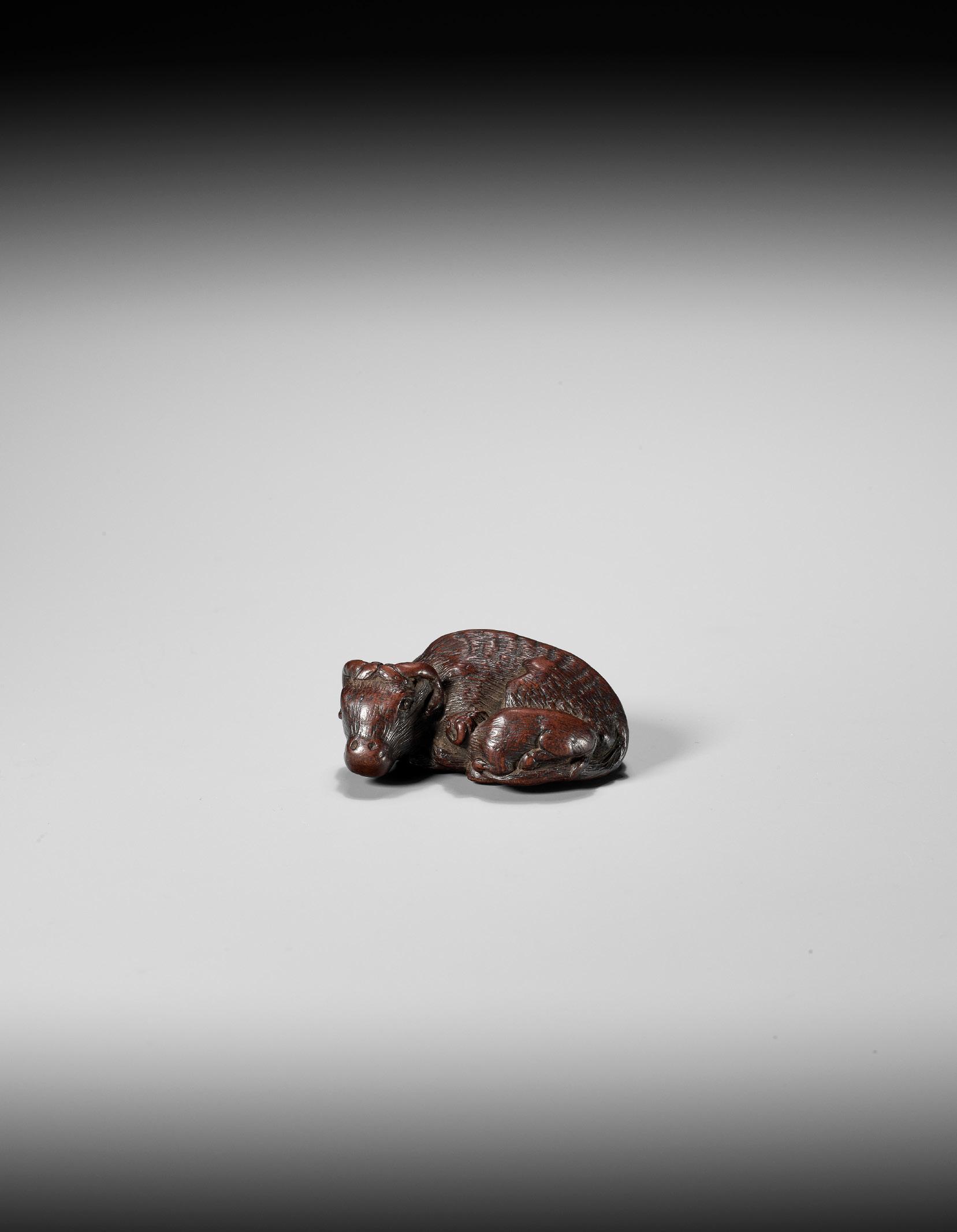
Finely carved in dark-reddish wood as a dog seated on his haunches, scratching his jowl with his right front paw, the animal well detailed with neatly incised fur, short floppy ears, narrowed eyes, a long snout, and a curled tail. Natural himotoshi between his left front and hind legs as well as his right front leg and neck.

LENGTH 4.5 cm
Condition: Small chip to the left front paw. Otherwise, good condition with minor expected wear and traces of use including a few tiny nicks.
Provenance: A noted private collection, USA.
The wood used, overall power and earthiness of the design, as well as the rugged yet fine execution, are reminiscent of Tametaka of Nagoya.
LITERATURE COMPARISON
Compare to a closely related dark wood netsuke of a puppy scratching its ear, signed Goto, illustrated in Barry Davies Oriental Art (2002) Netsuke and Inro from European Collections, no. 120.

AUCTION COMPARISON
Compare to a related wood netsuke of a dog, by Tametaka, at Bonhams, The Julius & Arlette Katchen Collection of Netsuke Part II, 10 May 2017, London, lot 117 (sold for 9,375 GBP).


Estimate EUR 3,000
Starting price EUR 1,500
96
70 A RARE DARK WOOD NETSUKE OF A DOG SCRATCHING ITS JOWL
Unsigned Japan, probably Nagoya, 18th century, Edo period (1615-1868)
Attributed to Tametaka, unsigned Japan, Nagoya, 18th century, Edo period (1615-1868)
A remarkably bold and powerful wood netsuke of a dragon coiling around itself, its body varying in thickness, forming a tactile, compact composition, the head and one of the claws resting on top, with flaming whiskers and finely incised scales. The underside shows the thick tail curling around itself, forming the natural himotoshi. The deep-reddish cherry wood beautifully worn with a fine, unctuous patina.

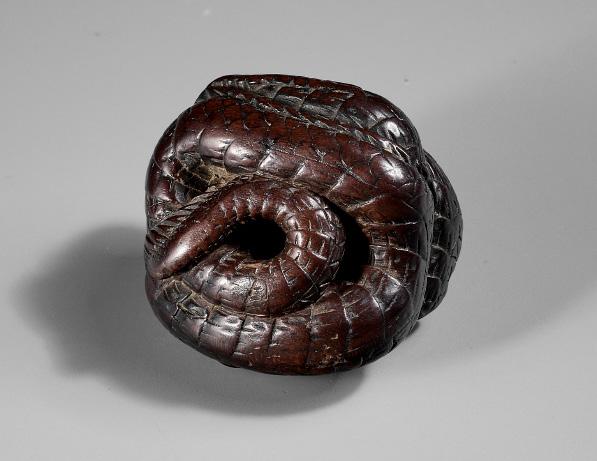
The netsuke is unsigned however confidently attributed to Tametaka, who is mentioned in the Soken Kisho of 1781.
LENGTH 3.8 cm
Condition: Very good condition with typical surface wear. Beautiful, deep patina.
AUCTION COMPARISON
Compare to a closely related wood netsuke of a dragon, by Tametaka, at Bonhams, Fine Netsuke from a French Private Collection, 4 November 2020, London, lot 61 (sold for 5,312 GBP). Also compare to another related ebony wood netsuke of a dragon, by Tametaka, at Sotheby’s, The Betty Jahss Collection of Netsuke Part I, 13 June 1991, London, lot 65.


Estimate EUR 4,000
Starting price EUR 2,000
97
71
A SUPERB DARK WOOD NETSUKE OF A COILED DRAGON, ATTRIBUTED TO TAMETAKA
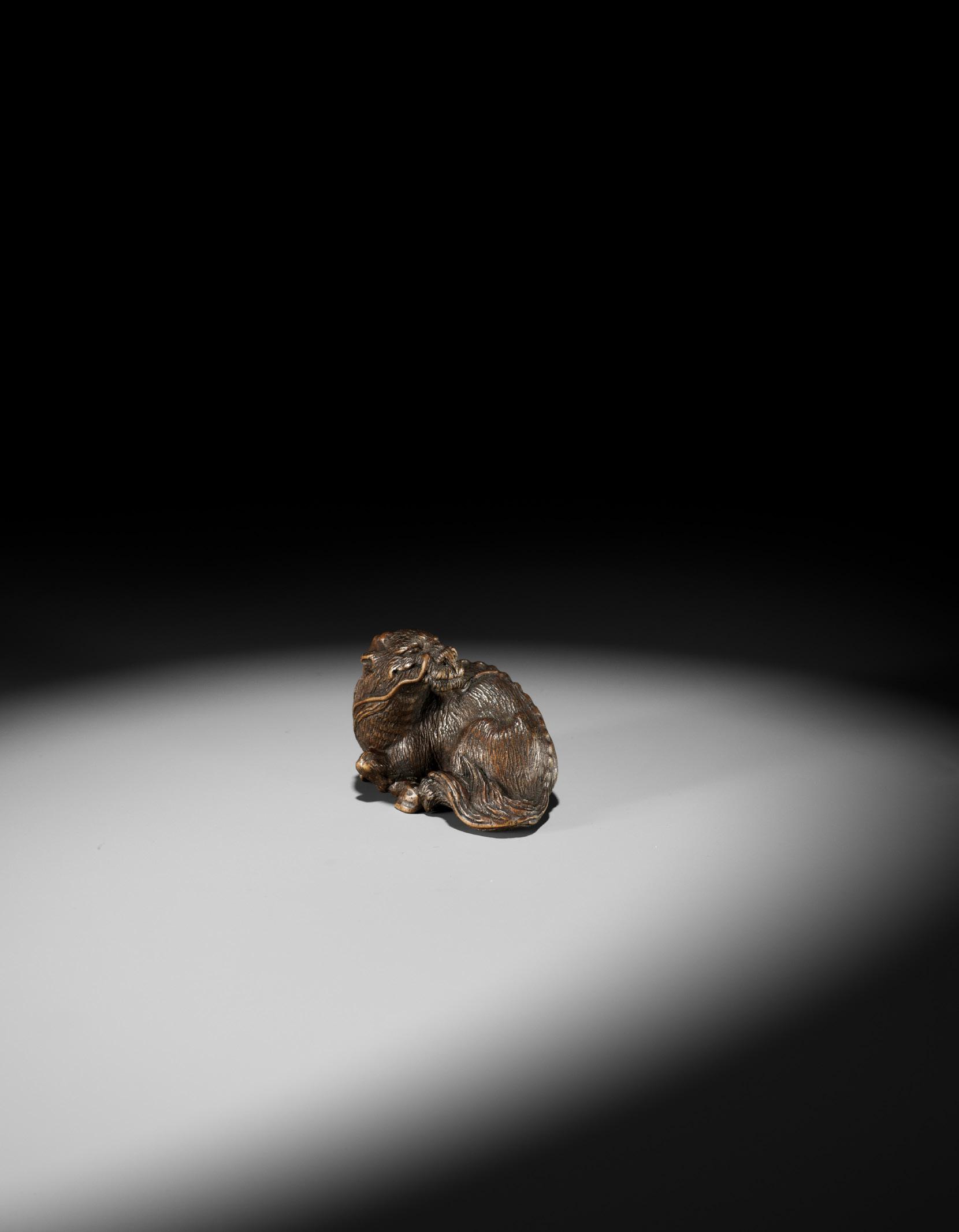
ICHIYU: A SUPERB NAGOYA SCHOOL WOOD NETSUKE OF A RECUMBENT KIRIN
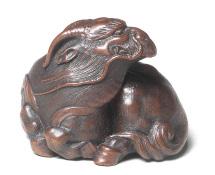
 By Ichiyu, signed Ichiyu 一友 Japan, Nagoya, 19th century, Edo period (1615-1868)
By Ichiyu, signed Ichiyu 一友 Japan, Nagoya, 19th century, Edo period (1615-1868)
Superbly carved with intricate details, depicting a recumbent twohorned kirin with long flowing whiskers, a well-carved mane, ridged spine, and finely incised, bushy tail which sweeps around its side. The legs are tucked close to the body, the two forelegs arched as the kirin lifts itself ever so slightly, the head turned backwards curiously. Natural himotoshi and signed ICHIYU within a shaped, polished reserve underneath.
LENGTH 3.7 cm
Condition: Very good condition, minor wear. Old repair to one of the whiskers.
Provenance: De-accessioned from the Metropolitan Museum of Art, New York. Sotheby’s, Netsuke, Ojime, Inro, 8 January 1981, Honolulu, lot 97. A noted private collection, USA.
This type of coveted kirin carving was likely invented by Ikkan of Nagoya and the model was treated with slight variations, generally increasing in intricacy, by several members of the Nagoya school lineage such as Ichimin, Ichiyu, Masatoshi and Masayuki.
LITERATURE COMPARISON
Compare to a closely related wood netsuke of a singled horn kirin by Masatoshi illustrated in Sydney L. Moss Ltd. (1993) Zodiac Beasts and Distant Cousins, no. 56.
AUCTION COMPARISON
Compare to a closely related wood netsuke of a recumbent kirin by Ikkan, sold at Bonhams, Tradition Travel Transition Japanese Art Across the Centuries, 4 November 2021, London, lot 6 (sold for 19,000 GBP). Also compare to a closely related wood netsuke of a recumbent kirin by Ichimin, sold at Quinn’s Auction Galleries, The Helen & Jack Mang Collection of Netsuke, 7 December 2007, Falls Church, Virginia, lot 218 (sold for hammer price 12,000 USD).


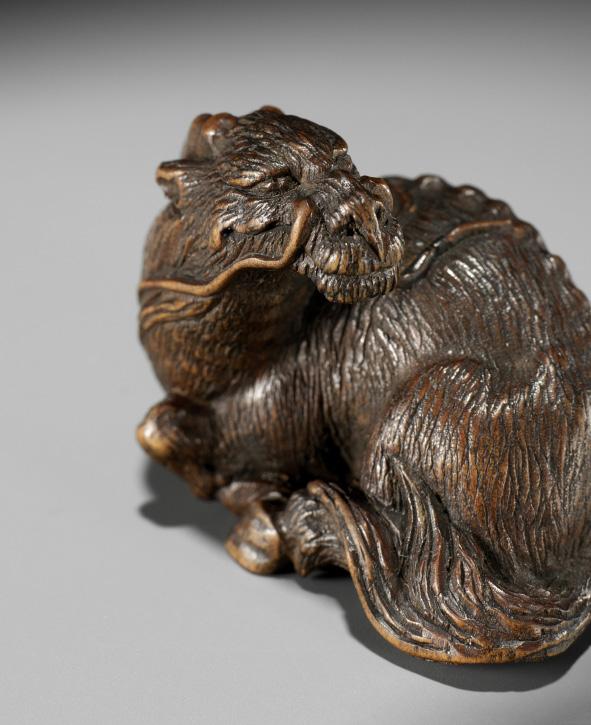
Estimate EUR 8,000
Starting price EUR 4,000
99 72
MASAMARU: A FINE WOOD NETSUKE OF A RECUMBENT HORSE
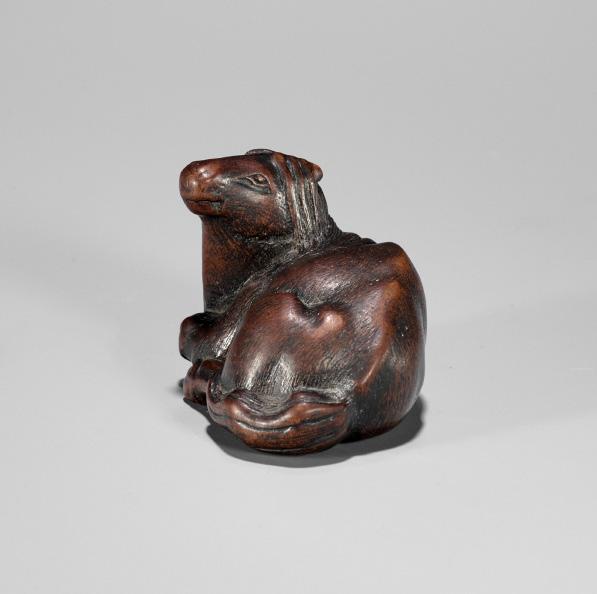
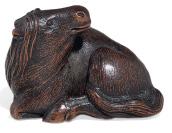
 By Masamaru, signed Masamaru 正丸 Japan, Nagoya, c. 1800, Edo period (1615-1868)
By Masamaru, signed Masamaru 正丸 Japan, Nagoya, c. 1800, Edo period (1615-1868)
Finely carved, the dark-reddish cherry wood beautifully smoothed and bearing a fine patina. The horse (uma) is sensitively crafted, rearing its head back over its left shoulder, the mane neatly incised and falling in tresses over its neck. The underside is equally well-carved, showing the legs with superbly carved hooves tucked underneath for compactness. Signed MASAMARU in a polished area on the haunch underneath.
LENGTH 3.7 cm
Condition: Very good condition, only very minor wear. Small repair to one ear. Superb patina.
Provenance: Ex-collection Philip Schneider (1908-1983), sold at Sotheby’s, Japanese Works of Art, 21 March 1997, New York, lot 318. A noted private collection, USA, acquired from the above.
The artist is a rare artist from the Nagoya school, his output being fairly limited and mostly focused on netsuke depicting shojo. The comparison of this netsuke with Ichiyu’s kirin (lot 72) and Masayasu’s goat (lot 74) is certainly instructive and interesting, particularly when comparing the undersides. The present horse netsuke is surely slightly earlier, and the three carvings together provide insight into the evolution of Nagoya carver’s techniques with more attention given to fur and an increased use of sukashibori (openwork), as netsuke became more ornamental during the 19th century, rather than being worn.
AUCTION COMPARISON
Compare to a closely related Nagoya school wood netsuke of a horse by Ittan was sold at Christie’s, Japanese Art & Design, 11 May 2011, London, lot 301 (sold for 3,750 GBP).
Estimate EUR 4,000
Starting price EUR 2,000
100
73
MASAYASU: A FINE WOOD NETSUKE OF A RECUMBENT GOAT



 By Masayasu, signed Masayasu 正保 to 刀 Japan, Nagoya, 19th century, Edo period (1615-1868)
By Masayasu, signed Masayasu 正保 to 刀 Japan, Nagoya, 19th century, Edo period (1615-1868)
Very finely carved, the goat’s head nobly raised, with elegantly curved horns, long sweeping tail, and ridged spine. The feet are kept close to the body or tucked underneath, forming a compact composition. The shaggy fur is sublimely carved, with subtle elevations between the individual hair strands. The dark-red cherry wood bears a fine patina. Natural himotoshi and signed within a polished area on the haunch MASAYASU to [carved by Masayasu].
LENGTH 4.3 cm
Condition: Very good condition, only very minor wear. Small repair to one ear. Fine patina.
Provenance: A noted private collection, USA.
Literature comparison: Compare a near-identical wood netsuke of a goat by Masatoshi in Sydney L. Moss Ltd. (1993) Zodiac Beasts and Distant Cousins, no. 57.
AUCTION COMPARISON
Compare to a near-identical wood netsuke of a goat by Masatoshi at Lempertz, Asian Art, 11 June 2022, Cologne, lot 407 (sold for 7,560 EUR). This is the same netsuke mentioned in the literature comparison.
Estimate EUR 5,000
Starting price EUR 2,400
101 74
A FINE WOOD NETSUKE OF A GOAT
Unsigned Japan, late 18th to early 19th century, Edo period (1615-1868)
A well-sized wood netsuke of a goat (hitsuji) with finely carved shaggy fur is shown in a reclining posture, looking back, the eyes inlaid in pale, translucent horn. The sensitively crafted animal has large, curved horns and a long chin beard which touches its body. The underside shows the well-carved hooves which are tucked under the body for compactness. Large, asymmetrical himotoshi underneath.



HEIGHT 4.1 cm, LENGTH 4.6 cm
Condition: Very good condition with minor expected wear and traces of use.
Estimate EUR 3,000
Starting price EUR 1,500
102 75
A FINE WOOD NETSUKE OF A RECUMBENT HORSE
Unsigned Japan, early 19th century, Edo period (1615-1868)
Published:
Gabor, Wilhelm (1999) Bulletin Franco-Japonais, no. 65, p. 42. Wilhelm, Gabor (Fall 1999) On the Continent, International Netsuke Society Journal, Vol. 19, No. 3, p. 56.
A dark plum wood netsuke finely carved as a recumbent horse looking back over its shoulder, well detailed with an attentive expression with subtly smiling mouth and almond-shaped eyes with dark pupils, the mane elegantly falling in strands to either side of the spine, the underside with the similarly carved tail and the drawn-in legs, natural himotoshi between the body and the hooves of the left legs.
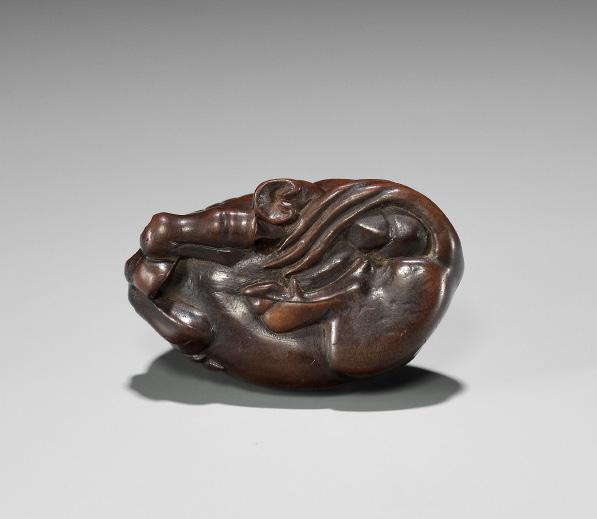
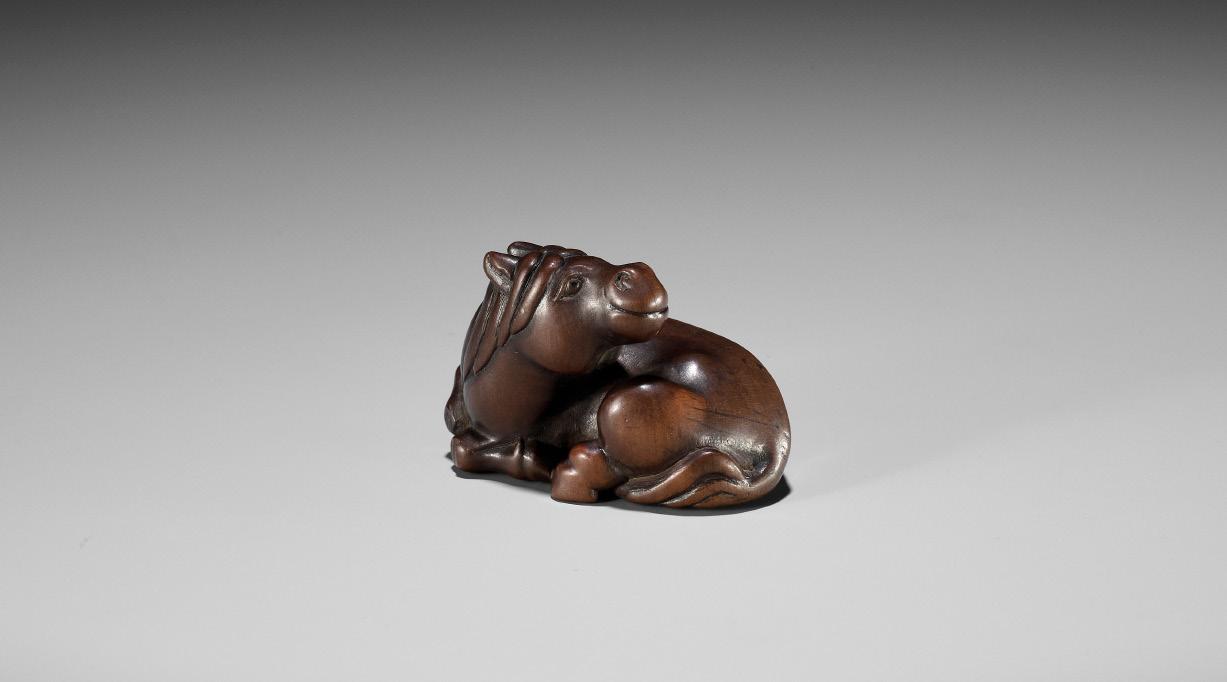

LENGTH 4.3 cm
Condition: Good condition, appealingly worn, tiny nicks, light surface scratches, the underside with a minor age crack, the front legs with small chips.
Provenance: Ex-collection Ganzl. Piasa, 2 June 1999, Paris, lot 440 (sold for 26,500 FRF). French private collection, acquired from the above.
Estimate EUR 3,000
Starting price EUR 1,500
103
76
ITTAN: A FINE WOOD NETSUKE OF A COILED RAT

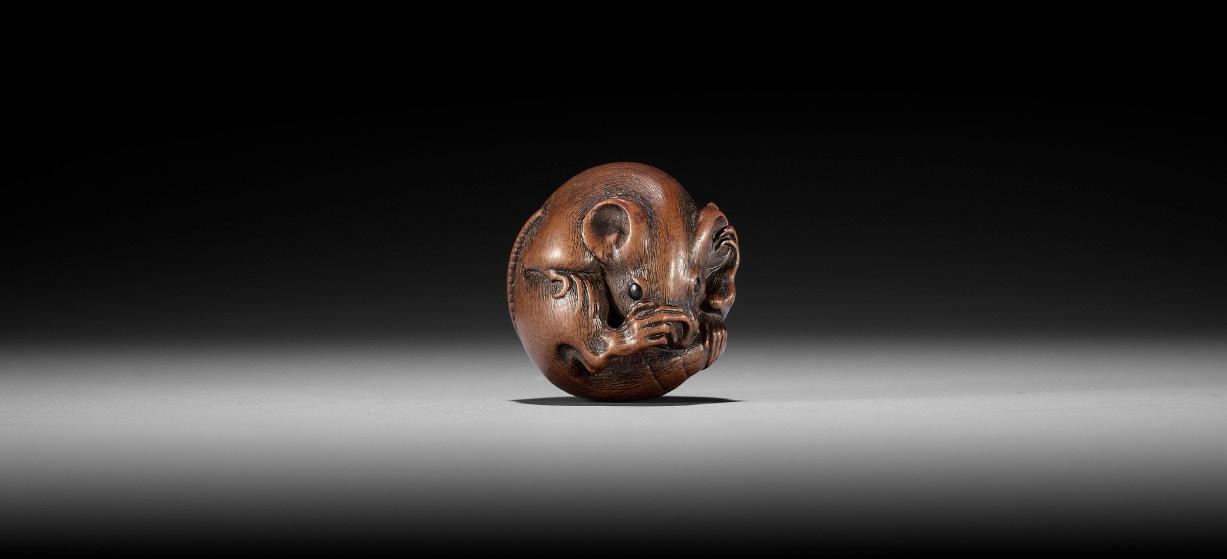 By Ittan, signed Ittan 一旦 with kakihan Japan, Nagoya, c. 1840, Edo period (1615-1868)
By Ittan, signed Ittan 一旦 with kakihan Japan, Nagoya, c. 1840, Edo period (1615-1868)
Published:
Lazarnick, George (1981) Netsuke & Inro Artists, and How to Read Their Signatures, vol. 1, p. 528.
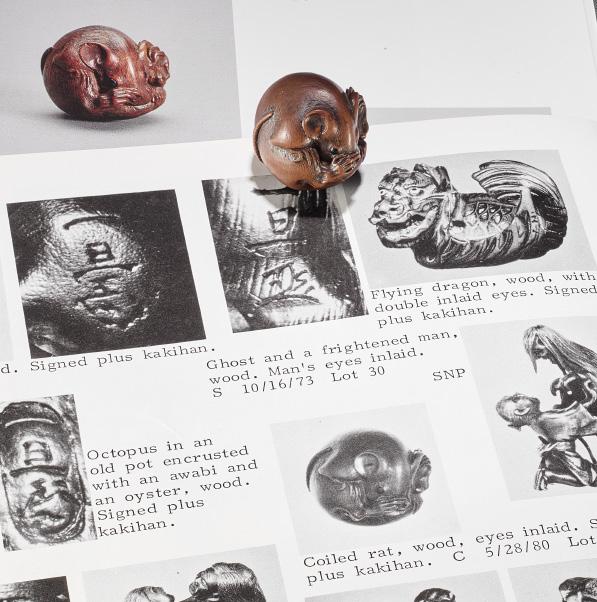
Barry Davies Oriental Art (1998) The Robert S. Huthart Collection of Non-Iwami Netsuke, no. 149.
Of ideal compact form, finely carved to depict a rat coiled into a ball, with one front paw holding the thick base of its sinuous tail, the hind paws grabbing its nose and left ear. The fur is neatly incised and the tail is well-detailed. The large eyes are inlaid with black wood. The underside with asymmetrical himotoshi and the signature ITTAN with a kakihan.
HEIGHT 2.9 cm
Condition: Good condition with minor wear, a small chip to one paw.
Provenance: Christie’s, 28 May 1980, London, lot 133. Ex-collection Robert S. Huthart, acquired from the above. Barry Davies Oriental Art, London, 1998. European private collection, acquired from the above. Sydney L. Moss, London, 2006. French private collection, acquired from the above.
This is very much the composition one expects of Masanao of Yamada and his followers, leaving the question of where it originated.
AUCTION COMPARISON
Compare a closely related wood netsuke of a coiled rat by Ittan at Sotheby’s, Netsuke from the Collection of Raymond and Frances Bushell, 21 March 2000, New York, lot 57. Compare also a similar wood netsuke of a coiled rat by Masanao of Yamada, 3.7 cm high, at Galerie Zacke, Fine Netsuke & Sagemono, 4 November 2022, Vienna, lot 44 (sold for 7,150 EUR).

Estimate EUR 5,000
Starting price EUR 2,400
104 77
YOSHIHISA: A FINE WOOD NETSUKE OF A COILED RAT


 By Yoshihisa, signed Yoshihisa 義久 Japan, Nagoya, early 19th century, Edo period (1615-1868)
By Yoshihisa, signed Yoshihisa 義久 Japan, Nagoya, early 19th century, Edo period (1615-1868)
Of compact form, well carved as a rat curled up into a half ball, cleaning itself, scratching itself behind the ear with one foot, the other leg forming the himotoshi with the curved tail, the eyes inlaid with yellowish, translucent horn, the fur and tail neatly incised, one hind leg signed YOSHIHISA within an oblong reserve.
LENGTH 3.5 cm
Condition: Good condition, minor wear and traces of use. A repaired crack through the body with associated traces of adhesive.
Yoshihisa is an excellent but little-known carver, whose style is reminiscent of the Minko school. See Bushell, Raymond (1961) The Netsuke Handbook by Ueda Reikichi, p. 308, and Davey, Neil K. (1974) Netsuke: A comprehensive study based on the M.T. Hindson Collection, p. 219. As evidenced by his carvings of rats, however, he was more likely a member of the Nagoya school.
Museum comparison: Compare a related wood netsuke of a rat on a peapod by Yoshihisa, 4.4 cm long, dated approx. 1800-1866, in the Asian Art Museum of San Francisco, object number B70Y1.
AUCTION COMPARISON
Compare a closely related wood netsuke of a coiled rat by Yoshihisa at Sotheby’s, The Betty Jahss Collection of Netsuke Part I, 13 June 1991, London, lot 70 (estimate 8,000-10,000 GBP).
Estimate EUR 4,000
Starting price EUR 2,000
105 78
ITTAN: A SUPERB WOOD NETSUKE OF SEVEN RATS IN A PYRAMID
By Ittan, signed Ittan 一旦 with kakihan Japan, Nagoya, c. 1850, Edo period (1615-1868)
Intricately carved and of compact design, depicting seven rats of different sizes piled on top of each other in a pyramid, two of them trapped in the middle of the pile, one of which is upside-down. One of the two rodents at the bottom clutches an edamame bean – presumably this is the reason they are fighting. All the eyes are inlaid in dark buffalo horn and the incisors in bone. The underside with edamame, a leaf, and a rat’s paw forming the natural himotoshi, as well as the signature within an oblong reserve ITTAN with a kakihan.
HEIGHT 3.7 cm
Condition: Very good condition, minor wear, possibly some replaced inlays to eyes.
Provenance: Ex-collection Adrienne Barbanson. Bonhams, Fine Netsuke from the Adrienne Barbanson Collection, 13 May 2013, London, lot 6 (sold for 7,250 GBP). French private collection, acquired from the above.

MUSEUM COMPARISON
Compare a closely related wood netsuke of seven rats by Ittan, formerly in the collection of Raymond Bushell and now in the Los Angeles County Museum of Art, accession number M.87.263.117.
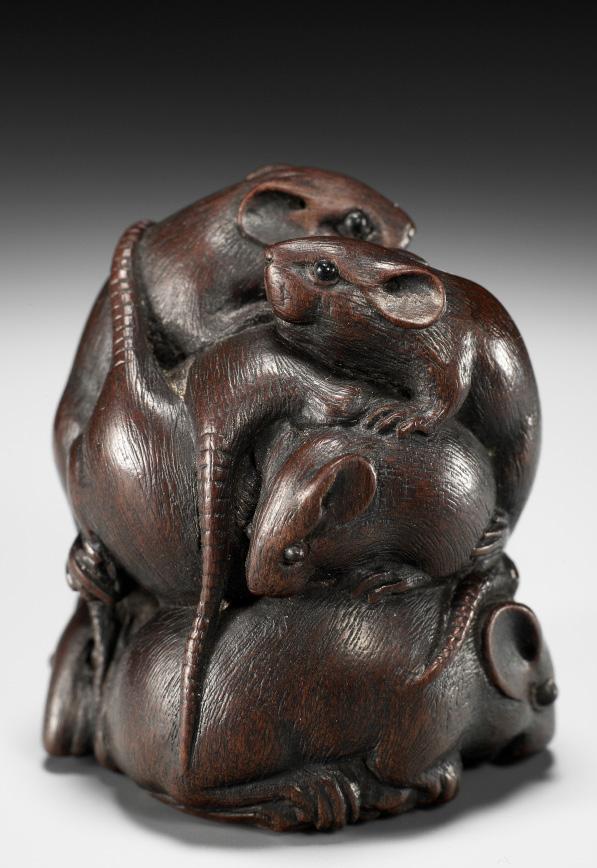


Estimate EUR 10,000
Starting price EUR 5,000
106 79

ITTAN: A SUPERB WOOD NETSUKE OF A LONG-SNOUTED WILD BOAR



 By Ittan, signed Ittan sanjin 一旦山人 Japan, Nagoya, c. 1865
By Ittan, signed Ittan sanjin 一旦山人 Japan, Nagoya, c. 1865
A finely stained wood netsuke of a long-snouted boar with its head lowered to the ground, the right hind and left forelegs drawn in for compactness and the left hind and right foreleg extended forwards. The boar with a deeply contented expression, well detailed with narrowed eyes, a long snout, curved tusks, and laid-back ears, the fur masterfully incised, the natural himotoshi between the left hind and fore legs, the underside with the signature ITTAN sanjin.
LENGTH 4.4 cm
Condition: Excellent condition with minor wear.
Provenance: Sotheby’s, 9 November 2006, London, lot 1092. Sydney L. Moss, London, 2008. French private collection, acquired from the above.
The sanjin in the signature implies a late work by this artist, likely after 1865, and this appears to be only boar by Ittan with its head lowered rather than raised (as in lot 82).
AUCTION COMPARISON
Compare a related wood netsuke of a recumbent wild boar by Masatami, similarly stained and incised, and with a similar long snout, 4.8 cm wide, dated 19th century, at Bonhams, The Julius and Arlette Katchen Collection of Fine Netsuke Part III, 6 November 2018, London, lot 102 (sold for 18,125 GBP).
Estimate EUR 10,000
Starting price EUR 5,000
108 80

81 ITTAN: A FINE WOOD NETSUKE OF A SHAGGY GOAT




By Ittan, signed Ittan 一旦 with kakihan Japan, Nagoya, c. 1840, Edo period (1615-1868)
Well carved as a recumbent goat with a shaggy coat which is finely incised in strands elegantly falling to either side of the pronounced yet subtly carved spine, the animal peacefully resting with the legs drawn in for compactness, further detailed with almond-shaped eyes, incised pupils, funnel-shaped ears, and curved horns, the left legs forming the natural himotoshi, the underside with the signature ITTAN and kakihan.

LENGTH 3.6 cm
Condition: Excellent condition with minor wear.
Provenance: Scholten Japanese Art, New York, 2007. French private collection, acquired from the above.
LITERATURE COMPARISON
Compare a wood netsuke by Ittan illustrated in Meinertzhagen, Frederick / Lazarnick, George (1986) MCI, Part A, p. 252. This goat is clearly derived from a Minko model, while the present netsuke is closer in spirit to Tametaka, but with all the precision of observation typical of the mid-19th century Nagoya carvers.
AUCTION COMPARISON
Compare a wood netsuke of a goat and kid by Tametaka at Bonhams, Fine Netsuke from a French Private Collection, 4 November 2020, London, lot 74 (sold for 11,937 EUR).
Estimate EUR 8,000
Starting price EUR 4,000
110
ITTAN: A SUPERB WOOD NETSUKE OF A WILD BOAR


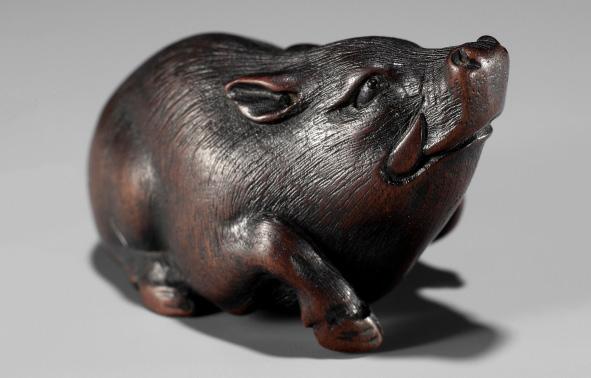 By Ittan, signed Ittan 一旦 with kakihan Japan, Nagoya, c. 1850, Edo period (1615-1868)
By Ittan, signed Ittan 一旦 with kakihan Japan, Nagoya, c. 1850, Edo period (1615-1868)
Published:
Bulletin Franco-Japonais, no. 30, p. 43.
Bandini, Luigi (Winter 1993) Learning at the Auctions, Netsuke Kenkyukai Study Journal, Vol. 13, No. 4, p. 42.
Netsuke Kenkyukai Study Journal, Vol. 15, No. 2, p. 5 (Advert from Szeszler Oriental Art).
Burditt, David (Summer 1997) Authenticity in Netsuke, in International Netsuke Society Journal, Vol. 17, No. 2, p. 16, no. 7.
Chappell, Sharon / Welch, Matthew (1999) Netsuke: The Japanese Art of Miniature Carving, p. 118, no. 174.
Exhibited:
Exhibited by Szeszler Oriental Art at The London Netsuke Fair and Convention, May 1990.
Minneapolis Institute of Art, Netsuke: The Japanese Art of Miniature Carving, 1998, no. 174.
Herbert F. Johnson Museum of Art, Cornell University, Netsuke: The Japanese Art of Miniature Carving, 1999.
Finely carved seated on its haunches with the head raised, well detailed with buffalo horn-inlaid pupils, a prominent snout, curved tusks, laid-back ears, the fur neatly incised and finely stained, the left legs forming the natural himotoshi, the underside signed ITTAN with a kakihan.
LENGTH 5 cm
Condition: Very good condition, minor wear, the chin with a small nick.
Provenance: Szeszler Oriental Art, New York, 1990. Alan Liss, acquired from the above. Sotheby’s, Fine Netsuke Including Property from the Collection of Alan R. Liss, 2 September 1993, Chicago, lot 54 (sold for USD 11,000). Denis Szeszler, New York, 1995. A private collection in the United Kingdom, acquired from the above. Sydney L. Moss, London, 2006. French private collection, acquired from the above.
The present netsuke is an unusually fine example of Ittan’s work, who rarely carved netsuke depicting boars, and is stylistically reminiscent of Ikkan.
As the twelfth animal of the zodiac, the boar often became a subject for netsuke carvers. For reasons which are probably selfevident, the boar is emblematic of unswerving courage. Perhaps because of its rounded proportions, it also came to represent wealth and well-being, and people born under its sign are said to be honest, courageous, forthright, and loyal. The boar’s fearless charge was infamous, and warriors who could stop an enraged animal became well known.

AUCTION COMPARISON
Compare a related wood netsuke of a recumbent boar by Ikkan, 5.1 cm wide, dated 19th century, at Bonhams, The Julius and Arlette Katchen Collection of Fine Netsuke Part II, 10 May 2017, London, lot 131 (sold for 10,000 USD).
Estimate EUR 8,000
Starting price EUR 4,000
111 82
IKKAN: A SUPERB WOOD NETSUKE OF A RECUMBENT OX

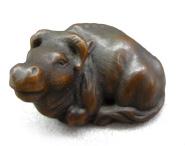 By Ikkan, signed Ikkan 一貫 Japan, Nagoya, mid-19th century, Edo period (1615-1868)
By Ikkan, signed Ikkan 一貫 Japan, Nagoya, mid-19th century, Edo period (1615-1868)
The dark-stained cherry (sakura) wood netsuke of compact form with a pleasing curve to the composition, depicting a recumbent ox with the right foreleg bent and slightly extended forwards and the other legs drawn in, the tail flung to one side, animal well-detailed with almond-shaped eyes, incised pupils, a long muzzle, and curved horns, its fur neatly incised and spine subtly carved, the natural himotoshi between the left legs and the body, the underside with the crisply carved hooves as well as the signature within an oval reserve IKKAN.


LENGTH 4.6 cm
Condition: Excellent condition with minor wear.
Provenance: Sydney L. Moss Ltd., London, 2007. French private collection, acquired from the above.
MUSEUM COMPARISON
Compare a closely related wood netsuke of an ox by Ikkan in the British Museum, registration number 1981,0808.107.
AUCTION COMPARISON
Compare a related ebony netsuke of an ox by Ikkan at Bonhams, The Edward Wrangham Collection of Japanese Art Part I, 9 November 2010, London, lot 130 (sold for 10,200 GBP).

Estimate EUR 10,000
Starting price EUR 5,000
112 83

IKKAN: A SUPERB WOOD NETSUKE OF A RECUMBENT HORSE


 By Ikkan, signed Ikkan 一貫 Japan, Nagoya, early 19th century, Edo period (1615-1868)
By Ikkan, signed Ikkan 一貫 Japan, Nagoya, early 19th century, Edo period (1615-1868)
A beautifully rounded and compact model of a horse turning backwards and raising its head, the ears laid back against the sublimely carved mane, the finely carved tail sweeping around to the front, the legs tucked neatly underneath the body. Signed on the haunch IKKAN within the typical oval reserve. Natural himotoshi, the eyes inlaid in dark horn.
A remarkably spirited carving with a stunning patina and aji, clearly loved by several generations. An early work by the artist, less detailed and opulent than his later works, however still possessing all the character and charm which distinguish this celebrated carver.
LENGTH
3.7 cm
Condition: Very good condition, minor associated surface wear including some tiny nicks and light surface scratches. Beautiful patina.
Provenance: Ex-collection Betty Jahss, sold at Sotheby’s, The Betty Jahss Collection of Netsuke Part II, 14 November 1991, London, lot 69.
LITERATURE COMPARISON
Compare to a closely related wood netsuke of a recumbent horse, by Ikkan, illustrated in Meinertzhagen, Frederick / Lazarnick, George (1986) MCI, Part A, p. 215.

Estimate EUR 8,000
Starting price EUR 4,000
114 84
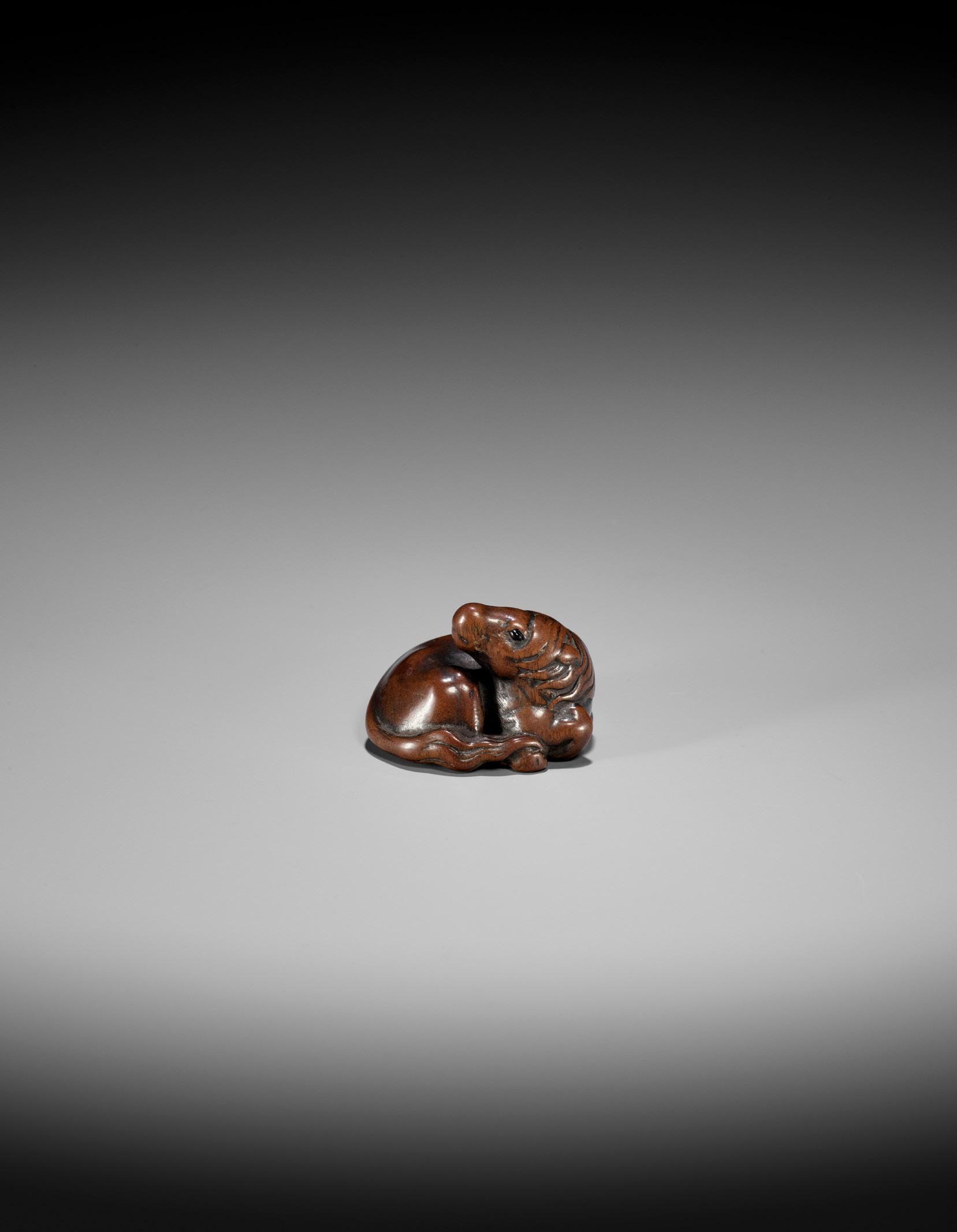

IKKAN: A SUPERB WOOD NETSUKE OF TWO RATS
By Ikkan, signed Ikkan 一貫 Japan, Nagoya, mid-19th century, Edo period (1615-1868)
Published: Katchen, Arlette (2010) Netsuke 7, Vol. 2, pp. 27-28, no. K277.

The cherry wood finely carved to depict two rats huddled close together, one curled into a ball in order to lick its left hind leg, the eyes of both inlaid with dark buffalo horn, the recumbent rat with incisors inlaid with bone. Their furs are neatly incised and darkly stained. Natural himotoshi between the two rats. The underside is well carved with the rats’ paws, two of which are on top of each other, their finely incised tails, and the signature IKKAN.
LENGTH 3.8 cm
Condition: Excellent condition with minor wear.
Provenance: Ex-collection Julius and Arlette Katchen, Paris. Sotheby’s, The Katchen Collection of Netsuke Part I, 8 November 2005, London, lot 104 (sold for 16,800 GBP). French private collection, acquired from the above.
Neil Davey’s catalog note in the Katchen sale catalog states: “Ikkan produced several examples of the subject, of which this is one of the finest recorded.”
MUSEUM COMPARISON
Compare a closely related wood netsuke of two rats by Ikkan in the Metropolitan Museum of Art, accession number 1985.399.19.

AUCTION COMPARISON
Compare a closely related wood netsuke of two rats by Ikkan at Bonhams, The Harriet Szechenyi Sale of Japanese Art, 8 November 2011, London, lot 110 (sold for 9,375 GBP).



Estimate EUR 10,000
Starting price EUR 5,000
117 85
IKKAN: A FINE WOOD NETSUKE OF A RAT WITH A SHOGI TILE



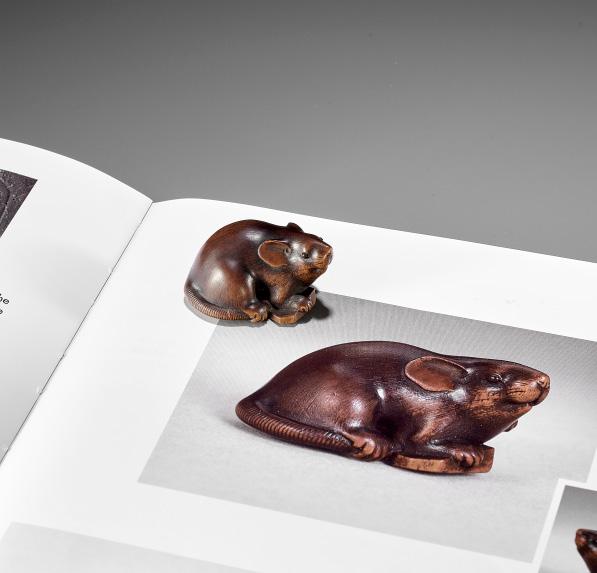
Condition: Very good condition, minor wear, few tiny nicks, few light scratches.
Provenance: Sydney L. Moss, London, 2005. French private collection, acquired from the above.
By Ikkan,
signed
Ikkan
一貫 Japan, Nagoya, mid-19th century, Edo period (1615-1868)
Published: Sydney L. Moss Ltd. (2005) More Things in Heaven and Earth, no. 56.
The finely stained and carved cherry (sakura) wood netsuke depicting a male rodent seated on its haunches with one front paw grasping the edge of a shogi chess tile and the other raised, one hind paw gripping its tail, the other only visible on the underside, with natural himotoshi between the tail and body, the eyes inlaid with dark horn. On the underside the shogi tile is boldly incised with the kanji for horse (keima 桂馬, the equivalent of a knight in Western chess). The belly of the rat signed within an oval reserve IKKAN.

LENGTH 4.3 cm
With its reference to a horse, the shogi piece neatly makes the netsuke into a joint representation of two zodiac animals. The rat and the horse represent opposite signs in the Asian zodiac and as such are considered incompatible. However, if the ‘younger’ of the two signs (the horse) submits to the ‘older’ (the rat), then the pairing can be successful.
Literature comparison: Compare a closely related wood netsuke depicting the same subject by Ikkan, illustrated by Harris, Victor (1987) The Hull Grundy Collection in the British Museum, p. 47, no. 149, and another in Atchley, Virginia / Davey, Neil (2006) The Virginia Atchley Collection of Japanese Miniature Arts, p. 29, no. N6.
AUCTION COMPARISON
Compare a related wood netsuke depicting the same subject by Tomokazu at Galerie Zacke, Fine Netsuke & Sagemono, 22 April 2022, Vienna, lot 114 (sold for 6,952 EUR).
Estimate EUR 6,000
Starting price EUR 3,000
118
86
KANO TOMOKAZU: A FINE WOOD NETSUKE OF A RAT BITING INTO A SHOGI PIECE

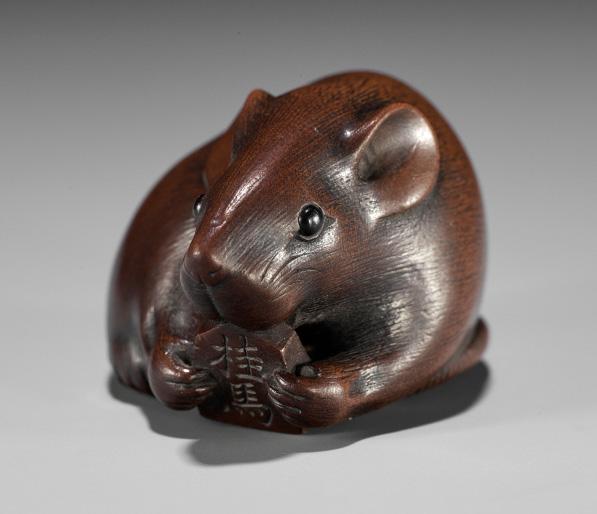 By Kano Tomokazu, signed Tomokazu 友一 Japan, Gifu, c. 1820, Edo period (1615-1868)
By Kano Tomokazu, signed Tomokazu 友一 Japan, Gifu, c. 1820, Edo period (1615-1868)
Exhibited: Netsuke, Edo Saimitsu Kogei no Hana (‘Netsuke, Flowers of Miniature Carving of the Edo Period’), Exhibition of the Nihon Netsuke Kenkyukai, 20th anniversary, Tokyo, 1995, no. 116.
The cherry (sakura) wood finely carved and stained to depict a rat nibbling on a shogi piece, which is inscribed with the kanji for horse (keima 桂馬, the equivalent of a knight in Western chess). Both front paws grasp the game piece, with one hind paw gripping its tail and the other only visible on the underside. Natural himotoshi between the neatly incised tail, the body, and the game piece. The eyes are inlaid with dark buffalo horn and the incisors with bone. The belly of the rat signed within an oval reserve TOMOKAZU.
4.1 cm
Condition: Very good condition, minor wear, few tiny nicks, few light scratches.
Provenance: Japanese private collection. Sotheby’s, 14 July 2005, London, lot 1033. French private collection, acquired from the above.
With its reference to a horse, the shogi piece neatly makes the netsuke into a joint representation of two zodiac animals. The rat and the horse represent opposite signs in the Asian zodiac and as such are considered incompatible. However, if the ‘younger’ of the two signs (the horse) submits to the ‘older’ (the rat), then the pairing can be successful.
The present netsuke appears to be a rare variation of this popular subject executed by Tomokazu and Ikkan.

Estimate EUR 5,000
Starting price EUR 2,400
119 87
LENGTH
MASATADA: A FINE WOOD NETSUKE OF TWO RABBITS WITH AMBER EYES



By Masatada, signed Masatada 正忠 Japan, Yamada, Ise Province, mid-19th century, Edo period (1615-1868)
Sensitively carved as two longeared rabbits (usagi), symbols of fertility, playfully clambering over one another, their furs neatly incised, and the eyes inlaid with pale amber. The underside shows the many well-carved paws and the signature within a polished reserve MASATADA. Natural himotoshi.
HEIGHT 2.6 cm
Condition: Good condition, minor wear, few light surface scratches. One split through the wood between the two rabbits.
Estimate EUR 3,000
Starting price EUR 1,500
From the Masanao sketchbook, illustrated in Highlights from the Masanano Sketchbook, International Netsuke Collectors Society Journal (INCSJ), vol. 2, no. 4, p. 37
120 88
MASANAO: A WOOD NETSUKE OF TWO RATS ON A CLUSTER OF PEANUTS



By a member of the Masanao family, signed Masanao 正直 with kakihan Japan, Yamada, Ise Province, mid-19th century, Edo period (1615-1868)
Published: Lazarnick, George (1981) Netsuke & Inro Artists, and How to Read Their Signatures (LNIA), Vol. 1, p. 721.

Two rats clambering on a densely carved cluster of peanuts, the shells naturalistically carved, and the rodents neatly detailed with finely incised fur and inlaid eyes of dark horn. Natural himotoshi and signed underneath one of the peanuts within a shaped polished reserve MASANAO and kakihan.
LENGTH 3.8 cm
Condition: Excellent condition, minor wear.
AUCTION COMPARISON
Compare to a related wood netsuke of a single rat with peanuts, signed Masanao, sold at Zacke, Fine Netsuke & Sagemono, 22 April 2022, Vienna, lot 139 (sold for 4,045 EUR).
Estimate EUR 3,000
Starting price EUR 1,500
121 89
A FINE TANBA SCHOOL WOOD NETSUKE OF A QUAIL AND MILLET

Unsigned Japan, Tanba Province, 19th century, Edo period (1615-1868)
Finely carved with a quail in mid-flight, a curved stalk of millet in its beak, the leaves flowing in an aerodynamic fashion. The plumage is meticulously rendered with precise incision work and dark staining, typical for the Tanba school. The eyes are inlaid with dark horn. The underside with the quail’s feet and the asymmetrical himotoshi.
LENGTH 4.7 cm
Condition: Some repairs to the millet stalk and leaves. One eye is replaced. Otherwise good condition with minor wear.
he combination of quail and millet is popular in Japanese art and symbolizes autumn. In Chinese, the two form the rebus suisui ping’an, meaning ‘may you have peace year after year’. It is common for Japanese artists to borrow such symbolism from the Chinese visual vocabulary.
AUCTION COMPARISON
Compare a related wood Yamada school ryusa manju netsuke depicting a quail and millet at Galerie Zacke, Fine Netsuke & Sagemono, 25 September 2020, Vienna, lot 120 (sold for 2,528 EUR).

Estimate EUR 2,500
Starting price EUR 1,200
122 90
92
IKKO: A WOOD NETSUKE OF RATS AND MILLET
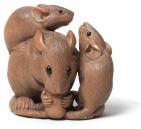

 By Ikko, signed Ikko 一光 Japan, late 19th century
By Ikko, signed Ikko 一光 Japan, late 19th century
Finely carved as a group of two rats, the larger one nibbling at a large head of millet, while the smaller one clambers up over the adult’s back. Their fur coats are very neatly incised and the large eyes are inlays of pale horn for the smaller rat and dark horn for the adult. The well-carved tails curl around the composition, one of them forming the natural himotoshi underneath and signed within a raised square reserve IKKO under the millet head.
91
A WOOD NETSUKE OF A MONKEY EATING A PERSIMMON (KAKI)


Unsigned Japan, probably Gifu, late 19th century
The darkly stained wood finely carved to depict a seated monkey biting into a kaki, holding the leafy stalk with both hands above his feet, the legs providing the natural himotoshi, the eyes double inlaid with pale and dark horn.
HEIGHT 3.3 cm
Condition: Very good condition, minor wear, few minuscule nicks, few light surface scratches, one eye inlay probably replaced. Provenance: Ex-collection W.W. Winkworth. Beaussant, 16 April 1999, Paris. French private collection, acquired from the above.
MUSEUM COMPARISON
Compare a related wood netsuke of a monkey eating a persimmon, also unsigned, dated c. 1860, Art Gallery of Greater Victoria, object number 2007.016.056.
Estimate EUR 1,500
Starting price EUR 800
HEIGHT 3.6 cm
Condition: Excellent condition with minimal wear.
AUCTION COMPARISON
Compare a closely related wood netsuke of three rats by Ikko, with inlaid eyes, late 19th century, at Bonhams, Fine Japanese Art, 17 May 2018, London, lot 17 (sold for 1,750 GBP). Compare a related ivory netsuke-okimono of a group of rats by Ikko, late 19th century, at Zacke, Fine Netsuke & Sagemono, 16th April 2021, lot 222 (sold for 5,688 EUR).
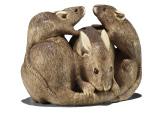
Estimate EUR 1,500
Starting price EUR 800
123
MASANAO: A WOOD NETSUKE OF A MONKEY EATING A PERSIMMON

By a member of the Masanao family, signed Masanao 正直 Japan, Yamada, Ise Province, mid-19th century, Edo period (1615-1868)
The monkey (saru) seated in a relaxed pose, one knee slightly raised and one hand resting on its other knee, folded underneath, the right hand raised and holding a half-eaten persimmon to its mouth, as the simian takes a large bite. The teeth and eyes are inlaid. Note the precisely incised fur and remarkably well-carved hands and feet. Signed within a polished reserve MASANAO. Natural himotoshi.

HEIGHT 4.1 cm
Condition: Excellent condition.
AUCTION COMPARISON
Compare to a closely related wood netsuke of a monkey eating a fruit, also with inlaid teeth and signed Masanao, sold at Bonhams, The Julius & Arlette Katchen Collection of Fine Netsuke Part II, 10 May 2017, London, lot 109 (sold for 2,750 GBP).
Estimate EUR 3,000
Starting price EUR 1,500
93
MASANAO: A FINE WOOD NETSUKE OF TWO MONKEYS

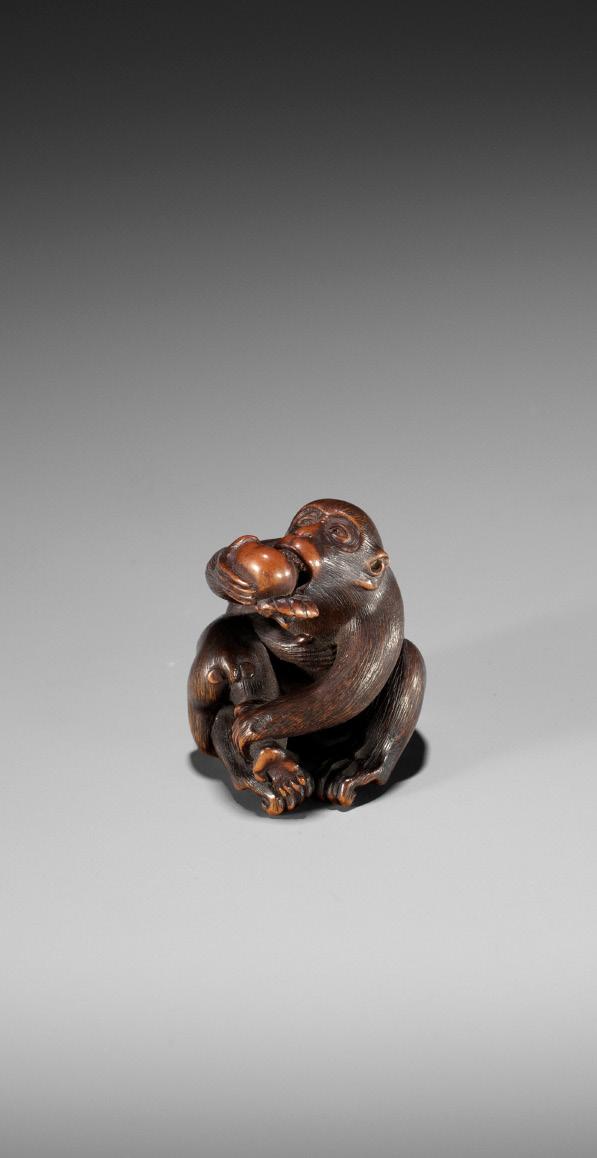

By a member of the Masanao family, signed Masanao 正直 Japan, Yamada, Ise Province, c. 1830-1840, Edo period (1615-1868)
A beautifully compact and ideally rounded composition, carved with vigor and imbued with movement, depicting a male monkey biting into a fruit and grabbing his young by one leg as it clambers up the thigh of its parent. The details are exquisitely carved – note the superbly crafted expressions, neatly incised fur, and well-carved hands, feet and ears. Signed within a polished reserve MASANAO. Natural himotoshi.
HEIGHT 3.5 cm
Condition: Excellent condition, minor wear to exposed areas.
Estimate EUR 3,000
Starting price EUR 1,500
125 94
MASAKAZU: A FINE AND AMUSING WOOD NETSUKE OF A MONKEY AND OCTOPUS
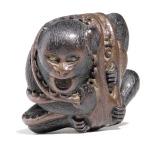

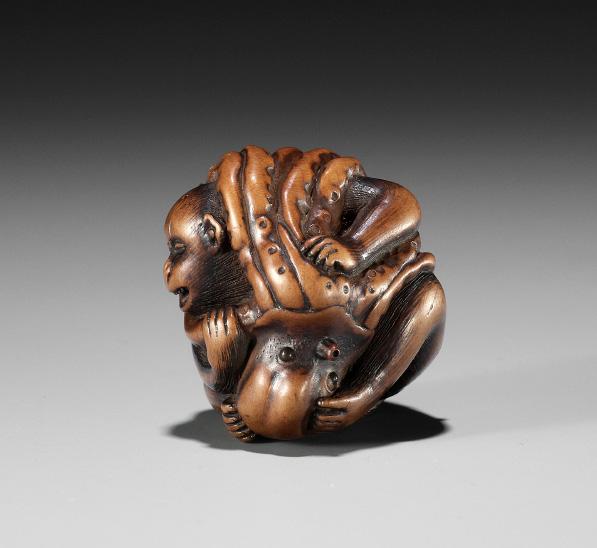
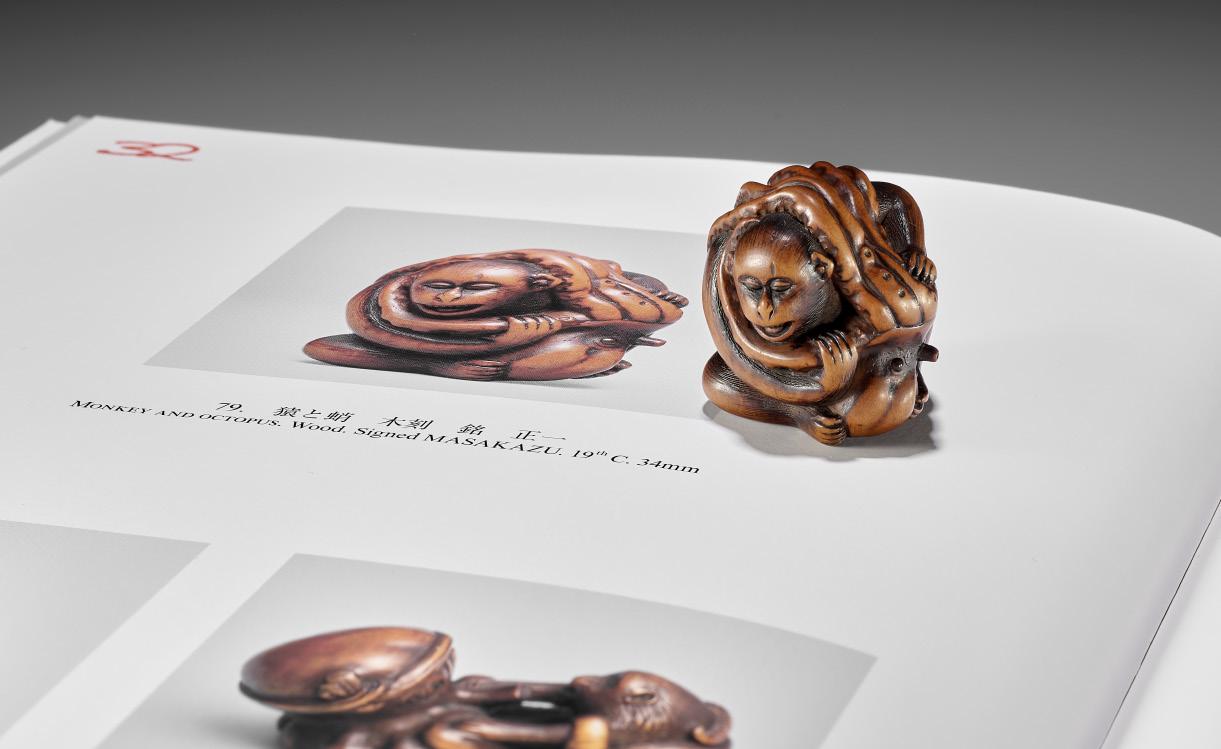 By Masakazu, signed Masakazu 正一 Japan, Gifu or Nagoya, c. 1860
By Masakazu, signed Masakazu 正一 Japan, Gifu or Nagoya, c. 1860
Published: Sagemonoya (2009) The 2009 New York Sans Ivoire Netsuke & Sagemono Selection, p. 32, no. 79.
Well-carved, of compact form, the two animals strongly exerting themselves in a vicious fight, the octopus firmly gripped by the monkey and using all its tentacles to defend itself, its soft head squashed by the simian’s feet, the monkey’s mouth slightly open, revealing tongue and teeth, both animals with horn-inlaid eyes, the suckers well detailed, the fur neatly incised and darkly stained, signed to the top of the upside-down octopus’ head within an oval reserve MASAKAZU.
HEIGHT 3.7 cm
Condition: Good condition, minor wear, few small nicks, few light surface scratches. The octopus’ muzzle repaired. Provenance: US private collection. Sagemonoya, Tokyo, 2009. French private collection, acquired from the above.
MUSEUM COMPARISON
Compare to a closely related wood netsuke of a monkey and octopus, by Masakazu, illustrated in Barker & Smith (1976), Netsuke: The Miniature Sculpture of Japan, no. 178. Located in the British Museum, accession no. F.805.

AUCTION COMPARISON
Compare a related wood netsuke depicting the same subject, signed Tomokazu, dated early to mid-19th century, formerly in the collection of Raymond Bushell, at Christie’s, An Important European Collection of Netsuke, 14 November 2001, London, lot 83 (sold for 7,638 GBP).
Estimate EUR 5,000
Starting price EUR 2,400
126 95

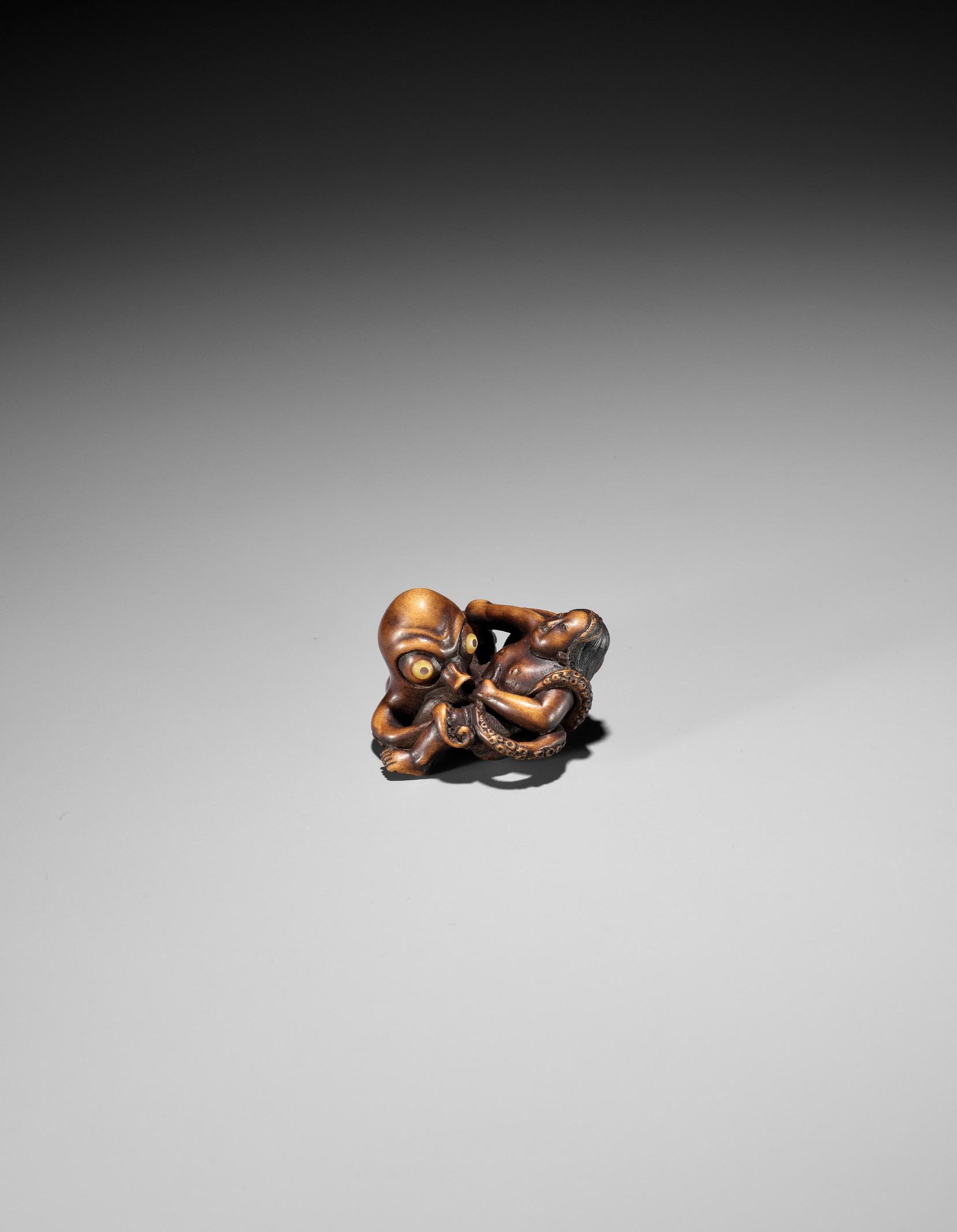
A SUPERB WOOD NETSUKE OF AN AMA STRUGGLING WITH AN OCTOPUS, ATTRIBUTED TO IKKYU

Attributed to Ikkyu, signed Minko 珉江 Japan, Nagoya, second half of 19th century
Intricately carved, the diver girl ensnared in the octopus’ tentacles, which are well detailed with numerous circular suckers. With one hand she is grabbing the tip of one tentacle, the other holding her long knife, which is facing away from the octopus, indicating she has no plans on freeing herself anytime soon. Her hair is finely incised and her eyes are inlaid with dark horn, the octopus’ with mother-ofpearl. The details are further heightened by skillful staining. Several natural himotoshi due to the openwork. The underside with a central himotoshi and signed Minko within an inlaid plaque.
LENGTH 4.2 cm
Condition: Excellent condition with minor wear.
Provenance: Sotheby’s, 23 May 1977, London, lot 74. A noted private collection, USA, acquired from the above.
The Minko signature on the present carving is either replaced or was inlaid by a follower of Minko who worked in the style of Ikkyu.
The octopus was one of Ikkyu’s favorite subjects and he executed them in his own imaginative and immediately recognizable design. The mixture of the humorous character coupled with the very fine and detailed carving make his netsuke incredibly unique, and as a result high in demand.
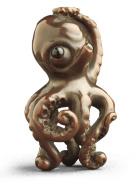

LITERATURE COMPARISON
Compare a related netsuke by Ikkyu, dated early Meiji, illustrated in Meinertzhagen, Frederick / Lazarnick, George (1986) MCI, Part A, p. 228.
MUSEUM COMPARISON
Compare a related netsuke of a standing octopus by Ikkyu, dated early 19th century, formerly in the collection of Raymond Bushell and now in the Los Angeles County Museum of Art, accession number M.91.250.41.


AUCTION COMPARISON
Compare a related wood netsuke of an octopus in a pot by Ikkyu, dated second half of 19th century, at Galerie Zacke, 25 September 2020, Vienna, lot 106 (sold for 24,016 EUR). Compare a related wood netsuke of an octopus with a straw bundle by Ikkyu, dated third quarter of the 19th century, at Lempertz, 11 June 2022, Cologne, lot 409 (sold for 10,080 EUR).
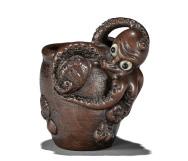

Estimate EUR 4,000
Starting price EUR 2,000
96
97
A FINE NAGOYA SCHOOL WOOD NETSUKE OF SHIMEJI MUSHROOMS
Unsigned Japan, early 19th century, Edo period (1615-1868)
Naturalistically carved as a cluster of shimeji (beech mushrooms), the stems of the two largest forming the himotoshi, the radial gills of the caps and roots of the stems superbly incised and applied with dark stain, the cap of the largest finely rendered to appear partly worm-eaten.

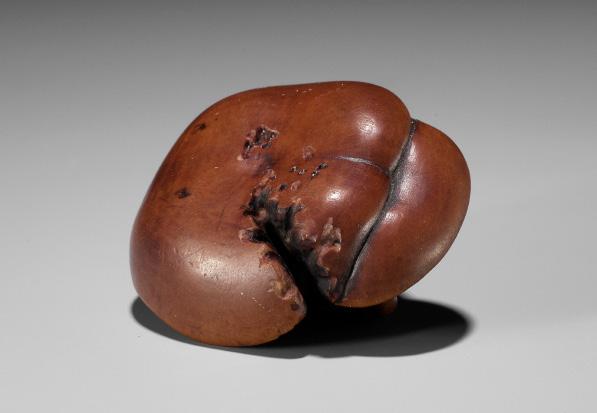
LENGTH 4.5 cm
Condition: Very good condition with minor wear, light surface scratches.
Provenance: Kunsthandel Klefisch, 9 April 2011, lot 312. Collection Prof. Dr. Henk C. Hoogsteden, Rotterdam, acquired from the above.
98
SHUGETSU: A WOOD NETSUKE OF A FROG ON A LOTUS LEAF

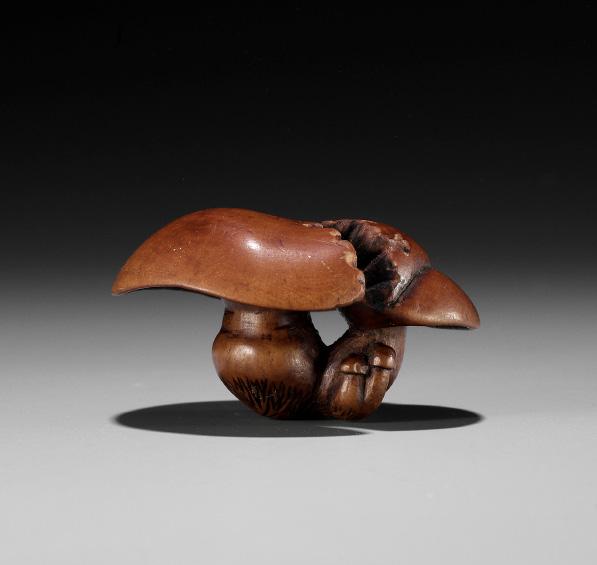
By Shugetsu, signed Shugetsu 秋月 and kakihan Japan, Echigo, early 19th century, Edo period (1615-1868)
Well carved as a frog emerging from the furled folds of a lotus leaf, the stem of which forms the himotoshi, its legs and round eyes finely detailed, the mouth neatly incised, the wood of an attractive grain and color darkly stained, the underside of the leaf incised with the signature SHUGETSU.
LENGTH 4.2 cm
Condition: Good condition, minor wear, few small chips and tiny nibbles to edges, light surface scratches.
The present netsuke is a rare work by Shugetsu listed in Davey, Neil K. (1974) Netsuke: A comprehensive study based on the M.T. Hindson Collection, p. 527, no. 32553, where the author notes that the artist came from Echigo and carved large models of toads. The first character means ‘Autumn’, which is rather uniquely abbreviated here, and the second character means ‘the moon’. Thus, the characters combine to form the art name ‘The Autumn Moon’. This artist should not be confused with the Edo school Shugetsu.
Estimate EUR 1,500
Starting price EUR 800
LITERATURE COMPARISON
A related wood netsuke similarly rendered to convey insect activity by Tadayoshi is illustrated in Coullery, Marie-Therese / Newstead, Martin S. (1977) The Baur Collection, p. 285, C 860.
Museum comparison: Compare also a related wood netsuke of two mushrooms by Tadatoshi, also with the stems forming the himotoshi, in the Art Gallery of Greater Victoria, object number 2006.002.044.
Estimate EUR 1,500
Starting price EUR 800
130
Finely carved as a decaying and half-eaten pear, the skin rotting off in sections to the reverse, a wasp with eyes inlaid in dark horn picking the fruit’s flesh inside a large hole in the front. The surface of the pear is smoothly polished, while its curved stem is roughly textured. The back with asymmetrical himotoshi with raised rims.
HEIGHT 5.2 cm
Condition: The stem repaired. Otherwise good condition with minor wear, few tiny nicks around the himotoshi.
LITERATURE COMPARISON
Compare a related wood netsuke of a wasp inside a rotten cucumber signed Harushinsai, the cucumber with a similarly smooth surface to the pear on the present netsuke, illustrated in Hurtig, Bernard (1973) Masterpieces of Netsuke Art: One Thousand Favorites of Leading Collectors, p. 172, no. 703.
AUCTION COMPARISON
Compare a related wood netsuke of a wasp inside a decaying pear by Gekko at Galerie Zacke, Fine Netsuke & Sagemono, 22 April 2022, Vienna, lot 129 (sold for 8,848 EUR).

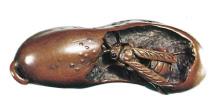
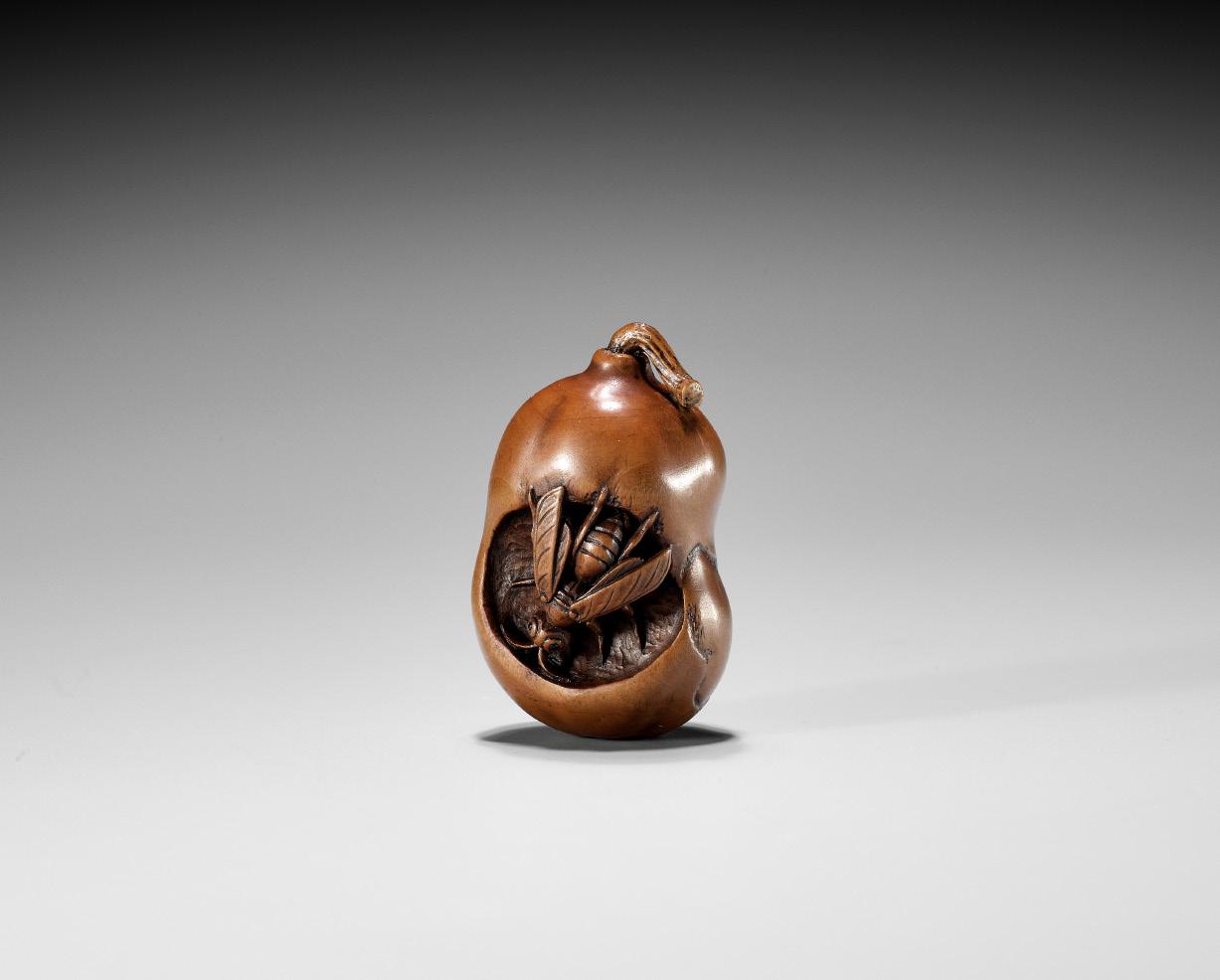
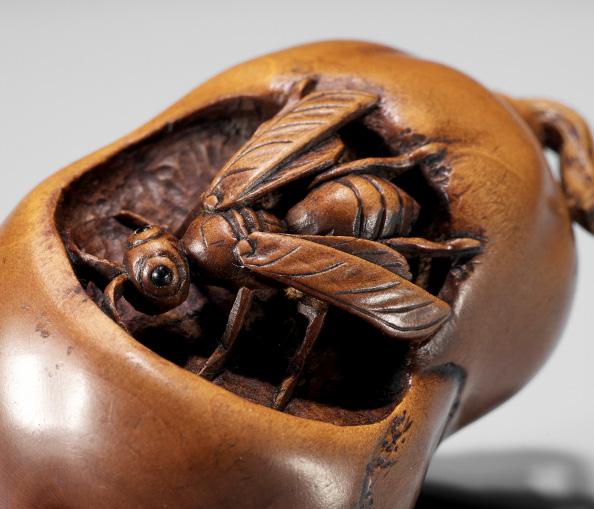
Estimate EUR 4,000
Starting price EUR 2,000
131
99 A FINE NAGOYA SCHOOL WOOD NETSUKE OF A WASP INSIDE A ROTTEN PEAR
Unsigned Japan, Nagoya, 19th century, Edo period (1615-1868)
TOMONOBU: A FINE NAGOYA SCHOOL WOOD NETSUKE OF SHELLS
 By Arima Tomonobu, signed Tomonobu 友信 Japan, Nagoya, 19th century, Edo period (1615-1868)
By Arima Tomonobu, signed Tomonobu 友信 Japan, Nagoya, 19th century, Edo period (1615-1868)
Published:
Meinertzhagen, Frederick / Lazarnick, George (1986) MCI, Part B, p. 908.
Katchen, Arlette (2010) Netsuke 7, vol. 2, p. 49, no. K579.

Finely carved and beautifully stained to depict a living awabi with two smaller hamaguri clams resting on its shell. The underside shows the naturalistically rendered fleshy foot of the mollusk, achieved with subtle elevations to the wood. Two ringed himotoshi and signed within a rectangular reserve – TOMONOBU - to the top.

With a wood box from H. I. H. Princess Takamado inscribed with the artist’s name.
LENGTH 4 cm
Condition: Excellent condition with minor wear and a fine patina.
Provenance: Ex-collection Julius & Arlette Katchen, Paris. Excollection H. I. H. Princess Takamado, acquired from the above.
Estimate EUR 1,500
Starting price EUR 800
A FINE NAGOYA SCHOOL WOOD NETSUKE OF PUMPKINS AND NASUBI
Unsigned Japan, Nagoya, early 19th century, Edo period (1615-1868)
A beautifully crafted still life group depicting an autumn harvest of one large pumpkin and three smaller nasubi (eggplants), the individual textures naturalistically detailed, and with pleasingly curling stems. The underside with large, generously excavated, asymmetrical himotoshi.
LENGTH 3.7 cm
Condition: Very good condition with minor associated surface wear. Fine patina.
AUCTION COMPARISON
Compare to a related Nagoya school wood netsuke of a pumpkin and nasubi within a basket, by Gyokumin, sold at Zacke, Fine Netsuke & Sagemono, 16 April 2021, Vienna, lot 141 (sold for 2,684 EUR).

Estimate EUR 1,500
Starting price EUR 800
132
100
101
102
TADAKUNI: A FINE NAGOYA SCHOOL WOOD NETSUKE OF SNAKE EMERGING FROM A PUMPKIN

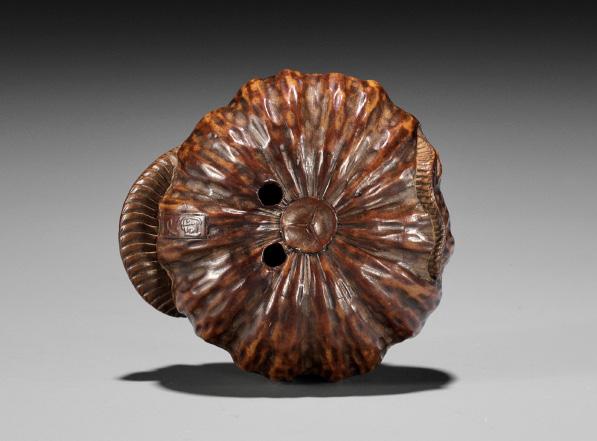
 By Tadakuni, signed Tadakuni 忠國 Japan, Nagoya, mid-19th century, Edo period (1615-1868)
By Tadakuni, signed Tadakuni 忠國 Japan, Nagoya, mid-19th century, Edo period (1615-1868)
Published: Meinertzhagen, Frederick / Lazarnick, George (1986) MCI, Part B, p. 838.
A finely detailed snake weaves its way in and out of rotting holes in the skin of a pumpkin. Its tongue flickering as it rests its head
on the top of the vegetable. The individual textures of the snake’s scaly skin and the pumpkin’s grooved surface are achieved with a heightened sense of naturalism. Signed within a rectangular reserve in fine ukibori characters TADAKUNI. Two small himotoshi underneath.
LENGTH 3.8 cm
Condition: Very good condition, minor wear. Provenance: Ex-collection W. W. Winkworth.
Estimate EUR 3,000
Starting price EUR 1,500
133

TADAKUNI: A SUPERB AND RARE WOOD NETSUKE OF A JAKONEKO (MUSK CAT)
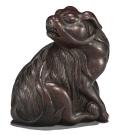 By Tadakuni, signed Tadakuni 忠國 Japan, Nagoya, mid-19th century, Edo period (1615-1868)
By Tadakuni, signed Tadakuni 忠國 Japan, Nagoya, mid-19th century, Edo period (1615-1868)
An exquisite and very finely carved wood netsuke of a jakoneko (musk cat) with beautifully incised shaggy fur, a bifurcated tail which flows up the animal’s back, and long beard-like whiskers which flow downwards from its snout. The animal looks downward with a sensitively crafted expression, the eyes are inlaid in dark horn. The underside shows the superbly carved paws and the signature within a raised served in ukibori characters TADAKUNI.
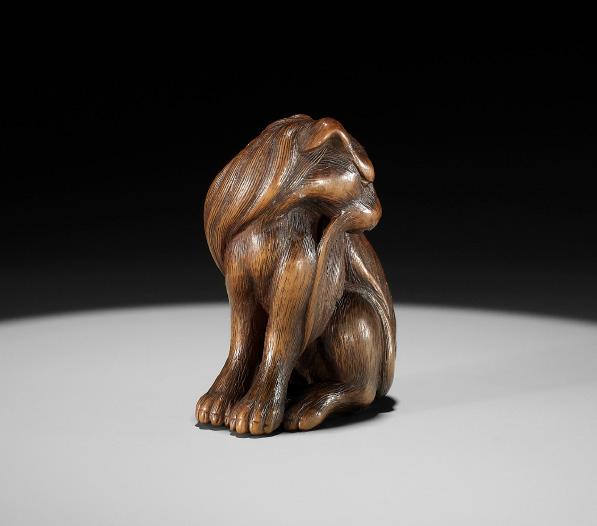

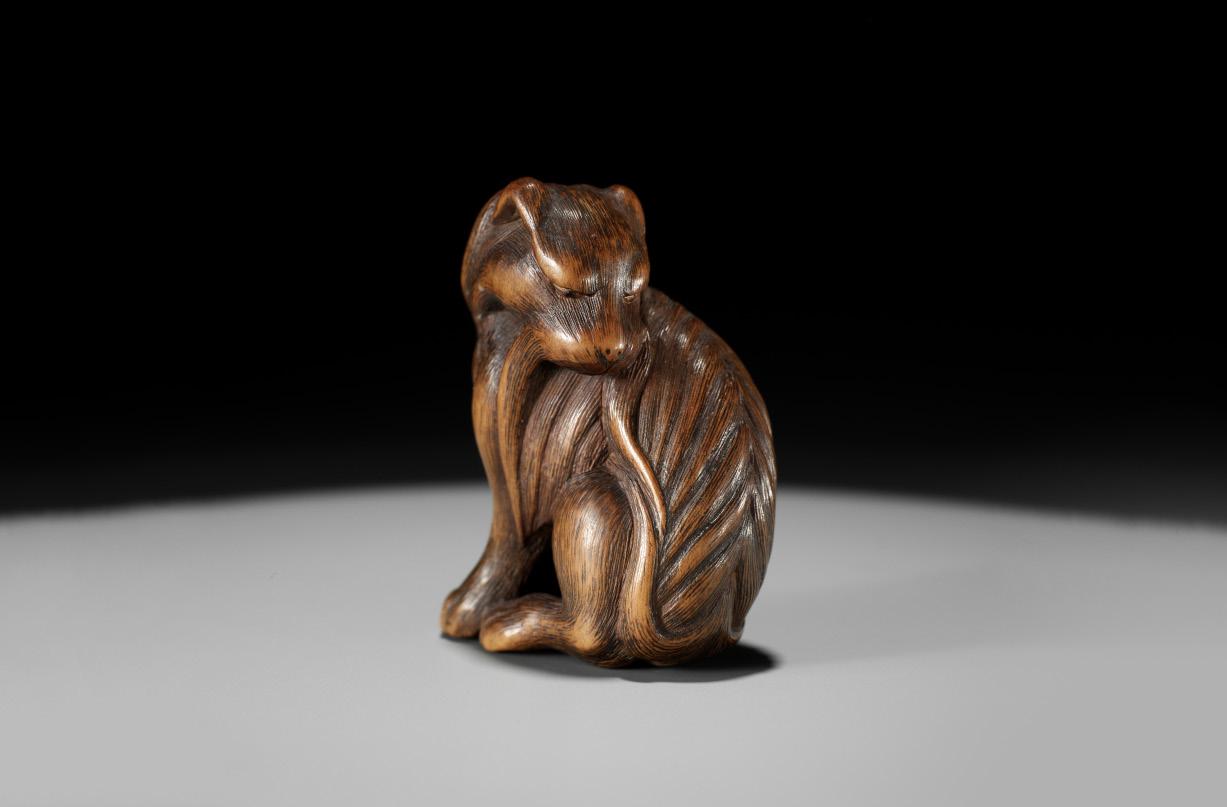
HEIGHT 4 cm
Condition: Very good condition, minor wear, a small age crack to the snout.
Provenance: A noted private collection, USA.
The jakoneko or musk cat, often called a shaggy dog, is of African origin and entered Japan via India, when it became popular for its musk, used for perfumes.

Tadakuni was a highly talented carver from the Nagoya school whose work is encountered rather infrequently. His carvings are extremely refined and his signature is usually engraved in ukibori characters. While the present netsuke is remarkably detailed and superbly finished, it also has an early feel to it, reminiscent of Tametaka who also carved a similar model of a jakoneko which likely provided the inspiration for this netsuke.
AUCTION COMPARISON
For a wood netsuke of a jakoneko by Tametaka see Zacke, Fine Netsuke & Sagemono, 16 April 2021, Vienna, lot 122 (sold for 6,710 EUR). For another wood netsuke by Tadakuni depicting a recumbent ox see Zacke, Fine Netsuke & Sagemono, 25 September 2020, Vienna, lot 109 (sold for 8,848 EUR).

Estimate EUR 10,000
Starting price EUR 5,000
135 103
A painting of a jakoneko by Uto Gyoshi (16th century), MET accession no. 2015.300.66
SHIGEMASA: A FINE WOOD NETSUKE OF A SNAIL ON BUCKET
 By Shigemasa,
By Shigemasa,
Carved from a single block of wood and masterfully stained in various subtle tones. The snail slithers across an upturned bucket, its body arched (forming the himotoshi) over the edge of the bucket, its feelers extended. The finely polished shell is stained in two different colors, with stippling and minute incision work used to achieve the heterogenous surface of the shell as naturalistically as possible – to great effect! The mollusk’s body and inside of the shell is worked with further minute stippling and even the pneumostome (breathing hole) is accounted for. The bucket, as well, is carved true to life, showing the various hues of the wood and grain. Signed on top of the bucket SHIGEMASA with the artist’s kakihan.
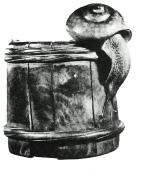
HEIGHT 3.4 cm
Condition: Excellent condition. Only very minor wear, some light surface scratches.
Provenance: Dutch private collection, purchased from Kunsthandel Klefisch, Cologne, in 2013.
The artist excelled at the carving of snails and was superior in the staining of his work.
LITERATURE COMPARISON
For a similar netsuke by Shigemasa, signed with the same kakihan, see Lazarnick, George (1982) Netsuke & Inro Artists, and How to Read Their Signatures, Vol. 2, p. 946.
AUCTION COMPARISON
Compare to a related wood netsuke of a snail on a bucket by Shigemasa, sold at Zacke, Fine Netsuke & Sagemono, 29 October 2021, Vienna, lot 120 (sold for 8,216 EUR).


Estimate EUR 4,000
Starting price EUR 2,000
136 104
signed Shigemasa 重正 and kakihan Japan, Nagoya, mid-19th century, Edo period (1615-1868)
TOMOSHIGE: A RARE WOOD NETSUKE OF A SNAIL ON A WELL BUCKET COVER

 By Gyokuryusai Tomoshige, signed Tomoshige 友重 Japan, Nagoya, c. 1820-1850, Edo period (1615-1868)
By Gyokuryusai Tomoshige, signed Tomoshige 友重 Japan, Nagoya, c. 1820-1850, Edo period (1615-1868)
Carved from a single block of wood and masterfully stained in various subtle tones, depicting a snail slithering across a well bucket cover, its arched body forming the cord attachment, the spiraling shell smoothly polished and fleshy body neatly stippled, a little hole carved in the interior of the shell to represent the breathing hole of the mollusk. Signed underneath TOMOSHIGE. A rustic, yet remarkably refined netsuke with a distinct Zen-Buddhist aesthetic.
LENGTH 4 cm
Condition: Very good condition. Some minor nicks here and there and few natural age cracks, some of the wear is simulated.
Provenance: Ex-collection Teddy Hahn, Darmstadt, purchased from his dear friend Klaus Riess, Munich. Theodor “Teddy” Hahn was a well-known and respected collector of netsuke and other Asian works of art. After spending time in museums to study the early cultures of the world, finding particular interest in their sculptures, he began collecting, remarking, “I somehow knew it would have a profound influence on my life. How right I was. And how happy I have been.” Teddy Hahn was a passionate collector of snail netsuke, arguably building the greatest collection of snail netsuke ever assembled.
The artist Gyokuryusai Tomoshige was a pupil of Arima Tomonobu of Nagoya. Furthermore, due to the use of the same kanji Shige 重 it is likely that Tomoshige was the predecessor to Shigemasa, who arguably perfected this type of snail netsuke in the latter half of the 19th century through the brilliant use of various stains to a single block of wood.
MUSEUM COMPARISON
Compare to a closely related wood netsuke of a frog on a well bucket cover by Shigemasa is in the collection of the Los Angeles County Museum of Art (LACMA), accession number M.84.34.
LITERATURE COMPARISON
A related wood netsuke of a snail on an old bucket by Tomoshige, dated to the early 19th century, is illustrated in Eskenazi Ltd. (1993) Japanese Netsuke from the Carré Collection, no. 193.

Estimate EUR 3,000
Starting price EUR 1,500
105
YASUTADA: A RARE WOOD NETSUKE OF A SNAIL EMERGING FROM ITS SHELL
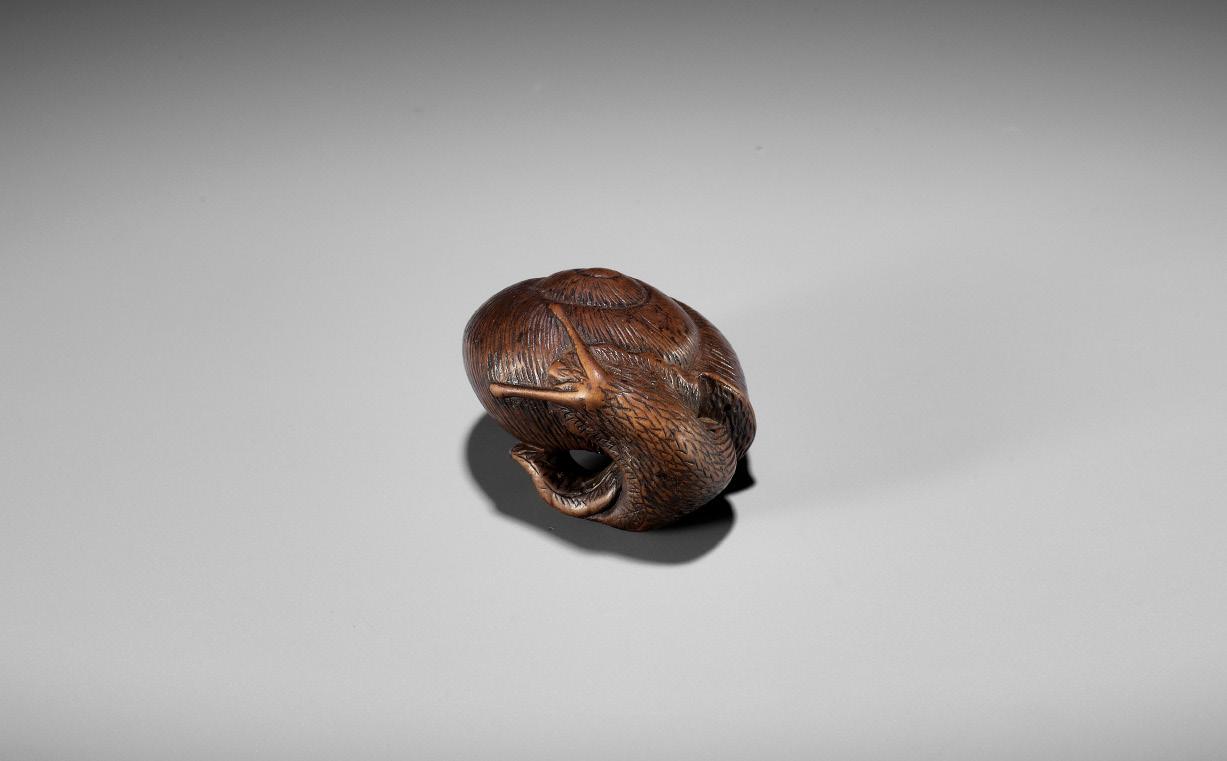
 By Yasutada, signed Yasutada 安忠 Japan,
By Yasutada, signed Yasutada 安忠 Japan,
Finely carved as a snail sliding over its coiled shell, its optic feelers fully extended and touching the shell, the skin neatly incised with a scale pattern, the shell with dense, gently curved lines, the varying incision work creating an appealing contrast in textures, the recesses finely stained. The underside with a ‘natural’ himotoshi between the snail’s shell and body, which nonetheless has been rounded by the carver, the shell incised with the signature within a rectangular reserve YASUTADA – the artist is very rare with only few examples recorded. It is supposed he was a pupil of Tomotada of Kyoto.
LENGTH 3.7 cm

Condition: Excellent condition, appealingly worn.
Provenance: Ex-collection Teddy Hahn, Darmstadt. Theodor “Teddy” Hahn was a wellknown and respected collector of netsuke and other Asian works of art. After spending time in museums to study the early cultures of the world, finding particular interest in their sculptures, he began collecting, remarking, “I somehow knew it would have a profound influence on my life. How right I was. And how happy I have been.” Teddy Hahn was a passionate collector of snail netsuke, arguably building the greatest collection of snail netsuke ever assembled.
Museum comparison: Compare a wood netsuke of an ox by Yasutada in the British Museum, registration number F.221.
AUCTION COMPARISON
Compare a wood netsuke of a rat by Yasutada at Lempertz, 11 June 2022, lot 403 (sold for 2,268 EUR).

Estimate EUR 2,000
Starting price EUR 1,000
138 106
late 18th to early 19th century, Edo period (1615-1868)
Teddy Hahn (1933-2012)
SARI: A FINE WOOD NETSUKE OF A SNAIL EMERGING FROM ITS SHELL
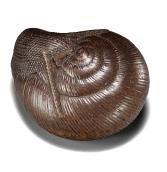
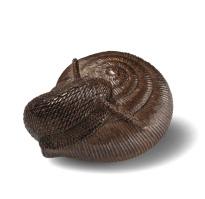 By Sari, signed Sari 左里 Japan, Iwashiro, early 19th century, Edo period (1615-1868)
By Sari, signed Sari 左里 Japan, Iwashiro, early 19th century, Edo period (1615-1868)
Beautifully and naturalistically carved as a decidedly fat snail (katatsumuri) emerging from its shell with its feelers and labial tentacles folded back and resting on the shell for compactness. The ridged and spiraling shell is carved with incredible detail and the rough texture of the body is achieved through a multitude of finely etched strokes. The foot is visible on the underside, forming a curling lump with natural himotoshi going through under it. The use of staining and some gold lacquer is sublime. The edge of the shell signed SARI.
LENGTH 4 cm
Condition: Excellent condition with only very minor wear.
Literature comparison: Compare a closely related wood netsuke of a snail by Sari illustrated in Davey, Neil K. (1982) Netsuke: A comprehensive study based on the M.T. Hindson Collection, p. 257 and p. 269 (in color), no. 794.
MUSEUM COMPARISON:
Compare a closely related wood netsuke of a snail by Sari, formerly in the Trumpf collection and now in the Linden Museum Stuttgart, inventory number OA 19210.




AUCTION COMPARISON
Compare a closely related wood netsuke of a snail by Sari at Bonhams, Fine Japanese Art, 6 November 2014, London, lot 66 (sold for 4,000 GBP), and another at Galerie Zacke, Fine Netsuke & Sagemono, 29 October 2021, Vienna, lot 123 (sold for 7,584 EUR).
Estimate EUR 6,000
Starting price EUR 3,000
139 107
HIDEHARU: A SUPERB WOOD NETSUKE OF THREE SNAILS

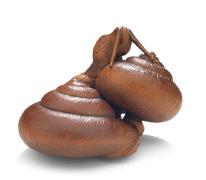


 By Hideharu, signed Hideharu 秀晴 Japan, Nagoya, c. 1880
By Hideharu, signed Hideharu 秀晴 Japan, Nagoya, c. 1880
Published:
Wilhelm, Gabor (2004) Bulletin Franco-Japonais, no. 83, p. 44-45. Wilhelm, Gabor (Spring 2004) On the Continent, International Netsuke Society Journal, Vol. 24, No. 1, p. 35.
Exquisitely carved as two adults and a smaller snail clustered together, the top snail having emerged from its shell, its optical tentacles fully extended and touching the shell, the small snail fully retreated into its shell, the subtle incision work creating a striking contrast between the varying textures, heightened by the superb staining (allegedly made using powdered turtle shell), the tail of the other adult forming the base and the himotoshi of the netsuke and signed HIDEHARU.
HEIGHT 3.9 cm
Condition: Very good condition, minor wear, few light surface scratches.
Provenance: Christie’s, 19 November 2003, Paris, lot 48 (sold for 11,163 EUR). French private collection, acquired from the above.
Unlike other netsuke carvers, who preferred the much more common subject of a single snail, Hideharu favored larger groups of two or three.
MUSEUM COMPARISON
Compare a related snail group by Hideharu, formerly in the collection of Raymond Bushell and now in the Los Angeles County Museum of Art, accession number AC1998.249.196.
AUCTION COMPARISON
Compare a related wood netsuke of two amorous snails by HIdeharu at Christie’s, 16 May 2007, London, lot 319 (sold for 10,200 GBP). Compare a closely related wood netsuke of three snails by Hideharu at Lempertz, 11 June 2022, Cologne, lot 413 (sold for 11,340 EUR).

Estimate EUR 7,000
Starting price EUR 3,400
140 108
109 HIDEHARU: A WOOD NETSUKE OF A KAPPA TRAPPED BY A HAMAGURI CLAM
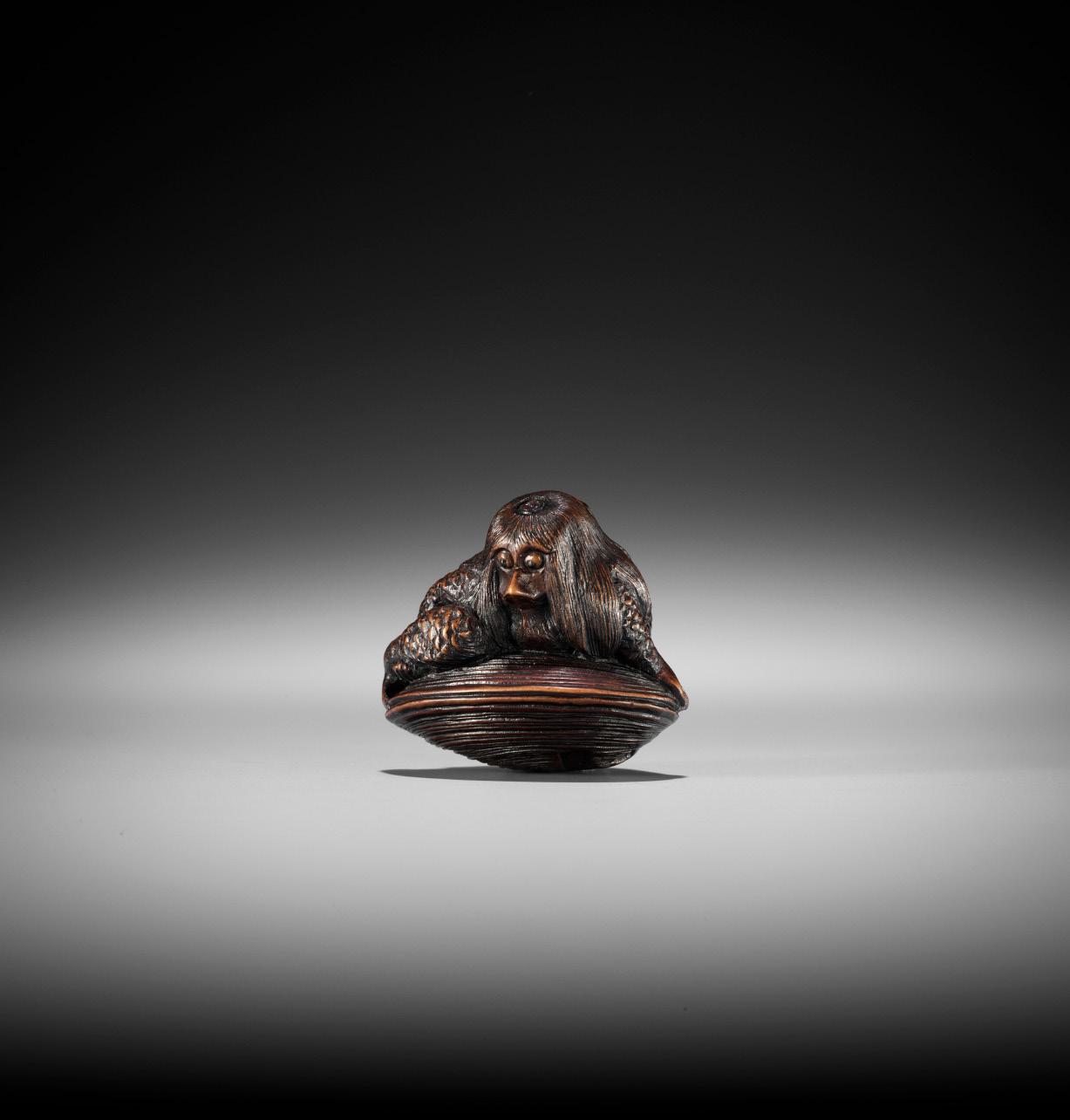 By Hideharu, signed Hideharu 秀晴 Japan, Nagoya, mid to late 19th century
By Hideharu, signed Hideharu 秀晴 Japan, Nagoya, mid to late 19th century
Seated on a giant clam and trying to extricate one foot caught in the jaws of the shell, the mythical creature with an amusing expression, the pupils inlaid at the corner of the eyes in dark horn, the beaked face framed by long, finely incised hair, and the entire body covered in meticulously incised scales. The underside with two asymmetrical himotoshi, the signature HIDEHARU within a rectangular recessed reserve between the two cord holes.
HEIGHT 4 cm, LENGTH 4.3 cm
Condition: Very good condition with minor associated surface wear, some very light chipping to the spine spikes. The stained wood with some typical wear to the exposed areas.
Provenance: A noted private collection, USA.
AUCTION COMPARISON
Compare to a closely related, larger wood netsuke of a kappa on clam, by Hideharu, at Lempertz, The Kolodotschko Collection of Netsuke I, 14 June 2014, Cologne, lot 133 (sold for 6,710 EUR).

Estimate EUR 4,000
Starting price EUR 2,000
141
TADASHIGE: A SUPERB WOOD NETSUKE OF A SKULL WITH INLAID STAG ANTLER TEETH


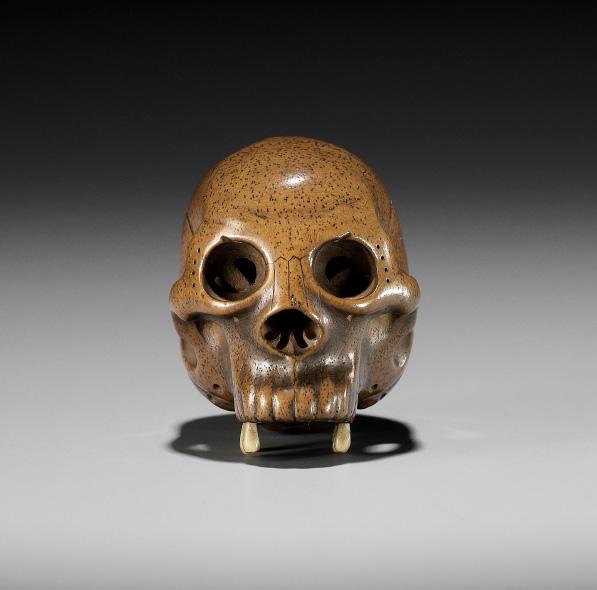 By Hogen Tadashige, signed Hogen Tadashige 法眼忠茂 Japan, Nagoya, 19th century, Edo period (1615-1868)
By Hogen Tadashige, signed Hogen Tadashige 法眼忠茂 Japan, Nagoya, 19th century, Edo period (1615-1868)
Published: Lazarnick, George (1981) Netsuke & Inro Artists, and How to Read Their Signatures (LNIA), Vol. 2, p. 1061
Naturalistically carved as a skull with cavernous eye sockets, the surface incised with parietal lines and neatly polished and stippled to resemble the heterogeneous structure of the cranium. The bottom is inlaid with six minutely carved stag antler teeth. Signed in ukibori characters Hogen TADASHIGE to the back surrounding the external occipital protuberance. One large single himotoshi to the underside.
SIZE 4 x 4 x 2.8 cm (L x H x W)
Condition: Very good condition, minor wear.
Provenance: Ex-collection Helen & Jack Mang. Sold at Quinn’s Auction Galleries, The Mang Collection of Japanese Art, 7 June 2012, Falls Church, lot 209 (sold for hammer price 6,500 USD). A noted private collection, USA, acquired from the above.
Tadashige (sometimes erroneously transcribed as Tadayoshi) was a pupil of Tadatoshi of Nagoya. He earned the title of Hogen during his lifetime and is regarded by Neil Davey as the most celebrated of the Nagoya carvers, his work becoming infinitely more subtle and sophisticated than that of Tadatoshi.
Estimate EUR 6,000
Starting price EUR 3,000
142 110
The okimono style netsuke finely carved as a realistically rendered skull, the details anatomically precise, including large, cavernous eye sockets and with neatly incised parietal lines to the cranium. The underside shows beautifully carved hossu, the inlaid bone teeth, the large singular himotoshi, and the neatly incised signature TOMOHISA – a pupil of the Tomochika school of Edo (Tokyo).

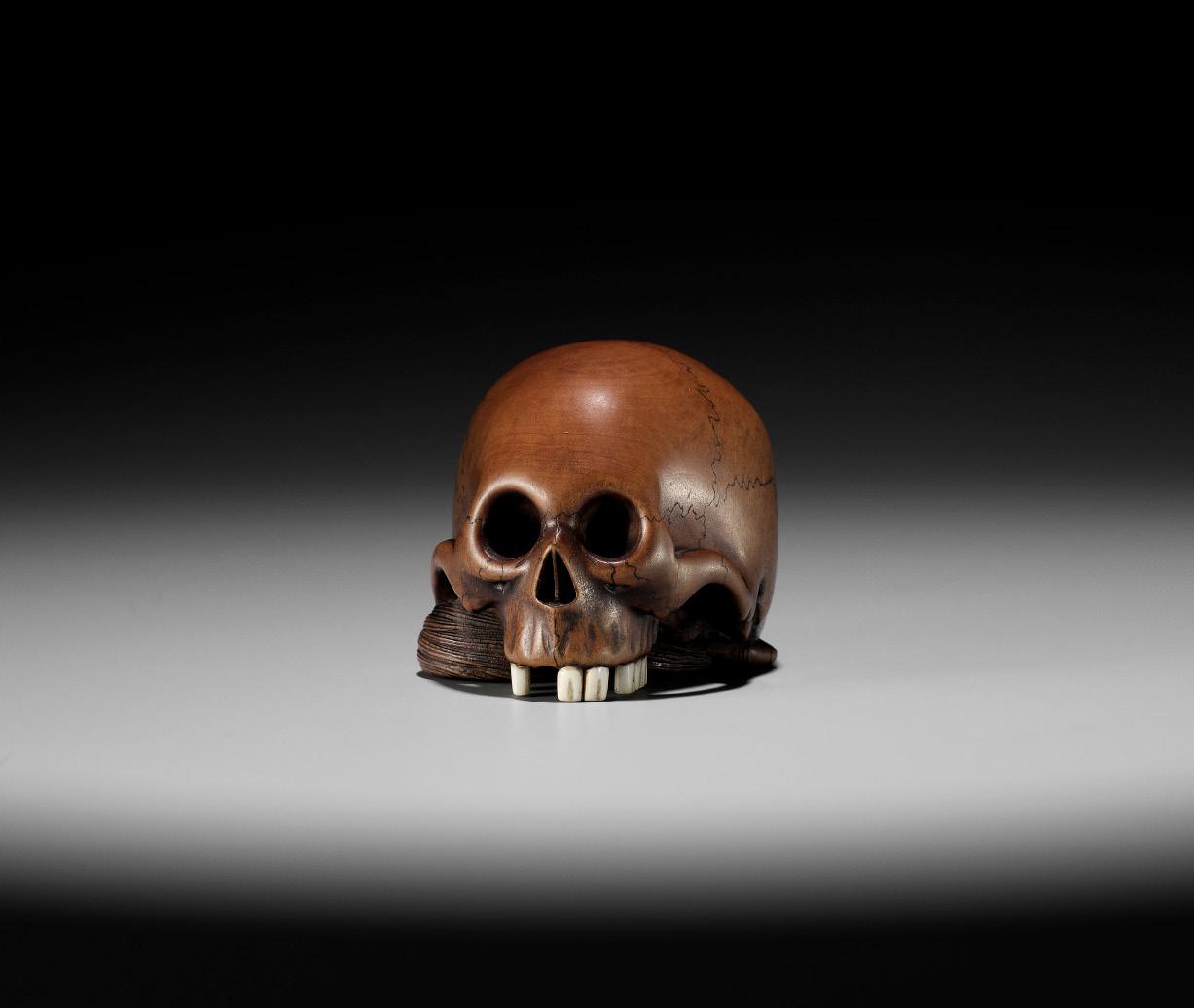
SIZE 5.8 X 4.3 X 4.5 cm (L x H x W)
Condition: One repaired crack to the side. Otherwise excellent condition with minor wear.
The fly whisk (hossu) belongs to the paraphernalia of a Buddhist monk, especially those of the Zen sect. The combination of skull and hossu might be an allusion to the Zen priest Ikkyu (1394-1481) who according to legend wandered around on New Year’s Day with a skull mounted on a stick as a reminder of the ephemeral nature of human life and the significance of the Buddhist teachings.
AUCTION COMPARISON
Compare to a closely related wood netsuke by Tomochika at Zacke, Fine Japanese Art, 27 May 2022, Vienna, lot 263 (sold for 3,648 EUR).

Estimate EUR 2,500
Starting price EUR 1,200
143
111 TOMOHISA: A LARGE WOOD NETSUKE OF A SKULL WITH HOSSU
By Tomohisa, signed Tomohisa 友久 Japan, Edo (Tokyo), second half of 19th century
TADAKAZU: A FINE WOOD NETSUKE OF TURTLES IN A BASKET


 By Tadakazu (Chuichi), signed Tadakazu 忠一 Japan, 19th century
By Tadakazu (Chuichi), signed Tadakazu 忠一 Japan, 19th century
Very finely carved as a straw basket filled with turtles, two adults emerging from the basket and clambering on one another, a further young turtle visible through a hole to the side of the basket. The details are finely carved, the carapaces naturalistically rendered, all eyes inlaid in dark horn. Large, asymmetrical himotoshi underneath and signed TADAKAZU within an oval recessed reserve.
LENGTH 4.5 cm
Condition: Very good condition, some minor wear and natural faults to the wood.
Provenance: A noted private collection, USA.
AUCTION COMPARISON
Compare to a closely related wood netsuke, by Tadakazu, at Christie’s, Japanese Art & Design, 4 November 2009, lot 22 (sold for 4,375 GBP).
Estimate EUR 4,000
Starting price EUR 2,000
144 112
A WOOD OKIMONO NETSUKE OF A TURTLE PILE ON A ROOF TILE, ATTRIBUTED TO TADAKAZU
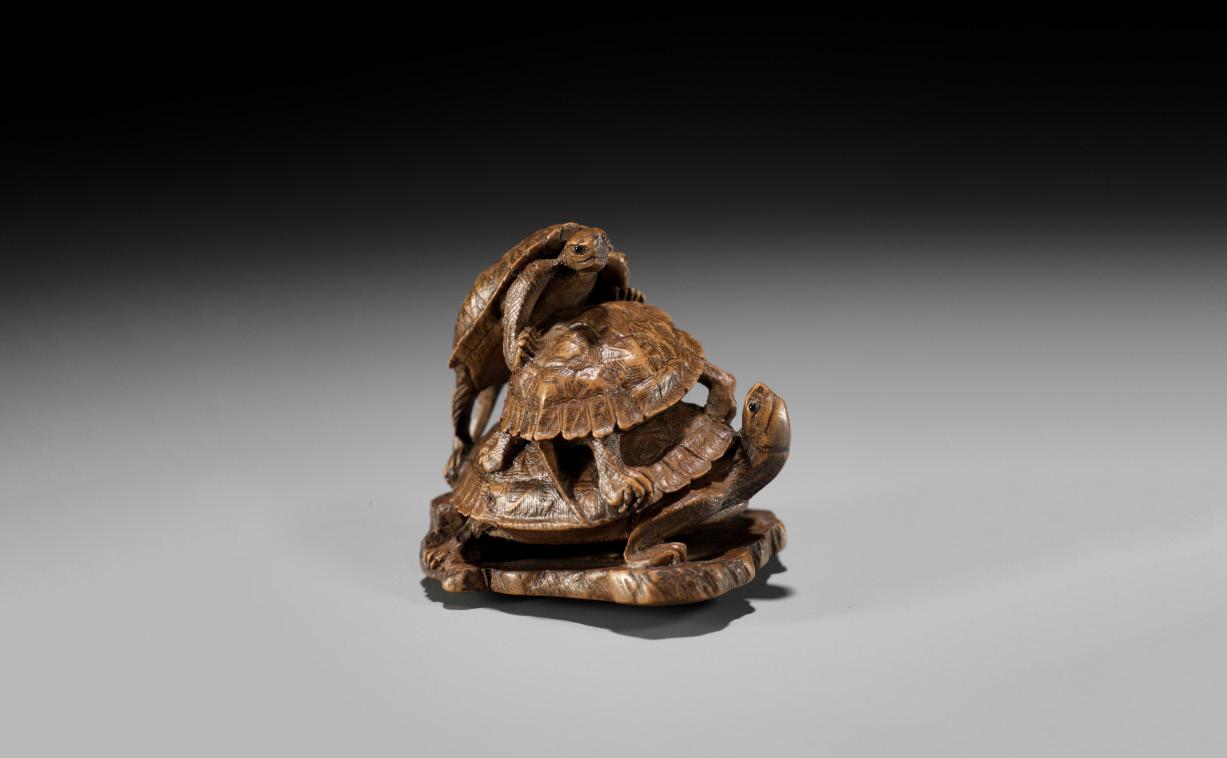
Attributed to Tadakazu (Chuichi), unsigned Japan, late 19th to early 20th century, Meiji period (1868-1912)
Depicting a large turtle nestled within a broken roof tile, stretching its neck towards the sun, two further turtles clambering on top of it and trying to get to the highest point. The carapaces are neatly detailed and the eyes are inlaid in dark horn. The underside shows the well-carved outer surface of the roof tile, with mitsudomo-e symbol, and central bone-ringed himotoshi.
HEIGHT 4.1 cm
Condition: Small repair to the neck of the turtle on the top. Otherwise, excellent condition with minimal surface wear.
Provenance: From the collection of Gaston Lazard (1878-1956) and his wife Jane Levy (1886-1985) and thence by descent within the same family.
MUSEUM COMPARISON
A related wood netsuke of a single turtle on roof tile, by Tadakazu, is in the collection of the Linden Museum, Stuttgart, accession no. OA 19183.

AUCTION COMPARISON
Compare to a related wood netsuke of a turtle pile, by Tadakazu, at Zacke, Fine netsuke & Sagemono, 25 September 2020, Vienna, lot 84 (sold for 4,803 EUR).
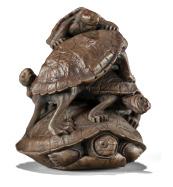
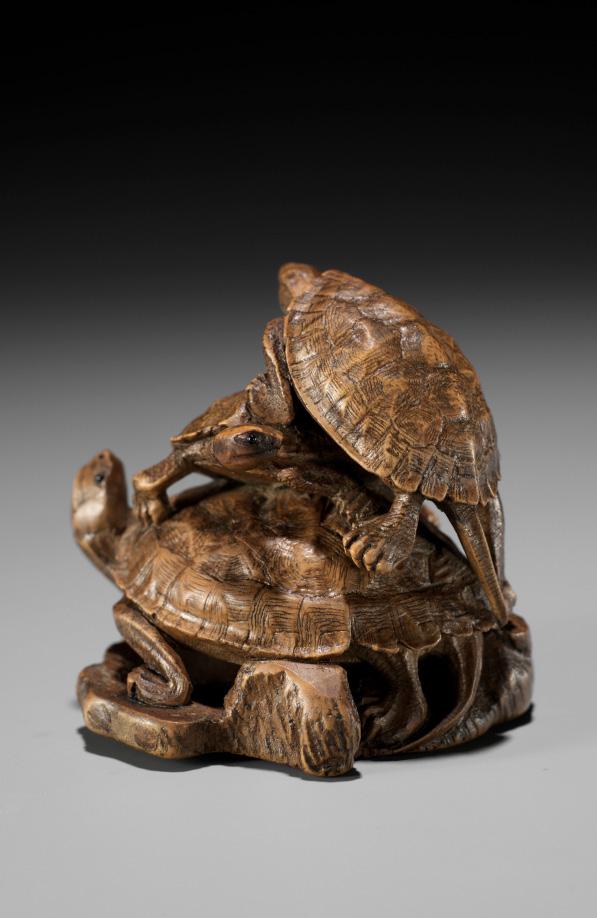
Estimate EUR 3,000
Starting price EUR 1,500
145 113
RANSEN:
A FINE WOOD NETSUKE OF A DRUNKEN TANUKI HARA NO TSUZUMI
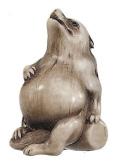


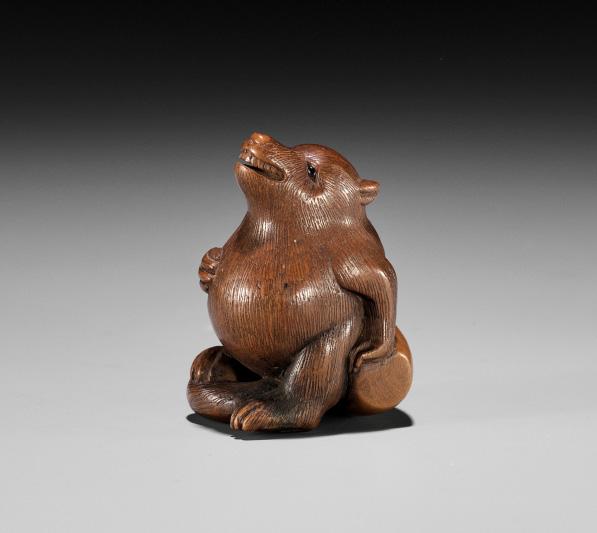 By Ransen, signed Ransen 蘭川 Japan, Kyoto, first half of 19th century, Edo period (1615-1868)
By Ransen, signed Ransen 蘭川 Japan, Kyoto, first half of 19th century, Edo period (1615-1868)
The jovial badger sitting on an emptied sake bottle (tokkuri), one paw resting on its bushy tail, forming the cord attachment, and drumming on its bloated belly, raising its head, the mouth slightly opened with visible teeth, as if about to let out a drunken howl. The eyes are inlaid dark horn and the fur is finely incised. Signed underneath the sake bottle RANSEN – a pupil of the Hogen Rantei of Kyoto.
HEIGHT 3.7 cm
Condition: Very good condition with only very minor surface wear.
The tanuki possesses magical powers and can change forms, sometimes into Buddhist monks; they are jovial, but also dangerous, as they have been known to suffocate hunters with their enormous scrotums. The act of drumming on the belly, according to legend, was used by tanuki to beguile travelers and hunters to lead them astray. However, it has also been said that tanuki would get together just for fun, drumming on their bellies under the moonlight, perhaps even with some sake involved.
LITERATURE COMPARISON
Compare to a closely related wood netsuke of a belly drumming tanuki without the sake bottle, by Ransen, illustrated in Davey, Neil K. (1974) Netsuke: A comprehensive study based on the M.T. Hindson Collection, p. 90, no. 248.
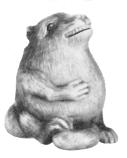
AUCTION COMPARISON
Compare to an ivory netsuke of a belly drumming tanuki with the sake bottle, by Rantei, sold at Sotheby’s, The Carlo Monzino Collection of Netsuke, Inro and Lacquer, 21 June 1995, London, lot 335 (sold for 3,220 GBP).
Estimate EUR 4,000
Starting price EUR 2,000
146 114
TADATOSHI: A WOOD NETSUKE OF A SLEEPING SHOJO
By Tadatoshi, signed Tadatoshi 忠利 Japan, Nagoya, c. 1840, Edo period (1615-1868)
An excellent cherry (sakura) wood netsuke depicting a shojo in a deep slumber after drinking a hefty amount of sake. Her head is resting on her upturned hand, nestled inside her robe, her expression conveying her fatigue from all the drinking very well. Her knees are bent towards her body, and her robe is carved with minute detail showing brocade and cloud patterns. One of her distinctive attributes is her full long hair, which was crimson and said to contain a much sought-after dye. Here it is delicately carved, flowing down her back and all the way to the underside. The side and underside with asymmetrical himotoshi, signed in ukibori within a rectangular reserve TADATOSHI.


LENGTH 4.3 cm
Condition: Excellent condition with minor wear.
Provenance: Sotheby’s, 14 July 2006, London, lot 1101. French private collection, acquired from the above.
AUCTION COMPARISON
Compare a closely related netsuke of a sleeping shojo by Tadatoshi at Lempertz, 5 June 2015, Cologne, lot 1064 (sold for 8,556 EUR), and another at Quinn’s Auction Galleries, The Mang Collection of Japanese Netsuke, 7 December 2012, Falls Church, lot 204 (sold for 6,000 USD).


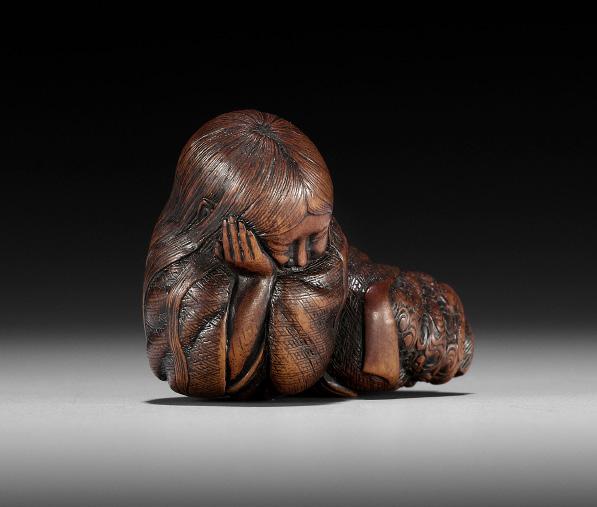
Estimate EUR 4,000
Starting price EUR 2,000
147 115
NOBUKAZU: A WOOD SHUNGA NETSUKE OF OKAME WITH TENGU MASK
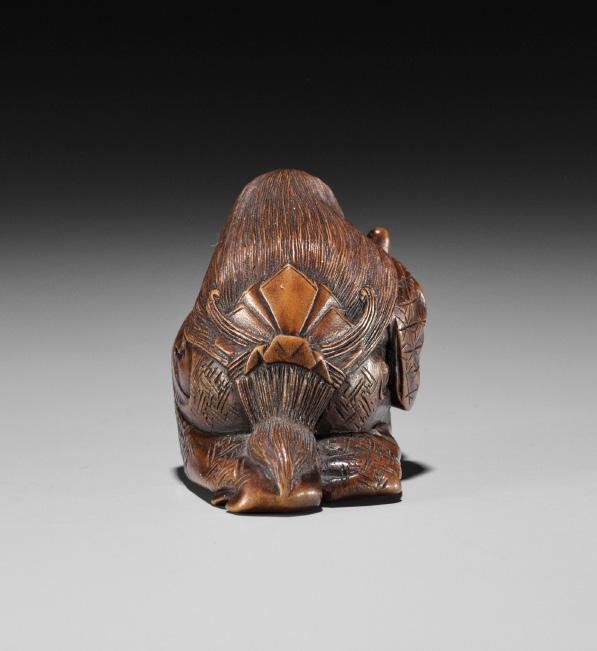

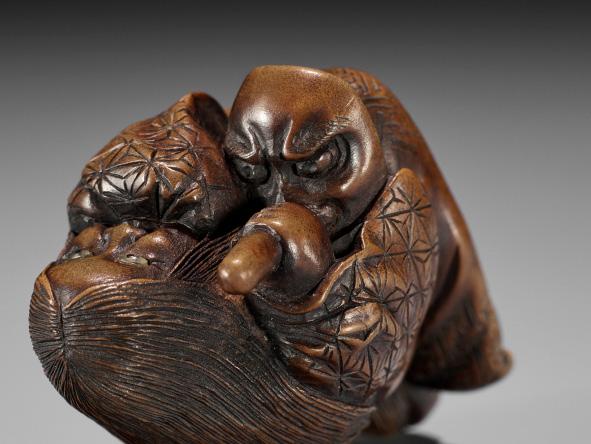 By Nobukazu, signed Nobukazu 信一 to 刀 Japan, 19th century, Edo period (1615-1868)
By Nobukazu, signed Nobukazu 信一 to 刀 Japan, 19th century, Edo period (1615-1868)
Published: Hurtig, Bernard & Wilhelm Gabor (1983) What’s New at Auctions, International Netsuke Collectors Society Journal (INCSJ), vol. 10, no. 4, p. 10.
The Shinto goddess of mirth depicted here with long, finely incised hair, wearing an elaborately decorated kimono, all in the manner of a shojo (drunken sprite), hiding her grin behind her sleeve as she caresses the long nose of a Konoha-tengu mask. The eyes are large and enigmatic inlays of pale, translucent horn with dark pupils. Natural himotoshi and signed underneath NOBUKAZU to [carved by Nobukazu].
LENGTH 4.5 cm
Condition: Very good condition, minor wear, some light surface scratches to the underside.
Provenance: French private collection, purchased at PechonDelavenn-Lafarge, Hotel Drouot, 19 November 1982, Paris, lot 32 (sold for 9,478 FRF).
Estimate EUR 3,000
Starting price EUR 1,500
148
116
117
TSUNEYOSHI: A RARE NAGOYA SCHOOL WOOD NETSUKE OF TWO DRUNKEN SHOJO
By Tsuneyoshi, signed Tsuneyoshi 常美 Japan, Nagoya, early to mid-19th century, Edo period (1615-1868)
The two drunken sprites depicted side by side, one sleeping blissfully, using a hyotan (double gourd) filled with sake as a pillow, and the other touching its head in an amusing gesture, clearly hungover and trying to remember their drunken exploits from last night. Their robes are well carved with typical cloud patterns and further detailed with subtle ukibori. Their expressions are finely
118
MASATOSHI: A NAGOYA SCHOOL WOOD NETSUKE OF A SLUMBERING SHOJO
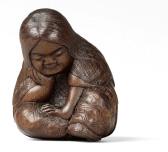

 By Masatoshi, signed Masatoshi 正利 Japan, Nagoya, mid-19th century, Edo period (1615-1868)
By Masatoshi, signed Masatoshi 正利 Japan, Nagoya, mid-19th century, Edo period (1615-1868)
Finely carved as a seated shojo in a deep slumber induced by a hefty amount of sake. One hand is placed in her lap and the other pressed against her cheek, supporting her face, as she gently smiles, perhaps even dreaming of drinking more sake. Her finely incised long hair neatly falls down her back and her robe is adorned with elaborately carved bekko-patterns. The wood of a good color with an attractive patina. Himotoshi through the back and underside and signed within a raised rectangular reserve MASATOSHI.
HEIGHT 3.2 cm
Condition: Very good condition with typical surface wear.
AUCTION COMPARISON
A similar netsuke by Masajo was sold by Lempertz, Netsuke und Sagemono, 9 June 2017, Cologne, lot 566 (sold for 2,728 EUR).

Estimate EUR 2,000
Starting price EUR 1,000
carved and treated with a healthy dose of humor. Asymmetrical himotoshi to the underside and signed TSUNEYOSHI – an apparently unrecorded artist working in the Nagoya style.
HEIGHT 3.4 cm, LENGTH 3.8 cm
Condition: Very good condition with minor wear and traces of use. Fine patina.
Shojo are usually depicted on their own in netsuke art. Netsuke of two or more shojo are considerably rare.
Estimate EUR 2,500
Starting price EUR 1,200
149
119 A
Unsigned Japan, Nagoya, 19th century, Edo period (1615-1868)
Well carved as the oil thief Abura Bozu standing and leaning forward as he holds his broken geta by the torn thong, trying to mend it, the oil lamp visible in the back tucked into the obi, his pupils inlaid with dark horn, the face with a fearful expression, the mouth wide open. Natural himotoshi. A particularly fine rendition of this Nagoya school subject.
HEIGHT 4.6 cm
Condition: Excellent condition with minor wear.
AUCTION COMPARISON
Compare a closely related wood netsuke by Masayoshi depicting the same subject at Galerie Zacke, 29 October 2021, Vienna, lot 93 (sold for 2,528 EUR).


Estimate EUR 2,000
Starting price EUR 1,000
120 A
Unsigned Japan, second half of 19th century
Very finely carved as a disappointed rat catcher, wearing only a loincloth, kneeling and holding a box down, looking backwards as the escaped rat clambers over his back. His expression is masterfully worked, brilliantly capturing his anger and disappointment, while at the same time vilifying him. Note the extremely well-carved bony fingers and toes, as well as the muscular and emaciated body. The rat catcher’s eyes are inlaid with dark horn. Natural himotoshi. The well-toned wood finely stained and bearing a fine patina.

LENGTH 5.6 cm
Condition: Very good condition. A repair to the box with associated traces of adhesive.
Provenance: French private collection, purchased at Christie’s, 26 November 2002, lot 22 (part lot).
AUCTION COMPARISON
Compare to a closely related wood okimono netsuke of a rat catcher from the same collection, signed Masayoshi, sold at Zacke, Fine Netsuke & Sagemono, 22 April 2022, Vienna, lot 111 (sold for 4,803 EUR).


Estimate EUR 3,000
Starting price EUR 1,500
150
FINE NAGOYA SCHOOL WOOD NETSUKE OF THE OIL THIEF
FINE WOOD OKIMONO NETSUKE OF AN EMACIATED RAT CATCHER
121
AN EDO SCHOOL WOOD NETSUKE OF A HUNTER TRAPPING A GOOSE
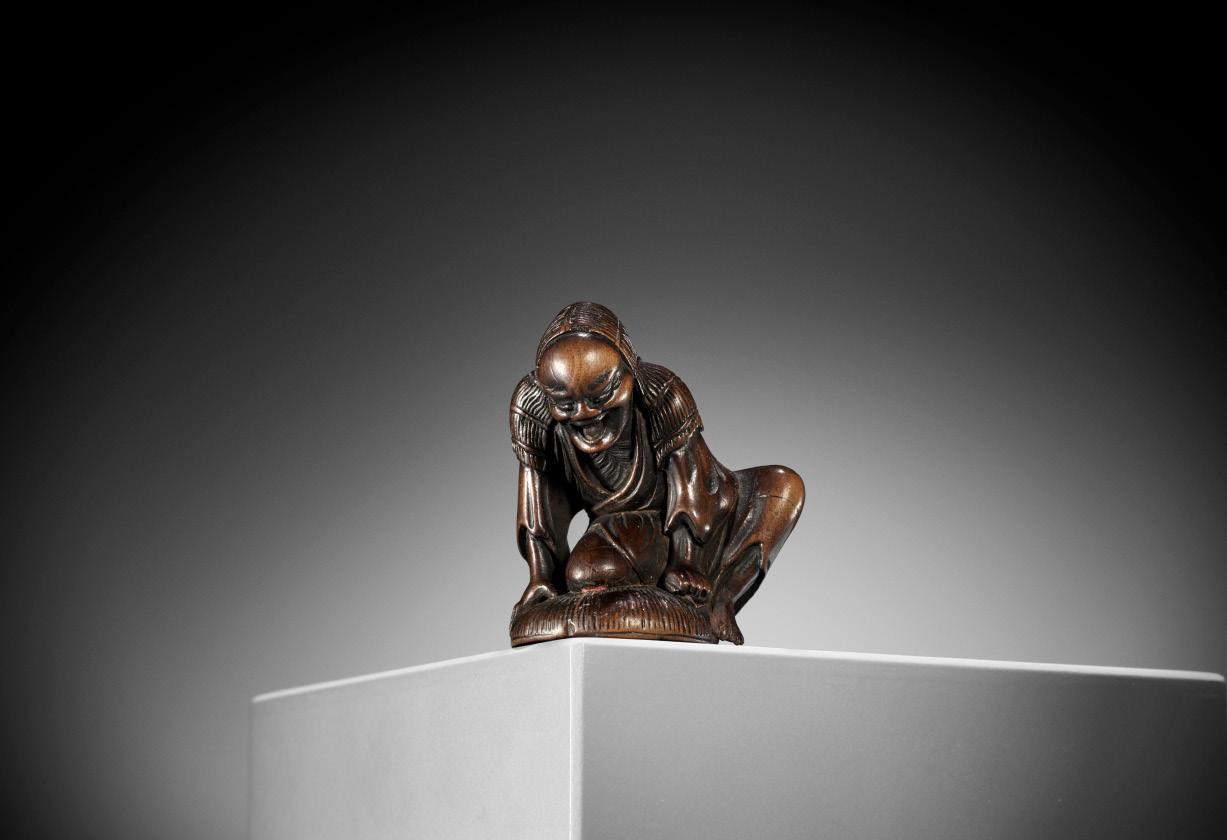


Unsigned Japan, Edo (Tokyo), 18th century, Edo period (1615-1868)
Finely carved, the hunter dressed in typical attire, pressing down on an old, tattered straw kasa hat and capturing a goose beneath. Note the expertly crafted facial expression of the hunter, who is visibly overjoyed with his catch. The well-toned wood bearing a fine, unctuous patina. Large, asymmetrical himotoshi through the back.
HEIGHT 4.2 cm
Condition: Very good condition. Minor wear and nibbling to exposed areas and edges.
Provenance: From the collection of Gaston Lazard (1878-1956) and his wife Jane Levy (1886-1985) and thence by descent within the same family.
Estimate EUR 2,000
Starting price EUR 1,000
151
CHIKUUNSAI: A WOOD NETSUKE OF A BABY BOY EATING MOCHI

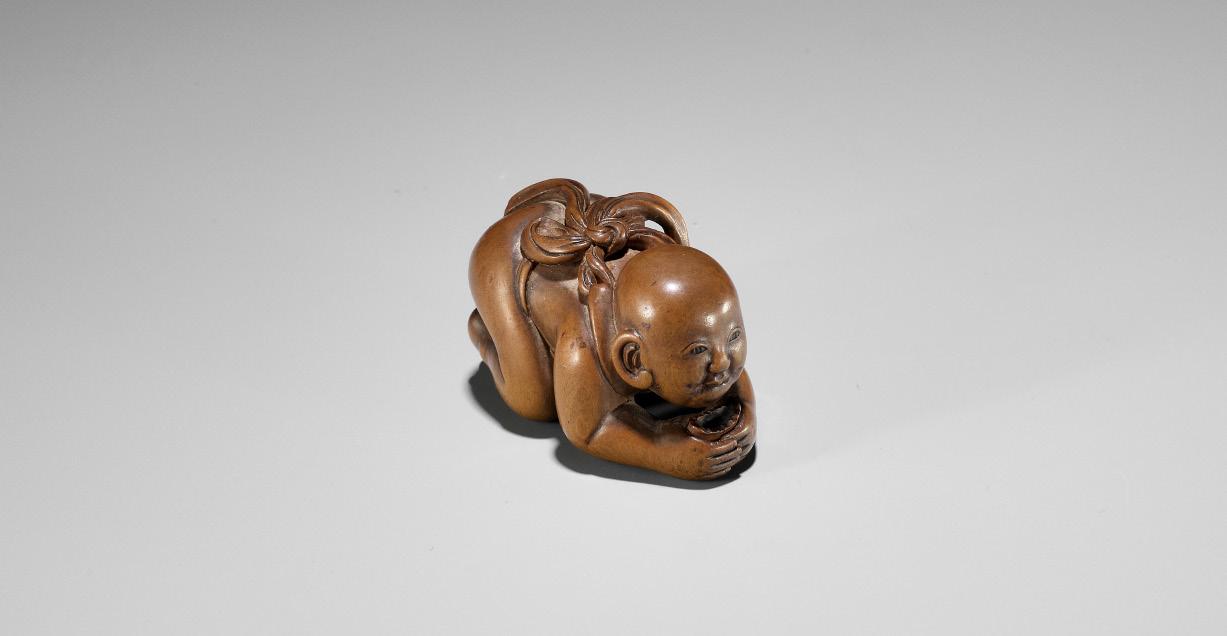

 By Chikuunsai,
By Chikuunsai,
signed
Chikuunsai 竹雲齋
Japan, Yamada, Ise Province, 19th century, Edo period (1615-1868)
The crawling, chubby boy of simple yet charming design and with a smooth surface, clad in a bib incised with a diapered hexagonal pattern and tied with a ribbon at the back, his plump naked behind showing and the genitals visible underneath. The boy is holding in front of him with both hands a rice cake (mochi) from which he has just taken a large bite. Natural himotoshi between the body and the arms, feet, and ribbon. Signed diagonally to the bib on the underside CHIKUUNSAI.
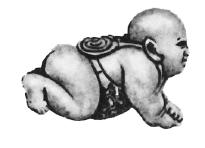
LENGTH 4.5 cm
Condition: Very good condition, minor wear, few light surface scratches.
The artist appears to be unrecorded, however clearly worked in the style of the Masanao family, his craftsmanship closely resembling Masakatsu of Yamada.
LITERATURE COMPARISON
Compare a related wood netsuke of a baby boy by Masanao, circa 1860, illustrated in Bandini, Rosemary (2020) The Larry Caplan Collection of Japanese Netsuke, no. 14. Also compare a closely related boxwood netsuke by Masakatsu, mid-19th century, illustrated in Meinertzhagen, Frederick / Lazarnick, George (1986) MCI, Part A, p. 419.
Estimate EUR 2,000
Starting price EUR 1,000
152
122
123 MASANAO: A SMALL WOOD NETSUKE OF A BEAN VENDOR

 By Miyake Masanao II (1848-1922), signed Masanao 正直 Japan, Yamada, Ise Province, late 19th century
By Miyake Masanao II (1848-1922), signed Masanao 正直 Japan, Yamada, Ise Province, late 19th century
A finely carved wood netsuke of relatively small stature, possibly intended for a child, depicting a traveling salesman carrying a closed umbrella in one hand and a box around his neck which is inscribed omame (‘beans’) on the front. The folds of his robe and headscarf are well-carved and skillfully stained. Perhaps it has just stopped raining, explaining not only the closed umbrella but also his long robe being tucked into his belt at the back, to avoid it getting wet and dirty. Two subtly placed himotoshi to the back and underside.


HEIGHT 4.8 cm
Condition: Very good condition, minor wear, few light surface scratches.
Provenance: Galerie Yamato, Paris, 2005. French private collection, acquired from the above.
Legumes such as beans (mame) and peas (endo) symbolize female fertility in East Asia. The fruits that appear in the swelling of the pod are considered to be the unborn child in the womb. Mame, written with different characters, also means health and efficiency. Bean netsuke were therefore worn as a talisman.
Estimate EUR 1,500
Starting price EUR 800
124 MASANAO: A RARE WOOD NETSUKE OF DAIKOKU CARVING A RAT
By a member of the Masanao family, signed Masanao 正直 Japan, Yamada, Ise Province, mid to late 19th century
The lucky god of wealth Daikoku lifting his wish-granting mallet and holding a chisel to a rat which he is carving. The lightly stained wood with finely carved details. Natural himotoshi and signed underneath the rat on a shaped reserve simulating the unfinished underside of the rodent – MASANAO.
HEIGHT 3.9 cm
Condition: Very good undamaged condition, minor wear.
Provenance: Collection Prof. Dr. Henk C. Hoogsteden, Rotterdam, purchased at Lempertz, Cologne, 5 June 2015, lot 1389.
The rat (nezumi) is a symbol of wealth and familiar to the god of wealth Daikoku.
AUCTION COMPARISON
Daikoku is a rare subject for the Masanao lineage, for another example see Lempertz, The Kolodotschko Collection of Netsuke II, 6 December 2014, Cologne, lot 784 (sold for 1,488 EUR). For another example of this rare subject see Lempertz, The Kolodotschko Collection of Netsuke II, 6 December 2014, Cologne, lot 969 (sold for 3,720 EUR).
Estimate EUR 1,500
Starting price EUR 800
153
125
MASAKATSU: A RARE WOOD NETSUKE OF A CLAM DIVER RESTING ON A LARGE AWABI SHELL
 By Suzuki Masakatsu, signed Masakatsu 正勝 with kakihan Japan, Yamada, Ise Province, mid to late 19th century, Edo period (1615-1868)
By Suzuki Masakatsu, signed Masakatsu 正勝 with kakihan Japan, Yamada, Ise Province, mid to late 19th century, Edo period (1615-1868)
Published: Malcolm Fairley Japanese Works of Art, Netsuke from a Private European Collection Part II, no. 37.

Finely carved as a diving girl (ama) dressed only in a loincloth and wearing a headband, resting on a naturalistically rendered awabi shell, a knife in her left hand. The attractively stained wood is engraved with delicate details. Natural himotoshi between the arm and the body, signed underneath MASAKATSU and kakihan.
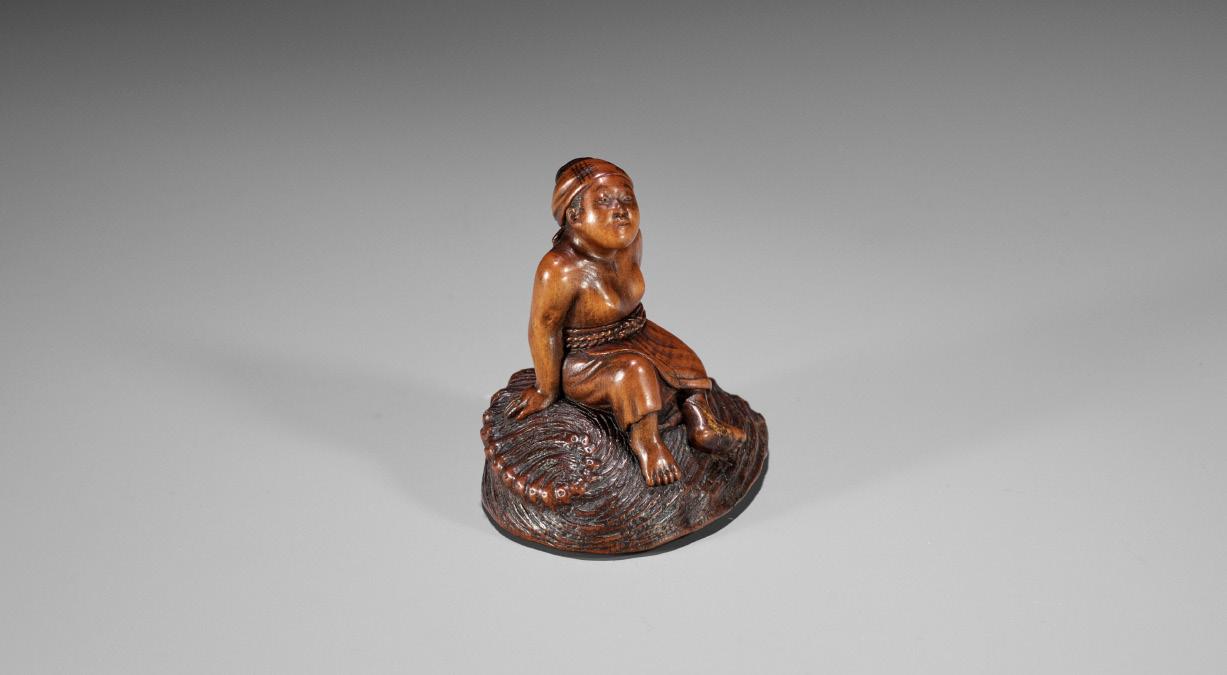
HEIGHT 4.7 cm, LENGTH 4 cm
Condition: A split through the wood and with an associated restoration to the left foot. Some minor wear throughout including some surface scratches to the underside. Otherwise excellent condition.
Provenance: Ex- collection Andre Lichtenberger, sold at Hotel Drouot, Paris, on 19 February 1979, lot no. 15. With Malcolm Fairley Japanese Works of Art. Dutch private collection, acquired from the above.
Suzuki Masakatsu was the son of Masanao I, the founder of a remarkably prolific netsuke carving school which is active to this very day. Masakatsu’s output is fairly limited as he did not enjoy good health, however he is widely regarded by scholars as the most talented of Yamada carvers and often came up with new and original designs, such as the present piece which is not a known subject from the Masanao school.
Estimate EUR 4,000
Starting price EUR 2,000
154
MASAKATSU: A SUPERB WOOD NETSUKE OF A PIEBALD HARE WITH AMBER EYES
By Suzuki Masakatsu, signed Masakatsu 正勝 Japan, Yamada, Ise Province, mid-19th century, Edo period (1615-1868)
Superbly carved, of ideally compact form, depicting a seated rabbit with piebald fur achieved by clever staining, the large eyes inlaid with pure amber, the animal further detailed with long floppy ears and subtly incised and darkly stained whiskers and hairwork, the himotoshi between the left hind paw and the body, the right haunch with the signature within a polished oval reserve MASAKATSU.
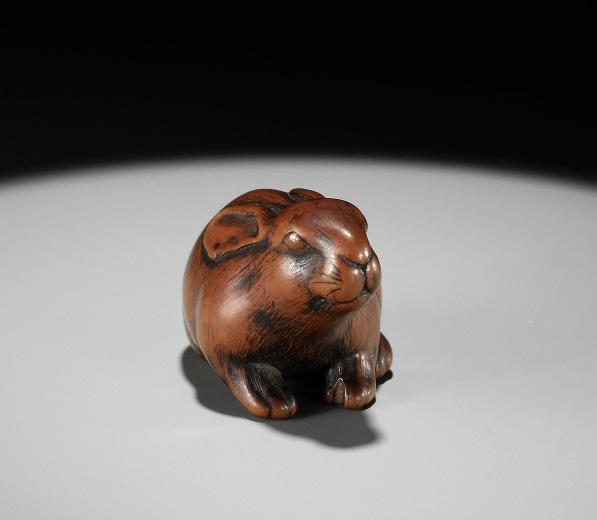
LENGTH 4.3 cm
Condition: Good condition, appealingly worn, distinct wear to the cord channel, few light surface scratches. One tiny chip to left fore paw.
Provenance: Ex-collection Paul Althier, Zurich. Sotheby’s London, 6 December 1972. Douglas J.K. Wright Ltd., London, acquired from the above. Ex-collection Martin Newstead, acquired from the above. Sotheby’s, 24 October 1984, London, lot 76. A noted private collection, USA, acquired from the above.
Suzuki Masakatsu was the son of Masanao I, the founder of a remarkably prolific netsuke carving school which is active to this very day. Masakatsu’s output is fairly limited as he did not enjoy good health, however he is widely regarded by scholars as the most talented of Yamada carvers and often came up with new and original designs or carved existing designs according to his own image and imbued with his own special character.
AUCTION COMPARISON
Compare to a related wood netsuke of a hare, by a member of the Masanao family, at Bonhams, Fine Japanese Art, 11 May 2017, London, lot 3 (sold for 2,250 GBP).



Estimate EUR 4,000
Starting price EUR 2,000
155 126
127 MASAKAZU: A RARE YAMADA SCHOOL WOOD NETSUKE OF TWO SNAILS
By Masakazu, signed Masakazu 正一
Japan, Yamada, Ise Province, 19th century, Edo period (1615-1868)
Well carved as two snails, the smaller crawling along the larger snail’s shell, both with slimy bodies naturalistically rendered with hatched incision work, the shells subtly incised and darkly stained, the larger snail’s foot forming the himotoshi, the underside of its shell incised with the signature within an oblong reserve MASAKAZU.
LENGTH 3.7 cm
Condition: The feelers are repaired. Otherwise good condition with minor wear and few tiny nicks here and there.
LITERATURE COMPARISON
Compare a related netsuke of three snails by Masanao, illustrated in Meinertzhagen, Frederick / Lazarnick, George (1986) MCI, Part A, p. 458.
Estimate EUR 1,500
Starting price EUR 800
128 MASANAO:
A WOOD NETSUKE OF A CROUCHING TOAD

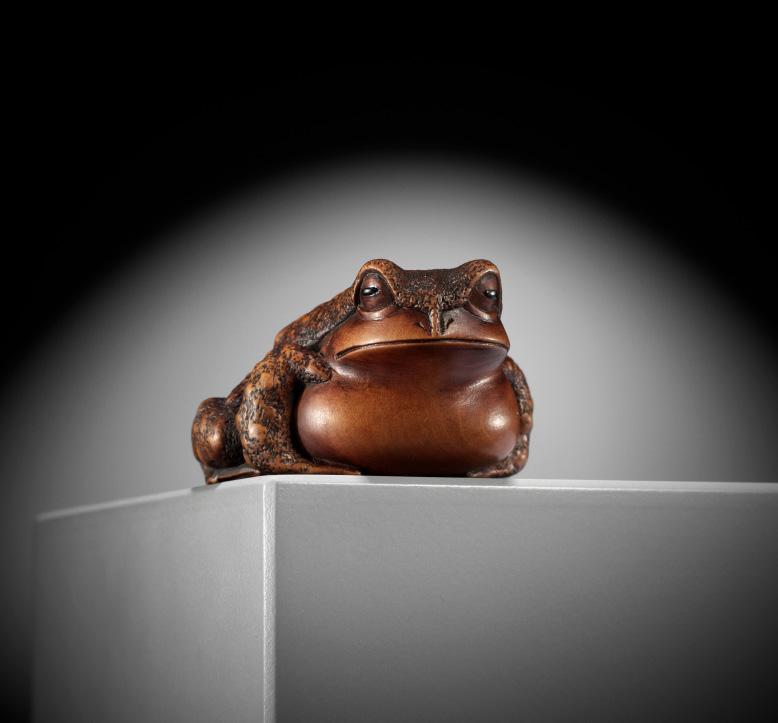
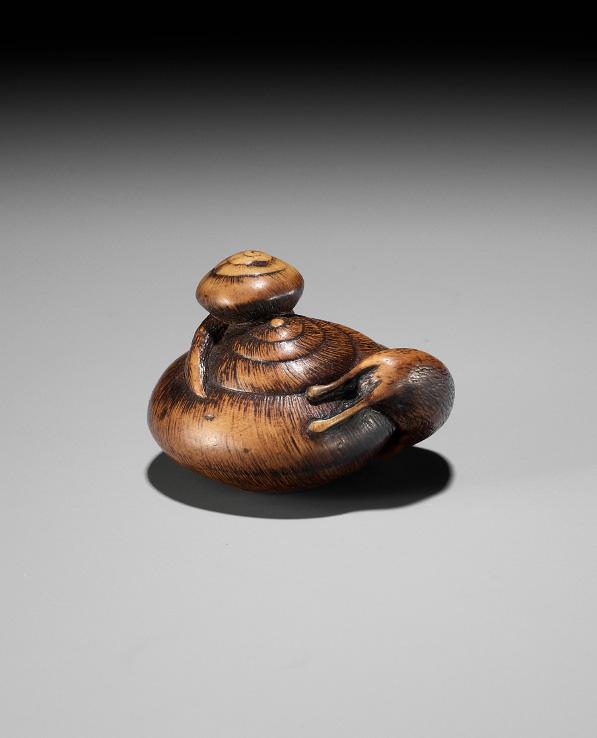
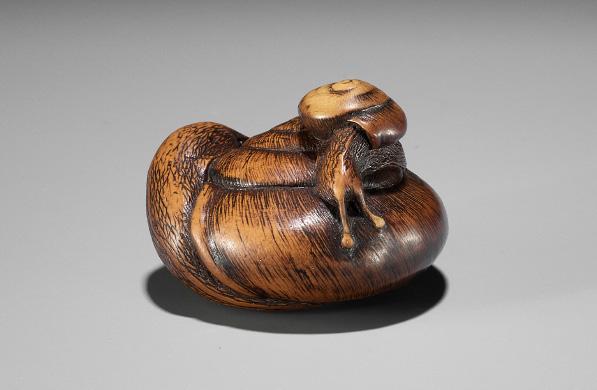
By a member of the Masanao family, signed Masanao 正直
Japan, Yamada, Ise Province, mid-19th century, Edo period (1615-1868)
The wood finely stained, depicting a crouching toad with masterfully rendered skin achieved by large, raised warts against a minutely stippled ground. The eyes are inlays of dark horn. The underside shows the splendidly carved webbed feet and the signature MASANAO. The cord channel runs through the left foreleg.
LENGTH 4.5 cm
Condition: Excellent condition, only minor surface wear.
Provenance: Collection Prof. Dr. Henk C. Hoogsteden, Rotterdam. Formerly in a French private collection, purchased from Galerie Yamato, Paris, 2003.
Estimate EUR 2,000
Starting price EUR 1,000
156
129 MASANAO: A FINE WOOD NETSUKE OF A RECUMBENT BOAR
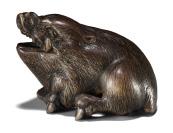


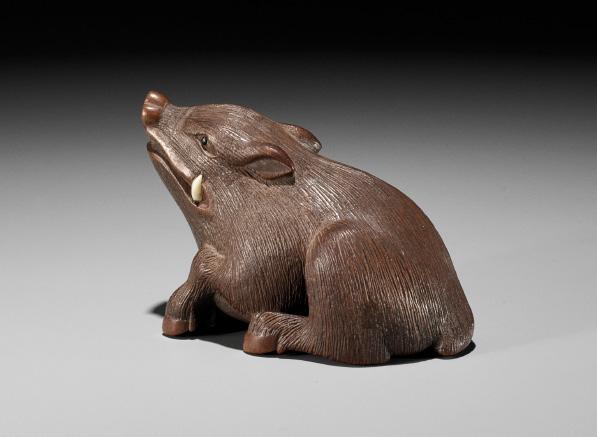

By a member of the Masanao family, signed Masanao 正直 Japan, Yamada, Ise Province, late 19th century to early 20th century
Finely carved, the creature raising its head, the small inlaid tusks at the corner of the mouth showing, the eyes inlaid in dark horn, the hairwork superbly incised, and the crisply carved feet folded underneath for compactness. Natural himotoshi and signed within a polished reserve on the haunch MASANAO.
LENGTH 4.2 cm
Condition: Excellent condition.
AUCTION COMPARISON
From the Masanao sketchbook, illustrated in Highlights from the Masanano Sketchbook, International Netsuke Collectors Society Journal (INCSJ), vol. 2, no. 4, p. 37
A closely related wood netsuke of a boar by Masanao was sold at Zacke, Fine Netsuke & Sagemono, 22 April 2022, Vienna, lot 136 (sold for 4,298 EUR).
Estimate EUR 3,000
Starting price EUR 1,500
157
MASASHIGE: A YAMADA SCHOOL WOOD NETSUKE OF A COILED RAT
By Masashige, signed Masashige 正重 Japan, Yamada, Ise Province, mid to late 19th century
A finely carved wood netsuke of a rat (nezumi) tightly coiled into a ball. A genius design when considering the functionality as a netsuke. This model is believed to originate from the Masanao family of Ise-Yamada and was executed in different variations and sizes across members of the school/family. The details are meticulously rendered, and the large beady eyes are inlaid in dark, lustrous horn. Natural himotoshi through one of the legs and signed within a polished reserve in sosho (cursive script) MASASHIGE – a pupil from the Masanao lineage.
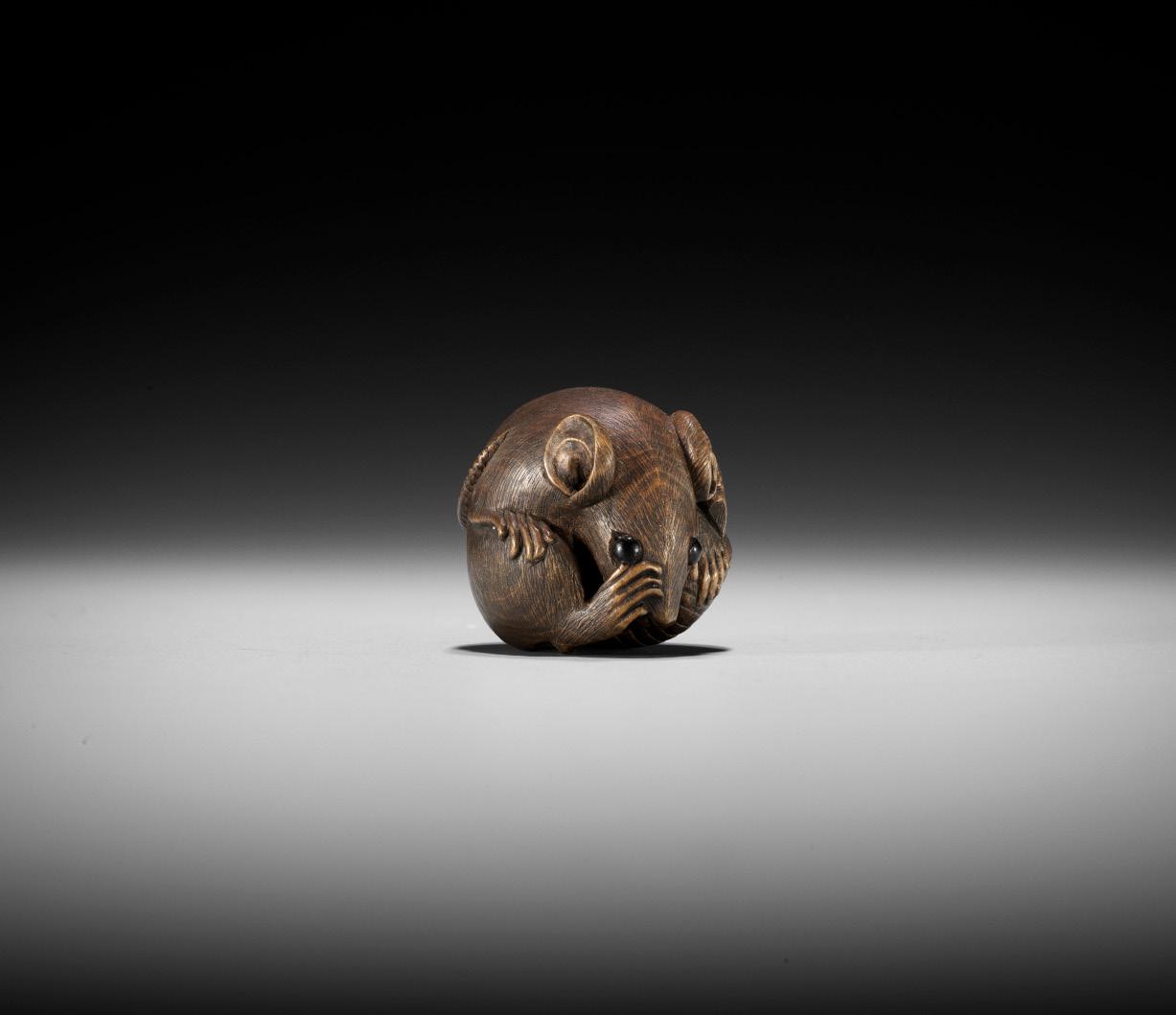
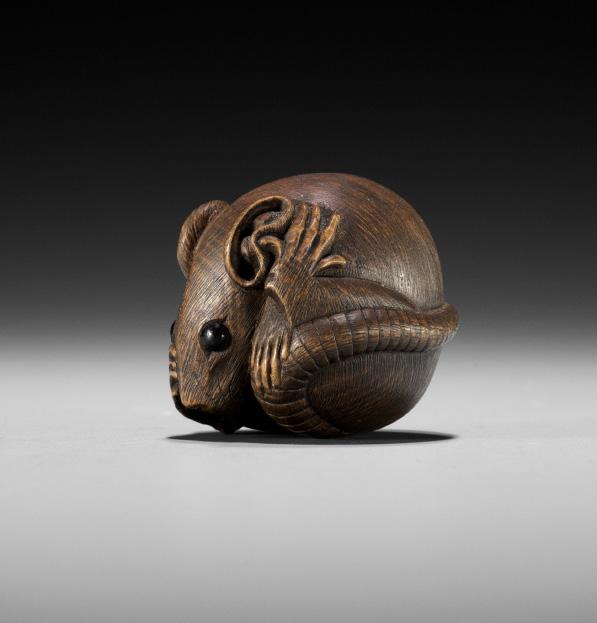
HEIGHT 3.2 cm
Condition: Excellent condition. Minor wear. Provenance: A noted private collection, USA, purchased from Norman L. Sandfield.
Estimate EUR 3,000
Starting price EUR 1,500
158 130
KINSUI: A CONTEMPORARY WOOD NETSUKE OF A COILED RAT

 By Kinichi Kawase (born 1926), signed Kinsui 欽 水 Japan, Mie prefecture, second half of 20th century
By Kinichi Kawase (born 1926), signed Kinsui 欽 水 Japan, Mie prefecture, second half of 20th century
A finely carved and compact wood netsuke of a coiled rat grabbing its large, finely carved tail and scratching its snout and ear with its hind paws. The large eyes are inlays of dark, lustrous buffalo horn. The hairwork is superbly incised. Natural himotoshi and signed within a polished reserve KINSUI. With a wood box box from H. I. H. Princess Takamado inscribed with the artist’s name.
HEIGHT 3.4 cm
Condition: Excellent condition.
Provenance: Ex-collection H. I. H. Princess Takamado.
Kinsui (real name Kinichi Kawase), an electrical engineer born in Mie prefecture, started carving netsuke in 1953. His style is distinctly that of the Masanao family hailing from the same prefecture.
Estimate EUR 2,000
Starting price EUR 1,000
159 131
132 MINKO: A DARK WOOD NETSUKE OF A FAT TOAD


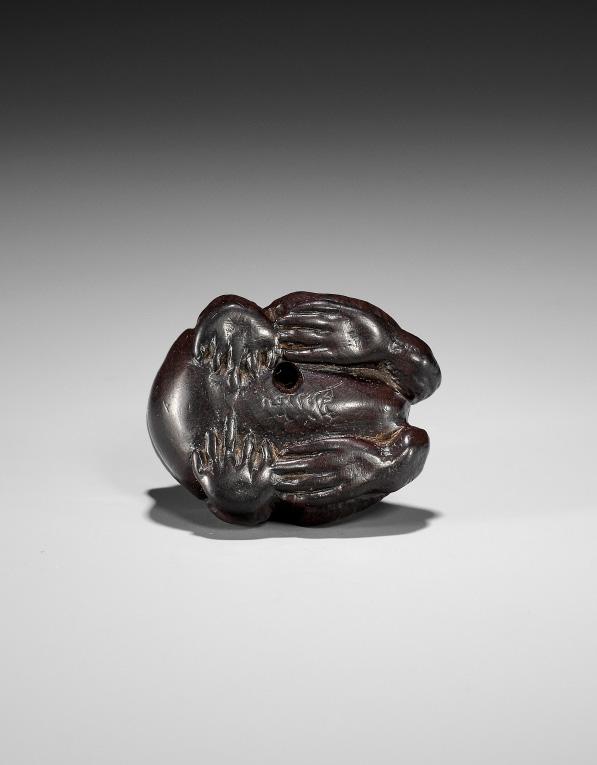

Minko lineage, signed Minko 珉江 with kakihan Japan, Tsu, early 19th century, Edo period (1615-1868)
The bloated fat toad crouching in an alert position, the warty skin naturalistically rendered, the underside showing the large, webbed feet tucked underneath the body, forming a compact composition, the eyes inlaid in pale horn with dark pupils. The dark-reddish wood bearing a fine patina. Himotoshi to the side and underside, signed MINKO and kakihan.
LENGTH 3.8 cm
Condition: Very good condition, minor surface wear. One eye is replaced.
LITERATURE COMPARISON
A closely related wood netsuke depicting a crouching toad by Minko is illustrated in Ducros, Alain (1987) Netsuke & Sagemono 2, pp. 86-87, no. 155.
Estimate EUR 2,000
Starting price EUR 1,000
160
133
By Kokei, signed Kokei 虎溪 Japan, Kuwana, Ise Province, 19th century, Edo period (1615-1868)
Finely carved as a chubby puppy nestled within a dustpan, the fur neatly engraved and the expression imbued with charm and character. Two asymmetrical himotoshi underneath and signed within a polished area KOKEI.
134
LENGTH 3.5 cm
Condition: Very good condition with minor wear including some tiny surface nicks.
Provenance: From an Austrian private collection, Vienna.
Estimate EUR 1,500
Starting price EUR 800
Well carved seated with its head raised and turned to one side, the puppy with an alert expression, the eyes inlaid with dark horn, the wood of an attractive dark tone, one haunch incised with the signature MINKO with a kakihan.
LENGTH 3.7 cm
Condition: Very good condition with minor expected wear and traces of use.
Provenance: Ex-collection Conte Don Enrico Lucchesi Palli (1861-1924), Monarch of Campofranco. Purchased in 1889, when he accompanied his cousin Enrico (Henry), Prince of Parma, Earl of Bardi, on a tour of the world from 1887-1891. Thence by descent within the same family. Old label.
LITERATURE COMPARISON
Compare to a similar netsuke by Minko in Barry Davies Oriental Art, The Netsuke Collection of W.G Bosshard Part 1, no. 42.



Conte Don Enrico Lucchesi Palli (18611924)

Auction comparison: A similar netsuke by Minko was offered at Bonhams, The Julius and Arlette Katchen Collection of Fine Netsuke Part II, 10 May 2017, London, lot 124 (sold for 1,875 GBP).
Estimate EUR 2,000
Starting price EUR 1,000
161
MINKO: A CHARMING EBONY WOOD NETSUKE OF A PUPPY
By Tanaka Juntoku Minko (1735-1816), signed Minko 岷江 Japan, Tsu, early 19th century, Edo period (1615-1868)
KOKEI: A WOOD NETSUKE OF A PUPPY INSIDE A DUSTPAN
KOKEI: A FINE AND RARE WOOD NETSUKE OF A HARE
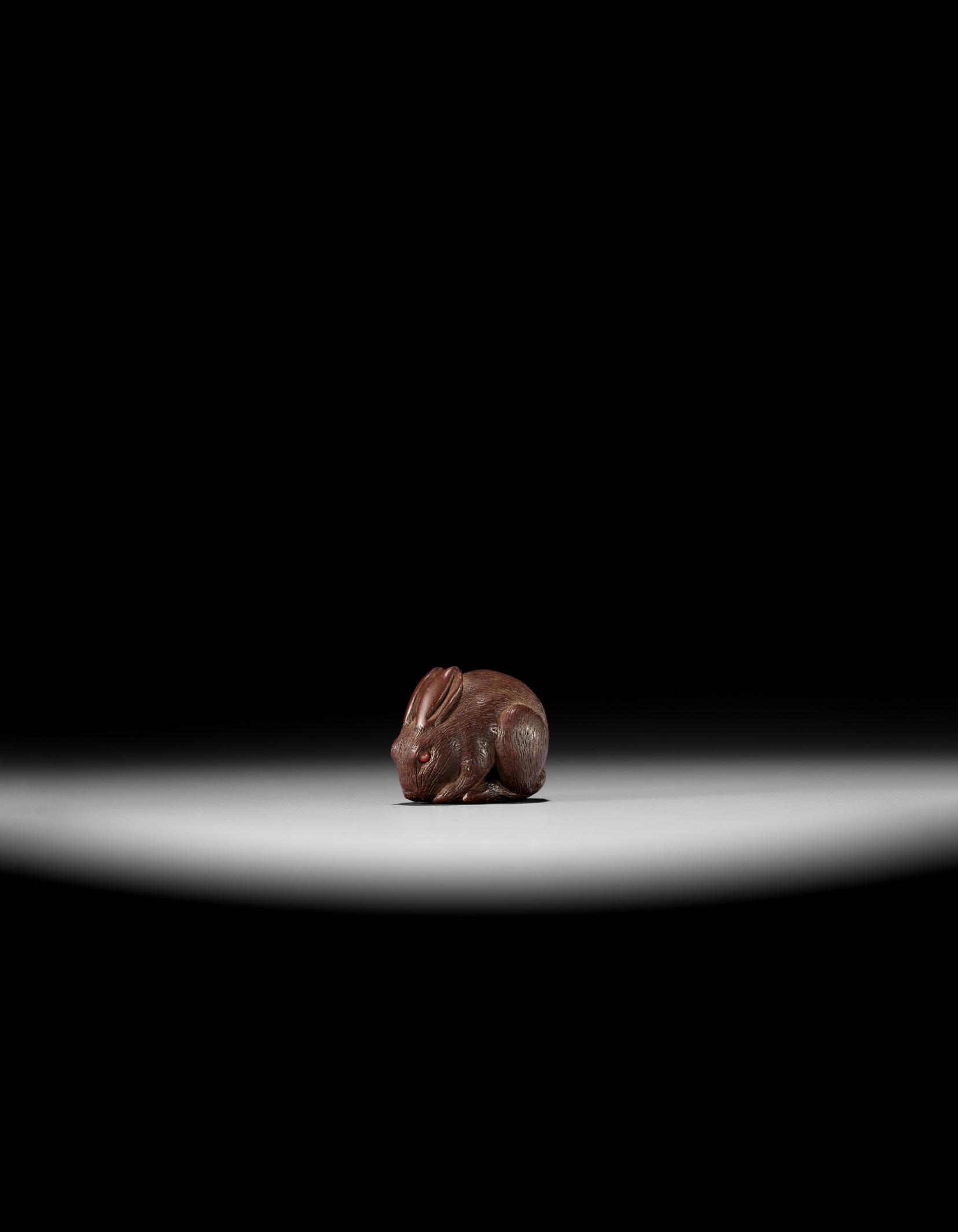 By Kokei, signed Kokei 虎溪 Japan, Kuwana, Ise Province, 19th century, Edo period (1615-1868)
By Kokei, signed Kokei 虎溪 Japan, Kuwana, Ise Province, 19th century, Edo period (1615-1868)
An attractively compact and finely carved wood netsuke of a longeared rabbit (usagi) with its head lowered to the ground and licking its fore paws. The hairwork is neatly incised in the typical manner of the artist and the eyes are inlaid in red-painted mother-of-pearl. Natural himotoshi and signed within an oval reserve to the belly KOKEI.
LENGTH 3.4 cm
Condition: Excellent condition, minor wear to surface and to the eyes.
Provenance: Bonhams, Fine Japanese Works of Art including Selections from the Collection of Ruth and Carl Barron, 16 September 2014, New York, lot 2069. A noted private collection, USA, acquired from the above.
The present subject is rarely treated by Kokei and recorded examples usually depict the hare in groups of 2 or more.
AUCTION COMPARISON
Compare to a related ebony netsuke of two hares, by Kokei, at Bonhams, Fine Japanese Art, 6 November 2012, London, lot 151 (sold for 5,000 GBP).

Estimate EUR 4,000
Starting price EUR 2,000
135
136
MINKO: A SUPERB WOOD NETSUKE OF A RECUMBENT HORSE
By Tanaka Juntoku Minko (1735-1816), signed Minko 岷江 with
kakihan
Japan, Tsu, late 18th to early 19th century, Edo period (1615-1868)
Published: Wertheim, Stanley (Winter 2008) Auctions, International Netsuke Society Journal, Vol. 28, No.4, p 41.
Finely carved in a recumbent pose with the legs drawn in for compactness, the body slightly emaciated with subtly detailed spine and incised ribs, the attentive face with inlaid gilt-brass eyes with dark pupils and framed by a full mane which is finely incised, as is the tail slung to one side. Himotoshi between the tail and body. The underside signed in typically boldly incised characters MINKO with a kakihan.
LENGTH 4.5 cm
Condition: Very good condition, minor wear and traces of use, few tiny nicks here and there.
Provenance: Bonhams, Japanese Works of Art, 19 September 2008, New York, lot 5100 (sold for 14,400 USD). French private collection, acquired from the above.
Tanaka Minko produced a number of netsuke depicting recumbent horses, generally in boxwood, although a few were made from ebony. The present example is a good example of the genre, with a finely-carved head and mane and the eyes typically inlaid with giilt-brass with inlaid dark pupils.


MUSEUM COMPARISON
Compare a closely related kaki wood netsuke of a recumbent horse by Tanaka Minko, formerly in the Trumpf collection and now in the Linden Museum Stuttgart, inventory number OA 19042.
AUCTION
COMPARISON
Compare a closely related wood netsuke of a recumbent horse by Tanaka Minko at Bonhams, Fine Netsuke from the Adrienne Barbanson Collection, 13 May 2013, London, lot 15 (sold for 7,500 GBP).
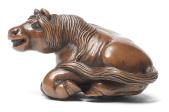

Estimate EUR 6,000
Starting price EUR 3,000
163
137
MINKO:
By Tanaka Juntoku Minko (1735-1816),
Minko
A remarkably powerful sculpture with boldly incised strokes, yet still retaining sophisticated detail. The goat is shown in a reclining posture, the large feet with the hallmark chubby hooves are neatly tucked underneath the body for compactness and the large ears and horns are resting against the shoulders and back. The wood bears a rich, deep patina and the eyes are typically inlaid in gilt brass with dark pupils. Natural himotoshi and signed within a polished reserve underneath with some red pigment added TANAKA MINKO – a rather early piece by this legendary netsuke-shi who was mentioned in the Soken Kisho of 1781.
LENGTH 4.3 cm
Condition: Excellent condition considering age and use, some minor surface wear here and there. Beautiful, dark patina to the exposed areas.
Provenance: A noted private collection, USA.
AUCTION COMPARISON
A closely related wood netsuke of a goat by Minko (note also the similar kakihan) was sold at Bonhams, Netsuke from a European Private Collection, 8 May 2016, London, lot 29 (sold for 6,875 GBP).



Estimate EUR 4,000
Starting price EUR 2,000
164
A WOOD NETSUKE OF A RECUMBENT GOAT
signed
岷江 with kakihan Japan, Tsu, 18th century, Edo period (1615-1868)
MINKO: AN EXQUISITE EBONY WOOD NETSUKE OF A RECUMBENT OX


 By Tanaka Juntoku Minko (1735-1816), signed Minko 岷江 with kakihan
By Tanaka Juntoku Minko (1735-1816), signed Minko 岷江 with kakihan
Japan, Tsu, late 18th to early 19th century, Edo period (1615-1868)
Published: Katchen, Arlette (2010) Netsuke 7, Vol. 2, p. 79, no. K249.

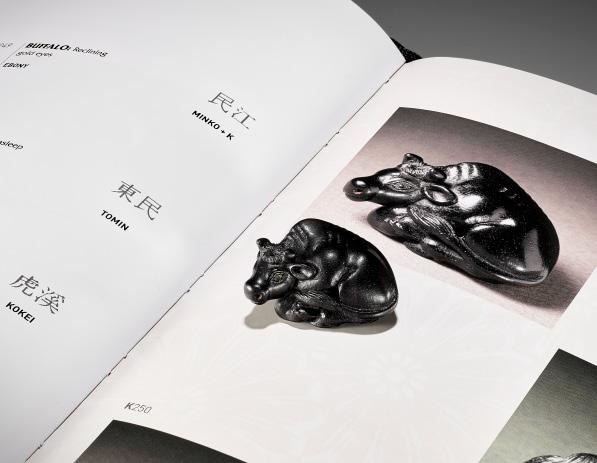
A sensitively crafted depiction of a recumbent ox, its body hunched together forming a compact composition, the eyes inlaid in brass with dark pupils, red pigment used for some of the details such as the nostrils. The kokutan wood is beautifully polished, some of the incised hairwork is still visible within the crevices. Natural himotoshi and signed underneath the haunch MINKO and kakihan.
LENGTH 3.6 cm
Condition: Very good condition, minor wear, fine patina. Provenance: Ex-collection Julius & Arlette Katchen, Paris. Sold at Bonhams, The Julius & Arlette Katchen Collection of Fine Netsuke Part I, 8 November 2016, London, lot 55. A noted private collection, USA, acquired from the above.
LITERATURE COMPARISON
A closely related ebony wood netsuke of an ox, with red-inked signature Minko and kakihan, is illustrated in Meinertzhagen, Frederick / Lazarnick, George (1986) MCI, Part A, p. 508.

AUCTION COMPARISON
Compare a closely related and unsigned ebony wood netsuke, in the style of Minko, at Van Ham, Netsuke & Japanische Kunst, 8 June 2017, Cologne, lot 1648 (sold for 3,612 EUR). Also compare to a closely related ebony wood netsuke of an ox with calf, by Minko, at Bonhams, Fine Netsuke from a French Private Collection, 4 November 2020, London, lot 45 (sold for 6,938 EUR).
Estimate EUR 4,000
Starting price EUR 2,000
165
138
139
HARITSU: AN EBONY NETSUKE OF AN OX AND CALF

 By Haritsu, signed Haritsu 破笠 Japan, 18th-19th century, Edo period (1615-1868)
By Haritsu, signed Haritsu 破笠 Japan, 18th-19th century, Edo period (1615-1868)
A delicate, remarkably powerful, and superbly carved ebony wood netsuke depicting a recumbent cow raising her head, with a sensitively crafted expression, her calf nestling up to her below and affectionately licking her chin. The hairwork is neatly incised, appropriately worn at the high points, and the ridged spine and ribs are subtly expressed. The rope halter which passes through the cow’s nose ring, the curved horns, as well as all other details are achieved with exceptional detail. An area of pale-brown shading in the wood has been skillfully incorporated by the carver as a spot to the cow’s haunches. The underside shows the many wellcarved hooves, as well as the generously excavated asymmetrical himotoshi, and the signature HARITSU – the kanji are the same as used by Ogawa Haritsu (1663-1747).

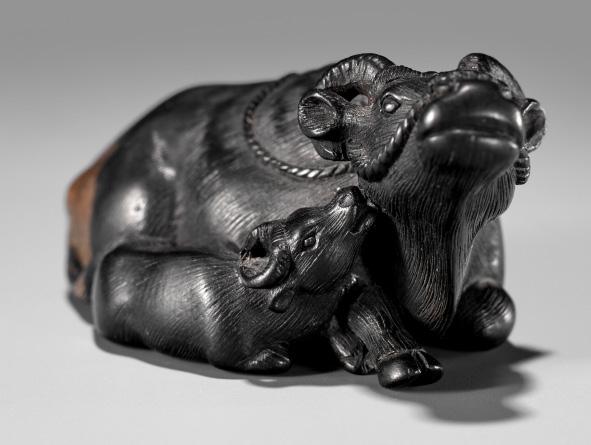
LENGTH 5.3 cm
Condition: Good condition with minor wear, one front leg with an old repair.
Provenance: A noted private collection, USA.
AUCTION COMPARISON
Compare a similar unsigned Kyoto-school ebony netsuke of an ox and calf, 4.5 cm long, dated late 18th to early 19th century, at Galerie Zacke, Fine Netsuke & Sagemono, 22 April 2022, Vienna, lot 42 (sold for 4,175 EUR).
Estimate EUR 3,000
Starting price EUR 1,500
166
Unsigned
Japan, 19th century, Edo period (1615-1868)
Finely carved in the manner of Horaku to depict a resting bat, hanging by the tips of its wings, which are drawn in to form a compact composition as well as a narrow base on which the netsuke stands. The bat’s body is covered with fine hairwork and its beady eyes are inlaid with dark horn, one side with the asymmetrical himotoshi, the larger of which is generously excavated to accommodate the knot.

LENGTH 5.5 cm
Condition: Very good condition with minor wear.
AUCTION COMPARISON
Compare a closely related ebony wood netsuke of a bat with its wing placed in a peculiar position, by Horaku, ex-collection Raymond Bushell, at Sotheby’s, Japanese and Korean Art, 9 June 2004, London, lot 1144 (estimate 5,000-6,000 GBP).
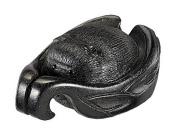

Estimate EUR 3,000
Starting price EUR 1,500
167
140
A RARE EBONY NETSUKE OF A BAT
141
KOKEI: A WOOD NETSUKE OF A TIGER
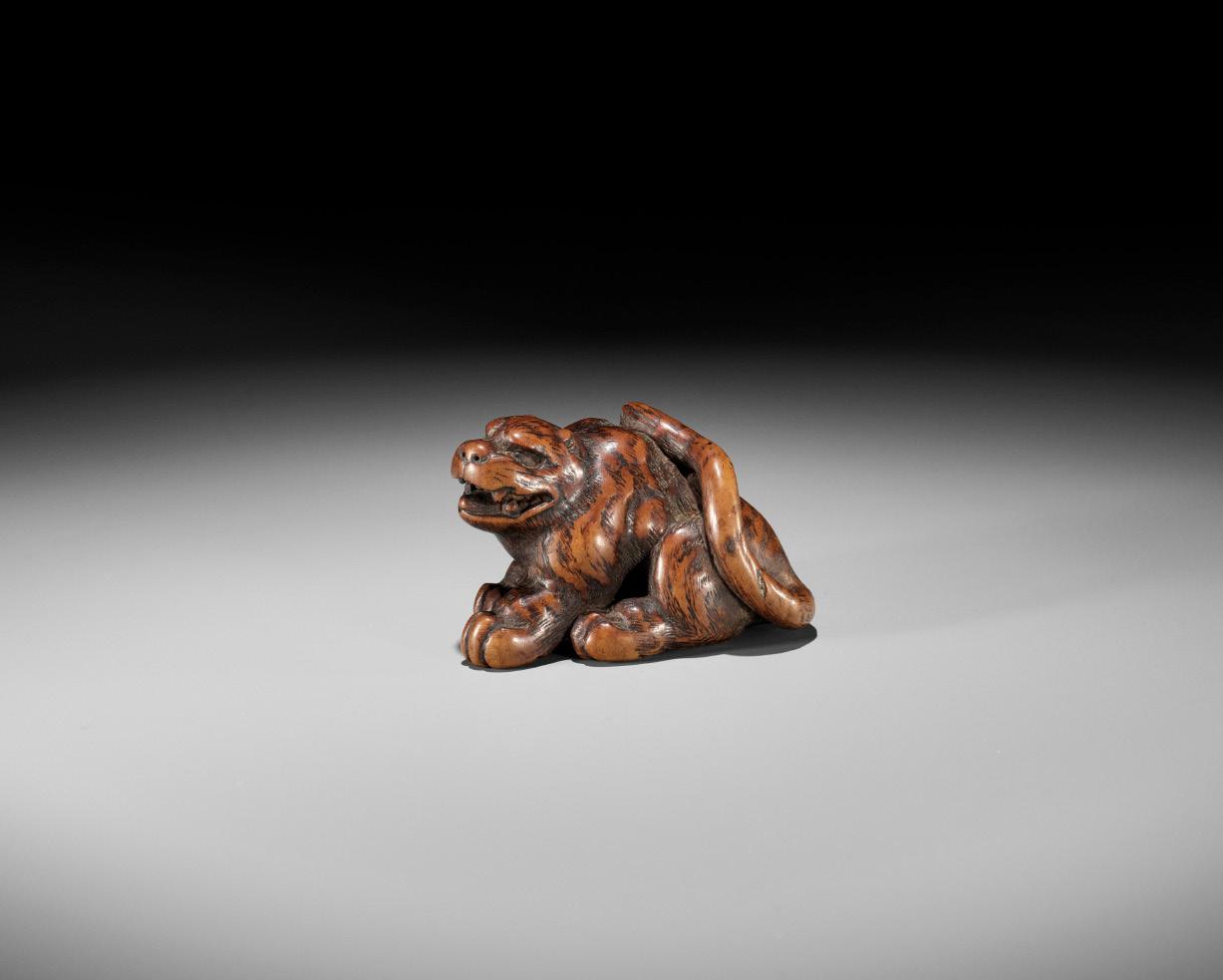 By Kokei, signed Kokei 虎溪 Japan, Kuwana, Ise Province, c. 1800, Edo period (1615-1868)
By Kokei, signed Kokei 虎溪 Japan, Kuwana, Ise Province, c. 1800, Edo period (1615-1868)
Finely carved, the wood bearing a deep unctuous patina, depicting a crouching tiger sporting a naturalistically rendered fur coat, the amusingly chubby paws pushed afore dynamically, and the thick tail powerfully curling up its backside. The eyes are inlaid with dark horn. The underside shows the signature KOKEI within a polished reserve. Natural himotoshi.

LENGTH 4 cm
Condition: Very good condition with some minor surface wear and tiny nicks. Superb, deep patina.
Provenance: A noted private collection, USA.
AUCTION COMPARISON
A closely related wood netsuke of a tiger, slightly later of date, was sold by Zacke, Fine Netsuke & Sagemono, 27 March 2020, Vienna, lot 73 (sold for 5,256 EUR).
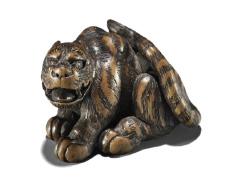
Estimate EUR 3,000
Starting price EUR 1,500
168
KOKEI: A WOOD
OF A TIGER AND CUB
A beautifully refined and compact wood netsuke of a tigress snarling and protectively placing one paw on her cub’s back, while the young tiger nestles up against her body, the head raised in order to lick its mother’s neck. The fur is achieved in the typical manner of the artist through alternating areas of incision work and polished sections. Note also the superbly carved tail which curls around over the mother tiger’s back. The underside shows the many well-carved, chubby paws and the signature KOKEI within a polished reserve. Natural himotoshi.




LENGTH 3.8 cm
Condition: Very good condition with only very little wear. Possibly a tiny chip to the very edge of the tail.
Provenance: A noted private collection, USA.
AUCTION COMPARISON
Compare a closely related wood netsuke of a tigress and cub, by Kokei, sold at Bonhams, The Julius & Arlette Katchen Collection of Fine Netsuke Part II, 10 May 2017, London, lot 60 (sold for 4,375 GBP). Also compare to a closely related wood netsuke of a tiger and cub, by Kokei, sold at Bonhams, Fine Netsuke from a French Private Collection, 4 November 2020, London, lot 48 (sold for 5,312 GBP).
Estimate EUR 3,000
Starting price EUR 1,500
169
142
NETSUKE
By Kokei, signed Kokei 虎溪 Japan, Kuwana, Ise Province, first half of 19th century, Edo period (1615-1868)
143
SHIGEYOSHI: AN INLAID DARK WOOD NETSUKE OF KIYOHIME
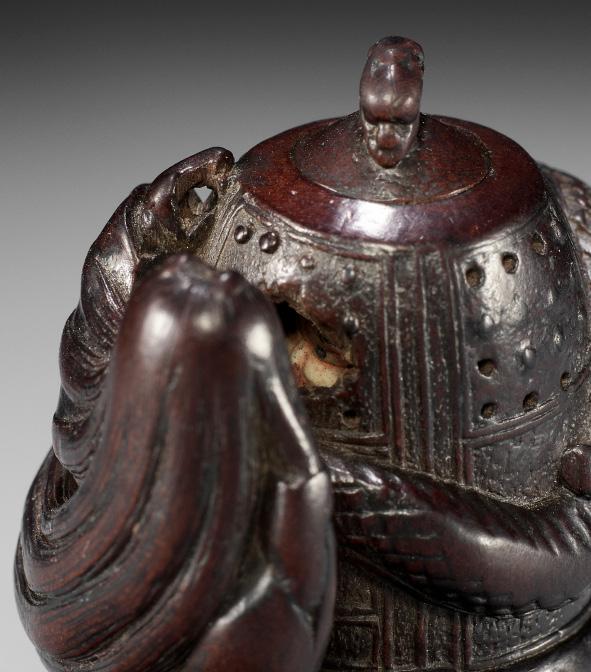 By Shigeyoshi, signed Shigeyoshi 重敬 to 刀 Japan, 19th century, Edo period (1615-1868)
By Shigeyoshi, signed Shigeyoshi 重敬 to 刀 Japan, 19th century, Edo period (1615-1868)
Finely carved to depict the enraged witch Kiyohime, her inlaid face well detailed, her monstrous serpentine body coiled around the bell of Dojo-ji temple, inside which the priest Anchin is hiding, his face visible through a hole to one side. The handle of the bell can be turned to alternate between the two expressions of Anchin, one showing a pale, frightened expression and the other burnt-red from fire. The underside with large himotoshi and the signature SHIGEYOSHI.

LENGTH 3.6 cm
Condition: Very good condition with minor wear and traces of use. Provenance: German private collection.
The present netsuke is mentioned in Davey, Neil K. (1974) Netsuke: A comprehensive study based on the M.T. Hindson Collection, p. 521, artist no. 2382: “One recorded. Wood. Figure of Kiyohime. Early”.


Kiyohime is a character in the story of Anchin and Kiyohime. In this story, she fell in love with a Buddhist monk named Anchin, but after her interest in the monk was rejected, she chased after him and transformed into a serpent in a rage, before killing him in a bell where he had hidden in the Dojo-ji temple. The story originally appeared in two collections of setsuwa (tales), Dainihonkoku hokekyo kenki (c. 1040) and Konjaku Monogatarishu (c. 1120).
AUCTION COMPARISON
Compare a related inlaid ebony netsuke by Tanaka Minko depicting the same subject at Galerie Zacke, Fine Netsuke, Sagemono & Okimono, 24 November 2018, Vienna, lot 70 (sold for 8,469 EUR).
Estimate EUR 2,000
Starting price EUR 1,000
144
TOMOKAZU: A FINE WOOD NETSUKE OF KIYOHIME WITH THE TEMPLE BELL OF DOJO-JI
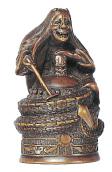


 By Kano Tomokazu, signed Tomokazu 友一 Japan, Gifu, 19th century, Edo period (1615-1868)
By Kano Tomokazu, signed Tomokazu 友一 Japan, Gifu, 19th century, Edo period (1615-1868)
Superbly carved, the serpentine monster winding around the bell of Dojo-ji, her scales meticulously rendered, her facial features well crafted, appearing almost like a Hannya mask, her long flowing hair in the back neatly incised. The vengeful witch holds a T-shaped striker in one hand and a loose strand of her hair in the other. The bell is finely carved as well with a neatly stippled ground and raised bosses, the removable and turnable handle carved with two dragons. Anchin’s face is visible through a small hole in the bell. Good himotoshi to Kiyohime’s back and underneath and signed TOMOKAZU within the typical oval reserve.
LENGTH 3.7 cm
Condition: A small chip to the edge of the handle and to one horn. Repair to the interior mechanism. Otherwise good condition.
Provenance: Christie’s, 4 November 2009, New York, lot 131. A noted private collection, USA, acquired from the above.
AUCTION COMPARISON
The subject. which is usually associated with Minko and the Tsu school. is rare for Tomokazu. For an example of the same subject depicted in a different manner see Sotheby’s, The Swedlow Collection of Inro, Lacquer and Ojime, 31 March 1993, London, lot 69.
Estimate EUR 2,500
Starting price EUR 1,200
171
145
MINKO: A WOOD NETSUKE OF YOJO STABBING THE KING’S CLOAK
By Tanaka Juntoku Minko (1735-1816),
signed Minko 岷江 with kakihan
Japan, Tsu, early 19th century, Edo period (1615-1868)
Depicting Yojo seated and stabbing Cho Bujutsu’s cloak with his sword, his expression marked with determination. The pupils are minutely inlaid in dark horn. One ringed himotoshi through the cloak and signed to the underside with red pigment MINKO. Note the superbly carved hair in the back with boldly incised strokes, interestingly somewhat similar in conception to Minko’s goat beards (lot 137).
LENGTH 3.9 cm
Condition: Very good condition with associated old surface wear.
LITERATURE COMPARISON
Compare to a netsuke depicting the same subject in Jirka-Schmitz Patrizia, The World of Netsuke, The Werdelmann Collection at the Museum Kunstpalast Düsseldorf, p. 40, no. 80.
The story of Cho Bujutsu and Yojo is described in Henri L. Joly, Legend in Japanese Art, p. 569. Yojo (in Chinese Yu Jang) wanted to avenge the death of his master by the hands of Cho Bujutsu. Several futile attempts ended up with Yojo begging for Cho’s royal mantle, which he then stabbed into shreds with his sword as a token of his revenge. Afterwards, Yojo killed himself as he could no longer live under the same heaven as his rival.
Estimate EUR 2,000
Starting price EUR 1,000
146
MINKO: A WOOD TRICK NETSUKE OF A DARUMA DOLL


By Tanaka Juntoku Minko (1735-1816), signed Minko 岷江 with kakihan
Japan, Tsu, early 19th century, Edo period (1615-1868)
A beautifully rounded and compact wood netsuke, the light-toned wood superbly polished and attractively tactile, depicting a daruma doll with stern expression and incised beard, the eyes switching when lightly tapped. Large, asymmetrical himotoshi underneath, the smaller hole ringed, and signed MINKO with a red-inked kakihan.
HEIGHT 2.8 cm
Condition: Very good condition with only very minor wear. The mechanism slightly loose.
Provenance: A noted private collection, USA.
LITERATURE COMPARISON
A similar, yet larger netsuke by Minko in a similarly toned wood is illustrated in Bandini, Rosemary (2019), The Larry Caplan Collection of Japanese Netsuke, no. 3.

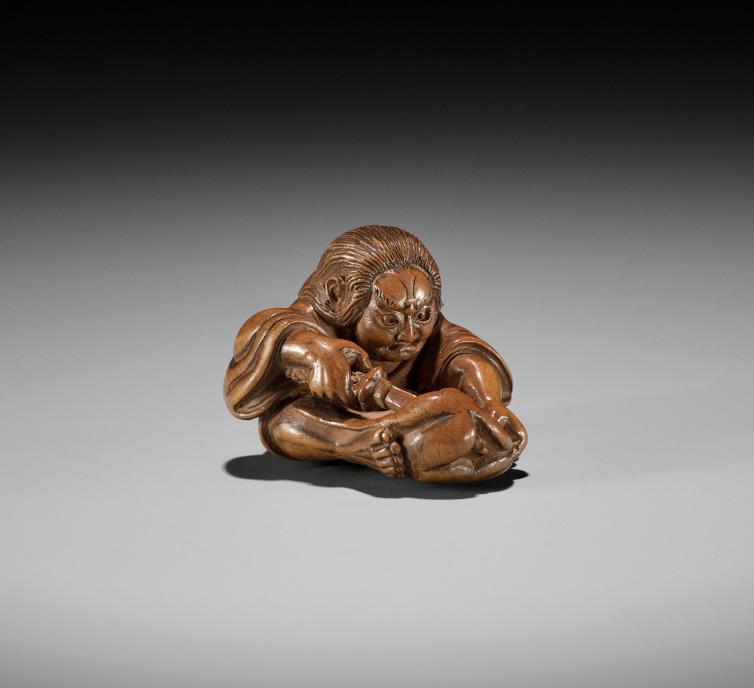
Estimate EUR 1,500
Starting price EUR 800
172
147 HARUMITSU: AN IMPRESSIVE WOOD NETSUKE OF A COILED DRAGON



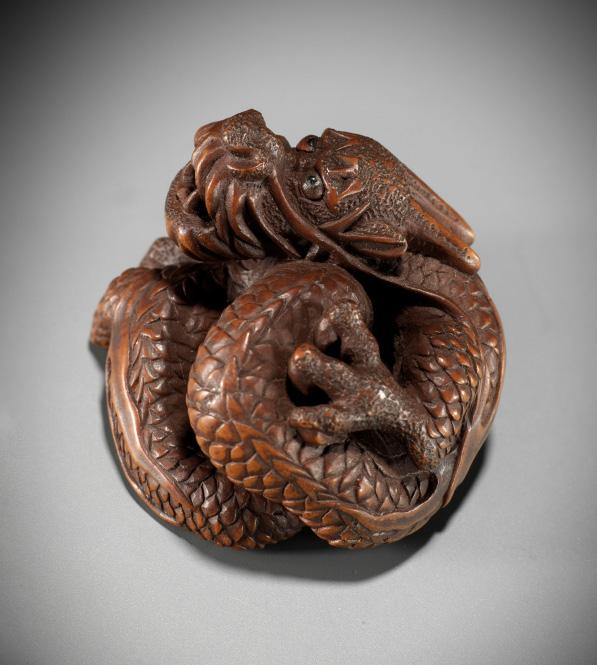 By Harumitsu (Shunko), signed Harumitsu 春光 Japan, Yamada, Ise
By Harumitsu (Shunko), signed Harumitsu 春光 Japan, Yamada, Ise
Finely carved with meticulously rendered scales and cleverly alternating textures, the dragon coiling around itself in a powerful stance and releasing a mighty roar. The sharp claws and flames emanating from its body are testament to its might, however the rather amusing expression marked by inlaid eyes of pale translucent horn with dark pupils creates a humorous contrast. Natural himotoshi and signed within a raised oval reserve HARUMITSU.
LENGTH 3.9 cm
Condition: Very good condition, only very minor wear, one inlaid eye possibly replaced.
Provenance: A noted private collection, USA.
Relatively little is known about the artist Harumitsu (Shunko), though it is suspected he was a pupil from the Masanao line of Yamada. The present piece also shows some similarities to the school of Minko (see auction comparison).
AUCTION COMPARISON
Compare to a closely related wood netsuke of a dragon by Harumitsu sold at Bonhams, Fine Japanese Works of Art, 13 September 2011, New York, lot 2025 (sold for 4,750 USD). Also compare to a related wood netsuke of a dragon signed Minko sold at Zacke, Fine Netsuke & Sagemono, 16 April 2021, Vienna, lot 112 (sold for 2,928 EUR).
Estimate EUR 4,000
Starting price EUR 2,000
173
Province, mid-19th century, Edo period (1615-1868)
148
HIDARI ISSAN: A SUPERB WOOD NETSUKE OF A COILED DRAGON
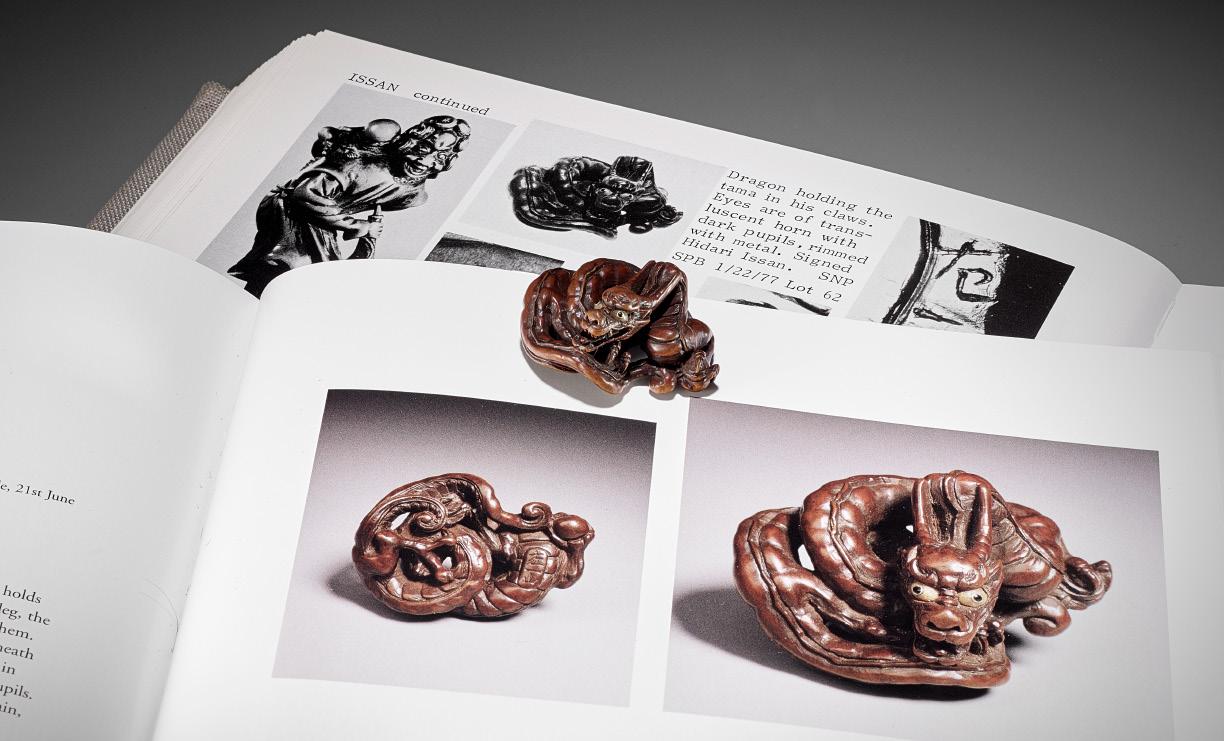




 By Hidari Issan, signed Hidari Issan 左一山 Japan, Iwashiro, c. 1840, Edo period (1615-1868)
By Hidari Issan, signed Hidari Issan 左一山 Japan, Iwashiro, c. 1840, Edo period (1615-1868)
Published:
Lazarnick, George (1981) Netsuke & Inro Artists, and How to Read Their Signatures, vol. I, p. 520. Sydney L. Moss (2008) Such Stuff as Dreams are made on. Japanese netsuke from the Willi G. Bosshard collection, p. 145, no. 69.
Exquisitely carved as a smooth dragon coiling its body back on itself in irregular loops and clutching a sacred tama (jewel) in its left foreclaw. The underside is reticulated, well detailed with claws, scales, and a curling tail tip, and the beast’s head is pulled back in a defensive pose. The glaring eyes are inlaid in bone with gilt-rimmed dark horn pupils.
LENGTH 4.3 cm
Condition: Excellent condition with only very minor wear. Provenance: Sotheby’s, 22 January 1977, Honolulu, lot 62. Kunsthandel Klefisch, June 1996, Cologne. Ex-collection Willi G. Bosshard, acquired from the above. Sydney L. Moss, London, 2008. British collection, acquired from the above.
Hidari Issan is a noteworthy and highly regarded netsuke carver, not least by Frederick Meinertzhagen who ranked him among the best, alongside Toyomasa, Tadatoshi, and Ikkan, and recorded a netsuke of his dated as early as 1798.
Literature comparison: Compare a related wood netsuke of a coiled dragon with tama by Hidari Issan, with similarly inlaid eyes, illustrated in Ducros, Alain (1987) Netsuke & Sagemono 2, p. 90, no. 177.
AUCTION COMPARISON
The artist has carved several variations of this subject, though none of them are exactly alike. One was sold at Bonhams, The Julius and Arlette Katchen Collection of Fine Netsuke Part II, 10 May 2017, London, lot 72 (sold for 11,250 GBP); another was sold at Galerie Zacke, Fine Netsuke & Sagemono, 25 September 2020, Vienna, lot 129 (sold for 10,112 EUR); and a third was sold at Galerie Zacke, 27 January 2022, Vienna, lot 600 (sold for 7,584 EUR).
Estimate EUR 8,000
Starting price EUR 4,000
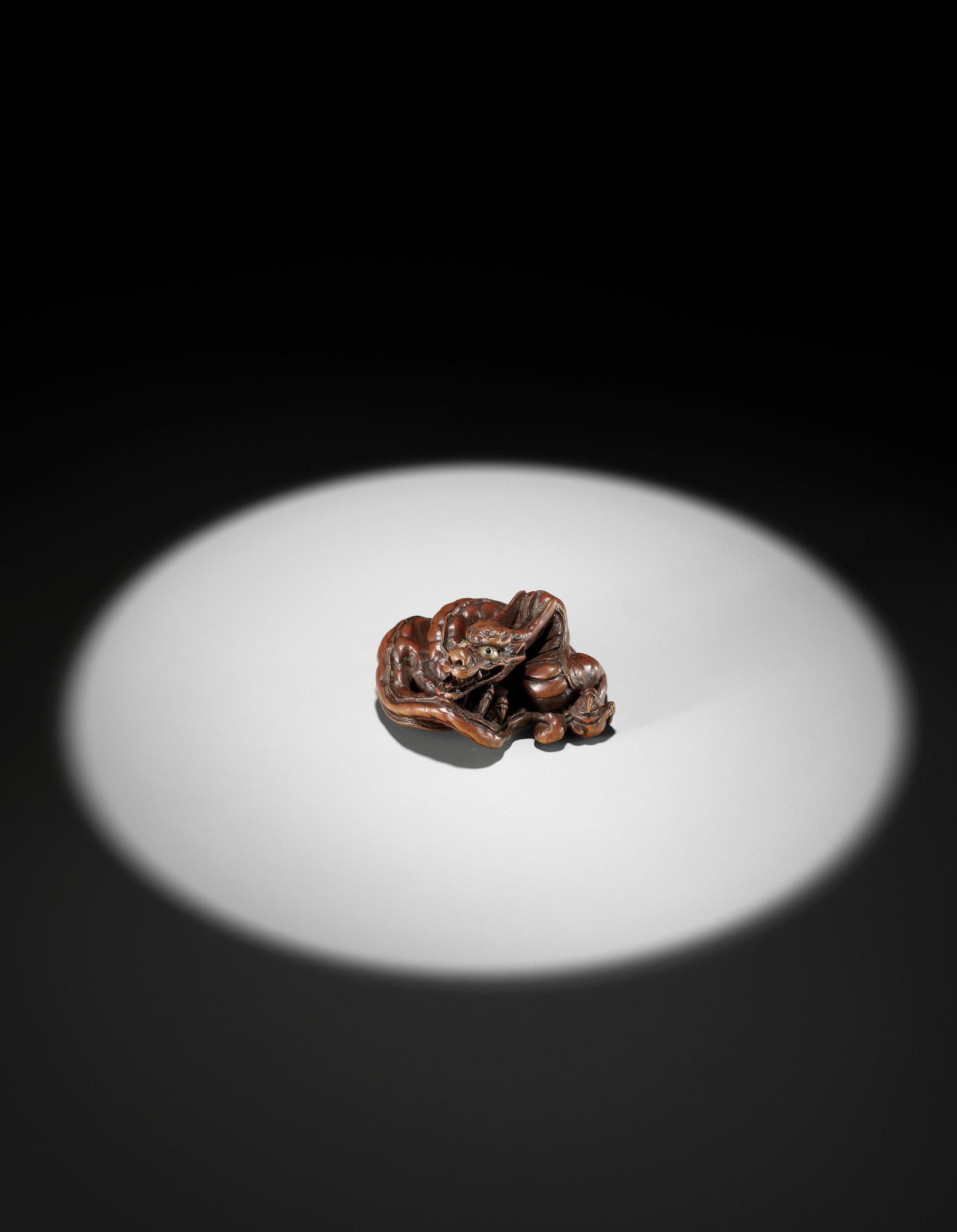
SHOTO: A SUPERB WOOD NETSUKE OF A WILD BOAR

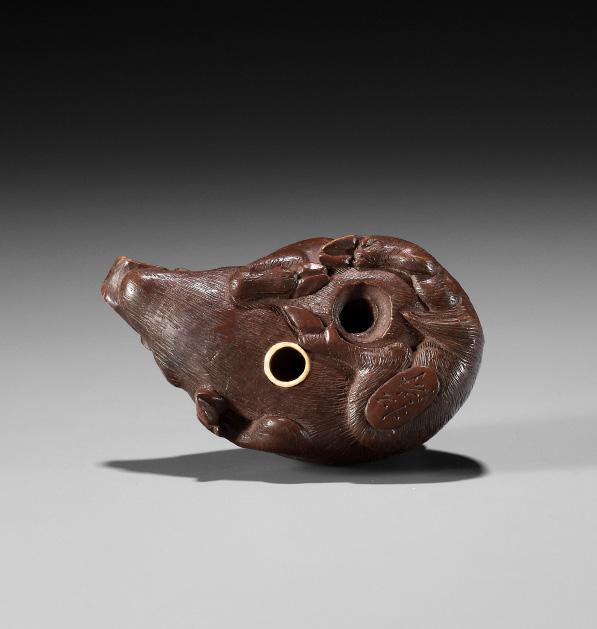
By Shoto, signed Shoto 松涛 Japan, Iwashiro Province, mid-19th century, Edo period (1615-1868)
A superbly carved wood netsuke, of compact design, depicting a recumbent long-snouted boar with a wild hairstyle and meticulously engraved fur. The eyes are inlaid in dark horn encircled with gilt metal, which is typical for the school of Hidari Issan, whom this carver is associated with. The underside shows the beautifully carved feet which are folded underneath the body, the asymmetrical himotoshi, the smaller hole ringed in stained bone, and the signature within an oval reserve underneath the right haunch SHOTO.
LENGTH 4.5 cm
Condition: Excellent condition with only minor wear.
Literature comparison: The artist was a rare follower/pupil of Hidari Issan and only a few of his netsuke are recorded. A wood netsuke depicting a dragon clutching a tama, signed Shoto, published in Barker & Smith (1976), Netsuke: The Miniature Sculpture of Japan, no. 247 and located in the British Museum, accession no. F. 296. further illustrates this point.
AUCTION COMPARISON
Compare to a wood netsuke of a boar, by Hidari issan, at Bonhams, Fine Japanese Works of Art including Selections from the Collection of Ruth and Carl Barron, 16 September 2014, New York, lot 2074 (sold for 5,625 USD).

Estimate EUR 6,000
Starting price EUR 3,000
176
149
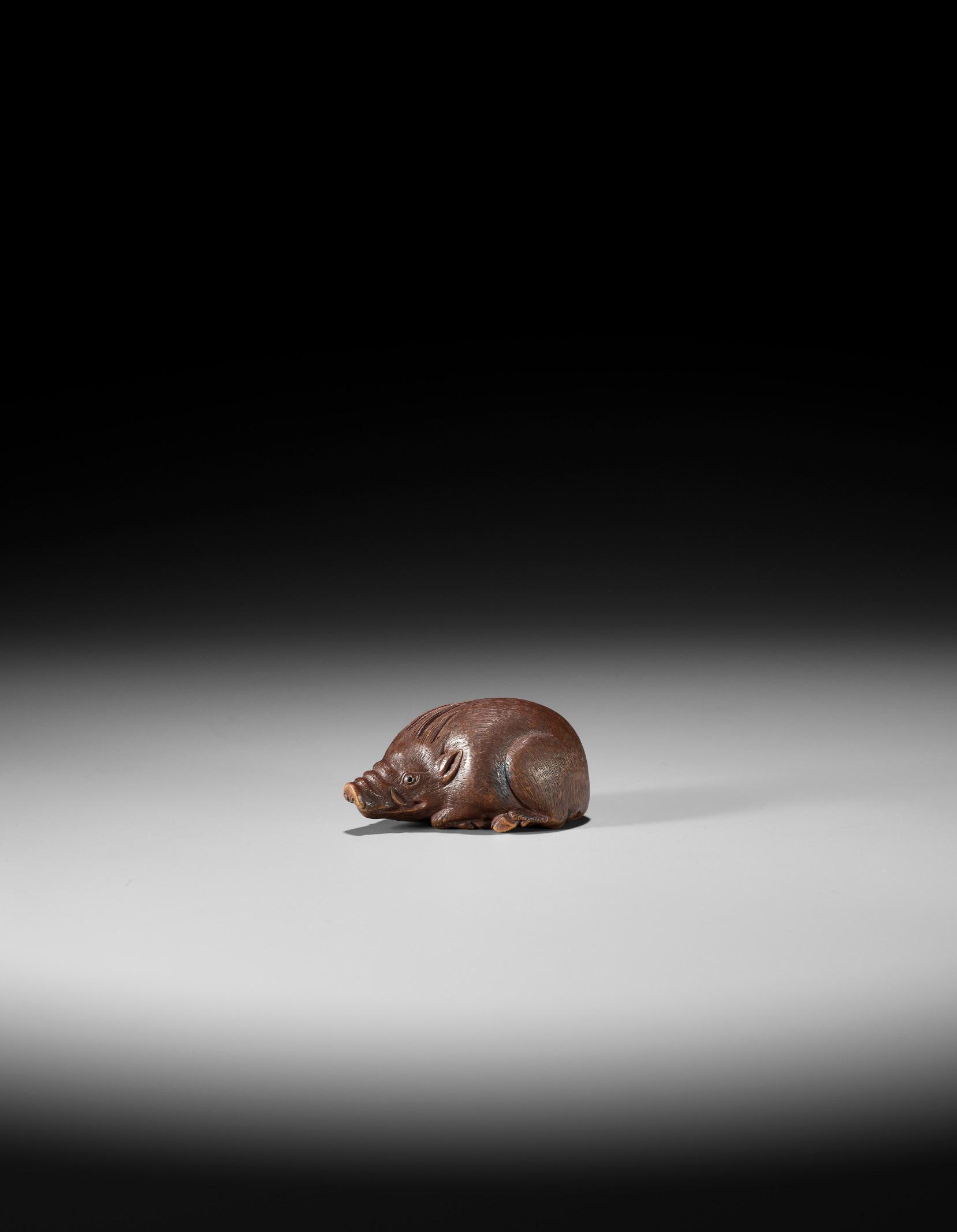
150
HIDARI ISSAN: A CHARMING WOOD NETSUKE OF A DARUMA DOLL
By Hidari Issan, signed Hidari Issan 左一山 Japan, Iwashiro Province, c. 1840, Edo period (1615-1868)
Published:
Wilhelm, Gabor (2004) Bulletin Franco-Japonais, no. 84, p. 36-37 (unillustrated).
Wilhelm, Gabor (Summer 2004) On the Continent, International Netsuke Society Journal, Vol. 24, No. 2, p. 20.
151
ISSAN: A WOOD NETSUKE OF TWO TOADS ON A WALNUT

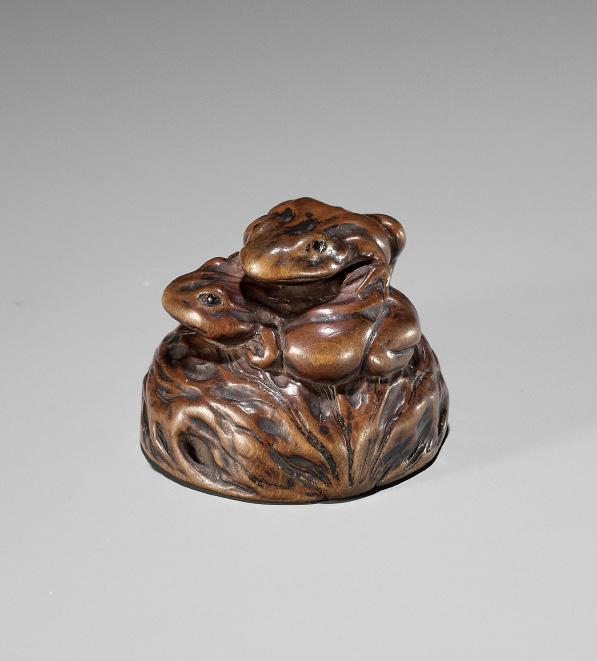


Well carved as a Daruma doll with hairy arms raised and hands placed on his head, the bearded face with a cheerful expression, the mouth wide open revealing tongue and teeth, the eyes inlaid with dark wood ringed in gilt-metal, as is typical for this artist. Good himotoshi, the larger hole generously excavated and forming a base ring. Signed within an oblong reserve HIDARI ISSAN.
HEIGHT 3.3 cm
Condition: Excellent condition with minor wear. Provenance: Galerie Yamato, Paris, 2004, no. 15. French private collection, acquired from the above.
A Daruma doll is a round, traditional roly-poly doll (okiagari) modeled after Bodhidharma, the founder of the Zen tradition of Buddhism. Though considered a toy by some, Daruma has a design that is rich in symbolism and is regarded more as a talisman of good luck to the Japanese.
MUSEUM COMPARISON
Compare a closely related wood netsuke of a Roly-Poly Daruma by Hidari Issan, formerly in the collection of Raymond Bushell and now in the Los Angeles County Museum of Art, accession number M.91.250.271.
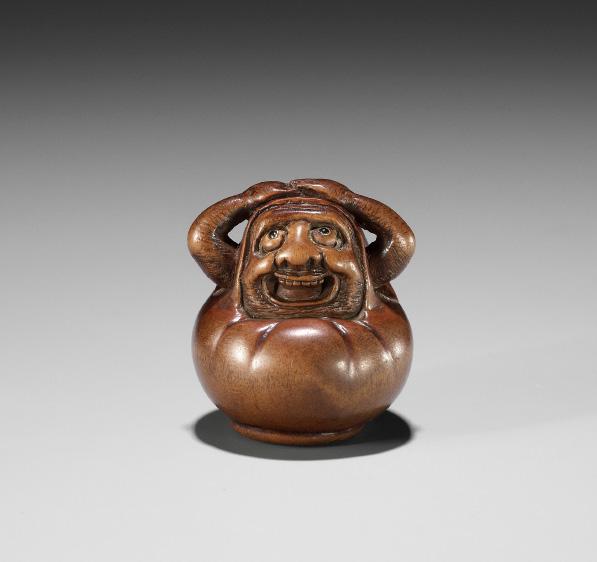
Estimate EUR 2,500
Starting price EUR 1,200
Condition: Very good condition, attractively worn, few tiny nicks. Provenance: A noted private collection, USA.
By
Ryusansai Issan, signed Issan 一山 with a kakihan Japan, Iwashiro Province, c. 1840, Edo period (1615-1868)
Exquisitely carved as two toads clambering over each other atop a half-walnut shell, their bodies well detailed and eyes inlaid with dark horn, although the lower toad has one eye closed as his companion has one front leg placed over it. The rough texture of the walnut shell and smoothly polished skin of the toads creates a fine contrast which is further enhanced by the dark stain to the low points. One of the upper toad’s hind legs forms a possible ‘natural’ cord attachment. The underside of the walnut shell with a central, horizontally pierced himotoshi and the signature ISSAN with a kakihan.
Ryusansai Issan was a contemporary of Hidari Issan and always worked in wood. Here, however, the similarities between the two end. Ruysansai made naturalistic animals in a life-like style, not always compact but certainly always functional. The features of his creatures are carefully detailed and the eyes are inlaid. See Davey, Neil K. (1974) Netsuke: A comprehensive study based on the M.T. Hindson Collection, p. 260.
Literature comparison: Compare a related wood netsuke of a toad on a sandal by Ryusansai Issan, illustrated in Davey, Neil K. (1974) Netsuke: A comprehensive study based on the M.T. Hindson Collection, p. 261, no. 806. Compare a related wood netsuke of a mole cricket on a walnut by Ryusansai Issan, illustrated in Galerie Zacke (1984) Netsuke und Inro, no. 6.
MUSEUM COMPARISON
Compare a related wood netsuke of a frog on a straw hat by Issan, in the Metropolitan Museum of Art, accession number 91.1.1000.
Estimate EUR 2,000
Starting price EUR 1,000
LENGTH 3.8 cm
A FINE WOOD NETSUKE OF A TOAD ON A LOTUS LEAF


Unsigned Japan, first half of 19th century, Edo period (1615-1868)
Finely carved and attractively stained, the toad clambering on an upturned furled lotus leaf well-executed with both raised and subtle ukibori veins, one of its hands placed on the stem, the other superbly carved splayed across the leaf, the toad’s warty skin carved in masterful ukibori. Natural himotoshi through the curved stem. The large eyes of the amphibian are inlaid in lustrous, dark buffalo horn.
LENGTH 4.7 cm
Condition: Very good condition with minor wear, few light scratches. Provenance: Bondu, Paris, December 1986. French private collection, acquired from the above. Bonhams, Fine Netsuke from a French private collection, 4 November 2020, London, lot 112. German private collection, acquired from the above.
The present netsuke is difficult to place in a particular school, but perhaps Nagoya fits best due to the type of wood and staining used. The superior level of ukibori, particularly the subtle veining to leaf, however, strongly suggests the Iwami school.
Estimate EUR 3,000
Starting price EUR 1,500
152
SEIMIN: A FINE WOOD NETSUKE OF FROGS ON A LOTUS LEAF

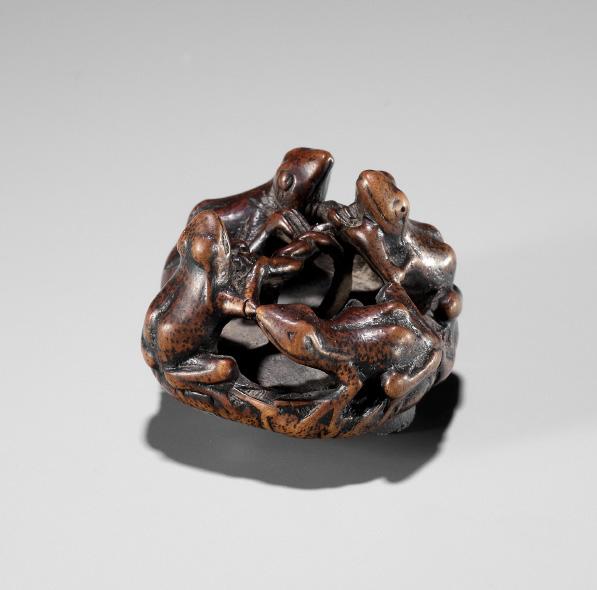 By Seimin, signed Seimin 晴民 Japan, Iwashiro Province, mid-19th century, Edo period (1615-1868)
By Seimin, signed Seimin 晴民 Japan, Iwashiro Province, mid-19th century, Edo period (1615-1868)
A well-carved and beautifully worn wood netsuke, depicting four frogs of varying size, dynamically arranged on a furled lotus leaf, two of them tying a sandal rope in the center, perhaps preparing for some tug of war action. The underside with the curved stem serving as the cord attachment and the signature SEIMIN within a mother-of-pearl tablet. The artist is best known for his depictions of frogs and is therefore also referred to as ‘Kaeru Seimin’. While many unsigned works are attributed to him, signed examples are rather scarce. The wear and overall boldness of the carving indicate an early work by this master.


LENGTH 4 cm
Condition: Very good condition with minor wear. A small crack to the side of the lotus leaf by one of the frog’s trailing legs.
LITERATURE COMPARISON
Compare to a closely related ivory netsuke of frogs on a lotus leaf, by Seimin, illustrated in Davey, Neil K. (1974) Netsuke: A comprehensive study based on the M.T. Hindson Collection, p. 262, no. 812.
Estimate EUR 3,000
Starting price EUR 1,500
180 153
154
SEIGYUKEN GAHO: A VERY FINE KURUMI (WALNUT) NETSUKE OF DAIKOKU AND THREE KARAKO, DATED 1816
By Seigyuken Gaho, signed Akamagaseki no ju Seigyuken Gaho, Bunka jusan-nen kito gejun 赤間関住 青牛軒我補 文化十三年 李冬
Japan, Akamagaseki (Shimonoseki), Yamaguchi prefecture, dated 1816
The double walnut carved as Daikoku’s treasure bag with neatly incised patterned designs, tied at the top, and carved in stunning relief with an image of three karako (Chinese boys) playing tug-ofwar and pulling on the lucky god’s arm, who is visible on the other side and who is amusingly unimpressed by their efforts. The details are superbly carved, quite incredible for a walnut carving. The top and bottom with metal mounts and a looped himotoshi. Signed in minutely incised characters within a raised rectangular reserve Akamagaseki no ju Seigyuken Gaho, Bunka jusan-nen kito gejun (Seigyuken Gaho, living in Akamagaseki [present-day Shimonoseki], end of the twelfth month in 1816).

HEIGHT 3.7 cm
Condition: Very good condition with typical wear and natural flaws to the material, including some tiny pinholes, all as is to be expected from kurumi netsuke
Estimate EUR 2,000
Starting price EUR 1,000
181
下旬
SUKETADA: A FINE WOOD NETSUKE OF A KAPPA TRAPPED BY A CLAM
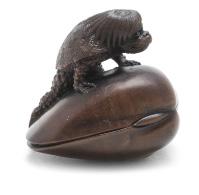

 By Suketada, signed Suketada
By Suketada, signed Suketada
A very finely carved study of a kappa with one hind foot caught in the jaws of a hamaguri clam as it climbs over it. The subject references, quite humorously, a parody of the seduction of feminine wiles, the clam representing the female here. The warty skin of the kappa is masterfully rendered, the eyes are inlaid, the shell is finely carved and the long hair surrounding the kappa’s swirling vital fluids on the head is minutely incised. Large, asymmetrical and generously excavated himotoshi through the underside, signed SUKETADA.
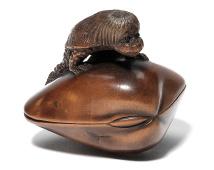

The present netsuke is much more worn than other examples of this subject by Suketada and shows a distinctly beautiful patina. It is likely that this is one of the earliest netsuke of this type.
HEIGHT 3.7 cm
Condition: Very good condition, the wood beautifully worn with a fine patina. Some light surface scratches.
AUCTION COMPARISON
Compare to a closely related wood netsuke of a kappa by Suketada at Bonhams, The Harriet Szechenyi Sale of Japanese Art, 8 November 2011, London, lot 54 (sold for 8,125 GBP). Another closely related wood netsuke of a kappa by Suketada at Bonhams, The Julius & Arlette Katchen Collection of Fine Netsuke Part I, 8 November 2016, London, lot 188 (sold for 5,000 GBP).
Estimate EUR 5,000
Starting price EUR 2,400
182
155
亮忠 Japan, Takayama, Hida Province, early to mid-19th century, Edo period (1615-1868)

183
A RARE IVORY NETSUKE OF A COILED SNAKE




Unsigned Japan, 18th century, Edo period (1615-1868)
Published: Sagemonoya (2022), The Gabor and Georgina Wilhelm Collection, p. 63, no. 99.
A pleasingly tactile and compact ivory netsuke of a snake (hebi) coiling around itself, with finely incised scales, its head resting on top, its gaze fixed in front, the eyes inlaid in dark horn, and ready to strike. Natural himotoshi. The ivory bearing a superb, honey-yellow patina.
LENGTH 3.8 cm
Condition: Very good condition with typical old wear. Beautiful patina. Provenance: The Gabor Wilhelm Collection, Paris.
AUCTION COMPARISON
Compare to a closely related ivory netsuke of a snake, likely by the same hand, at Bonhams, The Julius & Arlette Katchen Collection of Fine Netsuke Part I, 8 November 2016, London, lot77 (sold for 5,000 GBP).
Estimate EUR 4,000
Starting price EUR 2,000
184
156
157
Unsigned Japan, possibly Iwami, 18th-19th century, Edo period (1615-1868)
The snake (hebi) elaborately coiling around itself, its sinuous body forming an elaborate bundle of twisting loops, the entire surface covered in ‘punctured’ scales, its head resting at the top in a lurking manner. One large himotoshi through the body underneath. The glaring eyes are double inlays of pale, translucent horn with dark pupils.

LENGTH 4.4 cm
Condition: Excellent condition.
AUCTION COMPARISON
Ebony wood netsuke of snakes are to be considered rare and are mostly attributed to the Iwami school of carvers. The manner of the inlaid eyes of the present snake are reminiscent of this school as well. For a related ebony netsuke of a coiled snake, attributed to Seiyodo Bunshojo, see Bonhams, The Robert S. Huthart Collection of Iwami Netsuke Part I, 15 May 2019, London, lot 52 (sold for 6,312 GBP).

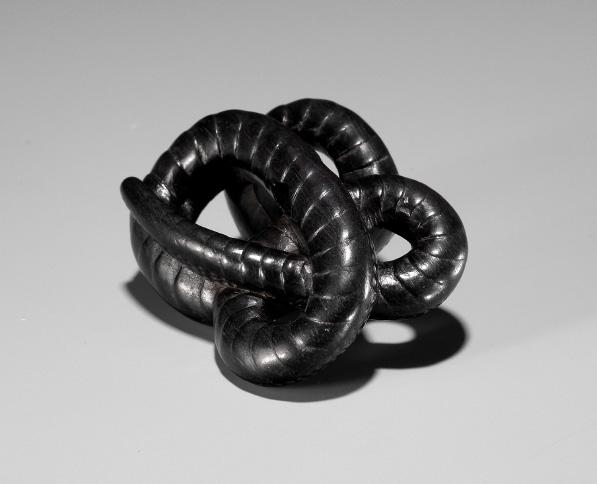

Estimate EUR 4,000
Starting price EUR 2,000
185
A RARE EBONY WOOD NETSUKE OF COILED SNAKE
TAKUSAI: A SUPERB WOOD NETSUKE OF A MERMAID (NINGYO)
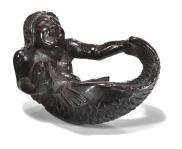

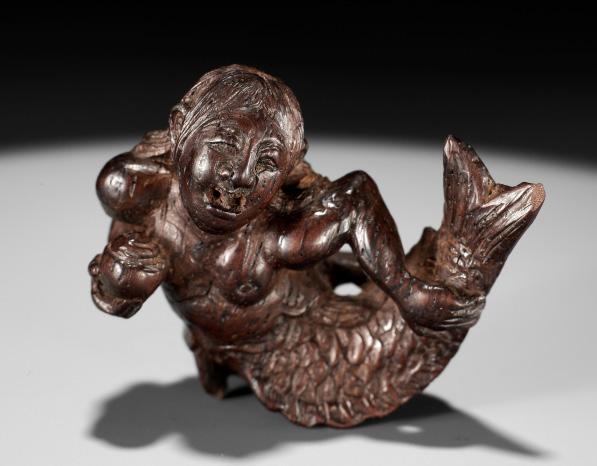 By Tachikawa Takusai (1817-1887), signed Takusai 啄齋 Japan, Suwa, Shinano Province, mid to late 19th century
By Tachikawa Takusai (1817-1887), signed Takusai 啄齋 Japan, Suwa, Shinano Province, mid to late 19th century
Published: Sydney L. Moss Ltd. (2006) More Things in Heaven and Earth, p. 92, no. 39.
Finely carved as a gleefully smiling mermaid clutching her tail and pulling it toward herself, her other hand holding a sacred tama (jewel), her facial features expressively carved, her arms distinguished with developed muscles, her lower body well detailed and neatly incised with scales and fins, her long hair flowing elegantly down her back in finely incised strands forming the ‘natural’ himotoshi. Signed within a smooth oval reserve TAKUSAI.
LENGTH 3.8 cm
Condition: Very good condition with minor expected wear. Tiny chip to the edge of the tail fin.
Provenance: Sydney L. Moss Ltd., London, 2006. A noted private collection, USA, acquired from the above.
The present netsuke is carved from shitan (purple sandalwood), which is riddled throughout with the traces of unusually small woodworm. Paul Moss concluded in More Things in Heaven and Earth that the wormholes were already in the material when Takusai chose it, as evidenced by the grooves lying on the surface of the wood. Other netsuke by Takusai illustrated in Lazarnick, George (1981) Netsuke & Inro Artists, and How to Read Their Signatures, vol. II, p. 1055-1056, show evidence of the same woodworm as the present netsuke.
Tachikawa was proposed by George Lazarnick as a group of carvers with the same family name (which had been previously read as single names including most often Ryusen and less often Tatsukawa, Tatsugawa, and seldom Tachikawa). The selection of characters used in the names, the very style of rendering of these characters and the reserves in which they are often placed, the invariable use of wood, as well as the information recorded about them all point to an interrelationship among them. See Lazarnick, George (1981) Netsuke & Inro Artists, and How to Read Their Signatures, vol. II, p. 1053.
AUCTION COMPARISON
Compare a closely related wood netsuke by Tachikawa Takusai depicting the same subject, illustrated in Meinertzhagen, Frederick / Lazarnick, George (1986) MCI, Part B, p. 833, where Meinertzhagen described it as “a little gem of art”, and in Lazarnick, George (1981) Netsuke & Inro Artists, and How to Read Their Signatures, vol. II, p. 1055, at Bonhams, 25 March 2010, New York, lot 2051 (sold for 4,575 USD).
Estimate EUR 6,000
Starting price EUR 3,000
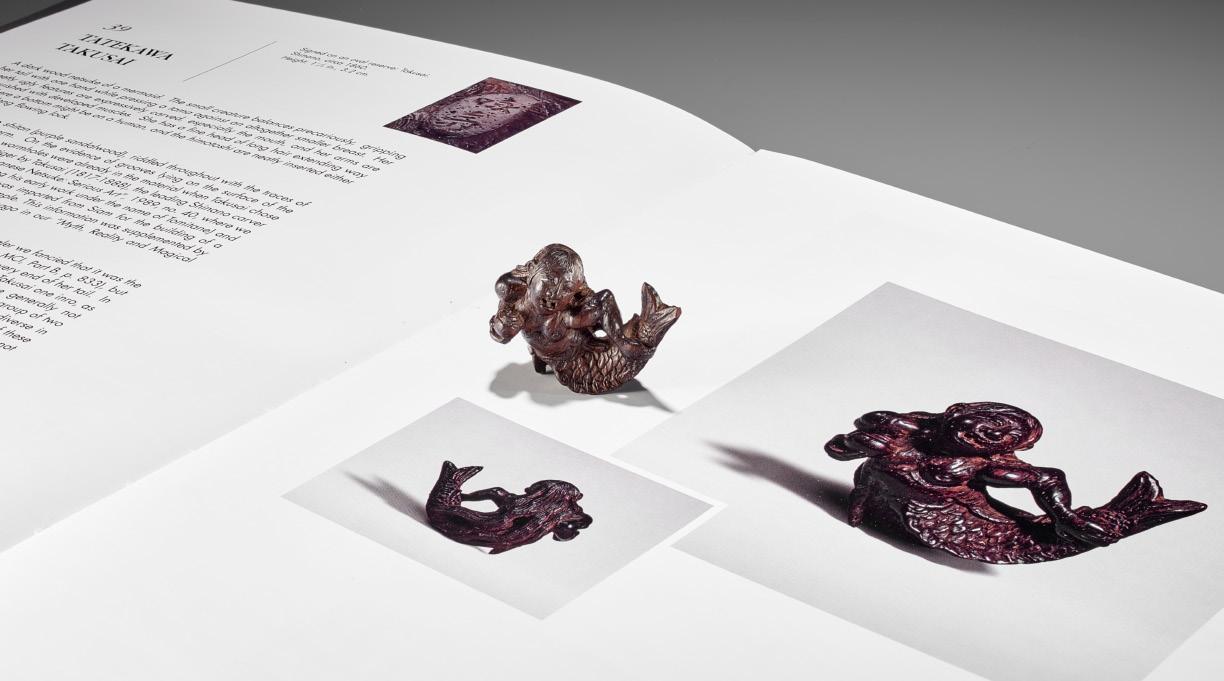
158

159
KANMAN: A RARE BUFFALO HORN NETSUKE OF A SNAIL ON A TARO LEAF
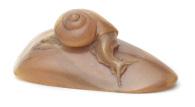

By Kanman (1793-1859), signed Iwami no kuni Kanman 石見国貫満 to 刀 with kakihan Japan, Iwami Province, early 19th century, Edo period (1615-1868)
Published: Earle, Joe (2000) The Robert S. Huthart Collection of Iwami Netsuke, Vol. II, p. 267, no. 236.
The curved section of horn carved in high relief with a snail, its body emerging from its shell as it slides over the leaf, the veins and venules meticulously carved in superb ukibori, an unprecedented feat even for this artist considering the material. Signed on the stalk in incised characters Iwami no kuni KANMAN to with a kakihan.
LENGTH 7.7 cm
Condition: Good condition, minor wear, natural imperfections, minor chips, small losses.
Provenance: Ex-collection Robert S. Huthart.
Kanman (1793-1859) was a Japanese netsuke carver of the Iwami school, which was founded by Seiyodo Tomiharu. Most of his work was designed in the first three decades of the 19th century. According to Anne Hull Grundy, “His netsuke [...] are extremely rare.” David Burditt has described him as one of the greatest of the Iwami carvers. A hallmark of Kanman’s work is his understanding of the materials he uses. His woods demonstrate wonderful undercutting, deep incisions, copious ukibori, and detailed overall carving. By contrast, his horn netsuke show more restrained carving, but careful finishing and polishing so that their surfaces are smooth and glow with the sheen only such material can produce.
Literature comparison: Compare a related buffalo horn netsuke of two snails by Kanman, illustrated in Lazarnick, George (1981) Netsuke & Inro Artists, and How to Read Their Signatures, vol. I, p. 585.

AUCTION COMPARISON
Compare a related buffalo horn netsuke of snail on a bamboo shoot by Kanman, illustrated in Earle, Joe (2000) The Robert S. Huthart Collection of Iwami Netsuke, Vol. II, p. 268, no. 237, at Bonhams, The Robert S. Huthart Collection of Iwami Netsuke Part II, 6 November 2019, London, lot 86 (sold for 4,437 GBP).

Estimate EUR 3,000
Starting price EUR 1,500
188
160
A FINE UMIMATSU NETSUKE OF A SNAIL ON A BRANCH, ATTRIBUTED TO KANMAN

Attributed to Kanman, inscribed sekishu Iwami 石州石見 Japan, Iwami Province, early 19th century, Edo period (1615-1868)
Published: Earle, Joe (2000) The Robert S. Huthart Collection of Iwami Netsuke, Vol. 2, p. 346, no. 322.

Finely carved as snail slithering over a gnarled branch, the paler shades of the material ingeniously incorporated in the snail’s shell and body as well as to indicate different layers of the branch. The snail is carved with a superior sense of naturalism, its feelers are stretched out as it navigates across the branch. The underside with two asymmetrical himotoshi, one of which is surrounded by an incised leaf, the side incised with the inscription Sekishu Iwami (Iwami Province). The style is certainly that of Kanman, who this netsuke can be attributed to.

LENGTH 6.5 cm
Condition: Excellent condition, minor wear.
Provenance: The Robert S. Huthart Collection.
Estimate EUR 5,000
Starting price EUR 2,400
189

161
KANMAN: A SUPERB AND LARGE UMIMATSU (SEAPINE) NETSUKE OF A CICADA ON AN OAK BRANCH
By Kanman, signed Iwami no kuni no ju Kanman to 石見国之住貫満
刀 with kakihan
Japan, Iwami Province, early 19th century, Edo period (1615-1868)
Published:
Lazarnick, George (1981) Netsuke & Inro Artists, and How to Read Their Signatures, vol. 1, p. 583.
Earle, Joe (2000) The Robert S. Huthart Collection of Iwami Netsuke, Vol. 2, p. 242, no. 210.
Exquisitely carved as a cicada perched on an oak branch issuing twigs, leaves, and acorns, the insect’s wings finely rendered with raised veins, the branch well detailed with several layers and burls, the side and underside with asymmetrical himotoshi, the underside with a sunken shaped reserve incised with the signature and inscription Iwami no kuni no ju KANMAN to (carved by Kanman, a resident of Iwami Province) with a kakihan. The umimatsu with superb natural marbling.
LENGTH 8.4 cm
Condition: Excellent condition, minor wear.
Provenance: The Robert S. Huthart Collection.
Umimatsu (lit. seapine) is in fact a species of black coral with dense texture, concentric growth rings, and amber or reddishcolored inclusions in the otherwise brown-black material. True coral is a hard calcareous substance secreted by marine polyps for habitation; umimatsu, on the other hand, is a colony of keratinous antipatharian marine organisms. As a material, it was considered risky for carvers as it was prone to crack, crumble, or chip.
LITERATURE COMPARISON
A related umimatsu netsuke of a cicada on a log is illustrated in Lazarnick, George (1981) Netsuke & Inro Artists, and How to Read Their Signatures, vol. 1, p. 582.

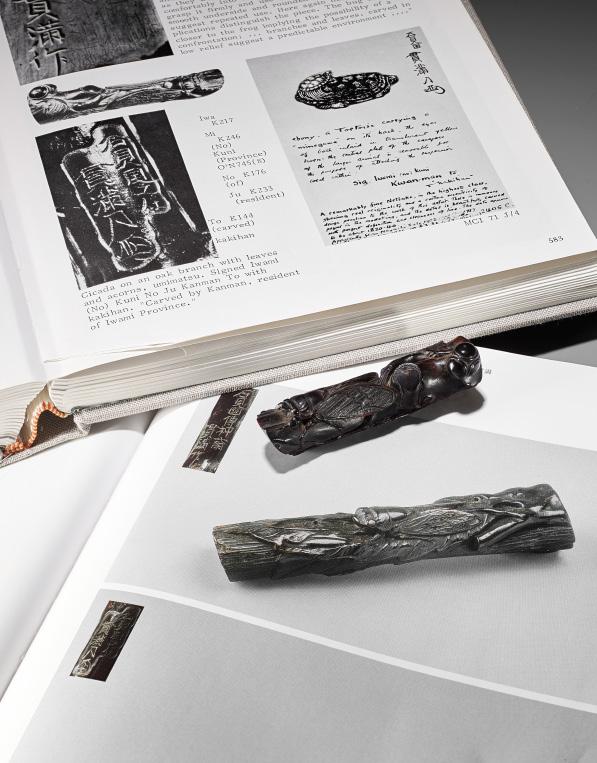
AUCTION COMPARISON
Compare a closely related umimatsu netsuke of a cicada on a log by Kanman, with a similar inscription, signature, and kakihan, 7.6 cm long, dated early 19th century, at Bonhams, The Robert S. Huthart Collection of Iwami Netsuke Part I, 15 May 2019, lot 92 (sold for 31,312 GBP).


Estimate EUR 10,000
Starting price EUR 5,000
191
KANMAN: AN EXCEPTIONAL AND LARGE KUROGAKI (BLACK PERSIMMON) WOOD NETSUKE OF A FROG ON A LOTUS LEAF
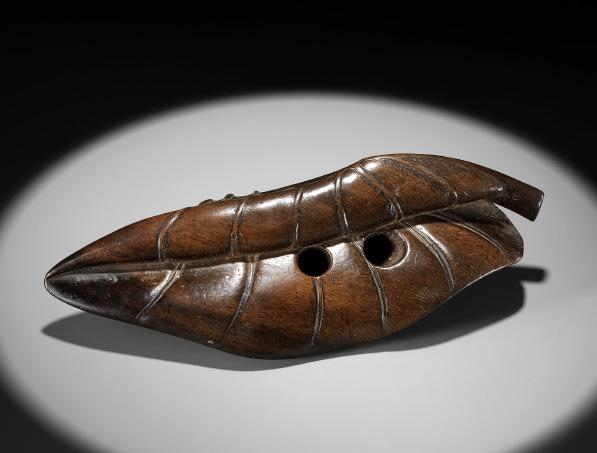

By Kanman (1793-1859), signed Iwami no ju Kanman 石見住貫満 […] with kakihan Japan, Iwami Province, early 19th century, Edo period (1615-1868)
Published:

Rokusho (1996), Vol. 20, p. 48, no. 59.
Earle, Joe (2000) The Robert S. Huthart Collection of Iwami Netsuke, Vol. II, p. 278, no. 247.
Burditt, David (Spring 2000) The Iwami Carvers: Kanman, International Netsuke Society Journal, Vol. 20, No. 1, p. 53, no. 15.

Superbly carved as a frog standing foursquare on a furled lotus leaf, its skin smooth at its back and detailed with ukibori warts elsewhere, the leaf meticulously carved with veins and venules in fine ukibori, the underside also well detailed and showing the attractive grain of the wood as well as the large asymmetrical himotoshi. Carved on the stem with the signature in partially worn ukibori characters Iwami no ju KANMAN […] with a kakihan.
LENGTH 11.1 cm
Condition: Excellent condition with only minor wear and traces of use.
Provenance: Ex-collection Joe Kurstin. Ex-collection Robert S. Huthart, acquired from the above. Dr. M. Joseph ‘Joe’ Kurstin (1931-2021) was a prominent Miami ophthalmologist who arguably built one of the greatest netsuke collections of all time. He was known by netsuke and inro lovers worldwide and made many lifelong friends in this tight-knit community. He published several books and articles on the subject and generously lent his collection for exhibitions at the Yale University Gallery, Museum of Fine Arts, Boston, Epcot Center at Disney World, and The Tobacco and Salt Museum, Tokyo.
Kanman (1793-1859) was a Japanese netsuke carver of the Iwami school, which was founded by Seiyodo Tomiharu. Most of his work was designed in the first three decades of the 19th century. According to Anne Hull Grundy, “His netsuke [...] are extremely rare.” David Burditt has described him as one of the greatest of the Iwami carvers. A hallmark of Kanman’s work is his understanding of the materials he uses. His woods demonstrate wonderful undercutting, deep incisions, copious ukibori, and detailed overall carving. By contrast, his horn netsuke show more restrained carving, but careful finishing and polishing so that their surfaces are smooth and glow with the sheen only such material can produce.
LITERATURE COMPARISON
Compare a closely related dark wood netsuke of a toad on a lotus leaf by Kanman, illustrated in Gould, Irving (1987) The Gould Collection of Netsuke, p. 367.
AUCTION COMPARISON
Compare a related ebony netsuke of a frog on a lotus leaf by Tomiharu, 7.5 cm long, dated late 18th to early 19th century, at Bonhams, The Robert S. Huthart Collection of Iwami Netsuke Part I, 15 May 2019, London, lot 20 (sold for 11,312 GBP).


Estimate EUR 12,000
Starting price EUR 6,000
192
162
Elena and Joseph Kurstin

163
A SUPERB WOOD SHUNGA NETSUKE OF A MAN WITH OKAME MASK
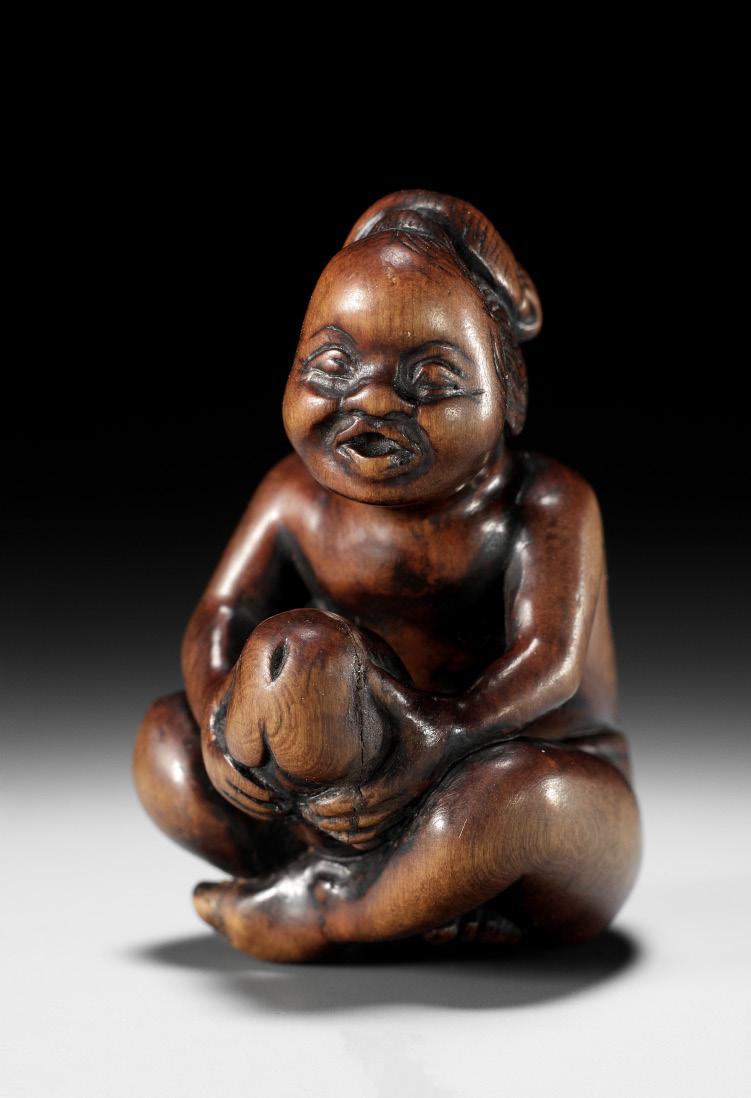

Unsigned Japan, Edo (Tokyo), 18th century, Edo period (1615-1868)
Finely carved as a man seated with crossed legs, wearing the mask and hairstyle of Okame, the hair neatly incised and tied at the back, the man otherwise clad only in a fundoshi, from which his enormous phallus emerges which he cradles with both hands, the man’s expression hidden behind the mask though obvious nonetheless. The back with two generously excavated, asymmetrical himotoshi above the inscription Otoko (‘man’).
HEIGHT 5 cm

Condition: Few minor age cracks, one with associated old repair, one foot with the toes restored. Otherwise, fine condition with a superb, deep patina.
Provenance: Sotheby’s, Fine Netsuke Including Property from the Collection of Alan R. Liss, 2 September 1993, Chicago, lot 128. Ex-collection Joe Kurstin, acquired from the above. Dr. M. Joseph ‘Joe’ Kurstin (1931-2021) was a prominent Miami ophthalmologist who arguably built one of the greatest netsuke collections of all time. He was known by netsuke and inro lovers worldwide and made many lifelong friends in this tight-knit community. He published several books and articles on the subject and generously lent his collection for exhibitions at the Yale University Gallery, Museum of Fine Arts, Boston, Epcot Center at Disney World, and The Tobacco and Salt Museum, Tokyo.
LITERATURE COMPARISON
Compare a related wood shunga netsuke of Okame, signed Deme saku, 6 cm high, dated 18th century, illustrated in Scholten Japanese Art (2001) Expressions of Style: Netsuke as Art, p. 47, no. 58.
Estimate EUR 8,000
Starting price EUR 4,000
194
Elena and Joseph Kurstin


164
MIWA KATSUSUKE: A SUPERB WOOD NETSUKE OF GAMA SENNIN WITH HUGE TOAD

 By Miwa Katsusuke, signed Miwa Katsusuke 三輪勝助 with kakihan Japan, Edo (Tokyo), c. 1800, Edo period (1615-1868)
By Miwa Katsusuke, signed Miwa Katsusuke 三輪勝助 with kakihan Japan, Edo (Tokyo), c. 1800, Edo period (1615-1868)
Published:
Meinertzhagen, Frederick / Lazarnick, George (1986) MCI, Part A, p. 572 (not illustrated).
International Netsuke Society Journal (2001) Vol. 21, No. 3, p. 28. (advert by Sydney Moss Ltd.)
Sydney L. Moss Ltd. (2004) Outside the Box, p. 42, no. 18.
A remarkably powerful netsuke carved from plum or isu wood, of an attractive grain and color, depicting a seated Gama Sennin wearing a thick mugwort leaf skirt spreading about him and leaning against the gigantic toad behind him, the expressions of both forcefully dyspeptic and disagreeable. The flattened base with large asymmetrical himotoshi and the signature MIWA KATSUSUKE, the last character of which is written to resemble a kakihan.
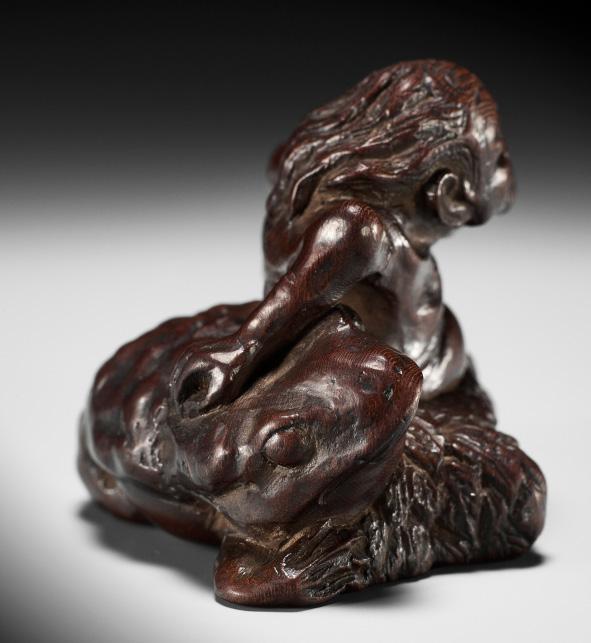

LENGTH 4 cm
Condition: Very good condition, appealingly worn, few tiny nicks, few light surface scratches.
Provenance: Ex-collection W.W. Winkworth. Sotheby’s, 27 June 1979, London, lot 99. Ex-collection Raymond Bushell. Sydney L. Moss, London, 2004. French private collection, acquired from the above.
The present netsuke was recorded by Frederick Meinertzhagen in his Card Index, wherein he noted, very interestingly, that it was shown to him on 27 June 1951 “by Winkworth who wrote this characteristic commentary:
‘… a small seated Gama looking rather like a determined Rationalist standing up for Individualism and the ‘scientific approach’ in controversy with a bigoted Catholic; I and my toad don’t believe any nonsense about Transubstantiation! My toad says if you’d been a tadpole once you’d have more sense than to believe in Purgatory!’ (too profound for my understanding, F.M.)”
Katsusuke, or Shojo, can be translated as ‘worthy follower’, and those enthusiasts who study the early masters have concluded that in the few work’s signed ‘Miwa’s worthy follower’ we very probably see a hand which may be categorized as a direct pupil of the master. Indeed, Meinertzhagen’s estimation of the carver seems to have been ratcheted up a notch between his June 1951 introductory card, explaining that only three works were known, which “show true artistic feeling, but lack originality of design, subtlety and fine craftsmanship”, and his handwritten note of May 1955, “Might this carver be Miwa 2nd, or even the first Miwa?”
Literature comparison: Compare two related wood netsuke by Miwa Katsusuke, illustrated in Meinertzhagen, Frederick / Lazarnick, George (1986) MCI, Part A, p. 572.
Estimate EUR 8,000
Starting price EUR 4,000
197
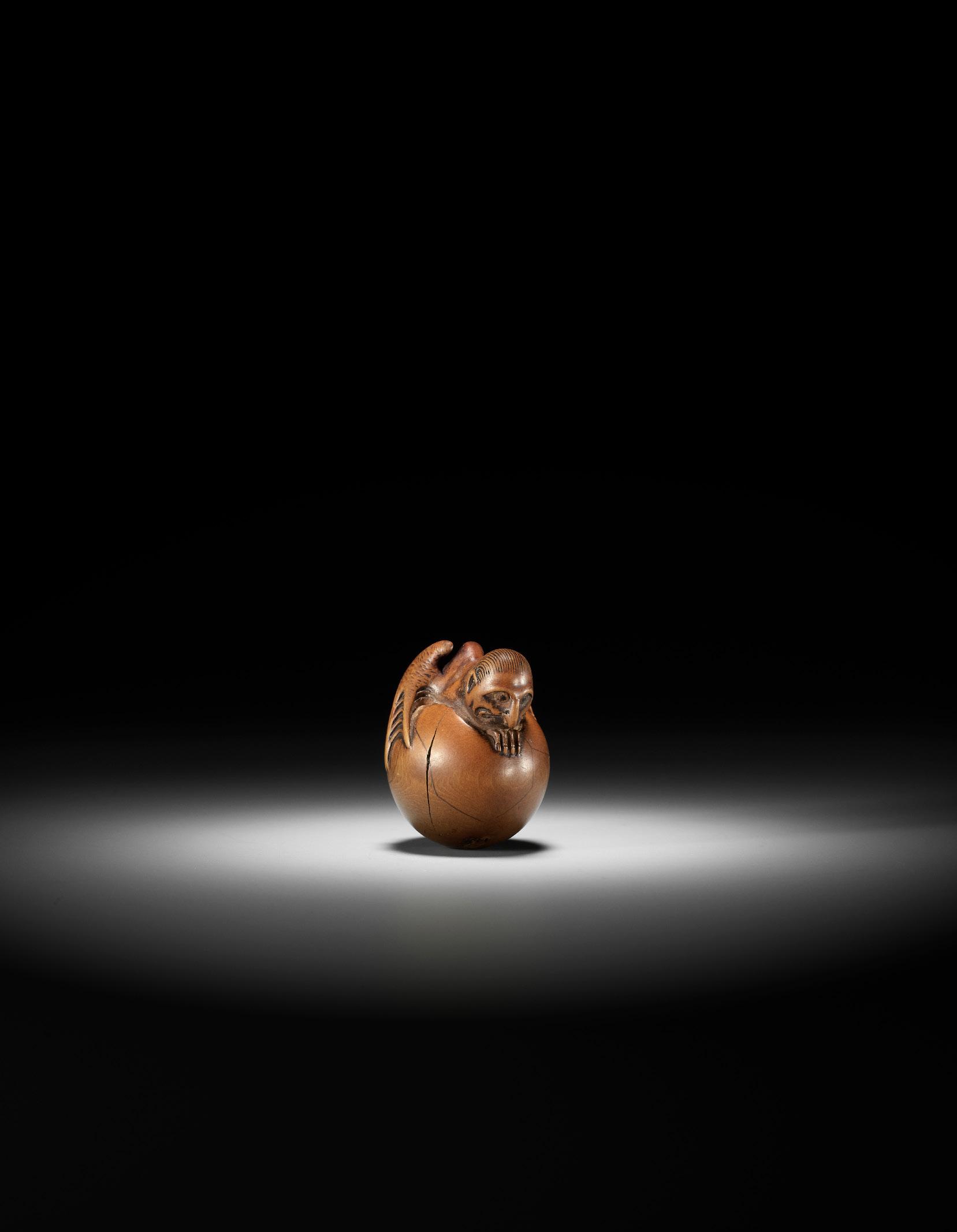
165
JOBUN: A SUPERB WOOD NETSUKE OF A HATCHING TENGU (TENGU NO TOMAGO)
 By Jobun, signed Jobun 如文 Japan, Edo (Tokyo), c. 1780, Edo period (1615-1868)
By Jobun, signed Jobun 如文 Japan, Edo (Tokyo), c. 1780, Edo period (1615-1868)
The mythical winged creature clambering out of his broken egg with delicately incised ‘cracks’ using its weak, undeveloped arms, the ‘hands’ superbly detailed and appearing like out of a sciencefiction movie, the head and one wing with neatly detailed webs are already free, the humanoid face with a hooked nose and finely incised brushed-back hair, the eyes inlaid with dark wood. The underside with generously excavated, asymmetrical himotoshi and the signature JOBUN.
LENGTH 3.8 cm
Condition: One arm with an old restoration, the egg with a minor age crack, otherwise in good condition.
Provenance: Ex-collection Joe Kurstin. Dr.

M. Joseph ‘Joe’ Kurstin (1931-2021) was a prominent Miami ophthalmologist who arguably built one of the greatest netsuke collections of all time. He was known by netsuke and inro lovers worldwide and made many lifelong friends in this tight-knit community. He published several books and articles on the subject and generously lent his collection for exhibitions at the Yale University Gallery, Museum of Fine Arts, Boston, Epcot Center at Disney World, and The Tobacco and Salt Museum, Tokyo.
LITERATURE COMPARISON
Compare a closely related wood netsuke of a hatching tengu by Jobun illustrated in Sydney L. Moss Ltd. (2000) Myth, Reality, and Magical Transformation: Aesthetics and Connoisseurship in Japanese Netsuke, no. 18.
AUCTION COMPARISON
Compare a closely related wood netsuke of a hatching tengu at Lempertz, Netsuke aus der Sammlung Albert Brockhaus, 27 June 2020, Cologne, lot 458 (sold for 8,750 EUR).

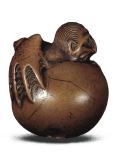
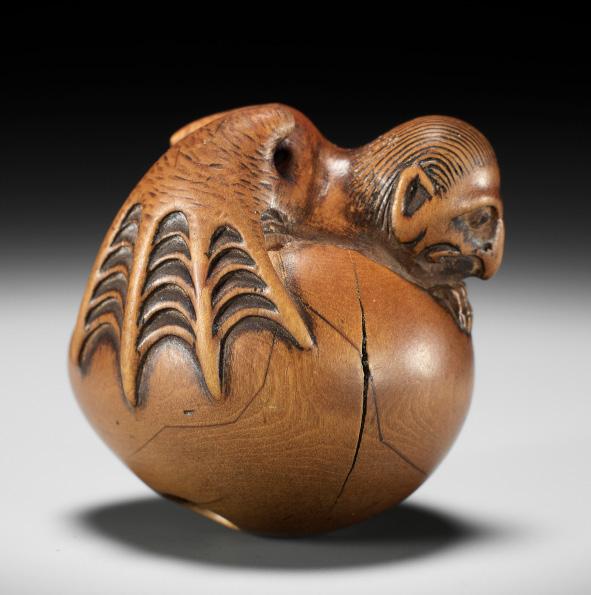
Estimate EUR 10,000
Starting price EUR 5,000
199
Elena and Joseph Kurstin
GENRYOSAI MINKOKU: A RARE WOOD NETSUKE OF TWO MONKEYS ON A PINE BRANCH

 By Genryosai Minkoku I, signed Genryosai 玄了齋 Japan, Edo (Tokyo), 18th century, Edo period (1615-1868)
By Genryosai Minkoku I, signed Genryosai 玄了齋 Japan, Edo (Tokyo), 18th century, Edo period (1615-1868)
Carved as two monkeys clambering on a gnarled branch issuing leaves, one monkey on top scratching his behind and the other climbing downwards playfully and facing the one on top. A boldly executed, humorous and dynamic design, the wood bearing a fine, dark patina. The underside with one large himotoshi and signed GENRYOSAI (Minkoku). The subject appears to be unique for this celebrated early Edo carver.
LENGTH 4.8 cm
Condition: Very good, typically worn condition. Few age cracks and minor surface wear. Beautiful, deep patina.
Provenance: Old Irish private collection, Dublin, purchased from Christie’s, 17 February 1981, London, lot 113.
Estimate EUR 5,000
Starting price EUR 2,400
200
166
A FINE WOOD NETSUKE OF A MONKEY ON BAMBOO SHOOT

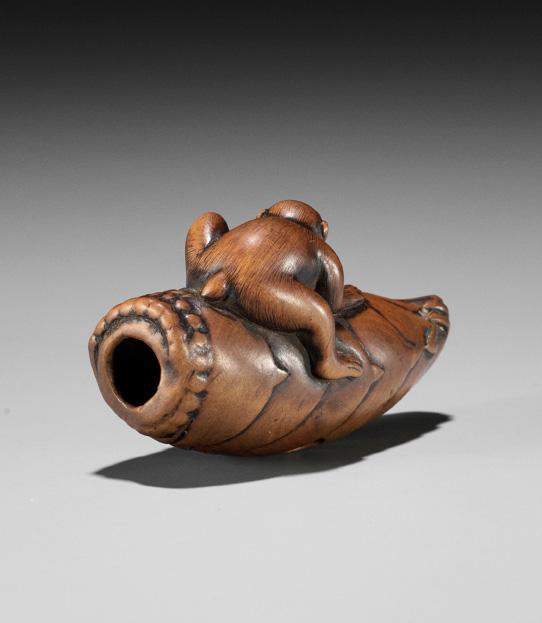
Unsigned
Japan, late 18th century, Edo period (1615-1868)
The monkey (saru) climbing up a large bamboo shoot, pulling at one of the folded leaves, its fur minutely incised and the expression neatly detailed. Very large himotoshi through the bamboo shoot. The surface attractively worn with a good patina.
LENGTH 5 cm
Condition: Very good condition with old wear and traces of use. Provenance: From the collection of Gaston Lazard (1878-1956) and his wife Jane Levy (1886-1985) and thence by descent within the same family.
LITERATURE COMPARISON
Compare to a related wood netsuke of a monkey on bamboo shoot, signed Miwa, illustrated in Sagemonoya (2004) Sleeping Beauties, no. 54.

Estimate EUR 2,500
Starting price EUR 1,200
201
167
168
SHUGETSU I: A SUPERB WOOD NETSUKE OF TEKKAI SENNIN
By Hara/Higuchi
Powerfully sculpted as the immortal Tekkai wearing a voluminous and elaborately flowing robe with a bag slung over his bag and a hyotan (double gourd) attached to his waist. The immortal is depicted here as an emaciated beggar with heavy skin folds and an extraordinarily well-carved, lamenting expression. In one hand, tucked under his arm, he is holding his characteristic cane, the other hand is tightly clenched into a fist as he looks upwards and presses his lips forward, exhaling his soul with his last efforts. Large himotoshi through the bag in the back which also houses the boldly incised two-character signature SHUGETSU.
HEIGHT 7.3 cm
Condition: Good, worn condition. One foot repaired and a small repair to the edge of the satchel.
Provenance: Ex-collection Rene Vittoz (1904 - 1992).
Tekkai Sennin is the Japanese adaptation of one of the Eight Chinese Immortals (Baxian). He was thought to be capable of leaving his body, sometimes traveling for extended periods. On one occasion, he asked a disciple to watch over his body and instructed him to burn it if his spirit did not return in seven days. On the sixth day, however, the disciple’s mother died, so he burned his master’s body and went home. Returning on the seventh day, Tekkai’s spirit found his body gone, leaving him no choice but to adopt the corpse of an emaciated beggar that he found beside the road.
LITERATURE COMPARISON
Compare to a closely related wood netsuke by Shugetsu I, formerly in the H. G. Beasley collection, sold at Sotheby’s, Fine Netsuke & Ojme, 14 March 1984, London, lot 32.


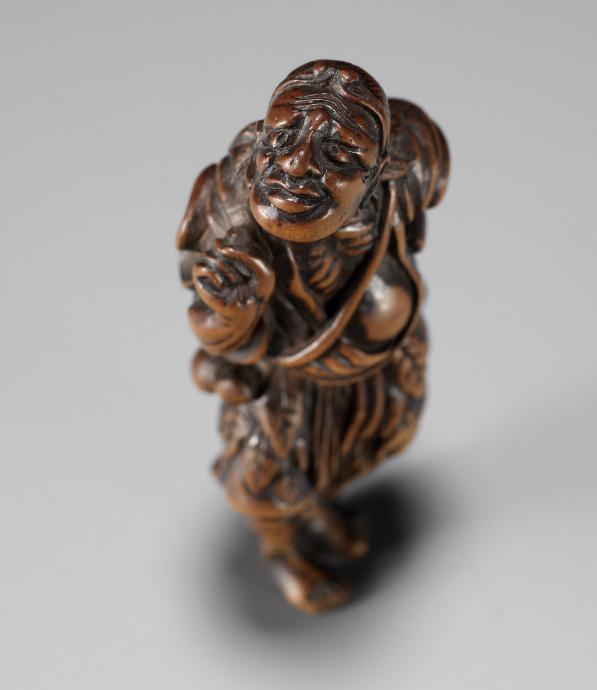
Estimate EUR 5,000
Starting price EUR 2,400
202
Shugetsu I, signed Shugetsu 舟月 Japan, Edo (Tokyo), late 18th century, Edo period (1615-1868)
169
SHUGETSU SHIZAN: A LARGE WOOD NETSUKE OF DARUMA

By Shugetsu, signed Shugetsu Shizan 舟月 紫山 saku 作 Japan, Edo (Tokyo), mid-19th century, Edo period (1615-1868)
Superbly carved, this well-known model by the Shumin lineage treated here with remarkable boldness. Daruma is depicted in a meditative pose, almost completely enveloped in his robe, the garment folds decisively incised, and the stern expression powerfully crafted and minutely detailed. The eyes are inlaid in dark horn, and the earrings and large himotoshi underneath are inlaid in stained bone. The wood bearing a fine, dark patina. Signed underneath SHUGETSU shizan saku [made by Shizan Shugetsu]. The art name Shizan, meaning literally “purple mountain”, was used by both Shugetsu II and III (see LNIA, vol. 2, p. 987). The art name Shizan was inscribed only on the best pieces by the master.

HEIGHT 4.5 cm, LENGTH 5.1 cm
Condition: Excellent condition, minor surface wear. Fine, dark patina.
Provenance: Collection Prof. Dr. Henk C. Hoogsteden, Rotterdam, purchased from Robert Fleischel in 2010.
AUCTION/LITERATURE COMPARISON
The present netsuke is much more common from the Shumin lineage and only very few examples are known bearing the Shugetsu signature. For another netsuke of Daruma, signed Shugetsu with kakihan, see Sotheby’s, Fine Netsuke Including Property from the Collection of Alan R. Liss, 2 September 1993, Chicago, lot 272.
Another wood netsuke depicting Daruma, signed Shugetsu with seal, executed in a different manner, is illustrated in Hurtig, Bernard (1973) Masterpieces of Netsuke Art: One Thousand Favorites of Leading Collectors, p. 99, no. 360.
Estimate EUR 3,000
Starting price EUR 1,500
170
SHUGETSU: A FINE WOOD NETSUKE OF THE SAMBIKI SARU (THREE WISE MONKEYS)



By Shugetsu, signed Shugetsu 舟月 Japan, Edo (Tokyo), first half of 19th century, Edo period (1615-1868)
A compact and finely carved netsuke of the sambiki saru, also referred to as the three wise monkeys. The three primates are huddled together, each using their hands to cover the others’ ears, eyes, or mouth. Their fur is neatly incised and their features, such as the eyes, fingers, and toes, are well-detailed. Signed on one of the monkeys’ backs SHUGETSU – probably Shugetsu II. Himotoshi underneath between one of the paws.
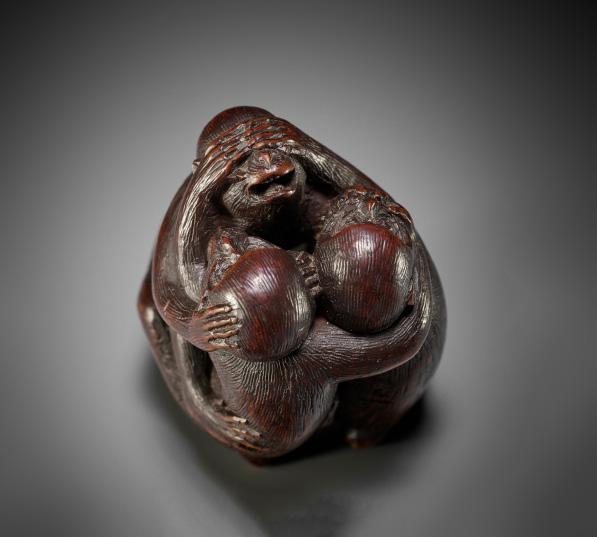
HEIGHT 3.8 cm
171
SHUGETSU SHIZAN: A FINE WOOD NETSUKE OF A MAN CUTTING A GIGANTIC GOURD
By Shugetsu, signed Shugetsu 舟月 with seal Shizan 紫山 Japan, Edo (Tokyo), 19th century, Edo period (1615-1868)
Intricately carved as a farmer dressed only in a loincloth and wearing a headband, squatting and straining to cut through a gigantic gourd with a large saw. Note the beautifully detailed expression and crisply carved hands and feet. Signed to the side of the gourd SHUGETSU and with seal Shizan, the seal quite brilliantly resembling the natural underside of the gourd. The art name Shizan was inscribed only on the best pieces by the master. Natural himotoshi.
HEIGHT 3.3 cm
Condition: Very good condition. Minor wear, a tiny chip to the headband in the back.
Provenance: From the collection of Gaston Lazard (1878-1956) and his wife Jane Levy (1886-1985) and thence by descent within the same family.
MUSEUM COMPARISON
A closely related wood netsuke of a man cutting a gourd is in the collection of the Metropolitan Museum of Art, accession number 81.1.118.

Estimate EUR 2,000
Starting price EUR 1,000
Condition: One foot with old repair to the toes, otherwise in excellent condition with minor wear.
LITERATURE COMPARISON
Monkeys appear to be a rare subject for the Shugetsu line of carvers. For an example of a single monkey performing the sambiki saru by Shugetsu I, see Scholten Japanese Art (2001) Expressions of Style, p. 123, no. 152.
Estimate EUR 2,500
Starting price EUR 1,200
204
172
A FINE EDO SCHOOL WOOD NETSUKE OF A BOY WEARING AN ONI MASK

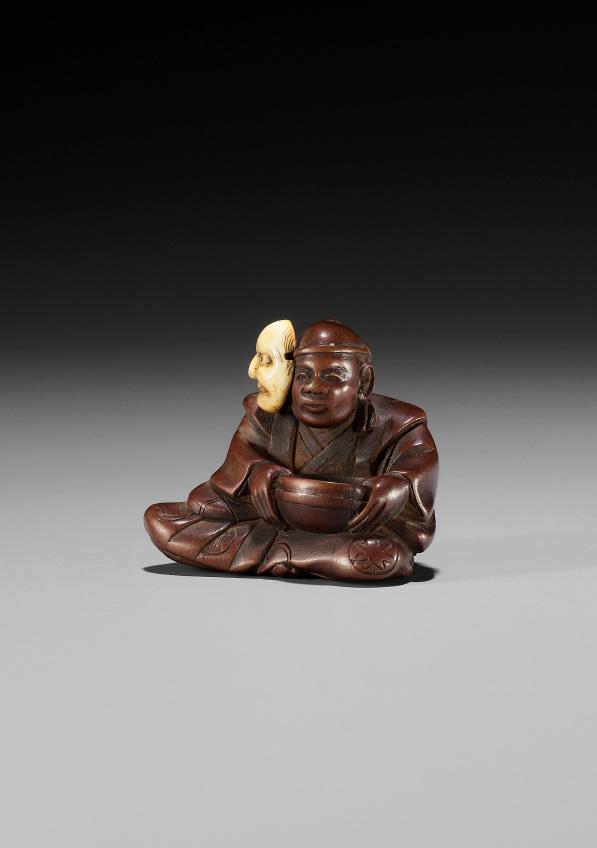
Unsigned Japan, Edo (Tokyo), mid-19th century, Edo period (1615-1868)
Finely carved, the boy kneeling as he holds an oni mask up in front of his face, holding the string with both hands, wearing a voluminous robe, the fine incision work heightened with dark staining, the back with two asymmetrical, generously excavated himotoshi.
HEIGHT 3.3 cm
Condition: Very good condition, appealingly worn, few tiny nicks.
Provenance: From the collection of Gaston Lazard (1878-1956) and his wife Jane Levy (1886-1985) and thence by descent within the same family.
MUSEUM COMPARISON
Compare a related wood netsuke by Ryuzan, 3.5 cm high, dated second half of 19th century, in the State Hermitage Museum, inventory number ЯР-1026.
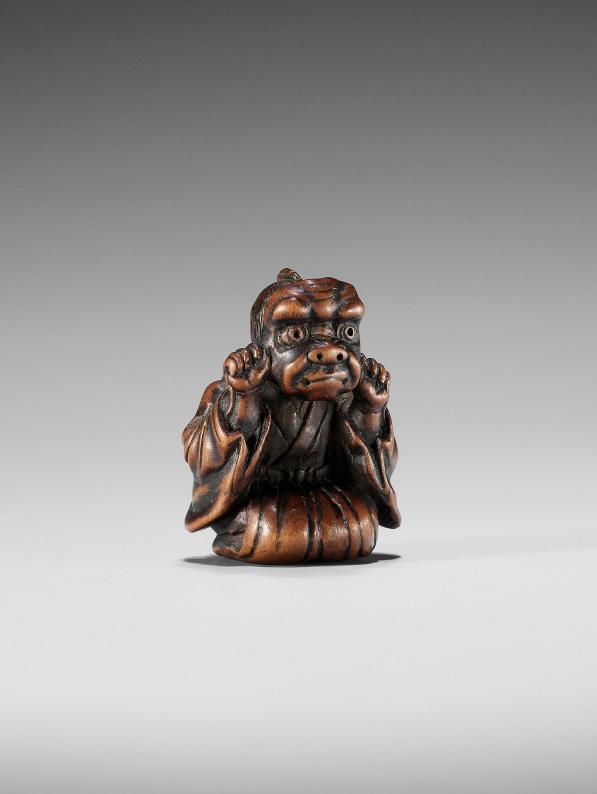
Estimate EUR 1,500
Starting price EUR 800
173
RYUKEI II: A FINE WOOD NETSUKE OF AN ACTOR WITH A BUAKU MASK
By
Ryukei II,
signed
Ryukei
龍珪 Japan, Edo (Tokyo), mid-19th century, Edo period (1615-1868)
Well carved to depict an actor seated with legs crossed, holding a large sake bowl with both hands over his lap, his expression betraying a state of inebriation, his face well detailed and hair neatly incised. The actor wears a typical robe incised with roundels and cloud designs, a Buaku mask carved from ivory tied to his forehead and hanging to the side of his head. The underside with two asymmetrical himotoshi, the larger of which is generously excavated to accommodate the knot, beside an ivory-inlaid rectangular reserve signed RYUKEI.
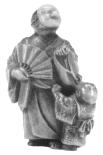
LENGTH 3.3 cm
Condition: Excellent condition with minor wear.
Provenance: From the collection of Gaston Lazard (1878-1956) and his wife Jane Levy (1886-1985) and thence by descent within the same family.
LITERATURE COMPARISON
Compare a related wood netsuke by Ryukei, depicting an actor wearing a Buaku mask, which is carved from coral, along with a karako, 4.3 cm high, dated 19th century, illustrated in Zacke (1985) Netsuke und Inro aus Japan, no. 9.
Estimate EUR 1,200
Starting price EUR 600
205
174
AN AMUSING EDO SCHOOL WOOD NETSUKE OF A MOXA CONTORTIONIST

Unsigned Japan, Edo (Tokyo), first half of 19th century, Edo period (1615-1868)
An amusingly crafted wood netsuke of a contorted man lying on his back, crossing his arms and legs, one foot touching a straw basket which he wears as a hat. The man is visibly in pain, his face twisted in a grimace. The cause is quickly revealed when turning the netsuke as six moxa pellets are inlaid in dark horn to his back. Natural himotoshi. The wood bearing a good patina.
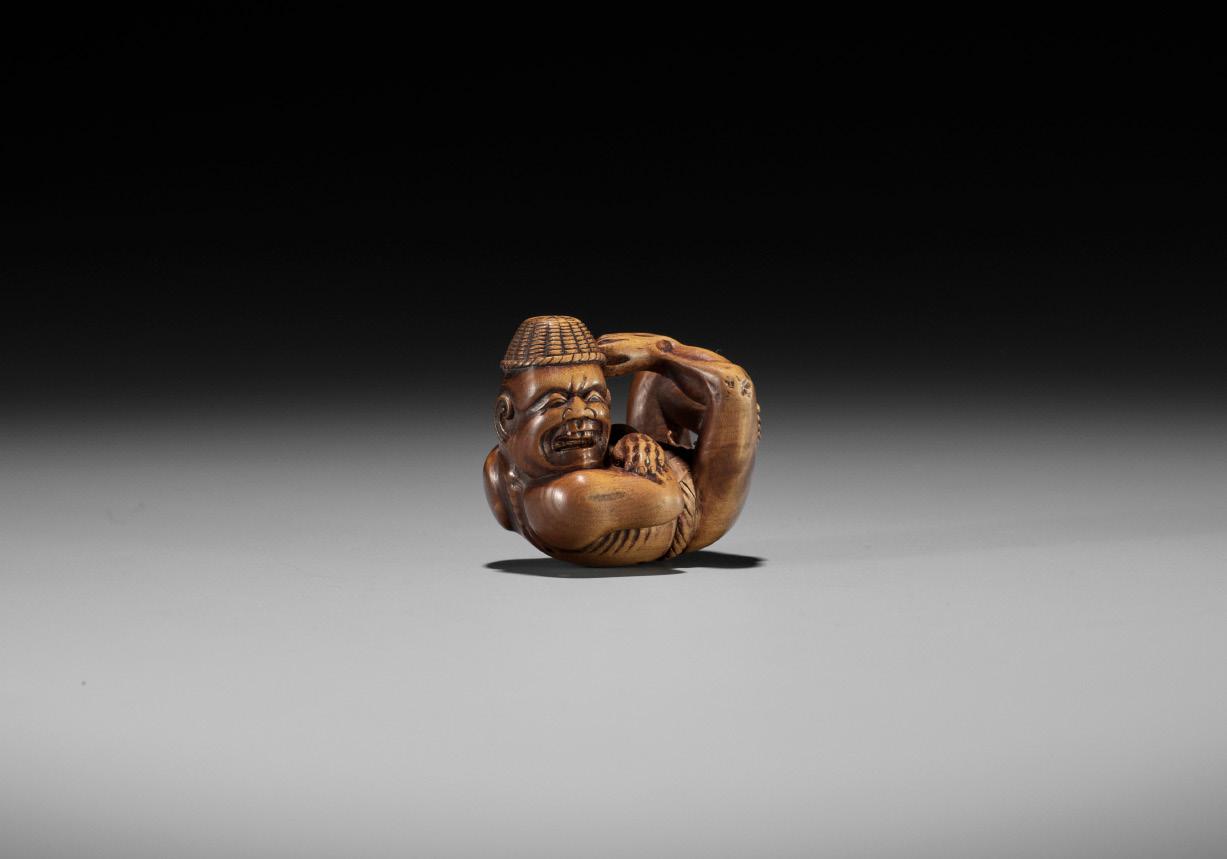
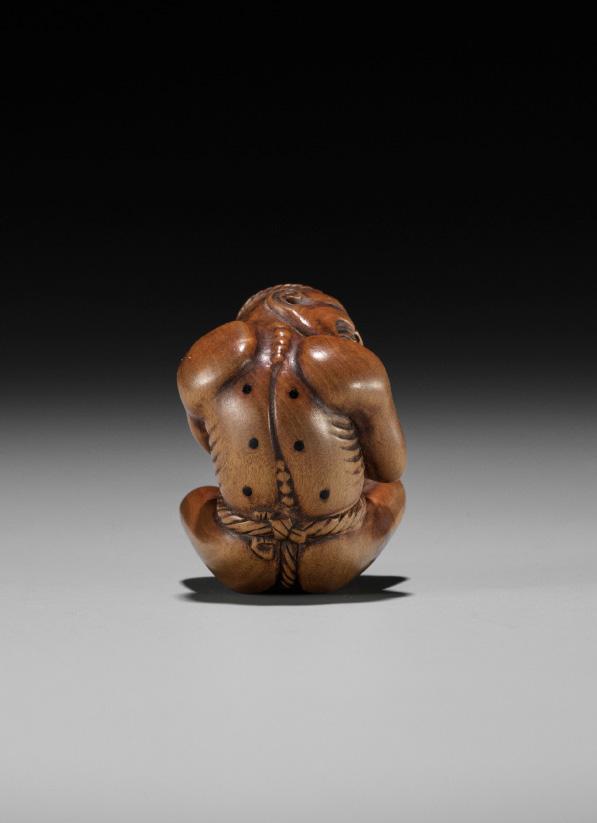
LENGTH 3 cm
Condition: Very good condition with minor typical surface wear.
Provenance: From the collection of Gaston Lazard (1878-1956) and his wife Jane Levy (1886-1985) and thence by descent within the same family.
Moxibustion is a traditional Chinese medicine therapy used to heat particular points of the body by using burning dried mugwort.
MUSEUM COMPARISON
Compare to an ivory netsuke depicting the same subject in the collection of the Los Angeles County Museum of Art (LACMA), accession number M.91.250.130.
Estimate EUR 3,000
Starting price EUR 1,500
206
175 HOKYUDO ITSUMIN: A FINE WOOD NETSUKE OF A BLIND MAN CLEANING HIS TEETH
 By Hokyudo Itsumin (active
By Hokyudo Itsumin (active
逢丘堂丘堂 to 刀
1830-1870), signed Hokyudo
Japan, Edo (Tokyo), c. 1830, Edo period (1615-1868)
Itsumin
The blind man of slender stature, wearing geta sandals and a long robe opening at the chest, tied at his waist with a broad obi suspending a kinchaku (pouch) and kiseruzutsu (pipe case), supporting himself on a cane, and cleaning his teeth using a fusayoji (tufted toothpicks). The back with asymmetrical himotoshi, the larger hole of oval shape. The wood with a fine, dark patina.

HEIGHT 8 cm
Condition: Excellent condition with minor wear.
Provenance: Max Rutherston Ltd., London, United Kingdom. A noted private collection, USA, acquired from the above.
Chew sticks are twigs or roots of certain plants that are chewed until one end is frayed. This end can be used to brush against the teeth, while the other end can be used as a toothpick. The earliest chew sticks have been dated to Babylonia in 3500 BC and an Egyptian tomb from 3000 BC. They are mentioned in Chinese records dating from 1600 BC, in the Ayurvedas around the 4th century BC and in Tipitaka, in the Buddhist Canon around the 5th century BC in India. The custom came to Japan with Buddhism and became popular during the mid-Edo period. Fusayoji (tufted toochpicks) were made from fragrant trees such as willow and black letters and were sold at shrine precincts.
A beauty cleaning her teeth with a fusayoji, by Utagawa Kunisada (17861865), University of Pittsburgh
Everyday figural subjects are rare in Itsumin’s work and this is likely an early work by the Edo school netsukeshi.
Estimate EUR 4,000
Starting price EUR 2,000
207
176
HOSHINSAI: A FINE EDO SCHOOL WOOD NETSUKE OF OMORI HIKOSHICHI ENCOUNTERING A DEMON
 By Hoshinsai,
By Hoshinsai,
signed
Hoshinsai 法眞齋
Japan, Edo (Tokyo), late 18th to early 19th century, Edo period (1615-1868)
A finely carved and powerfully executed wood netsuke, displaying a superb aji (patina). The hero Omori Hikoshichi is shown drawing his sword and looking back at the Hannya-faced demon which he carries on his back, the demon pulling a grimace and holding a loose strand of hair in her hand. According to legend, he thought he was carrying a beautiful lady across a stream, but in the ripples of the moonlight reflected on the water he discovered her true demonic form. Large himotoshi to the back and signed HOSHINSAI – a rarely encountered Edo school artist working in the style of Gessho.

HEIGHT 4.9 cm
Condition: Very good condition with typical and attractive wear. A small repair to one foot.
Provenance: A noted private collection, USA.
AUCTION COMPARISON
Compare to related, yet larger, Edo school wood netsuke depicting the same subject, at Zacke, Fine Netsuke & Sagemono, 29 October 2021, Vienna, lot 151 (sold for 12,008 EUR).

Estimate EUR 2,500
Starting price EUR 1,200
208
A WOOD NETSUKE OF AN ONI AT SETSUBUN, ATTRIBUTED TO ROKKO

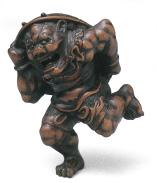
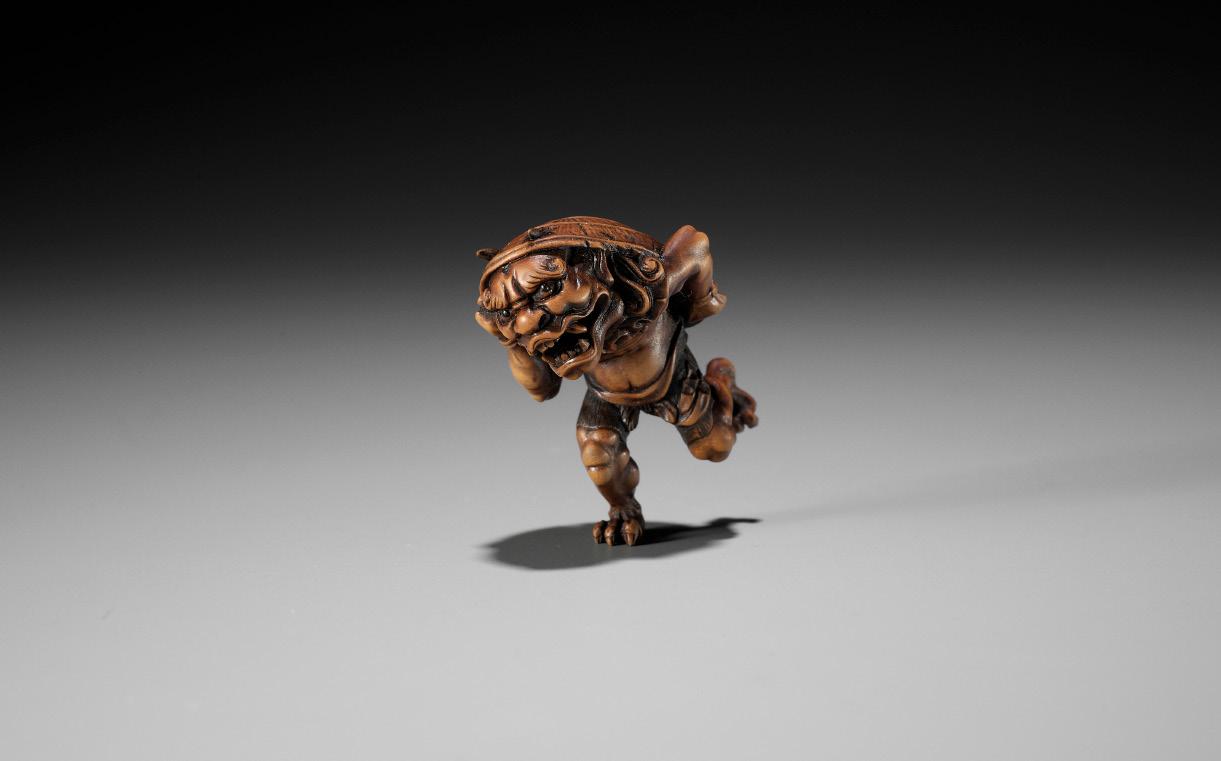

Attributed to Rokko, unsigned Japan, Tokyo, late 19th century
Finely carved as a running oni attempting to flee as he is being pelted with soybeans, holding a large straw hat over his back and head, his two horns poking through the hat, which has already suffered some well-executed ‘damage’, the demon’s muscles well detailed and heightened by skillful staining. His hair, brows, and garment are neatly incised. The eyes are inlaid with dark horn, the mouth agape in an agonized expression showing teeth and sharp fangs.
HEIGHT 4 cm
Condition: Excellent condition with minimal wear.
Provenance: Van Ham, 8 June 2017, Cologne, lot 1520 (sold for 2,193 EUR). A noted private collection, USA, acquired from the above.
The Setsubun festival is celebrated during the first day of spring and includes the rite of oni-yarai or mame-maki, where roasted beans are thrown at oni to rid the coming year of any demons and disease-bringing spirits. Sometimes, families also hang sardines and holly outside their doors, both of which were traditionally deemed unappealing to demons and thus also contribute to keeping the home free of evil spirits.
LITERATURE COMPARISON
Compare a closely related wood netsuke of an oni at Setsubun by Rokko, 4.5 cm high, dated 19th century, illustrated in Sagemonoya (2001) Netsuke That Never Left Japan, no. 25. Compare a closely related wood netsuke of an oni at Setsubun by Rokko, 5.7 cm high, dated 19th century, illustrated in Galerie Zacke (1982) Netsuke, no. 112.
Estimate EUR 2,000
Starting price EUR 1,000
209 177
178
AN AMUSING EDO SCHOOL WOOD SHUNGA NETSUKE OF A MAN CUTTING A HYOTAN
Unsigned Japan, Edo (Tokyo), first half of 19th century, Edo period (1615-1868)
The man wearing a half-shouldered robe, his hair tied in typical Edo fashion, the expression amusingly crafted as he cuts through a large hyotan (double gourd) secured with his two feet between his legs. Rather amusingly, the hyotan takes a distinct phallic shape in the process. The wood bearing a fine, dark patina. Large, asymmetrical himotoshi underneath.

HEIGHT 3.1 cm, LENGTH 3.6 cm
Condition: Very good condition, minor wear, some tiny surface nicks here and there. Fine, dark patina.
Provenance: From the collection of Gaston Lazard (1878-1956) and his wife Jane Levy (1886-1985) and thence by descent within the same family.
AUCTION/LITERATURE
COMPARISON
Compare to a closely related wood netsuke by Shuraku at Sotheby’s, Fine Netsuke Including Property from the Collection of Alan R. Liss, 2 September 1993, Chicago, lot 273. Another closely related wood netsuke by Masayuki is illustrated in Meinertzhagen, Frederick / Lazarnick, George (1986) MCI, Part A, p. 492. Another closely related wood netsuke by Miwa is illustrated in Arakawa, Hirokazu (1983) The Go Collection of Netsuke. Tokyo National Museum, pp. 104-105, no. 190/191.
Estimate EUR 1,200
Starting price EUR 600
179
MIWA: A CHARMING WOOD NETSUKE OF HOTEI YAWNING
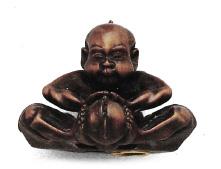


By Miwa, signed Miwa 三輪 with kakihan Japan, Edo (Tokyo), first half of 19th century, Edo period (1615-1868)
The pot-bellied lucky god wearing a loosely fitted robe and holding both hands to the side of his face as he lets out a cavernous yawn. The well-toned wood bearing a good patina. Large, asymmetrical himotoshi underneath, the smaller hole ringed in stained bone, and signed MIWA with a typical square seal-shaped kakihan.
HEIGHT 3.1 cm
Condition: Excellent condition, minor wear.
Provenance: From the collection of Gaston Lazard (1878-1956) and his wife Jane Levy (1886-1985) and thence by descent within the same family.
Estimate EUR 1,500
Starting price EUR 800
210
180
MIWA: A CHARMING WOOD NETSUKE OF DAIKOKU EMERGING FROM A RICE BALE
By Miwa, signed Miwa 三輪 with kakihan Japan, Edo (Tokyo), first half of 19th century, Edo period (1615-1868)
Carved as a group of two rice bales and a treasure bag, the God of Wealth Daikoku emerging from the largest bale in the middle, holding his wish-granting mallet up high, the top carved with a tama jewel, the entire composition set on a flat circular base. Large, asymmetrical himotoshi underneath, the smaller hole ringed in stained bone, and signed MIWA with a typical square seal-shaped kakihan. A charming and spirited little carving, Daikoku’s expression neatly detailed, the wood bearing a good patina.
HEIGHT 3.1 cm
Condition: Very good condition. Small chip to the side of the base, some minor wear to exposed areas.
Provenance: From the collection of Gaston Lazard (18781956) and his wife Jane Levy (1886-1985) and thence by descent within the same family.
Estimate EUR 1,500
Starting price EUR 800
181
MIWA: A FINE WOOD NETSUKE OF TWO SHISHIMAI PERFORMERS



By Miwa, signed Miwa 三輪 with kakihan Japan, Edo (Tokyo), first half of 19th century, Edo period (1615-1868)
Finely carved as a group of two shishimai performers, one in the back sitting upright and wearing an Okame mask behind his head, his face minutely incised with a jovial expression. The other performer is hidden within the shishimai costume, his remarkably well-carved face hidden within the jaws of the lion head, the eyes of the mask double-inlaid in bone and dark wood. Very large, generously excavated himotoshi underneath and signed MIWA with a typical square seal-shaped kakihan.
HEIGHT 2.9 cm
Condition: Very good condition with minor wear and traces of use around the himotoshi. Good patina.
Provenance: From the collection of Gaston Lazard (1878-1956) and his wife Jane Levy (1886-1985) and thence by descent within the same family.
The Shishimai festival was imported from China during the Tang dynasty and is celebrated during the New Year to bring good luck and ward off evil spirits.
LITERATURE COMPARISON
Compare to two closely related wood netsuke, by Miwa, illustrated in Arakawa, Hirokazu (1983) The Go Collection of Netsuke. Tokyo National Museum, pp. 102-105, nos. 188 & 192.
Estimate EUR 1,500
Starting price EUR 800
211
182
MUGAI:
A RARE WOOD NETSUKE OF A BLIND FISHERMAN TAMING THE NAMAZU


 By Mugai, signed Mugai 夢外 Japan, late 18th to early 19th century, Edo period (1615-1868)
By Mugai, signed Mugai 夢外 Japan, late 18th to early 19th century, Edo period (1615-1868)
An unusual and spirited carving, depicting a blind fisherman clad only in a fundoshi, his enlarged testicle slipping out, his face with an amusingly distorted expression, one eye closed and the other bulging, as he tries to tame the namazu with his tiny gourd – an amusingly futile attempt. The gigantic namazu appears to be smiling, the expressions of the two providing a humorous contrast. The namazu’s eyes are inlays of black wood. Large, asymmetrical, and generously excavated himotoshi underneath and signed MUGAI - The artist is exceedingly rare with only very few examples recorded. The well-toned wood bearing a beautiful, dark patina.
LENGTH 5.2 cm
Condition: Very good condition, some fine age cracks and light surface scratches. Good patina.
Provenance: From an old Swiss private collection, Geneve, purchased at Sotheby’s, 16 July 1973, London, lot 153.
Legend has it that certain types of catfish (namazu) are responsible for the earthquakes that plague the islands of Japan. When aroused, these creatures would contort their bodies in such a way that gigantic tremors shook the area for miles and miles. The Shinto deity Kadori Myojin usually attempts to prevent such catastrophe with the help of his magic gourd.
Estimate EUR 4,000
Starting price EUR 2,000
212
SHOKO: AN AMUSING WOOD NETSUKE OF A BLINDMAN AND PUPPY

 By Shoko Sugonoya, signed Shoko 尚古 Japan, Hida-Takayama, second half of 19th century
By Shoko Sugonoya, signed Shoko 尚古 Japan, Hida-Takayama, second half of 19th century
A finely carved and humorous wood netsuke of a blindman with a large bump on his head, one eye closed and the other inlaid eye bulging, his face grimacing as a small puppy pulls on his kimono, the poor man swinging his cane backwards to fend off the mischievous animal. Natural himotoshi and signed SHOKO on the geta underneath the puppy, the other is worn by the blind man.
HEIGHT 4.6 cm
Condition: Excellent condition, minor wear.
MUSEUM COMPARISON
Compare to a related wood netsuke of a blindman, by Shoko, in the Los Angeles County Museum of Art (LACMA), accession number M.91.250.160.

Estimate EUR 3,000
Starting price EUR 1,500
213 183
MASATAMI: A VERY FINE IVORY NETSUKE OF A RAT ON CHESTNUT


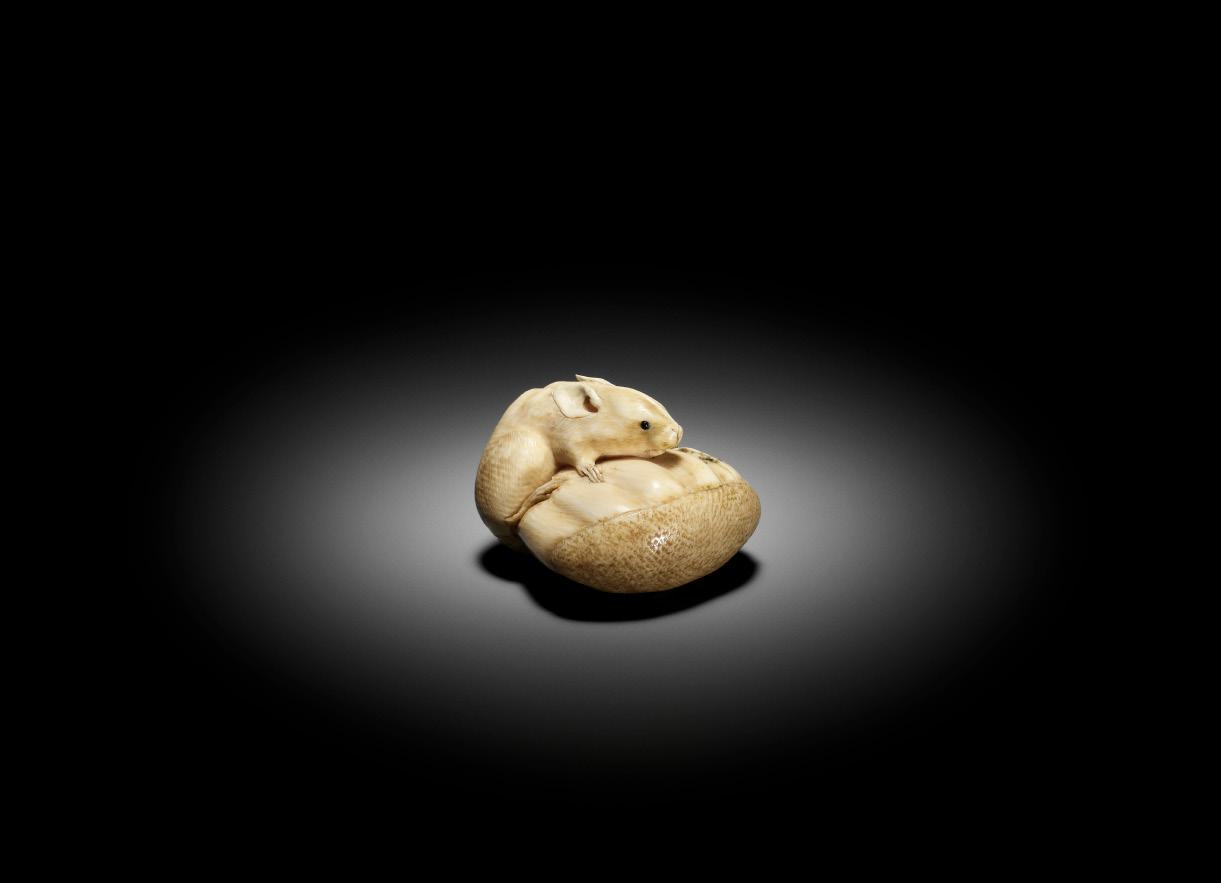
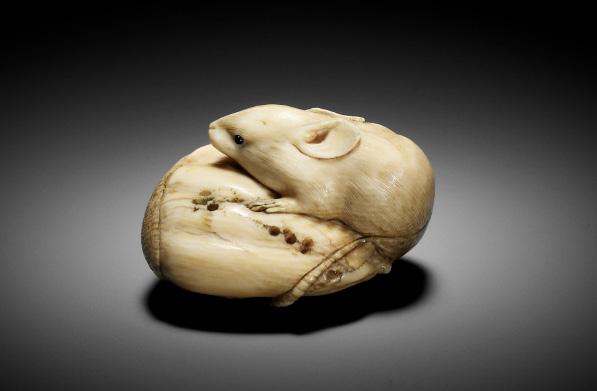 By Masatami (Shomin), signed Masatami 正民 Japan, Tokyo, mid to late 19th century
By Masatami (Shomin), signed Masatami 正民 Japan, Tokyo, mid to late 19th century
Very finely carved and beautifully stained to depict a rat awkwardly clambering on a chestnut, the nut realistically rendered with various polished and stippled textures, as well as simulated worm rot. The rat is exquisitely carved with superbly incised fur and large inlaid eyes of dark buffalo horn. The well-carved tail curves around the underside and touches the rodent’s body to the side. Himotoshi on either side of the tail and signed MASATAMI – the carver is best known for his idiosyncratic carvings of monkeys, but did occasionally carve rats as well, this is the finest example we have encountered.
LENGTH 3.2 cm
Condition: The tips of the ears repaired. Otherwise very good condition with minor wear and few fine age cracks. Provenance: From the collection of Dr. Ferdinand and Dr. Gudrun Thaler-Szulyovsky, and thence by descent in the same family. The couple, who had both been practicing law, met in 1967 through their mutual passion for art. Together they built a substantial and diverse art collection including many fine netsuke.
MUSEUM COMPARISON
Masatami carved several netsuke depicting monkeys with chestnuts, however the present model of a rat with chestnut appears to be rare. Compare to an ivory netsuke of a monkey with chestnut, by Masatami, in the collection of The Metropolitan Museum of Art, New York, accession no. 10.211.1065.

AUCTION COMPARISON
Compare to a closely related ivory netsuke of two rats on a fan, by Masatami, sold at Lempertz, Netsuke und Sagemono inkl. Sammlung Kolodotschko V, 9 June 2017, Cologne, lot 602 (sold for 2,728 EUR).
Estimate EUR 3,000
Starting price EUR 1,500
214
184
MINKOKU: A FINE IVORY NETSUKE OF YAMA-UBA AND KINTARO

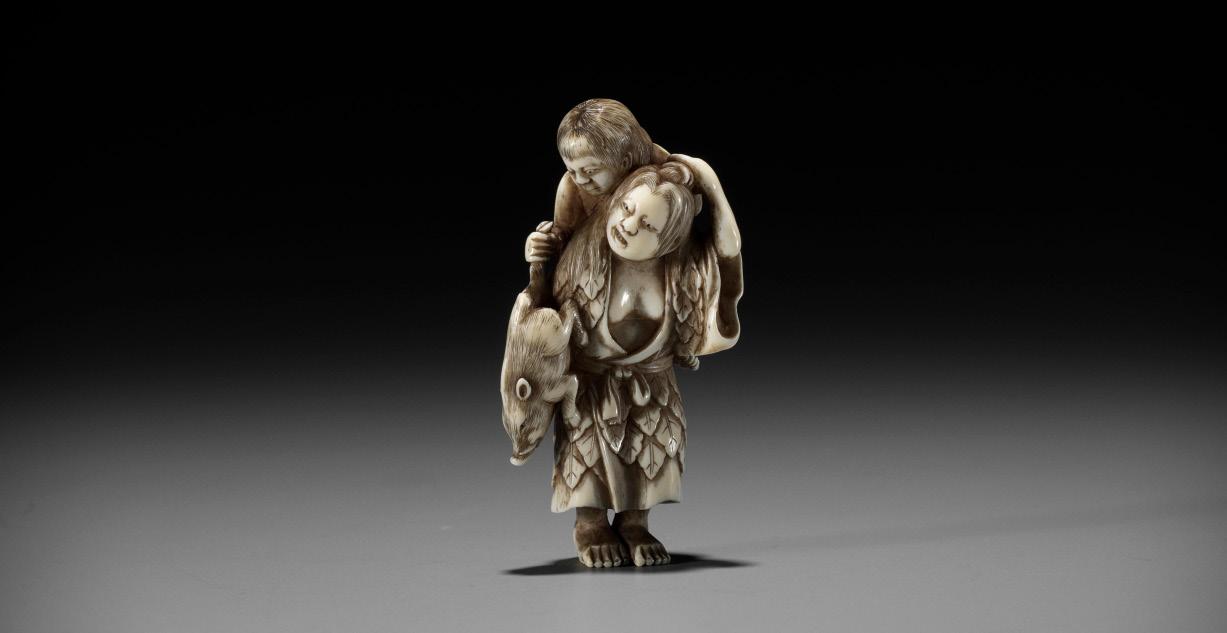
 By Shuyusai Minkoku (Minkoku III), signed Minkoku 民谷 Japan, Edo (Tokyo), mid-19th century, Edo period (1615-1868)
By Shuyusai Minkoku (Minkoku III), signed Minkoku 民谷 Japan, Edo (Tokyo), mid-19th century, Edo period (1615-1868)
Published: Sagemonoya (2022), The Gabor and Georgina Wilhelm Collection, p. 42, no. 61.
The mountain witch Yama-uba depicted here in a youthful manner, wearing a loosely fitted leaf cloak, opening at the chest, supporting Kintaro on her back, while the strong boy pulls on her hair, causing her visible discomfort, the other hand pulling on the leg of a minutely carved baby boar which tries to escape Kintoki’s clutches. The details are masterfully carved, particularly the expressions are lifelike and animated. Large himotoshi through the back, the signature located on the hem of the robe within a rectangular reserve MINKOKU.
HEIGHT 5.5 cm
Condition: Excellent condition with minor expected wear. Provenance: The Gabor Wilhelm Collection, Paris.
Kintaro (also known as the “Golden Boy”) is a folk hero from Japanese folklore. A child of superhuman strength, he was raised by Yama-uba on Mount Ashigara. Later he became a loyal follower of Minamoto no Yorimitsu under the new name Sakata no Kintoki. In his youth he was known to wrestle various animals from the mountain and was reputed to be able to lift a baby boar as an infant.
Estimate EUR 3,000
Starting price EUR 1,500
215
185

IKKOSAI: AN IMPORTANT AND LARGE IVORY NETSUKE OF IDATEN CAPTURING AN ONI

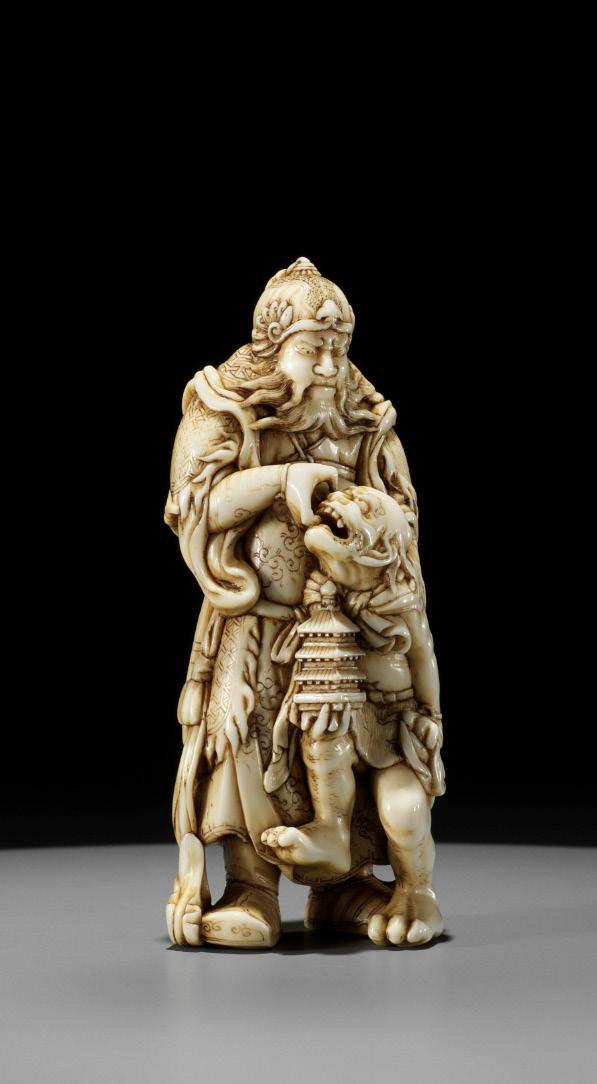 By Ikkosai Toun, signed Ikkosai 一光齋 Japan, Edo (Tokyo), mid-19th century, Edo period (1615-1868)
By Ikkosai Toun, signed Ikkosai 一光齋 Japan, Edo (Tokyo), mid-19th century, Edo period (1615-1868)
Published:
International Netsuke Society Journal (Spring 2019) Vol. 39, no. 3, p. 21, fig. 5.
Sagemonoya (2022), The Gabor and Georgina Wilhelm Collection, p. 36, no. 52.
A remarkably powerful and superbly carved, tall ivory netsuke of Idaten, protector of monasteries and monks, dressed in full Tang Chinese armor, carrying a sheathed sword on his back, capturing the oni shoshitsuki who has stolen a Buddhist reliquary containing one of Buddha’s teeth, the protective deity grabbing the oni’s mouth and forcefully removing the stolen tooth. The lightly stained ivory is carved with incredible detail – note the finely incised beard of Idaten and the hair of the oni, the various incised patterns to the armor, and the billowing celestial scarves which move seamlessly around the composition. The signature is located within an oval reserve IKKOSAI between the two himotoshi.
HEIGHT 8.8 cm
Condition: Excellent condition with minor surface wear and only very few natural age cracks. Fine patina.
Provenance: The Gabor Wilhelm Collection, Paris.
This carver Ikkosai, who also used the art name Toun, was likely a direct pupil of Ikkosai Saito Itaro, who also treated this rare subject. Considering the quality and size, the present netsuke has to be regarded as the figural masterpiece of this school.
Estimate EUR 30,000
Starting price EUR 15,000
Hashimoto Gaho, Idaten
Pursuing an Oni, c. 1885 (Philadelphia Museum of Art, accession no. 1941107-15)

217 186
IKKOSAI: AN AMUSING IVORY SHUNGA NETSUKE OF DAIKOKU AND EBISU

 By Ikkosai Saito Itaro, signed Ikkosai 一光斎 Japan, Edo (Tokyo), mid-19th century, Edo period (1615-1868)
By Ikkosai Saito Itaro, signed Ikkosai 一光斎 Japan, Edo (Tokyo), mid-19th century, Edo period (1615-1868)
A compact and intricately carved ivory netsuke depicting Daikoku and Ebisu, the latter hunched over a two-pronged daikon (radish) and the former fondling the vegetable, both laughing mischievously at its phallic appearance. Daikoku’s rats are also present in this charming carving, one is scurrying underneath the lucky god, looking up at him, and the other is found on top of a basket carved with human-faced handles. The lightly stained ivory bearing a fine patina. Himotoshi through the basket and signed underneath within the typical oval reserve IKKOSAI.
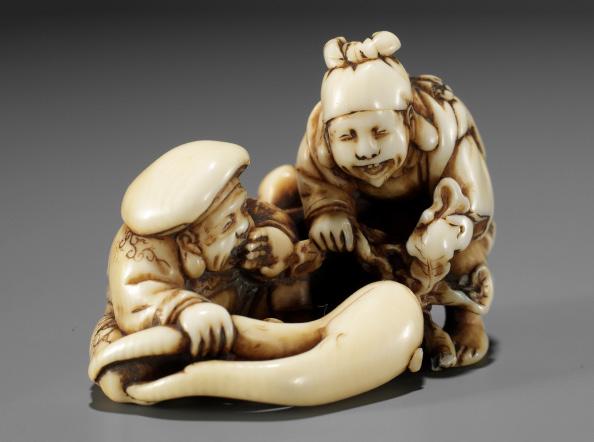
Condition: Good condition with minor surface wear. One of the daikon leaves with a chip.
Provenance: The Gabor Wilhelm Collection, Paris.
For a discussion of the artist, see International Netsuke Society Journal (Spring 2019) Vol. 39, no. 2, pp. 13-20.
Estimate EUR 3,000
Starting price EUR 1,500
218 187
LENGTH 3.9 cm
IKKOSAI: AN AMUSING IVORY NETSUKE OF GAMA, CHOKARO, AND TEKKAI SENNIN

 By Ikkosai Saito Itaro, signed Ikkosai 一光斎 Japan, Edo (Tokyo), mid-19th century, Edo period (1615-1868)
By Ikkosai Saito Itaro, signed Ikkosai 一光斎 Japan, Edo (Tokyo), mid-19th century, Edo period (1615-1868)
An amusing and rather unusual group of three sennin huddled together as they watch Gama’s toad riding on Chokaro’s horse on top of a scroll. All three sennin are laughing as Tekkai points at the toad in disbelief, while Gama screams out in laughter while pulling on the horse’s tail. Chokaro in the back is shown holding his enchanted hyotan (double gourd), tucking it away after releasing the horse. The ivory is lightly stained, as is typical for the artist, and the details are finely carved and embellished with sumi (ink). Himotoshi through the back and underside, the signature underneath located in the typical oval reserve IKKOSAI.

LENGTH 4 cm
Condition: Excellent condition with only very minor wear and few natural age cracks.
LITERATURE COMPARISON
Compare to a closely related ivory netsuke, by Ikkosai, illustrated in Coullery, Marie-Therese and Newstead, Martin S. (1977) The Baur Collection, pp. 92-93, no. C 144.
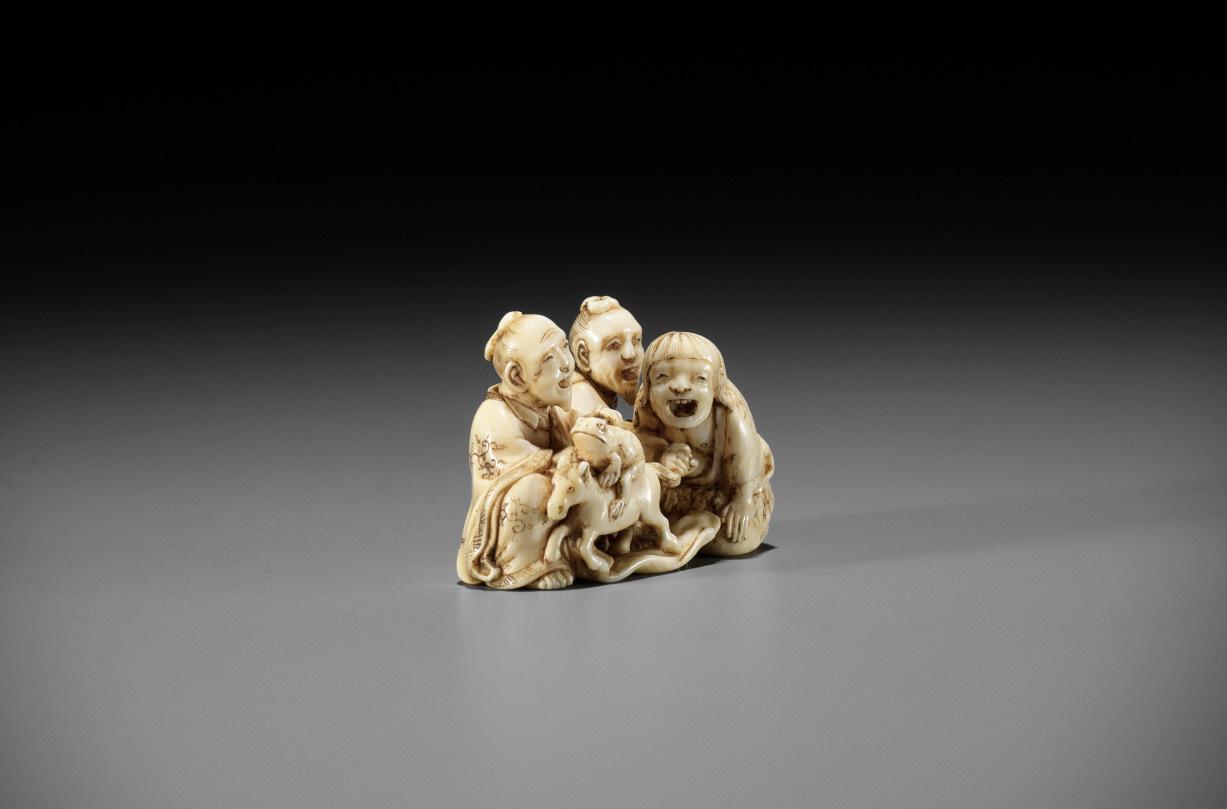
For a discussion of the artist, see International Netsuke Society Journal (Spring 2019) Vol. 39, no. 2, pp. 13-20.
Estimate EUR 3,000
Starting price EUR 1,500
219
188
189
GYOKKOSAI: A FINE IVORY NETSUKE OF JUROJIN HOLDING A SCROLL


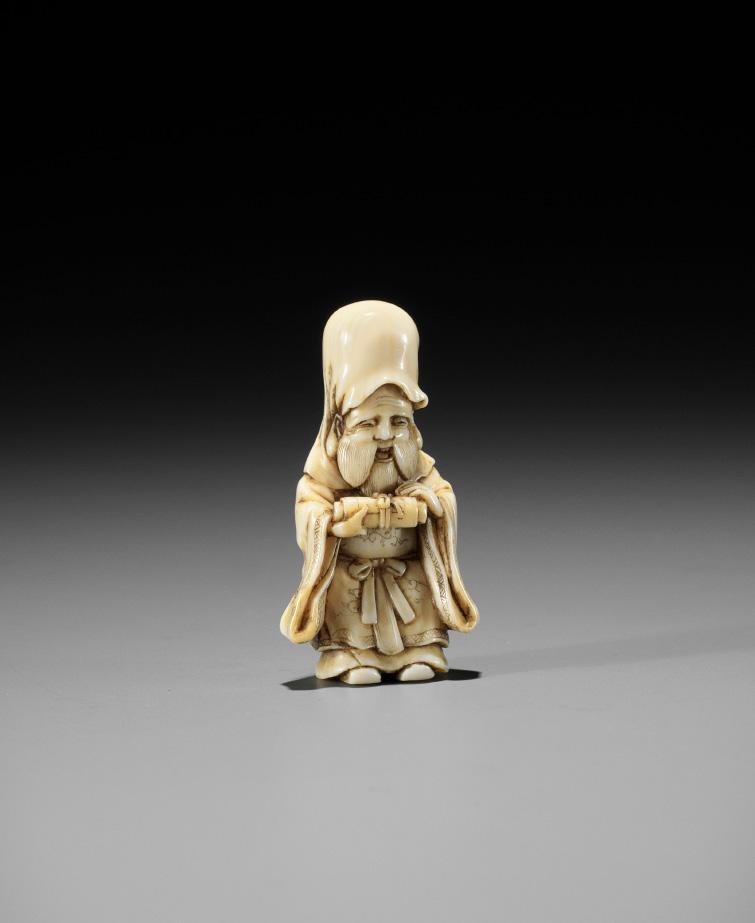 By Gyokkosai, signed Gyokkosai 玉光齋 Japan, Edo (Tokyo), mid-19th century, Edo period (1615-1868)
By Gyokkosai, signed Gyokkosai 玉光齋 Japan, Edo (Tokyo), mid-19th century, Edo period (1615-1868)
Finely carved, the ivory lightly stained and beautifully polished, depicting Jurojin wearing a large cowl draped over his elongated head, laughing jovially, his face framed by a neatly incised beard and pendulous earlobes, holding a scroll before him. The lucky god’s loosely fitted robe is minutely incised with scrolling vines and his long sleeves are draping towards the ground. Two himotoshi to the back and signed GYOKKOSAI.
HEIGHT 4.4 cm
Condition: Excellent condition with minor expected wear. Provenance: French private collection, purchased from Galerie Yamato, Paris, 2004.
Gyokkosai was an accomplished student of Ikkosai Saito Itaro, for a discussion of his work see the International Netsuke Society Journal (Spring 2019) Vol. 39, no. 2, pp. 18-20.
AUCTION COMPARISON
A closely related ivory netsuke, by Gyokkosai, was sold by Zacke, Fine Netsuke, Sagemono & Okimono, 2 November 2019, Vienna, lot 180 (sold for 6,320 EUR). Another closely related netsuke, carved from wood, by Hojitsu, was sold at Zacke, Fine Netsuke & Sagemono, 25 September 2020, Vienna, lot 98 (sold for 5,056 EUR).
Estimate EUR 2,500
Starting price EUR 1,200
190
RYOJI: A FINE IVORY NETSUKE OF A SAMBASO DANCER
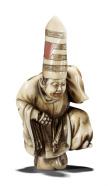
 By Ono Ryoji, signed Ryoji 凌次 Japan,
By Ono Ryoji, signed Ryoji 凌次 Japan,
Tokyo, late 19th century
Well carved as a sambaso dancer standing on his right foot, wearing a characteristic striped eboshi with roundels, his voluminous robe neatly incised with pine saplings, leafy chrysanthemum sprays, and a foliate design. He holds a bell tree with cords attached in his right hand. The ivory bearing a subtle stain and fine polish. The back of his robe with two himotoshi. Signed to the underside above his right foot RYOJI.
HEIGHT 4.9 cm
Condition: Excellent condition with minor wear.
Provenance: Collection Prof. Dr. Henk C. Hoogsteden, Rotterdam.
AUCTION COMPARISON
Compare to a related ivory netsuke of a sambaso dancer, with movable tongue, by Rakumin, at Zacke, Asian Art Discoveries, 20 January 2023, Vienna, lot 1408 (sold for 2,340 EUR).
Estimate EUR 1,500
Starting price EUR 800
220
191
JUGYOKU: A FINE IVORY MANJU NETSUKE DEPICTING A SCENE FROM THE KYOGEN PLAY TSURIGITSUNE
 By Ryukosai Jugyoku, signed Jugyoku 壽玉 Japan, Edo (Tokyo), mid-19th century, Edo period (1615-1868)
By Ryukosai Jugyoku, signed Jugyoku 壽玉 Japan, Edo (Tokyo), mid-19th century, Edo period (1615-1868)
Of circular form, the two-part manju finely stained and carved to one side in shishiaibori (sunken relief) with Hakuzosu holding a fox mask in his right and a staff in his left hand, to his right the fox hunter kneeling, cleverly carved in high relief to give a threedimensional feel to the scene. The reverse engraved with a fox trap below the central himotoshi and signed JUGYOKU.
The combination of the techniques of sunken and high relief is quite rare and cleverly utilized here as it ties into the subject matter of the manju, as the sly fox is depicted in the background, almost lurking in the shadows.
DIAMETER 4.9 cm
Condition: Excellent condition, minor surface wear.
Provenance: Collection Gabor Orszagh, Budapest, Hungary.
The manju depicts a scene from the Kyogen play Tsurigitsune (‘Fox trapping’), in which a fox hunter is visited by his uncle, the priest Hakuzosu, who lectures his nephew on the evils of killing foxes. The hunter is nearly convinced, but after the priest departs, he hears the cry of the fox and realizes it wasn’t his uncle at all but a fox in disguise. The fox resumes his natural form and reverts to his wild ways, takes the bait in a trap, and is captured by the fox hunter.
Estimate EUR 1,500
Starting price EUR 800
192
JUGYOKU: A VERY FINE IVORY MANJU NETSUKE OF DARUMA
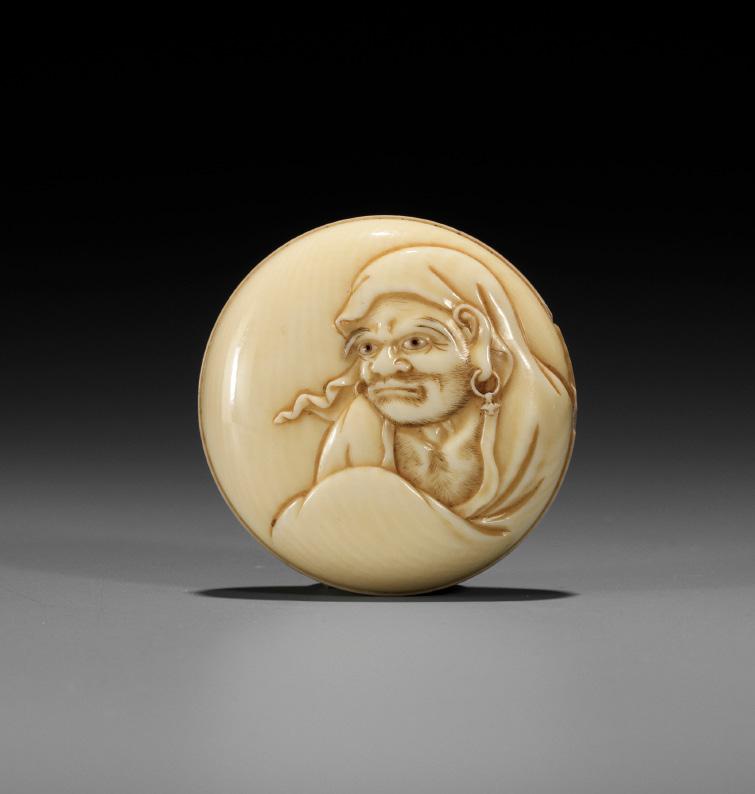
By Ryukosai Jugyoku, signed Jugyoku 壽玉 and sealed Yamazumi (Sanju) 山住
Japan, Edo (Tokyo), mid-19th century, Edo period (1615-1868)
The rounded two-part ivory manju netsuke superbly polished and attractively stained, carved in relief to the front with a pensive image of Daruma with some sumi-stained details, the eyes doubleinlaid in pale horn with dark horn pupils. The reverse shows a hossu (Buddhist fly whisk) executed in shishiaibori (sunken relief) with superb katakiri engraving. Signed JUGYOKU with red-lacquered square seal Yamazumi, which indicates a Shinto shrine. Central himotoshi to the back, the cord attachment within.
DIAMETER 4.8 cm
Condition: Very good condition, some minor chipping to the exterior and interior rim.
Provenance: The Gabor Wilhelm Collection, Paris. Old Japanese label to the interior.
Estimate EUR 1,500
Starting price EUR 800
221
KOSAI MORITOSHI: A FINE IVORY MANJU NETSUKE DEPICTING GENTOKU ON HORSEBACK
By Kosai Moritoshi (1854-1911), signed Kosai Moritoshi 孝齋 守壽 with kakihan Japan, Tokyo, late 19th century, Meiji period (1868-1912)
Finely carved in shishiaibori with the Han-dynasty hero on horseback, brandishing a long spear, wearing a patterned robe over his armor, the horse with finely incised fur, all surrounded by thick clouds. Cord attachment through the peg in the middle. Signed to the back KOSAI MORITOSHI with the characteristic ‘flying crane’ kakihan.
DIAMETER 5.6 cm
Condition: Excellent condition with only minor wear.
Gentoku was a descendant of the fourth generation of the Emperor Keitei of the Eastern Hung dynasty. Although of Royal blood, he began life in the humble position of a shoemaker. After he put down an uprising by the ‘Yellow Ribbon Rebels’ he was rewarded by the emperor and was made governor of Yoshu. But when the emperor was defeated Gentoku lost his position and became homeless. A relative of his, Riu Hio, took him in and even gave him quarters in a nearby castle. This did not please Riu Hio’s wife or relatives and they plotted to kill Gentoku. His escape took place when, surrounded on three sides, the only way out was to the west where there was a cliff overlooking a wide river with a fast flowing current. As soon as he realized his position, Gentoku, without a moment’s delay, decided to attempt to escape across the river, and without waiting to inform his escort, he threw himself onto his favorite horse Tekiro and bolted towards the water. As soon as it became obvious that the bird was flown, a body of horsemen was detached in pursuit, but Gentoku, although aware of the apparent hopelessness of his task, gave rein to his good horse and dashed into the river. None of his pursuers felt himself called upon to attempt to follow the fugitive into the swirling waters, and, fate favoring the bold, Gentoku safely negotiated the dangerous passage and gained the opposite bank, thus escaping the snare so carefully set for him.
Kosai Moritoshi (1854-1911) was the founder of a school of Manju netsuke carvers. Ueda Reikichi describes this carver’s work as having “a beautiful style”. See Bushell, Raymond (1961) The Netsuke Handbook by Ueda Reikichi, p. 543.
MUSEUM COMPARISON
Compare a closely related ivory manju netsuke by Kosai Moritoshi depicting the same subject, 5.2 cm, dated late 19th to early 20th century, formerly in the collection of Raymond Bushell and now in the Los Angeles County Museum of Art, accession number M.87.263.25.
AUCTION COMPARISON
Compare a related ivory manju netsuke by Kosai Moritoshi, depicting Prince Hanzoku and the nine-tailed fox, similarly carved in shishiaibori, at Galerie Zacke, 1 September 2022, Vienna, lot 171 (sold for 5,056 EUR).



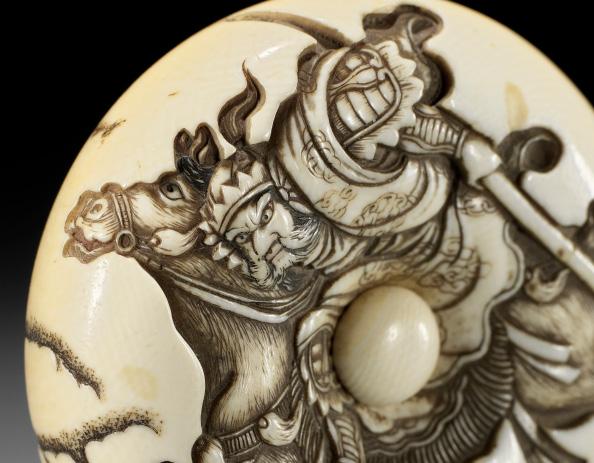
Estimate EUR 3,000
Starting price EUR 1,500
222 193
194
KIKUGAWA: A LARGE IVORY MANJU NETSUKE DEPICTING THE WISTERIA MAIDEN (FUJI MUSUME) AND A REPENTANT ONI (ONI NO NENBUTSU)


Finely carved in shishiaibori with Fujihime holding a trailing branch of wisteria, wearing intricately patterned robes inlaid with motherof-pearl, gilt-metal, coral, and stained bone, looking coquettishly towards the repentant oni, who shows a hesitant expression, biting one of his fingers, the gesture akin to a fish hook, a gong and inscribed donation ledger tied around his neck, a parasol around his back. The reverse incised and stippled with two sheets of paper bearing an outline of ash-stenciled oni, fitted in the center with a silver loop finial attached with a flap with gold takazogan and carved in katakiri and kebori with flames, clouds, and a waterfall, and signed KIKUGAWA with a red seal tomoe.
DIAMETER 6.6 cm
Condition: Good condition, minor wear, natural age cracks, few losses to inlays.
Estimate EUR 4,000
Starting price EUR 2,000
The Wisteria Maiden (Fuji Musume) and repentant oni (Oni no Nenbutsu), from the series Edo shire Otsu miyage (Souvenir Paintings from Otsu, Stocked in Edo), by Kitagawa Utamaro I (17531806), c. 18021803, Museum of Fine Arts, Boston, accession number 11.14202
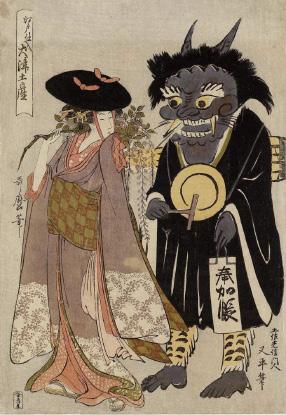
223
By a member of the Kikugawa family, signed Kikugawa 菊川 with seal Tomoe 巴 Japan, late 19th century, Meiji period (1868-1912)
195
GYOKUSAI: A RARE IVORY NETSUKE OF THE MONKEY KING SONGOKU


 By Gyokusai, signed Gyokusai 玉哉 Japan, Tokyo, c. 1880
By Gyokusai, signed Gyokusai 玉哉 Japan, Tokyo, c. 1880
Finely carved in a dynamic pose, standing on one foot atop his cloud with the other leg raised, which along with his billowing sleeve indicates rapid movement, wearing neatly incised patterned robes and armor, holding his sacred baton, staring into the distance and shielding his eyes from the wind and sun, his eyes inlaid with dark wood. Several natural himotoshi due to the openwork.
HEIGHT 4.6 cm
Condition: Very good condition, minor wear, the upper back with a plugged nerve channel and associated minor age crack.
Provenance: Galerie Yamato, Paris, April 2003. French private collection, acquired from the above.
The monkey king Songoku is rarely seen in netsuke art and is derived from the 16th-century Chinese classic Journey to the West, where he is known as Sun Wukong. He became a popular character in Japan when the novel was translated and published during the Edo period. Songoku was one of three servants of the holy monk Sanzo Hoshi (Xuanzang), the others being a boar and a demon. His patron having to prove his saintliness by performing 108 different acts, Songoku helped him by plucking 107 of his hairs and blowing on them to create the same number of doubles of his master, leaving each to carry out one saintly act. The band around his head is what bound him to obey his monastic master. The cloud he is seen standing on in this netsuke can instantly transport him over great distances.
LITERATURE COMPARISON
Compare a closely related ivory netsuke of Songoku by Gyokusai, illustrated in Ueda, Reikichi (1934) Netsuke for Taste (Shumi no Netsuke), and in Meinertzhagen, Frederick / Lazarnick, George (1986) MCI, Part A, p. 102.
AUCTION COMPARISON
Compare a closely related ivory netsuke of Songoku by Gyokusai, formerly in the collection of Baron Van Zuylen, at Christie’s, 21 November 1977, London, lot 86 (illustrated on plate 6). Also compare to a marine tooth netsuke of Songoku at Zacke, Fine Netsuke & Sagemono, 22 April 2022, Vienna, lot 315 (sold for 2,781 EUR).
Estimate EUR 3,000
Starting price EUR 1,500
Songoku standing on a cloud, Kabo Shunman (1757-1820), Edo period, dated 1812, Arthur M. Sackler Gallery, National Museum of Art, Smithsonian Institution, accession number S2004.3.200

224
ITTO: A RARE OBIDOME-FORM IVORY NETSUKE OF A WRITHING RAIN DRAGON
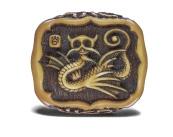
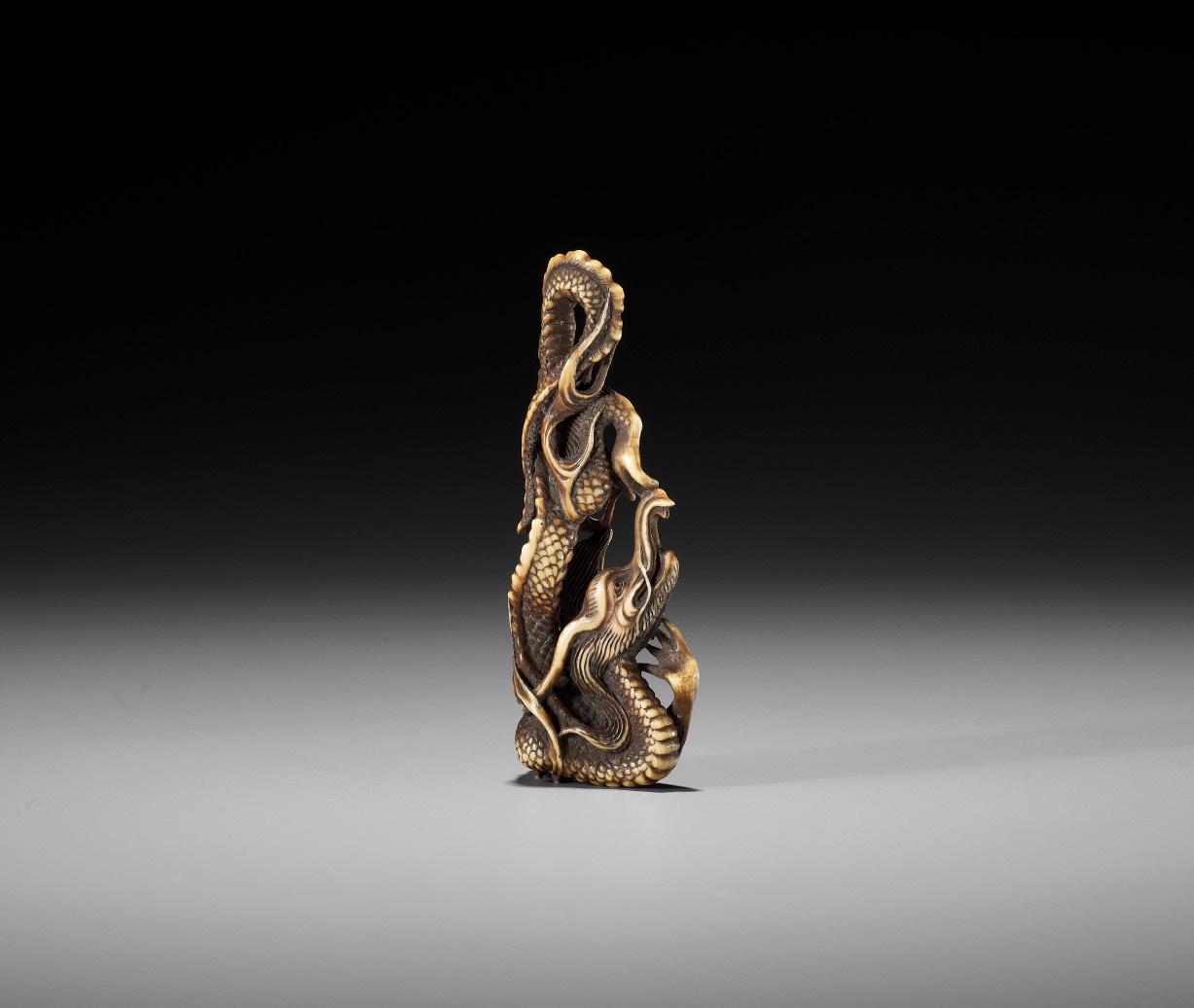
Finely carved in openwork, the netsuke of obidome form, yet also able to stand with the body and signed claw forming the base. The four-clawed, two-horned rain dragon with a sinuously writhing body carved with flickering flames, densely arranged scales, and neatly incised mane, further detailed with almost hand-like claws and a long baku-like snout. Several natural himotoshi due to the openwork. One paw carved with a raised oblong reserve incised with the signature ITTO – the artist was born in Kyoto but studied sculpture in Nagasaki.
HEIGHT 6.3 cm
Condition: Very good condition, microscopic nibbling to edges. Provenance: Ex-collection Étienne de Villaret, Paris. With an old handwritten and illustrated description of the present netsuke by the previous owner.

LITERATURE COMPARISON
Compare a walrus ivory obidome manju depicting a rain dragon, illustrated in Sydney L. Moss Ltd. (2016) Kokusai the Genius: and Stag-antler Carving in Japan, vol. III, p. 380-381, no. 561.
Estimate EUR 3,000
Starting price EUR 1,500
225
196
By Itto, signed Itto 一東 Japan, Nagasaki, late 19th century, Meiji period (1868-1912)
RYOMIN: A RARE AND FINE LACQUER NETSUKE OF JUROJIN
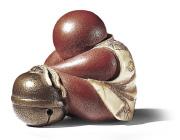

 By Ono Ryomin, signed Ryomin 陵民 Japan, Edo/Tokyo, second half of 19th century
By Ono Ryomin, signed Ryomin 陵民 Japan, Edo/Tokyo, second half of 19th century
The lucky god seated with one hand resting on his lap, the other holding a scroll, his expression marked with joyous laughter, his long silver beard flowing downwards, wearing a finely carved goldlacquered robe embellished with scrolling gold hiramaki-e designs, a silver-lacquered cowl draped over his head. Large, asymmetrical himotoshi through the underside, the signature RYOMIN lacquered in gold within a raised rectangular reserve. Lacquer netsuke by this artist are very rare.
LENGTH 3.8 cm
Condition: Very good condition, minor typical wear to lacquer.
LITERATURE COMPARISON
Another lacquer netsuke by Ono Ryomin, depicting a saru ningyo, is illustrated in Hutt, Julia (2012) Japanese Netsuke, no. 88.
Estimate EUR 2,500
Starting price EUR 1,200
226
197
198
HOKOKU: A SHIBAYAMA-INLAID IVORY NETSUKE DEPICTING DAIKOKU

By Hokoku, signed Hokoku 峯谷 Japan, Tokyo, Meiji period (1868-1912)
The netsuke formed as Daikoku’s treasure bag slung over the lucky god’s back, Daikoku with a cheerful expression and pointing at a small rat which has escaped from the bag along with two coins, the reverse with Daikoku’s hammer with a tasseled cord, all detailed with subtle incision work and finely inlaid in the Shibayama style with mother-of-pearl, lacquer, bone, wood, gilt metal, silver, pewter, and hardstone.
199
A RARE SHIBAYAMA-INLAID WOOD NETSUKE OF A CAPARISONED ELEPHANT

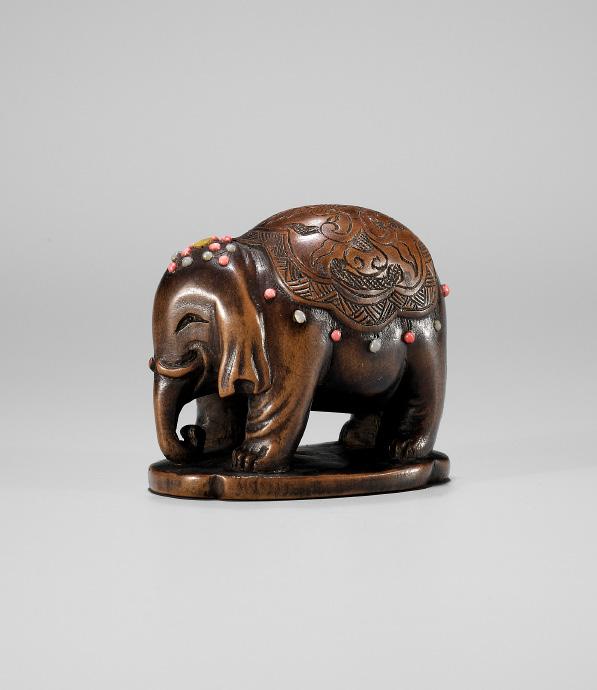

Unsigned Japan, Tokyo, late 19th century
Finely carved with a caparisoned elephant standing foursquare on a quadrilobed oval base, the animal well detailed with narrowed eyes, a long curled trunk, curved tusks, long ears, and subtly carved wrinkles, the saddlecloth incised with a peony design within a crosshatched border, suspending beads inlaid with coral and pale horn, the elephant’s forehead similarly decorated with coral and pale beads surrounding a larger central jewel in mother-of-pearl, the base with a central ojime.
LENGTH 4 cm
Condition: Very good condition, minor wear.
The subject of the present netsuke with Shibayama inlay is considerably rarer in wood than it is in ivory.

LENGTH 4 cm
Condition: Very good condition, minor wear, fine age cracks, few light scratches.
MUSEUM COMPARISON
Compare a closely related inlaid ivory netsuke by Hokoku in the Metropolitan Museum of Art, accession number 10.211.116.
Estimate EUR 1,200
Starting price EUR 600
AUCTION COMPARISON
Compare a related inlaid ivory netsuke, signed Shibayama, 4.2 cm long, dated late 19th century, at Galerie Zacke, Fine Netsuke & Sagemono, 25 September 2020, Vienna, lot 189 (sold for 3,792 EUR).
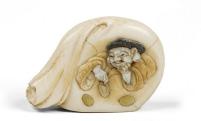
Estimate EUR 1,200
Starting price EUR 600
227
200 A
RARE AND UNUSUAL TRICK WOOD NETSUKE OF A RAKAN AND FOX
Unsigned Japan, probably Edo (Tokyo), 19th century, Edo period (1615-1868)
201 A
LARGE WOOD NETSUKE DEPICTING THE STORY OF SHIBA ONKO
Unsigned Japan, late 18th to early 19th century, Edo period (1615-1868)
A large and remarkably earthy wood netsuke depicting the famous story of Shiba Onko. The composition is set on a large, shaped base and is carved with a large jar in the center from which a stream of water, inlaid with silver dew drops. flows outwards, a small boy emerging from the cracked pot amongst the water. Shiba Onko and his companions are carved around the jar, watching the events unfold, two of the heads are inlaid in stained bone with dark horn tufts of hair and all eyes are inlaid in dark horn as well. Large, asymmetrical himotoshi through the underside. The wood bearing a superb, dark patina.



The rakan (arhat) seated leaning against a large ittobori-carved rock, the interior inset with a minutely carved painted fox priest which springs out and is secured by a mechanism to the side, scaring the rakan, the separately carved Buddhist disciple amusingly unaware of its presence. The combination of techniques used on this netsuke is quite unusual, the face of the rakan carved with exquisite detail reminiscent of the Edo school. Natural himotoshi to the rock.
HEIGHT 3.1 cm (without the fox being extended)
Condition: Very good condition, minor wear.
Estimate EUR 1,500
Starting price EUR 800
HEIGHT 3.6 cm, LENGTH 5.4 cm
Condition: Excellent condition with minor wear and a superb patina.
The manner of inlay on the present netsuke is reminiscent of Kanjuro, who is mentioned in the Soken Kisho of 1781.

Estimate EUR 1,500
Starting price EUR 800
228
202
HIDEYUKI: A RARE IVORY AND LACQUER NETSUKE OF BATHING SKELETONS
By Hideyuki, signed Hideyuki 秀之 Japan, Tokyo, Meiji period (1868-1912)
A rare ivory netsuke depicting a skeleton sitting in a contemplative pose inside a small silver-lacquered tub, a washing rag in its hand, another skeleton seated behind and washing his companion’s back. The underside carved with a lotus leaf, two asymmetrical himotoshi, the smaller one florally rimmed, and the signature HIDEYUKI within an aogai inlaid plaque. The artist favored skulls and skeletons as a subject and usually signed within an inlaid aogai plaque. The present composition is quite unusual and possibly unique for the artist.


LENGTH 3.8 cm
Condition: Excellent condition, minor wear.
Estimate EUR 2,500
Starting price EUR 1,200
229
TOMOKAZU: A DARK WOOD NETSUKE OF A CORAL FISHERMAN
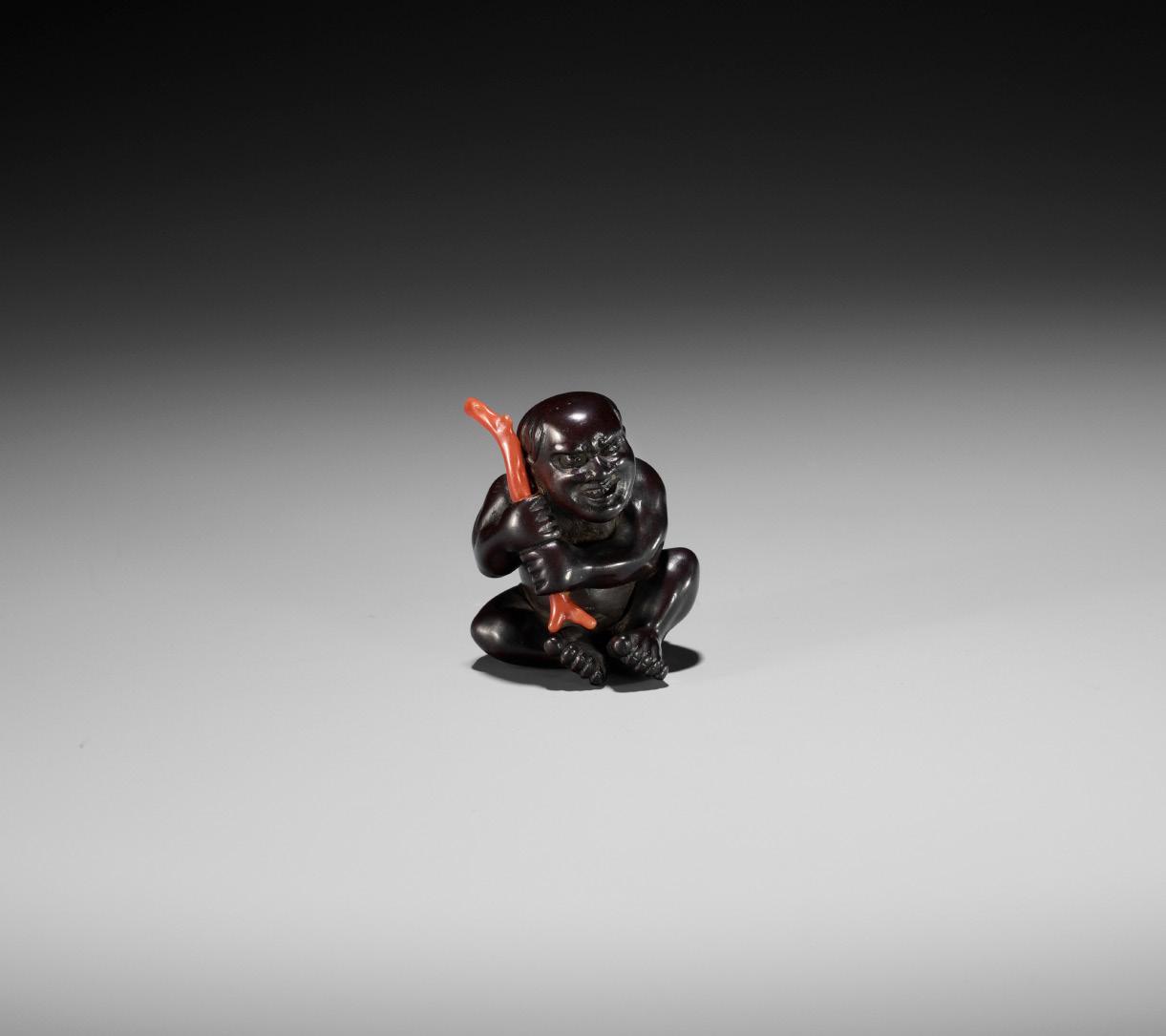

Signed Tomokazu 友一
Japan, Edo (Tokyo), mid-19th century, Edo period (1615-1868)
The seated coral fisherman holding a bright-red coral branch in his hands, wearing only a finely carved straw skirt, his expression fiercely protective, the eyes inlaid with dark horn. Good himotoshi to the side and through the straw skirt and signed on the right leg TOMOKAZU – not to be confused with Kano Tomokazu, but rather an artist working in Edo during the mid-19th century.
HEIGHT 3.7 cm
Condition: Very good condition, minor wear, a few small age cracks.
Provenance: Jacques Ganzl collection, sold at Piasa, Paris, 1999. Sold at Bonhams, Netsuke from a European Collection, 8 May 2016, London, lot 141. A noted private collection, USA, acquired from the above.
Estimate EUR 3,000
Starting price EUR 1,500
230 203
204
SHOUNSAI: AN EXCELLENT AND RARE WOOD AND IVORY NETSUKE OF DARUMA
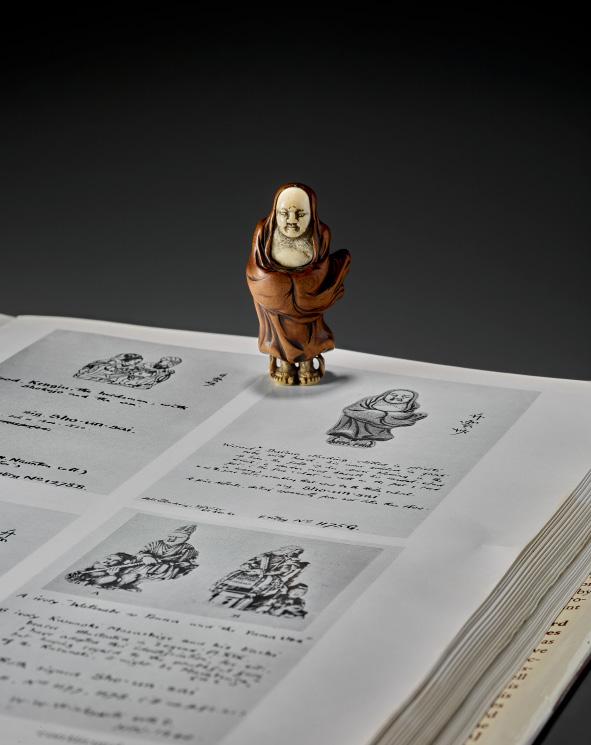
 By Shounsai Joryu, signed Shounsai 升雲齋 Japan, Edo (Tokyo), early 19th century, Edo period (1868-1912)
By Shounsai Joryu, signed Shounsai 升雲齋 Japan, Edo (Tokyo), early 19th century, Edo period (1868-1912)
Published: Illustrated in F. Meinertzhagen, MCI Part A, New York, 1986, page 263.
Depicting the Zen patriarch Daruma with a pensive expression. Daruma is almost entirely covered in a priestly robe flowing in the wind, carved from wood with a stunning patina and grain. His face and bare torso are inlaid in ivory, with incised beard and chest hair, and his facial features are crafted very well. Daruma was of either Persian, central Asian or south Indian descent, which is reflected in this netsuke – making it a rare portrait of this important and historical Buddhist monk, who is often caricaturized in netsuke art. His sandaled feet and the thin reed which he floats on are also carved from a single piece of ivory. The backside with good himotoshi above the signature SHOUNSAI.
HEIGHT 6.3 cm
Condition: Very good condition.
Provenance: Anonymous sale, Glendining, 31st May 1935, then Jay Hopkins and hence British collection.
Estimate EUR 3,000
Starting price EUR 1,500
JUJO: A FINE WOOD NETSUKE OF HARE IN BOAT, KACHI-KACHI YAMA

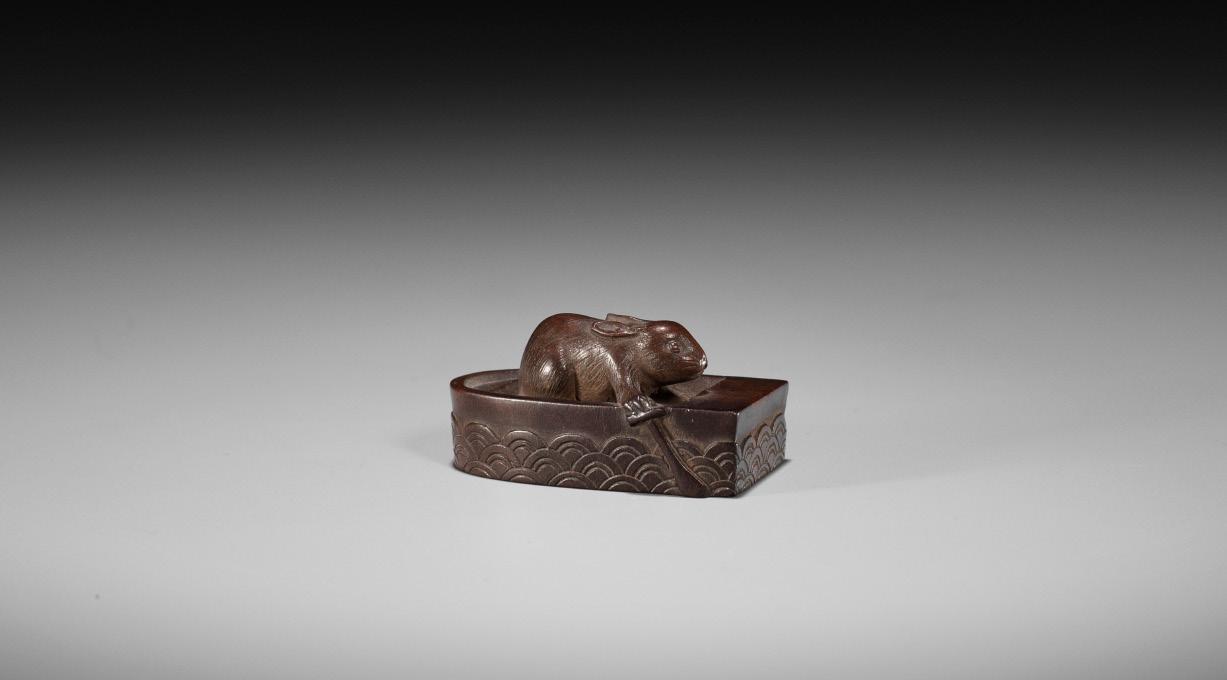
 By Jujo (Toshinori), signed Jujo 壽乗 and kakihan Japan, Tokyo, late 19th century
By Jujo (Toshinori), signed Jujo 壽乗 and kakihan Japan, Tokyo, late 19th century
Published: Meinertzhagen, Frederick / Lazarnick, George (1986) MCI, Part A, p. 280.
Depicting a hare nestled inside a boat, one paw grabbing an oar and propelling itself along the waves which are carved to the side of the boat. The details are superbly carved and finished, the wood bearing a good polish. Large himotoshi to the underside and signed JUJO and kakihan. The artist was a pupil of Ryukosai Jugyoku.
LENGTH 3.6 cm
Condition: Excellent condition.
The netsuke references a scene from the Kachi-kachi Yama folktale when a tanuki challenged a rabbit to a life and death contest to prove who was the better creature. They were each to build a boat and race across a lake. The rabbit carved its boat out of a fallen tree trunk, but the foolish tanuki made a boat of mud. At first, the two competitors were evenly matched, but the badger’s mud boat began to dissolve in the middle of the lake and instead of saving the badger, the rabbit strikes him with an oar, and proclaimed his friendship with the innocent human couple whom the wicked tanuki had earlier inflicted upon its horrible deeds - thus revealing his revenge.
MUSEUM COMPARISON
Compare to a closely related wood netsuke depicting the same subject, by Jugyoku, in the Museum of Fine Arts Boston, accession no. 11.23273.

Estimate EUR 3,000
Starting price EUR 1,500
The climactic scene of Kachi-kachi Yama, in which the rabbit strikes the alreadysinking tanuki with an oar and reveals his vendetta. Detail from a Japanese painting circa 1890s-1900s

232 205
JUGYOKU: A FINE INLAID WOOD NETSUKE OF BENKEI INSIDE HORAGAI

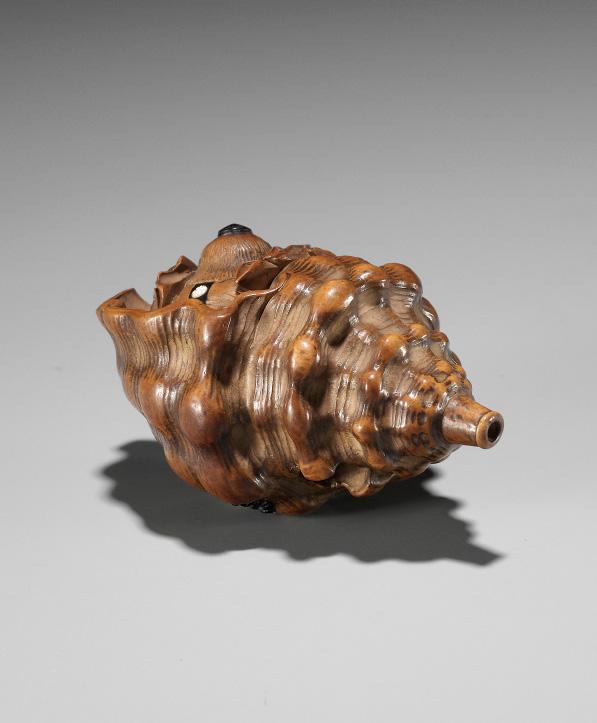 By Ryukosai Jugyoku, signed Jugyoku 壽玉 Japan, Edo (Tokyo), first half of 19th century, Edo period (1615-1868)
By Ryukosai Jugyoku, signed Jugyoku 壽玉 Japan, Edo (Tokyo), first half of 19th century, Edo period (1615-1868)
The hero Benkei nestled within a large horagai conch, wearing traditional yamabushi garments and a tokin cap, embellished with inlays of bone and ebony, holding prayer beads, one of the beads inlaid in coral. The expression with minutely inlaid eyes is expertly crafted and the surface of the conch is naturalistically rendered with ridged and polished areas. Large himotoshi, the smaller hole rimmed with ebony wood in the form of floral medallion and signed within an inlaid ebony plaque JUGYOKU – the artist was a master of combining various materials.
LENGTH 5.7 cm
Condition: Very good condition with minor expected surface wear and traces of use, some light surface scratches and age cracks.
The yamabushi were renegade mountain priests of the Shingon Tantric Buddhist sect, who used the conch to communicate their movements in the mountain wilderness.
Estimate EUR 4,000
Starting price EUR 2,000
233
206
207
JUGYOKU: A FINE WOOD NETSUKE OF A CICADA
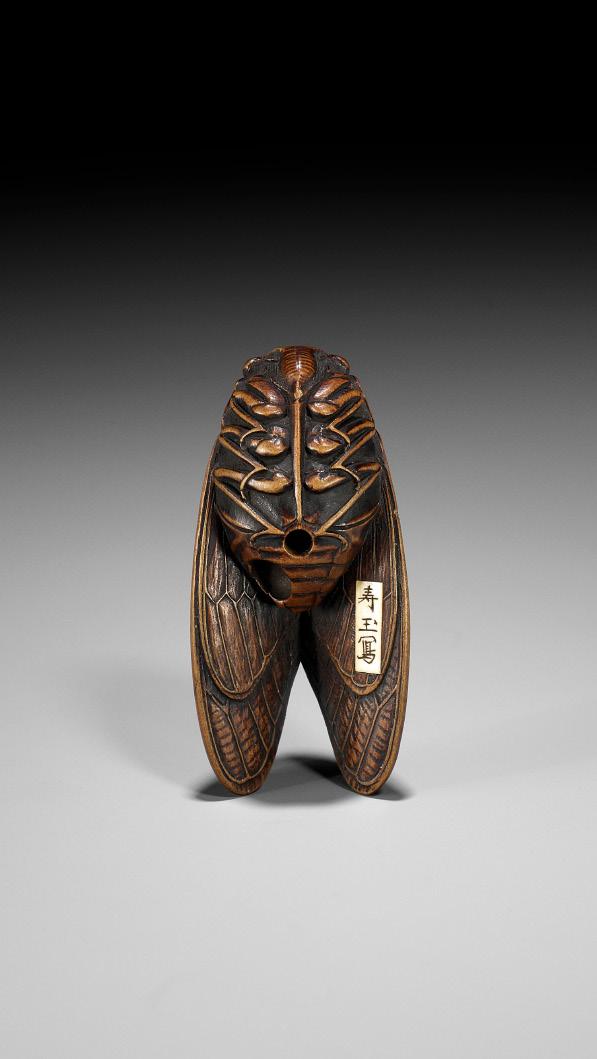
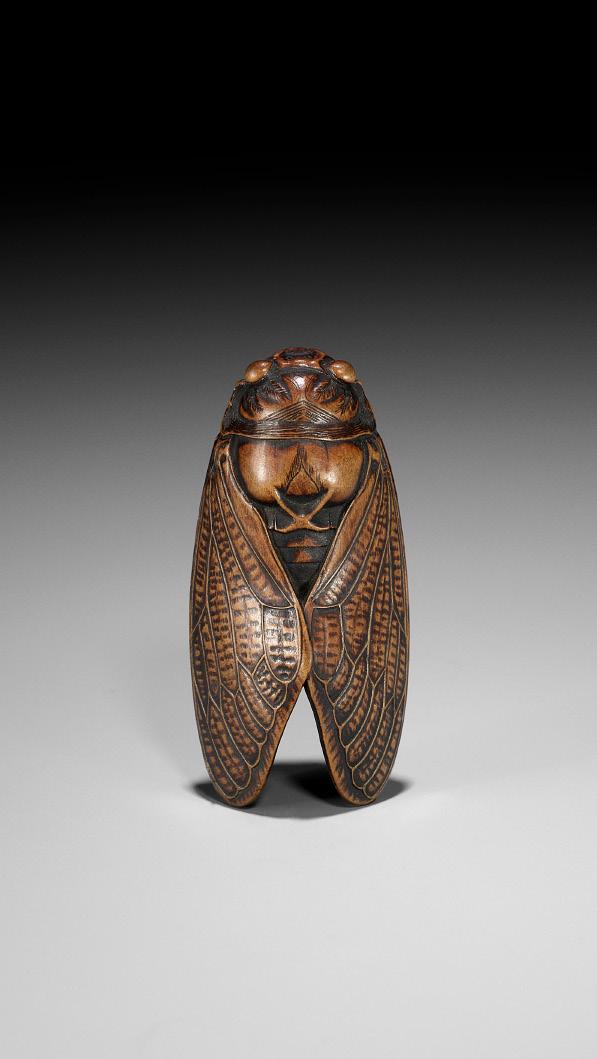
 By Ryukosai Jugyoku, signed Jugyoku 壽玉 with kakihan Japan, Edo (Tokyo), mid-19th century, Edo period (1615-1868)
By Ryukosai Jugyoku, signed Jugyoku 壽玉 with kakihan Japan, Edo (Tokyo), mid-19th century, Edo period (1615-1868)
Finely and naturalistically carved as a cicada, its wings with neatly detailed veins, the underside with further realistic details such as the limbs which are kept close to the body for compactness. Large himotoshi underneath, the larger hole generously excavated to accommodate the knot and signed under the left wing within a neatly inlaid plaque JUGYOKU and kakihan.
LENGTH 5.5 cm
Condition: Excellent condition, minor wear.
Provenance: A noted private collection, USA.
LITERATURE COMPARISON
For an ivory netsuke of a cicada on a leaf, by Jugyoku, see Harris, Victor (1987) The Hull Grundy Collection in the British Museum, p. 93, no. 457.
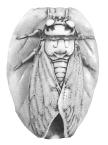
Estimate EUR 3,000
Starting price EUR 1,500
234
208
A RARE TOKYO SCHOOL COROZO NUT AND STAG ANTLER NETSUKE OF A FROG INSIDE A CHRYSANTHEMUM



Unsigned
Japan, Edo (Tokyo), mid to late 19th century, Edo period (1615-1868)
Deeply stained to resemble wood, the chrysanthemum finely carved with neatly incised individual petals, the hollowed section in the center inlaid with a green-stained frog carved from stag antler. The underside shows the curved stem which forms the cord attachment.

The carving can be attributed to circle of hands around Jugyoku, Ryukei, Gyokko, and Gyokkei who excelled in carving netsuke from exotic materials and often used green-stained antler to embellish their carvings.

LENGTH 4.1 cm
Condition: Excellent condition with natural flaws to the material.
Provenance: A noted private collection, USA.
AUCTION COMPARISON
Compare to a wood netsuke with similar greenstained inlay, by Jugyoku, at Bonhams, Fine Netsuke from a French Private Collection, 4 November 2020, London, lot 149 (sold for 4,812 GBP). Also compare to a corozo nut netsuke by Gyokkei, with a green-stained antler signature plaque, erroneously described as wood, at Gros-Delettrez, Art D’ Asie, 7 December 2021, Paris, lot 20 (sold for 3,000 EUR).
Estimate EUR 1,500
Starting price EUR 800
235
AN EXQUISITELY SMALL WOOD NETSUKE OF A FOX DANCER, ATTRIBUTED TO JUGYOKU
Attributed to Ryukosai Jugyoku, unsigned Japan, Edo (Tokyo), mid to late 19th century
Superbly carved as a young boy performing the kitsune odori (fox dance) wearing tightly fitted cloths with a cowl over his head, wearing a fox’s mask and tail. The dancer stands on one leg (the netsuke actually is perfectly balanced and stands on that leg), the other leg lifted dynamically, and the two hands are raised in a dancing posture. Two himotoshi to the back. Unsigned, however attributed to Ryukosai Jugyoku who treated this subject and used the same type of reddish wood.

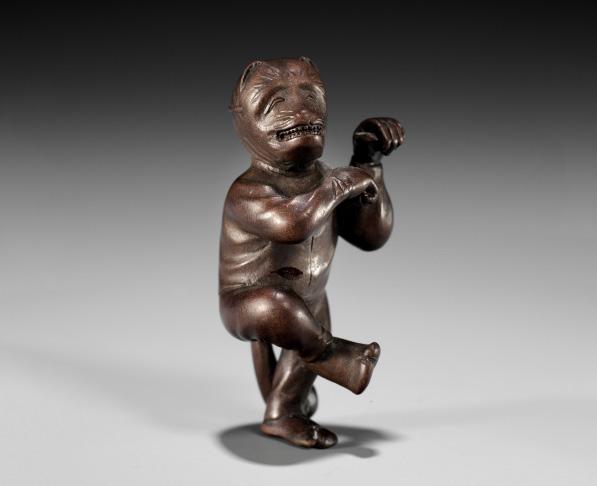
HEIGHT 4.1 cm
In some areas of Japan, the kitsune odori was performed during O-bon (a traditional festival honoring the dead), the boys wearing white close-fitting costumes including a fox’s mask and tail. The small size of this netsuke may indicate it was made for a young boy, the subject matter here making it a suitable gift.
Condition: Excellent condition.
Provenance: Ex-collection Irene Segeler, Zurich. Irene Segeler specialized in collecting tiny children’s netsuke, acquiring over 80 examples, which is quite remarkable as they are exceptionally rare. A few pieces from her collection are illustrated in Children’s Netsuke (2001), The International Netsuke Society Journal (INSJ), vol. 21, no. 2, pp. 26-30.
LITERATURE COMPARISON
Compare to a closely related wood netsuke of a fox dancer, by Jugyoku, illustrated in Coullery, MarieTherese and Newstead, Martin S. (1977) The Baur Collection, pp. 247-247, no. C 699.

Estimate EUR 3,000
Starting price EUR 1,500
236
209
GYOKUZAN: A MASTERFUL MINIATURE WOOD NETSUKE OF A BLINDMAN BEING TRAPPED BY A CLAM

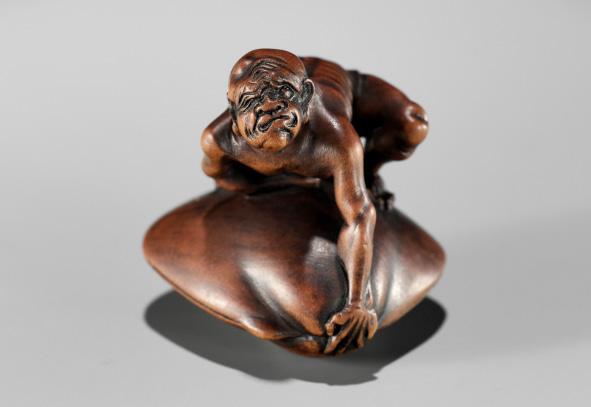 By Gyokuzan, signed Gyokuzan 玉山 Japan, Edo (Tokyo), mid-19th century, Edo period (1615-1868)
By Gyokuzan, signed Gyokuzan 玉山 Japan, Edo (Tokyo), mid-19th century, Edo period (1615-1868)
Published: Eskenazi (1997) Japanese Netsuke, Ojime and Inro from the Dawson Collection, pp. 30-31, no. 41.

Exquisitely carved, the blindman with a distinct bump on his head, one eye closed and one eye opened, the tiny pupil minutely inlaid in dark horn, clambering over a giant clam and struggling with all his might to pull his fundoshi from the jaws of the bivalve. The subject references, quite humorously, a parody of the seduction of feminine wiles, the clam representing the female here. The expression of the man is masterfully crafted with incredible detail, which holds up even to extreme magnification. The well-toned wood bearing a good patina. The underside with florally rimmed himotoshi and signature GYOKUZAN and kakihan.
HEIGHT 2.9 cm, LENGTH 2.7 cm
Condition: Excellent condition.
Provenance: Ex-collection Irene Segeler, Zurich, acquired from Eskenazi Ltd., London, in 1997. Irene Segeler specialized in collecting tiny children’s netsuke, acquiring over 80 examples, which is quite remarkable as they are exceptionally rare. A few pieces from her collection are illustrated in Children’s Netsuke (2001), The International Netsuke Society Journal (INSJ), vol. 21, no. 2, pp. 26-30.
Estimate EUR 4,000
Starting price EUR 2,000
237 210
211
A RARE AND VERY FINE MINIATURE WOOD OKIMONO NETSUKE OF TWO ONI AND A SKELETON (GAIKOTSU)
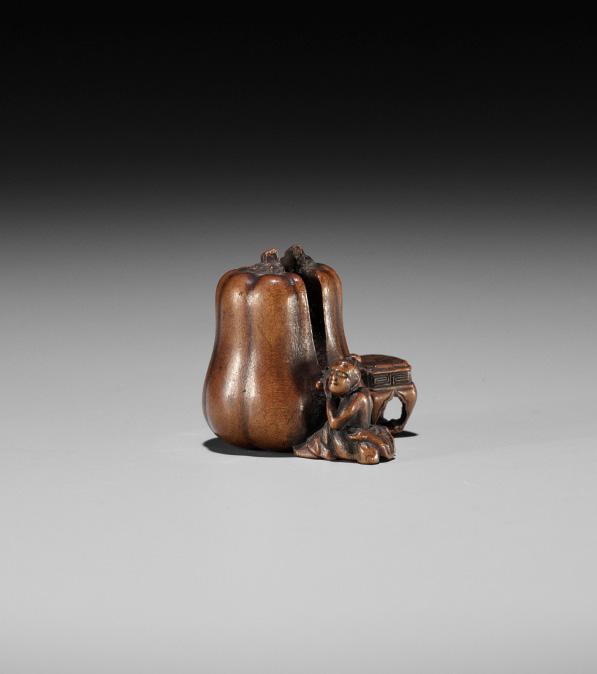

Unsigned Japan, late 19th century, Meiji period (1868-1912)
Depicting an oni wrestling a skeleton (gaikotsu) while another oni, leaning against an iron club, plays the referee. The details are minutely carved with extraordinary detail. Singular bone-ringed himotoshi through the square base.

HEIGHT 2.7 cm
Condition: Excellent condition.
Provenance: Ex-collection Irene Segeler, Zurich. Irene Segeler specialized in collecting tiny children’s netsuke, acquiring over 80 examples, which is quite remarkable as they are exceptionally rare. A few pieces from her collection are illustrated in Children’s Netsuke (2001), The International Netsuke Society Journal (INSJ), vol. 21, no. 2, pp. 26-30.
Estimate EUR 1,500
Starting price EUR 800
212 NAOYUKI: AN EXQUISITE MINIATURE WOOD NETSUKE OF A NIO CUTTING THROUGH A GIGANTIC GOURD
By Naoyuki, signed Naoyuki 直雪 and kakihan Japan, Edo (Tokyo), mid-19th century, Edo period (1615-1868)
A minutely carved Nio, measuring only 0.7 cm, with remarkably well-carved features is shown testing his strength by cutting through a gigantic gourd with a saw. The well-toned wood of an attractive color, a small Chinese table carved next to the gourd. One himotoshi through the underside, the other going through under the table. Signed NAOYUKI with kakihan.
HEIGHT 2.4 cm
Condition: Excellent condition, minor wear.
Estimate EUR 1,500
Starting price EUR 800
238
A truly miniature-sized carving, likely intended as a gift for a child, the protective deity seated on a shishi and holding a scroll. The boddhisattva is dressed in a voluminous robe with billowing scarves, the details such as her urna and the shishi’s eyes and fangs are inlaid in dark horn or wood. The underside shows two ringed himotoshi and the signature within a square silver tablet TOSAI –this rare artist is associated with Suzuki Tokoku (1846-1913) who carved similar fine works with inlays.

HEIGHT 2.6 cm, LENGTH 2.3 cm
Condition: Excellent condition with minor natural imperfections to the material, as are to be expected.
Provenance: Ex-collection Irene Segeler, Zurich, purchased at Kunsthandel Klefisch, 26 November 1994, Cologne, lot 135. Irene Segeler specialized in collecting tiny children’s netsuke, acquiring over 80 examples, which is quite remarkable as they are exceptionally rare. A few pieces from her collection are illustrated in Children’s Netsuke (2001), The International Netsuke Society Journal (INSJ), vol. 21, no. 2, pp. 26-30.
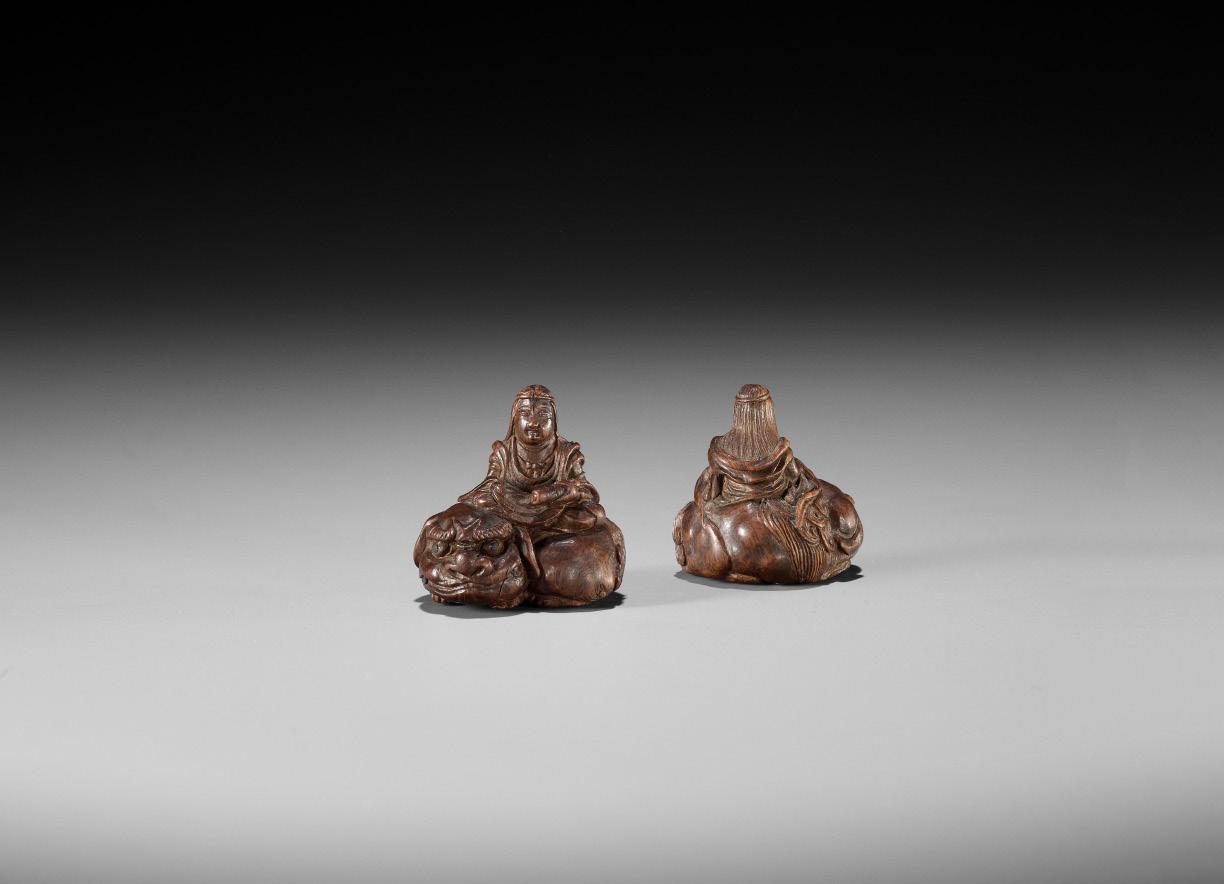
LITERATURE COMPARISON
Compare a related wood netsuke, by Jujo (school of Jugyoku), in Meinertzhagen, Frederick / Lazarnick, George (1986) MCI, Part A, p. 279.
Estimate EUR 3,000
Starting price EUR 1,500

239
213 TOSAI: AN EXQUISITE MINIATURE BAMBOO NETSUKE OF MONJU BOSATSU
By Tosai, signed Tosai 東采 Japan, Tokyo, late 19th century
214 KOKOKU: A VERY FINE INLAID WOOD NETSUKE OF JUROJIN


WITH STAG
By Kokoku, signed Kokoku 光谷 with seal Kokoku 光谷 Japan, Tokyo, Meiji period (1868-1912)
Carved from two different woods and inlaid with various materials including horn, bone and stag antler, depicting the lucky god Jurojin seated in a relaxed pose, holding a scroll and leaning on his stag familiar. Two himotoshi underneath and signed KOKOKU with inlaid gold seal Kokoku.
LENGTH 4.6 cm
Condition: Excellent condition.
MUSEUM COMPARISON
Compare to a closely related netsuke depicting the same subject, also signed Kokoku with gold seal Kokoku, in the Metropolitan Museum of Art (Met), New York, accession no. 10.211.744.

Estimate EUR 4,000
Starting price EUR 2,000
240
215
TOKOKU: A MASTERFUL MIXED MATERIAL NETSUKE OF A BUTTERFLY

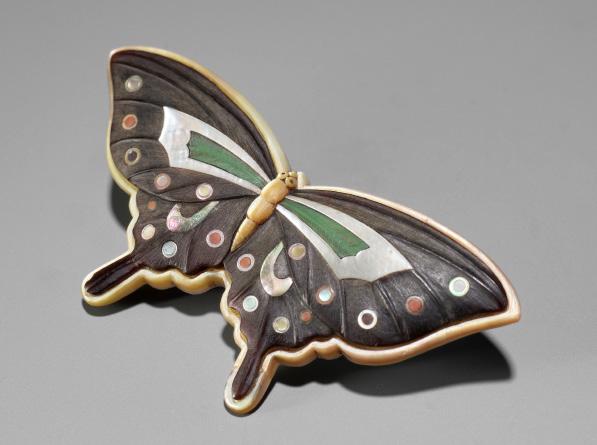
 By Suzuki Tokoku (1846-1913), signed Tokoku 東谷 with seal Bairyu
By Suzuki Tokoku (1846-1913), signed Tokoku 東谷 with seal Bairyu
Japan, Tokyo, Meiji period (1868-1912)
Published: Mcniff, Ed (2004) Auctions, International Netsuke Society Journal (INSJ), vol. 24, no. 4, p. 694.
Of manju type, masterfully worked in various precious materials including mother-of-pearl, ebony and horn, depicting a butterfly with outstretched wings. The choice section of ebony which is inlaid to the mother-of-pearl frame is cleverly utilized and worked to resemble the heterogenous surface of the membrane of the butterfly’s wings. The various patterns are minutely inlaid in the form of shaped roundels to the back and front. The craftsmanship and precision are truly remarkable and hold up to extreme magnification. The backside with two ringed himotoshi and the incised signature TOKOKU and inlaid gold seal Bairyu.
LENGTH 6.3 cm, HEIGHT 3 cm
Condition: Very good condition, minor wear to one inlay.
Provenance: Sold at Eldred’s, 23 August 2004, Massachusetts, lot 694 (sold for hammer price 8,500 USD).
In the auction report mentioned above Ed Mcniff remarks the following: “..upon close inspection, the workmanship and technical carving skill apparent in this piece are as impressive as any I’ve ever seen. Perhaps this is an example of an artist who was willing to adjust his artistic sensibilities to suit the demands of the times, but also of a superb craftsman unwilling to compromise his craft.”
Estimate EUR 6,000
Starting price EUR 3,000
241
楳立
OUCHI
GYOKUSO: A VERY FINE SO SCHOOL WOOD NETSUKE OF A TEMPLE SERVANT WITH MOKUGYO


 By Ouchi Gyokuso
By Ouchi Gyokuso
Very finely carved as a man chanting and wearing a mokugyo strapped around his neck and beating it with a striker, the free hand resting against the side of his face, the double-dragon headed mokugyo with a loose ball inside. His patterned robe is well-carved, the hem lifted and tucked into the obi, the signature GYOKUSO incised to the interior of the hem, flanked by two himotoshi, an inro with en suite manju netsuke hanging from the obi. The lightly stained wood is superbly finished as is typical for this school.
HEIGHT 5.7 cm
Condition: Excellent condition.
Provenance: Collection Prof. Dr. Henk C. Hoogsteden, Rotterdam, purchased at Lempertz, The Kolodotschko Collection of Netsuke II, 6 December 2014, Cologne, lot 942.
Ouchi Gyokuso (1879-1944) was the father of Ouchi Sosui (1911-1966) and together with Morita Soko (1879-1942) the most important pupil of Miyazaki Joso (1835-1910), the founder of the important So school in Tokyo.
AUCTION COMPARISON
Compare to a closely related wood netsuke by Morita Soko, depicting the same subject, at Kunsthandel Klefisch, Asiatische Kunst, 16 July 2005, lot 675 (illustrated on pl. XV).
Estimate EUR 3,000
Starting price EUR 1,500
242
216
(1879-1944), signed Gyokuso 玉藻 Japan, Tokyo, early 20th century
SOZAN: A VERY FINE SO SCHOOL WOOD NETSUKE OF A PUPPETEER



 By Sozan, signed Sozan 宗山 Japan, Tokyo, late 19th to early 20th century
By Sozan, signed Sozan 宗山 Japan, Tokyo, late 19th to early 20th century
Superbly carved as a puppeteer holding a large box with movable drawer to the side, placing a puppet female puppet holding a fan on top of the box, his robe incised with minutely carved patterns. The wood is masterfully finished and polished, and further embellished with various colored inlays. Large himotoshi to the back, the cord channel running through an opening of the man’s jacket. Signed underneath the box within a red-lacquered reserve SOZAN.

HEIGHT 5.2 cm
Condition: Excellent condition.
LITERATURE COMPARISON
Compare to a closely related wood netsuke by Tokoku, depicting the same subject, illustrated in Lazarnick, George (1981) Netsuke & Inro Artists, and How to Read Their Signatures (LNIA), Vol. 2, p. 1103. Also compare to a related wood netsuke by Gyokuso illustrated in Bandini, Rosemary (2001) Expressions of Style, Netsuke as Art, Scholten Japanese Art, New York, no. 30.
Estimate EUR 6,000
Starting price EUR 3,000
243
217
OUCHI GYOKUSO: A MASTERFUL STAINED AND LACQUERED WOOD NETSUKE OF A GROUP OF CUCUMBERS

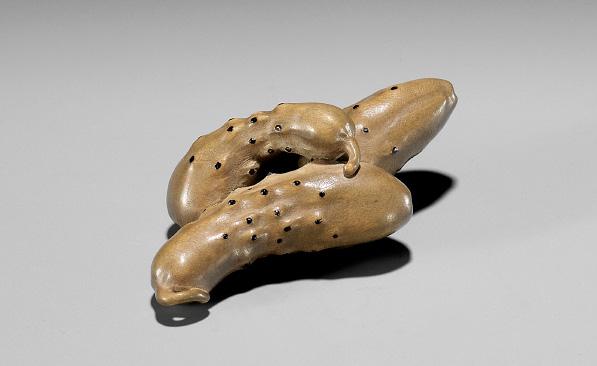 By Ouchi Gyokuso (1879-1944), signed Gyokuso玉藻 to 刀 Japan, Tokyo, early 20th century
By Ouchi Gyokuso (1879-1944), signed Gyokuso玉藻 to 刀 Japan, Tokyo, early 20th century
Published: Bushell, Raymond (1971) Collector’s Netsuke, p. 155, no. 261. Kobijutsu Rokusho vol. 27 (1991), 62. Sagemonoya (1998) So School Netsuke, no. 91.
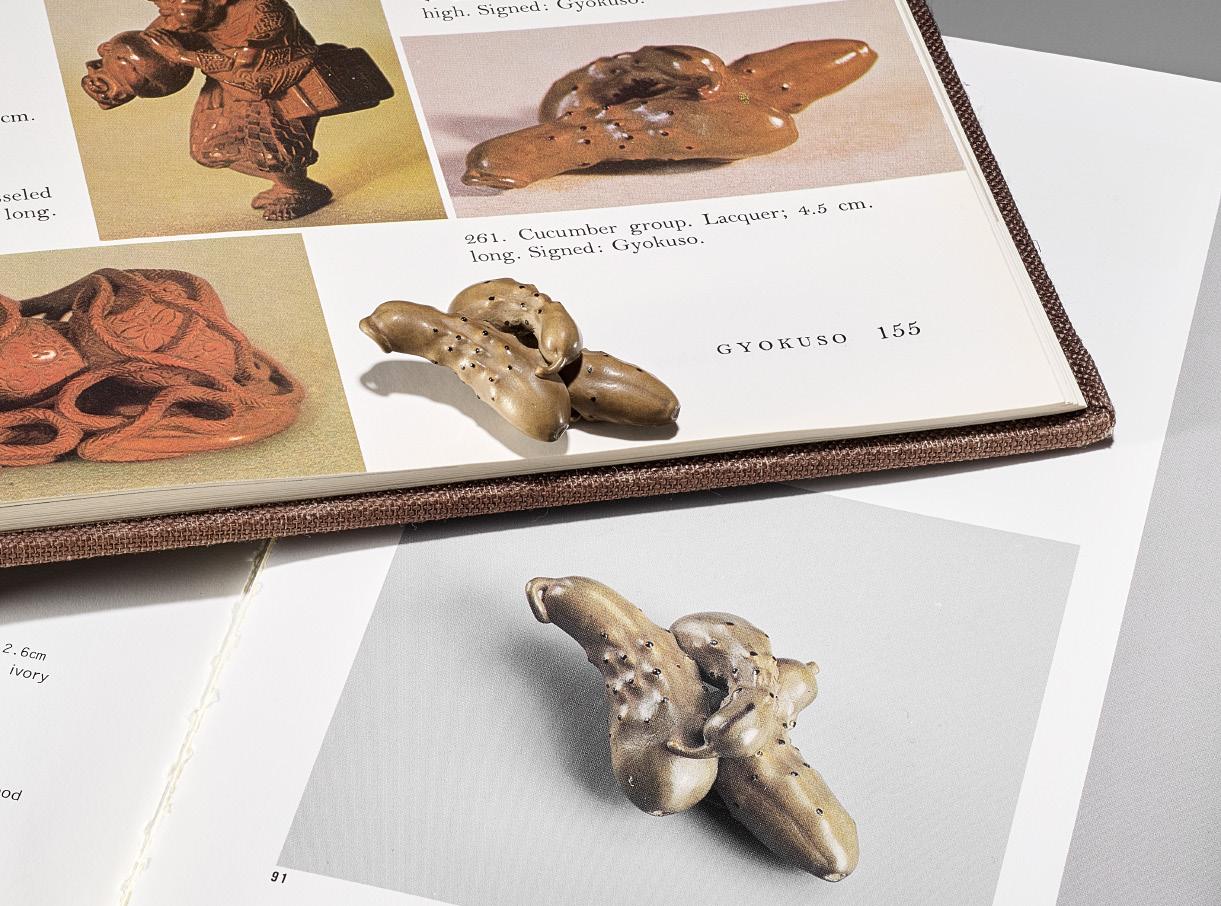
Naturalistically carved, stained green with black lacquered pimples, as three pickled cucumbers overlapping one another, above an edamame bean pod which forms the cord attachment and houses the signature GYOKUSO to [carved by Gyokuso]. The carving is superbly finished and polished in all the right areas, as is typical for the artist – a true miniature masterpiece.
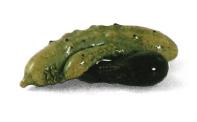
LENGTH 4.5 cm
Condition: Excellent condition.
Provenance: Ex-collection Raymond and Frances Bushell. Excollection Bluette H. Kirchhoff, sold at Bonhams, The Bluette H. Kirchhoff Collection of Netsuke and Sagemono, 16 September 2009, New York, lot 2048 (sold for 9,150 USD).
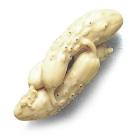
Ouchi Gyokuso (1879-1944) was the father of Ouchi Sosui (1911-1966) and together with Morita Soko (1879-1942) the most important pupil of Miyazaki Joso (1835-1910), the founder of the important So school in Tokyo.
LITERATURE COMPARISON
There appears to be only two other netsuke recorded depicting cucumbers by the So school. Compare to a closely related ivory netsuke depicting cucumbers, by Morita Soko, illustrated in Sagemonoya (1998) So School Netsuke, no. 90. Also compare to a closely related lacquered wood netsuke depicting cucumbers and an eggplant, by Morita Soko, illustrated in Bushell, Raymond Netsuke (1975) Familiar & Unfamiliar, p. 169, no. 439.
Estimate EUR 8,000
Starting price EUR 4,000
244
218
219
MORITA SOKO: A SUPERB SMALL WOOD NETSUKE OF A RAT ON A STRAW RICE BALE
 By
By
Morita Soko (1879-1942), signed Soko 藻己 to 刀 Japan, Tokyo, early 20th century
Published:
Kobijutsu Rokusho vol. 27 (1991), 28. Sagemonoya (1998) So School Netsuke, no. 28.
Exquisitely carved as a small rat (nezumI) sitting on a bundle of rice stalks naturalistically carved within a shallow basket, the weaving intricately emulated, its long finely carved tail extending towards the underside and gnawing at a minutely carved branch of persimmon fruit. Signed to the underside within a polished area SOKO to [carved by Soko].

LENGTH 3 cm
Condition: Tiny chip to one ear, otherwise excellent condition. Provenance: The Bluette H. Kirchhoff Collection of Netsuke and Sagemono, sold at Bonhams, 16 September 2009, New York, lot 2067 (sold for 11,590 USD). A princely collection, acquired from the above.
The rat (nezumI) seated on rice stalks is an allusion to the lucky god of wealth Daikoku.
LITERATURE COMPARISON
Fuld’s Netsuke and Ojime Index records two further netsuke of rats on a straw basket, each depicted in a different manner. One is recorded in Traditional Objects, INCS Journal, Vol. 4, no. 3, p. 16, figs. 2A & 2B. Another is recorded in Coullery, Marie-Therese and Newstead, Martin S. (1977) The Baur Collection, pp. 360-361, no. C1145.



Estimate EUR 8,000
Starting price EUR 4,000
245
A POWERFUL TALL STAG ANTLER NETSUKE OF CHINNAN SENNIN, ATTRIBUTED TO TOMOHISA


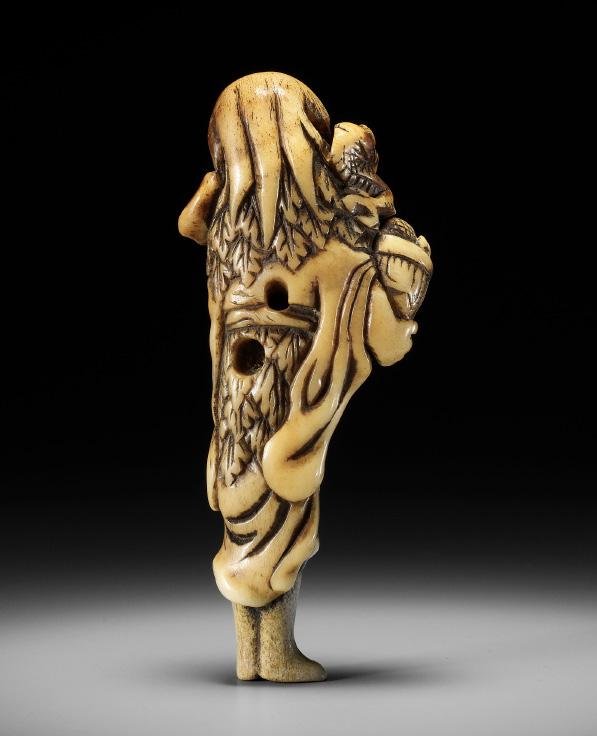
Attributed to Tomohisa, unsigned Japan, Kyoto, mid-18th century, Edo period (1615-1868)
Powerfully carved, the sennin standing tall and holding an alms bowl in one hand, from which a small sinuous dragon emerges, and a gnarled staff in the other, wearing a long robe with deeply carved folds as well as an artemisia leaf skirt and apron with neatly incised veins. His face with a grim expression, the mouth slightly open, the eyes with pierced pupils, the hair and long chin beard carved in thick strands. The back with asymmetrical himotoshi. Beautiful, deep caramel-brown patina.
HEIGHT 10.2 cm
Condition: Good condition, minor wear, natural imperfections, the feet restored.
The present lot is attributed to Tomohisa, who belongs to an important group of 18th-century figure carvers, which also includes Mototada. About this group, Jay Hopkins writes, “Working in staghorn, they primarily produced large figures ranging from 3 to 6 inches in height. Subject matter usually involved Chinese legends, including Shoki, sennin, Kann’u, guardians and entertainers. They effectively used black horn to inlay eye pupils, buttons and other details – perhaps the earliest cavers to use this technique.” See Sydney L. Moss Ltd. (2016) Kokusai The Genius: and Stag-antler Carving in Japan, vol. I, p. 30.
LITERATURE COMPARISON
Compare a closely related stag antler netsuke of Chinnan Sennin with a dragon by Tomohisa, illustrated in Barry Davies Oriental Art (2001) Selected Netsuke and Inro for exhibition at the International Netsuke Society Convention Boston, p. 3. Compare a related stag antler netsuke of Handaka Sonja with a dragon by Tomohisa, illustrated in Sydney L. Moss Ltd. (2016) Kokusai The Genius: and Stag-antler Carving in Japan, vol. I, p. 200-201, no. 55.
Estimate EUR 2,500
Starting price EUR 1,200
246 220
221
Attributed to Mototada, unsigned Japan, Kyoto, mid-18th century, Edo period (1615-1868)
Powerfully carved, the three-clawed two-horned dragon writhing around a large tama pearl which is smoothly polished, creating an appealing contrast to the dragon’s scaly body, the beast with a ferocious expression, its eyes inlaid with dark horn. The skillfully executed incision work is darkly stained for effect. The tama with the rather well-hidden himotoshi. The base of the tama and areas of the dragon’s body with a rich, pale-brown patina.
HEIGHT 5.3 cm
Condition: Very good condition, minor wear, natural imperfections. Provenance: Ex-collection Michael Tomkinson (by repute).
The present lot is attributed to Mototada, who belongs to an important group of 18th-century figure carvers, which also includes Tomohisa. About this group, Jay Hopkins writes, “Working in staghorn, they primarily produced large figures ranging from 3 to 6 inches in height. Subject matter usually involved Chinese legends, including Shoki, sennin, Kann’u, guardians and entertainers. They effectively used black horn to inlay eye pupils, buttons and other details – perhaps the earliest cavers to use this technique.” See Sydney L. Moss Ltd. (2016) Kokusai The Genius: and Stag-antler Carving in Japan, vol. I, p. 30.
LITERATURE COMPARISON
Compare a related stag antler netsuke of Chinnan Sennin and a dragon by Mototada, illustrated in Chappell, Sharon / Welch, Matthew (1999) Netsuke: The Japanese Art of Miniature Carving, p. 24, no. 9.
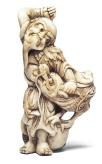
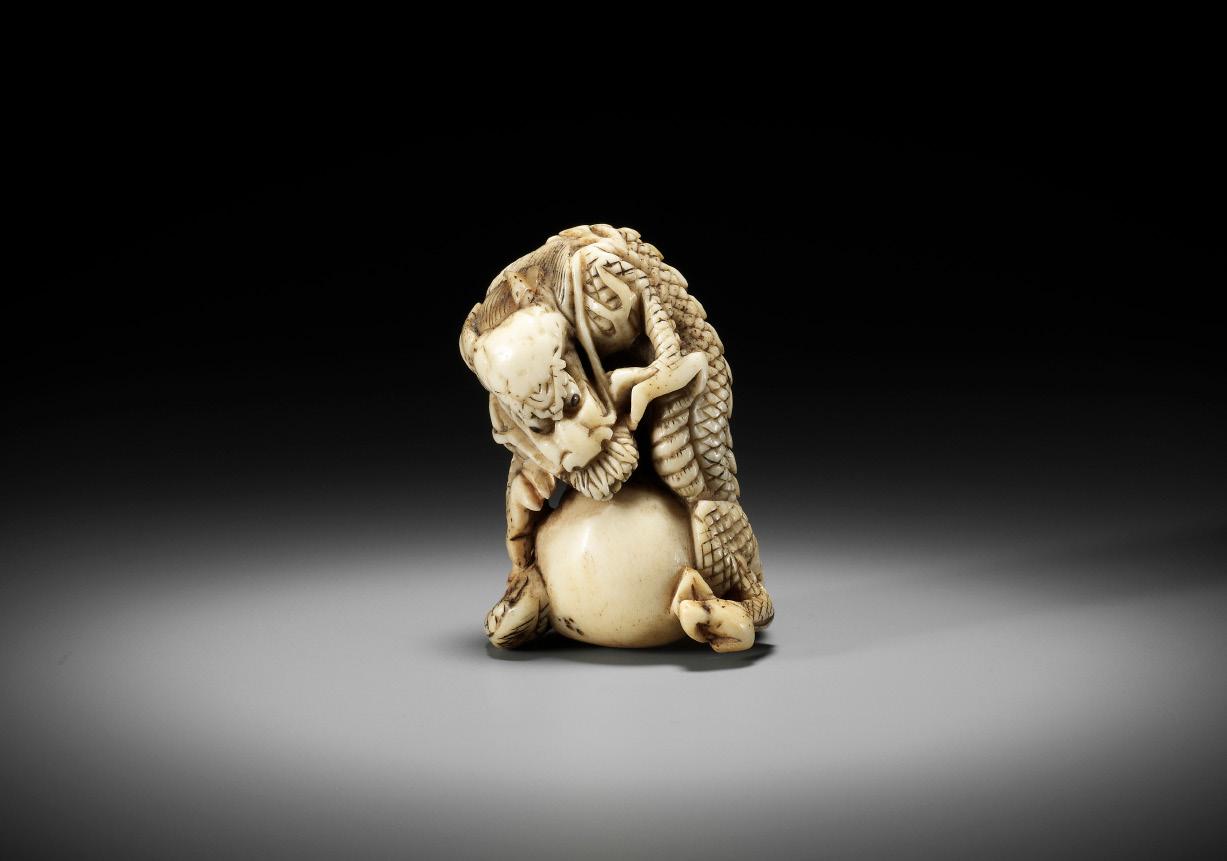

Estimate EUR 3,000
Starting price EUR 1,500
247
A POWERFUL STAG ANTLER NETSUKE OF A DRAGON WITH TAMA, ATTRIBUTED TO MOTOTADA
222 KOKUSAI: A STAG ANTLER RYUSA MANJU NETSUKE DEPICTING A ROOF TILE WITH ONI MASK (ONIGAWARA)
By Ozaki Kokusai (1835-1892), sealed Koku 谷 Japan, Shiba, Tokyo, c. 1860-1880
Of oval form, finely carved and pierced to depict the face of an oni with a large reishi-form nose and similarly carved brows, the face encircled by the neatly incised mane, the reverse with a kongo (vajra), scroll designs, and a tama pearl carved with the seal KOKU.


LENGTH 4 cm
Condition: Very good condition, appealingly worn, natural imperfections.
Literature comparison: Compare two stag antler kiseruzutsu by Kokusai, each decorated with a very similar roof tile (described as “shishi monster face medallion[s]”), illustrated in Sydney L. Moss Ltd. (2016) Kokusai the Genius: and Stag-antler Carving in Japan, vol. II, p. 366-367, nos. 278-279.
AUCTION COMPARISON
Compare a related stag antler netsuke by Ozaki Kokusai, also depicting a roof tile with oni mask, 4.2 cm, at Sotheby’s, The Katchen Collection of Netsuke, 8 November 2005, lot 88 (sold for 11,760 GBP).
Estimate EUR 3,000
Starting price EUR 1,500

248
The netsuke also functions as a ‘double mask’ producing an amusing face when viewed upside down.
223
KOKU: A STAG ANTLER KNIFE HANDLE IN THE FORM OF A MONKEY WITH A LOTUS CLOAK

By a follower of Ozaki Kokusai (1853-1892), sealed Koku 谷 Japan, Tokyo, Asakusa, late 19th century
The netsuke sized handle exquisitely carved as a tanuki-like monkey seated on a circular platform rising from a lotus blossom, wearing a large worm-eaten lotus leaf as a cloak over its back and head, the simian’s fur neatly incised and darkly stained, its face well detailed with round eyes and the mouth wide open revealing tongue and teeth, the back carved with the seal KOKU.

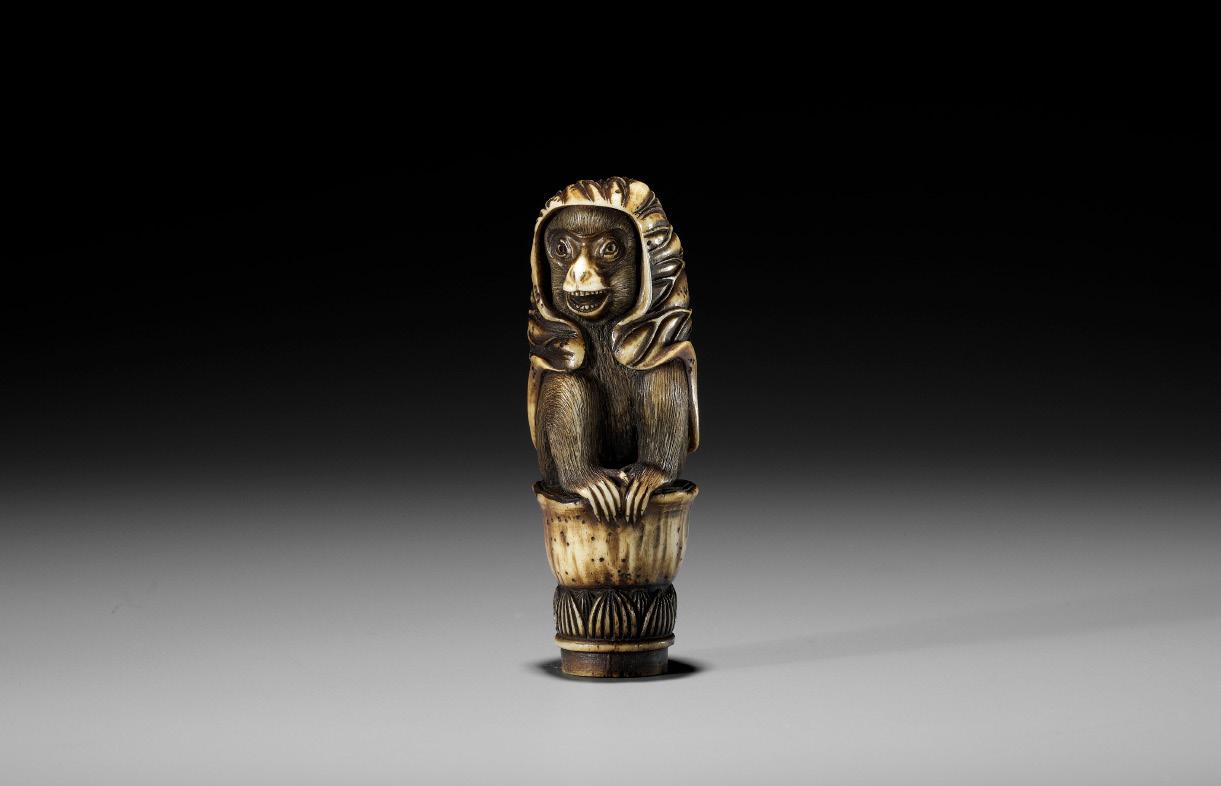
HEIGHT 6.3 cm
Condition: Very good condition, minor wear, natural imperfections. While the Koku seal is perfectly cut and the overall quality is indicative of this grand artist, the carving is a little too refined for Ozaki Kokusai, a more likely artist being a close follower such as Hoshunsai Masayuki.
LITERATURE COMPARISON
Compare a related stag antler box and cover by Kokusai, with similarly carved lotus petals and leaf, also sealed Koku, illustrated in Sydney L. Moss Ltd. (2016) Kokusai the Genius: and Stag-antler Carving in Japan, vol. II, p. 322-323, no. 252. Compare also two stag antler netsuke of stylized bats with similarly incised fur and eyes, attributed to Masayuki, illustrated in ibid., vol. III, p. 78-81, nos. 375-376.
AUCTION COMPARISON
Compare a related stag antler netsuke of a kappa ningyo, attributed to Ozaki Kokusai but more likely by Masayuki, at Galerie Zacke, Fine Netsuke, Sagemono & Okimono, 2 November 2019, Vienna, lot 253 (sold for EUR 21,488). Compare also an ivory netsuke of a cat in a kimono by Masayuki at Lempertz, Netsuke aus der Sammlung Albert Brockhaus, 27 June 2020, Cologne, lot 529 (sold for 18,750 EUR).


Estimate EUR 4,000
Starting price EUR 2,000
249
224 A WALRUS IVORY RYUSA MANJU NETSUKE OF A WINGED DRAGON
Unsigned Japan, Tokyo, Asakusa, mid to late 19th century
Finely carved in openwork with a sinuous winged dragon with scrolling mane, furcated tail, long trailing limbs, and baku-like snout, flying amid swirling clouds, the reverse with rows of stylized lotus petals encircling the central himotoshi.
DIAMETER 3.8 cm
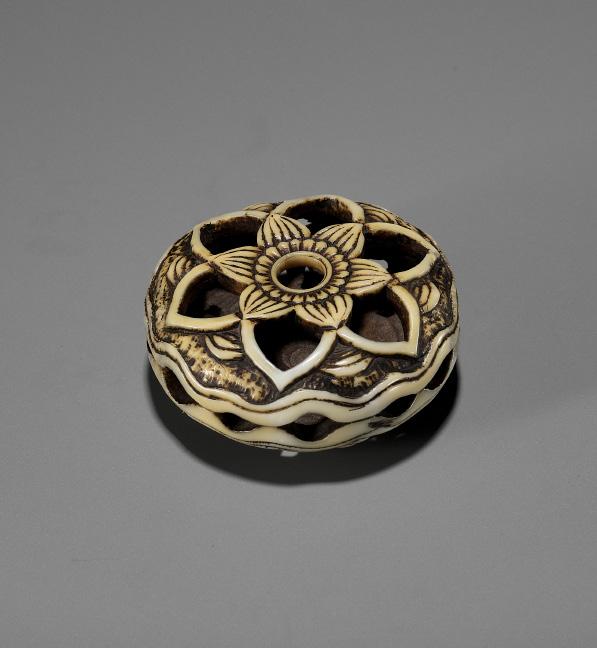
Condition: Very good condition, appealingly worn, natural imperfections.
AUCTION COMPARISON
Compare a related stag antler ryusa manju netsuke with two baku, 4.1 cm diameter, dated mid to late 19th century, at Galerie Zacke, Fine Netsuke & Sagemono, 22 April 2022, Vienna, lot 259 (sold for 5,056 EUR).


Estimate EUR 2,500
Starting price EUR 1,200
250
225
A STAG ANTLER RYUSA MANJU NETSUKE OF A KIRIN AMONGST CLOUDS
Unsigned Japan, Tokyo, Asakusa, mid to late 19th century
Published: Raymond and Frances Bushell (December 1983) Please Take My Kokusais Part II: The Frances Numano Collection, Netsuke Kenkyukai, Vol. 3, No. 4, p. 30.
Of partly furled petal-lobed form, finely carved and pierced with a kirin standing foursquare with its head turned back amid swirling clouds, its mane and bushy tail neatly incised, the reverse with a hexagonal panel enclosing waves and clouds.

DIAMETER 3.9 cm
Condition: Very good condition, appealingly worn, natural imperfections.
Provenance: Ex-collection Raymond and Frances Bushell. Sotheby’s, Netsuke from the Collection of Raymond and Frances Bushell, 18 November 1999, London, lot 318. US private collection, acquired from the above.
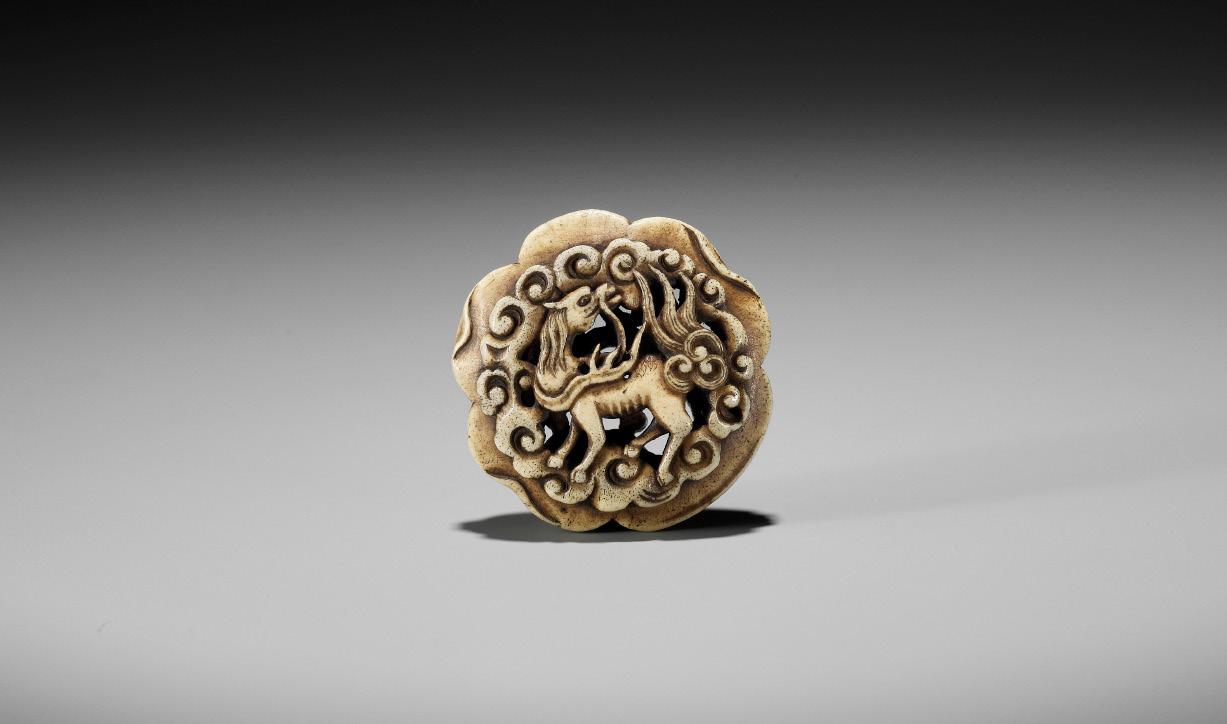

Estimate EUR 4,000
Starting price EUR 2,000
251
226
A STAG ANTLER AND SHIBUICHI KAGAMIBUTA NETSUKE DEPICTING A GOOSE IN FLIGHT
Unsigned Japan, Tokyo, Asakusa, late 19th century
Of circular form, the stag antler bowl fitted with a shibuichi plate worked in takazogan with a goose in flight, a cloud behind it indicated by the empty space, the bowl finely carved and reticulated with a basketweave design and crashing waves to the sides, the reverse with a hexagonal design of ginkgo leaves alternating with oval leaves radiating from the central himotoshi.
DIAMETER 4 cm
Condition: Very good condition, appealingly worn, natural imperfections to stag antler, the reverse with remnants of an old label.
Estimate EUR 2,000
Starting price EUR 1,000
227
A STAG
ANTLER RYUSA MANJU NETSUKE OF A HO-O BIRD AND UNUSUAL MON
Unsigned Japan, Tokyo, Asakusa, mid to late 19th century
Finely carved in openwork with a central roundel enclosing a flying ho-o bird, the twisted strands of its long tail flowing in the wind, encircled by stylized petals, the reverse with a mon composed of a twisted circular design surmounted by inflorescences, centered by a single himotoshi.
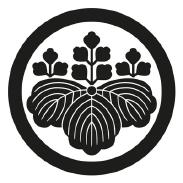
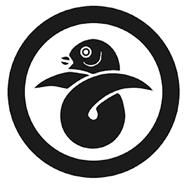
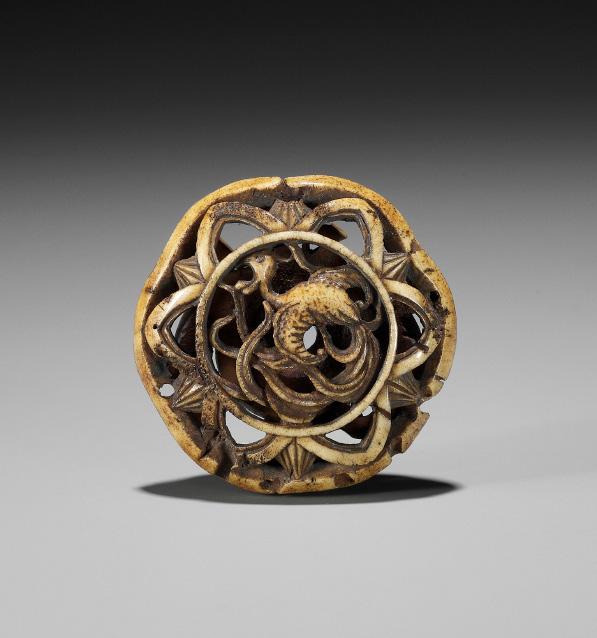

DIAMETER 4 cm
Condition: Very good condition with minor wear and typical natural imperfections.
The mon carved to the reverse of the present netsuke is highly unusual and appears to be a combination of the ‘body’ of the Maruni Musubi Karigane (wild goose crest) and the inflorescences found on the kiri mon (paulownia crest). Both the ho-o bird, which is carved to the front of this netsuke, and the paulownia (kiri) tree are imperial symbols of Japan. According to legend, the ho-o, a bird similar to the phoenix that represents the eternal rebirth of the soul, only settles on the Kiri tree. In the hope of attracting this auspicious bird that blesses people with wisdom, health and happiness, the trees are planted in courtyards and gardens.

Estimate EUR 1,500
Starting price EUR 800
252
The wild goose crest or Maruni Musubi Karigane
The paulownia crest or kiri mon
228
KO: AN INLAID WALRUS IVORY RYUSA MANJU NETSUKE WITH DEPICTING THE THREE FRIENDS OF WINTER (SHOCHIKUBAI)

 By Ko, sealed Ko 光
By Ko, sealed Ko 光
Japan, Tokyo, Asakusa, second half of 19th century
Of circular form, intricately carved in openwork with craggy rockwork, thick clouds, pine, bamboo, and a jakago (bamboo basket), and finely decorated in shibuichi and copper takazogan with the stump of a tree issuing a single branch bearing plum blossoms. The reverse with a central himotoshi surrounded by bamboo leaves and pine clusters as well as a circular reserve incised with a single seal character KO.


DIAMETER 4.2 cm
Condition: Very good condition, minor wear, natural imperfections. Provenance: From the collection of Gaston Lazard (1878-1956) and his wife Jane Levy (1886-1985) and thence by descent within the same family.
LITERATURE COMPARISON
Compare a related inlaid ivory ryusa manju netsuke, also signed Ko in seal form, similarly carved with pines and bamboo, illustrated in Lazarnick, George (1981) Netsuke & Inro Artists, and How to Read Their Signatures, vol. 1, p. 627.
Estimate EUR 1,500
Starting price EUR 800
229
A RARE STAG ANTLER AND IRON NETSUKE DEPICTING A FROG ON A LOTUS LEAF

Unsigned Japan, Tokyo, Asakusa, second half of 19th century
Finely and naturalistically carved as a furled lotus leaf with well-executed raised veins and pierced wormrot, ingeniously incorporating the natural flaws of the material, skillfully inlaid with an iron frog with spots in nunome-zogan, the frog encircled by a lotus stem issuing a pod and a bud, the reverse fitted with a looped cord attachment.
LENGTH 4.4 cm
Condition: Very good condition, minor wear, natural imperfection. Provenance: From the collection of Gaston Lazard (1878-1956) and his wife Jane Levy (1886-1985) and thence by descent within the same family.
AUCTION COMPARISON
Compare a related stag antler and iron netsuke, depicting a snail with acorns, at Zacke, Fine Netsuke, Sagemono & Okimono, 2 November 2019, Vienna, lot 73 (sold for 2,780 EUR).
Estimate EUR 1,500
Starting price EUR 800
253
230
A SUPERB STAG ANTLER NETSUKE OF EDAMAME BEAN-PODS

Unsigned Japan, 19th century
Finely carved from a branch section of purely white antler, much of the natural orientation dictating the shape of the netsuke. Depicted is a group of overlapping edamame bean pods with subtly carved undulations to indicate the beans within. Two ends of the netsuke with stag antler plugs. One side with two generously excavated himotoshi.
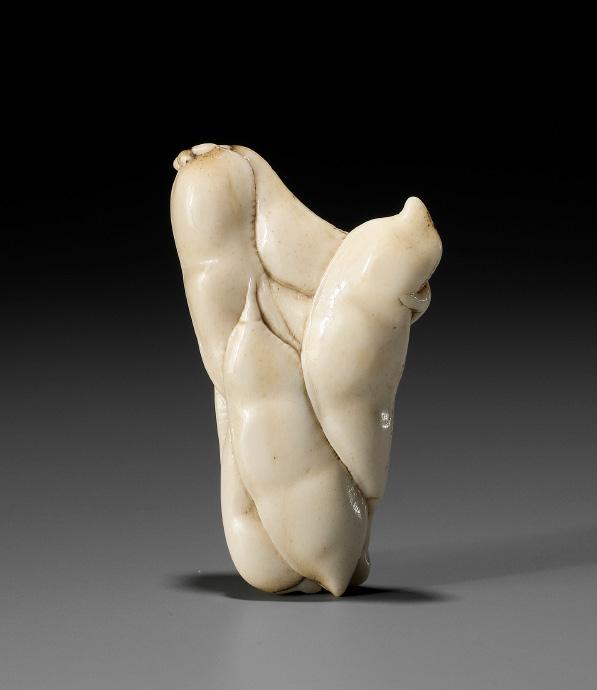
The stag antler is of a deceivingly pure color and quality, the material revealed only by the two plugs and small areas of natural imperfections.
LENGTH 5.6 cm
Condition: Very good condition, minor wear, few light surface scratches.
Provenance: Old Dutch private collection. Collection Prof. Dr. Henk C. Hoogsteden, Rotterdam, acquired from the above.
Edamame literally means stem beans because the soybeans were boiled while still attached to the stem. Legumes such as beans (mame) and peas (endo) symbolize female fertility in East Asia. The fruits that appear in the swelling of the pod are considered to be the unborn child in the womb. Mame, written with different characters, also means health and efficiency. Bean netsuke were therefore worn as a talisman.
Estimate EUR 1,500
Starting price EUR 800
231
A STAG ANTLER NETSUKE OF REISHI FUNGI
Unsigned Japan, 19th century
Well carved as six reishi heads of varying sizes borne on gnarled stems, some of which are entwined, the surface finished to resemble the naturally rough texture and stained dark. Several possibilities for the cord attachment due to the openwork.


HEIGHT 6 cm
Condition: Very good condition, attractively worn, few small age cracks.
Provenance: A noted private collection, USA.
LITERATURE COMPARISON
Compare a related stag antler netsuke of reishi fungi by Rosetsu, dated circa 1870s-1890s, illustrated in Sydney L. Moss Ltd. (2016) Kokusai the Genius: and Stag-antler Carving in Japan, vol. III, p. 402-403, no. 575.
Estimate EUR 1,200
Starting price EUR 600
254
232
A FINE STAG ANTLER RYUSA MANJU NETSUKE OF A CUCKOO AND MOON (TSUKI NI HOTOTOGISU), ATTRIBUTED TO RENSAI

Attributed to Ishikawa Rensai Japan, Tokyo, Asakusa District, mid to late 19th century, c. 1860s-1880s
Finely carved in openwork with a night cuckoo (hototogisu), a bird associated with the summer, flying over the crescent moon before a thoroughly stylized conception of ribbon-like swirling clouds. The back of the moon is carved with a partly ‘obscured’ seal.


LENGTH 4.4 cm
Condition: Good condition, appealingly worn, natural imperfections including minor age cracks.
Provenance: A noted private collection, USA.
The subject of a cuckoo and the moon (tsuki no hototogisu) has a long association with romance and has inspired many poems. A poem by Otomo no Yakamochi (c. 718-785), compiled in the Man’yoshu (‘Collection of Ten Thousands Leaves’), reads: “Hototogisu, ko yo naki watare, tomoshibi o, tsukiyo ni nasoe, sono kage mo mimu” (‘Come and sing here, cuckoo. We would see you, with our lamplight for the moon’).

LITERATURE COMPARISON
Compare a closely related stag antler ryusa manju netsuke depicting the same subject, also attributed to Rensai, illustrated in Sydney L. Moss Ltd. (2016) Kokusai the Genius: and Stag-antler Carving in Japan, vol. III, p. 60-61, no. 363.
Estimate EUR 4,000
Starting price EUR 2,000
Cuckoo with Moon, by Ohara Shoson, c. 1900, Los Angeles County Museum of Art, accession number
M.2005.158.50
255
233
ISHIKAWA RENSAI: A SUPERB IVORY NETSUKE OF A FISHERMAN SUBDUING A FUGU (BLOWFISH)

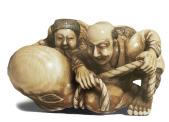
 By Ishikawa Rensai, signed Rensai 蓮齋 Japan, Tokyo, Asakusa District, second half of 19th century
By Ishikawa Rensai, signed Rensai 蓮齋 Japan, Tokyo, Asakusa District, second half of 19th century
Published: Sydney L. Moss Ltd. (2016) Kokusai the Genius: and Stag-antler Carving in Japan, vol. III, p. 52-53, no. 357.
Superbly polished, amusingly and finely carved as a fisherman on top of a giant fugu, his behind resting squarely on the fish’s head, his hands grabbing the tail fin, his legs spread out as he uses all his strength to hold the fugu down, which has been considerably flattened by the man’s effort, forming the oval base of the netsuke, the underside with two asymmetrical himotoshi and the rather unusual signature RENSAI in sosho script. Note the fine staining to the fugu’s head and surrounding area.
LENGTH 3.7 cm
Condition: Excellent condition with minor wear.
LITERATURE COMPARISON
Compare a related ivory netsuke depicting a similar subject by Rensai, with similar staining to the fugu, illustrated in Sydney L. Moss Ltd. (1996) Meetings with Remarkable Netsuke, London, no. 90, and also illustrated with a line drawing in Meinertzhagen, Frederick / Lazarnick, George (1986) MCI, Part B, p. 647.

Estimate EUR 6,000
Starting price EUR 3,000
256
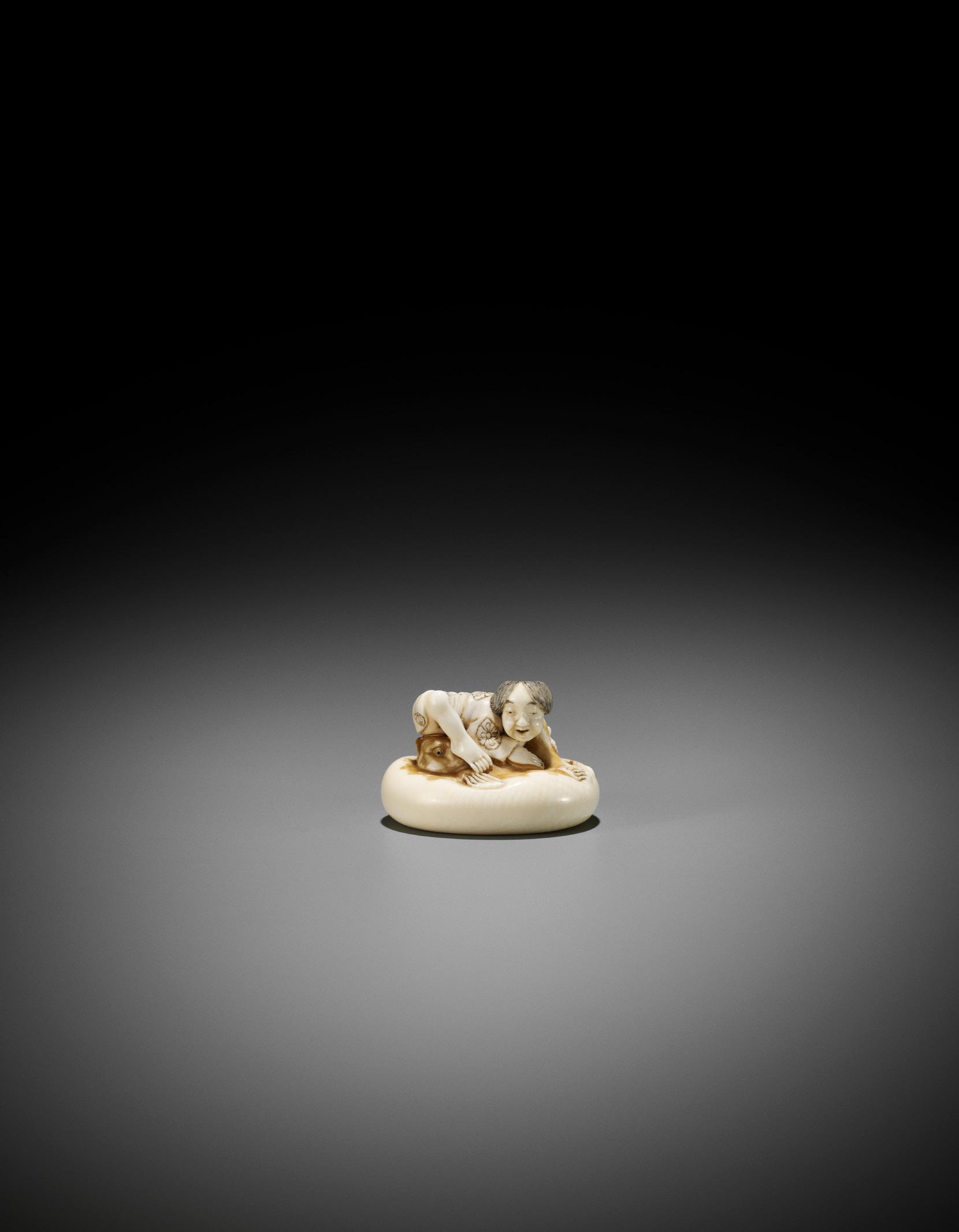
MASAYUKI: A FINE WOOD NETSUKE OF A SMOKING ONI
 By Hoshunsai Masayuki, signed Masayuki 正之 with kakihan Japan, Edo (Tokyo), mid-19th century, Edo period (1615-1868)
By Hoshunsai Masayuki, signed Masayuki 正之 with kakihan Japan, Edo (Tokyo), mid-19th century, Edo period (1615-1868)
The repentant oni (oni no nembutsu) seated cross-legged, wearing a monastic robe, his hair tied in typical Edo fashion, two horns visible on his head, holding a large pipe in one hand, the other hand beating against his chest as he is about to release a plume of smoke. The details are expressively carved, and the wood bears a rich, unctuous patina. The underside with himotoshi and signature MASAYUKI and kakihan.
HEIGHT 3.5 cm, LENGTH 4 cm
Condition: Very good condition, minor surface wear.
Provenance: From an old Swiss private collection, Geneva.
Estimate EUR 3,000
Starting price EUR 1,500
234
235
MASAYUKI: A FINE WOOD NETSUKE OF A BOY
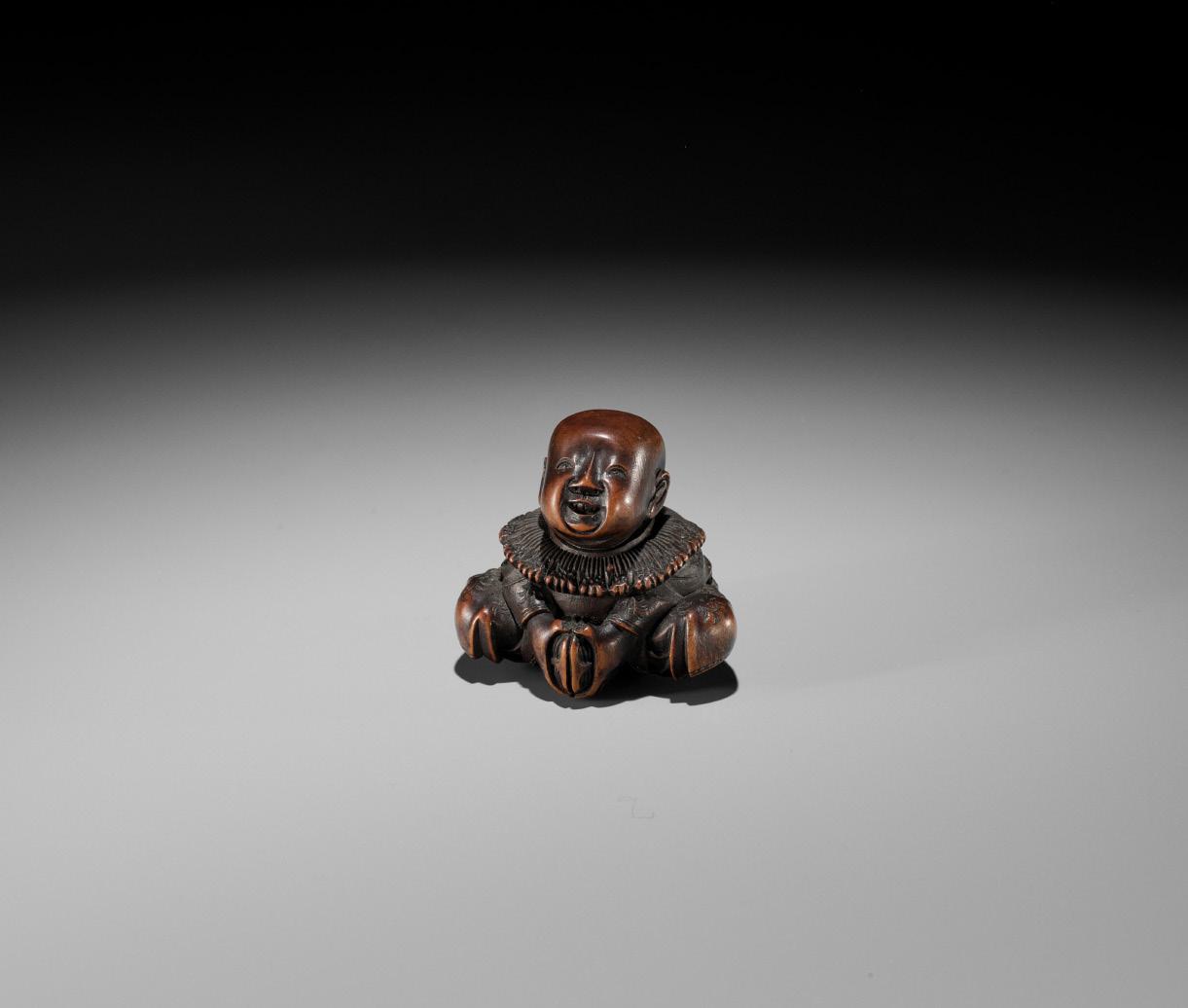
 By Hoshunsai Masayuki, signed Masayuki 正之 with kakihan Japan, Edo (Tokyo), c. 1860
By Hoshunsai Masayuki, signed Masayuki 正之 with kakihan Japan, Edo (Tokyo), c. 1860
Finely carved, the young boy wearing a ruffled collar, his head tilted upwards with a joyous expression and clasping his feet tightly together in a shunga-like gesture. The underside of the netsuke reveals a beautifully carved stylized lucky sparrow (fukura suzume) with neatly incised hanabishi décor. Large, asymmetrical himotoshi underneath and signed within a raised, double-gourd shaped reserve MASAYUKI and kakihan.
HEIGHT 3 cm, LENGTH 3.2 cm
Condition: Excellent condition, very minor wear.
LITERATURE COMPARISON
A near-identical or perhaps this exact netsuke is illustrated in Meinertzhagen, Frederick / Lazarnick, George (1986) MCI, Part A, p. 493.
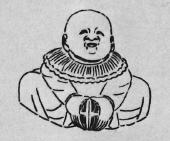
A remarkably fine and clever study by Hoshunsai Masayuki who is celebrated for his stag antler carvings and somewhat undeservedly has received little acclaim for his wood netsuke which belongs to his suspected early production when working in the Edo style.
Estimate EUR 2,000
Starting price EUR 1,000
259
HOSHUNSAI MASAYUKI: A MASTERFUL WOOD NETSUKE OF A STRANGE KAPPA

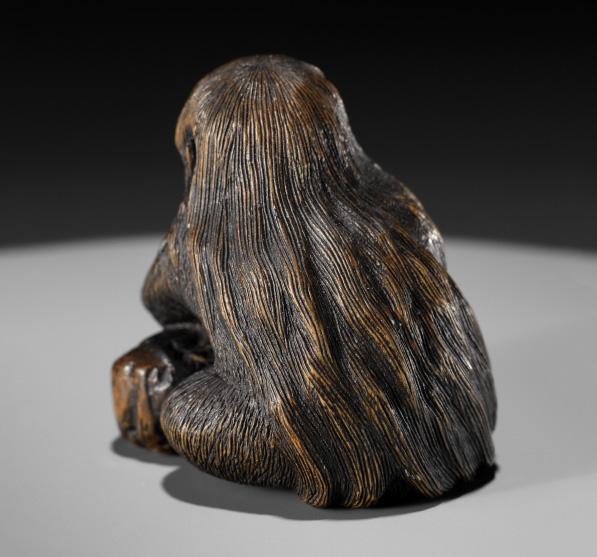
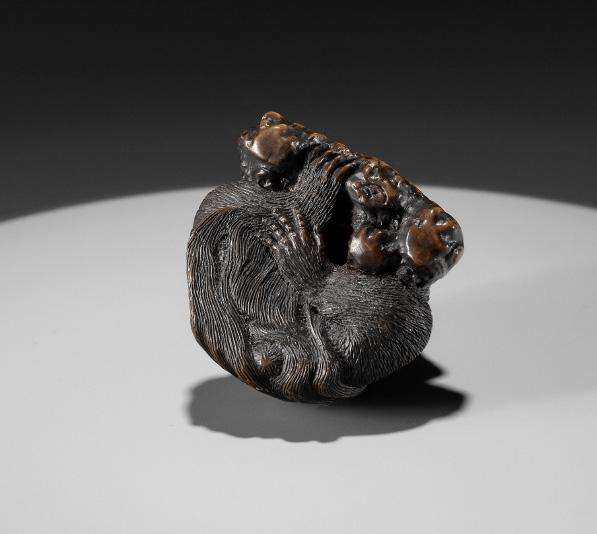
 By Hoshunsai Masayuki, signed with the artist’s kakihan Japan, Tokyo, late 19th century
By Hoshunsai Masayuki, signed with the artist’s kakihan Japan, Tokyo, late 19th century
Published: Cohen, George (1974) In Search of Netsuke & Inro, p.59, pl. XV, no. 243.

Superbly carved as a very unusual long-haired, ape-like kappa crossing its arms and resting them on a cucumber which it grabs with its feet. The enigmatic eyes are inlays of highly iridescent blueish horn, which make for a haunting expression as the strange mythical creature gnashes its teeth. The carving is incredibly refined, with superb detailing to the hairwork and bony fingers, though still bearing a purposely roughened appearance to the hairwork and cucumber. Masayuki is best known for his stag antler carvings and it is evident that the present netsuke is carved to imitate stag antler. The carving is certainly a departure from his typical Tokyo school wood pieces depicting traditional daily life subjects and is much closer to his stag antler carvings, often depicting exotic and strange subjects. Natural himotoshi and signed with the artist’s kakihan underneath the cucumber.
HEIGHT 4 cm, LENGTH 3.6 cm
Condition: Excellent condition with only very minor wear.
Provenance: Ex-collection Annable, sold through Geoffrey Moss of Sydney L. Moss Ltd. Ex-collection George Cohen, acquired from the above. Sold Sotheby’s, 29 May 1980, London, lot 48. Ex-collection Joe Kurstin, acquired from the above. Dr. M. Joseph ‘Joe’ Kurstin (1931-2021) was a prominent Miami ophthalmologist who arguably built one of the greatest netsuke collections of all time. He was known by netsuke and inro lovers worldwide and made many lifelong friends in this tight-knit community. He published several books and articles on the subject and generously lent his collection for exhibitions at the Yale University Gallery, Museum of Fine Arts, Boston, Epcot Center at Disney World, and The Tobacco and Salt Museum, Tokyo.
Estimate EUR 20,000
Starting price EUR 10,000
260 236
Elena and Joseph Kurstin
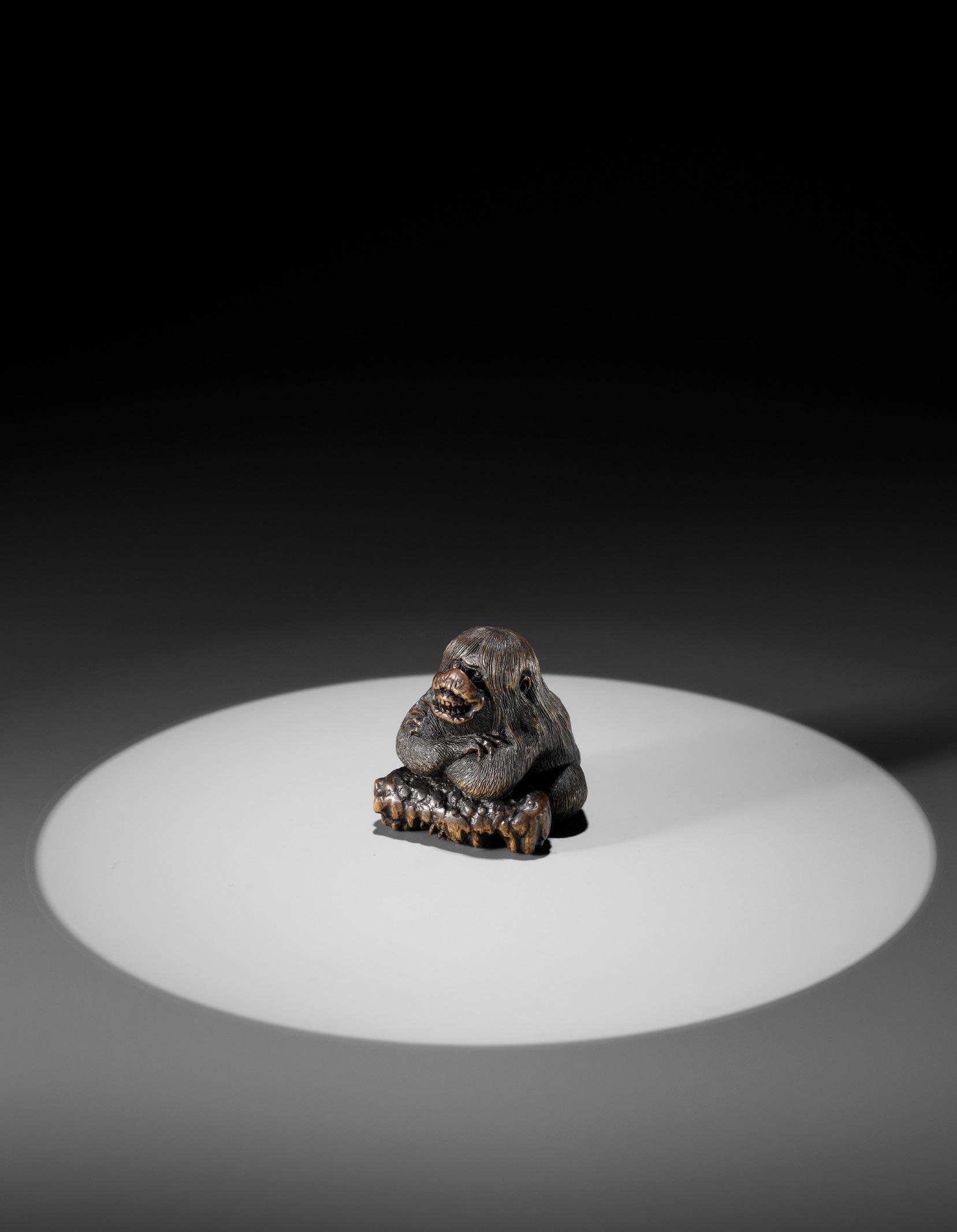
HAKUSAI: A RARE COROZO NUT AND STAG ANTLER NETSUKE OF A KAPPA HEAD

By Hoshino Hakusai, signed Haku はク Japan, Asakusa, Tokyo, second half of 19th century
Exquisitely carved, the head surmounted by a natural deer coronet with horsehair tufts, the round eyes double-inlaid in translucent and dark horn, the head itself carved from corozo nut, the finely textured skin of the nut still visible to the cheeks, chin, and back, the face well detailed with neatly incised wrinkles and grimacing mouth slightly agape revealing teeth, the back with two asymmetrical himotoshi beside the signature HAKU executed in a mixture of hiragana and katakana characters within an oval reserve.
Corozo nut is rarely used in netsuke art as it is notoriously difficult to carve. The artist here exhibits tremendous skill, the surface of the nut brilliantly utilized to emulate antler.
HEIGHT 4.3 cm
Condition: Excellent condition with minor wear.
Provenance: Ex-collection Dr. Walter Heihs. Sotheby’s, 17 June 1998, London, lot 752 (described as a tengu mask).

AUCTION COMPARISON
Compare a related Asakusa school stag antler netsuke of a kappa head by Gyokusai, also previously in the collection of Dr. Walter Heihs, sold at Sotheby’s, 17 June 1998, lot 732, and later at Galerie Zacke, 29 October 2021, Vienna, lot 257 (sold for 6,320 EUR).
Estimate EUR 4,000
Starting price EUR 2,000
262
237
A SUPERB STAG ANTLER MASK NETSUKE OF HANNYA
Unsigned
Japan, probably Asakusa, Toyko, second half of 19th century
Finely carved with a fierce expression, the intense eyes with raised and pierced pupils, the nose bridge and forehead with cranial bump well-detailed, the hooked nose with pierced nostrils, the mouth wide open showing teeth and tongue, the back with a himotoshi bar, the stag antler with a rich, deep staining.
HEIGHT 3.5 cm
Condition: Very good condition, minor wear, natural imperfections with possible associated small loss to back of tongue.
As evidenced by the museum comparison below (and many further examples in private and public collections), stag antler netsuke are most commonly of a rather rustic design, especially compared to the present netsuke, which boasts well-detailed and finely carved features that make this a particularly rare example.
MUSEUM COMPARISON
Compare a related stag antler mask netsuke, formerly in the Trumpf collection and now in the Linden Museum Stuttgart, inventory number OA 18928.

AUCTION COMPARISON
Compare a stag antler netsuke of an oni, attributed to Kokusai, at Sotheby’s, 19 June 2001, London, lot 43 (sold for 3,840 GBP), illustrated in Wright, Douglas J. K. (Fall 2001)

Auctions, International Netsuke Society Journal, Vol. 21, No. 3, p. 36. Also compare a related stag antler mask netsuke of Hotei, with a similar patina, 4.7 cm high, dated early 19th century, at Galerie Zacke, Fine Netsuke & Sagemono, 25 September 2020, Vienna, lot 220 (sold for 4,803 EUR).

Estimate EUR 2,500
Starting price EUR 1,200
263
238

MITSUHIRO: A RARE AND IMPORTANT
IVORY NETSUKE OF THE GHOST OF OIWA AS A CHOCHIN (LANTERN)

By
Ohara
Mitsuhiro (1810-1875), signed Mitsuhiro 光廣 Japan, Osaka, mid-19th century, Edo period (1615-1868)
Published:
The Honolulu Academy of Arts Netsuke Exhibit (1975) INCS Journal Vol. 3, No. 1, p. 31, no. 70.
Lazarnick, George (1976) The Signature Book of Netsuke, Inro and Ojime Artists in Photographs, p. 286.

Hurtig, Helen (1980) Grotesqueries in Netsuke, INCS Journal Vol. 8, No. 1, p. 32, no. 26A.
Lazarnick, George (1981) Netsuke & Inro Artists, and How to Read Their Signatures, vol. 1, p. 72 (in color) and p. 779.
Eskenazi (1990) Japanese netsuke from the Lazarnick collection, p. 53, no. 30.
Eskenazi (1998) Japanese netsuke, ojime and inro from a private European collection, p. 34, no. 26.
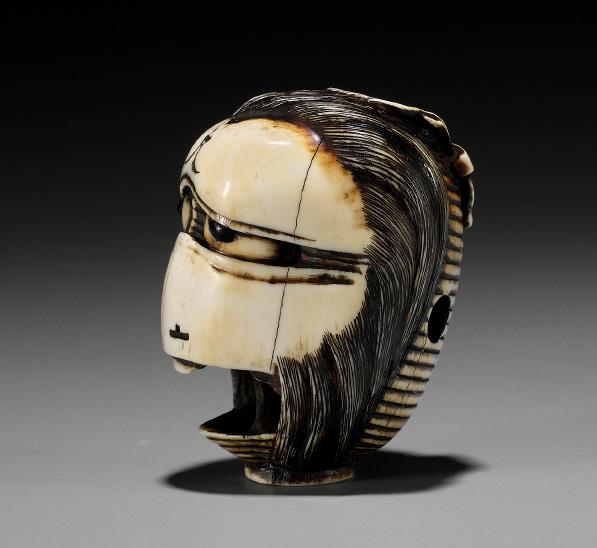
Finely carved, the paper lantern baring the open-mouthed face of the ghastly heroine, the pupils inlaid with dark horn, her neatly incised long hair brushed back and her eyes inlaid, the incised details and inscriptions on the ivory skillfully stained for effect. The forehead bears a bonji (Sanskrit character). The back of the lantern bears an inscription Namu Amida butsu zokumyo Oiwa-jo (save us merciful Buddha, the woman commonly known as Oiwa), beside the asymmetrical himotoshi and below the signature MITSUHIRO. The staining and extensive use of sumi-e, as well as the minutely incised signature, is certainly coherent with the work of Mitsuhiro, while the size and subject matter are a departure from this celebrated artist’s usual work. It is likely that the present netsuke was a one-off commission.
HEIGHT 5.1 cm
Condition: Very good condition with minor wear, natural flaws including expected age cracks.
Provenance: Ex-collection George Lazarnick. Eskenazi, London, 1990. Ex-collection Emiel Veranneman, acquired from the above. Eskenazi, London, 1998. Sotheby’s, May 2007, London, lot 785 (described as “after Ohara Mitsuhiro; sold for GBP 6,600). European collection P. Jacquesson, acquired from the above.
Oiwa died in 1636 and even today it is believed that she haunts the place of her death as well as anyone who performs her story which was adapted into the famous kabuki play Tokaido Yotsuya Kaidan (Ghost story of Yotsuya in Tokaido) in 1825. The story is a tale of betrayal, murder, and ghostly revenge which features Tamiya Iemon who poisoned his loving wife Oiwa, who in turn haunted him and drove him mad. The design of the present netsuke is taken from a woodblock print by Katsushika Hokusai (17601849) titled Oiwa-san from the series Hyaku monogatari (One Hundred Ghost Stories), circa 1831-1832.

Estimate EUR 12,000
Starting price EUR 6,000
265
239
The Lantern Ghost Oiwa by Katsushika Hokusai, c. 18311832, Minneapolis Institute of Arts, accession number 56.52.1
240
AN IMPORTANT EARLY WOOD MASK NETSUKE DEPICTING A GRIMACING MAN
Unsigned Japan, late 17th to 18th century, Edo period (1615-1868)
Published: Moss, Paul (1990) The London Netsuke Fair and Convention Handbook, p. 61.
Wright, Douglas J.K. (Spring 2001), Auctions, International Netsuke Society Journal, vol. 21, no. 1, p. 50.
Exhibited:
The London Netsuke Fair and Convention, 1990.
Boldly carved, somewhat reminiscent of a Hyottoko mask, the face contorted to one side with deeply carved wrinkles below the mouth and around the prominent frontal bone, one eye round and the other crescent-shaped, the small mouth with two buck teeth. Some red pigments are used for dramatic effect. The reverse with a large, vertically pierced himotoshi bar.
HEIGHT 6.3 cm
Condition: Very good condition with minor wear, few tiny nicks, occasional light scratches.
Provenance: Ex-collection G.H. Hodgson, sold at Glendining’s, 1917, London. Ex-collection Michael and Hiroko Dean. Sotheby’s, 14 November 2000, London, lot 103 (sold for GBP 3,800). European collection P. Jacquesson, acquired from the above.
This mask netsuke was presented at the London Netsuke Fair and Convention in 1990, where it was shown at Joseph Kurstin’s lecture Early Netsuke. The handbook (edited by Paul Moss) dates the mask “probably late 17th century”.
Douglas J.K. Wright wrote on the present lot in his International Netsuke Society Journal article on the Sotheby’s auction where it was previously sold: “I loved this piece. There were signs of a signature much worn away. Paul Moss felt I was seeing strokes before my eyes, but I am adamant that one could make some of the scratches translatable and reading Tenkaichi. Also, I felt from the style it was by Deme Uman […].”
While P. Jacquesson has built one of the most important collections of mask netsuke recorded with many fantastic examples, this is arguably the masterpiece of the collection.

Estimate EUR 8,000
Starting price EUR 4,000
266

241
A LARGE WOOD MASK NETSUKE OF USOFUKI
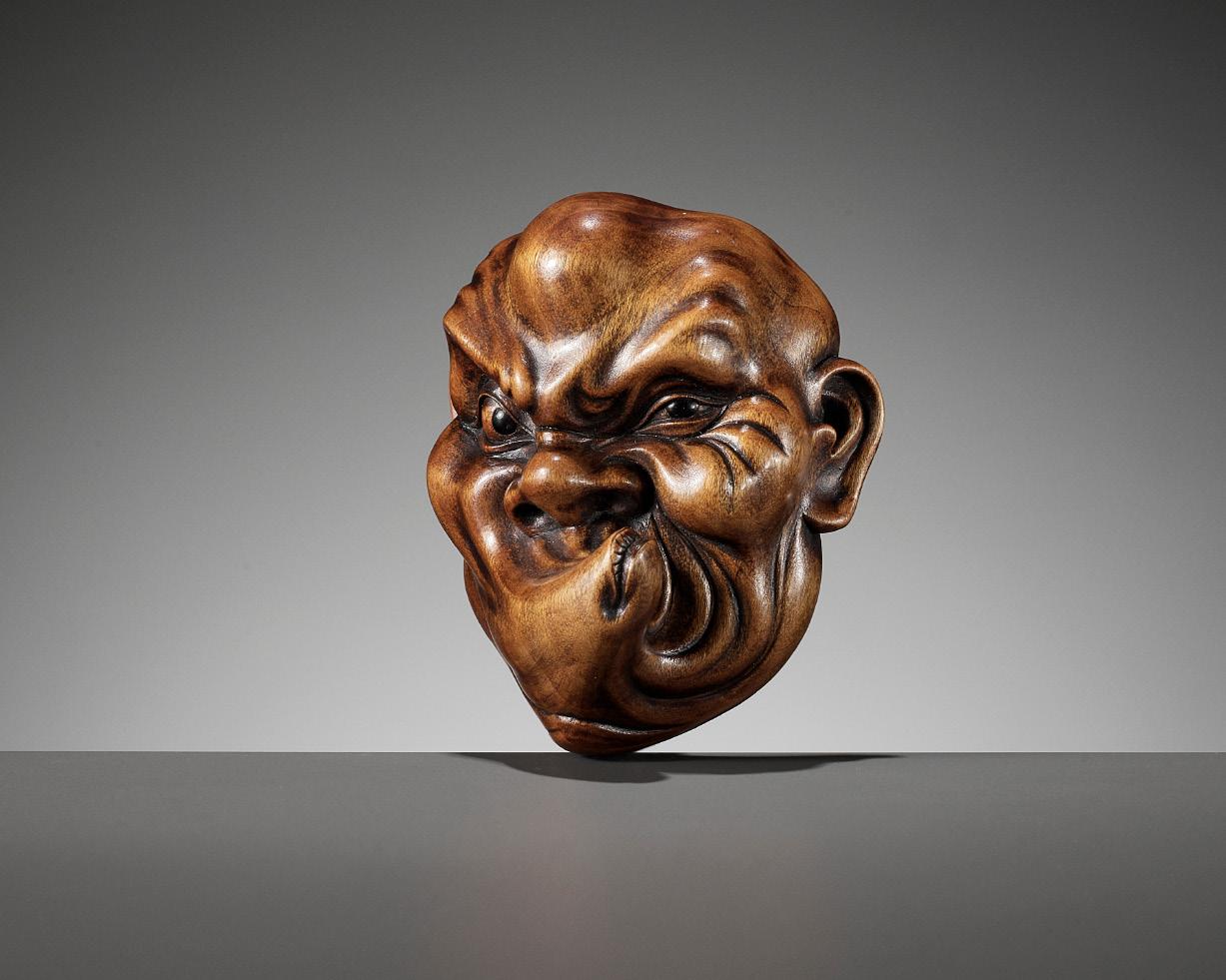
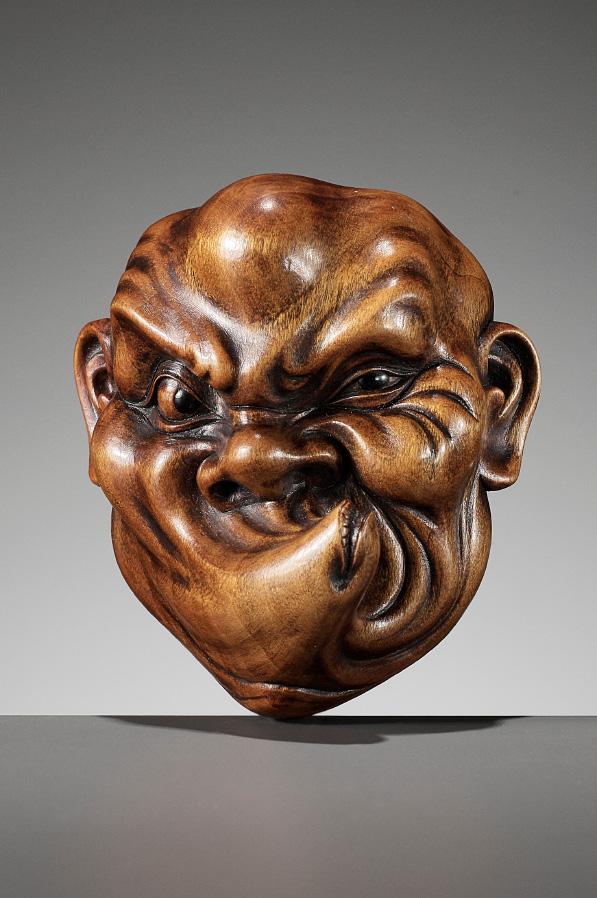
Unsigned Japan, 19th century
Well carved with an amusing expression, the elongated lips puckered in a whistle and twisted to one side, the wrinkles deeply carved and accentuated by skillful staining, one eye narrowed, both with pupils inlaid in dark horn, the ears pierced, the forehead with a prominent circular bump. The reverse deeply incised with a kakihan (artist’s cursive monogram) below the vertically pierced himotoshi bar.
HEIGHT 7.1 cm
Condition: Very good condition with minor wear, the reverse with few light scratches, tiny repair to the edge above the right ear. Provenance: Parisian private collection. European collection P. Jacquesson, acquired from the above in May 2002.
Usofuki (or Usobuki) is a Kyogen mask type which is not well standardized, but easily identifiable by the pursed or puckered lips, lending the mask (and the actor wearing it) a highly comical expression. The noun usobuki or usofuki is a gerund of the verb usobuku, which has many meanings: exhale sharply, whistle, hum, intone, howl or bay, pretend ignorance, and brag. A highly regarded ethnographer and linguist, the late Shinobu Orikuchi assigned a much earlier meaning to usobuku: taunt, oppose, and rebel. He specifically interpreted the pursed lips of old indigenous masks as signifying imminent speech, as the expression of seirei determined to speak out in defiance but constrained by the consequences of thereby acknowledging the authority of the kami.
Estimate EUR 3,000
Starting price EUR 1,500
268
242 AN AMUSING WOOD MASK NETSUKE OF A LONG-NOSED TENGU
Unsigned
Japan, 19th century, Edo period (1615-1868)
Published: Bulletin Franco Japonais, no. 50, October 1996, p. 26, no. 50.
Expressively and amusingly carved as a tengu with its long nose bent to one side, his face contorted in a pained grimace, the eyes with large pierced pupils evoking a distraught expression, the details deeply carved and heightened by skillful staining.
HEIGHT 4.2 cm
Condition: Excellent condition with minor wear.
Provenance: Kunsthandel Klefisch, 24 June 1995, Cologne.
European collection P. Jacquesson, acquired from the above.
Tengu masks are popularly used at tengu festivals held all over Japan, from Tengu Matsuri on Mt. Tengu in Hokkaido, to the Shimokitazawa Tengu Festival in Tokyo. While the tengu Matsuri is a more traditional affair, the Shimokitazawa festival is a modern take on setsubun, where beans are thrown to ward away evil. People dressed as tengu take to the streets, visiting shops and homes to throw their beans of evil’s bane to bring good luck and fortune.
In netsuke art, the tengu mask often takes on a phallic meaning due to its long nose. In the present netsuke, however, this symbolism has been inverted, as the nose does not protrude outward but is bent to the side, a surely painful and emasculating experience which nonetheless elicits amusement.



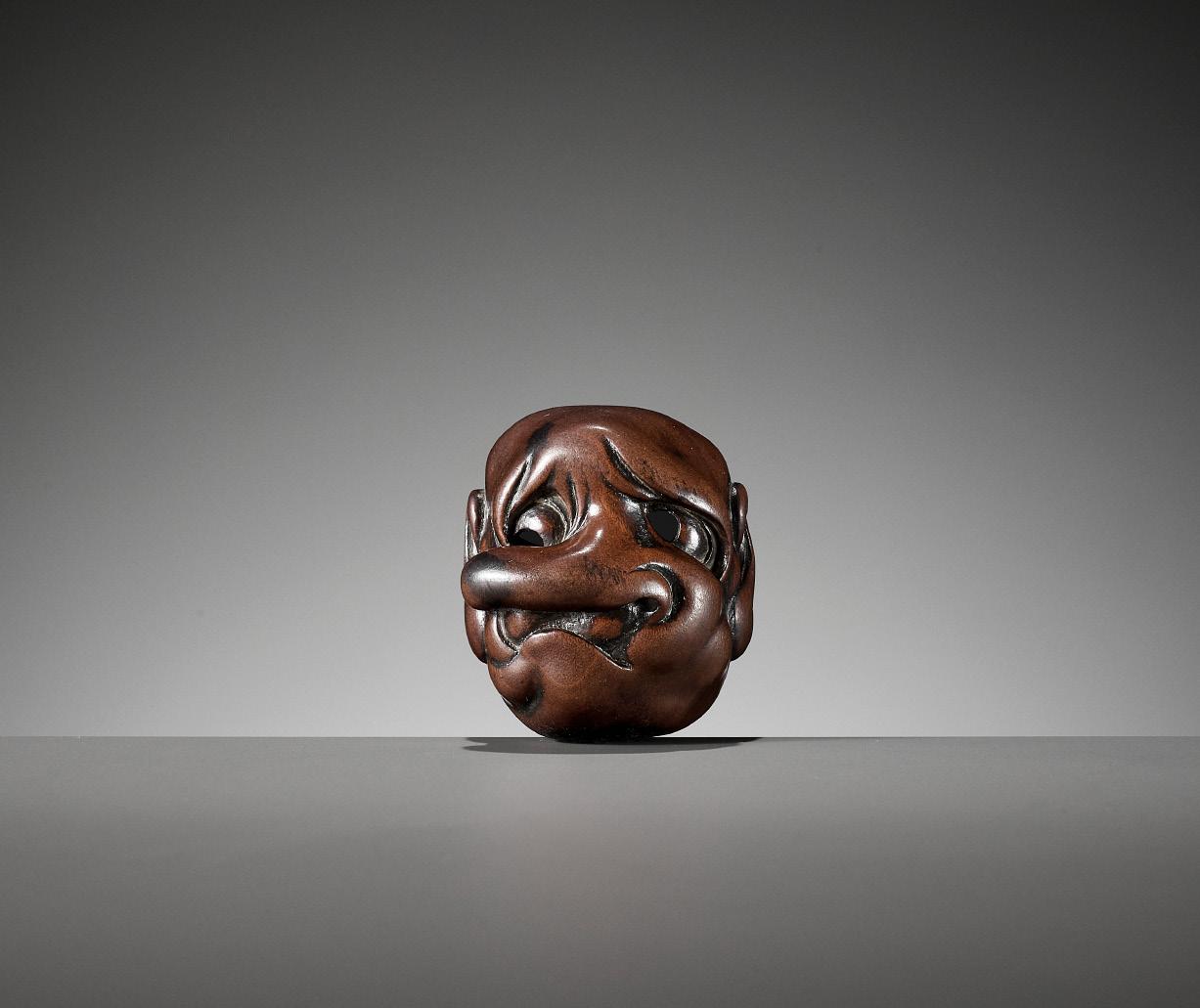
LITERATURE COMPARISON
Compare a related wood netsuke depicting Hyottoko, also with a long nose twisted to one side, albeit with a stern expression, illustrated in Bushell, Raymond (1985), Netsuke Masks, pls. 254.
MUSEUM COMPARISON
Compare a related wood netsuke by Kokeisai Sansho, also depicting a long-nosed tengu with similar expression, 5.4 cm high, dated late 19th to early 20th century, previously in the collection of Raymond Bushell and now in the Los Angeles County Museum of Art, accession number M.91.250.341, illustrated in Bushell, Raymond Netsuke (1975) Familiar & Unfamiliar, p. 146, no. 315 and Bushell, Raymond (1985), Netsuke Masks, pl. 327. Compare also a related wood netsuke by Deme Uman, also depicting a longnosed tengu, 5.7 cm high, dated 19th century, previously in the Trumpf collection and now in the Linden-Museum Stuttgart, inventory number OA 18947, illustrated in Patrizia Jirka-Schmitz (2000) Netsuke: Trumpf Collection, vol. 2, Linden Museum, 2000, p. 217, no. 432.
Estimate EUR 2,500
Starting price EUR 1,200
269
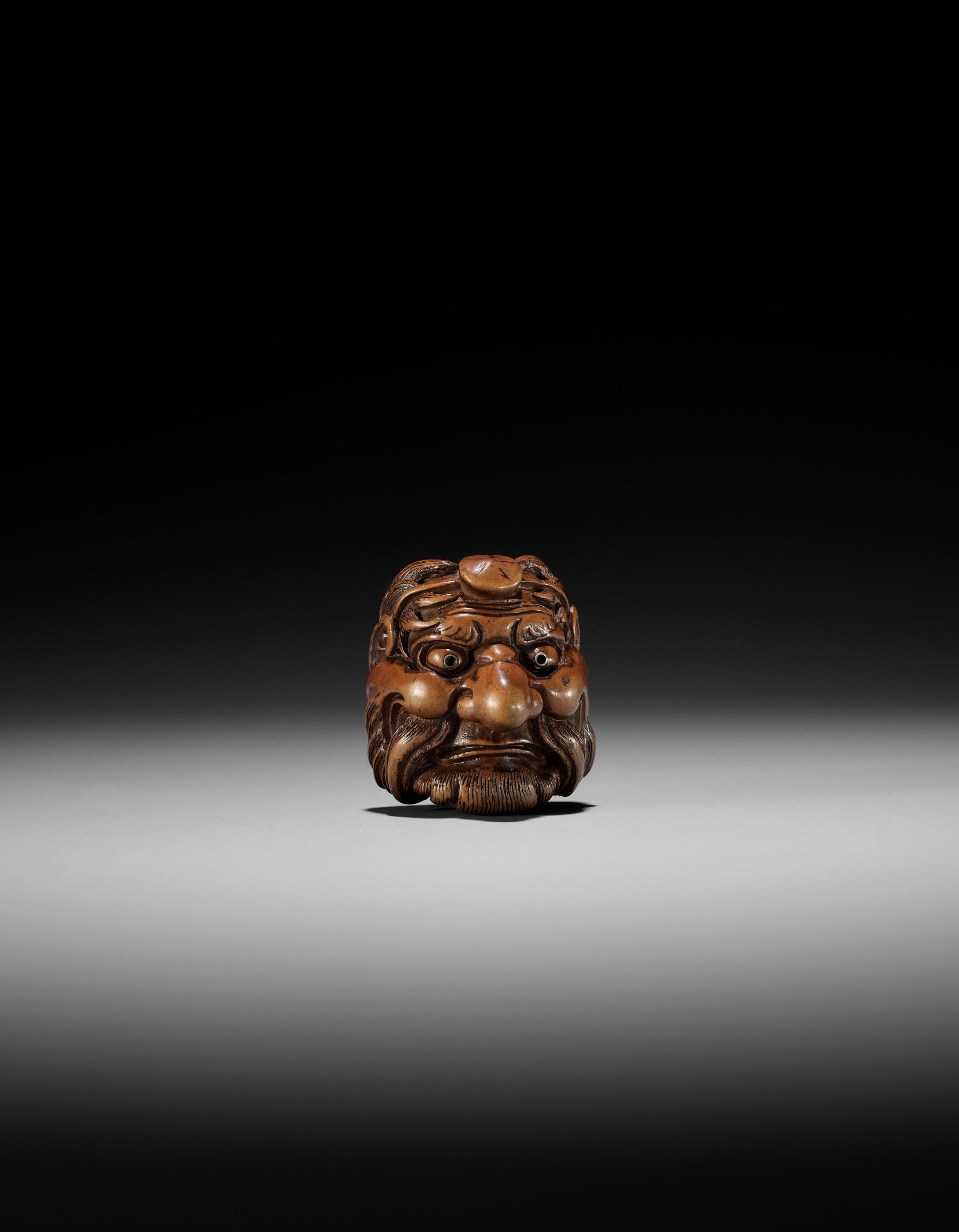
243
HIDARI ISSAN: A RARE WOOD MASK NETSUKE OF SOJOBO, THE TENGU KING OF MOUNT KURAMA
By Hidari Issan (1804-1857), signed Hidari Issan 左一山 with kakihan Japan, Iwashiro, c. 1840, Edo period (1615-1868)
A well-sized wood netsuke, boldly carved as the Tengu King wearing the characteristic tokin cap of the yamabushi, his face with a stern expression, his bulging eyes with round gilt-ringed pupils, his prominent nose with recessed nostrils, flanked by strong cheeks, his long beard neatly incised and curling back to the reverse below the broad himotoshi bar signed HIDARI ISSAN with a kakihan based on the character Toku 篤. The well-toned wood bearing a fine, dark patina.

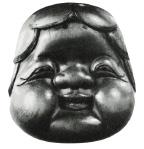
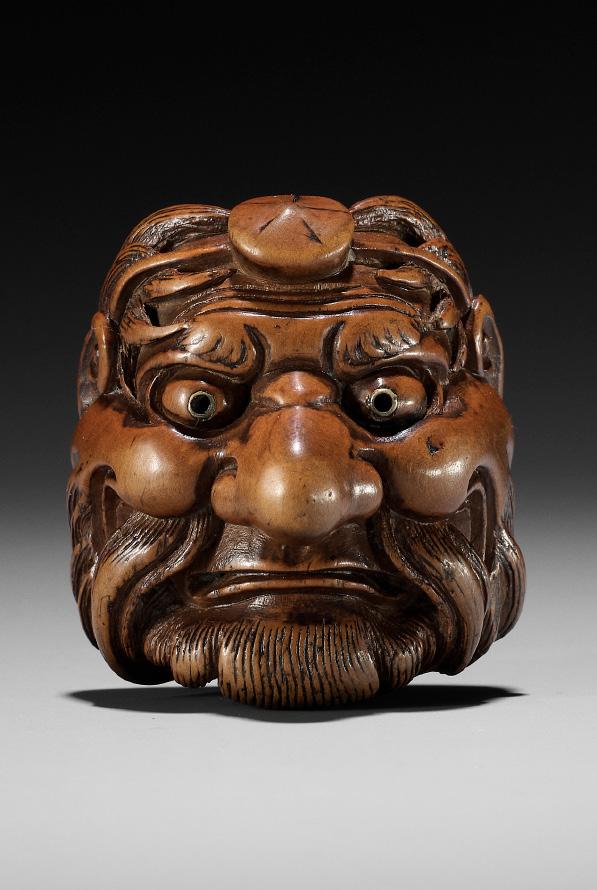
HEIGHT 4.6 cm, LENGTH 4 cm
Condition: Good condition with some wear, few light scratches, one larger scratch to the back of the himotoshi bar.
Provenance: Ex-collection Dr. Walter Heihs. Sotheby’s, 17 June 1998, London, lot 712. European collection P. Jacquesson, acquired from the above.
Sojobo is the mythical king and god of the tengu. He has the appearance of a yamabushi and is often depicted wearing their tokin cap. The other distinctive physical characteristics of Sojobo include his long, white hair and unnaturally long nose. Sojobo is said to live on Mount Kurama. He rules over the other tengu that inhabit Mount Kurama in addition to all the other tengu in Japan. He is extremely powerful, and one legend says he has the strength of 1,000 normal tengu. He is perhaps best known for the legend of his teaching the warrior Minamoto no Yoshitsune (then known by his childhood name Ushiwaka-maru or Shanao) the arts of swordsmanship, tactics, and magic.
LITERATURE COMPARISON
Mask netsuke by Hidari Issan are rare with only very few examples recorded. A mask netsuke of Okame bearing a similar kakihan is illustrated in Lazarnick, George (1981) Netsuke & Inro Artists, and How to Read Their Signatures (LNIA), Vol. 1, p. 519. Another mask netsuke depicting a comical mask of Emi-men is illustrated in Davey, Neil K. / Tripp, Susan G. (1993) The Garrett Collection, p. 293, no. 426.
Estimate EUR 5,000
Starting price EUR 2,400
271
LITERATURE COMPARISON
KOKEISAI SANSHO: A SUPERB STAINED WOOD MASK NETSUKE OF A GHOUL


 By Kokeisai Sansho (1871-1936), signed
By Kokeisai Sansho (1871-1936), signed
with the artist’s kakihan Japan, Osaka, early
20th century
Well carved as a bucktoothed ghoul biting his lower lip, the large eyes, wide nostrils, and corners of his mouth pierced, his nose bridge subtly carved, the brows and wrinkles neatly incised, the carving heightened by skillful staining, the back with a himotoshi bar signed with the artist’s kakihan.
HEIGHT 4.7 cm
Condition: Very good condition, minor wear. A tiny crack near the left eye and a small to the edge visible in the back.
Compare a related wood mask netsuke by Kokeisai Sansho, illustrated in Lazarnick, George (1981) Netsuke & Inro Artists, and How to Read Their Signatures, vol. 2, p. 913. Compare a wood netsuke by Kokeisai Sansho signed with the same kakihan, illustrated in Boris Filatov (Spring 2012) Kokeisai Sansho: Mystery of the Genius International Netsuke Society Journal, Vol. 32, No. 1, p. 24, no. 14.
AUCTION COMPARISON
Compare a closely related wood mask netsuke of a demon by Kokeisai Sansho, signed with the same kakihan as the present lot, 3.9 cm high, at Van Ham, 4 December 2014, Cologne, lot 424 (sold for 4,257 EUR).

Estimate EUR 4,000
Starting price EUR 2,000
272
244
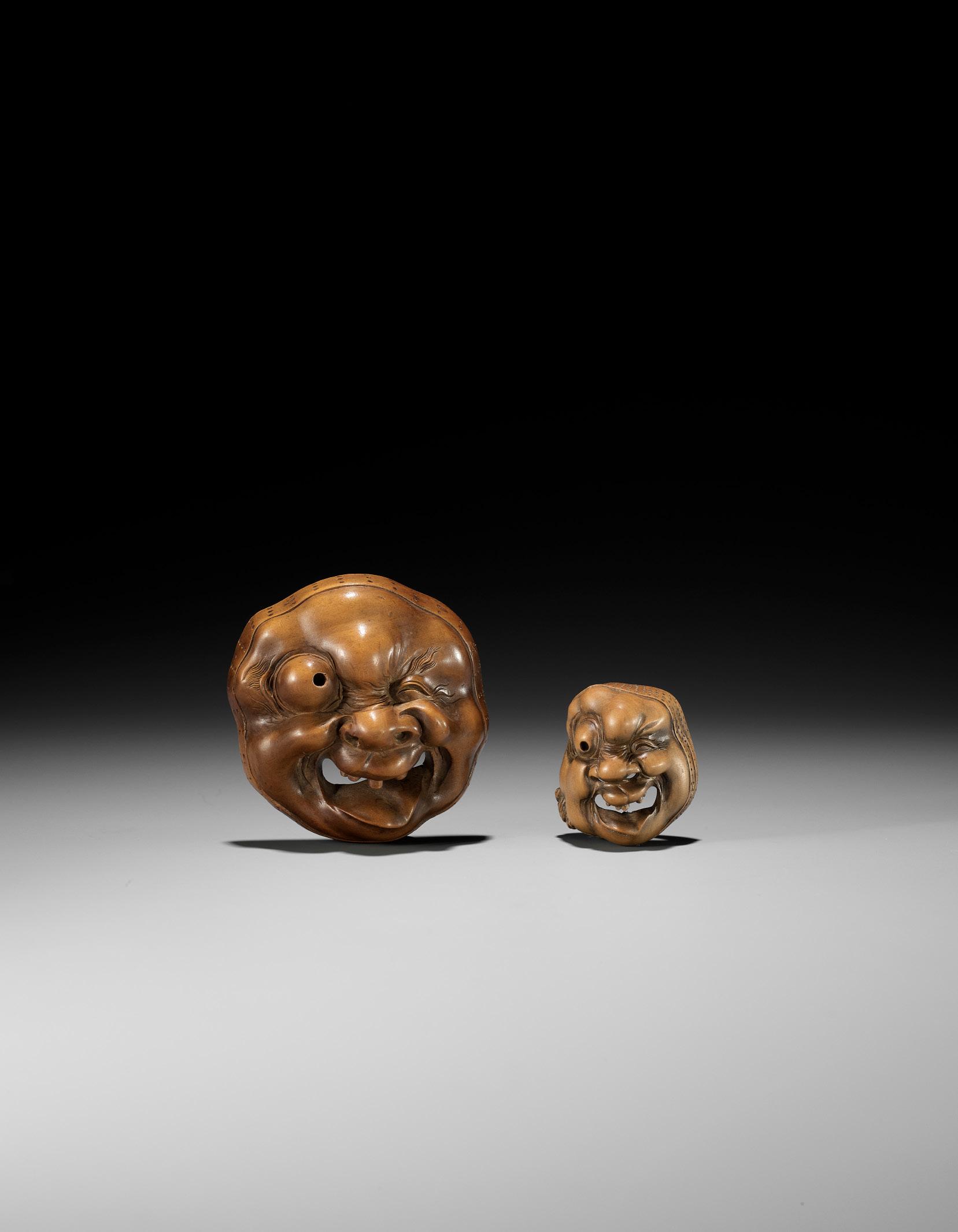
Well carved as a grimacing man with pierced pupils, nostrils, and mouth, one eye round and the other narrowed, centered by a prominent bump to the forehead and the broad nose, above the open mouth with missing teeth, the head wrapped in a cloth tied at his left cheek, the reverse with a narrow himotoshi bar incised with the kakihan of Kokeisai Sansho (artist’s cursive monogram).



HEIGHT 3.8 cm
Condition: Excellent condition with minor wear. Provenance: Ex-collection Grandvuinet. Sotheby’s, 14 July 2006, London, lot 1109 (part lot). European collection P. Jacquesson, acquired from the above.
LITERATURE COMPARISON
Compare a closely related wood mask netsuke, unsigned and attributed to Kokeisai Sansho, described as a Kuron mask, 5.4 cm high, illustrated in Boris Filatov (Spring 2012) Kokeisai Sansho: Mystery of the Genius International Netsuke Society Journal, vol. 32, no. 1, p. 25, no. 17. Several further examples are illustrated in the article showing this exact kakihan.
AUCTION COMPARISON
Compare a related wood netsuke of a feline creature, also signed with Sansho’s kakihan, at Zacke, Fine Netsuke & Sagemono, 25 September 2020, Vienna, lot 228 (sold for 10,112 EUR).

Estimate EUR 4,000
Starting price EUR 2,000
274
245 KOKEISAI SANSHO: A SUPERB WOOD MASK NETSUKE OF A GROTESQUELY GRIMACING MAN
By Kokeisai Sansho (1871-1936), signed with the artist’s kakihan Japan, Osaka, early 20th century
A LARGE AND SUPERB WOOD MASK NETSUKE OF A GROTESQUELY GRIMACING MAN, ATTRIBUTED TO KOKEISAI SANSHO

Attributed to Kokeisai Sansho (1871-1936), unsigned Japan, Osaka, early 20th century
Very similar to no. 245, however significantly larger. Well carved as a grimacing man, his right eye large and round and his left almost shut, centered by a prominent bump to the forehead and the broad nose with asymmetrical nostrils, above the open mouth with missing teeth and outstretched tongue, his brows and wrinkles neatly incised, the head wrapped in a cloth. Unsigned, however confidently attributed to the celebrated Osaka master Kokeisai Sansho (1871-1936).
HEIGHT 6.2 cm
Condition: The himotoshi bar in the back has been lost and with associated restoration to the back. Otherwise fine condition.
The present netsuke shows strong affinities with the work of Kokeisai Sansho (1871-1936), who lived in Osaka and whose life and work are discussed by Boris Filatov in Kokeisai Sansho: Mystery of the Genius (Spring 2012) International Netsuke Society Journal, vol. 32, no. 1, p. 12-25.
Literature comparison: Compare a closely related wood mask netsuke described as a Kuron mask, attributed to Kokeisai Sansho, 5.4 cm high, illustrated in Boris Filatov (Spring 2012) Kokeisai Sansho: Mystery of the Genius International Netsuke Society Journal, vol. 32, no. 1, p. 25, no. 17.
Estimate EUR 3,000
Starting price EUR 1,500
275 246
247 CHIKUSAI:
A RARE WOOD NETSUKE DEPICTING THE HEAD OF A DOG
 By Chikusai,
Chikusai
By Chikusai,
Chikusai
Published: Bushell, Raymond (1985), Netsuke Masks, pl. 304.

Well carved in the round, the eyes double-inlaid with pale and dark horn, the fur finely incised, the floppy ears relaxed, the mouth and eyes conveying a pleading look, trying to gain the viewer’s sympathy. The underside with a horizontally pierced himotoshi bar, signed CHIKUSAI.
LENGTH 4.5 cm
Condition: Very good condition with minor wear, old restoration to one eye.
Provenance: Ex-collection Raymond Bushell. Collection Prof. Dr. Henk C. Hoogsteden, Rotterdam.
Netsuke depicting dog heads are rare, and are possibly inspired by European carvings and models, such as dog-shaped silver stirrup cups or figural walking sticks.

LITERATURE COMPARISON
Compare a related ivory netsuke depicting the head of a dog, signed Ishikawa Komei, also formerly in the collection of Raymond Bushell, illustrated in Bushell, Raymond Netsuke (1975) Familiar & Unfamiliar, p. 218, no. 698, and later sold at Christie’s, The Raymond and Frances Bushell Collection of Netsuke Part II, 18 October 1988, London, lot 270, where it is noted to be “[p]robably a copy of a European ivory carving”.
Estimate EUR 2,000
Starting price EUR 1,000
276
signed
竹齋 Japan, Edo (Tokyo), mid to late 19th century
248
IKKO: A WOOD KYOGEN MASK NETSUKE OF A MONKEY (SARU)
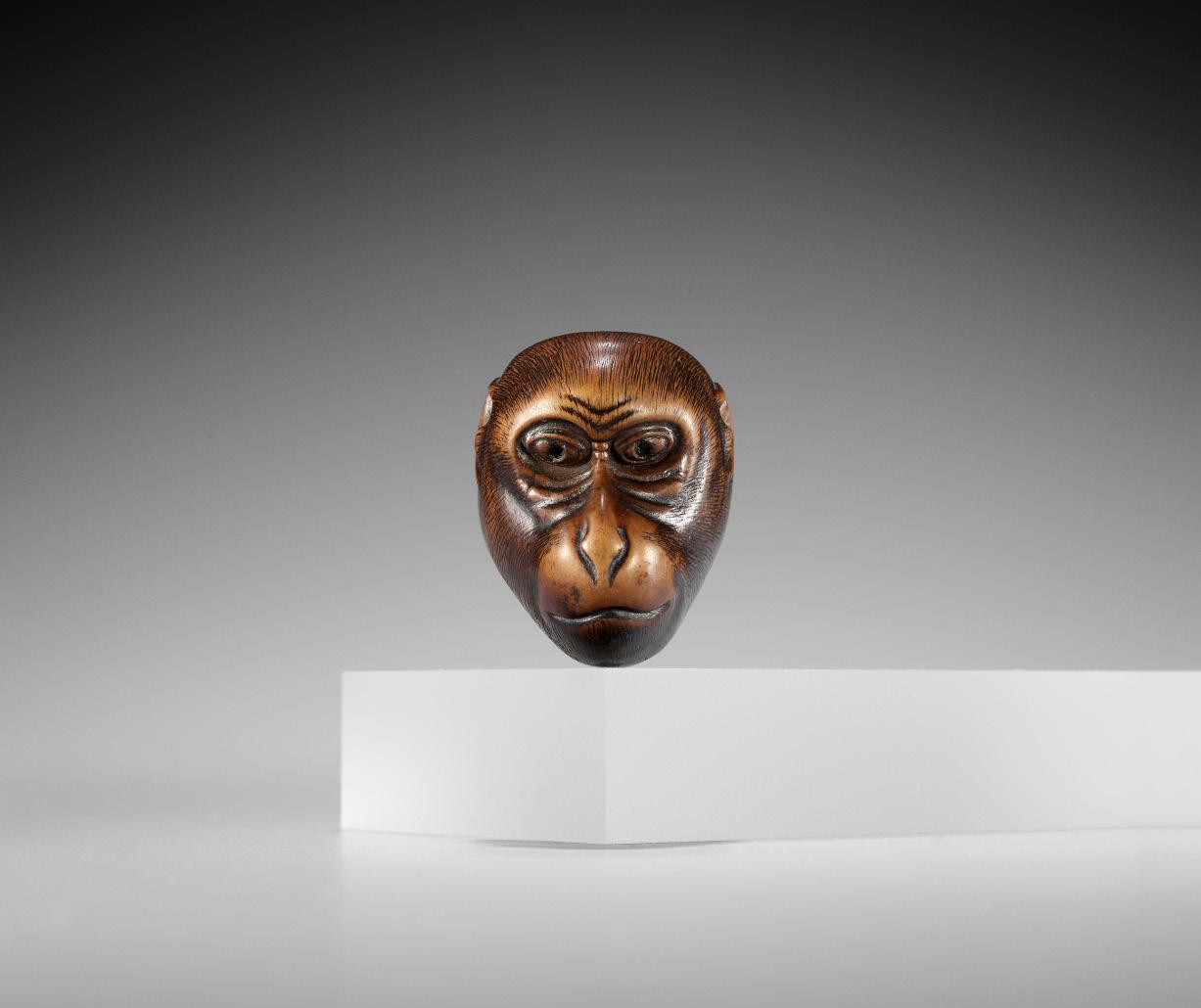
 By Ikko, signed Ikko 一光 Japan, 19th century
By Ikko, signed Ikko 一光 Japan, 19th century
A very finely carved and remarkably naturalistically modeled mask netsuke, carved as a monkey with an intelligent expression marked by almond-shaped eyes surrounded by deep wrinkles, the mouth forming a subtle smile, his fur neatly incised, the details heightened by skillful staining, the back with a looped himotoshi bar below the signature IKKO.
HEIGHT 4.1 cm
Condition: The himotoshi bar in the back repaired. Otherwise excellent condition with minor expected wear.
Provenance: European collection P. Jacquesson.
Kyogen is a form of traditional Japanese comic theater. It developed alongside Noh, was performed along with Noh as an intermission of sorts between Noh acts on the same stage and retains close links to Noh in the modern day. Its contents are nevertheless not at all similar to the formal, symbolic, and solemn Noh theater; kyogen is a comic form, and its primary goal is to make its audience laugh.
Saru, also known as Mashi, the monkey mask, is not entirely simian; it is more a humanoid simian. A realistic monkey face would not make a good Kyogen mask. As in the case of other animal masks such as the badger, fox, or dog, the monkey mask must include sufficient traces of human features for its ability to speak and understand not to cause too great a surprise.
LITERATURE COMPARISON
For related wood mask netsuke of saru, see Bushell, Raymond (1985), Netsuke Masks, pls. 172-174.
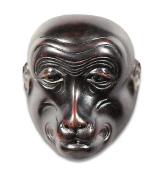
Estimate EUR 2,000
Starting price EUR 1,000
277
OKATOMO: A VERY RARE EBONY WOOD MASK NETSUKE OF AN OLD MAN (JO)
 By Yamaguchi Okatomo, signed Okatomo 岡友 Japan, Kyoto, late 18th to early 19th century, Edo period (1615-1868)
By Yamaguchi Okatomo, signed Okatomo 岡友 Japan, Kyoto, late 18th to early 19th century, Edo period (1615-1868)
Powerfully carved, the narrowed eyes with incised and raised lids, the furrowed brows well carved and sparingly incised, the mouth slightly open in a subtle smile showing teeth, the long mustache and chin beard neatly incised, the chin beard continuing to the reverse up to the himotoshi bar and forming part of the cord channel, the bar signed OKATOMO.
HEIGHT 5.1 cm
Condition: Very good condition, minor wear, few tiny nicks.
The Noh masks that served as the inspiration for the present netsuke and others like it were fitted with natural hair (usually horsehair) to indicate the mustache and beard, and sometimes also the eyebrows. The ingenious detail of the beard leading up to the himotoshi bar and forming part of the cord channel is thus a departure of the usual mode of adhering closely to the actual Noh mask that was copied in miniature by the carver.
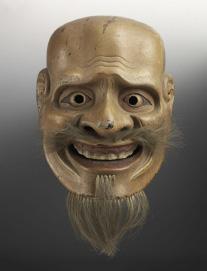
The term Jo denotes a large corpus of indigenous masks that portray old men. These masks were worn, and still are, for a myriad of agrarian fertility rituals, rites for propitiating the gods of nature, and ceremonies associated with folk festivals. They usually represent an aged deity or an apotheosized elder. In the early days of Noh, there was only a single type of Jo mask which satisfied the need for any play requiring the role of an old man, but as new plays were written there was an increasing need for a variety of masks.
Noh Mask of Amazakuro Akujo, 1700-1800, Victoria & Albert Museum, London, accession no. 578G1886
LITERATURE COMPARISON
Mask netsuke by Okatomo are extremely rare. The only recorded example is an ivory netsuke of the face of oiwa as a lantern ghost, illustrated in Harris, Victor (1987) The Hull Grundy Collection in the British Museum, p. 36, no. 92.
Estimate EUR 1,500
Starting price EUR 800
278
249
250
A RARE LACQUERED IRON MASK NETSUKE DEPICTING A TENGU SOMEN

Unsigned Japan, 19th century
Published: Rutherston, Max (2017) Japanese Masks, Peter E. Müller, no. 203.
Finely cast and assembled in sections with embossed eyebrows, wrinkles, prominent cheeks and chin, and an extended beaklike nose plate, the chin with two pegs, the exterior and interior lacquered black and reddish-brown to simulate rust. Natural himotoshi. The underside of the chin with a pierced inome (boar’s eye).

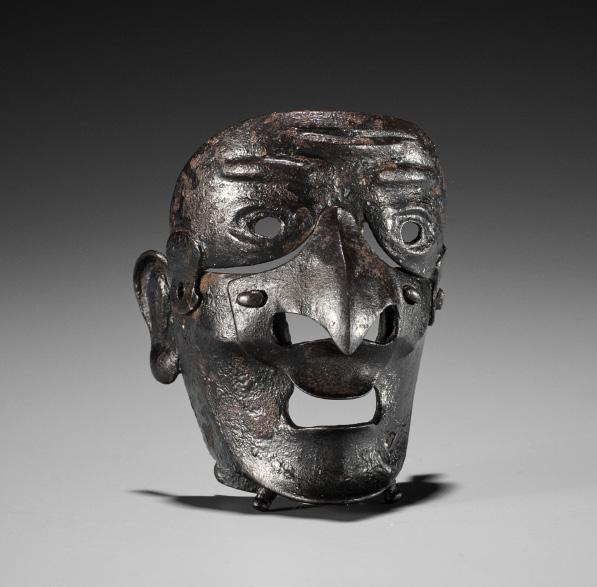
HEIGHT 5.1 cm
WEIGHT 18.5 g
A RARE MIXED METAL NETSUKE DEPICTING THE HEAD OF A NOBLEMAN
Unsigned
Japan, 19th century
Condition: Very good condition with minor and simulated wear. One rivet lost to the side.
Provenance: Ex-collection Peter E. Müller, no. 203. Matthew Barton Ltd., 6 June 2018, lot 217. European private collection P. Jacquesson, acquired from the above.
The existence of somen (full masks) goes back to the Muromachi Period but quickly declined in popularity as the full-coverage of the face was found to be uncomfortable and impractical since it did not provide any functional advantage. They continued to be made as showpieces for high-ranking lords as opposed to practical armor accoutrements. Mask netsuke of this type are very rare, the present example being possibly unique.
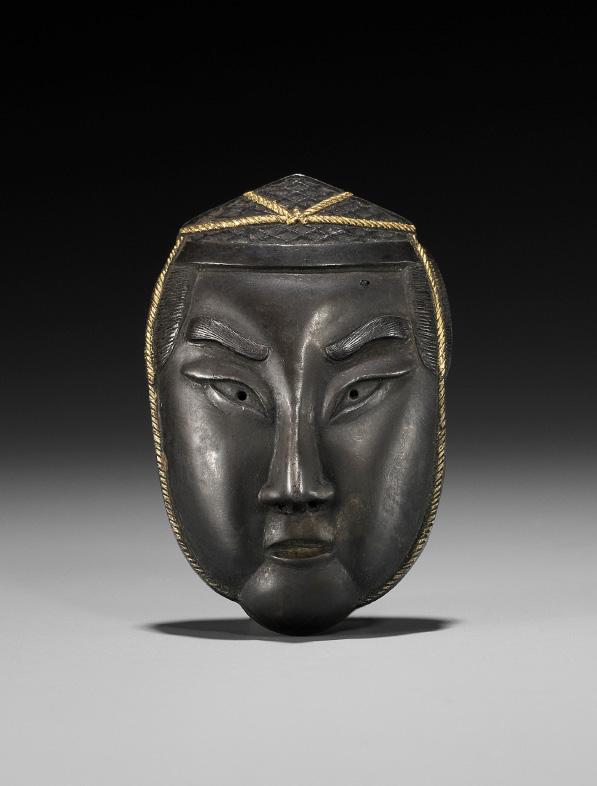
LITERATURE COMPARISON
Compare a wood netsuke depicting a menpo signed Sankyu, illustrated in Joly, Henri L. (1966) The W. L. Behrens Collection, Part 1, Netsuke, pl. III, no. 139, and in Meinertzhagen, Frederick / Lazarnick, George (1986) MCI, Part B, p. 694, where Meinertzhagen mentions a similar netsuke by Hoichi in ebony in the T. Seligman and subsequently W.W. Winkworth collection. This netsuke is also mentioned in the MCI, Part A, p. 584, where it is described as a “Mask (minus the forehead) of a Man with large nose”, indicating it is a tengu menpo. The Sankyu netsuke was also sold at Kunsthandel Klefisch, 23 May 1981, lot 189.
MUSEUM COMPARISON
Compare a lacquered iron mask inscribed by Myochin Muneakira, dated 1713, 21.7 cm high, in the Metropolitan Museum of Art, accession number 14.100.45.
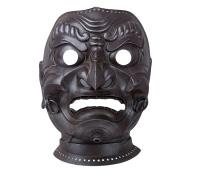
Estimate EUR 1,500
Starting price EUR 800
The face with a stern expression, marked by thick furrowed brows, intensely staring heavy-lidded eyes with pierced pupils, a long slender nose, the mouth slightly agape. The hair and eyebrows are neatly incised. The head is surmounted by a short cap with crosshatched design, secured by a gold-inlaid cord. The back with two himotoshi.
HEIGHT 5.8 cm
Condition: Very good condition with minor wear, casting irregularities, few tiny nicks.
Provenance: European private collection P. Jacquesson, acquired from Robert Fleischel in November 2014 during the Netsuke Convention in London.
AUCTION COMPARISON
Compare a related wood netsuke of the head of a samurai by Iwama Masayoshi, 4.2 cm, also dated 19th century, at Bonhams, The Edward Wrangham Collection of Japanese Art Part I, 9 November 2010, London, lot 123 (sold for 12,000 GBP).
Estimate EUR 1,500
Starting price EUR 800
279
251
252
A RARE AND UNUSUAL WOOD MASK NETSUKE OF A CICADA
Unsigned Japan, 18th-19th century, Edo period (1615-1868)
Published: Bushell, Raymond (1985), Netsuke Masks, pls. 288A and 288B.

Well carved as a resting cicada, the veining of its folded wings carved in low relief, the antennae partly covering the eyes, the legs supposedly tucked in; the reverse, however, is hollowed out like a mask netsuke and fitted with a himotoshi crossbar. The wood of a particularly attractive grain and color with distinct markings.

HEIGHT 5.5 cm
ondition: Very good condition with minor wear, tiny nicks, light scratches.
Provenance: Ex-collection Raymond Bushell. European private collection P. Jacquesson.
In his book Netsuke Masks, Raymond Bushell chose to include this unusual netsuke in the chapter Trick Mask Netsuke, noting that the “actor who represents the spirit of an insect generally wears the Usofuki mask. In this case the carver apparently preferred a realistic portrayal of the insect to the symbolic Usofuki.”
Estimate EUR 2,000
Starting price EUR 1,000
280
AN UNUSUAL AND RARE ROOTWOOD NETSUKE DEPICTING USOFUKI
Unsigned Japan, 18th-19th century, Edo period (1615-1868)
The burled and knotted rootwood of an attractive grain and color, sparingly and yet expressively worked to depict the mask of a swine-like Usofuki with lips puckered in a whistle, the flattened, polished back with two asymmetrical himotoshi.
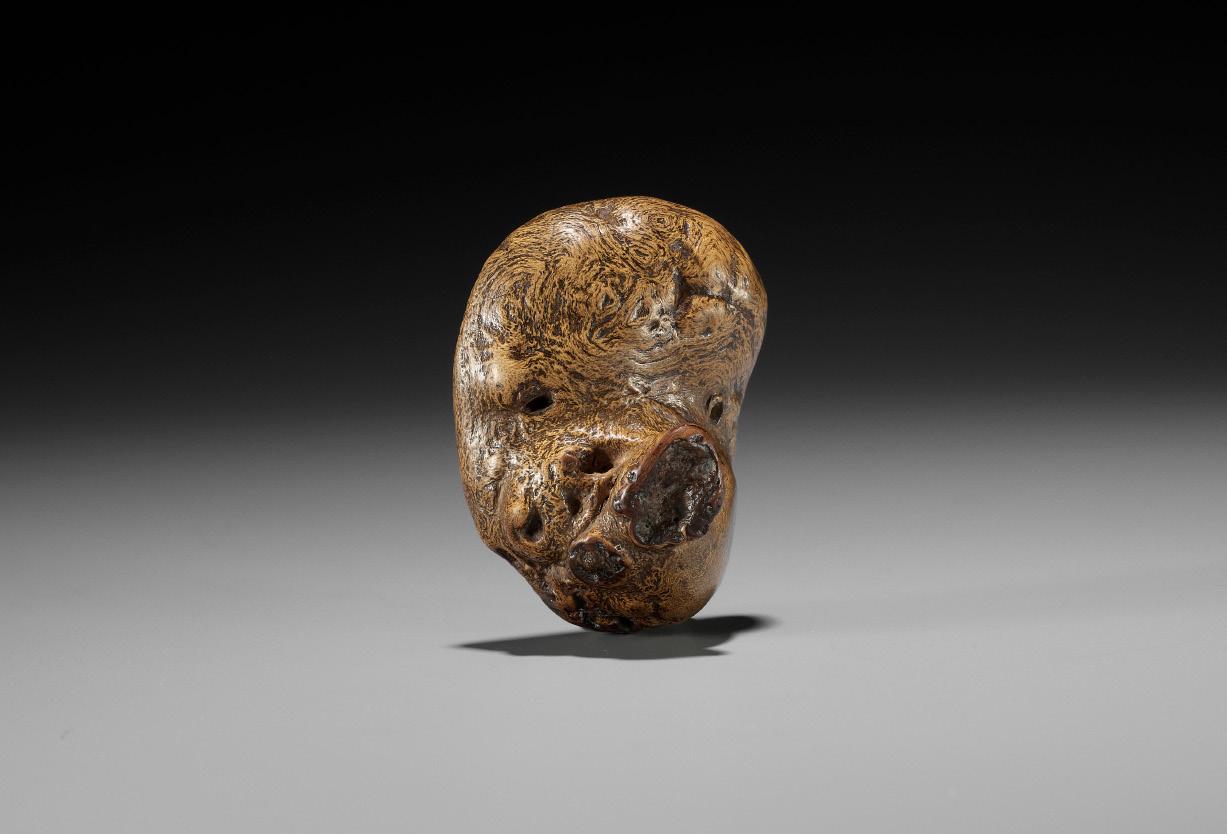

HEIGHT 5.4 cm
Condition: Excellent condition with minor wear and natural flaws.
Provenance: Kunsthandel Klefisch, 14 June 2003, Cologne, lot 751 (illustrated on p. 197). European collection P. Jacquesson, acquired from the above.
Usofuki (or Usobuki) is a Kyogen mask type which is not well standardized, but easily identifiable by the pursed or puckered lips, lending the mask (and the actor wearing it) a highly comical expression. The noun usobuki or usofuki is a gerund of the verb usobuku, which has many meanings: exhale sharply, whistle, hum, intone, howl or bay, pretend ignorance, and brag. A highly regarded ethnographer and linguist, the late Shinobu Orikuchi assigned a much earlier meaning to usobuku: taunt, oppose, and rebel. He specifically interpreted the pursed lips of old indigenous masks as signifying imminent speech, as the expression of seirei determined to speak out in defiance but constrained by the consequences of thereby acknowledging the authority of the kami.
Estimate EUR 2,000
Starting price EUR 1,000
281 253
A LACQUERED WOOD GIGAKU MASK NETSUKE OF CHIDO

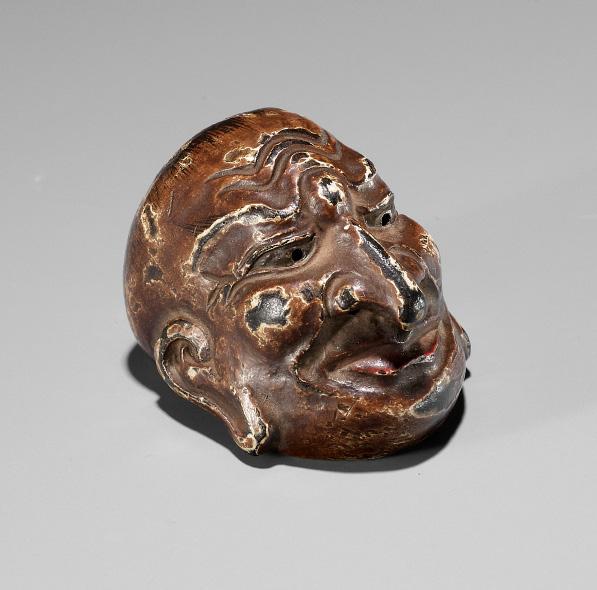
 By Kano Tessai (1845-1925), signed Tessai 銕哉 to 刀 and kakihan Japan, Nara, late 19th to early 20th century
By Kano Tessai (1845-1925), signed Tessai 銕哉 to 刀 and kakihan Japan, Nara, late 19th to early 20th century
Finely carved, the smiling face with pierced narrowed eyes and mouth, centered by a long hook nose, his facial features, ears, and wrinkles neatly incised and elegant brows neatly incised, the wood lacquered in brown, black, and red with skillfully executed simulated wear to depict an ancient mask, the himotoshi bar to the reverse signed TESSAI to with a kakihan.
HEIGHT 3.8 cm
Condition: Very good condition with minor and simulated wear. Provenance: Marsha Vargas, San Francisco, USA. Dutch private collection, acquired from the above.
Chido represents a man of impressive and dignified bearing who may have been the herald of the Gigaku pageant. See Bushell, Raymond (1985), Netsuke Masks, p. 68.
Kano Tessai (1845-1925) came from a Gifu family and started his life as a Buddhist priest, though his father instructed him in the art of carving. He studied Chinese literature and drawing and was a professor at Tokyo art school in 1872. He was also on the examining committee for investigating the ancient art of Japan and subsequently went to Nara where he engaged in the reproductions of old objects of art, such as the present example. Tessai in particular made mask netsuke copied from the Gigaku masks within the Shoso-in repository, where around 225 examples are preserved representing 15 different roles
The Shoso-in is the treasure house of the Toda-ji temple in Nara, Japan. From the very beginning, the Shoso-in has been sealed by the Imperial family. One was permitted to enter only with explicit permission from the Imperial family. Ninety-five percent of the fine arts and crafts in the Shoso-in were produced in Japan around the 8th century, with the remainder imported from the Tang Dynasty, Central Asia, India, Iran, etc. during the same period. Although these collections are not open to the public, selections are shown at Nara National Museum once a year in autumn.
Estimate EUR 1,500
Starting price EUR 800
282
254
Mask of Chido, Shoso-in repository Nara, 7th century
TETSURO: A LACQUERED WOOD
GIGAKU MASK NETSUKE OF SUIKO-JU

By Ichikawa Tetsuro, signed Tetsuro 鉄琅 and kakihan Japan, Nara, late 19th to early 20th century
Well carved, the smiling face with pierced narrowed eyes and mouth, centered by a long hook nose, his wrinkles neatly incised and elegant brows finely painted, the wood lacquered in brown, black, and red with skillfully executed simulated wear to depict an ancient mask, the himotoshi bar to the reverse signed TETSURO and kakihan.

HEIGHT 5 cm
Condition: Very good condition with minor and simulated wear. Provenance: Sachi Wagner, Midori Gallery, Miami, Florida, USA, 2 May 1990. Copy of the original invoice available. Canadian private collection, acquired from the above.
Suiko-ju is the aide-de-camp to Suiko-o, according to Raymond Bushell; “both are drunken revelers. They are either Central Asian or Iranian, but the identification is uncertain.” See Bushell, Raymond (1985), Netsuke Masks, p. 68. Suiko translates to ‘drunken barbarian’.
Ichikawa Tetsuro was a student of Kano Tessai in Nara. Like his teacher, he engaged in the reproductions of old objects of art, such as the present lot.
Literature comparison: Compare a closely related Gigaku mask netsuke by Tessai, illustrated in Meinertzhagen, Frederick / Lazarnick, George (1986) MCI, Part B, p. 866.
MUSEUM COMPARISON
A carved wood mask of Suiko-ju, dated to the 7th century (Asuka period) is in the Tokyo National Museum, no. N-223, and described as follows: “This mask can really be considered to be a laughing drunk. As the back of the head is made of the same wood, the mask covers the back of the head rather shallowly. This mask is not only more excellent than the other four Suiko-ju (N-220, N-221, N-222 and N-223 [sic]),but is also one of the most excellent masks among all the Gigaku masks.”
Estimate EUR 1,500
Starting price EUR 800
283
255
256
TESSAI: A RARE LACQUERED WOOD GIGAKU MASK NETSUKE

 By Kano Tessai (1845-1925), signed signed Tessai 銕哉 to 刀 with kakihan
By Kano Tessai (1845-1925), signed signed Tessai 銕哉 to 刀 with kakihan
Japan, Nara, late 19th to early 20th century
Published:
Hurtig, Bernard (1973) Masterpieces of Netsuke Art: One Thousand Favorites of Leading Collectors, p. 174, no. 723.
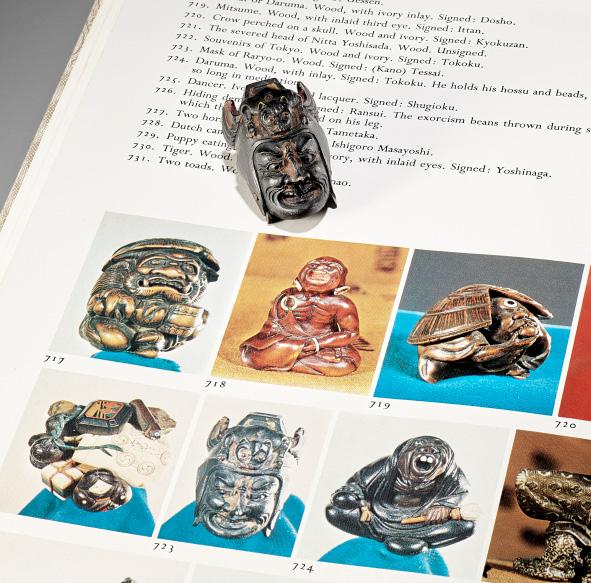
Sachi Wagner (December 1983) Okimono. Origins and Links to Netsuke, Journal of the International Netsuke Collector’s Society, Vol. 11, No. 3, p. 37, no. 25.
Finely carved as a man with a grim expression marked by furrowed brows, intense eyes, neatly incised deep wrinkles above the nose and around the mouth, which is pierced and slightly agape revealing teeth, wearing a tall cap surmounted by a very unusual winged feline creature. The mask lacquered black with accents in red and brown to simulate an ancient mask. The back with a waisted himotoshi bar signed TESSAI and kakihan.
HEIGHT 4.2 cm
Condition: Very good condition with minor and simulated wear. Provenance: Ex-collection Victor Topper. Michael Bernstein, New York, October 1997. European collection P. Jacquesson, acquired from the above.
Kano Tessai (1845-1925) came from a Gifu family and started his life as a Buddhist priest, though his father instructed him in the art of carving. He studied Chinese literature and drawing and was a professor at Tokyo art school in 1872. He was also on the examining committee for investigating the ancient art of Japan and subsequently went to Nara where he engaged in the reproductions of old objects of art, such as the present example. Tessai in particular made mask netsuke copied from the Gigaku masks within the Shoso-in repository, where around 225 examples are preserved representing 15 different roles
The Shoso-in is the treasure house of the Toda-ji temple in Nara, Japan. From the very beginning, the Shoso-in has been sealed by the Imperial family. One was permitted to enter only with explicit permission from the Imperial family. Ninety-five percent of the fine arts and crafts in the Shoso-in were produced in Japan around the 8th century, with the remainder imported from the Tang Dynasty, Central Asia, India, Iran, etc. during the same period. Although these collections are not open to the public, selections are shown at Nara National Museum once a year in autumn.
LITERATURE COMPARISON
The present mask is difficult to determine and shares some characteristics with the Ranryo-o Bugaku masks, as it shows a similar winged creature on the helmet, however this mask usually has a hinged jaw. A Gigaku mask netsuke illustrated in Bushell, Raymond (1985), Netsuke Masks, p. 70, fig. 8, provides a favorable comparison and is defined as ‘Goko’.

Estimate EUR 3,000
Starting price EUR 1,500
257
A LACQUERED WOOD MASK NETSUKE OF KOJO



Unsigned Japan, 19th century
Expressively carved, the old man with an almost ghost-like appearance, with deeply incised wrinkles around his cheeks, elegantly arched brows, and tall forehead. The narrowed eyes are pierced, as is the open mouth with two buck teeth, above the prominent chin. The mask netsuke is skillfully lacquered and carved with simulated wear to depict an ancient mask.
HEIGHT 4 cm
Condition: Very good condition with minor and simulated wear, few small nicks to the back and around the himotoshi.
The reverse with a vertically pierced himotoshi bar and a partly illegible inscription reading ‘ko[…]’.
The Kojo mask is worn by the actor portraying the old man in the first part of Takasago and in other Noh plays. The mask, embodying dignity and divinity, foreshadows the old man’s appearance in the second part as a god.

258
HO RAKUMIN: A WOOD AND LACQUER MASK NETSUKE OF A SHOJO
By Ho Rakumin (1804-1877), signed Ho Hogen 鴇 法眼 with kakihan Japan, Edo/Tokyo,
second half of 19th century
Skillfully carved as a young man, the pierced mouth opened in a charming smile revealing rows of teeth, the narrowed eyes with recessed pupils, the neatly incised eyebrows and parted hair as well as the thin lips lacquered red. The reverse with a himotoshi bar below the signature Ho Hogen with a kakihan. The artist is Ho Rakumin, for further examples bearing this signature see MCI p. 160.
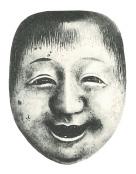
MUSEUM COMPARISON
Compare a Noh mask of Kojo, dated to the Muromachi period, 16th century, in the Brooklyn Museum, accession number 86.85.1.
Estimate EUR 1,000
Starting price EUR 500
HEIGHT 4.1 cm
Condition: Very good condition with minor wear.
Provenance: Ex-collection John and Helen Mang. Quinn’s Auction Galleries, The Mang Collection of Japanese Netsuke, 7 December 2012, Falls Church, Virginia, USA, lot 119. European collection P. Jacquesson, acquired from the above.
Shojo is used exclusively for the play Shojo (The Dancing Orangutan). Despite the name, the mask is that of a smiling youth, certainly not an ape at all. The distinguishing feature of Shojo is his overall reddish color, the color which symbolizes the drunkard. Shojo’s hair is painted downward on his forehead in thin separated strands or bangs. For his dance the actor always wears a wig of long red hair with the Shojo mask. The dance symbolizes a drunken orangutan. Some Noh schools use a group of seven dancers all wearing Shojo masks to represent the orangutan.
Ho Rakumin (1804-1877) was born in Tsuchiura in Hitachi Province (now Ibaraki Prefecture). He received the honorary title Hogen and was, together with Hojitsu, one of the best netsuke carvers in Tokyo.
LITERATURE COMPARISON
Compare a related wood netsuke, also with red hair, by Keizan, illustrated in Joly, Henri L. (1966) The W. L. Behrens Collection, Part 1, Netsuke, pl. IV, no. 186, and in Meinertzhagen, Frederick / Lazarnick, George (1986) MCI, Part A, p. 321.
MUSEUM COMPARISON
A polychrome wood mask of Shojo, dated to the Muromachi period, 15th-16th century, is in the Tokyo National Museum, collection reference no. C-1535.
Estimate EUR 2,000
Starting price EUR 1,000
285
YOZEI:
A RARE LACQUERED IVORY HAKO (BOX) AND COVER IN THE FORM OF AN OKAME MASK, DATED 1705 BY INSCRIPTION
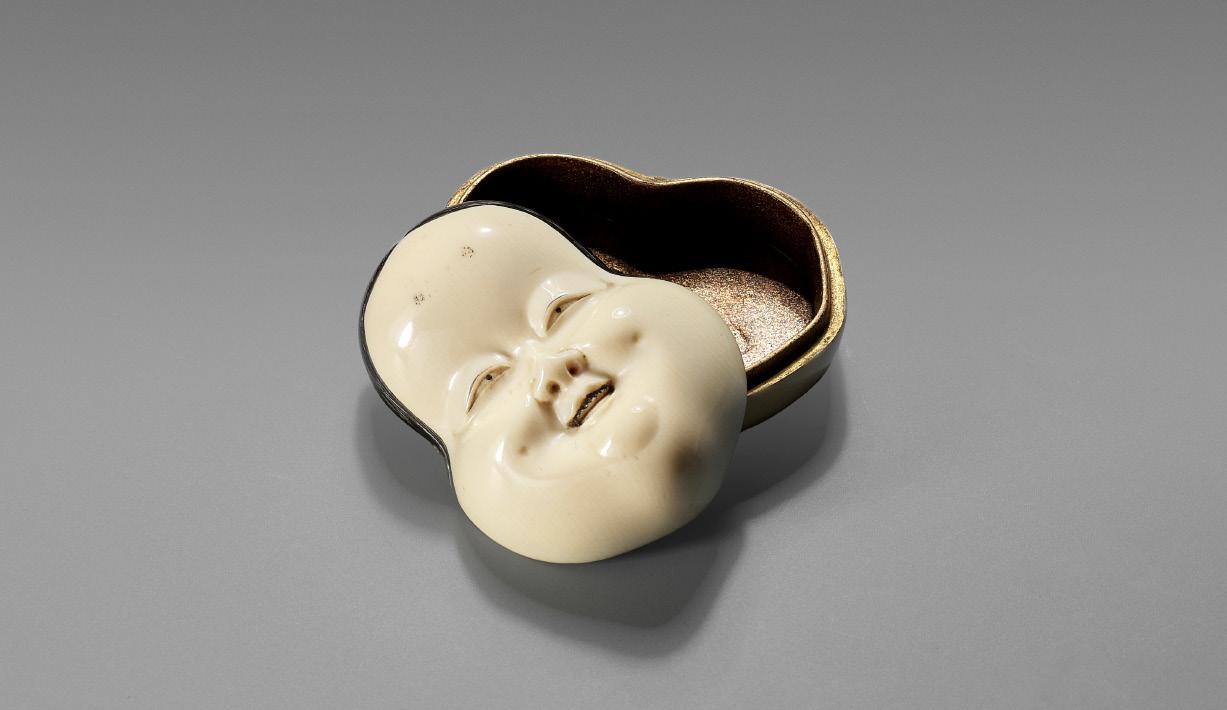
 By Tanaka Yozei (Yosei), signed Tanaka Yozei 田中陽成 with seal Tanaka 田中 Japan, dated
By Tanaka Yozei (Yosei), signed Tanaka Yozei 田中陽成 with seal Tanaka 田中 Japan, dated
1705
Published: Gabor Wilhelm (Winter 2006) On the Continent, International Netsuke Society Journal, vo. 26, no.4, p. 39.
Well carved as a typically plump-faced Okame with narrowed eyes and mirthful smile, framed by tresses of black lacquer. The interiors of nashiji with gold fundame edges, the interior of the cover with a himotoshi loop, the base with a central himotoshi and inscribed in gold lacquer Hoei ni, kinoto-tori, chushun no haru motome ni yotte tsukuru kore, TANAKA YOZEI (This is made on commission by request, in the mid-spring in the second year of the Hoei era (1705), by Tanaka Yozei) with a tsuishu lacquer pot-seal mark in the form of a bronze metal tripod censer reading TANAKA. Beautiful, deepyellow patina, particularly to the underside.
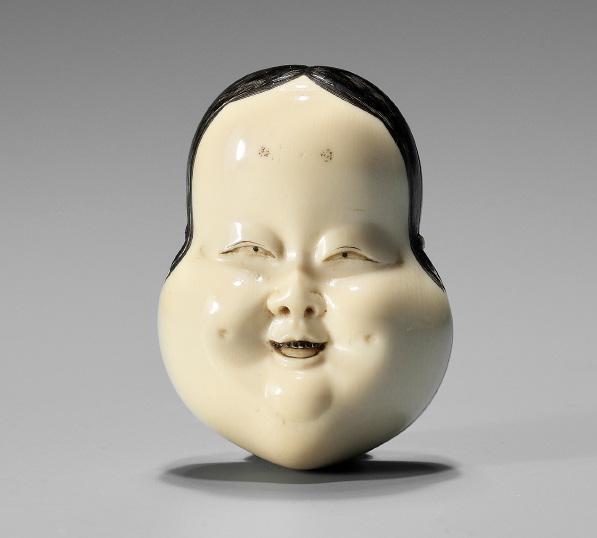
LENGTH 5.1 cm
Condition: Very good condition with minor wear, minimal loss to black lacquer.
Provenance: Nagel, 19 May 2006, Stuttgart, lot 2798. European private collection P. Jacquesson, acquired from the above.
Okame (or Otafuku) represents a lovely, always smiling Japanese woman who brings happiness and good fortune to any man she marries. She is also known as the Goddess of Mirth and is a very popular image in Japanese culture. Otafuku literally means ‘much good fortune’, and Okame means ‘tortoise’, which is also an auspicious symbol of longevity, as tortoises lead long lives.
Yozei, sometimes also written as Yosei, was the hereditary name given to a famous family of lacquerers, which dated back to the mid-fourteenth century and which specialized in tsuishu in the style of Chinese carved lacquers. Jahss writes that their tsuishu “far surpasses the Chinese work in richness and color, beauty, skill of carving and variation of design”. The artist family is listed in Wrangham, (1995) The Index of Inro Artists, pp. 331-332.
Estimate EUR 3,000
Starting price EUR 1,500
286
259
260
AN IVORY MASK NETSUKE DEPICTING OF AN OLD MAN (JO), ATTRIBUTED TO MITSUYUKI


Attributed to Yamaji Mitsuyuki, unsigned Japan, 19th century, Edo period (1615-1868)
Published: Bushell, Raymond (1985), Netsuke Masks, pl. 97.

Finely carved with a pained expression as the old man cries out with the mouth wide open, his hair tied over the brow and his long beard, which is usually applied with horsehair to the actual mask, trailing to one side, all neatly incised and skillfully stained with sumi-e. The reverse with a broad himotoshi bar pierced both vertically and horizontally, the horizontal cord hole with a chrysanthemum design. The ivory beautifully stained and bearing a warm patina.
HEIGHT 4.5 cm
Condition: Very good condition with minor wear and few tiny age cracks. Rich honey-yellow patina.
Provenance: Ex-collection Raymond Bushell. Christie’s, The Raymond and Frances Bushell Collection of Netsuke, Part II, 18 October 1988, New York, lot 107. Ex-collection Bluette H. Kirchhoff, acquired from the above. Bonhams, The Bluette H. Kirchhoff Collection of Netsuke and Sagemono, 16 September 2009, New York, lot 2133. European collection P. Jacquesson, acquired from the above.
The term Jo denotes a large corpus of indigenous masks that portray old men. These masks were worn, and still are, for a myriad of agrarian fertility rituals, rites for propitiating the gods of nature, and ceremonies associated with folk festivals. They usually represent an aged deity or an apotheosized elder. In the early days of Noh, there was only a single type of Jo mask which satisfied the need for any play requiring the role of an old man, but as new plays were written there was an increasing need for a variety of masks. The chief characteristic of Jo masks is the locks of hair brought up from the sides and tied in a type of bow, or double loop, just above the forehead.
MUSEUM COMPARISON
Compare a related ivory netsuke by Yamaji Mitsuyuki, with a similar pained expression and open mouth, formerly in the collection of Raymond Bushell and now in the Los Angeles County Museum of Art, accession number AC1998.249.257.



AUCTION COMPARISON
Compare to a closely related ivory netsuke of Oiwa, by Mitsuyki, at Zacke, Fine Netsuke & Sagemono, 4 November 2022, Vienna, lot 85 (sold for 4,860 EUR).
Estimate EUR 2,500
Starting price EUR 1,200
287
Sanko-jo Noh mask by Deme Mitsutaka, 19.8 cm high, dated 18th century, Fukuoka City Museum
261

HOKEI: A MASTERFUL TSUISHU (RED LACQUER) MASK NETSUKE OF A SHOJO
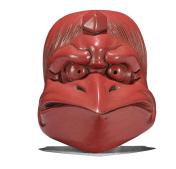

 By Matsuki Hokei, signed Hokei 宝桂 Japan, Tokyo, late 19th century, Meiji period (1868-1912)
By Matsuki Hokei, signed Hokei 宝桂 Japan, Tokyo, late 19th century, Meiji period (1868-1912)
Published:
Hurtig, Bernard (1973) Masterpieces of Netsuke Art: One Thousand Favorites of Leading Collectors, p. 212, no. 899. Davey, Neil K. (1974) Netsuke: A comprehensive study based on the M.T. Hindson Collection, p. 162, no. 485.
Exquisitely and comically modeled with the face creased into a grimace as he stares upward with round eyes and recessed pupils, framed by long flowing hair with neatly incised strands, the mustache similarly incised, the various layers of lacquer clearly delineated and the reverse lacquered black save for the redlacquered edges and himotoshi bar signed HOKEI.
HEIGHT 5.2 cm
Condition: Very good condition with minor wear to lacquer. Provenance: Ex-collection E. Evelyn Barron. Ex-collection Mark T. Hindson. Sotheby’s, The M. T. Hindson Collection of Important Japanese Works of Art, Part VIII (Final), London, 20 October 1969, lot 253. Ex-collection Edward A. Wrangham, acquired from the above. Bonhams, The Edward Wrangham Collection of Japanese Art Part II, 10 May 2011, London, lot 98 (sold for GBP 4,800). Ex-collection Robert Fleischel, acquired from the above. European collection P. Jacquesson, acquired from the above.
Shojo is used exclusively for the play Shojo (The Dancing Orangutan). Despite the name, the mask is that of a smiling youth, certainly not an ape at all. The distinguishing feature of Shojo is his overall reddish color, the color which symbolizes the drunkard. This crucial feature to the mask obviously lends itself well to the medium of carved red lacquer. The present mask netsuke, however, presents Shojo in a rather unique way, with a distinctive grimace instead of the usual smile.
Matsuki Hokei was perhaps the most famous and certainly one of the finest workers in tsuishu (carved red lacquer). His figures in this material are comparable to the finest wood and ivory Netsuke, the various layers of lacquer used to denote highlights in some cases. The work is always well-finished. He taught several pupils whose work was similar but lacking the finesse of the master. See Davey, Neil K. (1974) Netsuke: A comprehensive study based on the M.T. Hindson Collection, p. 161.
LITERATURE COMPARISON
Compare a related tsuishu mask netsuke of a grimacing male mask, 4.8 cm high, dated 19th century, illustrated in Eskenazi (1998) Japanese netsuke, ojime and inro from a private European collection, p. 63, no. 66.
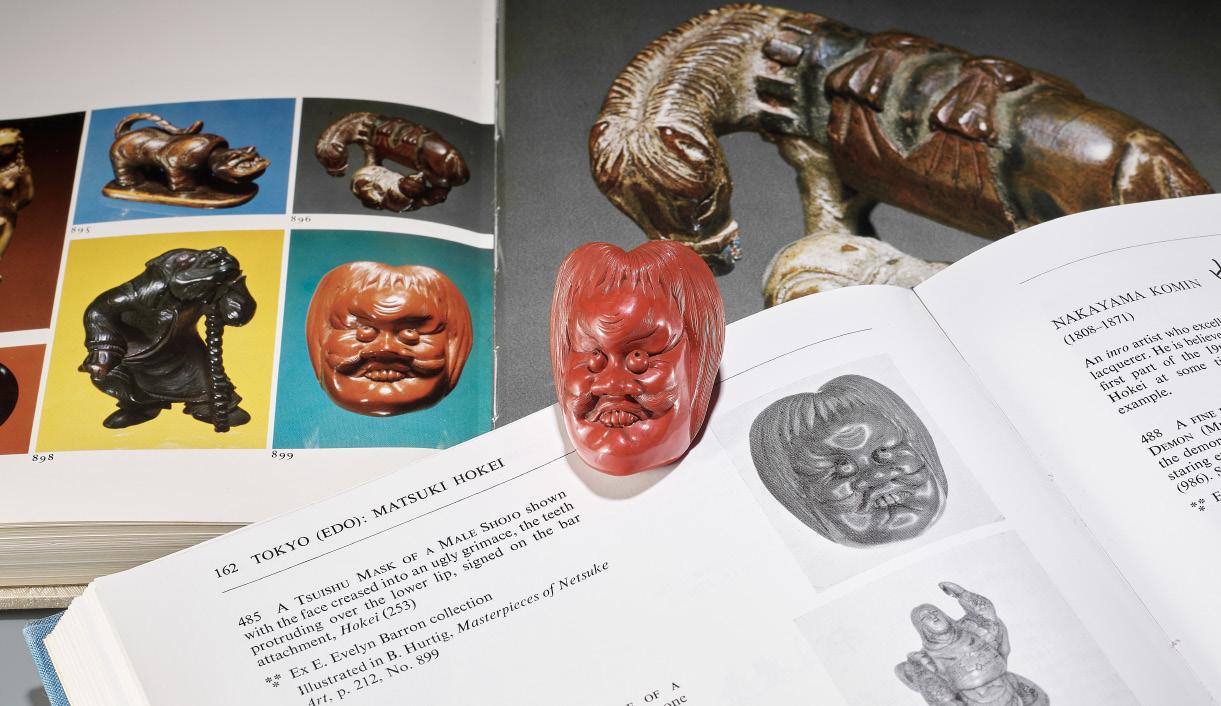
AUCTION COMPARISON
Compare to a related tsuishu mask netsuke of a tengu, by Somin, at Zacke, Fine Netsuke & Sagemono, 16 April 2021, Vienna, lot 283 (sold for 9,150 EUR).
Estimate EUR 8,000
Starting price EUR 4,000
288
Mark T. Hindson

JOKO: A RARE TSUISHU (RED LACQUER) BUGAKU MASK NETSUKE OF GENJORAKU


 By Joko, signed Joko 如光 Japan, Tokyo, second half of 19th century
By Joko, signed Joko 如光 Japan, Tokyo, second half of 19th century
Well carved with staring eyes beneath heavy eyebrows, the mouth wide open in a scream showing teeth, the pupils, brows, and mustache neatly incised, the reverse lacquered black save for the waisted himotoshi bar signed to one side JOKO.
HEIGHT 4.6 cm
Condition: Excellent condition with only very minor wear to lacquer.
Provenance: Ex-collection Edward Wrangham. Bonhams, The Edward Wrangham Collection of Japanese Art Part I, 9 November 2010, London, lot 180. A Princely Collection, acquired from the above.
In the Bugaku dance known as Genjoraku, a barbarian dances around a wooden model of a snake, rejoicing at having caught one of his favorite delicacies. Thought to have originated in India, this
dance eventually was regarded as an auspicious dance to perform upon the return of an emperor to his palace, and thus was named Genjoraku, meaning ‘Return visit of a High Personage’. Performed as early as the Nara period, Genjkoraku developed as a companion to the Bato dance.
LITERATURE COMPARISON
Compare a related tsuishu mask netsuke of an oni by Joko, dated late 19th century, illustrated in Davey, Neil K. / Tripp, Susan G. (1993) The Garrett Collection, p. 141, no. 105 (together with an inro and ojime), where the authors note that “[o]nly one other netsuke by Joko has been recorded, a red lacquer mask in the Brockhaus collection”.
AUCTION COMPARISON
Compare a related tsuishu maks netsuke from the same school, by Soyo, depicting Okame, at Zacke, Fine Netsuke & Sagemono, 29 October 2021, Vienna, lot 265 (sold for 5,056 EUR).
Estimate EUR 3,000
Starting price EUR 1,500
290 262
A FINE LACQUER MASK NETSUKE OF OKAME
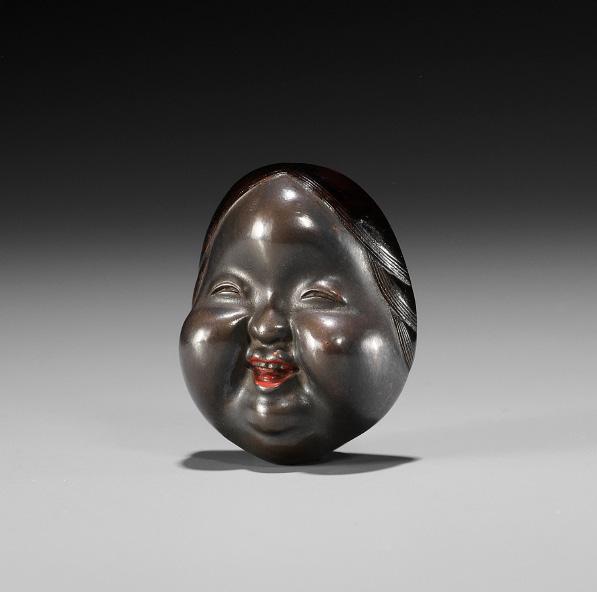
Unsigned Japan 19th century
264 SOSHI: A FINE JOSO SCHOOL WOOD MASK NETSUKE OF A GROUP OF MASKS


 By Soshi, signed Soshi 藻之 to 刀 Japan, Tokyo, late 19th to early 20th century
By Soshi, signed Soshi 藻之 to 刀 Japan, Tokyo, late 19th to early 20th century
Published: Bushell, Raymond (1985), Netsuke Masks, pls. 272A and 272B.
Finely carved as an Okame mask and an upside-down Okina mask side by side, both with smiling expressions and of typical appearance, the Okina bucktoothed, the Okame with neatly incised strands of hair, backed by an oni mask with bulging eyes and a prominent wide nose, the large flaring nostrils forming the ‘natural’ himotoshi, the chin signed SOSHI to [carved by Soshi].
LENGTH 3.3 cm
Condition: Excellent condition with only very minor wear. Provenance: Ex-collection Raymond Bushell. Sotheby’s New York, 21 March 2000, New York, lot 303. European private collection P. Jacquesson, acquired from the above.
Published:
Davey, Neil K. (1974) Netsuke: A comprehensive study based on the M.T. Hindson Collection, p. 423, no. 1262.

Eskenazi (1998) Japanese netsuke, ojime and inro from a private European collection, p. 58, no. 57.
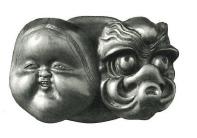
Finely modeled with characteristic plump cheeks and mirthful smile, her eyes narrowed in laughter. The silver-lacquered face framed by tresses of black lacquer, the lips and tongue lacquered red, the reverse brown with a bar pierced with a single himotoshi of circular form with a slightly raised rim.
HEIGHT 3.5 cm
Condition: Excellent condition with minor wear.
Provenance: Ex Guest collection, no. 1315.
Ex-collection Mark T. Hindson. Sotheby’s, The M. T. Hindson Collection of Important Japanese Works of Art, Part VIII (Final), London, 20 October 1969, lot 170. Ex-collection Emiel Veranneman, acquired from the above. Eskenazi, London, 1998. Sotheby’s, May 2007, London. European collection P. Jacquesson, acquired from the above.
Estimate EUR 2,000
Starting price EUR 1,000
Soshi was a netsuke artist from the Joso school whose work is rarely seen. Most of his netsuke are masks, with his signature engraved on a himotoshi crossbar. The present netsuke, however, does not have a crossbar and is signed to the chin of the Oni mask.

LITERATURE COMPARISON
Compare a related wood netsuke by Joso, depicting three masks representing Okame, Suguchi, and Akuso, 3.8 cm long, illustrated in Coullery, MarieTherese / Newstead, Martin S. (1977) The Baur Collection, p. 260, C 763. Compare a closely related wood netsuke by Sokyu, also depicting masks of Okame, Okina, and Oni, and also with Oni’s nostrils forming the himotoshi and the signature found on his chin, illustrated in Galerie Zacke, Netsuke. Die Sammlung Frank Pingotti, 1998, no. 120.
AUCTION COMPARISON
Compare a related wood group of three masks, depicting masks of Okame and Oni backed by that of Buaku, by Morita Soko, 3.5 cm, dated late 19th to early 20th century, at Sotheby’s, The Swedlow Collection of Inro, Lacquer and Ojime, 31 March 1993, London, lot 83.
Estimate EUR 1,500
Starting price EUR 800
263
Mark T. Hindson
265
A LACQUER NETSUKE OF A CLUSTER OF MASKS

Unsigned Japan, 19th century
Finely carved and lacquered in gold, silver and red maki-e, depicting a cluster of masks including Okame, Hannya, kitsune, Hyottoko and a long-nosed tengu. Natural himotoshi.
LENGTH 3.8 cm
Condition: Excellent condition with minor wear to lacquer.
Provenance: Canadian private collection, purchased from Orientations Gallery, New York.
Estimate EUR 1,200
Starting price EUR 600
266 KOMA: A LARGE LACQUER MANJU NETSUKE WITH SARU MASK

By a member of the Koma school of lacquerers, signed Koma 古滿 and kakihan Japan, 19th century, Edo period (16151868)
A large two-part manju netsuke, bearing a black-lacquered ground with sparsely sprinkled maki-e flakes, the front decorated with a fine iro-e takamaki-e saru mask, the eyes double inlaid in crystal with black pupils. The reverse shows a striking design of interlocking circles executed in gold takamaki-e. With a large silver-lined himotoshi to the back, the cord attachment to the nashiji interior.
DIAMETER 4.9 cm
Condition: Very good condition with minor wear to lacquer on the inside and a small loss to the interior silver-lined cord hole.
Provenance: The Collection of Gloria and Joe Kurilecz, Westchester County, New York.
Estimate EUR 1,500
Starting price EUR 800
292
267
AN EXCEPTIONAL LACQUER NETSUKE OF A KONOHA TENGU MASK WRAPPED IN A FUROSHIKI



Unsigned Japan, 19th century
Finely modeled as a long-nosed tengu mask lacquered red with black and gold lacquer details, the back of the mask with ishimenuri, the mask wrapped in a gold-lacquered furoshiki decorated with gold sprinkles and very fine takamaki-e maple leaves, the cloth tied in a meticulously executed bow below the nose, the back with good asymmetrical himotoshi, the larger of which is of oval shape.
Condition: Excellent condition with minor wear.
Provenance: Ex-collection Edward Wrangham. Ex-collection Edward Wrangham. Bonhams, The Edward Wrangham Collection of Japanese Art Part I, 9 November 2010, London, lot 178 (sold for 4,200 GBP). A Princely Collection, acquired from the above.
LITERATURE COMPARISON
Compare a related, yet less fine lacquer netsuke depicting a Konoha Tengu mask wrapped in a furoshiki by Kokuzan, dated 18th century, illustrated in Davey, Neil K. / Tripp, Susan G. (1993) The Garrett Collection, p. 285, no. 402.

Estimate EUR 4,000
Starting price EUR 2,000
293
LENGTH 4.4 cm
MORIKAWA TOEN: AN EXCEPTIONAL PAINTED WOOD NETSUKE OF AN ACTOR IN THE ROLE OF THE FOX PRIEST HAKUSOZU

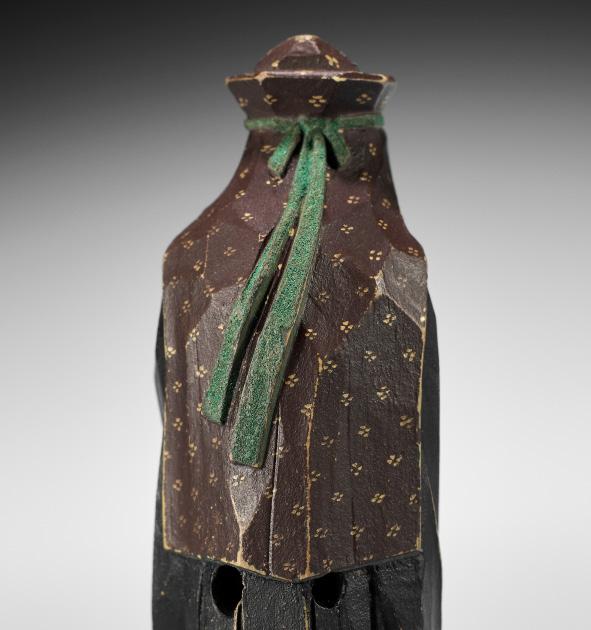
By Morikawa Toen (1820-1894), signed with the artist’s kakihan Japan, Nara, second half of 19th century
Published:
Okada, Barbara Teri & Neill, Mary Gardner (1980) Real and Imaginary Beings: The Netsuke Collection of Joseph and Edith Kurstin, p.110, no.116.
Kurstin, Joseph & Ortega, Maria (1986) Masterworks of Netsuke and Other Japanese Miniature Art from American Collections, p.57, no.70.

Kurstin, Joseph & Lorin, Gilles Feather (2006) The Peacock’s Gentlemen’s Jewelry of Old Japan, Delray Beach, Art Media Resources, p.23, no. 10.
Yoshida, Yukari & Kurstin, Joseph, Questions & Answers (2007) International Netsuke Society Journal (INSJ) vol.27, no.1, p. 13, fig.4.
Exhibited:
Yale University Art Gallery, February 28-April 12, 1980

Morikami Museum and Japanese Gardens, Delray Beach, Florida, January 10-March 18, 2007
A masterpiece of ittobori (single cut) technique, the actor in the guise of a fox priest, playing the role of Hakusozu, wearing a mask, almost completely enveloped in an elaborate robe with headdress, leaning against a cane and holding prayer beads. The netsuke is treated with various polychrome pigments which are in perfect harmony with each other. Asymmetrical himotoshi to the back and signed with the artist’s kakihan.
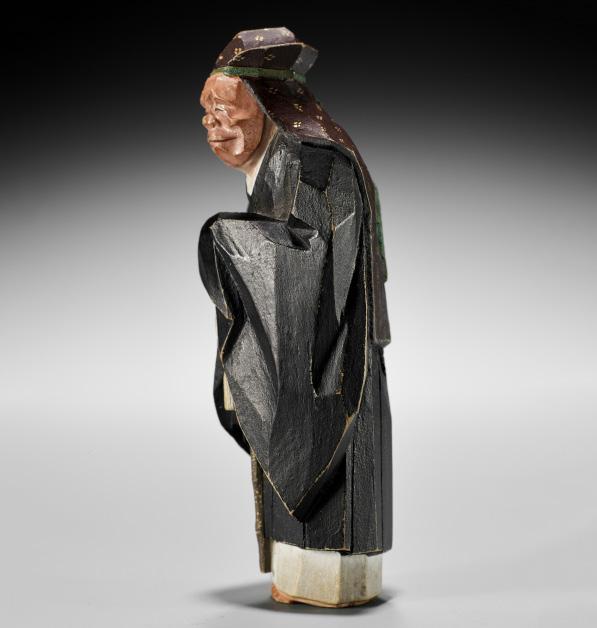
HEIGHT 8.9 cm
Condition: Excellent condition with only very minor wear to exposed edges.
Provenance: Ex-collection Joe Kurstin. Dr. M. Joseph ‘Joe’ Kurstin (1931-2021) was a prominent Miami ophthalmologist who arguably built one of the greatest netsuke collections of all time. He was known by netsuke and inro lovers worldwide and made many lifelong friends in this tight-knit community. He published several books and articles on the subject and generously lent his collection for exhibitions at the Yale University Gallery, Museum of Fine Arts, Boston, Epcot Center at Disney World, and The Tobacco and Salt Museum, Tokyo.
LITERATURE COMPARISON
Compare to another netsuke depicting the same subject, by Morikawa Toen, however executed in a different style, in Bushell, Raymond (1993) An Introduction to Netsuke, p. 76, pl. 29.
MUSEUM COMPARISON
A closely related netsuke depicting the same subject by Morikawa Toen, also signed with the artist’s kao, is in the Los Angeles County Museum of Art (LACMA), accession number AC1998.249.159.

Hakuzosu is the name of a popular kitsune character who shapeshifted into a priest in the Kyogen play Tsurigitsune.
Morikawa Toen was known for his Nara ningyo (dolls) sculptures and as a noh actor. His work was admired by the Daimyo of Tosa, the magistrate of Nara, who awarded him with names from Japanese mythology. The Imperial household also became his patrons. He received many prizes throughout his career and was later commissioned by the newly founded Tokyo Imperial Museum to make copies of ancient works of art.
Estimate EUR 8,000
Starting price EUR 4,000
294
268
Elena and Joseph Kurstin

269
A RARE LACQUER NETSUKE OF A GOSHO NINGYO DOLL PERFORMER
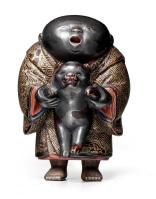
Unsigned Japan, late 19th century
270
A RARE GOLD LACQUER NETSUKE OF A GOSHO NINGYO DOLL AS KADORI MYOJIN
Unsigned Japan, late 19th century
A charming netsuke worked in lustrous gold kinji lacquer with red and black highlights, depicting a fat boy holding a huge hyotan (double gourd) and trying to tame a black-lacquered Namazu catfish underneath. Two himotoshi through the boy’s back.
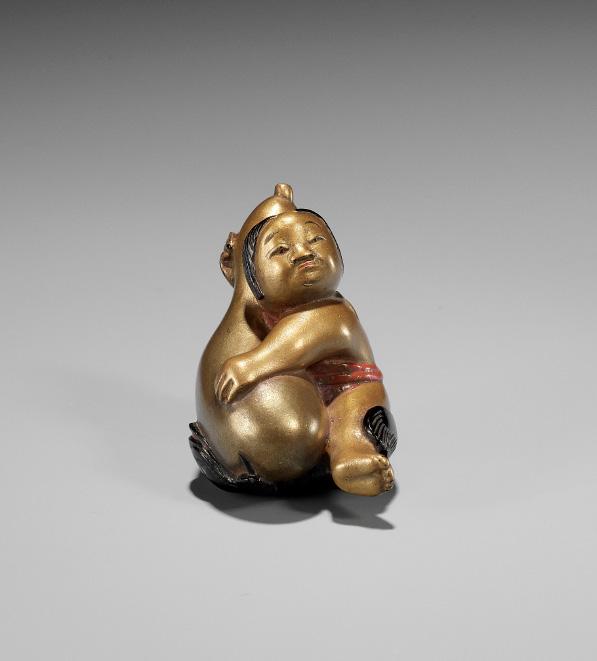


The gosho ningyo performer lacquered in gold, silver, and red, the face typically enlarged and chubby with red lips, placing one hand on its head and the other holding a bell tree. The doll’s robe is embellished with various ornate patterns such as geometric designs, leaves and plovers. Large, asymmetrical himotoshi to the back.
HEIGHT 4.5 cm
Condition: Chip to one foot, one loss to the knee and a repair to the bell tree. Otherwise fine condition with minor wear to lacquer.
Gosho ningyo are characterized by their chubby figures, fair skin, small hands and legs, their large heads, and simple eyes and noses. Their history goes back some 400 years, when they were treasured in the Imperial court. Over time they became expressions of hope for happiness and prosperity in life.
Literature comparison: A closely related lacquer netsuke depicting a Gosho ningyo is illustrated in Bushell, Raymond Netsuke (1975) Familiar & Unfamiliar, p. 109, no. 111.
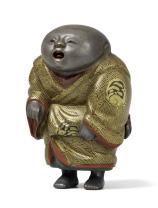
AUCTION COMPARISON
Compare to a lacquer netsuke of a boy from the same workshop, at Lempertz, Asian Art, 27 June 2020, Cologne, lot 317 (sold for 4,000 EUR). Another lacquer netsuke from the same workshop was sold at Bonhams, Netsuke from the Collection of Joseph and Elena Kurstin, 16 December 2022, New York, lot 17 (sold for 10,200 USD).
Estimate EUR 1,500
Starting price EUR 800
HEIGHT 3.6 cm
Condition: Very good condition with minor traces of use and wear to lacquer.
Legend has it that certain types of catfish (namazu) are responsible for the earthquakes that plague the islands of Japan. When aroused, these creatures would contort their bodies in such a way that gigantic tremors shook the area for miles and miles. The Shinto deity Kadori Myojin usually attempts to prevent such catastrophes with the help of his magic gourd.
Gosho ningyo are characterized by their chubby figures, fair skin, small hands and legs, their large heads, and simple eyes and noses. Their history goes back some 400 years, when they were treasured in the Imperial court. Over time they became expressions of hope for happiness and prosperity in life.
Estimate EUR 1,500
Starting price EUR 800
271
A RARE LACQUER NETSUKE OF ONIWAKAMARU SLAYING THE GIANT CARP
Unsigned Japan, late 19th century
Depicting Oniwakamaru wrestling with a giant carp, a knife in his mouth, standing on the fish’s tail. The netsuke is worked in variously colored lacquer and the boy’s robe is ornately detailed with various patterns, typical for this workshop which produced these enigmatic lacquered katabori netsuke in the latter half of the 19th century. Two himotoshi underneath the boy’s obi.


HEIGHT 4.9 cm
Condition: Good condition with minor typical wear to lacquer. A crack through the left hand.
Provenance: Old Viennese private collection assembled within the same family over three generations.
272
A RARE AND UNUSUAL INLAID AND LACQUERED WOOD NETSUKE OF DAIKOKU
Unsigned Japan, 19th century
Depicting the lucky god seated, holding and marveling at a large two-pronged daikon (radish), the hands and vegetable inlaid in marine ivory, his iron-inlaid face with an amusing expression, the eyes of gilt. Some details such as his cap and the patterns on his robe are lacquered in gold kinji takamaki-e. The underside with large and generously excavated himotoshi.
HEIGHT 3.7 cm
Condition: Good condition, minor expected wear to lacquer. Structurally inherent crackling to the lacquer around the iron-inlay. Provenance: Austrian private collection, purchased from Max Rutherston Ltd., London.
Estimate EUR 1,500
Starting price EUR 800
Oniwakamaru or ‘young devil child’ was the nickname given to the young warrior monk Musashibo Benkei (1155-1189) because of his enormous strength and violent nature. This netsuke shows the young boy attacking and slaying the giant red carp that swallowed his mother.
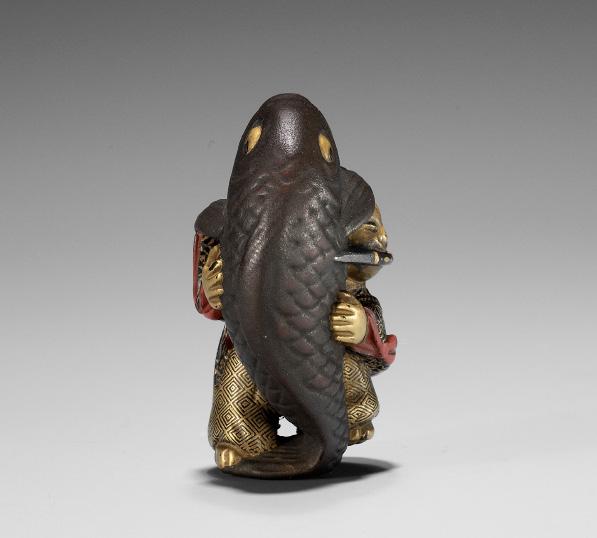
Auction comparison: Compare to a lacquer netsuke of a boy from the same workshop, at Lempertz, Asian Art, 27 June 2020, Cologne, lot 317 (sold for 4,000 EUR). Another lacquer netsuke from the same workshop was sold at Bonhams, Netsuke from the Collection of Joseph and Elena Kurstin, 16 December 2022, New York, lot 17 (sold for 10,200 USD).
Estimate EUR 2,000
Starting price EUR 1,000
Saito Oniwakamaru on a Carp, Tsukioka Yoshitoshi (1839-1892), LACMA accession no. M.84.31.43

297
A POWERFUL AND EARLY TSUISHU LACQUER NETSUKE OF A SHISHI ON BASE
Unsigned Japan, 18th century, Edo period (1615-1868)
A powerfully sculpted netsuke, bulky and heavy, depicting a Buddhist lion curled up on a base, with neatly incised fur and sweeping tail, floppy ears, reishi nose, the mythical animal turnings its head and snarling. The base is incised with a key fret design to the sides and with an asanoha pattern to the underside. Two himotoshi underneath.
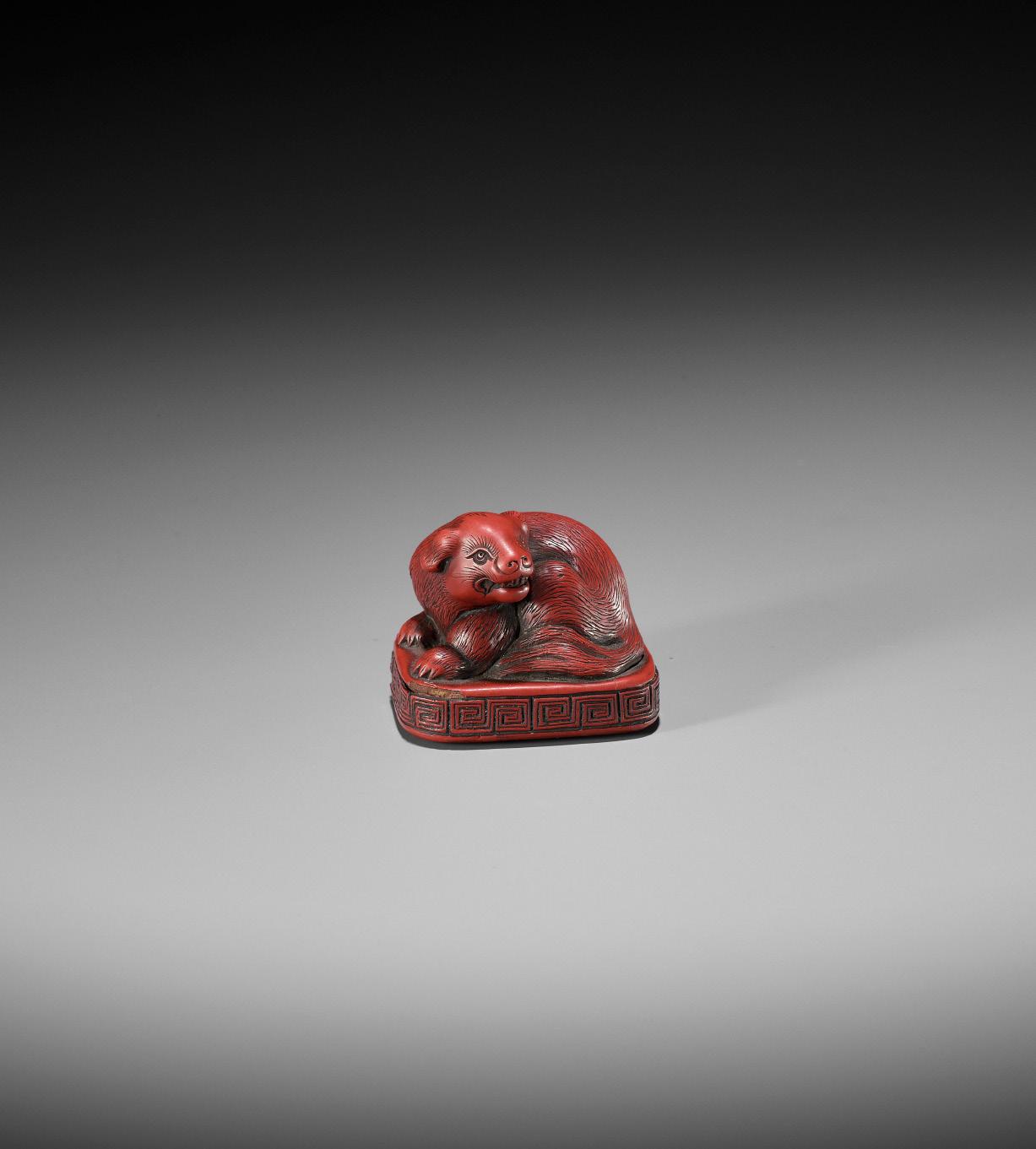
LENGTH 3.5 cm, HEIGHT 3 cm
Condition: Worn condition with losses to lacquer and some crackling.
Provenance: Ex-collection Conte Don Enrico Lucchesi Palli, Monarch of Campofranco. Purchased in 1889, when he accompanied his cousin Enrico (Henry), Prince of Parma, Earl of Bardi, on a tour of the world from 1887-1891. Thence by descent within the same family.
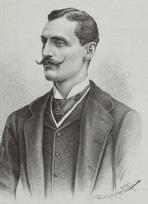
Estimate EUR 2,000
Starting price EUR 1,000
298
273
Conte Don Enrico Lucchesi Palli (18611924)
A RARE TSUISHU LACQUER NETSUKE OF A CAT
Unsigned Japan, 19th century, Edo period (1615-1868)
Finely carved and lacquered in tsuishu (red lacquer) as a fat reclining cat lifting its right front paw to its mouth and eating in a somewhat anthropomorphic manner. The domestic cat wears a knotted collar, its tail curls around over its back, and the fur is neatly incised. The circular base with a concentric band of asanoha incision work which is continued on the underside. Very large, asymmetrical himotoshi underneath.



DIAMETER of base 2.8 cm
Condition: Excellent condition with only very minor wear.
AUCTION COMPARISON
Compare to another tsuishu netsuke from the same artist/workshop at Van Ham, Netsuke & Japanische Kunst, 8 June 2017, Cologne, lot 1652 (sold for 2,064 EUR).
Estimate EUR 2,000
Starting price EUR 1,000
275
A TSUISHU LACQUER NETSUKE OF TWO CRANES WADING IN WATER
Unsigned Japan, 19th century, Edo period (1615-1868)
Depicting two cranes wading in the water on top of a wave-crested base, one preening itself and the other submerging its beak in the water. Large himotoshi through the circular base. The plumage of the birds and the waves are neatly incised throughout.
HEIGHT 2.7 cm
Condition: Very good condition with minor typical wear to lacquer.
Estimate EUR 1,200
Starting price EUR 600
299
274
276 A RARE AND LARGE NEGORO LACQUER NETSUKE OF A SEA BREAM
Unsigned Japan, 18th century, Edo period (1615-1868)
The sea bream (tai) depicted with neatly incised scales, swimming through water as its tail fin sweeps to the left, the lateral fins held close to the body for compactness. The netsuke is covered in negoro lacquer, beautifully worn away from generations of handling. Two large, generously excavated himotoshi to one side.


LENGTH 7.8 cm
Condition: Good condition, the lacquer beautifully worn. An old, smoothed-out chip to the tail fin. Provenance: The Gabor Wilhelm Collection, Paris.
Negoro ware is characterized by relatively simple shapes, and by a red lacquer surface rubbed to reveal an underlying layer of black. The name derives from that of a temple, Negoro-ji in present-day Wakayama Prefecture, where the technique for making the wares was discovered by accident in the thirteenth century.
Estimate EUR 2,500
Starting price EUR 1,200
300
278
A NEGORO LACQUER NETSUKE DEPICTING SHISHI NO SAKA OTOSHI

Unsigned Japan, 18th-19th century, Edo period (1615-1868)
Of zabuton (cushion) shape, finely lacquered in the negoro style, the imagery worked in shishiaibori (sunken relief), the front depicting an adult shishi standing on a rocky outpost and facing its cub below which has survived its trial, both are surrounded by a dense composition of blooming leafy peonies. The reverse shows another shishi standing next to a gushing waterfall amongst more blossoming peonies. The central peg with eyelet forms the cord attachment.
LENGTH 4.1 cm
Condition: Very good condition with typical wear and minor crackling and losses around the edges.
Legend has it that the shishi tested the vigor of their young by throwing the young ones from the top of a cliff (shishi no saka otoshi). Longevity was assured if the animal survived.
Negoro-ware is characterized by relatively simple shapes, and by a red lacquer surface rubbed to reveal an underlying layer of black. The name derives from that of a temple, Negoro-ji in present-day Wakayama Prefecture, where the technique for making the wares was discovered by accident in the thirteenth century.
Estimate EUR 1,500
Starting price EUR 800
Two Shishi on a Cliff, Utagawa Hiroshige, c. 1840, color woodblock print

277
A NEGORO LACQUER NETSUKE OF HOTEI
Unsigned Japan, 18th-19th century, Edo period (1615-1868)
Published: Atchley, Virginia / Davey, Neil (2006) The Virginia Atchley Collection of Japanese Miniature Arts, p. 102, no. N129.
A simple, yet charming and attractively lacquered wood netsuke, executed in the negoro style, depicting an unusually slim Hotei holding an uchiwa, his treasure bag strapped around his back, and his well carved expression marked with joyous laughter. The himotoshi cleverly hidden behind the treasure bag.

HEIGHT 4.2 cm
Condition: Excellent condition with minor, mostly simulated wear.
Provenance: Ex-collection Heinz and Eva Kaempfer. Ex-collection Virginia Atchley, CA.
Estimate EUR 1,500
Starting price EUR 800
301
YOZEI: A RARE TSUISHU LACQUER HAKO NETSUKE WITH SHISHI
By Tsuishu Yozei (Yozei), signed Yozei 楊成 tsukuru 造 Japan, 18th century, Edo period (1615-1868)
Published: Meinertzhagen, Frederick / Lazarnick, George (1986) MCI, Part B, p. 981.
The hako (box) netsuke of rectangular quatrefoil shape, consisting of two parts, and worked in fine tsuishu (carved red lacquer), the front with an image of a large shishi playfully snarling next to a rock issuing a blooming peony. The reverse incised with a stunning asanoha ground and further with a design of brocade balls, a favorite toy of the Buddhist lion. The interior lacquered in black. Signed to the black lacquered interior YOZEI zo [made by Yozei]. Large himotoshi to the back, the looped cord attachment within.

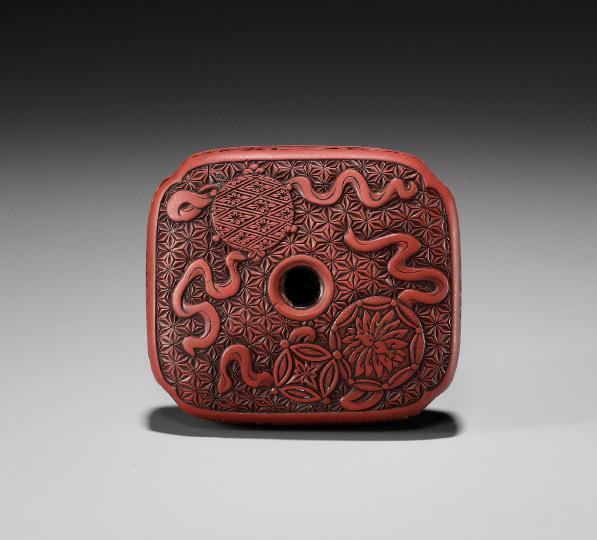
LENGTH 4.3 cm
Condition: Good condition with minor expected wear to lacquer. One of the side panels restored. Provenance: Ex-collection Mrs. F. M. Allhusen. Sold at Sotheby’s London, December 1930.
Yozei, sometimes also written as Yosei, was the hereditary name given to a famous family of lacquerers, which dated back to the mid-fourteenth century and which specialized in tsuishu in the style of Chinese carved lacquers. Betty Jahss notes that their tsuishu “far surpasses the Chinese work in richness and color, beauty, skill of carving and variation of design”. The artist family is listed in Wrangham, (1995) The Index of Inro Artists, pp. 331-332.
Estimate EUR 2,000
Starting price EUR 1,000
302 279
280
A FINE TSUISHU (CARVED RED LACQUER) MANJU NETSUKE WITH LILIES
Unsigned Japan, late 18th to early 19th century, Edo period (1615-1868)
The two-part manju decorated with beautiful tsuishu lacquer depicting a group of flowering lilies with some buds and tall grasses against a finely incised wave ground. Central himotoshi and looped cord attachment on the inside, which is lacquered in black.
DIAMETER 4.3 cm
Condition: Good condition with minor wear and a few minuscule cracks.
Provenance: Ex-collection Teddy Hahn, Darmstadt.
Estimate EUR 2,000
Starting price EUR 1,000
281
A FINE TSUISHU LACQUER MANJU NETSUKE WITH PEONIES
Unsigned Japan, 18th-19th century, Edo period (1615-1868)
The two part manju netsuke executed in stunning tsuishu (carved red lacquer) featuring an intricately worked, dense design of flowering and budding peonies issuing leaves, all against a minutely incised asanoha ground, the reverse with continuing the imagery. Large central himotoshi through the back, the cord attachment in the form of a metal loop mounted to a kiku roundel. The interior lacquered in black.
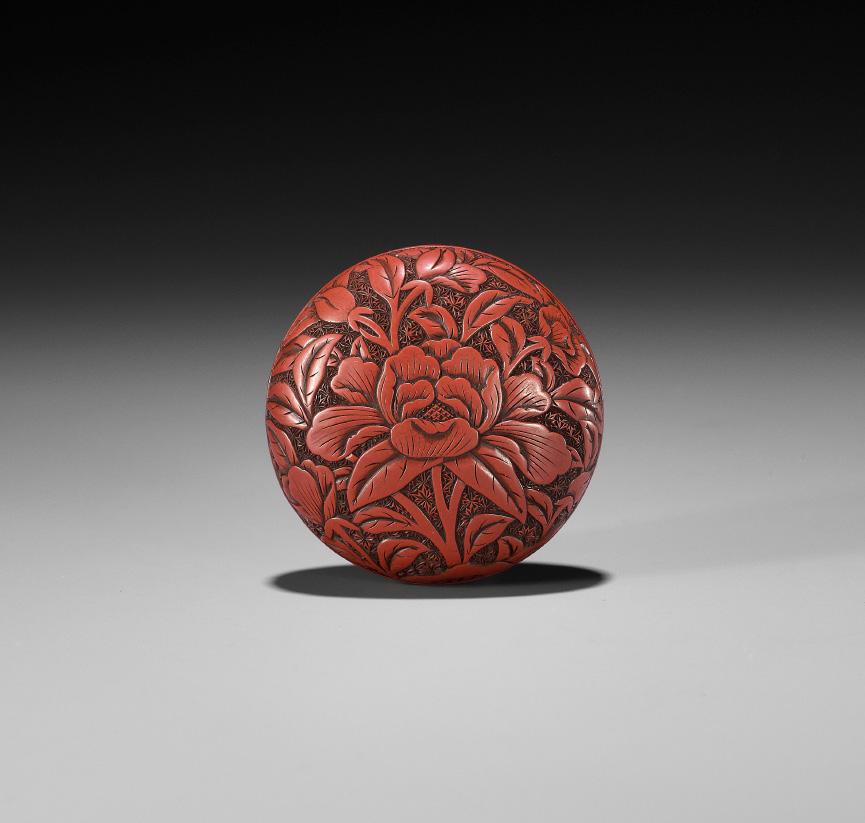

DIAMETER 4.2 cm
Condition: The exterior in excellent condition with only very minimal wear along the edges. The interior with some flaking to black lacquer.
Estimate EUR 1,500
Starting price EUR 800
303
SHIBATA SHINSAI: A FINE AND RARE LACQUER HAKO NETSUKE

By Shibata (Ikeda) Shinsai (1858-1895), signed Shinsai 眞哉 Japan, Tokyo, late 19th century, Meiji period (1868-1912)
The two-part hako (box) netsuke bearing a superbly lacquered ishime ground and decorated in gold hiramaki-e and takamaki-e with two roundels enclosing coiled rain dragons encircled by swirling clouds, likely imitating an antique Chinese mirror, amid fragmented Hanabishi mon, the base signed SHINSAI within a gold-lacquered oval reserve. The interior of dense nashiji. Central himotoshi underneath, the looped cord attachment within.
SIZE 1.6 x 3.6 x 3.3 cm (the hako netsuke)
The artist was a son of Shibata Zeshin (1807-1891) and worked in the style of his father, even collaborating with him on some works. His work is relatively scarce, however, as he died at a young age.
Condition: Excellent condition with only very minor wear to lacquer. Provenance: French private collection, assembled in Paris during the 1950s and 1960s.
AUCTION COMPARISON
Compare to a related lacquer hako netsuke by the artist’s father, Shibata Zeshin, also bearing an ishime ground, at Bonhams, The Edward Wrangham Collection of Japanese Art Part I, 9 November 2010, London, lot 146 (sold for 13,200 GBP).
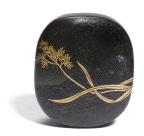


Estimate EUR 3,000
Starting price EUR 1,500
304
282
283 ZESHIN: A WOOD NETSUKE OF A REISHI FUNGUS WITH LACQUERED ANTS


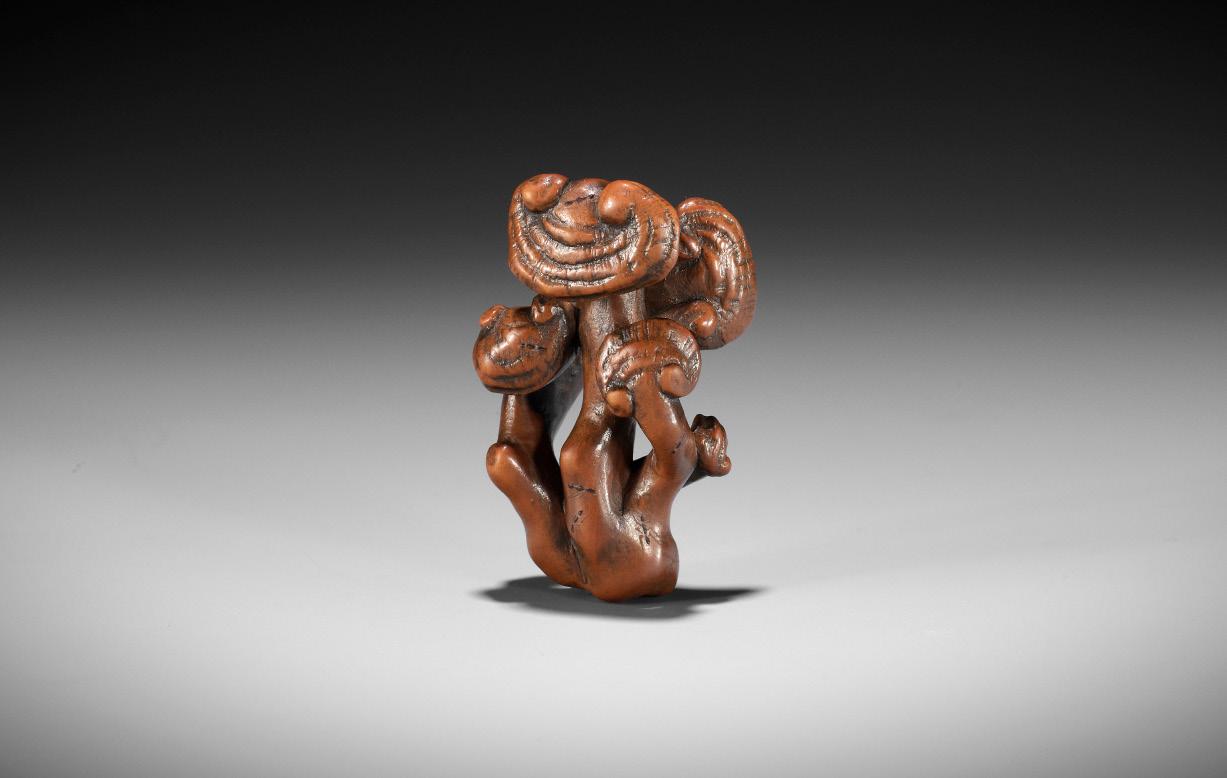


By
Shibata Zeshin
(1807-1891), signed Zeshin 是眞 Japan, Tokyo, late 19th century
Very finely carved as four reishi stalks of various size, partially intertwining and overlapping, the surface treated with translucent lacquer, and further embellished with seven tiny ants delicately applied in black lacquer. Natural himotoshi. Signed in black lacquer ZESHIN.
HEIGHT 5 cm
Condition: Very good condition, the lacquered details slightly worn. Provenance: Leblanc Collection, purchased at Beaussant-Lefèvre, Hotel Drouot, 20 November 2009, lot 243. Sold at Bonhams, Fine Netsuke from a French Private Collection, 4 November 2020, London, lot 136.
LITERATURE COMPARISON
Compare two closely related netsuke with lacquered ants, one of a bamboo node and the other depicting mushrooms, each signed Zeshin, in Hurtig, Bernard (1977) Shibata Zeshin, International Netsuke Collectors Society Journal (INCSJ), vol. 5, no. 1, nos. 3 & 7, p. 25.
Estimate EUR 3,000
Starting price EUR 1,500
305
A FINE GOLD LACQUER NETSUKE DEPICTING CHERRY BLOSSOMS



Unsigned Japan, 19th century, Edo period (1615-1868)
A beautiful and densely crafted composition depicting two blossoming sakura flowers and one bud, all issuing several leaves. The largest cherry flower is worked in red lacquer sprinkled with dense nashiji and leaves are worked in various shades of gold lacquer embellished with nashiji, hiramaki veins, and kirigane flakes. The reverse with a looped metal cord attachment.
LENGTH 3.8 cm
Condition: Excellent condition with only very minor typical wear to lacquer.
Provenance: Ex-collection Shep Brozman, New York.
Estimate EUR 2,500
Starting price EUR 1,200
306 284
285
A FINE GOLD LACQUER NETSUKE OF A PEONY FLOWER



Unsigned Japan, 19th century, Edo period (1615-1868)
Of stunning gold kinji lacquer, partially enriched with nashiji, and with drawn hiramaki veins, depicting a large peony flower which is about to bloom, its many petals densely packed and tense, as if wanting to unfold immediately. The underside shows the beautifully furling stem which forms the cord attachment.
LENGTH 4.2 cm
Condition: Excellent condition with only very minor typical wear to lacquer.
Provenance: Ex-collection Shep Brozman, New York.
Estimate EUR 2,500
Starting price EUR 1,200
307
286
A VERY FINE LACQUER MANJU NETSUKE WITH BLOSSOMING UME (PLUM)
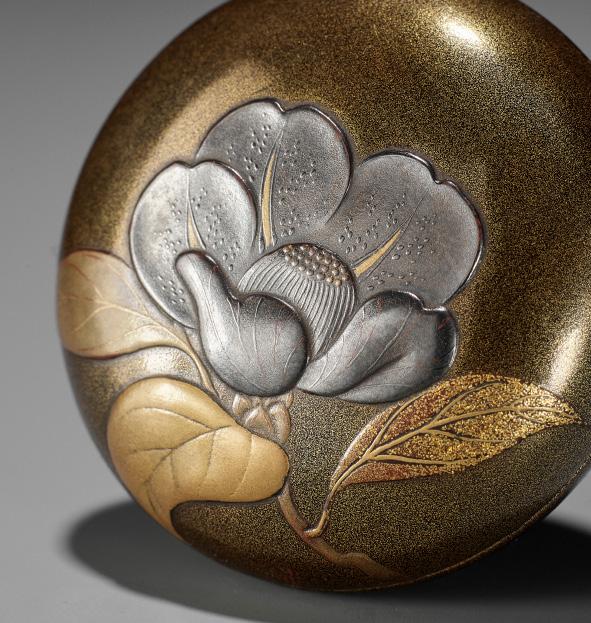
Unsigned Japan, 19th century, Edo period (1615-1868)
The two-part manju netsuke magnificently lacquered with a rich nashiji ground and decorated with a blossoming ume flower, the three leaves each executed in a different technique of nashiji, gold fundame, and greenish lacquer. The plum blossom is worked in lustrous silver takamaki-e with hiramaki-e veins and lacquered dots resembling the stamen of the flower. The reverse with a silverlined himotoshi, the cord attachment within, the interior of densely sprinkled nashiji.

DIAMETER 4.1 cm
Condition: Very good condition with minor and typical wear to lacquer. One tiny repair to the edge of the bottom section, some light crackling to the interior.
Provenance: Ex-collection Shep Brozman, New York.
Estimate EUR 2,500
Starting price EUR 1,200
308
287
A RARE AND UNUSUAL LACQUER NETSUKE WITH FLORAL DESIGN
Unsigned Japan, late 19th century
A manju-style netsuke exhibiting various different lacquer techniques in perfect harmony with each other. The front is decorated with a leafy flower issuing a bud and bloom, both inlaid in coral, the leaves executed in green takamaki-e with red hiramaki-e veins, all against a stunning green-gold nashiji ground. The sides and underside are executed in the remarkable seido-nuri (imitating black patinated bronze) technique, which was frequently used by Shibata Zeshin (1807-1891). One central himotoshi underneath and two large oval apertures through the mid-section.
LENGTH 3.6 cm
Condition: Excellent condition with only very minor wear.
Provenance: Ex-collection Shep Brozman, New York.
Estimate EUR 2,000
Starting price EUR 1,000
288
JOKA: A LACQUERED WOOD NETSUKE DEPICTING DAIKOKU AS A MANZAI DANCER
The rectangular manju-style netsuke bearing an ishime ground, simulating lightly rusted iron, and lacquered in iro-e takamaki-e with a design of Daikoku as a Manzai dancer, holding a fan before his face. The back engraved with towering ferns imitating kebori metal engraving. Large, asymmetrical himotoshi through the back and signed in gold-lacquered characters JOKA.
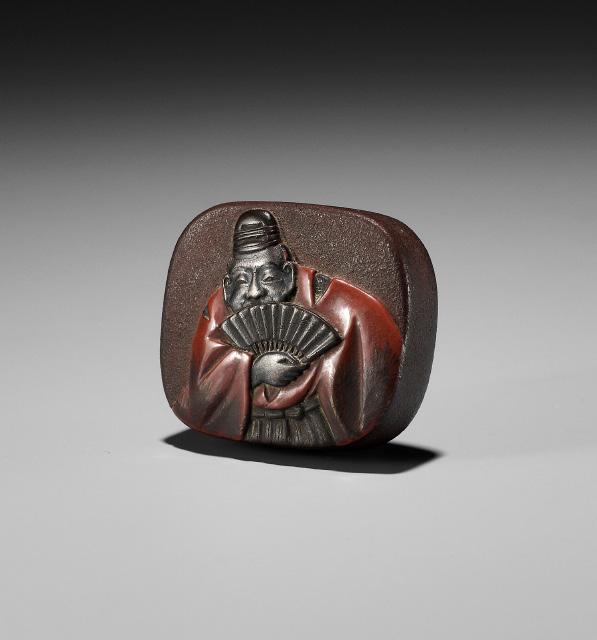

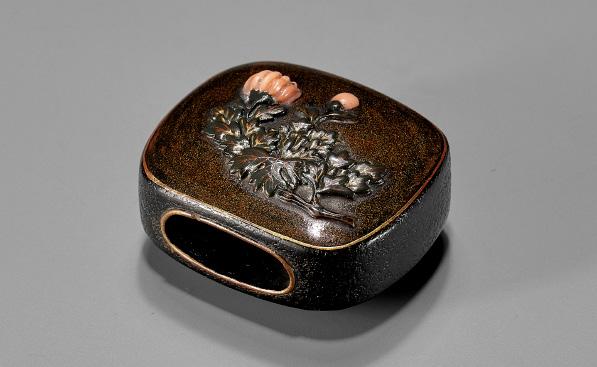
LENGTH 3.4 cm

Condition: Excellent condition with only very minor wear.
Provenance: Ex-collection Gretchen Kroch Kelsch, sold at Sotheby Parke Bernet, 11 March 1981, New York, lot 7. Ex-collection Ted Wrangham, acquired from the above. Edward A. ‘Ted’ Wrangham (1928-2009) formed one of the most important collections of Japanese Art in modern times. His reference book ‘The Index of Inro Artists’ (1995) is considered one of the most important Englishlanguage studies on Japanese lacquer ever published.
Joka is listed on page 451, H 02141.0 in THE INDEX OF JAPANESE SWORD FITTINGS AND ASSOCIATED ARTISTS by Robert E. Haynes. The signature Joka indicated a group of artists who were active during the last two hundred years of the Edo period and into the Meiji period. There are various signatures and most artists are known for their lacquered metalwork and lacquerware imitating metalwork.
Estimate EUR 1,200
Starting price EUR 600
309
By a member of the Joka lineage, signed Joka 常嘉 Japan, 19th century, Edo period (1615-1868)
Edward ‘Ted’ Wrangham (1928-2009) with Her Majesty Queen Elizabeth II, 1980
289
A RARE HIRAME-LACQUERED HAKO NETSUKE WITH TEA CEREMONY UTENSILS (CHADOGU)
Unsigned Japan, 19th century, Edo period (1615-1868)
The rectangular two-part hako (box) netsuke with a lavish gold hirame design, the underside and interior of nashiji, the top bearing a design of tea ceremony utensils including a kogo (incense box) executed in red and black lacquer, a haboki (feather broom) executed in gold and black lacquer and a storage box executed in variously colored lacquer and embellished with aogai (mother-of-pearl) floral medallions. Central himotoshi underneath, the cord attachment within.
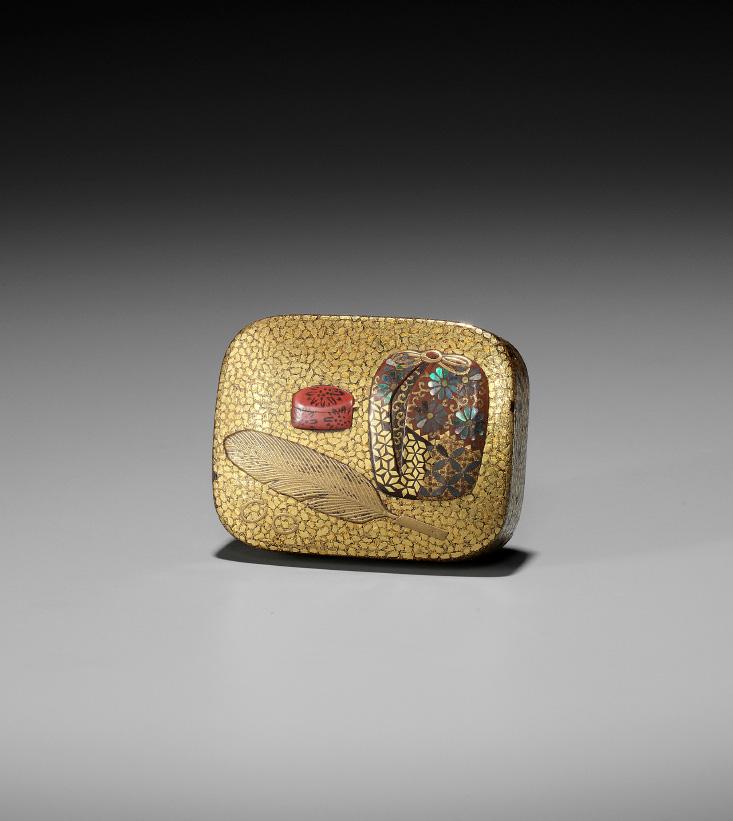
LENGTH 3.7 cm
Condition: Very good condition, some losses to the hirame flakes consistent with age and use.
Provenance: Ex-collection Shep Brozman, New York.
Estimate EUR 2,000
Starting price EUR 1,000
290
A FINE LACQUER HAKO NETSUKE OF A MANDARIN DUCK (OSHIDORI)

Unsigned Japan, 19th century
Very finely executed in gold nashiji with gold, silver, red and black hiramaki-e highlights, consisting of two parts, the mandarin duck shown as if swimming through water, the wings raised, the tail feathers folded in the back and the crest streamlined against the wind. The plumage is finely worked with gentle gold strokes, the feet underneath are lacquered in red. Central himotoshi through the underside, the cord attachment within, the interior of silver hirame.
LENGTH 3.8 cm
Condition: Excellent condition with only very minor wear.
AUCTION COMPARISON
Compare a closely related lacquer katabori netsuke of a mandarin duck, by Yokobue III, at Zacke, Fine Netsuke & Sagemono, 16 April 2021, Vienna, lot 320 (sold for 3,172 EUR).
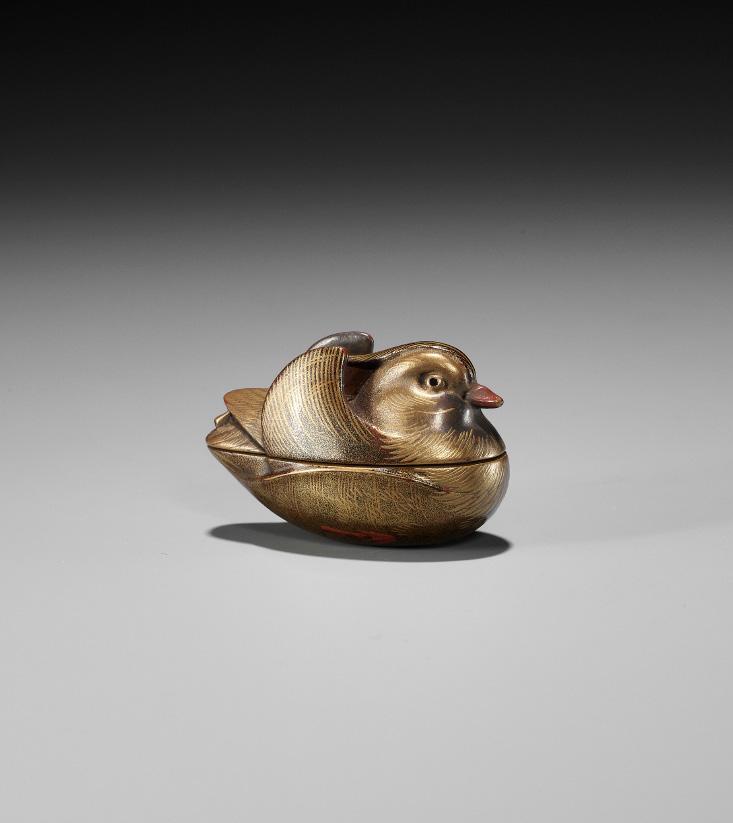
Estimate EUR 2,000
Starting price EUR 1,000
310
291
TOYO: A RARE AND UNUSUAL LACQUERED ROOT WOOD NETSUKE OF A SNAKE INSIDE A PINE TREE
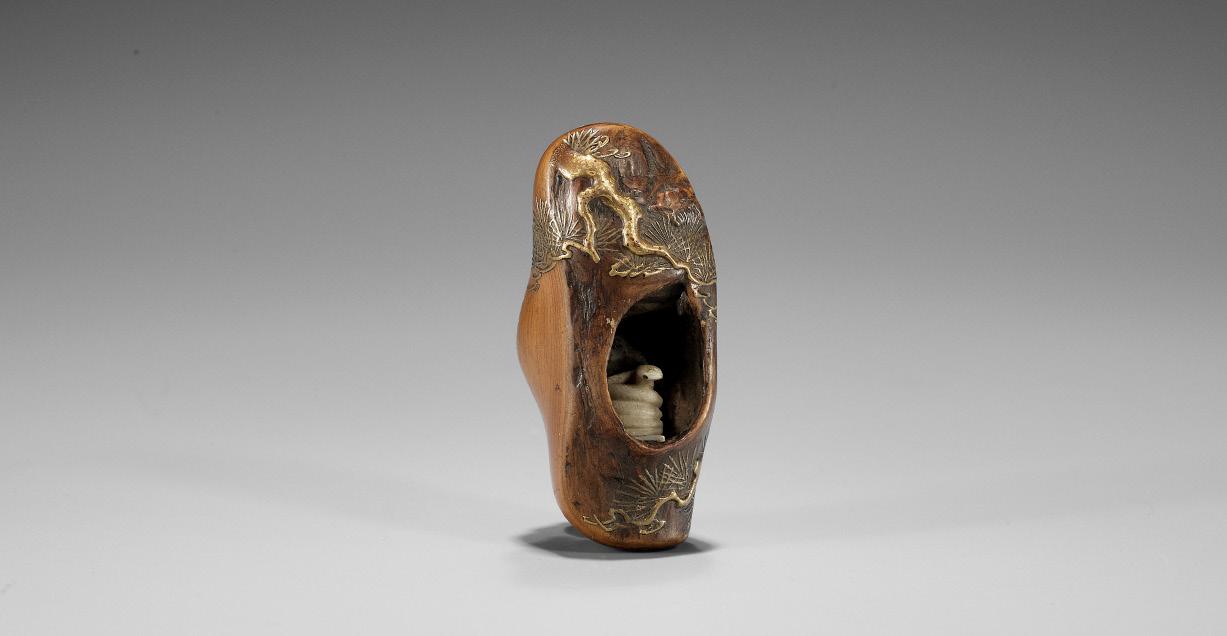
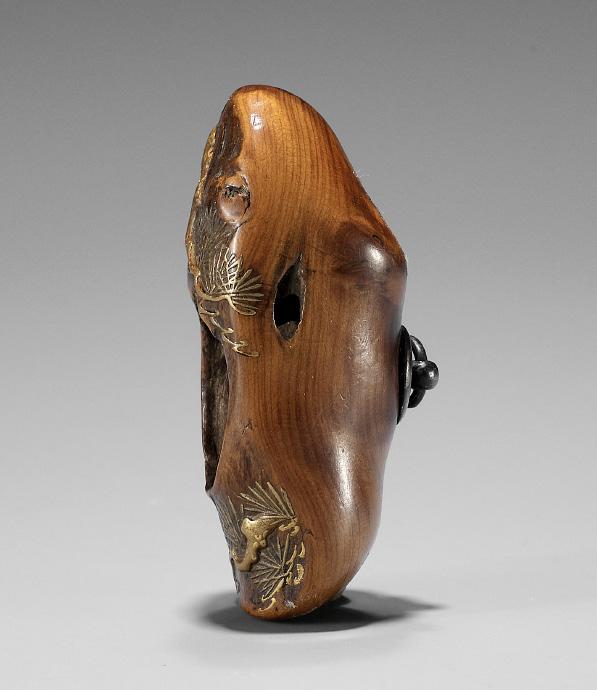
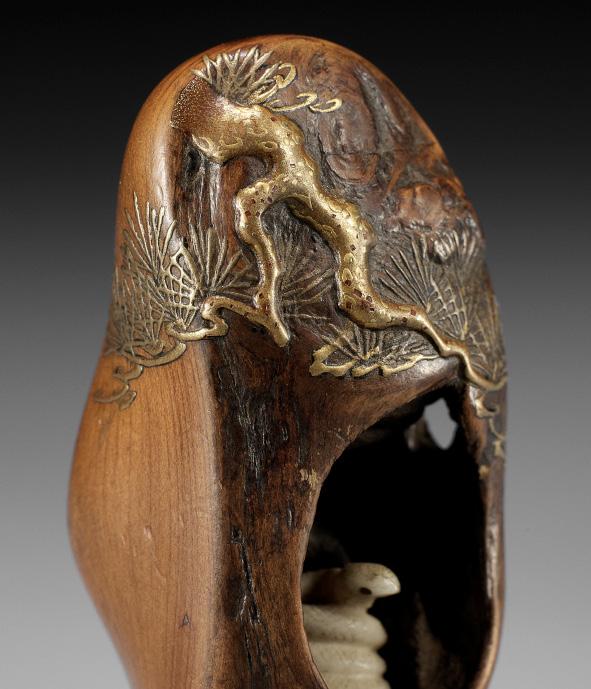
Kanshosai Toyo lineage, signed Toyo 桃葉 and kakihan Japan, 19th century, Edo period (1615-1868)
Formed as a natural section of root wood with beautiful natural veining, the surface all around neatly polished, the front carved to resemble the trunk of a pine tree and with gold takamaki-e branches issuing pine needles, a hollowed section in the center inlaid with a lurking snake. The back with a looped cord attachment and signed TOYO and kakihan.
HEIGHT 5.2 cm
Condition: Very good condition with few natural imperfections to the wood.
The kakihan used on this netsuke best compares to the ones shown in the row ‘E’ illustrated in Wrangham, (1995) The Index of Inro Artists, p. 312.
Estimate EUR 2,500
Starting price EUR 1,200
311
293
NAOMICHI: A RARE GOLD LACQUER AND SHIBUICHI KAGAMIBUTA DEPICTING SEIOBO
The shibuichi disc by Naomichi, signed Naomichi 直道 Japan, late 19th century
Finely executed netsuke, the rich nashiji lacquer of the bowl and silvery shibuichi disc in perfect harmony with each other. The disc is worked in takazogan with gold and silver inlays depicting Seiobo, The Queen Mother of the West, holding a leafy immortality peach in one hand and smiling benevolently. Signed to the side NAOMICHI – a known maker of sword fittings. Central himotoshi underneath, the cord attachment to the back of the disc.
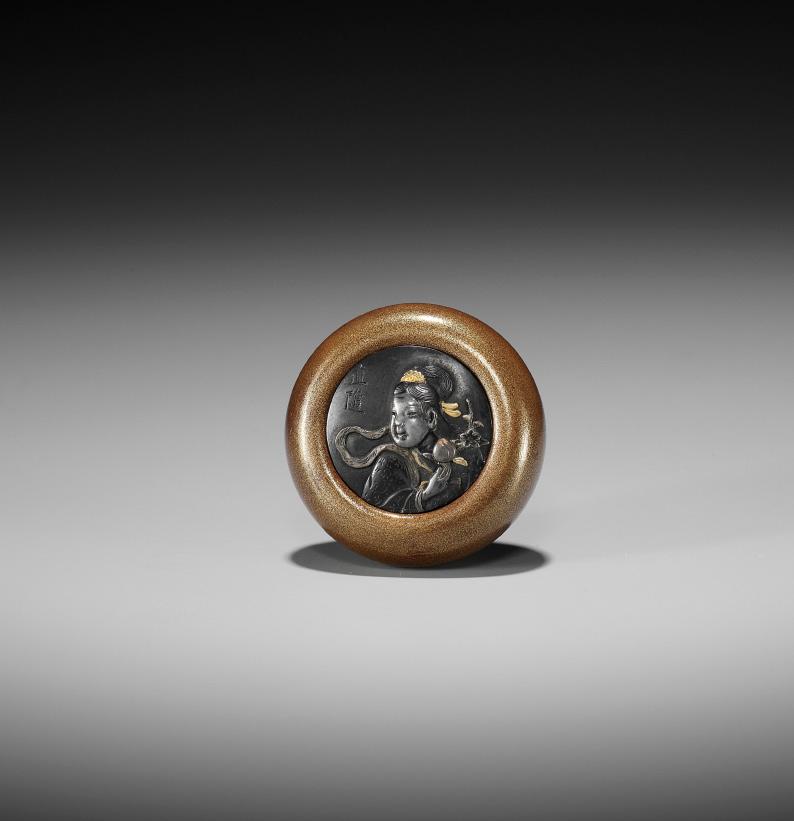
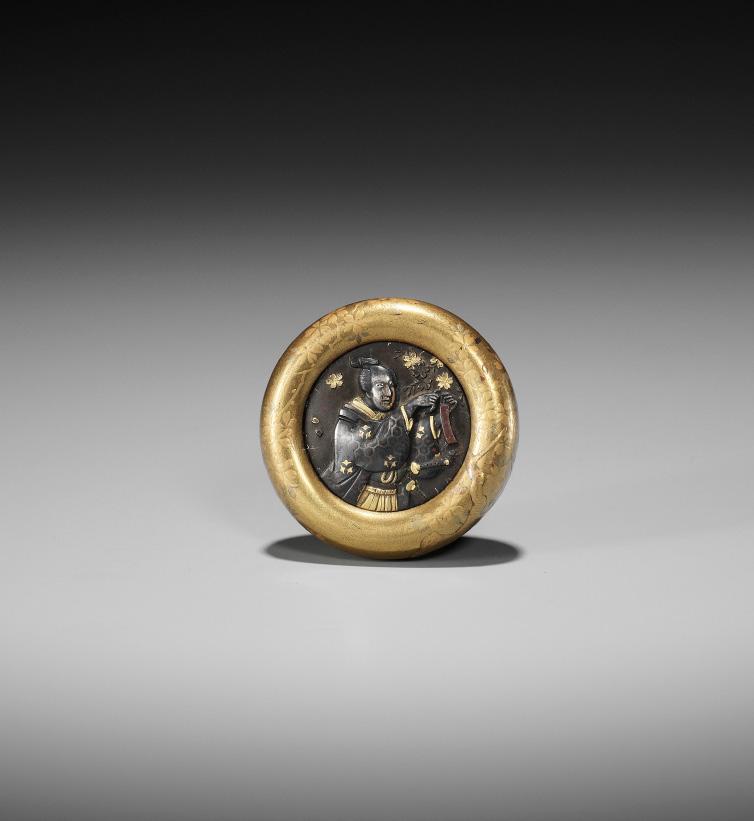
DIAMETER 3.4 cm
Condition: Very good condition. Minor wear to lacquer and to the exposed areas of the metalwork.
Provenance: Ex-collection Shep Brozman, New York.
Estimate EUR 1,500
Starting price EUR 800
292
A RARE LACQUER AND MIXED METAL KAGAMIBUTA NETSUKE OF AN ACTOR TYING A POEM SLIP TO A CHERRY TREE
Unsigned Japan, late 19th century
The shibuichi disc set into a splendid gold-lacquered bowl bearing a lustrous kinji ground and lacquered in gold and silver takamaki-e with a blossoming cherry tree, the disc worked in takazogan with highlights of silver and gold depicting an actor in the role of samurai and tying a poem slip to a cherry tree. Central himotoshi through the back, the cord attachment within.
DIAMETER 3.2 cm
Condition: Very good condition with only minor wear to the shibuichi disc and tiny losses to gold lacquer bowl.
Provenance: Ex-collection Raymond Bushell, sold at Sotheby’s, Japanese and Korean Works of Art, 21 March 2001, New York, lot 153.
Estimate EUR 1,500
Starting price EUR 800
Actor tying a poem slip to a cherry tree by Utagawa Kunisada (178-1865), Van Gogh Museum, accession no. n0269V1962

312
294
KAKOSAI: A RARE METALINLAID LACQUER MANJU NETSUKE WITH PUPPIES
By Kakosai Shozan, singed Kakosai 可交齋 Japan, 19th century, Edo period (1615-1868)
The two-part manju netsuke bearing an attractive nashiji ground and inlaid with a small shakudo plaque depicting two playful puppies facing each other, the eyes picked out in gilt, surrounded by a tranquil scene of various flowers lacquered in gold takamaki-e. The interior of nashiji. The reverse signed KAKOSAI – the artist was known for his use of metal inlays on lacquer inro and netsuke. Central himotoshi to the back, the looped cord attachment within.
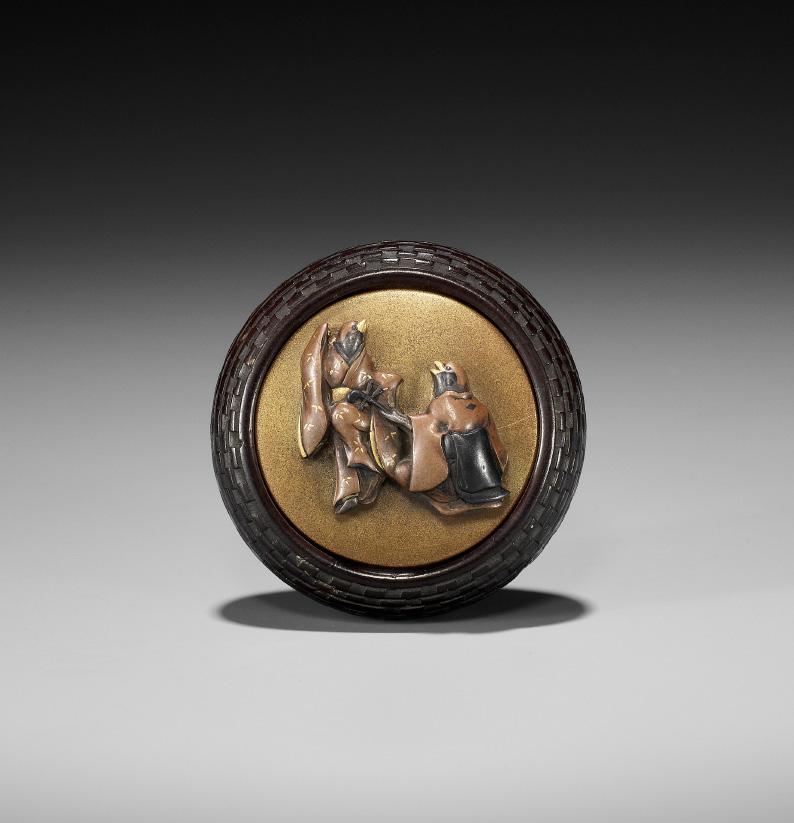

DIAMETER 3.7 cm
Condition: Very good condition. Some minor wear to lacquer and few scratches to the backside.
Estimate EUR 2,000
Starting price EUR 1,000
295
AN UNUSUAL WOOD, GOLD LACQUER AND MIXED METAL KAGAMIBUTA WITH SHITAKIRI SUZUME DESIGN
Unsigned Japan, 19th century
The bowl carved from wood in the form of a basket with a meticulously rendered weave design, the inset wood disc lacquered to the front in gold nashiji and inlaid in mixed metal of copper, shakudo and gold, depicting two frolicking humanoid sparrows, one dancing and the other playing the samisen. Central himotoshi underneath, the cord attachment through the eyelet to the underside of the disc.
DIAMETER 4.2 cm
Condition: Excellent condition, minor wear. Provenance: Ex-collection Shep Brozman, New York.
The design references the legend of the tongue cut sparrow (Shita-kiri Suzume), in which an old man is rewarded for saving a little sparrow.
Estimate EUR 2,500
Starting price EUR 1,200
313
IKESHIMA YOSHINORI: A LACQUER MANJU NETSUKE DEPICTING THE TONGUE CUT SPARROW
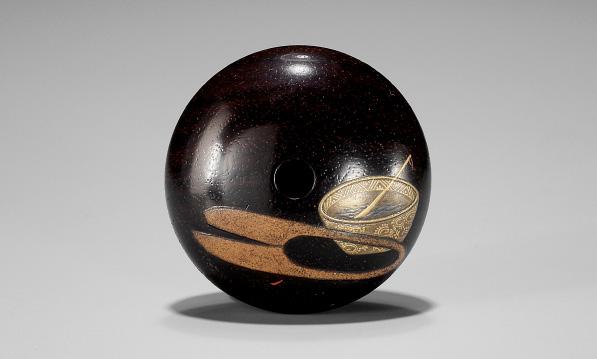 By Ikeshima Yoshinori,
Ikeshima Yoshinori 池嶌義矩 with kakihan Japan, 19th century, Edo period (1615-1868)
By Ikeshima Yoshinori,
Ikeshima Yoshinori 池嶌義矩 with kakihan Japan, 19th century, Edo period (1615-1868)
The two-part wood manju netsuke bearing an attractive grain, lacquered in gold, black, and silver takamaki-e with two fleeing sparrows, the reverse showing a pair of scissors issuing a blood droplet, and a bowl and stirring spoon. The netsuke references the tongue cut sparrow, when the old hag cuts the sparrow’s tongue with a pair of scissors after the sparrow pecked at a bowl of starch which the woman left to cool. Signed to the interior IKESHIMA
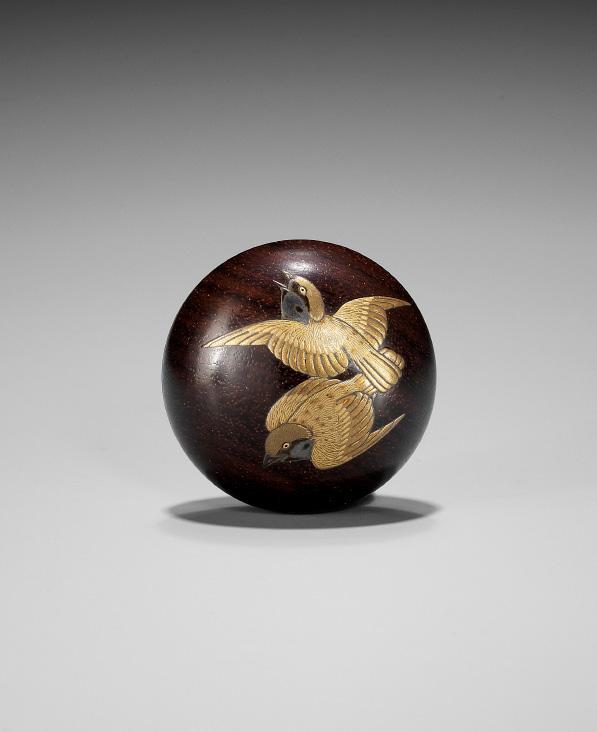
YOSHINORI with kakihan. Central himotoshi through the back, the cord attachment within.
DIAMETER 3.4 cm
Condition: Excellent condition with only very minor wear.
Provenance: Collection Prof. Dr. Henk C. Hoogsteden, Rotterdam, purchased from Max Rutherston Ltd., London, in 2018.
As noted by Edward Wrangham (Wrangham, (1995) The Index of Inro Artists, p. 338) the artist belongs to the Kanshosai Toyo lineage as he utilizes a similar kakihan.
Estimate EUR 1,500
Starting price EUR 800
297
HOGETSU: A RARE GOLD LACQUER MANJU NETSUKE WITH QUAILS AND AUTUMN GRASSES
 By
By
Kajikawa Hogetsu, signed Hogetsu 峯月 saku 作 with red pot seal Japan, 19th century, Edo period (1615-1868)
The two-part lacquer manju netsuke lacquered in lustrous gold kinji and worked in gold takamaki-e to the front with two quails standing amongst autumn grasses, the reverse with further grasses issuing red-lacquered buds. Signed to the interior in gold lacquer HOGETSU saku [made by Hogetsu] with a red tsubo (pot) seal. Central himotoshi through the back, the cord attachment within.
DIAMETER 3.8 cm
Condition: Good condition with minor wear to lacquer including some light bruising and minuscule losses. Some flaking to the interior gold fundame rim.
Provenance: French private collection, sold at Piasa, 1 June 2005, lot 135.
The artist Hogetsu is recorded in Wrangham, (1995) The Index of Inro Artists, p. 77 and notes his affiliation to the Kajikawa family of lacquerers. The use of the idiosyncratic red pot seal here further confirms this.
Estimate EUR 1,500
Starting price EUR 800
314
296
signed
298 KOAMI TADAMITSU: A FINE AND RARE KOAMI SCHOOL GOLD LACQUER MANJU NETSUKE WITH CELESTIAL DRAGON
The artist is recorded as a member of the Koami family in Wrangham, (1995) The Index of Inro Artists, p. 133.
LITERATURE COMPARISON
By Koami Tadamitsu,
signed Koami
Tadamitsu
光阿弥 忠光 Japan, 18th-19th century, Edo period (1615-1868)
The two-part manju bearing a fine gold kinji ground and lacquered in predominantly gold takamaki-e with some red and brown lacquer, depicting a celestial dragon emerging from clouds, extending one claw, bright flames emanating from its body. Its eyes as well as some of the clouds are inlaid with gold foil. The back with further clouds, a central himotoshi and signed in gold lacquered characters KOAMI TADAMITSU.
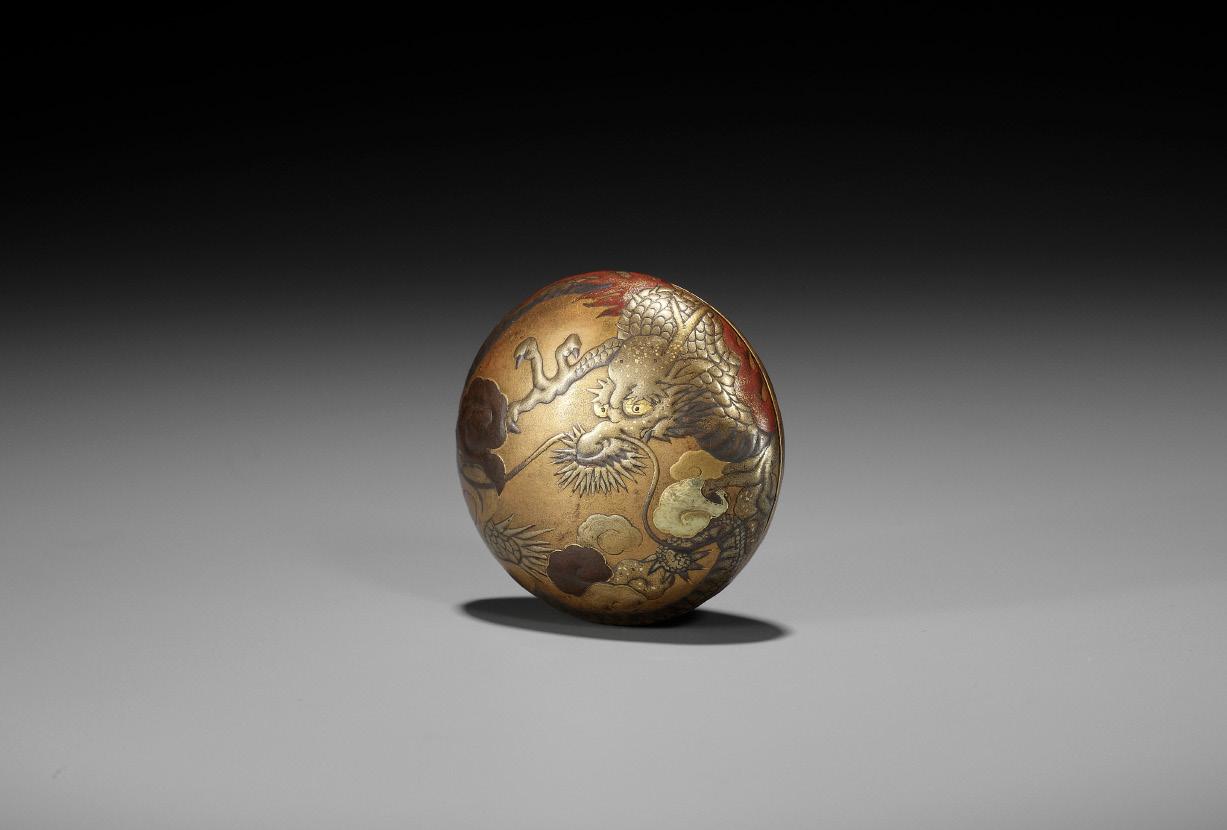

DIAMETER 4.3 cm
Condition: Very good condition with minor wear to lacquer and minuscule losses to gold foil.
The Koami name is one of the most famous dynasties of lacquerers, founded according to tradition by Docho (Michinaga, 1410-1479) in 1429. The family worked extensively for the court and the shogunate until well into the 19th century and had considerable influence on the development of lacquer art through its leadership of the teams of craftsmen that worked on important shrines and palaces and other national projects. The early family masters are recorded as having used the designs of such painters as Tosa Mitsunobu (1434-1525) and Sesshu (21420-15065). The present netsuke is in-line with this tradition, the image of the dragon resembling those featured in early Japanese ink paintings
Dragon, from a painting by Sesshu, in the British Museum

Compare to another lacquer manju netsuke by a member of the Koami family, signed Nagataka, depicting bird and bamboo, in Hurtig, Bernard (1973) Masterpieces of Netsuke Art: One Thousand Favorites of Leading Collectors, p. 208, no. 860.

AUCTION COMPARISON
Compare to another lacquer manju netsuke by a member of the Koami family, signed Nagaharu, depicting a tortoise, at Bonhams, The Last Treasures From the Edward Wrangham Collection of Japanese Art, 19 July 2021, London, lot 204 (sold for 8,287 GBP).
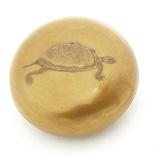
Estimate EUR 2,500
Starting price EUR 1,200
315
299 AN UNUSUAL LACQUERED AND INLAID KURUMI (WALNUT) NETSUKE OF RAKAN HANDAKA SONJA

Unsigned Japan, 19th century
Intricately carved, depicting the rakan Handaka Sonja blowing on a shell-inlaid conch, holding glass-inlaid prayer beads in one hand, conjuring a mighty writhing dragon which twist around the composition, its scales neatly incised and eyes inlaid with glass. Some details are lacquered in red, such as the rakan’s robe and the flames emanating from the dragon’s body. Two himotoshi, one of them florally rimmed.
HEIGHT 3.3 cm
Condition: Very good condition with typical wear and natural flaws to the material as are to be expected from kurumi netsuke.
AUCTION COMPARISON
Compare to a related kurumi netsuke depicting a dragon at Zacke, Fine Japanese Art, 27 May 2022, Vienna, lot 278 (sold for 2,781 EUR).



Estimate EUR 2,000
Starting price EUR 1,000
316
300
AN EXCEPTIONALLY RARE AND LARGE SOLID CORAL NETSUKE OF GAMA SENNIN
Unsigned Japan, 19th century, Edo period (1615-1868)
Carved from a large and heavy branch of bright-red coral and depicting Gama Sennin, bent forwards following the natural orientation of the material, and holding a large pot, a huge toad clambering on his back. Gama’s eyes are double inlays of bone and dark horn, and the eyes of the toad are inlaid in gold with dark horn pupils. This quite spectacular carving is of a somewhat grotesque nature, certainly helped by the peculiar and porous surface of the coral which the carver has utilized very skillfully. Himotoshi through the back.

HEIGHT 11.5 cm
Condition: Excellent condition with natural flaws to the material.
Provenance: The Gabor Wilhelm Collection, Paris.
A coral netsuke of this size has to be considered extremely rare
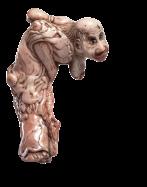
LITERATURE COMPARISON
A related coral netsuke depicting Tekkai Sennin is in the Linden Museum Stuttgart, inventory number OA 18599.
Estimate EUR 4,000
Starting price EUR 2,000
301
A HIRADO GLAZED PORCELAIN NETSUKE OF A BOY WITH SHISHIMAI MASK
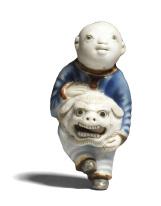
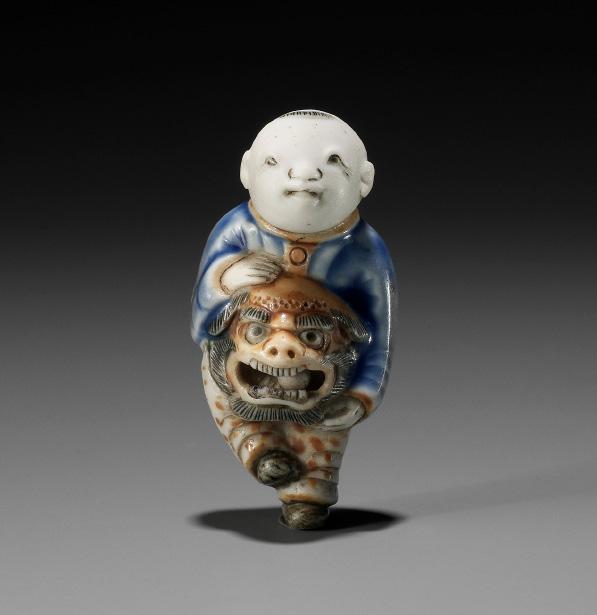
Unsigned Japan, 19th century
Well potted as a boy holding a shishimai mask in front of him, the mask with a loose ball inside, the boy with one foot placed over the other in a dancing pose, the netsuke covered with deep blue and amber glazes for the boy’s robes and the lion mask. The back with large asymmetrical himotoshi.
HEIGHT 5 cm
Condition: Excellent condition with minor wear and firing irregularities.
The shishi masked dance (shishimai) is performed to ward off disease and calamity. It is thought to have been imported from China during the Tang dynasty, and became associated with the celebration of Buddha’s Birthday, originating as a religious ceremony, but the excitement of the dance, the music, and the rhythms increased over the centuries, so that over time it was performed for entertainment rather than ritualistic purposes.
This netsuke was fired in the Mikawachi kilns of Hizen province (current Nagasaki and Saga Prefectures) in Kyushu, the southernmost island of Japan. The official kiln of the Hirado clan was located there, and the area’s kilns generally produced fine white porcelain, for both the domestic and European markets, from the later part of the seventeenth century to the present day.
MUSEUM COMPARISON
Compare a closely related Hirado porcelain netsuke of a karako with a shishimai mask in the British Museum, registration number Franks.1462.+, illustrated in Tsuchiya (2014) Netsuke: 100 miniature masterpieces from Japan, p. 21, no. 1.
AUCTION COMPARISON
Compare a related Hirado porcelain netsuke of a karako with a Daikoku mask, 6.3 cm high, dated 19th century, Edo period, at Galerie Zacke, Fine Japanese Art, 3 December 2021, Vienna, lot 290 (sold for 2,402 EUR).

Estimate EUR 1,500
Starting price EUR 800
302 A RARE NANKI OTOKAYAMA GLAZED PORCELAIN NETSUKE OF A DRAGON AMONGST CLOUDS
With underglaze blue mark Nanki Otokayama 南紀男山 Japan, 19th century
Well potted as a ferocious horned dragon amid swirling clouds, the head and scales well detailed, the white ware covered with aubergine, turquoise, and transparent glazes, the underside further with underglaze blue around the himotoshi above the underglazeblue four-character mark NANKI OTOKAYAMA.
LENGTH 4.2 cm
Condition: Excellent condition with minor wear and firing irregularities.
Nanki Otokoyama ware is a type of Japanese pottery originally from southern Kii Province, central Japan. It is also known generally as Otokoyama ware. The kiln was the largest pre-modern kiln in Kishu province (modern day Wakayama prefecture and part of Mie prefecture), originally opened as an official domain kiln of Wakayama clan. The management was transferred to a private hand in the mid-18th century until it was closed in 1878.
AUCTION COMPARISON
Compare a closely related Nanki Otokoyama blueglazed pottery netsuke of a dragon amid clouds by Nanki Danzan, dated 19th century, at Sotheby’s, The Cornelius V.S. Roosevelt Collection of Netsuke, 2 June 1992, New York, lot 227 (part-lot).

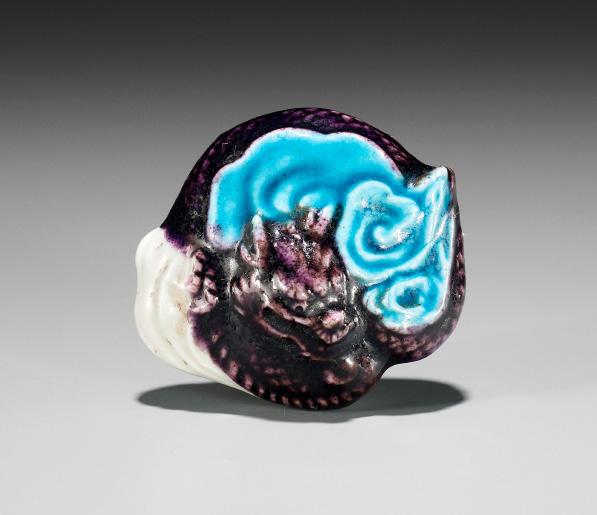
Estimate EUR 1,500
Starting price EUR 800
318
303
A VERY RARE MIXED-METAL AND LACQUER NETSUKE OF A RAT INSIDE AN ABUMI (STIRRUP)
Unsigned Japan, 19th century
The shakudo stirrup of classic shitanaga abumi type with a silver buckle, the stirrup apparently fallen into disuse as there are ‘losses’ (clearly intended by the artist) to the red lacquer interior lining, and a small shibuichi rat with a gold ingot has made its home inside. The underside with a gilt-metal movable loop for the cord attachment.

LENGTH 3.8 cm
Condition: Good condition with minor and simulated wear, the lacquer lining possibly partly split (but at least mostly intentional).
While netsuke depicting metal abumi appear on the market from time to time, this is the only example this author has seen with a rat.
Estimate EUR 2,000
Starting price EUR 1,000
304
A RARE MIXED METAL MANJU NETSUKE WITH ASTROLOGICAL ZODIAC COMPASS


Unsigned Japan, c. 1850, Edo period (1615-1868)
Of shibuichi with a silver rim, the front worked in takazogan with rich gold depicting a scene of temple servants amongst butterflies resting by a fire. The interior reveals an old silver compass inscribed with the characters for the twelve animals of the zodiac and the four cardinal directions. Looped cord attachment to the exterior.

DIAMETER 3 cm
Condition: Very good condition with minor wear. A peg to the side lost.
Estimate EUR 1,200
Starting price EUR 600
305 A DARK WOOD KAGAMIBUTA NETSUKE WITH A SHAKUDO PLATE DEPICTING SPARROWS IN BAMBOO
Unsigned Japan, second half of 19th century
Of circular form, the dark wood bowl of an attractive grain and color, fitted with a shakudo plate decorated with gilt highlights and depicting two sparrows perched on thin branches issuing from leafy bamboo stalks, one bird with the beak open as it sings. The reverse with a central himotoshi encircled by chrysanthemum petals in stag antler.
DIAMETER 4 cm
Condition: Very good condition, minor wear, the bowl with a small age crack, some rubbing to gilt, a small loss to the stag antler chrysanthemum himotoshi.
Take ni Suzume (‘Bamboo and Sparrow’) is a popular theme in Japan that has been considered as a combination of auspicious symbols since ancient times. Bamboo is said to be auspicious because it grows straight and never breaks. Since sparrows make a lot of children, it is said to represent the prosperity of descendants and has been considered to be auspicious. When sparrows and bamboo are depicted together, they represent the idea of harmony and balance. The sparrow perched on a bamboo branch symbolizes the delicate balance of nature and the coexistence of all living creatures. Sparrows, with their ability to adapt to different environments, represent the transience of life and the impermanence of things. Bamboo, with its strength and flexibility, represents the ability to withstand and adapt to change. Together, they represent the idea of wabi-sabi, which emphasizes the beauty of imperfection, impermanence, and the natural cycle of life.
Estimate EUR 1,500
Starting price EUR 800
Bamboo and Sparrows, by Utagawa Hiroshige (1797-1858), ca. 1840, Metropolitan Museum of Art, accession number JP246

306
A RARE SENTOKU BRONZE NETSUKE OF A MINOGAME
Unsigned Japan, 18th century, Edo period (1615-1868)
Cast as a minogame with a bekko-patterned shell and seaweed tail on the exterior, the interior showing the mythical animal with elongated neck retracted into its carapace. Large himotoshi through the underside.

The style, particularly of the peculiarly shaped larger himotoshi, is reminiscent of Karamono Kyubei, who is mentioned in the Soken Kisho published in 1781. Kyubei is described as making ashtrays, Chinese-style cast netsuke and kuwara (rings used for a priest’s kesa). Other designs include gourds, incense burners, eggs, and clams. Many other shapes were used for his netsuke. Sophisticated designs such as rain dragons, arabesques, flowers, clouds, and spirals were skillfully combined to create an openwork finish. They are very high-quality, perfect netsuke, not too heavy, not too light, and are very comfortable to the touch.

LENGTH 4.1 cm
Condition: Very good condition. Minor surface wear and few tiny dents to edges.
Estimate EUR 1,200
Starting price EUR 600
307
AN IVORY KAGAMIBUTA NETSUKE DEPICTING PILGRIMS CLIMBING THE GREAT BUDDHA OF NARA

Unsigned Japan, late 19th century
Published: Davey, Neil K. (1974) Netsuke: A comprehensive study based on the M.T. Hindson Collection, p. 419, no. 1245.

The shibuichi plate cast in relief with gilt details to depict a man standing on the shoulder of the giant Buddha statue at Todai-ji, lowering some rope for his companion to grab, of whom we can only see one arm as his head is obscured by his hat, the Buddha also only partly visible, his neck wrinkles, earlobe, hair locks, and facial features neatly incised. The ivory bowl superbly polished, the reverse with a central himotoshi.
DIAMETER
4.4 cm
Condition: Very good condition with minor wear, light surface scratches, some rubbing to gilt.
Provenance: Ex-collection S.X. Constantinidi. Sotheby’s, 26 November 1935, London. Excollection Mark T. Hindson, acquired from the above. Sotheby’s, The M. T. Hindson Collection of Important Japanese Works of Art, Part VIII (Final), London, 20 October 1969, lot 512. Excollection Edward A. Wrangham, acquired from the above. Bonhams, The Edward Wrangham Collection of Japanese Art Part III, 15 May 2012, lot 125. Collection Prof. Dr. Henk C. Hoogsteden, Rotterdam, acquired from the above.
The present netsuke depicts the giant statue of Buddha at Todai-ji, a Buddhist temple complex in Nara. The statue is the largest bronze seated Buddha in Japan at 15 m high and was completed in 751. The Great Buddha statue has been recast several times for various reasons, including earthquake damage. The current hands of the statue were made in the Momoyama Period, and the head was made in the Edo period. The Great Buddha Hall (Daibutsuden) has been rebuilt twice after fire. The current building was finished in 1709 and was the world’s largest wooden building until 1998.

Estimate EUR 1,500
Starting price EUR 800
Mark T. Hindson
The Great Buddha (Daibutsu) in the main hall of Todai-ji
308
MASAKAZU: A FINE SILVER OJIME DEPICTING THREE HARES
 By Masakazu, signed Masakazu 政一 Japan, 19th century, Edo period (1615-1868)
By Masakazu, signed Masakazu 政一 Japan, 19th century, Edo period (1615-1868)
Of globular form, finely incised, engraved in katakiri and kebori, and pierced with three rabbits nestled together amid blossoming aster and foliage, the animals with gold-inlaid eyes, long floppy ears, neatly incised fur, and lively expressions. The reverse with a rectangular reserve incised with the signature MASAKAZU.
HEIGHT 1.5 cm
WEIGHT 4.7 g
Condition: Very good condition, minor wear and rubbing to the surface.
The present ojime is probably by the same Masakazu as the metal artist who made fuchi-kashira sword fittings and is listed in Haynes, Robert E. (2001) The Index of Japanese Sword Fittings and Associated Artists, p. 885, H 04127.0. The artist was active circa 1800 and worked in Dewa Province, a resident of the Unshu Shonai region.
Estimate EUR 800
Starting price EUR 400
309
KATSUHIRA: A RARE GOLD OJIME DEPICTING DAIKOKU INSIDE HIS SACK
By Hagiya Katsuhira (born 1859), signed Katsuhira 勝平 Japan, Meiji period (1868-19812)
Of slightly flattened globular form, superbly worked in the form of a gleefully smiling Daikoku peeking out of his treasure bag with cloud designs inlaid in shakudo and copper, his face framed by the large ears, neatly incised chin beard and hands, and his copper-inlaid hat. Incised with the signature KATSUHIRA to the side above the lower cord hole.

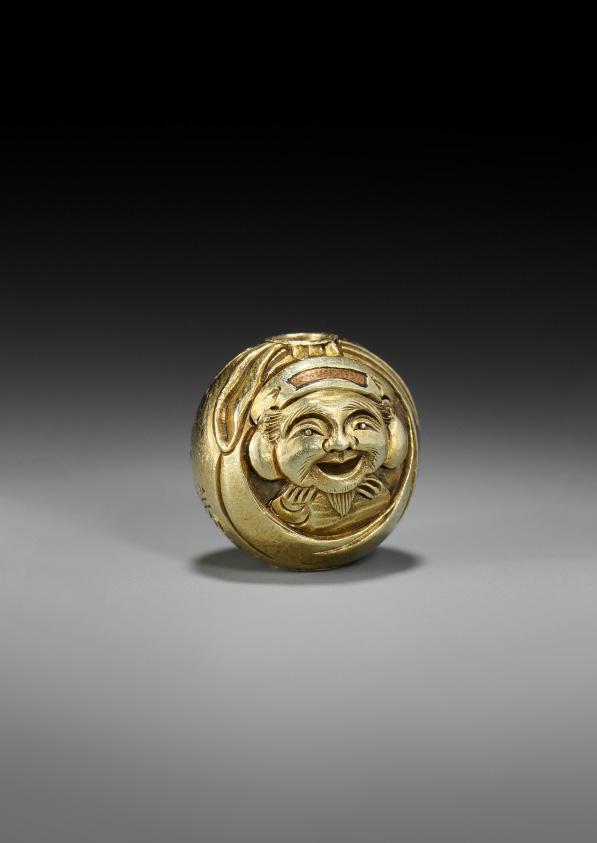
HEIGHT 1.5 cm
WEIGHT 7.5 g
Condition: Excellent condition, minor wear.
Provenance: Christie’s, 4 July 1984, London, lot 570. A Distinguished Private Collection, acquired from the above.
LITERATURE COMPARISON
Compare a related example in silver of Daikoku in his sack illustrated by Kinsey, Robert (1991) Ojime: Magical Jewels of Japan, p. 36, no. 119-12.
Auction comparison: Compare two related gold ojime from the same collection as the present lot and also previously at Christie’s, 4 July 1984, London, lot 567, at Galerie Zacke, 29 October 2021, Vienna, lot 314 (sold for 17,696 EUR) and 315 (sold for 10,112 EUR).
Estimate EUR 3,000
Starting price EUR 1,500
322
KATSUO: A MASTERFUL SOLID GOLD OJIME OF A SARUMAWASHI
By Katsuo, signed Katsuo 勝小 Japan, Meiji period (1868-19812)
Superbly worked as a kneeling monkey trainer wearing finely incised and patterned robes, his monkey clambering over the large bag slung over his back. Both the cheerful sarumawashi and the monkey with well detailed faces, especially considering the minute size.. The underside incised with the signature KATSUHIRA to one leg beside the lower cord hole.
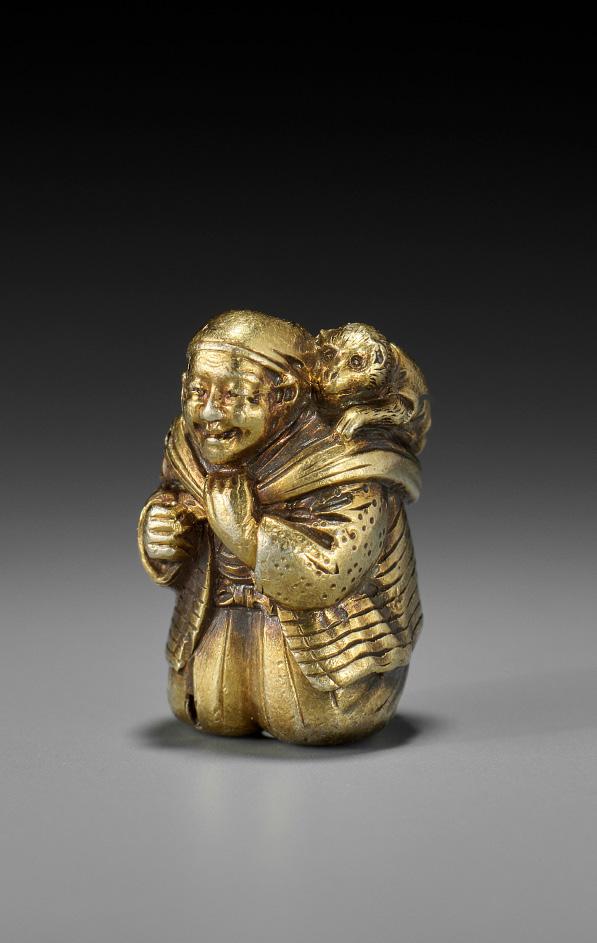
HEIGHT 1.8 cm
WEIGHT 6.8 g
Condition: Excellent condition, minor wear.
Provenance: Christie’s, 4 July 1984, London, lot 573. A Distinguished Private Collection, acquired from the above.
LITERATURE COMPARISON
Compare a related gold ojime of a sarumawashi by Masayoshi illustrated in Lazarnick, George (1981) Netsuke & Inro Artists, and How to Read Their Signatures, vol. 1, p. 744.
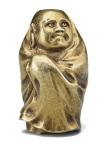


AUCTION COMPARISON
Compare two related gold ojime from the same collection as the present lot and also previously at Christie’s, 4 July 1984, London, lot 567, at Galerie Zacke, 29 October 2021, Vienna, lot 314 (sold for 17,696 EUR) and 315 (sold for 10,112 EUR).
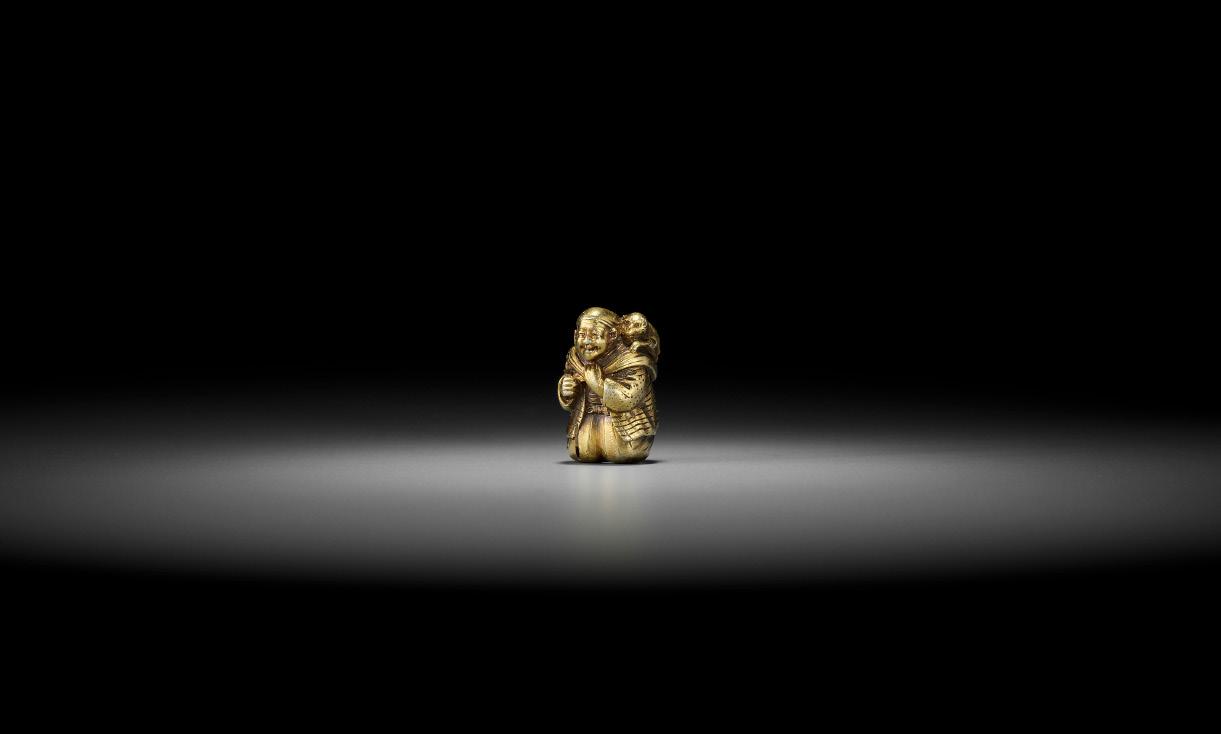
Estimate EUR 5,000
Starting price EUR 2,400
323
310
311
KAZUO MIZUTANI: AN INLAID WOOD NETSUKE OF A TABAKO-IRE DEPICTING HYOTAN KARA KUMA
By Kazuo Mizutani (b. 1932), signed Kazuo 一小 Japan, 20th century
The tobacco pouch with a kanamono (clasp) in gold takazogan of a galloping horse, below a flat-inlaid bone gourd, the pouch holding a plain kiseruzutsu (pipe case) with the karikubi (bowl) of the kiseru (pipe) inlaid in stained bone. The back signed KAZUO.

LENGTH 5.3 cm
Condition: Excellent condition with minor wear.
Provenance: Max Rutherston, London, 2017. Collection Prof. Dr. Henk C. Hoogsteden, Rotterdam, acquired from the above.
The present netsuke alludes to the Japanese expression hyotan kara koma (lit. ‘a horse in the gourd’), referring to a completely unexpected event that actually comes to pass, akin to the flight of pigs in the English-speaking world.

Estimate EUR 1,500
Starting price EUR 800
312
DOUG MARSDEN: AN INLAID WOOD NETSUKE OF TURTLES AND OTHER MARINE LIFE, ‘PACIFIC JEWEL’
By Doug Marsden (b.
1958), signed with the artist’s mark New Zealand, late 20th century
Intricately carved in openwork with a towering coral reef surmounted by a large sea turtle, with a smaller turtle and a school of fish swimming around and amid the coral, the base in the form of with neatly incised algae. The turtles and all but the very smallest fish have ebony-inlaid eyes and the netsuke is further decorated with small mother-of-pearl inlays. The wood is superbly polished in some places, creating a striking contrast between different textures. An inlaid reserve to the coral with the artist’s mark.
HEIGHT 7.1 cm
Condition: Excellent condition.
With a wood storage box.
Doug Marsden (b. 1958) began carving in 1982, making pendants and sculptures from cleaned cow leg bone, inspired by Maori art. He later found inspiration in the book The Art of Netsuke Carving by Masatoshi and began to pursue carving in a more serious manner, receiving personal encouragement from Raymond Bushell, Miriam Kinsey, and Bishu Saito, president of the Japan Netsuke Association. In 1985, he traveled to Tokyo with the assistance of the Queen Elizabeth II Arts Council of New Zealand and met with M. Yamada, who was one of the most reputed dealers of the time. In 1992, Michael Spindel Ltd. exhibited a number of his carvings in New York. His work depicts contemplative subjects with a focus on strong tactile appeal and the expression of emotion.
Estimate EUR 1,500
Starting price EUR 800
324
313 NICK LAMB: A WOOD NETSUKE OF TWO PUPPIES AT PLAY
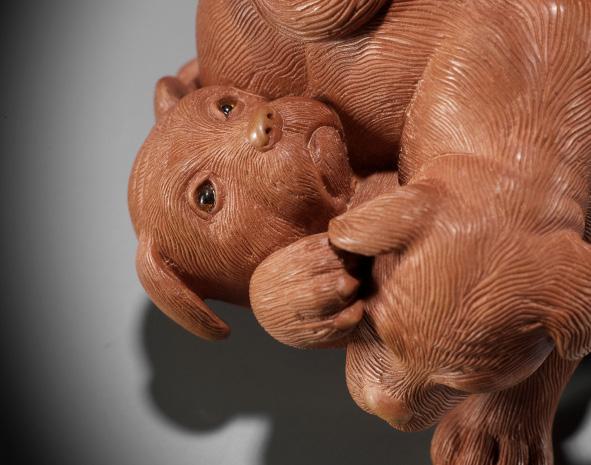

By Nick Lamb (b. 1948), signed with the artist’s mark United Kingdom, c. 1990
Published: Michael Spindel Ltd. (1992) Contemporary Netsuke, p. 33.

Finely carved as two playful puppies engaged in a lively scuffle, the animals well detailed with long tails and floppy ears, their eyes inlaid with translucent and dark horn, their fur coats neatly incised, the back of one puppy with two asymmetrical himotoshi, its haunch signed with the artist’s mark on a gold lozenge-shaped reserve.
314
SHION:
A
WOOD NETSUKE OF A MONKEY
By Shion, signed Shion 紫苑 Japan, Mie Prefecture, 21st century
A well-carved compact netsuke depicting a young monkey seated with the feet placed in front and forming the himotoshi, the simian with neatly incised and finely stained fur, the eyes inlaid in translucent horn with dark pupils, the mouth slightly open, the expression conveying a childlike sense of wonder. Signed next to the short tail SHION.

HEIGHT 3.3 cm
Condition: Excellent condition.
Shion is a Japanese contemporary netsuke carver who was born in Mie Prefecture and began carving netsuke in 2004 at the studio of Tadamine Nakagawa. The artist, hailing from the same prefecture as the Masanao family, has clearly incorporated this famous family’s style into his work.
Estimate EUR 2,000
Starting price EUR 1,000
LENGTH 5.2 cm
Condition: Excellent condition with minor wear.
Provenance: Michael Spindel Ltd., New York, 1992. A noted private collection, USA, acquired from the above.
Nick Lamb (b. 1948) is one of only a few nonJapanese netsuke carvers. Over the past three decades, he has built a reputation as being among the finest living practitioners of the art form and is known for his meticulous, graceful carvings, typically of animals. His work was exhibited in several museums, such as the British Museum, and became part of many important private and public collections, including that of the Imperial Family of Japan, the Robin Lehman Collection, the Robert O. Kinsey Collection, and the Tokyo National Museum.
Estimate EUR 2,500
Starting price EUR 1,200
325
Nick Lamb (b. 1948)
315
VADYM PYVOVAR: A WOOD NETSUKE OF A BAKU AFTER MASATOSHI
By Vadym Pyvovar, signed with the artist’s initials Ukraine, 2023
A wood netsuke of a lean young baku, standing foursquare with the feet close together like a circus elephant and turning its head back to look behind, its trunk touching its left haunch. The ridges of the underside of its trunk, recalling the softer skin of the neck of a crocodile, continue the full length of its neck and belly. The top of the trunk is wrinkled, as is the forehead and nape of the neck. The creature has the customary flames licking around the tops of its legs. The one visible eye is inlaid with amber. Natural himotoshi between the front legs and between the body and the trunk and the tail. One haunch incised with the artist’s initials.


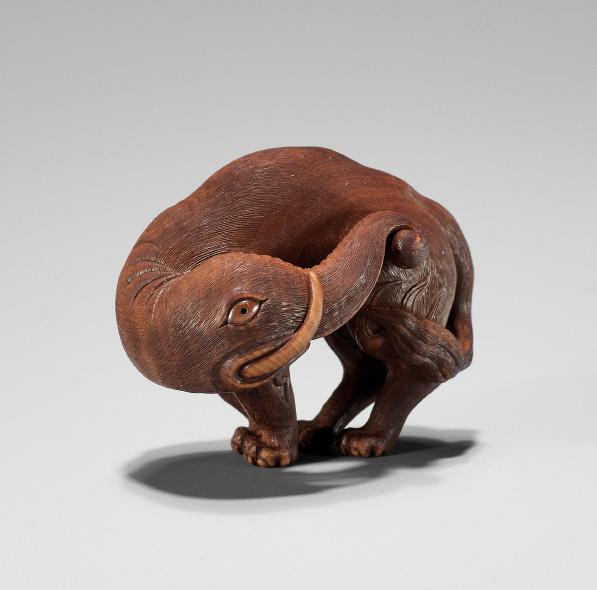
LENGTH 4.5 cm
Condition: Excellent condition.
Baku are Japanese supernatural beings that are said to devour nightmares. According to legend, they were made from the spare pieces that were left after the gods had finished creating all other animals. Baku heads are commonly placed under the eaves of Japanese Buddhist temples and Shinto shrines to ward off bad spirits.
LITERATURE COMPARISON
Compare to an example which inspired this model by Masatoshi, illustrated in Sydney L. Moss (2008) such stuff as dreams are made on. Japanese netsuke from the Willi G. Bosshard collection, p. 189, no. 96.
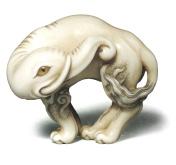
Estimate EUR 1,200
Starting price EUR 600
316 VADYM PYVOVAR: A WOOD NETSUKE OF A KIRIN AFTER SANKO

By Vadym Pyvovar, signed with the artist’s initials Ukraine, 2023
Finely carved standing foursquare with the feet close together, its head raised high and mouth agape in a snarl, revealing sharp teeth, the beast well rendered with finely incised fur, mane, and tail, the scales to the underside of its mouth, neck, and belly and the horn neatly detailed, the front legs with flames, the eyes inlaid with amber. Natural himotoshi between the legs and between the tail and body. One haunch incised with the artist’s initials.
HEIGHT 7.8 cm
Condition: Excellent condition.
LITERATURE/AUCTION COMPARISON
Compare the ‘Meinertzhagen Kirin’ which inspired this model, illustrated in color in Meinertzhagen, Frederick / Lazarnick, George (1986) MCI, Part A, p. v. Compare to another example which inspired this model, carved from ivory and dated 18th century, formerly in the Behrens, Mannstaedt, and Carré collections, at Van Ham, 7 December 2017, Cologne, lot 2242 (sold for 129,000 EUR).
Estimate EUR 1,500
Starting price EUR 800
326
317
ALEXANDER DERKACHENKO: A WOOD NETSUKE OF A CICADA ON A SKULL

By Alexander Derkachenko, signed with the artist’s mark Ukraine, 2023
Finely carved as a skull with cavernous eye sockets, several fine parietal lines covering the cranium, one tooth missing from the upper jaw. A large cicada is perched on top, the eyes inlaid in horn. The back and underside with asymmetrical himotoshi, the underside incised with the artist’s signature.
318 ALEXANDER DERKACHENKO: A WOOD NETSUKE OF A HAKUTAKU

By Alexander Derkachenko, signed with the artist’s mark Ukraine, 2023
HEIGHT 3.6 cm
Condition: Excellent condition.
With an original mahogany storage box signed by the artist. Traditionally cicada netsuke were worn during the festival of Obon, honoring the dead.
Memento mori (Latin for ‘remember that you will die’) is an artistic and symbolic reminder of the inevitability of death. Altogether sobering, and in some sense comforting, it’s an epitaph for the masses – commoners and kings alike. Such art, which already appeared in ancient cultures, is also associated with festivals in remembrance and honor of the deceased, as held by many peoples throughout the world. Skulls in Japan are considered to be a positive representation of the natural circle of life and can also represent change. The cicada is considered a symbol of longevity, eternal youth and even immortality.
AUCTION COMPARISON
Compare a related wood netsuke of a snake and skull by Alexander Derkachenko, 3.8 cm high, dated 2021, at Galerie Zacke, Fine Japanese Art, 27 May 2022, Vienna, lot 265 (sold for 3,792 EUR).

Estimate EUR 2,000
Starting price EUR 1,000
Finely carved as a hakutaku in a recumbent pose atop a mat, one hoof placed on a tama pearl carved from carnelian agate, the beast with the face of an elderly man with a cheerful expression marked by narrowed eyes, the mouth agape, the large earlobes reminiscent of a lucky god, the long beard and shaggy fur neatly incised, the horns inlaid with mammoth tusk, the large eye on its forehead and three additional eyes to the back double-inlaid with translucent and dark horn. The underside with two asymmetrical himotoshi and the artist’s signature incised within a rectangular reserve.
LENGTH 5 cm
Condition: Excellent condition.
With an original mahogany storage box signed by the artist.
Hakutaku no Zu by Gusukuma Seiho (16141644), Okinawa

Prefectural Museum & Art Museum
The hakutaku is a mythical beast of ancient Chinese origin (where it is known as bai ze) that is only rarely depicted in netsuke art. The common Japanese image generally depicts the hakutaku as a monstrous creature with nine eyes and six horns, arranged in sets of three and two on both its flanks and its man-like face. It is also commonly depicted as having the body of a lion and eight eyes, known for having a horn or multiple horns on their heads. However, the number of extra eyes actually varies depending on interpretation, and sometimes the creature is pictured with only one in the center of its head. It is considered to be intelligent, and well-read with the ability to understand human speech.
Estimate EUR 3,000
Starting price EUR 1,500
327
ADAM BLAND: THE YEAR OF THE TIGER
By Adam Bland,
signed with the artist’s initials United Kingdom, 2023
Beautifully carved as a ferociously crouching tiger, the wood finely stained and the fur coat achieved with alternating incised and polished areas. The thick tail curls up over the animal’s bulky body and the large chubby paws are inlaid with stag antler claws. Signed underneath the right hind paw with the artist’s initials. Natural himotoshi.
LENGTH 3.7 cm
Condition: Excellent condition.
The carving certainly draws inspiration from the tiger netsuke by the Masanao family of Yamada (Masanao would be proud), though the expression is much more menacing, as the tiger looks back at the past year.


Adam Bland is a contemporary netsuke artist from the north of England who has studied the craft of netsuke for several years. He has a qualifications in Fine Art and Design and first discovered netsuke accidentally following a career in architectural model making. He was drawn to the art of netsuke as they combine elements of design with fine art to create small, intricate sculptures rich with narrative and meaning. Adam Bland has recently exhibited at the Netsuke Convention in Amsterdam in 2022 and his craft is constantly improving, making him one of the most exciting contemporary carvers to emerge in these past years.
Estimate EUR 6,000
Starting price EUR 3,000
Notes on the present piece by Adam Bland:
“As a netsuke artist there is a temptation to sculpt a new zodiac animal to celebrate the start of each new year. Not only is this good for social media but there is also less stress in deciding your subject matter. Being as busy and poorly organised as I am, I managed to sculpt a tiger at the end of 2022, completing it as the year of the rabbit dawned. This retrospective approach to the tiger means the challenges of the year cannot help but influence the finished piece. My tiger takes up a defensive stance, crouched, bearing its fangs and claws, ready to fight the challenges which confront it.
Carved from boxwood all the way from Japan, stained using walnut husks collected from my local village green in northern England and inlaid with antler and amber from the Ukraine.”
328
319

320 KAJIKAWA KYUJIRO: AN EXCEPTIONALLY LARGE AND IMPORTANT STAG ANTLER-INLAID LACQUER FOUR CASE INRO DEPICTING A DRAGON, DATED 1647 BY INSCRIPTION
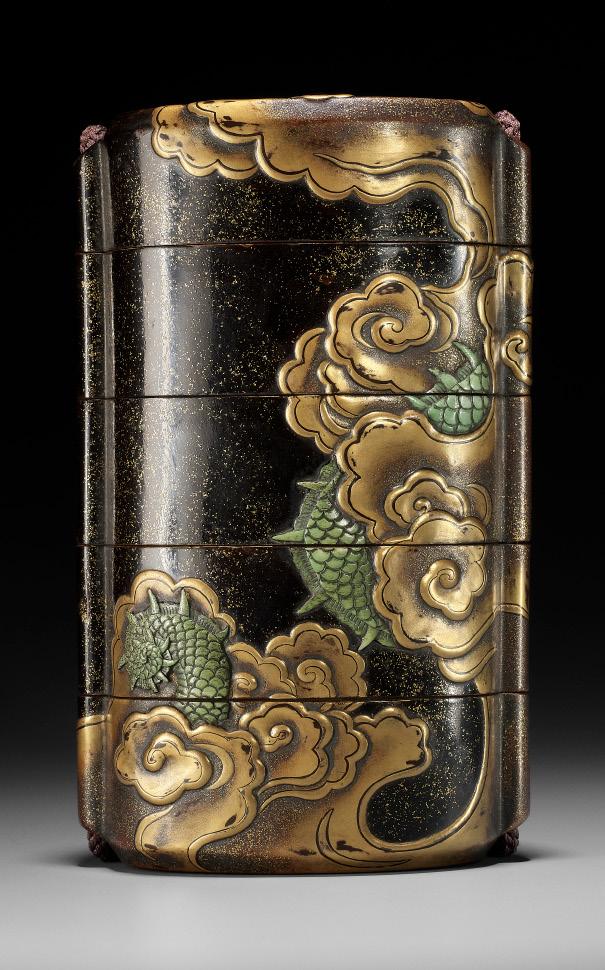
 By Kajikawa Kyujiro, signed Kajikawa Kyujiro 梶川久次郎 with kakihan Japan, dated 1647, Edo period (1615-1868)
By Kajikawa Kyujiro, signed Kajikawa Kyujiro 梶川久次郎 with kakihan Japan, dated 1647, Edo period (1615-1868)
Published: Wrangham, Edward (1995) The Index of Inro Artists, p. 159 (only the signature is illustrated).
Of upright form, the ground of roiro with a dusting of gold powder and mura-nashiji, lacquered in takamaki-e and inlaid in greenstained stag-antler with a sinuously writhing three-clawed twohorned dragon clutching a sacred tama (jewel) amid thick swirling clouds. The base dated Shoho yon hinoto-i shoshun (‘early Spring in the fourth year of Shoho’, corresponding to 1647) and signed KAJIKAWA KYUJIRO with a red kakihan.
The wood ojime is also of unusually large size and is carved a three-sided Bizen-ware sake bottle, a carved rope tied around the neck, two sides worked in relief with a standing Hotei, one holding a fan, one side incised with the signature Ippo. Note also the exceptionally large inro cord.
HEIGHT 17.6 cm (the inro) and 4.3 cm (the ojime)
Condition: Very good condition with minor wear and expected traces of use. The top with minor dents and discoloration to lacquer. The interior with few small nicks, tiny nibbles, few minor chips and flakes, few minor age cracks.
Provenance: Sotheby’s, London, 1984. Ex-collection Edward Wrangham (no. 1708), acquired from the above. Bonhams, The Edward Wrangham Collection of Japanese Art Part I, 9 November 2010, London, lot 248 (sold for 36,000 GBP). A Princely Collection, acquired from the above. OId label to ojime, ‘4772.B’. The interior of the cover lacquered with a collector’s number, ‘25298.’
The present inro is unusual and extremely rare for its huge size, which along with the dating inscription make it an important work of art. It was likely commissioned by the shogunate in the mid-17th century.
Kyujiro, also known as Kajikawa II, was a direct pupil of Hikobei, the founder of the Kajikawa dynasty. Kyujiro is generally considered to have established the family reputation. He worked for the shogunate, living in Nakabashi in Edo, and in the words of the Soken Kisho of 1781 was ‘the best inro maker of the past or present’. His dates are not recorded, but he must have worked in the mid-17th century. Another exceptionally large inro is recorded in the W. L. Behrens collection, no. 468, and shows a design of a snail and bamboo in relief with pewter, gold, and aogai.
Estimate EUR 20,000
Starting price EUR 10,000
330

A VERY RARE RYUKYU LACQUER THREE-CASE INRO DEPICTING FIGHTING BEARS AND CHRYSANTHEMUM, WITH A LACQUER HAKO NETSUKE ATTRIBUTED TO ZOKOKU
Unsigned, the netsuke attributed to Tamakaji Zokoku (1806-1869) Japan, 18th century, Edo period (1615-1868)
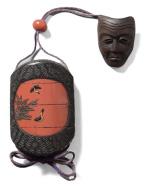
Of wide rectangular form, each side with a quadrilobed panel bearing a red-lacquered ground decorated in tsuikin (applied multi-colored lacquer) to one side with two bears fighting amid grasses under a craggy rock and to the other with blossoming chrysanthemums and rockwork, all against a neatly carved diapered shippo ground. The interior of red lacquer, the top case divided into three compartments and the middle case divided into two.


The beautifully fitting 19th-century hako netsuke of rounded rectangular form, finely carved through an outer tsuikoku layer to the tsuishu ground with a meandering stream and leafy floral sprays, the sides with a rinzu (key fret) band, one short side with a hidden sliding cover. Unsigned, however attributed to Tamakaji Zokoku (1806-1869). The globular ojime with a marbled design.
HEIGHT 8.5 cm, LENGTH 7.9 cm
Condition: Very good condition, minor wear, few minor age cracks, some wear to lacquer.
Provenance: Ex-collection Michael Tomkinson, no. 1109 (label to interior).
MUSEUM COMPARISON
Compare two related lacquer inro in the Victoria & Albert Museum, accession numbers W.179:3-1922 and W.292-1921, the first signed Ikkan, dated 1750-1850, and attributed to the Ryukyu Islands.
AUCTION COMPARISON
Compare a related Ryukyu lacquer four-case inro, also dated 18th century, at Bonhams, The Edward Wrangham Collection of Japanese Art Part II, 10 May 2011, London, lot 184 (sold for 3,840 GBP).


Estimate EUR 6,000
Starting price EUR 3,000
332
321

322
A FINE TSUISHU FOUR-CASE LACQUER INRO WITH CHORYO AND KOSEKIKO, WITH EN SUITE NETSUKE AND OJIME

Unsigned Japan, 19th century, Edo period (1615-1868)

The four-case inro of upright form and oval section, lacquered in tsuishu (carved red lacquer) and finely worked in high relief depicting Choryo with his sword drawn, standing atop a water dragon amidst crashing waves, and presenting the fallen shoe to Kosekiko who is shown on the other side mounted on his horse striding across a bridge and holding a scroll. The scene is set beneath a neatly carved pine tree, the sides of the inro are incised with key fret borders, the top and bottom beautifully incised with floral designs. The interior lacquered in red.

With a beautifully matching blue and white porcelain ojime decorated with underglaze blue waves and a fine tsuishu lacquer netsuke of unusual quatrefoil shape, the top carved with a chrysanthemum flower and with four panels to the side depicting literati, pine and craggy rocks, the underside with a central himotoshi and a finely incised asanoha ground.
HEIGHT 8.2 cm, LENGTH 4.6 cm
Condition: Very good condition, some tiny losses to lacquer.
Provenance: German private collection. The interior with some old Japanese labels and remnants of incense.
Estimate EUR 2,500
Starting price EUR 1,200
ZONSEI: A FINE TSUIKOKU (CARVED BLACK LACQUER) FOUR-CASE INRO DEPICTING CHORYO AND KOSEKIKO
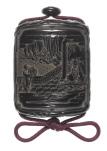
 By Zonsei, signed Zonsei 村靖 zo 造 Japan, 19th century, Edo period (1615-1868)
By Zonsei, signed Zonsei 村靖 zo 造 Japan, 19th century, Edo period (1615-1868)
Each side bearing a sunken panel, one carved in relief with Kosekiko chasing the unseen dragon though crashing waves near a mountain, the other with Kosekiko presenting the shoe to Choryo, who sits on his horse galloping over a bridge. The various layers of lacquer are intricately carved with rinzu and wave grounds,
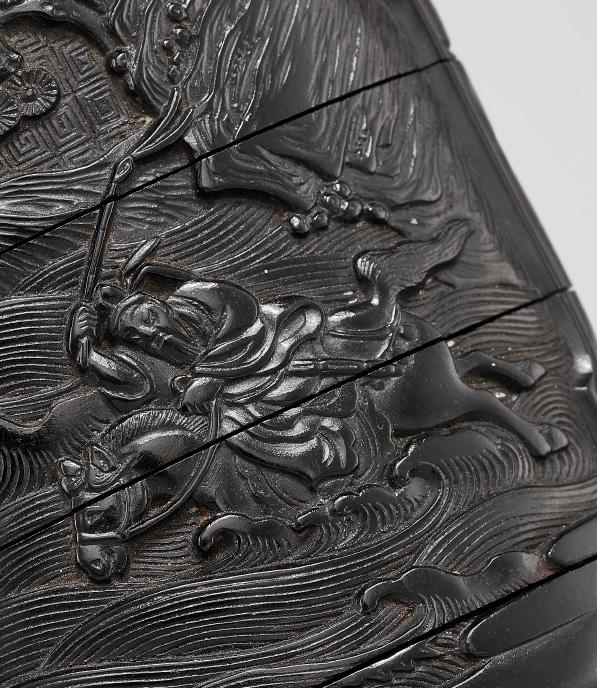
complementing the finely incised crashing waves, roughly textured craggy rockwork, and smooth wispy clouds. The top and base carved with further swirling clouds. One side neatly incised with the signature ZONSEI zo [made by Zonsei]. With a black-lacquered wood ojime of faceted ovoid form and decorated with mother-ofpearl inlays.
HEIGHT 7.5 cm
Condition: Excellent condition with minor wear.
Provenance: Swiss private collection. The interior with two inscribed labels, ‘4928 18 Jun 05’ and ‘59’.
Zonsei, who appears to have worked exclusively in tsuishu and tsuikoku, is listed in Wrangham, (1995) The Index of Inro Artists, p. 347.
Zhang Liang (known as Choryo in Japanese) was a Chinese military strategist and politician who lived in the early Western Han dynasty. The present netsuke depicts the legend of when Choryo met the old man Kosekiko (Huang Shigong) on a bridge. The old man began to teach the art of war to Choryo and one day Kosekiko wanted to test Choryo and threw a shoe into the river where a powerful water dragon lived. The dragon seized the shoe and Choryo defeated it and gave the shoe back to Kosekiko. The present inro shows Choryo chasing the unseen dragon through crashing waves on one side, while the other shows side shows the aftermath: the proud Choryo, standing on the vanquished dragon, presenting the shoe to Kosekiko who is mounted on a horse atop a bridge. According to legend, Choryo used the teachings of Kosekiko as a military adviser to Liu Bang, the founder of the Han dynasty.
AUCTION COMPARISON
Compare a related tsuikoku four-case inro by Zonsei, similarly carved with a different subject, 7.3 cm high, also dated 19th century, with a black-lacquered ojime, at Bonhams, The Edward Wrangham Collection of Japanese Art Part V, 5 November 2014, London, lot 199 (sold for 1,500 GBP).
Estimate EUR 2,500
Starting price EUR 1,200
335
323
A RARE AND EARLY BLACK AND GOLD LACQUER FOUR-CASE INRO DEPICTING RAIJIN AND FUJIN

Unsigned Japan, 18th century, Edo period (1615-1868)
Of lenticular section, the roiro ground finely decorated in predominantly gold takamaki-e with detailing in hiramaki-e and kirigane, depicting to one side the God of Thunder smoking a pipe and carrying a drum and two drumsticks strapped to his back, with stylized bolts of thunder surrounding him , the other side showing the God of the Wind walking under a pine tree and carrying a second drum on his back, further with foliage and rockwork, the interior of rich nashiji with gold fundame edges.
HEIGHT 8.2 cm
Condition: Very good condition with minor and typical wear, few short fine age cracks, minuscule losses, few small nibbles to edges with one associated minor touchup.
Estimate EUR 2,500
Starting price EUR 1,200
336 324
325
TATSUKE KOKOSAI: A RARE LACQUER FOUR-CASE INRO DEPICTING A CAT AND BUTTERFLY
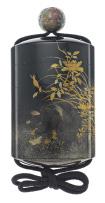
 By Tatsuke Kokosai II, signed Tatsuke Kokosai 田附交々齋 Japan, 18th-19th century, Edo period (1615-1868)
By Tatsuke Kokosai II, signed Tatsuke Kokosai 田附交々齋 Japan, 18th-19th century, Edo period (1615-1868)
Bearing a reddish-brown ground, finely decorated in mostly gold and silver togidashi-e and hiramaki-e with nahiji and hirame to depict a cat teasing a butterfly while another flutters around a clump of wild flowers on the reverse, the interior of nashiji with gold fundame edges. Each case is inscribed to the interior in black lacquer with a character, reading ‘Shi’, ‘So’, ‘Cho’, and ‘Mei’. The base signed in gold lacquer TATSUKE KOKOSAI.
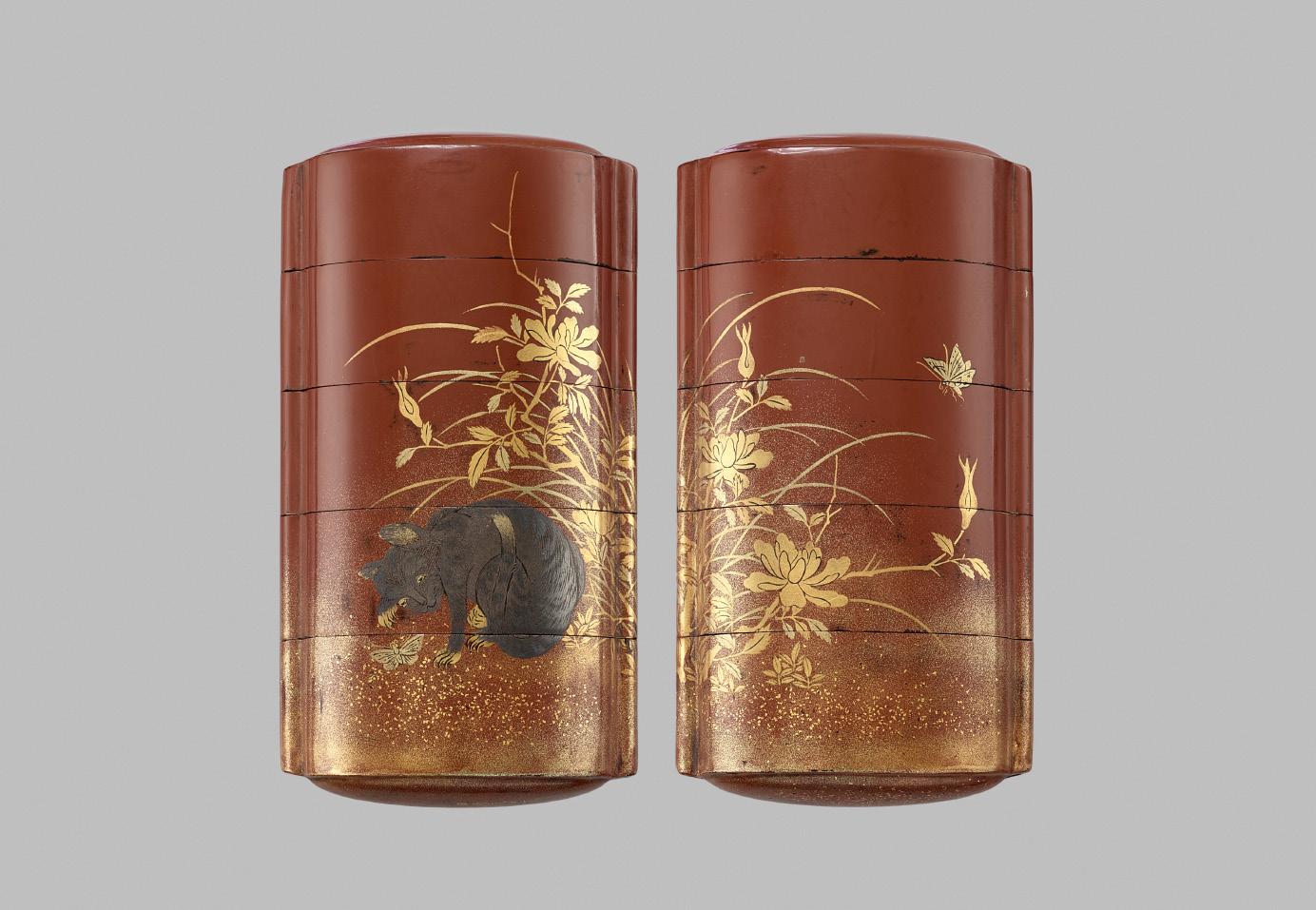
HEIGHT 9 cm
Condition: Good, worn condition with minuscule losses to edges and risers, minor rubbing throughout.
Provenance: Kunsthandel Klefisch, 11-12 October 2013, Cologne, lot 873. A private collection in Rhineland, Germany, acquired from the above.
Cats and butterflies are symbols of longevity. The word for cat in Chinese (mao) is a homophone for the word for octogenarian, and the word for butterfly (die) sounds the same as that for a septuagenarian. Thus, the combination of the cat and butterflies here conveys the wish that the recipient might live a long life of seventy or eighty years. It is common for Japanese artists to borrow such symbolism from the Chinese visual vocabulary.
AUCTION COMPARISON
Compare a closely related four-case inro by Tatsuke Kokosai II, decorated with the same design on a roiro ground, 7.6 cm high, dated 19th century, formerly in the collections of Michael Tomkinson (no. 1152) and Edward A. Wrangham (no. 1516), at Bonhams, The Last Treasures from the Edward Wrangham Collection of Japanese Art, 19 July 2021, London, lot 83 (sold for 5,100 GBP). This inro is also recorded in Wrangham, E. A. (1995) The Index of Inro Artists, p. 140.
Estimate EUR 2,500
Starting price EUR 1,200
337
326
A LACQUER THREE-CASE INRO WITH SPINNING TOPS (KOMA), ATTRIBUTED TO SOETSU
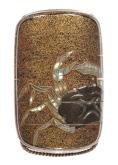
Attributed to Tsuchida Soetsu (c. 1660-1745), unsigned Japan, 17th-18th century, Edo period (1615-1868)
327
A RARE LACQUER FOUR-CASE SAYA INRO WITH HO-O BIRDS AND KIRI MON
Unsigned Japan, 17th century, Edo period (1615-1868)
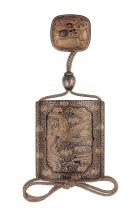

The saya of roiro and nashiji decorated in gold hiaramaki-e with scrolling foliage interspersed by kiri mon (paulownia crests). The inro bearing a roiro ground similarly decorated with dense foliage and kiri mon as well as a flying ho-o bird to each side. The interior of nashiji with gold fundame edges. With a small lacquered wood ojime.
HEIGHT 6.7 cm
Condition: Very good condition considering age and use. The saya with typical associated wear from contact with the frame.
The kiri mon is one of the five major family crests in Japan, and one of the two imperial crests, along with the kiku (chrysanthemum) mon. More than 140 designs of the kiri mon exist, the most common one being known as the 5-3 Paulownia (Go-san no Kiri), consisting of three leaves and an inflorescence of 3–5–3 flowers, as found on the present lot. Originally, the paulownia seal was the private symbol of the Japanese Imperial Family, from as early as the sixteenth century. The Toyotomi clan, led by Toyotomi Hideyoshi, later adopted the paulownia seal for use as the crest of his clan. After the Meiji Restoration, the seal was eventually adopted as the emblem of the Japanese government.
Both the ho-o bird and the paulownia (kiri) tree are imperial symbols of Japan. According to legend, the ho-o, a bird similar to the phoenix that represents the eternal rebirth of the soul, only settles on the Kiri tree. In the hope of attracting this auspicious bird that blesses people with wisdom, health and happiness, the trees are planted in courtyards and gardens.
The nashiji ground finely decorated in gold hiramaki-e and inlays of aogai with five spinning tops to either side, their motion suggested by neatly painted wavy lines. The interior of roiro with gold fundame edges.
HEIGHT 5.9 cm
Condition: Good condition with minor wear, rubbing and tiny losses to lacquer.
Provenance: From the collection of Gaston Lazard (1878-1956) and his wife Jane Levy (1886-1985) and thence by descent within the same family.
The history of spinning tops (koma) in Japan dates back around 1,300 years ago, when children’s spinning tops made from bamboo arrived from China. They became increasingly popular from the Kamakura period and were ubiquitous by the 17th century.
AUCTION COMPARISON
Compare to a related lacquer inro, by Tsuchida Soetsu, at Bonhams, The Edward Wrangham Collection of Japanese Art Part IV, 6 November 2013, London, lot 141 (sold for 5,625 GBP).

Estimate EUR 1,500
Starting price EUR 800
LITERATURE COMPARISON
Compare to a near-identical saya inro with kiri and ho-o, dated 17th century, illustrated in Kurstin, Joseph & Lorin, Gilles (2006) The Peacock’s Feather, Gentlemen’s Jewelry of Old Japan, no. 58.
Estimate EUR 2,000
Starting price EUR 1,000
338
328
SHUNSHO: A VERY RARE
GILT-INLAID LACQUER FOUR-CASE INRO WITH SHISHI AND HO-O BIRD
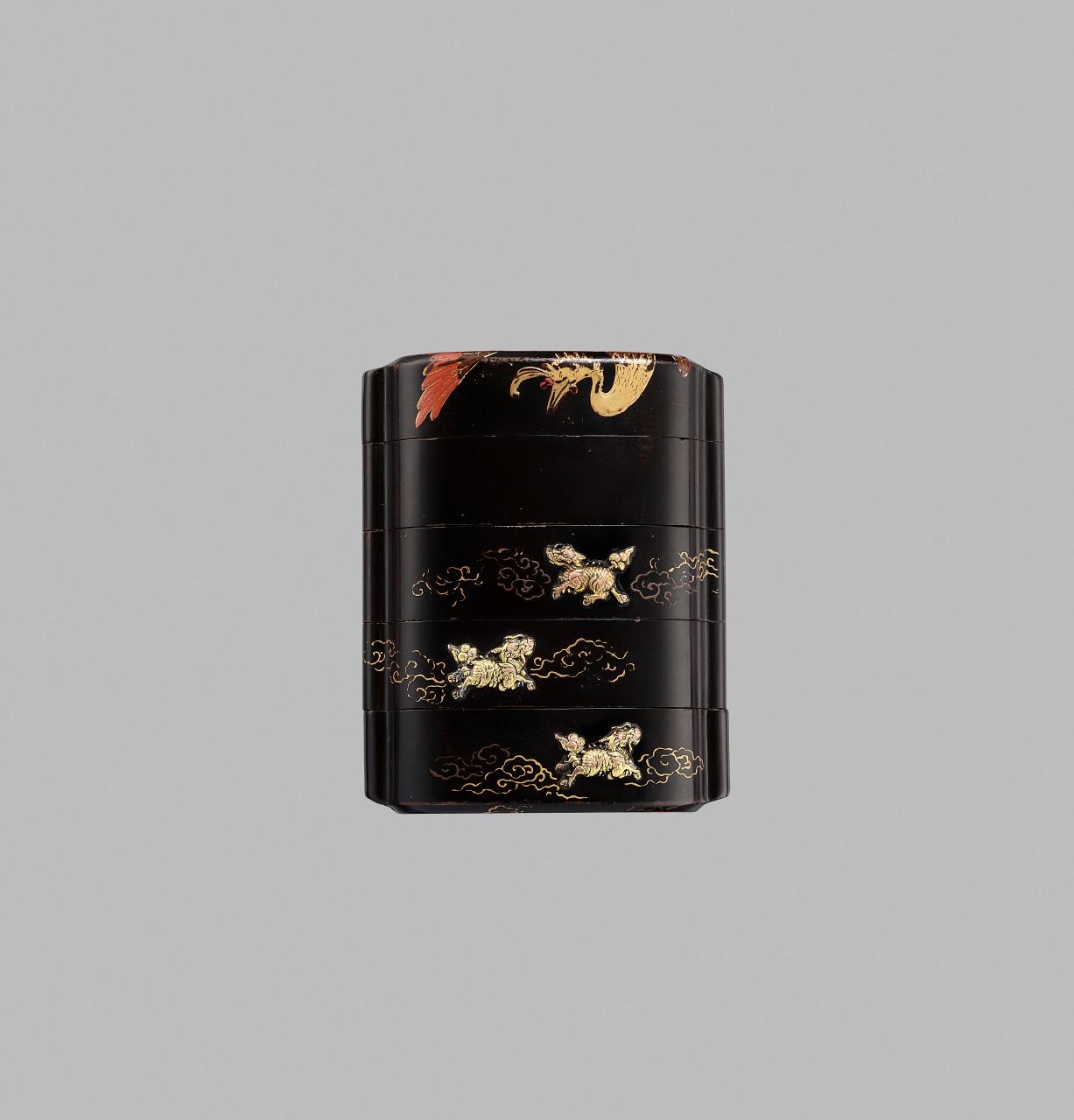

Yamamoto Shunsho lineage, signed Kyohakudo 擧白堂 with seal Shunsho 春正
Japan, 17th-18th century, Edo period (1615-1868)
The roiro ground finely decorated in gold and colored hiramaki-e, e-nashiji, and gilt-copper takazogan to depict three prancing shishi amid swirling clouds to either side, all below a majestic ho-o bird looking down toward the small shishi. The interior of rich nashiji with gold fundame edges. The base signed Kyohakudo with a red seal SHUNSHO.
HEIGHT 6.6 cm
Condition: Good condition with minor wear, tiny nibbles to edges, few minor age cracks, few small nicks, minor losses to lacquer. Some rubbing to gilt.
Estimate EUR 3,000
Starting price EUR 1,500
329
A FINE MIXED-METAL-INLAID GOLD LACQUER FIVE-CASE INRO WITH A FINE INLAID AND LACQUERED STAG ANTLER MANJU NETSUKE BY JIYOSAI
The inro unsigned, the netsuke by Jiyosai, signed Jiyosai 慈羊斎 Japan, 19th century, Edo period (1615-1868)
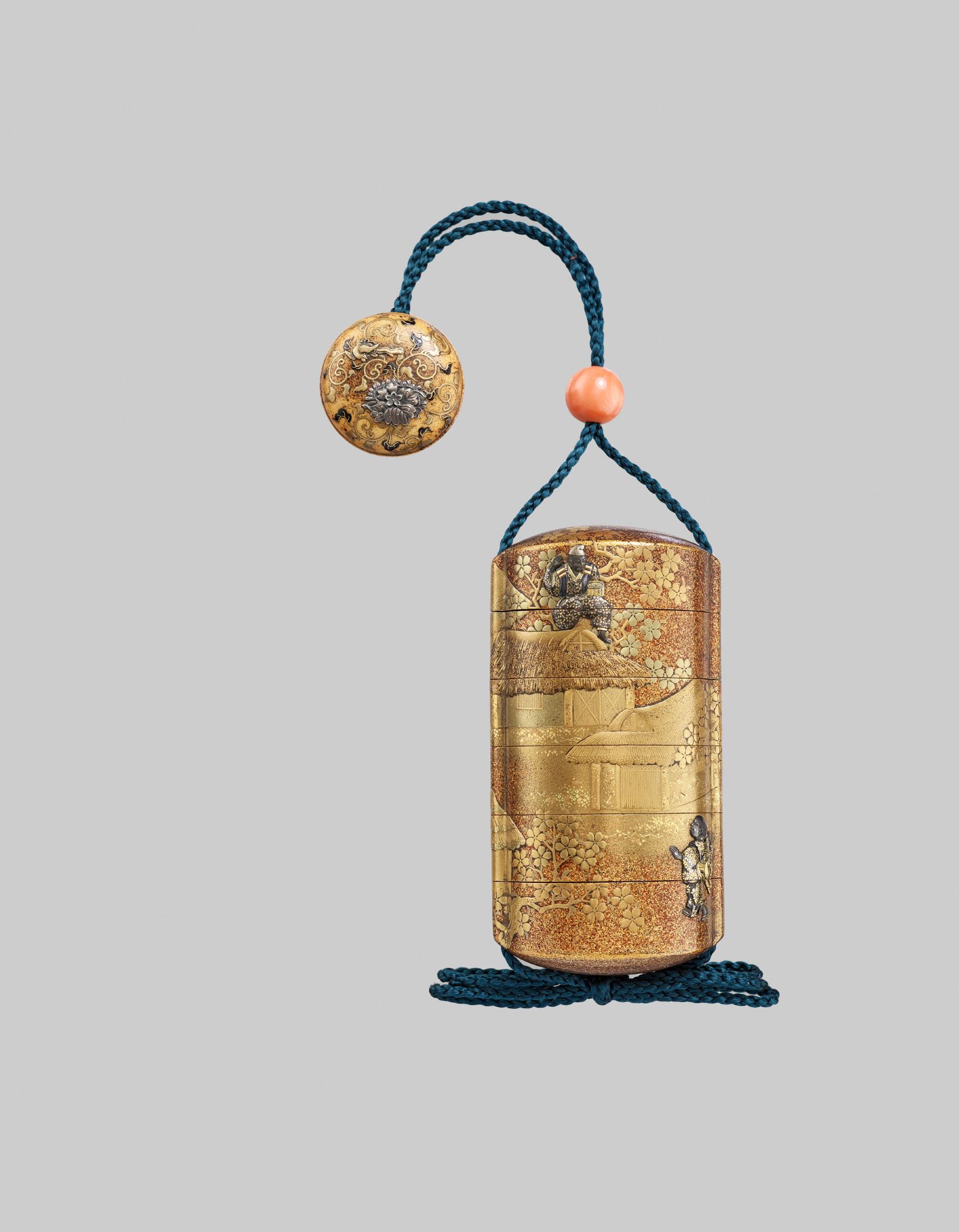
Of rounded rectangular form, bearing a gold nashiji ground finely decorated in gold and aokin, takamaki-e, kirigane, and mixed-metal takazogan to depict a man standing on the thatched roof of a hut, carrying a basket and picking fruit from flowering prunus trees, while a young boy looks up toward him from below, the other side with further houses and trees.
The two-part stag antler manju netsuke beautifully matching the inro and finely decorated in gold and black takamaki-e as well as gold and silver takazogan to depict a flying ho-o bird and a cluster of leaves and flowers amid scrolling vines, the underside and interior with the himotoshi, the underside signed JIYOSAI. The coral ojime of globular form.
HEIGHT 9.8 cm (the inro), DIAMETER 3.2 cm (the manju) and 1.2 cm (the ojime)
Condition: Excellent condition, minor wear, the stag antler manju with natural imperfections.
Provenance: Sydney L. Moss Ltd., London, June 2010. A private collection in New York, USA, acquired from the above.
Estimate EUR 3,000
Starting price EUR 1,500
330
A SUPERB SILVER SINGLE-CASE INRO DEPICTING PEONY, ATTRIBUTED TO UNNO SHOMIN

Unsigned Japan, Meiji period (1868-1912)
The inro intricately crafted with blossoming peony to either side, the furled petals neatly incised, the back with a small leaf as well. Unsigned, however attributed to Unno Shomin (see auction comparison).
The manju netsuke of rounded square form, of shakudo with a gilt border, decorated with a gold-inlaid cricket under flowers and grasses delicately carved in katakiri and kebori below a silver flat-inlaid moon, the reverse with a gold-inlaid seal reading Kakushi and a silver-inlaid foliate emblem. The signed ojime of globular form and inlaid in silver and copper with a fruiting prunus branch.
LENGTH 4.6 cm (the inro), LENGTH 3.2 cm (the netsuke), DIAMETER 1.5 cm (the ojime)
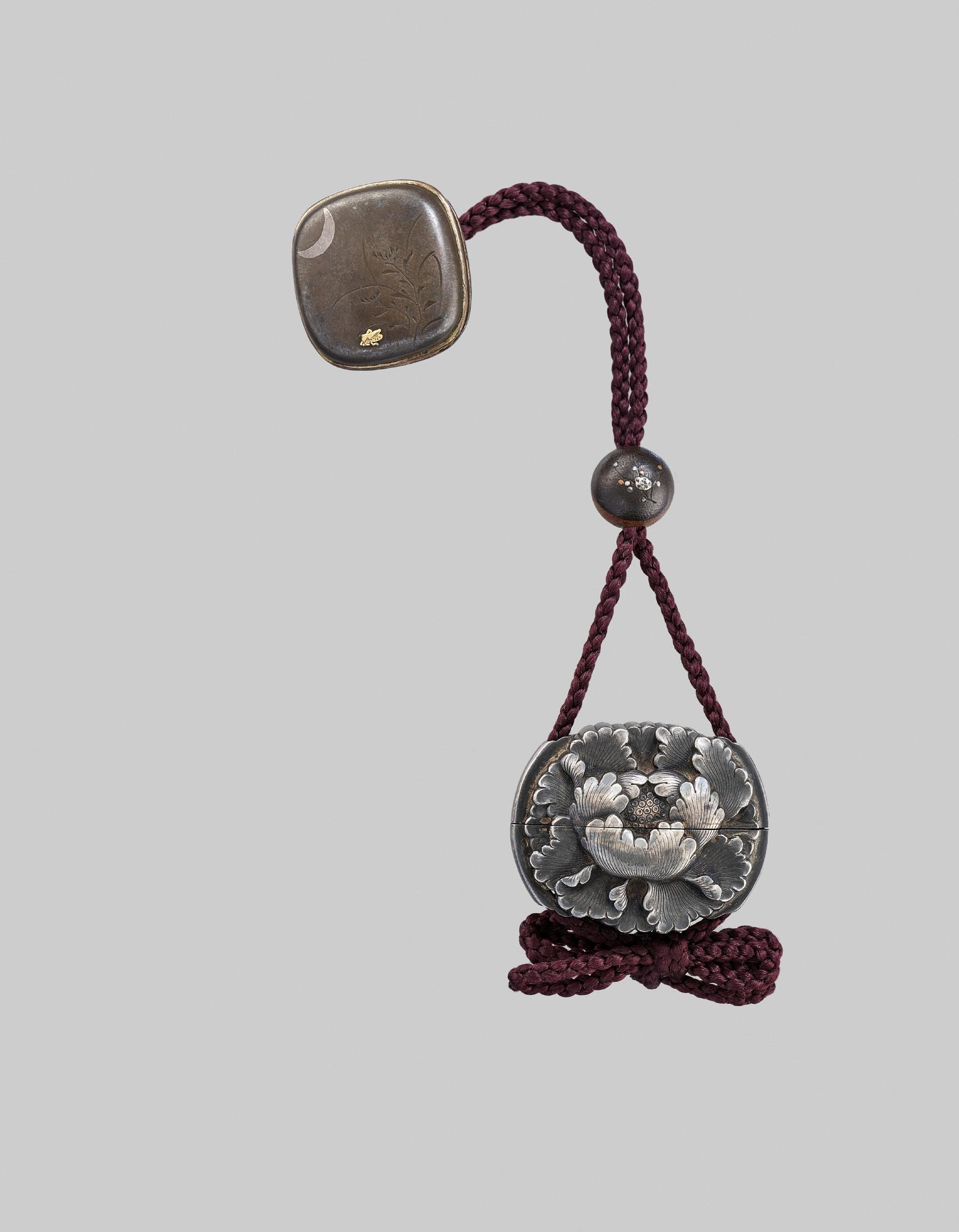
Condition: Good condition, minor wear, few small dents.
AUCTION COMPARISON
Compare a closely related silver two-case inro attributed to Unno Shomin and dated to the late Meiji period at Bonhams, Fine Japanese Art, 12 November 2008, London, lot 366 (sold for 4,200 GBP).
Estimate EUR 3,000
Starting price EUR 1,500
A FINE METAL-INLAID GOLD LACQUER FOUR-CASE INRO DEPICTING RATS AND HORSES


Unsigned Japan, 19th century
The kinji ground finely decorated in gold and silver takamaki-e and hiramaki-e with kirikane, nashiji, and beautifully inlaid in gold, shibuichi, and shakudo to depict on one side a flowerpot with blossoming prunus branches, two rats eating beans from the ground, and a third rat gnawing on a branch bearing fruit, and to the other a pair of horses in a field with chrysanthemums and grasses. The interior of nashiji with gold fundame edges.
HEIGHT 9.3 cm
Condition: Good condition with minor wear to lacquer and some occasional light scratches throughout. Some dents to the top and bottom case
The rat and the horse represent opposite signs in the Asian zodiac and as such are considered incompatible. However, if the ‘younger’ of the two signs (the horse) submits to the ‘older’ (the rat), then the pairing can be successful. They two are occasionally depicted together in inro and netsuke art.
Estimate EUR 2,500
Starting price EUR 1,200
342 331
332
A RARE METAL-INLAID GOLD-LACQUER FOUR CASE SAYA (SHEATH) INRO DEPICTING SUMO WRESTLERS


Unsigned Japan, 19th century
The saya bearing a kinji ground, finely decorated in gold and colored takamaki-e with kirikane, nashiji, and iro-e takazogan to depict a pair of sumo wrestlers facing off in the center of the dohyo (ring), both standing in dynamic poses with the arms extended and legs spread, their feet planted firmly on the floor. The circumference of the dohyo is outlined with bailed straw in gold lacquer with each twist delicately rendered. To the verso, a banner decorated in fretwork bears two mon, one a pair of circling ho-ho birds and the other the Katabami mon. The removable internal compartments are decorated with an all over design of the Katabami mon in gold hiramaki-e, the interiors of rich nashiji with gold fundame edges.
HEIGHT 7.7 cm
Condition: Very good condition with minor typical wear and traces of use.
Estimate EUR 3,000
Starting price EUR 1,500
343
333 SHIOMI MASANARI: A FINE BLACK LACQUER FOUR-CASE INRO DEPICTING A SLEEPING WILD BOAR AND SILVER MOON, WITH A LACQUERED MANJU NETSUKE

The inro by Shiomi Masanari (1647-1722), sealed Shiomi Masanari
鹽見政誠; the netsuke by Kensai Tonei, signed Kensai 賢哉 Japan, 18th century, Edo period (1615-1868)
Of rounded rectangular form, the superbly polished, lustrous roiro ground with sparse gold hirame, decorated in gold hiramaki-e and takamaki-e with aogai inlays to depict a wild boar sleeping amid autumnal flowers and foliage, its hooves, tusks, snout, and one eye subtly inlaid with mother-of-pearl, its fur well painted, continued on the reverse beneath the full moon in stunning silver togidashi-e. The interior of roiro with gold fundame edges. The reverse signed with two seals SHIOMI and MASANARI.
The manju netsuke of circular form, bearing a rogin (shibuichi) ground decorated in gold takamaki-e with a leafy chrysanthemum, the reverse signed KENSAI. The dark lacquered bead ojime of globular form.
HEIGHT 7.3 cm (the inro), DIAMETER 3.3 cm (the manju netsuke)
Condition: Very good condition with minor wear. One tiny chip to the edge of one cord-runner, one small nibble to edge of one case. The manju netsuke with tiny nicks and few light surface scratches.
Provenance: Ex-collection Harriet Szechenyi. Bonhams, The Harriet Szechenyi Sale of Japanese Art, 8 November 2011, London, lot 258 (sold for 3,500 GBP). A private collection in New York, USA, acquired from the above.
Shiomi Masanari (1647-1722) was a talented painter of the Kano school, however he is better known for his lacquerwork and the important family of lacquerers that he founded. The Shiomi family also specialized in togidashi-e (‘brought out by rubbing’) lacquer of extremely high quality, as is exhibited in the present piece.
AUCTION COMPARISON
Compare a closely related black lacquer four-case inro depicting a sleeping boar by Shiomi Masanari, dated to the 18th century, lacking the aogai inlay, at Bonhams, 7 November 2013, London, lot 114 (sold for 4,000 GBP).


Estimate EUR 4,000
Starting price EUR 2,000
344
334 SHIOMI MASANARI: A FINE INLAID BLACK LACQUER FOUR-CASE INRO DEPICTING A RABBIT AND SILVER MOON
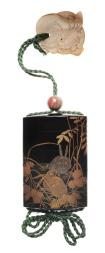 By Shiomi Masanari (1647-1722), signed Shiomi Masanari 鹽見政誠
By Shiomi Masanari (1647-1722), signed Shiomi Masanari 鹽見政誠
hitsu 筆 and sealed Masanari 政誠 Japan, 18th century, Edo period (1615-1868)
Of oval section, bearing a superbly polished, lustrous roiro ground finely decorated in gold and colored hiramaki-e and aogai inlays to depict a rabbit hiding beneath bean pods under a rising full moon delicately rendered in stunning silver togidashi-e to the reverse, the interiors of rich nashiji with gold fundame edges, the reverse signed SHIOMI MASANARI hitsu [painted by Shiomi Masanari] and sealed MASANARI.
With a beautifully polished pale green hardstone ojime of globular form.
HEIGHT 9.8 cm
Condition: Very good condition with minor wear, few small losses to inlays, one minor touchup to lacquer, possibly a few minor touchups to inlays, the ojime with a small chip and hairline fissure.
Provenance: Bonhams, 13 September 2011, New York, lot 2097 (sold for 6,000 USD). A private collection in New York, USA, acquired from the above.

Shiomi Masanari (1647-1722) was a talented painter of the Kano school, however he is better known for his lacquerwork and the important family of lacquerers that he founded. The Shiomi family also specialized in togidashi-e (‘brought out by rubbing’) lacquer of extremely high quality, as is exhibited in the present piece.
AUCTION COMPARISON
Compare a related inro depicting rabbits, signed in seal-form Shiomi Masanari and dated to the 19th century, lacking the aogai inlay, at Bonhams, The Misumi Collection of Important Works of Lacquer Art and Paintings Part II, 10 November 2015, London, lot 14 (sold for 10,000 GBP).

Estimate EUR 4,000
Starting price EUR 2,000
JOKASAI: A FINE GOLD LACQUER FOUR-CASE INRO WITH PIGEONS IN A PLUM TREE
By Yamada Jokasai, signed Jokasai 常嘉齋 Japan, 19th century, Edo period (1615-1868)
The four-case inro of wide rectangular form, magnificently lacquered, bearing a lustrous kinji ground, decorated in predominantly gold takamaki-e with silver and red highlights, as well as some kirikane and gold hiramaki-e, the front showing a group of five pigeons perched on a gnarled plum tree, huddled close together in the cold, the blooming plum blossoms with some buds indicating that spring is about to arrive. The verso continuing the image and showing a branch with further plum blossoms and buds. The interior cases of rich nashiji with gold fundame rims. Signed underneath JOKASAI.
With an agate ojime and an unusual metal manju netsuke with floral décor and applied with rubies and other hardstones.

HEIGHT 8.7 cm
Condition: Good condition with minor wear and light surface scratches. Some minor touch-ups to the side and bottom case.
Normally blooming from as early as mid-February, while it is still winter, the plum or ume blossom is revered and celebrated as endurance through adversity, the resilience of life, and faith that life will regenerate.
Estimate EUR 4,000
Starting price EUR 2,000
346 335
336
A LACQUER FOUR-CASE INRO DEPICTING CRANES WITH EN SUITE OJIME AND NETSUKE

Unsigned Japan, 19th century

Of oval section, bearing a roiro ground sprinkled with dense gyobu nashiji and decorated in gold and colored takamaki-e to one side with three standing red-capped cranes, two of which are eating kirikane seeds from a large footed basin, and to the other with two cranes in flight amid thick swirling clouds. The interiors of rich nashiji with gold fundame edges. The matching two-part manju netsuke of circular form, similarly decorated in iro-e takamaki-e with clouds on a gyobu nashiji ground. The gold-lacquered ojime of globular form.
HEIGHT 7.7 cm
Condition: Very good condition with only minor wear. With an inscribed wood tomobako (storage box)..
AUCTION COMPARISON
Compare to a related inro depicting feeding cranes, by Kanshosai Toyo, at Zacke, Fine Netsuke & Sagemono, 29 October 2021, Vienna, lot 324 (sold for 4,803 EUR).
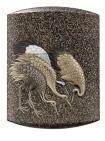
Estimate EUR 2,000
Starting price EUR 1,000
347
337
A FINE LACQUER FOUR-CASE INRO DEPICTING CHRYSANTHEMUMS
Unsigned Japan, 18th-19th century, Edo period (1615-1868)
The gold-sprinkled roiro ground finely decorated in gold and silver takamaki-e and kirikane to depict overlapping chrysanthemum blossoms of varying designs and different sizes, interspersed by smaller aster blooms, the interior of rich nashiji with gold fundame edges.
HEIGHT 8 cm
Condition: Very good condition with minor wear and discoloration to lacquer.
Provenance: French private collection, assembled in Paris during the 1950s and 1960s.
MUSEUM COMPARISON
Compare a related four-case inro similarly decorated with overlapping chrysanthemum blossoms on a gold-sprinkled roiro ground, signed Kajikawa saku with a red ‘tsubo’ seal Ei, also dated 18th-19th century, in the Metropolitan Museum of Art, accession number 29.100.884.

AUCTION COMPARISON
Compare a related five-case inro similarly decorated with overlapping chrysanthemum blossoms on a gold-sprinkled roiro ground by Hokugasai, dated 19th century, with a coral ojime, at Bonhams, The Last Treasures from the Edward Wrangham Collection of Japanese Art, 19 July 2021, London, lot 140 (sold for 3,187 GBP).

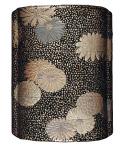
Estimate EUR 2,000
Starting price EUR 1,000
348
338
KOMA KORYU: A FINE LACQUER FOUR-CASE INRO WITH PEONIES
By Koma Koryu, signed Koma Koryu 古満巨柳 with kakihan Japan, late 18th to early 19th century, Edo period (1615-1868)
Of rounded rectangular form, the dense gyobu nashiji ground finely decorated in iro-e takamaki-e, hiramaki-e, kirikane, and aogai inlay to depict a large flowering greyish-white peony amid gold-veined leaves, the flower executed in simulation of pottery, a white and a red bud to one side, the other side similarly decorated with a red peony amid leaves and a red bud. The interior of nashiji with gold fundame edges. The underside with the lacquered signature KOMA KORYU and kakihan.



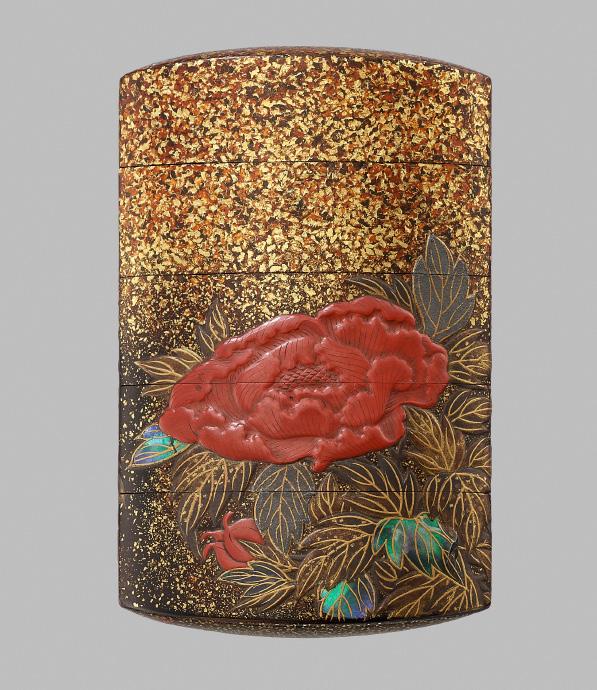
HEIGHT 8 cm
Condition: Good condition with minor wear, few tiny nicks to edges and aogai inlays. The lacquer a little dry. Tiny repair to the edge of the smaller white flower and minuscule losses to lacquer throughout, as to be expected.
Provenance: From the collection of Gaston Lazard (1878-1956) and his wife Jane Levy (1886-1985) and thence by descent within the same family.
MUSEUM COMPARISON
Compare a related three-case inro by Koma Yasumasa, dated late 18th to early 19th century, in the Museum of Fine Arts, Boston, accession number 21.2337.
AUCTION COMPARISON
Compare a related lacquer four-case inro by Koma Yasutada, 8.9 cm high, dated 19th century, with an unsigned black lacquer ojime, at Bonhams, The Edward Wrangham Collection of Japanese Art Part III, 15 May 2012, London, lot 260 (sold for 7,500 GBP).
Estimate EUR 2,000
Starting price EUR 1,000
349

339
A MASTERFUL WALRUS TUSK FOUR-CASE INRO DEPICTING A SWALLOW AMONGST FLOWERS

Unsigned Japan, Osaka/Tokyo, late 19th century
Superbly carved in relief to one side with a swallow flying above a chrysanthemum blossom amid bamboo stalks and smaller aster blooms, the other side with flowering peony and bamboo stalks, each side framed by scrolling clouds to the top and craggy rockwork to the base, the top carved with a diapered wave design and the base carved with a leaf. The swallow’s visible eye is inlaid.
The narwhal tusk netsuke carved with a foliate rim and small openings, the center fitted with a gold-inlaid shibuichi kanamono in the form of a flowering branch. The bone ojime carved in openwork with a floral design.
HEIGHT 10.2 cm (the inro), LENGTH 6.2 cm (the netsuke), DIAMETER 1.6 cm (the ojime)

Condition: Very good condition with three tiny chips to the edge of three leaves. Few natural age cracks.
The overall quality of the inro strongly suggest the master carver Kaigyokusai Masatsugu (1813-1892), or at the very least a close follower. Though rarely, Kaigyokusai was known to work in marine ivory and his inro usually featured floral décor carved in unparalleled relief. The artist of this superb inro clearly had a superior appreciation for this material, as the natural marbling and typical striations enhance the effect of the composition beautifully.
AUCTION COMPARISON
Compare to a closely related ivory inro by Kaigyokusai Masatsugu, with similar relief carving to the floral depiction, at Bonhams, The Edward Wrangham Collection of Japanese Art Part II, 10 May 2011, London, lot 328 (sold for 24,000 GBP). Another related inro carved from ebony, by Kaigyokusai Masatsugu, was sold at Bonhams, The Edward Wrangham Collection of Japanese Art Part V, 5 November 2014, London, lot 203 (sold for 21,250 GBP).
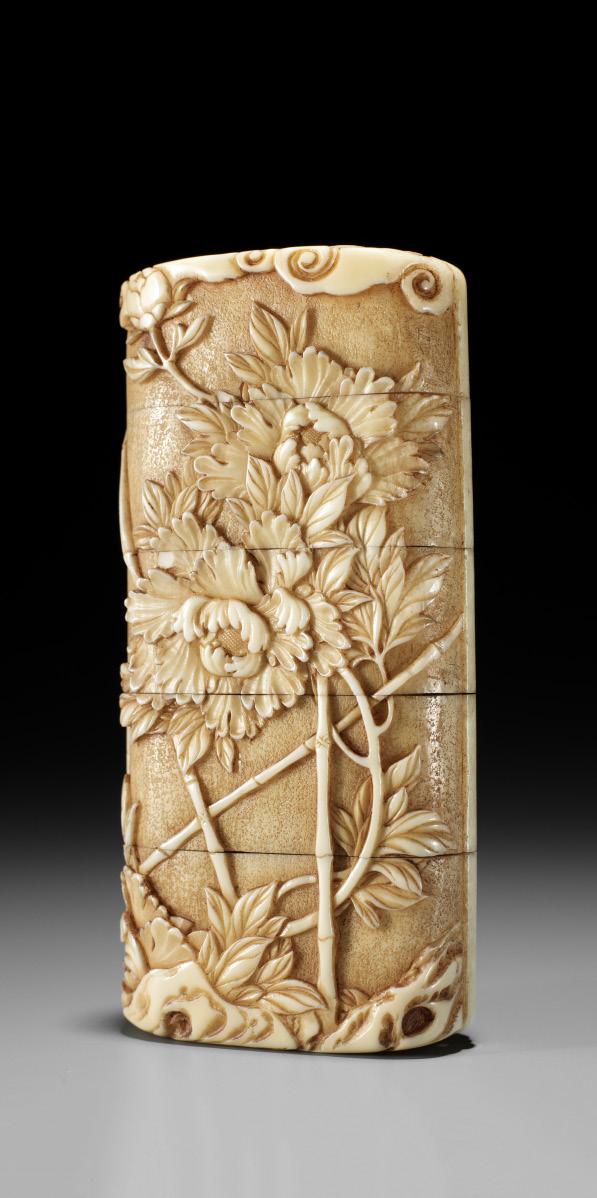
Estimate EUR 6,000
Starting price EUR 3,000
351
AN UNUSUAL INLAID GOLD LACQUER AND TSUISHU FOUR-CASE INRO WITH MONKEYS
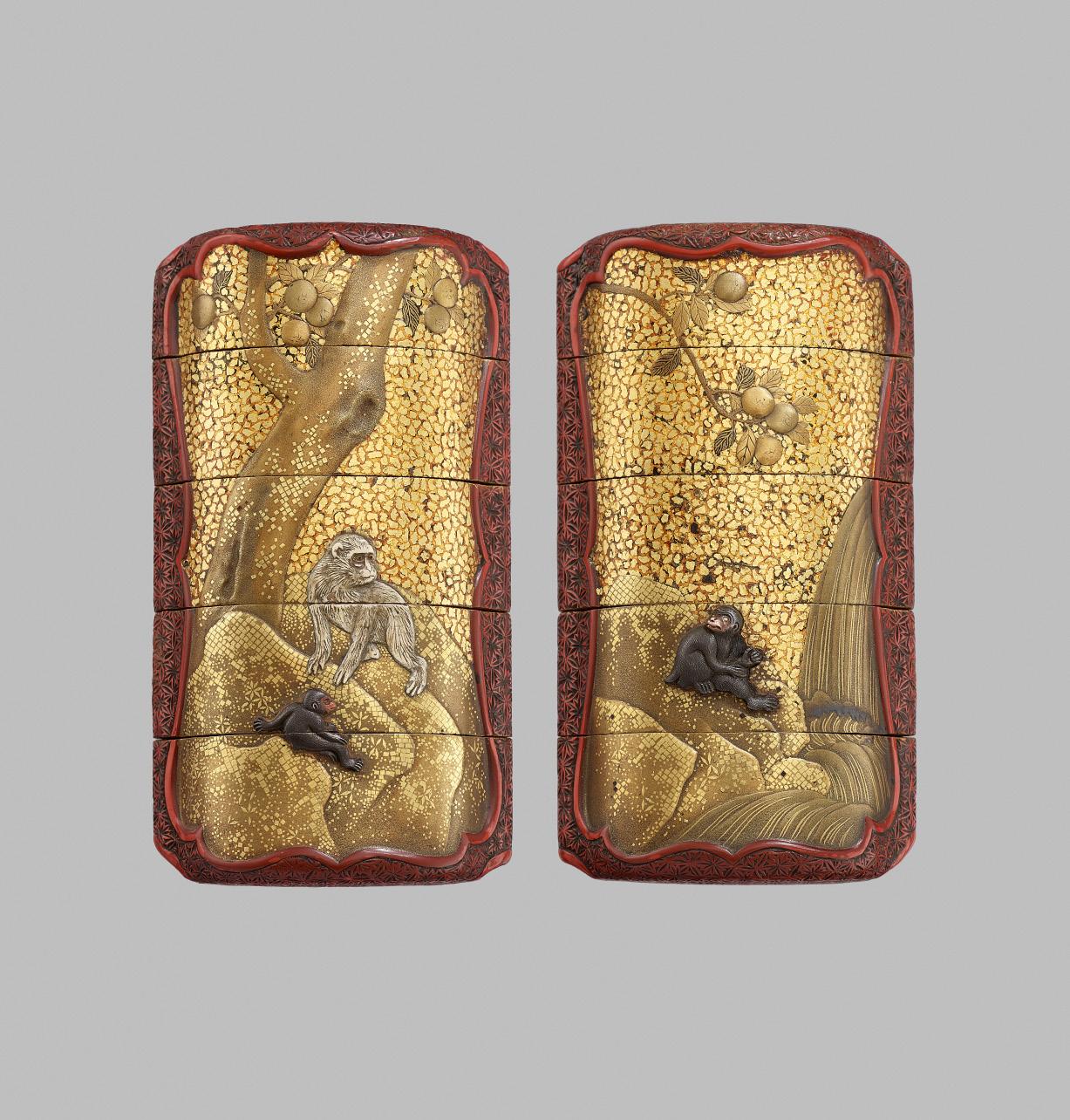
Unsigned Japan, 19th century, Edo period (1615-1868)
Each side with a foliate-lobed panel bearing a hirame ground finely decorated in predominantly gold takamaki-e, hiramaki-e, and kirikane as well as mixed-metal and lacquered-pottery inlays, depicting to one side a monkey with gold eyes seated on a rock beneath a flowering peach tree beside a waterfall, and to the other two further monkeys under a towering peach tree. The sides, top, and bottom of tsuishu (carved red lacquer) with diapered asanoha. The interior of rich nashiji with gold fundame edges.
HEIGHT 9.5 cm
Condition: Very good condition with minor surface wear and losses to gold flakes, the interiors with few expected age cracks and small nibbles to edges. The cases are rigid, particularly the top case.
Provenance: Hotel Drouot, Paris, 26 April 1967, lot 19. French private collection, assembled in Paris during the 1950s and 1960s, acquired from the above. The interior with a cut-out of the original Drouot catalog description for the present lot, inscribed with the sale date.
The combination of lacquer techniques on the present inro is most unusual.
Estimate EUR 4,000
Starting price EUR 2,000
352 340
341 AN EXQUISITE INLAID WOOD THREE-CASE INRO DEPICTING RABBITS
Unsigned Japan, late 19th century, Meiji period (1868-1912)
The wood ground finely decorated with Shibayama-sytle inlays of mother-of-pearl, coral, malachite, aventurine, wood, gold, and stained bone to depict two hares seated on the ground, one with its head raised toward the sky, no doubt looking up at the moon, both animals well detailed with neatly incised fur, round eyes, and long funnel-shaped ears, the ground further carved to indicate pebbles, the resulting recesses filled with gold dust.
Condition: Very good condition with minor wear, some light scratches to the top case.
Provenance: From an old East German private collection, assembled before 1980.
AUCTION COMPARISON
Compare a related gold-lacquer Shibayama-inlaid four-case inro also depicting two rabbits, the inlay by Masayuki, 9 cm high, dated Meiji period, with a wood netsuke in the form of a mushroom and a glass bead ojime, at Bonhams, 11 May 2017, London, lot 90 (sold for 2,750 GBP).

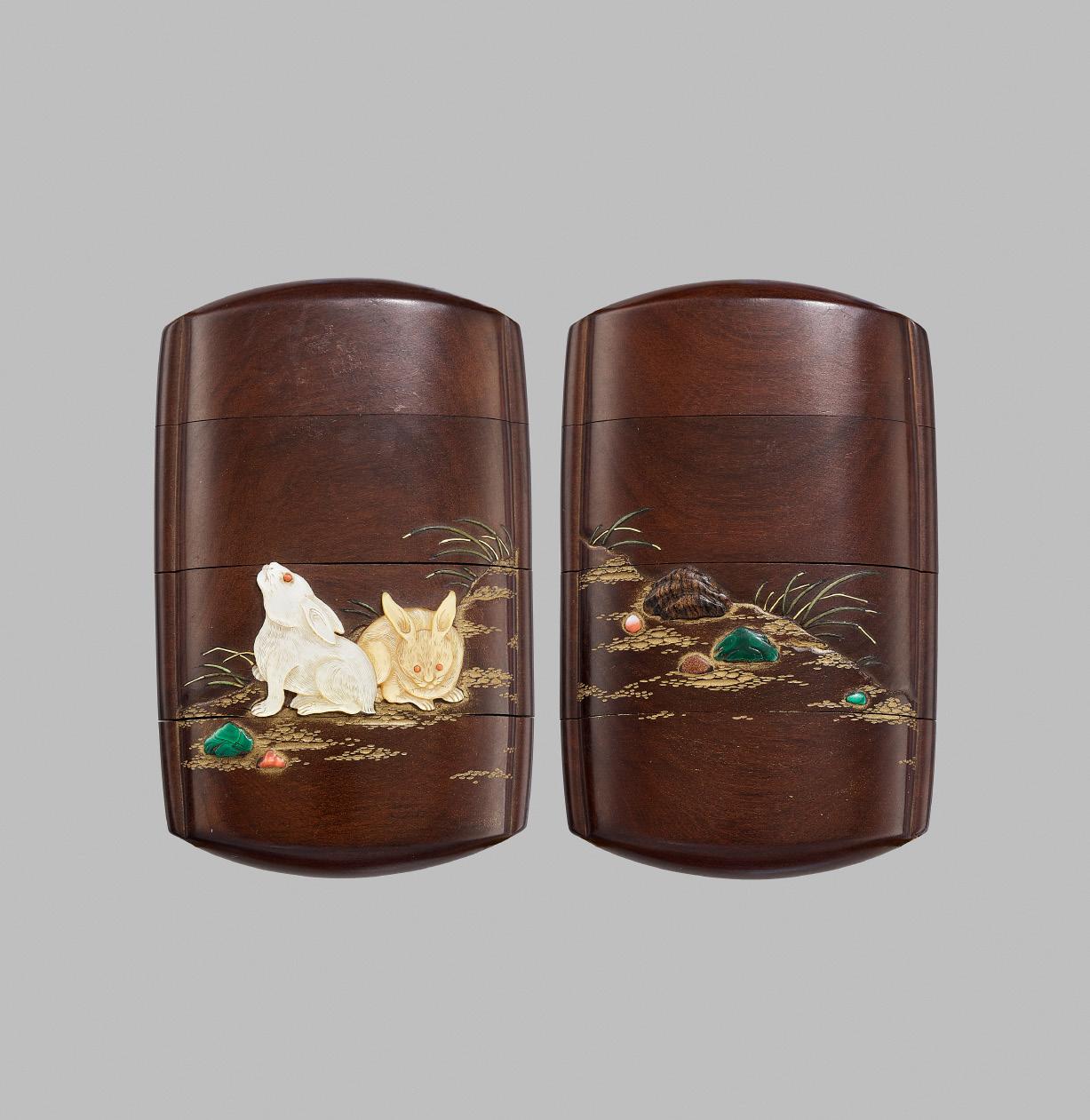
Estimate EUR 4,000
Starting price EUR 2,000
353
HEIGHT 8.5 cm
Unsigned Japan, late 19th century, Meiji period (1868-1912)
Each side with a silver-rimmed quatrefoil panel bearing a kinji ground finely inlaid in mother-ofpearl, horn, coral, tortoiseshell, and bone, one side with two karako playing music, one striking a dynamic pose with one foot raised and wearing a Korean-style hat while playing a transverse flute, the other seated on the ground and striking a drum with a mallet held in his hand, a bird-form wheeled toy at their feet, the other side with a karako standing next to a barrel-form stool, holding a fan and feeding a bird on a perch hanging from a gnarled prunus tree, all in a fenced garden with peonies, the surrounding hirame ground decorated in gold takamaki-e and kirigane with kiri mon and chrysanthemum designs. The interior of nashiji with gold fundame edges. The faceted bead-form metal ojime decorated in relief with a peacock amid leafy floral sprays.

HEIGHT 8 cm
Condition: Excellent condition with minor wear to hirame and very minor general wear.
Estimate EUR 10,000
Starting price EUR 5,000
354
342 A SUPERB SHIBAYAMA INLAID GOLD LACQUER FOUR-CASE INRO DEPICTING KARAKO

343
KAJIKAWA: A VERY RARE GOLD LACQUER FIVE-CASE INRO DEPICTING DUTCHMEN


By a member of the Kajikawa family, signed Kajikawa 梶川 saku 作 Japan, 19th century, Edo period (1615-1868)
Of lenticular section, the lustrous bright kinji ground superbly decorated in iro-e takamaki-e with hiramaki-e detailing to depict two Dutchmen, both typically dressed, one holding a long clay pipe and leaning against a cherry tree with a pensive expression, his head resting in his hand, and to other supporting himself on his walking stick. The interiors of nashiji with gold fundame edges. The base signed KAJIKAWA saku [made by Kajikawa]. With a reticulated metal ojime bearing a shippo pattern.
HEIGHT 9.7 cm
Condition: Excellent condition with minor wear, mostly to interior lacquer, few microscopic nibbles to edges as is to be expected.
Provenance: A private collection in New York, USA. The interior with an inscribed label, ‘No, 7 – 350 Kajikawa’.
AUCTION COMPARISON
Compare a related gold lacquer four-case inro by Koma Kyuhaku depicting Dutchmen at Bonhams, 6 November 2012, London, lot 40 (sold for 37,250 GBP). Compare a related silver lacquer five-case inro by Hara Yoyusai depicting Portuguese traders at Bonhams, 6 November 2012, London, lot 37 (sold for 46,850 GBP).

Estimate EUR 8,000
Starting price EUR 4,000
356
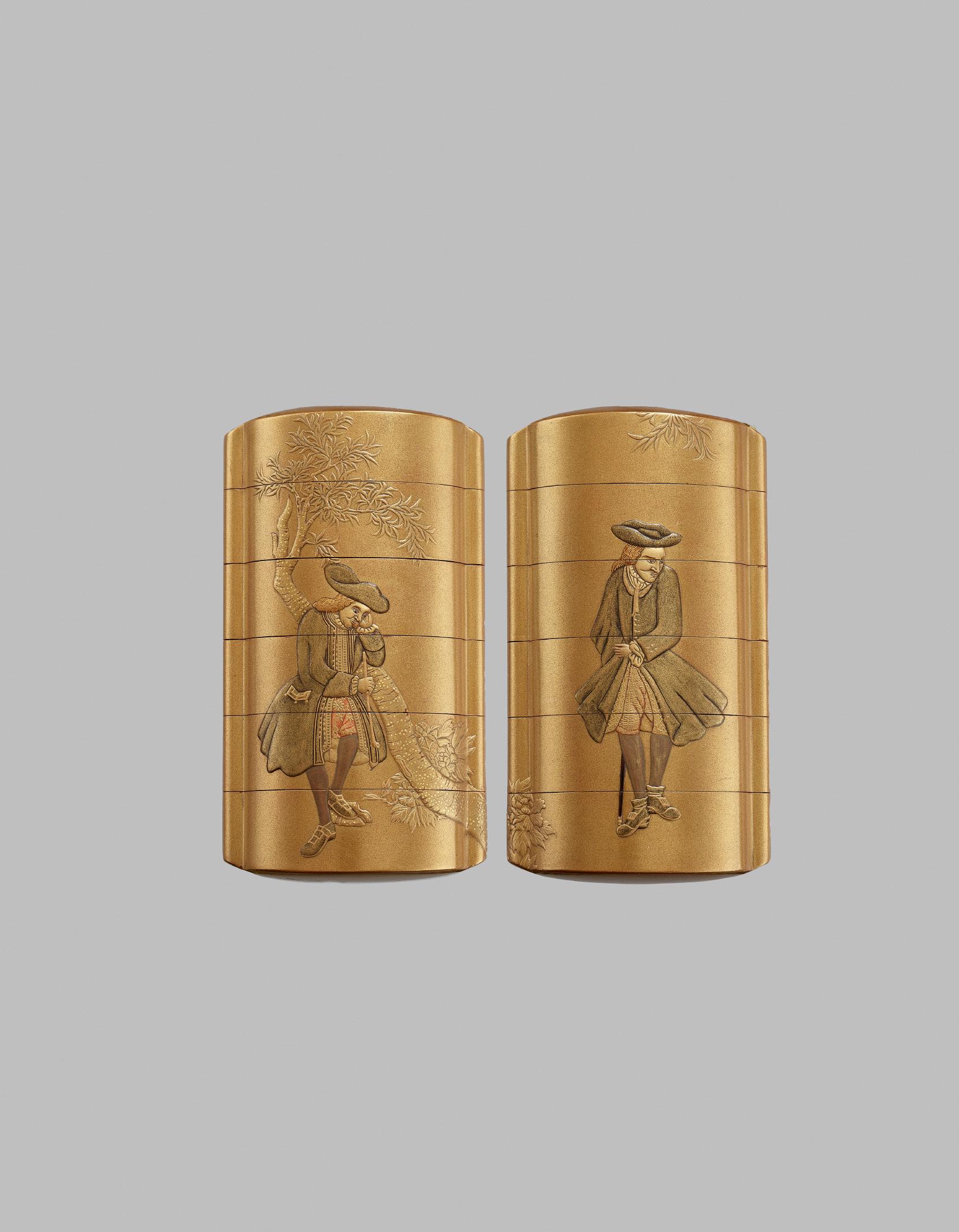
344
YOYUSAI: AN EXQUISITE SMALL LACQUER FOUR-CASE INRO DEPICTING OKAME AND ONI AT SETSUBUN
 By Hara Yoyusai
By Hara Yoyusai
Finely decorated in gold and colored takamaki-e and hiramaki-e with e-nashiji and aogai inlays, one side with a rectangular kinjiground panel enclosing Okame reaching into a sanpo (offering stand) to grab soybeans, the other with a circular nashiji-ground panel enclosing a fleeing oni, both panels surrounded by snowladen bamboo stalks and leaves. The interior of nashiji with gold fundame edges. The base signed in gold lacquer YOYUSAI saku. With a gold lacquer ojime decorated with blossoming flowers and a metal-inlaid butterfly, signed Tenmin (Asama Tenmin) with an inlaid rectangular reserve.
HEIGHT 5.6 cm (the inro) and DIAMETER 1.4 cm (the ojime)
Condition: Excellent condition with minor wear.
Provenance: French private collection, assembled in Paris during the 1950s and 1960s.
The present inro alludes to the Setsubun festival, which is celebrated during the first day of spring and includes the rite of oniyarai or mame-maki, where roasted beans are thrown at oni to rid the coming year of any demons and disease-bringing spirits.
Hara Yoyusai (1772-1845/6) lived in Edo and worked under the patronage of Lord Matsudaira. He had an extensive workshop and a large number of lacquer objects were produced with his signature, or just with his kakihan. Yoyusai had many pupils, the most renowned being Nakayama Komin, who became famous in his turn for work in the style of ancient and classic lacquerers.
Estimate EUR 3,000
Starting price EUR 1,500
358
(1772-1845/6), signed Yoyusai 羊遊齋 saku 作 Japan, Edo (Tokyo), 19th century, Edo period (1615-1868)
JOKASAI: A LACQUER FOUR-CASE INRO DEPICTING SHOKI AND ONI

HEIGHT 8.7 cm
Condition: Very good condition with minor wear to lacquer and light rubbing to the surface.
By
Yamada Jokasai, signed Jokasai 常嘉齋 saku 作 Japan, 19th century, Edo period (1615-1868)
Of lenticular section, the roiro ground sprinkled with dense nashiji and decorated in gold and iro-e hiramaki-e and takamaki-e to one side with Shoki seen through a circular window, his face with a grim expression, his finely painted beard and hair flowing as he watches a fleeing oni who is running away to the other side. The demon, surrounded by a billowing scarf, is neatly detailed with beautifully polished iro-e takamaki and hiramaki-e. The interiors of rich nashiji with gold fundame edges. The base with the gold-lacquered signature JOKASAI saku [made by Jokasai].
This design is traditionally attributed to the Zeshin school or to Koma Kansai.

LITERATURE COMPARISON
Compare a closely related Zeshin school inro depicting the same subject, illustrated in Sydney L. Moss Ltd. (2014) Lac Lacquer Lacquest, no. 114.
Estimate EUR 3,000
Starting price EUR 1,500
359
345
A FINE INLAID LACQUER TONKOTSU WITH NEW YEAR DESIGN, ATTRIBUTED TO SHIBATA ZESHIN

Attributed to Shibata Zeshin (1807-1891), unsigned Japan, late 19th century
Of rounded rectangular form, the superb black ishime ground decorated in gold, brown, and black takamaki-e and aogai inlays to depict an oni escaping from beans that are raining down upon him, using a large hat to shield himself, the reverse with further soybeans and a window with bamboo bars, from which a tiny rat peeks out, all underneath shimenawa hangings, such as shide and pine saplings. Unsigned, however attributed to the school of Shibata Zeshin (1807-1891), who created similar designs and used a very similar ground on his lacquerworks.
HEIGHT 9.5 cm
Condition: Good condition with minor wear, few small age cracks, some losses to and near the window.
The imagery on the present tonkotsu are all evocative of New Year’s celebrations as the rat is companion of the lucky god of wealth Daikoku, who is often seen pelting soy beans at oni during the rite of oni-yarai which is celebrated on New Year’s day. Shimenawa hangings are also found throughout households during the New Year. This way of alluding to a specific event through clever use of imagery is very typical for Zeshin and his followers.
LITERATURE
COMPARISON
For three similar examples depicting the same subject, signed Zeshin, Koma Kansai, or both, see Sydney L. Moss Ltd. (2014) Lac Lacquer Lacquest, pp. 288-289.
AUCTION COMPARISON
Compare a closely related lacquer tonkotsu, described as “after Shibata Zeshin” and dated late 19th century, with a similar black ground imitating cast iron, and also depicting an oni at Setsubun, formerly in the collections of Raymond Bushell and Edward Wrangham, at Bonhams, 9 July 2018, London, lot 122 (sold for 2,000 GBP).

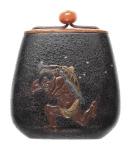
Estimate EUR 3,000
Starting price EUR 1,500
Samurai Mouse chasing away demons during the New Year, ink painting, Shibata Zeshin (1807-1891)

346
A SUPERB LACQUER TONKOTSU DEPICTING A CUCKOO SINGING IN THE MOONLIGHT

Unsigned Japan, 19th century

Bearing a roiro ground, save for the side beneath the hinged cover which is lacquered silver to indicate the crescent moon when the cover is closed, finely decorated in gold and colored thick takamaki-e to depict a flying cuckoo (hototogisu) with its beak agape as it sings, the reverse with masterful togidashi grasses and lantern fruit, the sides with crickets and winged insects. The interior of roiro. The lacquer ojime of faceted form and decorated in gold hiramaki-e with stylized flowerheads and a paulownia design.
A most charming tonkotsu, the shape ingeniously adding to the subject matter and the two main lacquer techniques used, togidashi and takamaki-e, beautifully contrasting with each other.
LENGTH 10.5 cm
Condition: Very good condition with minor surface wear.
Cuckoos are a popular subject of waka and haiku poets. A prominent characteristic of this bird is that it sings in the night as it flies, as depicted in the present lot. A poem by Sanesada no Fujiwara (1139-1191) on the cuckoo, from the Ogura Hyakunin Isshu, reads:

Nakitsuru kata wo Nagamureba
Tada ariake no Tsuki zo nokoreru.
(The cuckoo’s echo dies away, And lo! the branch is bare I only see the morning moon, Whose light is fading there Before the daylight’s glare.)
Estimate EUR 5,000
Starting price EUR 2,400
Cuckoo with Moon, by Ohara Shoson, c. 1900, Los Angeles County Museum of Art, accession number M.2005.158.50
A LARGE AND FINE INLAID AND CARVED WOOD TONKOTSU WITH DRAGON,
Unsigned Japan, late 19th century
TIGER AND SHISHI
Finely carved and decorated with inlays of stag antler, motherof-pearl, tortoiseshell, horn, and bone, depicting to one side a snarling tiger amid bamboo beside a three-clawed sinuous dragon amid swirling clouds over crashing waves, and to the other with two shishi with wild scrolling manes in a field with craggy rockwork and flowering peony, the top inlaid with a leafy peony spray and fluttering butterfly, the cord runners ringed in stained bone.
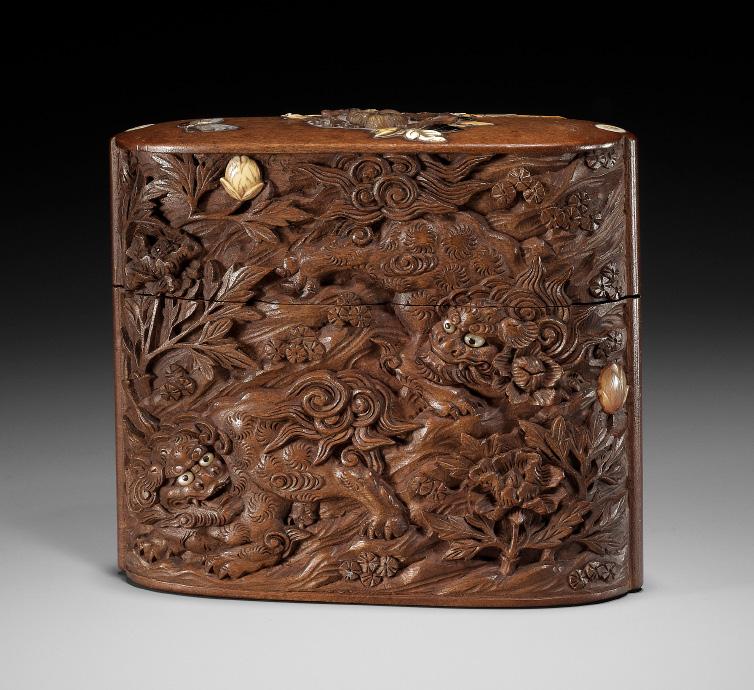

HEIGHT 9.3 cm, LENGTH 10.6 cm
Condition: Excellent condition with minor wear, light scratches and small age crack to the underside, the inlays well preserved with no losses whatsoever.
Provenance: Ex-collection Paul Doumer. Excollection Emile Goubert, thence by descent in the family. The base with an old label inscribed ‘100’. Joseph Athanase Doumer (1857-1932), commonly known as Paul Doumer, was the President of France from 13 June 1931 until his assassination on 7 May 1932. He was GovernorGeneral of French Indochina from 1897 to 1902, and successfully lobbied the French government to approve construction of the Indochina-Yunnan railway in 1898. He served as Minister of Finance of France three times and as President of the French Senate from 1927 until the 1931 presidential election, which he won. He was one of the founders and the second president of the Friends of the Natural History Museum Paris.

Estimate EUR 2,500
Starting price EUR 1,200
362 348
Paul Doumer in 1931 at the Élysée Palace
349
A POWERFUL AND RARE WOOD TONKOTSU IN THE FORM OF A HANNYA MASK
Unsigned Japan, 19th century
Well carved as a Hannya mask for the role of Kiyohime, with bulging eyes double-inlaid in pale and dark horn, the mouth wide open in a ferocious scream showing tongue and teeth flanked by sharp fangs, the hair neatly incised and wrinkles deeply carved, the interior of the hinged cover carved with a striker, forming a himotoshi underneath.


LENGTH 9.6 cm
Condition: Good condition with minor wear, light scratches. A small repair to the edge of the cover.
The Hannya mask represents a female serpent-demon filled with malicious jealousy and hatred. The mask is worn by the protagonist (shite) in the second acts of the Noh plays Aoi no Ue, Dojoji, Kurozaka, and Momijigari. The first two plays depict women betrayed or spurned by their lovers; the second two portray demons who first appear in human form to trap the unwary. Several traditions account for the name Hannya: the most plausible account traces the origins of the mask to the mask carver Hannyabo who was active in the late 15th or early 16th century. The bell striker, which forms the cord attachment in the present tonkotsu, indicates that this particular Hannya mask was used for the Dojoji play for the role of Kiyohime.
Estimate EUR 2,500
Starting price EUR 1,200
363
350
A SUPERB INLAID BURLWOOD TONKOTSU DEPICTING A SNAKE AND INSECTS IN THE MANNER OF HASEGAWA IKKO
Unsigned Japan, 19th century
Well carved from a particularly attractive section of richly gnarled and knotted burlwood, the top surrounding the circular mouth of the box smoothly polished, the interior hollowed, the box and cover superbly inlaid in mother-of-pearl, bone, mixed metal, and stag antler with a writhing snake, its head and sinuous body to the cover and its tail to the underside of the box, as well as two bees, a ladybug, a beetle, and scattered leaves. The interior of the cover with a knop for the cord attachment, the box pierced with two himotoshi which are ringed in bone to the exterior. Stylistically this can be attributed to Hasegawa Ikko.

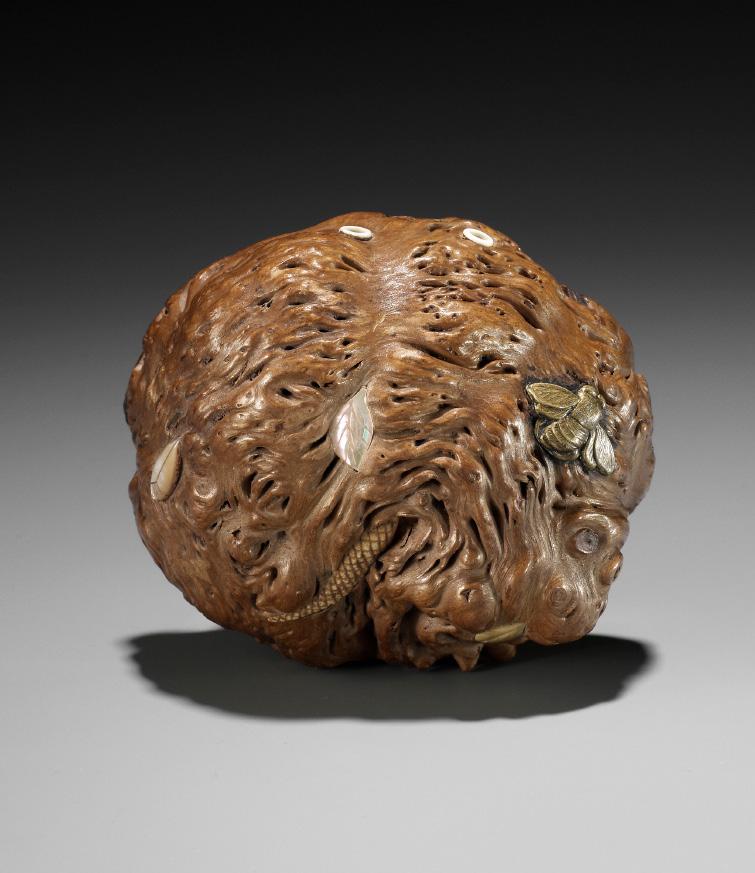

LENGTH 8 cm
Condition: Very good condition with minor expected wear and natural flaws to the material including a few fine age cracks.
AUCTION COMPARISON
Compare to an inlaid tanto with snake, by Hasegawa Ikko, at Zacke, Fine Japanese Art, 3 December 2021, Vienna, lot 71 (sold for 12,008 EUR). Also compare to an inlaid burlwood netsuke, by Nakayama Shomin, at Zacke, Fine Netsuke & Sagemono, 29 October 2021, Vienna, lot 288 (sold for 6,952 EUR).
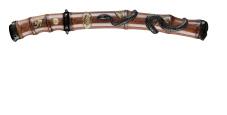
Estimate EUR 3,000
Starting price EUR 1,500
364
351
A SUPERB WOOD TONKOTSU DEPICTING A TOAD ON A LEAF WITH EN SUITE OJIME AND ‘LOTUS’ KISERUZUTSU
Unsigned
Japan, probably Hida-Takayama, 19th century, Edo period (1615-1868)
Well carved as a toad standing foursquare with webbed feet, about to leap forwards, its warty skin naturalistically detailed and darkly stained for effect, the large eyes inlaid in translucent horn with dark pupils, the underside with the ingenious cover in the form of a furled leaf with neatly incised veins and jagged edges, the cord attachment through the pierced mouth and the interior of the cover.
The ojime similarly carved as a slug on a worm-eaten leaf. The pipe case of senryu-zutsu form, one end carved as a lotus pod with movable seeds borne on a long stem, with further stems issuing finely veined lotus leaves and a smaller pod, the underside with a metal loop for the cord.
LENGTH 10 cm (the tonkotsu) and 21.4 cm (the kiseruzutsu)
Condition: Very good condition, minor wear, traces of use.
AUCTION COMPARISON
The manner of the toad, particularly the finely carved warts and double inlaid eyes, is reminiscent of the HidaTakayama carvers such as Sukenaga, Sukenao, Suketada and Sukenobu. For a related okimono of a toad and snake, by Sukenobu, see Zacke, Fine Japanese Art, 2 December 2022, Vienna, lot 168 (sold for 18,420 EUR).



Estimate EUR 5,000
Starting price EUR 2,400

MINKO: A RARE AND IMPRESSIVE UMIMATSU (SEA PINE) KISERUZUTSU OF A CORAL FISHERMAN
By Tanaka Juntoku Minko (1735-1816), signed Minko 岷江 Japan, Tsu, late 18th to early 19th century, Edo period (1615-1868)
Of senryu-zutsu type. The large section of umimatsu with stunning greenish marbling and typical concentric, reddish inclusions, carved as an exotic coral fisherman, also known as a South Sea Islander, standing on a rock embellished with inlaid stag antler barnacles, holding in one hand a large branch of coral, the other hand is held close to the face to secure the pipe. The eyes are inlaid in bone with red and black pupils. The cord channel runs through the right arm of the islander. With a bamboo and silvered metal pipe.
LENGTH (without pipe) 21.6 cm

Condition: Typical crackling and minor losses to the material as are to be expected. A small section of the inlaid coral is lost near the top. Generally, in very good condition.
Provenance: Family collection of either Felix Tikotin (18931986) or his sonin-law Louis (Loek) Borensztajn (19352021), Netherlands.
Felix Tikotin (1893-1986) was an architect, art collector, dealer, and founder of the first Museum of Japanese Art in the Middle East. He became one of the world’s leading collectors of Japanese art, starting at the age of 18, and continued to collect and work as an art dealer in Berlin in the 1920s. In the 1930s Felix Tikotin fled from the Nazis and hid his collection in the Netherlands. After the war, he decided that his collection should be taken to Israel, where in 1959 and with the help of Abba Hushi, who was the mayor of Haifa, The Tikotin Museum of Japanese Art was established. The Museum’s collection comprises more than 8,000 items of art and crafts.
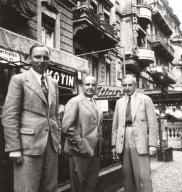
AUCTION COMPARISON
Compare a closely related umimatsu pipe case, signed Minko with kakihan, at Christie’s, The Beresford Jones Collection of Japanese Art, 7 June 200, London, lot 42 (sold for 4,700 GBP).

Estimate EUR 8,000
Starting price EUR 4,000
352
Felix Tikotin (18931986), center, in front of his gallery in Berlin
A WOOD KISERUZUTSU DEPICTING AN OCTOPUS

Unsigned Japan, 19th century
Of senryu-zutsu type, finely carved in openwork as an octopus with entwined tentacles, its large head incised with deep wrinkles, a characteristic of Ikkyu (see Literature comparison for a signed example), above the bulging eyes and open beak.

LENGTH 20.4 cm

Condition: Very good condition with minor wear, few light scratches, the back of the head with a minor age crack.
Provenance: From the collection of Felix Tikotin, and thence by descent within the family. Felix Tikotin (1893-1986) was an architect, art collector, and founder of the first Museum of Japanese Art in the Middle East. Born in Glogau, Germany, to a Jewish family, his ancestors had returned with Napoleon from Russia from a town named Tykocin. He grew up in Dresden and after World War I, he traveled to Japan and immediately fell in love with the culture. In April 1927, he opened his own first gallery in Berlin. The entire family survived the holocaust, and in the 1950s Tikotin slowly resumed his activities as a dealer in Japanese art. He became, once again, very successful and prominent, holding exhibitions all over Europe and the United States. When he first visited Israel in 1956, he decided that the major part of his collection belonged in that country. In 1960, the Tikotin Museum of Japanese Art was opened in Haifa.
LITERATURE COMPARISON
Compare a closely related bamboo kiseruzutsu depicting an octopus by Ikkyu, also dated second half of 19th century, illustrated in Brockhaus, Albert (2005 reprint Edizioni Bocca - Milano) Netsuke, p. 543. Compare a closely related wood kiseruzutsu depicting an octopus, illustrated in Bushell, Raymond (1975) Netsuke Familiar & Unfamiliar, p. 232, no. 786.
Estimate EUR 1,500
Starting price EUR 800

353
Felix Tikotin (18931986), center, in front of his gallery in Berlin
354
A RARE WOOD KISERUZUTSU
DEPICTING A SINIOUS DRAGON
Unsigned Japan, 19th century
Of senryu-zutsu type, of clever conception and skillfully carved as a sinuous dragon with curled tail, neatly incised scales, roughly textured horns, trailing whiskers, and inlaid dark pupils, its body elegantly writhing around the pipe.

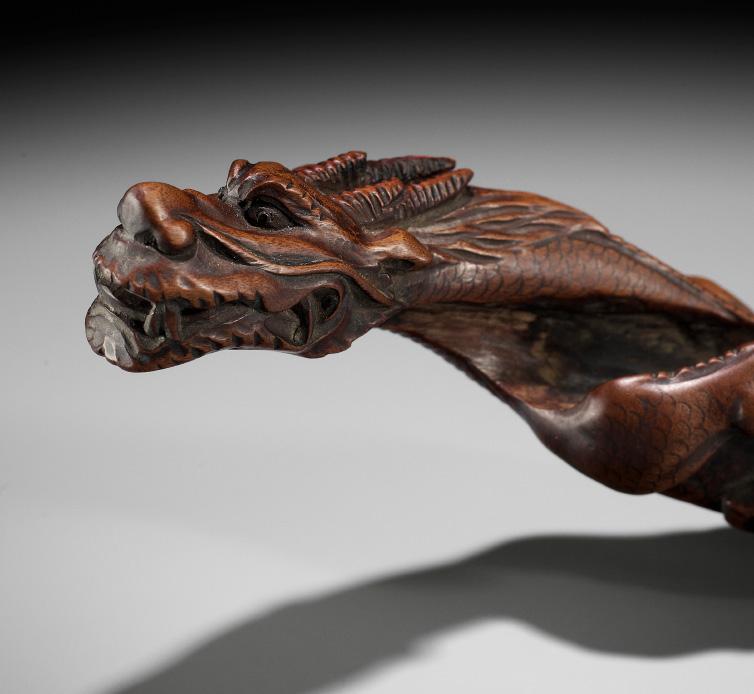
LENGTH 22.8 cm
Condition: Very good condition, minor wear, traces of use to wear the pipe is inserted, few tiny nicks.
Estimate EUR 1,500
Starting price EUR 800
KANO TESSAI: A FINE SAGEMONO CASE WITH BYAKUE KANNON
By Kano Tessai (1845-1925), sealed Tessai 鉄哉 to 刀 and kakihan Japan, Nara, late 19th to early 20th century
A rare bamboo sagemono by Kano Tessai crafted from a wide section of bamboo. The front is decorated with a Byakue Kannon (white-robed Kannon Bosatsu) in shishiaibori highlighted with dried lacquer (kanshitsu). Her gently flowing robe is delicately decorated with a dry gold lacquer scrolling pattern. Her face shows a serene expression. The surface has then been altered to look more like the old Buddhist statues found in Japanese temples, black from centuries of old incense smoke. Looped cord attachment near the top, the hinged cover and rim of shibuichi.

The case is inscribed with a large single character: Sei (Pure)
The longer inscription to the back is a poem that draws its inspiration from the moment of enlightenment in Zen Buddhism: “The reflection of moonlight is immersed in clear water, as the moon is dropped in the water the light becomes more radiant. Therefore, I sense no-mind, standing here as it is.”
Priest Dogen (1200–1253) wrote a poem with a similar meaning: “Enlightenment is like the moon reflected on water. The moon doesn’t get wet, nor the water broken.”
Signed TESSAI to [carved by Tessai] and with the artist’s kakihan.
HEIGHT 17.8 cm
Condition: Very good condition with minor, mostly intentional wear.
Estimate EUR 1,500
Starting price EUR 800
355
356
KOZAN: A FINE BAMBOO KISERUZUTSU WITH HANNYA SHINGYO SUTRA
By Kozan, signed Kozan dojin koku 江山道人刻 with seal Kozan 江山 Japan, c. 1900
An aesthetically pleasing kiseuzutsu of musozutsu form bringing together a combination of exceptional workmanship and material selection. The base for the creation is a wonderful section of tubular bamboo which, when viewed from the top and bottom, reveals the beautiful grain of the bamboo. The design is engraved in teppitsu-bori, also known as ‘iron brush carving’, emulating fine ink painting, with three priests partaking in a tea ceremony; one holds a fly whisk while another holds hishaku ladle and the other, presumably the most senior of the three, looks on, supervising the proceedings with a very serious expression.

Above the priests is a perfectly inked transcription of the Hannya Shingyo Sutra (Heart Sutra), written in tiny kanji with each character measuring only a few millimeters in height. Signed KOZAN dojin koku [made by Kozan, a man of Tao] and with further seal Kozan.
LENGTH 21 cm
Condition: Excellent condition.
Estimate EUR 1,500
Starting price EUR 800
RENSAI: A RARE MARINE IVORY KISERUZUTSU WITH A BASKET OF FRUIT
By Ishikawa Rensai, signed Rensai 蓮齋 Japan, Tokyo, Asakusa District, second half of 19th century, circa 1860s-1880s
Of wari-zutsu form, the marine ivory of pure color, finely carved in shishiaibori with a neatly incised woven basket filled with loquats, eggplant, peach, pomegranate, and berries, some fruit attached on leafy stems, one open pomegranate showing the seeds is borne on a towering branch, a loquat and worm-eaten leaf are lying on the ground before the basket. The cord attachment is formed by a reishi fungus carved in high relief, surrounded by cleverly stippled shading. The base carved in shishiaibori with a Buddha’s Hand citron. The reverse incised with the signature RENSAI.
LENGTH 20 cm
Condition: Very good condition, minor wear, a small nick near the base.
Provenance: Ex-collection Gabor Wilhelm, Paris.
A wari-zutsu pipe case is slit at the sides, leaving two flexible leaves. Bamboo and wood are the usual materials, because of the need for flexibility, although occasionally stag antler is utilized. See Stratos, Milton (Spring 2016) Kiseruzutsu, the Other Sagemono. A Modest Appreciation, International Netsuke Society Journal, Vol. 36, No. 1, p. 19. A wari-zutsu pipe case carved from marine ivory is extremely rare and shows great skill from the artist
In Chinese art, the pomegranate symbolizes the wish for many children, and in particular, sons. The fruit is full of seeds, and the word for seeds in Chinese is also that for children. Together with the double-happiness symbol, pomegranates feature prominently as wedding gifts. The Chinese rebus, liu kai bai zi, translates as ‘the pomegranate brings you a hundred seeds’. The Buddha’s Hand citron, which can be interchangeable with other citrons, together with the peach and pomegranate, are known collectively as ‘The Three Abundances’ (sanduo) which express the wish for abundant blessings, long life, and many sons. It is common for Japanese artists, particularly Asakusa carvers, to borrow such symbolism from the Chinese visual vocabulary.
LITERATURE COMPARISON
Compare a stag antler kiseruzutsu by Rensai decorated with a ho-o bird, clouds, and blossoms, illustrated in Sydney Moss Ltd. (2016) Kokusai The Genius: and Stag-antler Carving in Japan, Part 3, p, 74-75, no. 374. Compare an ivory netsuke by Rensai of a frog on a gourd, with a very similar signature, illustrated ibid., p. 40, no. 350, where the author notes that “[i]t might be that the unusual signature proposes the hand of Ishikawa Rensai II.” Compare another ivory netsuke by Rensai of a frog on a gourd, illustrated in Davey, Neil K. (1974) Netsuke: A comprehensive study based on the M.T. Hindson Collection, p. 181, no. 539, where the author notes that “[t]he carving and the signature differ from Rensai’s work in staghorn and this piece is probably by Rensai II.”


Estimate EUR 2,000
Starting price EUR 1,000
357
TOSAI: A RARE STAG ANTLER YATATE DECORATED WITH MONS
 By Tosai, signed Tosai 匋斎 saku 作 with two seals Japan, Tokyo, Asakusa, late 19th century
By Tosai, signed Tosai 匋斎 saku 作 with two seals Japan, Tokyo, Asakusa, late 19th century
The yatate comprising a fudezutsu (brush holder) and silver-fitted sumitsubo (inkwell) with hinged cover, the underside of the inkwell decorated with a finely carved chrysanthemum, the sides of the inkwell and one end of the handle decorated with various mon designs including Maru ni chigai takanoha (double hawk feather), hanabishi (diamond flower), manji (svastika), serrated leaves, and a pouch, all against a densely hatched ground, all executed in the manner of Ozaki Kokusai (1835.1892). The smoothly polished section of the handle incised with the signature TOSAI saku as well as two seals, Zuiun Ho (‘The Laws of Auspicious Clouds’) and Sakko (‘To create the old and antiquity’). The stag antler of a fine caramel tone.

LENGTH 14.8 cm
Condition: Good condition, minor wear, natural imperfections including minor age cracks.
With a small bead and a miniature silk pouch.
This apparently unrecorded artist appears to be a rare follower of Ozaki Kokusai (1835-1892), the founder of the famous ‘Asakusa school’ in Tokyo.
Estimate EUR 3,000
Starting price EUR 1,500
373
358
359
HAKUMIN: A FINE STAG ANTLER KISERUZUTSU WITH AN OWL
By Isshosai Hakumin, signed Isshosai
照齋 with seal Hakumin 方印 Japan, Tokyo, Asakusa District, second half of 19th century
Of senryu-zutsu type, finely carved in openwork with an owl perched on a gnarled oak tree branch bearing leaves and acorns. The cord attachment ‘naturally’ through the branch. The back carved with a seal HAKUMIN and signed within a metal-inlaid reserve ISSHOSAI.
LENGTH 19.7 cm
Condition: The interior rim with a chip. Otherwise good condition with minor wear and natural flaws to the material.
Provenance: Sagemonoya, Tokyo, 2009. Ex-collection Edward Wrangham (no. 2338), acquired from the above.
LITERATURE COMPARISON
Compare a closely related pipe case, attributed to Hoshunsai Masayuki, illustrated in Sydney Moss Ltd. (2016)
Kokusai The Genius: and Stag-antler Carving in Japan, Part 3, p. 128-129, no. 411. A related pipe case by Koshin is illustrated ibid., p. 128-129, no. 412.
AUCTION COMPARISON
Compare a related stag antler kiseruzutsu depicting the same subject, sealed Kyo, with a bamboo and silver pipe, at Galerie Zacke, Fine Netsuke & Sagemono, 16 April 2021, Vienna, lot 347 (sold for 1,830 EUR).


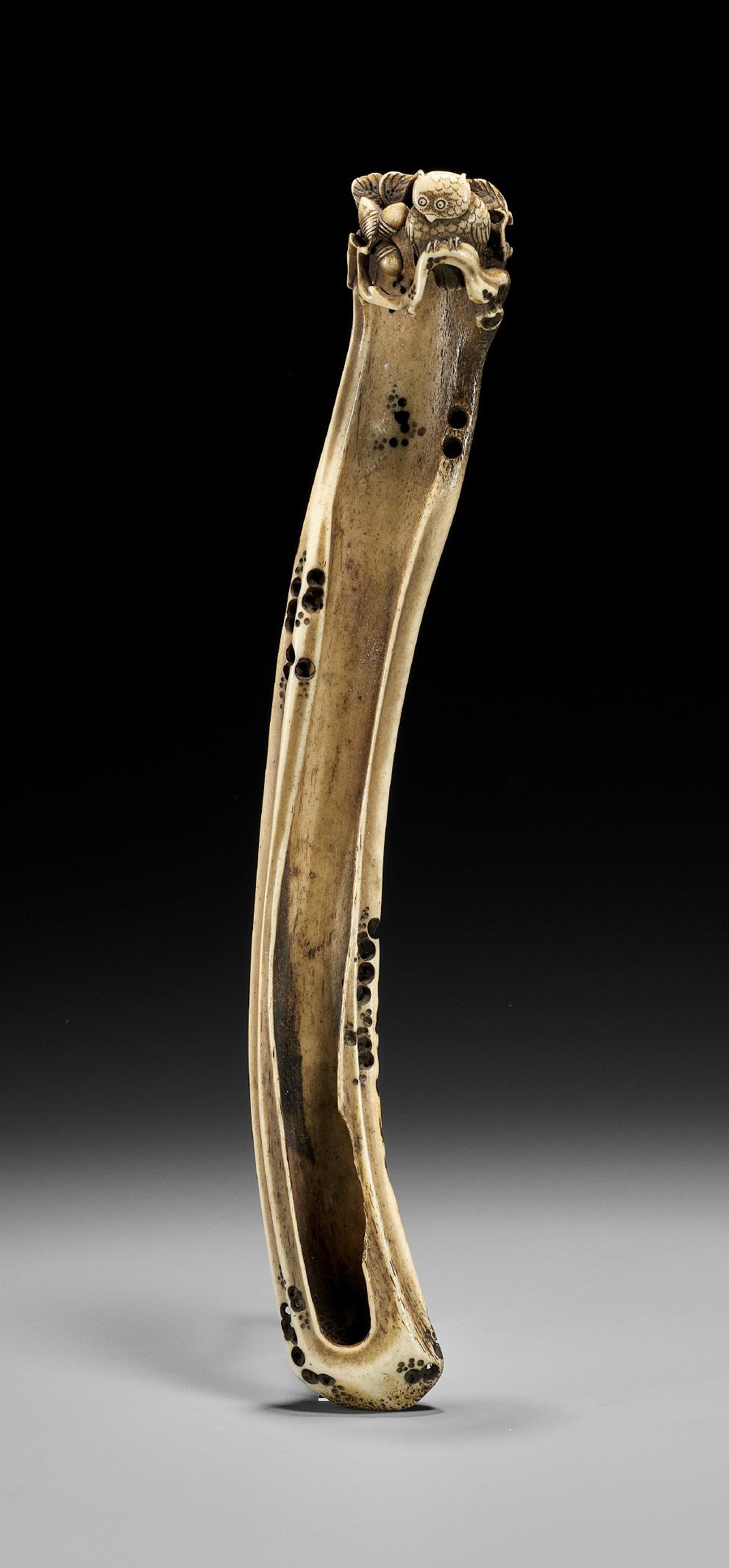
Estimate EUR 2,000
Starting price EUR 1,000
HAKUMIN: A SUPERB STAG ANTLER KISERUZUTSU WITH A BAKU


 By Isshosai Hakumin, sealed Hakumin 方印 Japan, Tokyo, Asakusa District, second half of 19th century
By Isshosai Hakumin, sealed Hakumin 方印 Japan, Tokyo, Asakusa District, second half of 19th century
Of senryu-zutsu type, finely carved in openwork with a baku, its scrolling mane and tail neatly incised and darkly stained for effect, the reverse with a trailing leafy vine and the mythical creature’s furcating tail, the entire pipe case superbly detailed with worm-eaten sections here and there. The cord attachment ‘naturally’ through under the baku’s body. The back carved with a gourd-shaped seal HAKUMIN.
LENGTH 19.7 cm
Condition: Very good condition, minor wear, natural imperfections.
Provenance: From the collection of Gaston Lazard (18781956) and his wife Jane Levy (1886-1985) and thence by descent within the same family.
LITERATURE COMPARISON
Compare a closely related pipe case depicting a bat with baku-snouted water dragon head, with seal Haku and attributed as “probably Isshosai Hakumin”, illustrated in Sydney Moss Ltd. (2016) Kokusai The Genius: and Stag-antler Carving in Japan, Part 3, p. 174-175, no. 441.
Estimate EUR 4,000
Starting price EUR 2,000
360
A STAG ANTLER KISERUZUTSU DEPICTING
A KIRIN AND SHISHI HEAD, ATTRIBUTED TO OZAKI KOKUSAI
Attributed to Ozaki Kokusai (1835-1892), unsigned Japan, Shiba, Tokyo, mid to late 19th century, circa 1860s-1880s
Of relative large size and muso-zutsu form, superbly carved in relief with a shaped panel enclosing a long-necked kirin with neatly incised bushy tail and mane amid scrolling vines bearing fruit and leaves between flowerheads, the panel framed by swirling clouds, all below a shishi head with bulging eyes, sharp fangs, and a broad nose with large nostrils forming the cord attachment, the mouth with a key-fret band above swirling clouds to the back, the top with a shaped panel enclosing a flowering peony above a key-fret band.
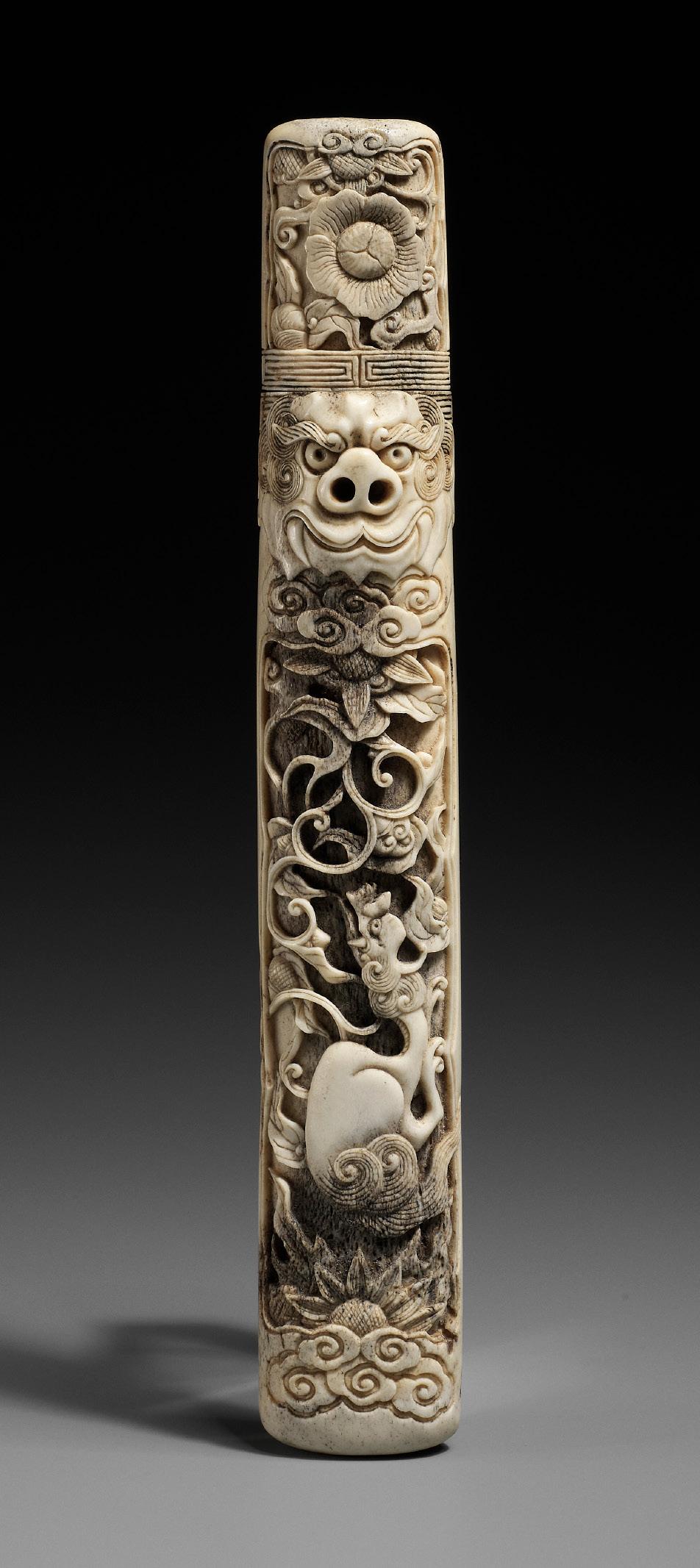
LENGTH 22.4 cm
Condition: Very good condition with minor wear, natural flaws including expected age cracks.
LITERATURE COMPARISON
Compare a closely related stag antler kiseruzutsu by Ozaki Kokusai, similarly carved with a shaped panel below a shishi head forming the cord attachment, 20.7 cm long, dated circa 1860s-1880s, illustrated in Sydney L. Moss Ltd. (2016) Kokusai the Genius: and Stag-antler Carving in Japan, vol. II, p. 368-369, no. 280. A related stag antler kiseruzutsu by Ozaki Kokusai, similarly carved with a dragon head forming the cord attachment above a shaped panel, 21.3 c, long, dated circa 1860s-1880s, is illustrated ibid., p. 370-371, no. 281.

AUCTION COMPARISON
Compare a closely related stag antler kiseruzutsu by Ozaki Kokusai, similarly carved with a shaped panel below a shishi head forming the cord attachment, 21.5 cm long, at Bonhams, 15 May 2014, London, lot 104 (sold for 12,500 GBP).


Estimate EUR 2,000
Starting price EUR 1,000
361
362
A POWERFUL STAG ANTLER KISERUZUTSU DEPICTING A RAIN DRAGON

Unsigned Japan, Tokyo, Asakusa district, late 19th century
Of muso-zutsu form, finely carved in low and high relief with a ferocious, long-snouted rain dragon writhing amid thick scrolling clouds, its mane and other details neatly incised. The cord attachment is formed by the curling tail of the slender dragon.



LENGTH 20 cm
Condition: Very good condition with minor wear, natural flaws including expected minor age cracks, the interior with remnants of an old label.
LITERATURE COMPARISON
A related stag antler kiseruzutsu with a single water dragon, likely from the same hand, is illustrated in Atchley, Virginia / Davey, Neil (2006) The Virginia Atchley Collection of Japanese Miniature Arts, p. 303, no. S42. A related stag antler netsuke signed and by Ozaki Kokusai is illustrated in Sydney L. Moss Ltd. (2016) Kokusai the Genius: and Stag-antler Carving in Japan, vol. II, p. 376-377, no. 284. Another related stag antler netsuke, attributed to Ryu, is illustrated in Sydney L. Moss Ltd. (2016) Kokusai the Genius: and Stag-antler Carving in Japan, vol. III, p. 340-341, no. 540.
Estimate EUR 1,500
Starting price EUR 800
363
HAKUUNSAI: AN UNUSUAL LACQUER KISERUZUTSU WITH ROOF TILES
By Hakuunsai, signed Hakuunsai 白雲斎 Japan, 19th century
Of muso-zutsu type, superbly decorated with layers of red and black lacquer which have been carved and polished to depict numerous overlapping roof tiles and shaped panels enclosing characters, mythical animals, and floral designs, all against a diapered wave ground, one roundel to the lower end with the artist’s signature HAKUUNSAI, the first two characters Haku and Un encased in the last character Sai, which is extremely stylized. Two roof tiles show FURTHER seals as well, one reading Kotobuki (‘longevity’) and the other Tairyu (lit. ‘willow trees on a high platform’, possibly an additional art name of the artist). The lacquer has been carefully enriched with charcoal to, quite brilliantly, give the appearance of aging to the roof tiles.

LENGTH 20.7 cm
Condition: Good condition, some wear, fine age cracks, tiny nicks, few small losses.
AUCTION COMPARISON
Compare a guri-lacquer kiseruzutsu, similarly decorated with layers of red and black lacquer which have been carved and polished, dated late 19th century, at Lempertz, 25 June 2021, Cologne, lot 785 (sold for 3,250 EUR).

Estimate EUR 1,500
Starting price EUR 800
MATSUKI HOKEI: A SUPERB TSUISHU LACQUER KISERUZUTSU WITH MYTHICAL BEASTS
By Matsuki Hokei, signed Hokei 豊慶 Japan, Tokyo, late 19th century, Meiji period (1868-1912)
Of muso-zutsu form, masterfully worked in tsuishu (carved red lacquer), the surface beautifully polished and highlighted with yellow and black accents to simulate wear, decorated to one side with a winged dragon ascending towards a descending sparrow, surrounded by reishi clouds, opulent flowers and scrolling vines. The verso continuing the imagery and featuring a ho-o (phoenix) and dragonfly. The relief decoration is carved above a fine asanoha ground. The inset piece carved with lotus butterflies. With a gilt metal fitting forming the cord attachment.

LENGTH 21.3 cm

Condition: Very good condition with minor wear, some nibbling to edges. The gilt metal cord attachment probably a replacement.
Matsuki Hokei was a lacquerer who worked in Tokyo in the early Meiji era and is widely recognized for his superb craftsmanship in tsuishu lacquer. Hokei was a professor at the Tokyo Academy of Fine Arts.
AUCTION COMPARISON
For another pipe case by Hokei see Bonhams, The Edward Wrangham Collection of Japanese Art Part IV, 6 November 2013, London, lot 101 (sold for GBP 5,250).
Estimate EUR 2,000
Starting price EUR 1,000
364
365
TESSHIN: A ZESHIN SCHOOL LACQUERED AND INLAID RATTAN KISERUZUTSU WITH PERSIMMONS
By Tesshin, signed Tesshin 鉄真 Japan, Tokyo, late 19th century to early 20th century, Meiji period (1868-1912)
Of muso-zutsu form, the ground ingeniously simulating woven rattan, decorated in gold and colored takamaki-e with aogai inlays to depict two persimmons borne on a thin branch further issuing neatly veined leaves. A looped himotoshi ringed in metal below the mouth. Signed within an oval reserve TESSHIN. This rarely encountered artist belongs to the Zeshin school of lacquerers.

LENGTH 20 cm
Condition: Very good condition with minor wear, the interior of the mouth with minor nibbling.
AUCTION COMPARISON
Compare a closely related kiseruzutsu bearing a similar design and also with a simulated rattan ground, signed Zeshin, sold at Zacke, Fine Japanese Art, 29 November 2019, Vienna, lot 87 (sold for 3,792 EUR).

Estimate EUR 1,500
Starting price EUR 800
SEN’YU: A WOVEN RATTAN KISERUZUTSU WITH A BAMBOO AND SILVER KISERU
By Sen’yu, signed Sen’yu 泉友 Japan, c. 1900, Meiji period (1868-1912)
Of slender muso-zutsu form, the woven rattan ground finely decorated in gold and black takamaki-e as well as aogai inlays to depict edamame bean pods borne on twisting vines further issuing leaves. A looped himotoshi ringed in gilt metal below the mouth. Signed within an oval reserve SEN’YU. The kiseru (pipe) with a bamboo rao (tube) and plain silver suikuchi (mouthpiece) and karikubi (bowl).

LENGTH 20.5 cm (the kiseruzutsu) and 18.7 cm (the kiseru)
Condition: Excellent condition with minor wear.
Provenance: From the collection of Felix Tikotin, and thence by descent within the family. Felix Tikotin (18931986) was an architect, art collector, and founder of the first Museum of Japanese Art in the Middle East. Born in Glogau, Germany, to a Jewish family, his ancestors had returned with Napoleon from Russia from a town named Tykocin. He grew up in Dresden and after World War I, he traveled to Japan and immediately fell in love with the culture. In April 1927, he opened his own first gallery in Berlin. The entire family survived the holocaust, and in the 1950s Tikotin slowly resumed his activities as a dealer in Japanese art. He became, once again, very successful and prominent, holding exhibitions all over Europe and the United States. When he first visited Israel in 1956, he decided that the major part of his collection belonged in that country. In 1960, the Tikotin Museum of Japanese Art was opened in Haifa.
Felix Tikotin (1893-

Estimate EUR 1,200
Starting price EUR 600
366
1986), center, in front of his gallery in Berlin
367
A FINE RATTAN AND LACQUER KISERUZUTSU WITH DRAGONFLIES
Inscribed with a single character Ro 犂 Japan, late 19th century
A finely woven rattan pipe case of musozutsu form. The pair of dragonflies in various shades of lacquer face each other, one at the top looking down and other at the bottom looking up. Each creature’s body wraps around the opposite side of the case. Both creatures are treated with different lacquer techniques, the top example with its wings lacquered in ishime that starts a subtle gold and fades to black towards the tips, the veins lacquered in black. The bottom creature’s body is treated in the same fashion, the wings lacquered in silver with gold veins. Signed with a single kanji RO which literally means “deaf”.

LENGTH 20 cm
Condition: Very good condition with minor wear to lacquer and to the woven ground.
Estimate EUR 2,000
Starting price EUR 1,000
A LARGE AND RARE RINPA-STYLE INLAID AND LACQUERED KISERUZUTSU DEPICTING DRAGONFLIES
After Ogata Korin (1658-1716), signed Seisei shirushi kizamu 青々讖刻 Japan, Edo (Tokyo), 18th-19th century, Edo period (1615-1868)
The unusually large kiseruzutsu of muso-zutsu type, designed for either a very long pipe or as part of a yatate, the grooved pipe case imitating woven rattan lacquered burgundy-red and superbly decorated in gold and black takamaki-e with pewter inlays lacquered in hiramaki-e to depict two dragonflies with large round eyes, delicate limbs and feelers, finely veined wings, and long slender bodies. The shibuichi neck mount with a gilt loop himotoshi. The reverse signed in fine calligraphy SEISEI shirushi kizamu [this is engraved by Seisei] in gold lacquer on a rectangular, black-lacquered reserve. The art name Seisei, which literally means “blue and blue”, was used by Ogata Korin and his followers.

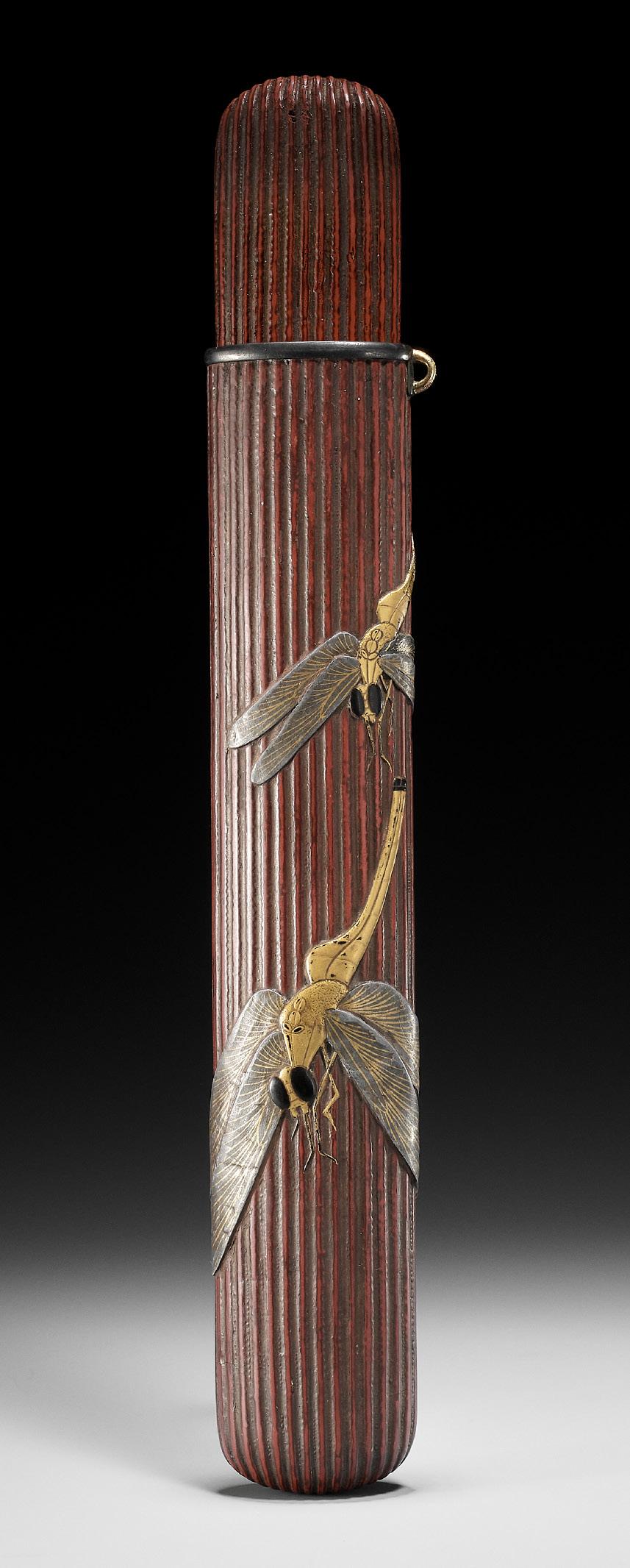
LENGTH 26.5 cm
Condition: Good condition, minor wear, one dragonfly with touchups to tail and one wing.
Ogata Korin (1658-1716) was a famous and highly influential Japanese landscape illustrator, lacquerer, painter, and textile designer of the Rinpa School. Korin is best known for his byobu folding screens, such as Irises and Red and White Plum Blossoms (both registered National Treasures), and his paintings on ceramics and lacquerware produced by his brother Kenzan (1663-1743). Also a prolific designer, he worked with a variety of decorative and practical objects, such as round fans, maki-e writing boxes, or inro medicine cases. He is also credited with reviving and consolidating the Rinpa school of Japanese painting, fifty years after its foundation by Hon’ami Koetsu (1558-1637) and Tawaraya Sotatsu (c. 1570-c. 1640). In fact the term ‘Rinpa’, coined in the Meiji period, means ‘school of [Ko]rin’. In particular he had a lasting influence on Sakai Hoitsu (1761-1828), who replicated many of his paintings and popularized his work, organizing the first exhibition of Korin’s paintings at the hundredth anniversary of his death.
LITERATURE COMPARISON
Compare a related lacquered kiseruzutsu by Maeyama Koshin, with a similar grooved design imitating woven rattan, dated c. 1900, illustrated in Sydney L. Moss (2010) they are all fire and every one doth shine. The Elly Nordskog Collection of Japanese Inro, Pipecases and Netsuke, p. 316-317, no. 85.
MUSEUM COMPARISON
Compare a related lacquered letter box depicting dragonflies with similar pewter inlays, dated 18th century, in the Cleveland Museum of Art, accession number 1972.165.
Estimate EUR 4,000
Starting price EUR 2,000

368
A LACQUER KISERUZUTSU AND A RED LEATHER POUCH DEPICTING AUTUMN GRASSES AND FLOWERS
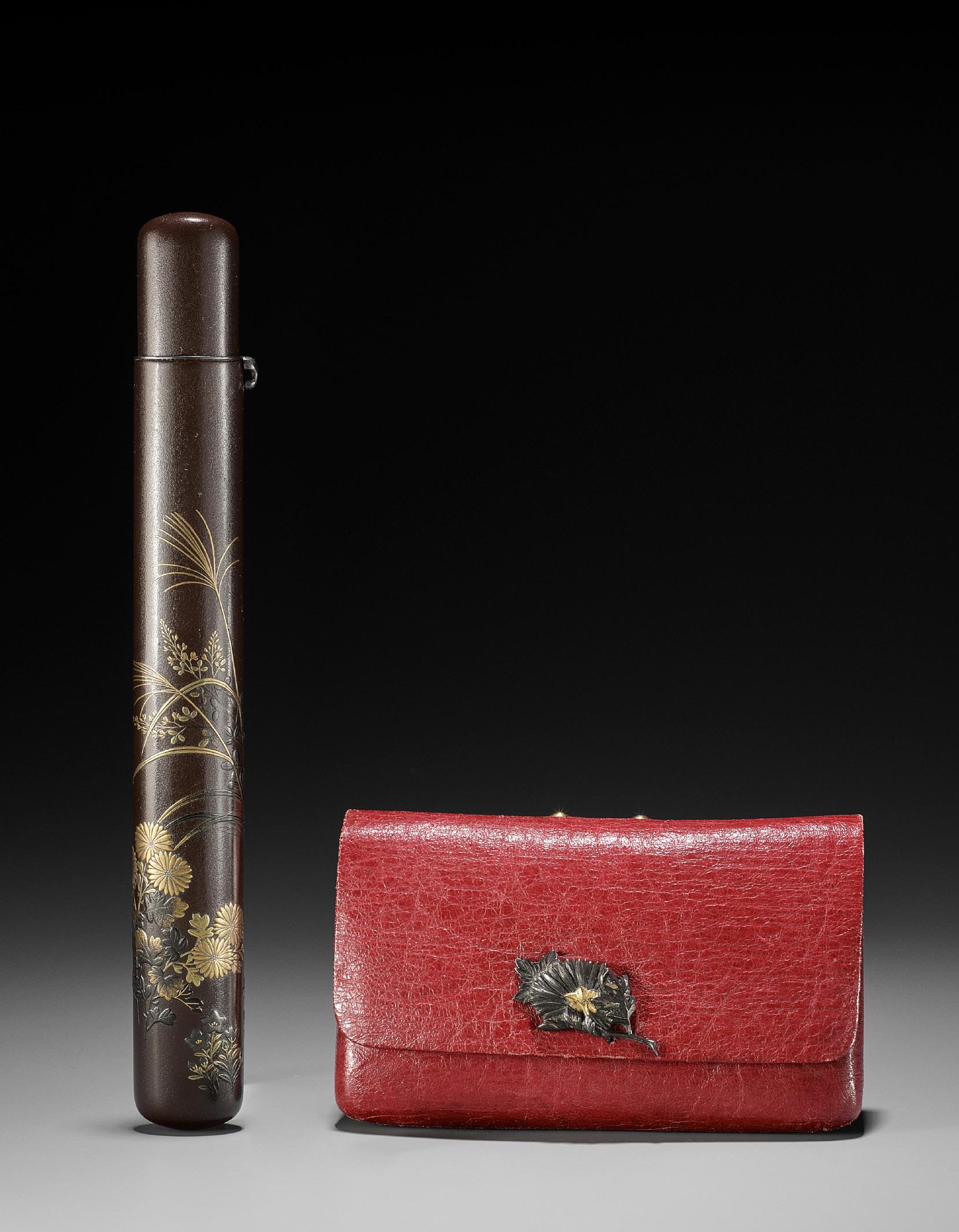
The kiseruzutsu by Fukushima Taisai, signed Taisai 泰哉 Japan, Tokyo, c. 1900, Meiji period (1868-1912)
The pipe case of musozutsu type and bearing a brown lacquer ground, imitating patinated metal, finely decorated in gold, silver, and black takamaki-e with various plants and flowers associated with autumn. The lacquer work is delicate and precise with the design flowing around the entire case. The red leather pouch is equally pleasing with a fine parcel-gilt metal clasp depicting an elaborate flower.

LENGTH 20.9 cm (the pipe case), SIZE 7 x 12 cm (the pouch)
Condition: Excellent condition with minor wear.
With a felt-lined wood tomobako (storage box).
Fukushima Taisai, who also used the family name Koma, likely trained under Shibata Zeshin’s best pupil, Ikeda Taishin (18251903). For further deails of the artist, see Wrangham, Edward (1995) The Index of Inro Artists, p. 280.
AUCTION COMPARISON
Compare a closely related kiseruzutsu by Fukushima Taisai, also depicting autumn flowers, at Bonhams, The Edward Wrangham Collection of Japanese Art Part II, 10 May 2011, London, lot 152 (sold for 3,360 GBP).
Estimate EUR 2,000
Starting price EUR 1,000

369


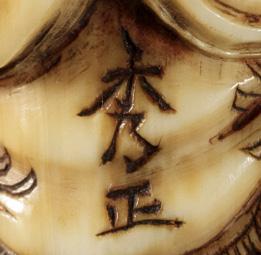


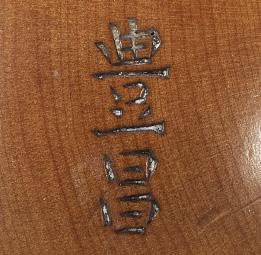








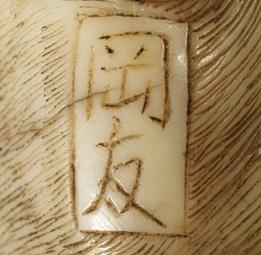







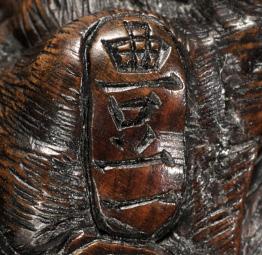
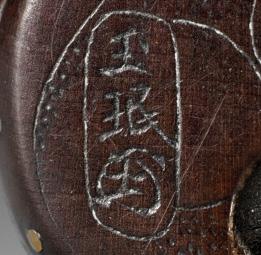

385 41 Tomotada 友忠 42 Okatori 岡隹 43 Kaigyoku Masatsugu 懐玉 正次 44 Masahiro 正廣 45 Dosho 道笑 46 Mitsuhiro 光廣 47 Hidemasa 秀正 50 Masamine 正峯 51 Toyomasa 豊昌 53 Toyomasa 豊昌 54 Toyomasa 豊昌 55 Toyoshima 豊嶋 56 Toyomasa 豊昌 57 Toyokazu 豊一 59 Gyokumin 玉珉 31 Gyokuzan 玉山 32 Tomotada 友忠 34 Masatomo 正友 35 Okatomo 岡友 38 Okatomo 岡友 6 Issai 一齋 11 Gyokusen 玉仙 25 Issai 一哉 26 Shuzan 周山 28 Okakoto 岡言 ARTIST SIGNATURES

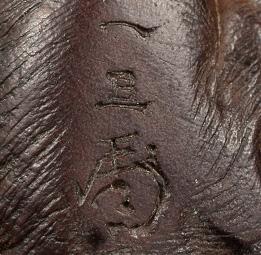

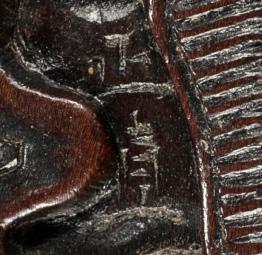




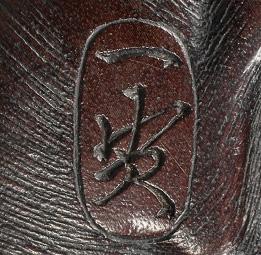
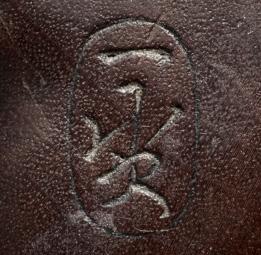




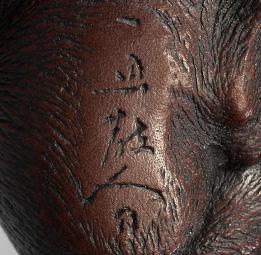







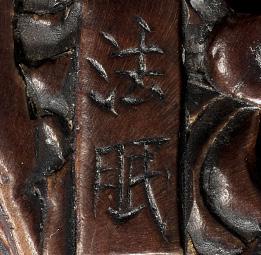

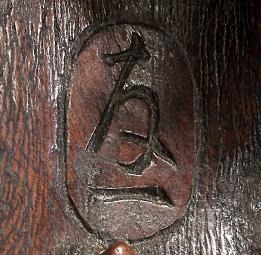
386 74 Masayasu 正保 77 Ittan 一旦 78 Yoshihisa 義久 79 Ittan 一旦 80 Ittan 一旦 81 Ittan 一旦 82 Ittan 一旦 83 Ikkan 一貫 84 Ikkan 一貫 85 Ikkan 一貫 86 Ikkan 一貫 87 Tomokazu 友一 88 Masatada 正忠 89 Masanao 正直 92 Ikko 一光 65 Masanao 正直 67 Masakazu 正一 68 Tametaka 爲隆 72 Ichiyu 一友 73 Masamaru 正丸 60 Masakazu 昌貞 61 Homin 法眠 62 Koichi 光一 63 Masatoshi 正利 64 Masakazu 正一

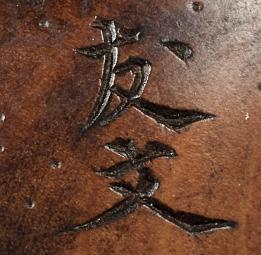


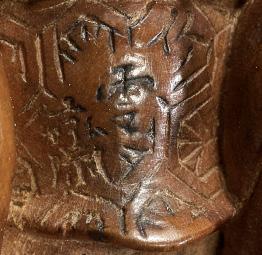


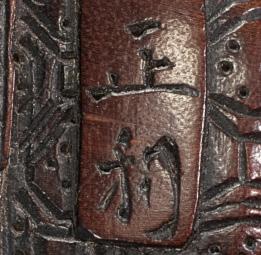




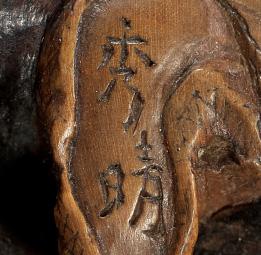



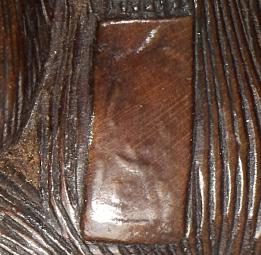




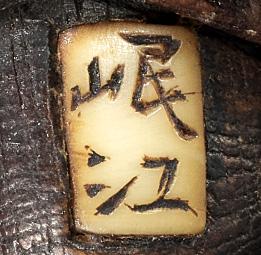



387 106 Yasutada 安忠 107 Sari 左里 108 Hideharu 秀晴 109 Hideharu 秀晴 110 Hogen Tadashige 法眼忠茂 111 Tomohisa 友久 112 Tadakazu 忠一 114 Ransen 蘭川 115 Tadatoshi 忠利 116 Nobukazu 信一 to 刀 117 Tsuneyoshi 常美 118 Masatoshi 正利 122 Chikuunsai 竹雲齋 123 Masanao 正直 124 Masanao 正直 100 Tomonobu 友信 102 Tadakuni 忠國 103 Tadakuni 忠國 104 Shigemasa 重正 105 Tomoshige 友重 93 Masanao 正直 94 Masanao 正直 95 Masakazu 正一 96 Minko 珉江 98 Shugetsu 秋月

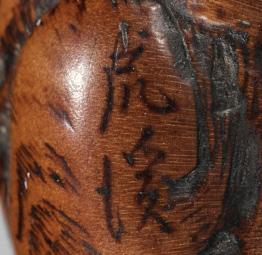

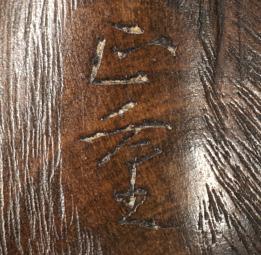


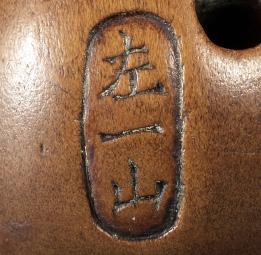




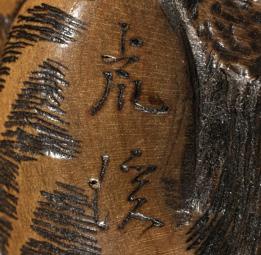






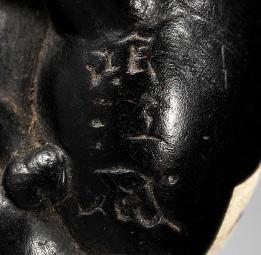


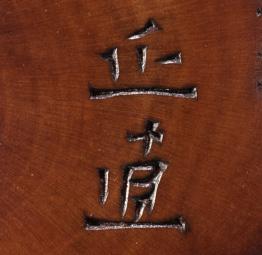



388 135 Kokei 虎溪 136 Minko 岷江 137 Minko 岷江 138 Minko 岷江 139 Haritsu 破笠 141 Kokei 虎溪 142 Kokei 虎溪 143 Shigeyoshi 重敬 144 Tomokazu 友一 145 Minko 岷江 146 Minko 岷江 147 Harumitsu 春光 148 Hidari Issan 左一山 149 Shoto 松涛 150 Hidari Issan 左一山 130 Masashige 正重 131 Kinsui 欽 水 132 Minko 珉江 133 Kokei 虎溪 134 Minko 岷江 125 Masakatsu 正勝 126 Masakatsu 正勝 127 Masakazu 正一 128 Masanao 正直 129 Masanao 正直
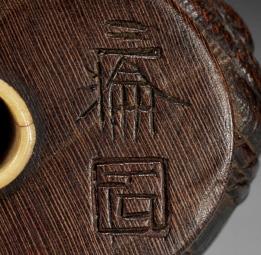
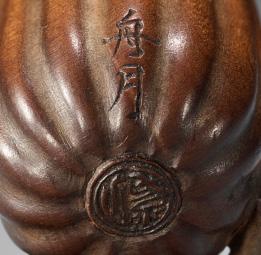

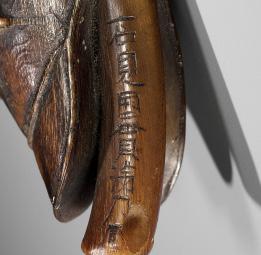



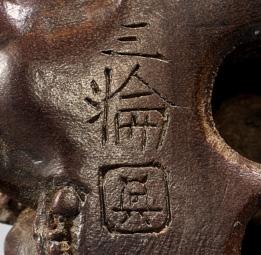



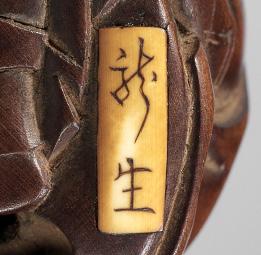

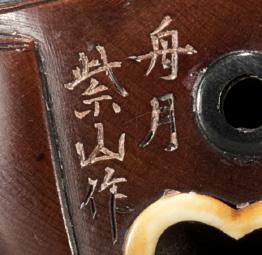



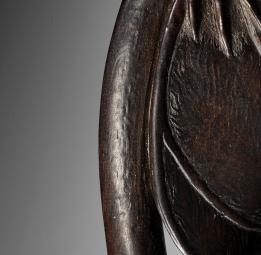



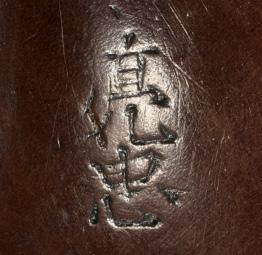
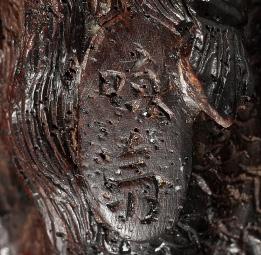
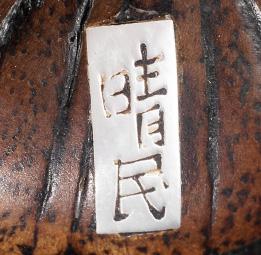

389 165 Jobun 如文 166 Genryosai 玄了齋 168 Shugetsu 舟月 169 Shugetsu Shizan 舟月 紫山 170 Shugetsu 舟月 171 Shugetsu 舟月 173 Ryukei 龍珪 175 Hokyudo Itsumin 逢丘堂丘堂 176 Hoshinsai 法眞齋 179 Miwa 三輪 180 Miwa 三輪 181 Miwa 三輪 182 Mugai 夢外 183 Shoko 尚古 184 Masatami 正民 159 Kanman 国貫 160 Sekishu Iwami 石州石見 161 Kanman 貫満 162 Kanman 国貫 164 Miwa Katsusuke 三輪勝助 151 Issan 一山 153 Seimin 晴民 154 Seigyuken Gaho 青牛軒我補 155 Suketada 亮忠 158 Takusai 啄齋

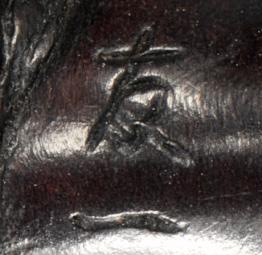
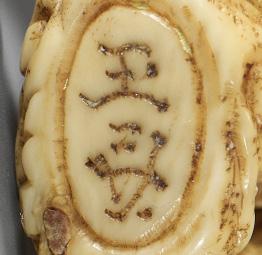





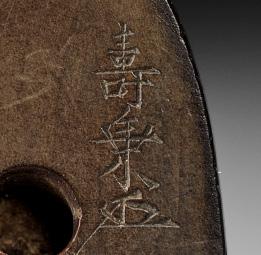

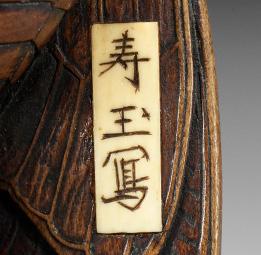


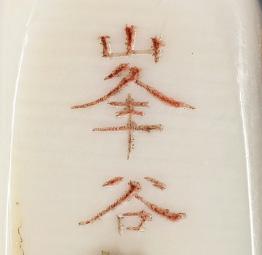

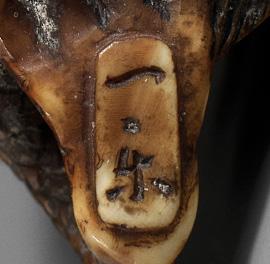




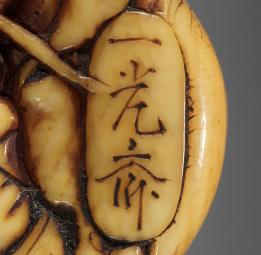



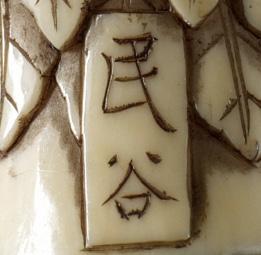
390 195 Gyokusai 玉哉 196 Itto 一東 197 Ryomin 陵民 198 Hokoku 峯谷 202 Hideyuki 秀之 203 Tomokazu 友一 204 Shounsai 升雲齋 205 Jujo 壽乗 206 Jugyoku 壽玉 207 Jugyoku 壽玉 210 Gyokuzan 玉山 212 Naoyuki 直雪 213 Tosai 東采 214 Kokoku 光谷 215 Tokoku 東谷 190 Ryoji 凌次 191 Jugyoku 壽玉 192 Jugyoku 壽玉 193 Kosai Moritoshi 孝齋 守壽 194 Kikugawa 菊川 185 Minkoku 民谷 186 Ikkosai 一光齋 187 Ikkosai 一光斎 188 Ikkosai 一光斎 189 Gyokkosai 玉光齋

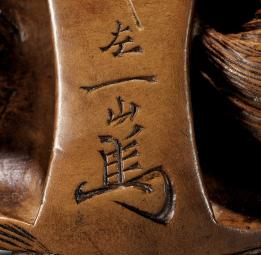

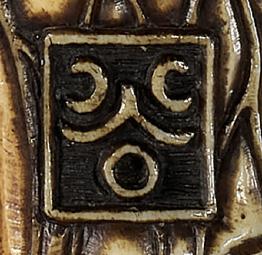



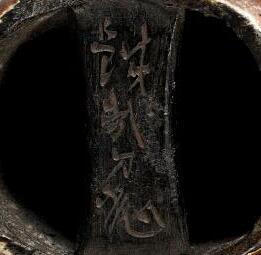

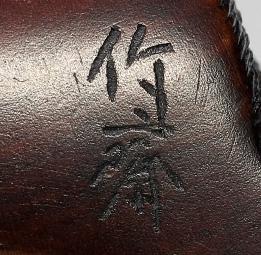








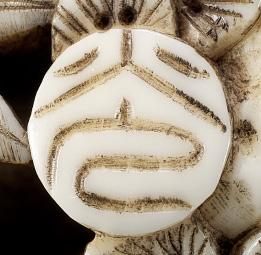


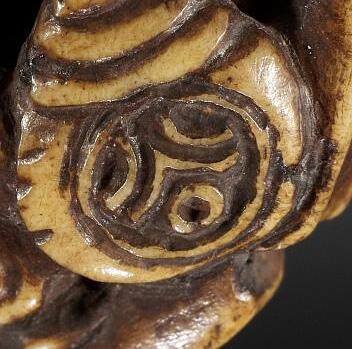

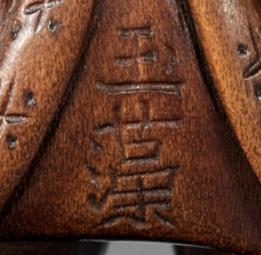

391 236
237
239
241
243
244
245
247
248
249
254
255 Tetsuro
256 Tessai
258 Ho
259
223 Koku 谷 228 Ko 光 233 Rensai 蓮齋 234 Masayuki
235 Masayuki
216 Gyokuso 玉藻 217 Sozan 宗山 218 Gyokuso 玉藻 219 Soko
Masayuki (Kakihan) はク
Haku はク
Mitsuhiro 光廣
Artist‘s kakihan
Hidari Issan 左一山
Sansho (Kakihan)
Sansho (Kakihan)
Chikusai 竹齋
Ikko 一光
Okatomo 岡友
Tessai 銕哉
鉄琅
銕哉
Hogen 鴇 法眼
Tanaka Yozei 田中陽成
正之
正之
藻己








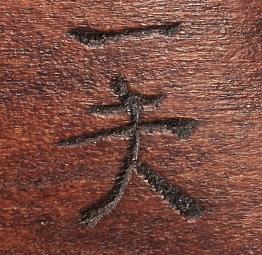


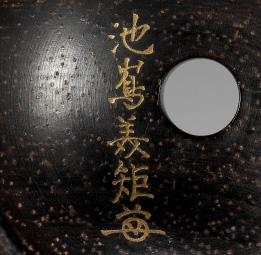





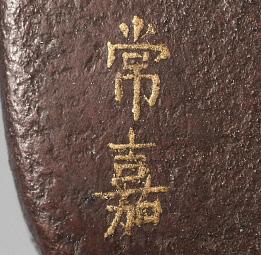


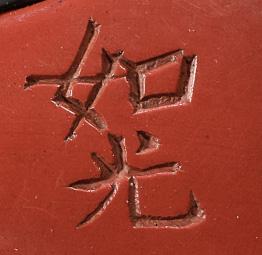



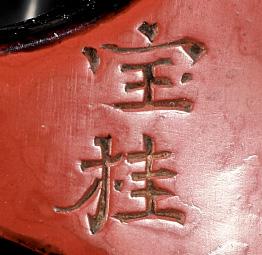
392 293 Naomichi 直道 294 Kakosai 可交齋 296 Ikeshima Yoshinori 池嶌義矩 297 Hogetsu 峯月 298 Koami
光阿弥
302 Nanki
南紀男山 308 Masakazu 政一 309 Katsuhira
310 Katsuo
311
312 Doug
313 Nick
314
紫苑 315
316 Vadym
279 Yozei 楊成 282 Shinsai 眞哉 283 Zeshin 是眞 288 Joka 常嘉 291 Toyo
261 Hokei 宝桂 262 Joko
264 Soshi 藻之 266 Koma
268
Tadamitsu
忠光
Otokayama
勝平
勝小
Kazuo 一小
Marsden
Lamb
Shion
Vadym Pyvovar
Pyvovar
桃葉
如光
古滿
Morikawa
Toen (Kakihan)
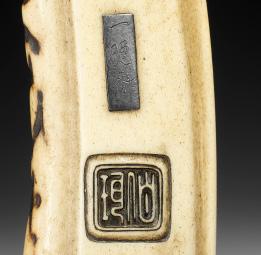









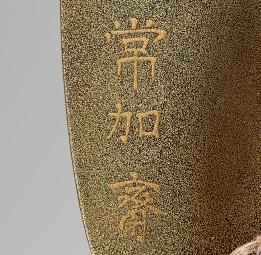
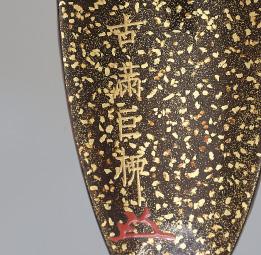






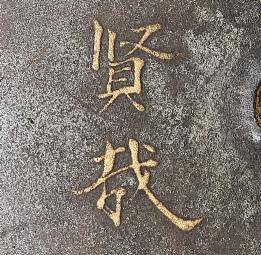



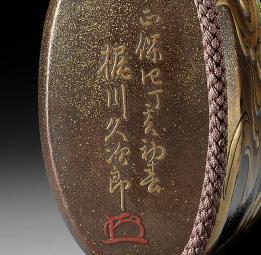

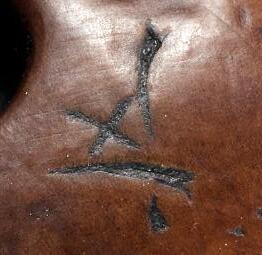
393
334 Shiomi Masanari 鹽見政誠
335 Jokasai 常嘉齋
338 Koma Koryu 古満巨柳
343 Kajikawa 梶川
344 Yoyusai 羊遊齋
345 Jokasai 常嘉齋
352 Minko 岷江
355 Tessai 鉄哉
356 Kozan 江山
匋斎
357 Rensai 蓮齋 358 Tosai
一照齋
359 Isshosai Hakumin
方印
360 Hakumin 方印
363 Hakuunsai 白雲斎
364 Hokei 豊慶
325 Tatsuke Kokosai 田附交々齋
328 Kyohakudo Shunsho 擧白堂 春正
329 Jiyosai 慈羊斎
333 Shiomi Masanari 鹽見政誠
333A Kensai 賢哉
317 Alexander Derkachenko
318 Alexander Derkachenko
319 Adam Bland
320 Kajikawa Kyujiro 梶川久次郎
323 Zonsei 村靖





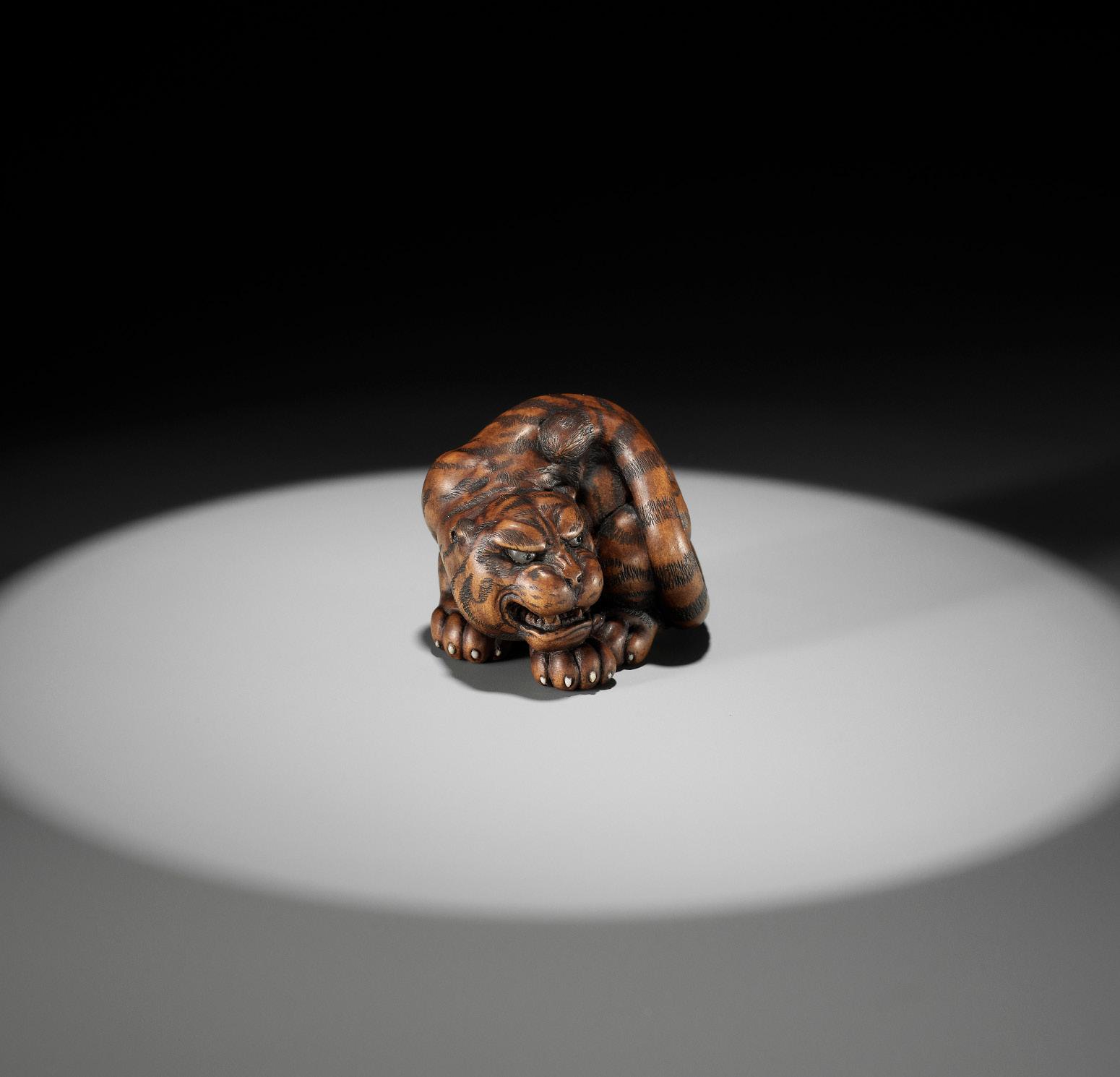 365 Tesshin 鉄真
366 Sen’yu 泉友
367 Ro 犂
368 Seisei 青々
369 Taisai 泰哉
365 Tesshin 鉄真
366 Sen’yu 泉友
367 Ro 犂
368 Seisei 青々
369 Taisai 泰哉
IMPRINT
Publisher
Galerie Zacke founded 1968 © SZA Versteigerungen & Vertriebs GmbH
Sterngasse 13
1010 Vienna
Austria, Europe
Tel (0043-1) 532 04 52
Email: office@zacke.at
Editors
Lukas Zacke
Marion Schor
Experts
Lukas Zacke
Max Zacke
Assistance
Mieko Gray
Photography
Georg Bodenstein
Design
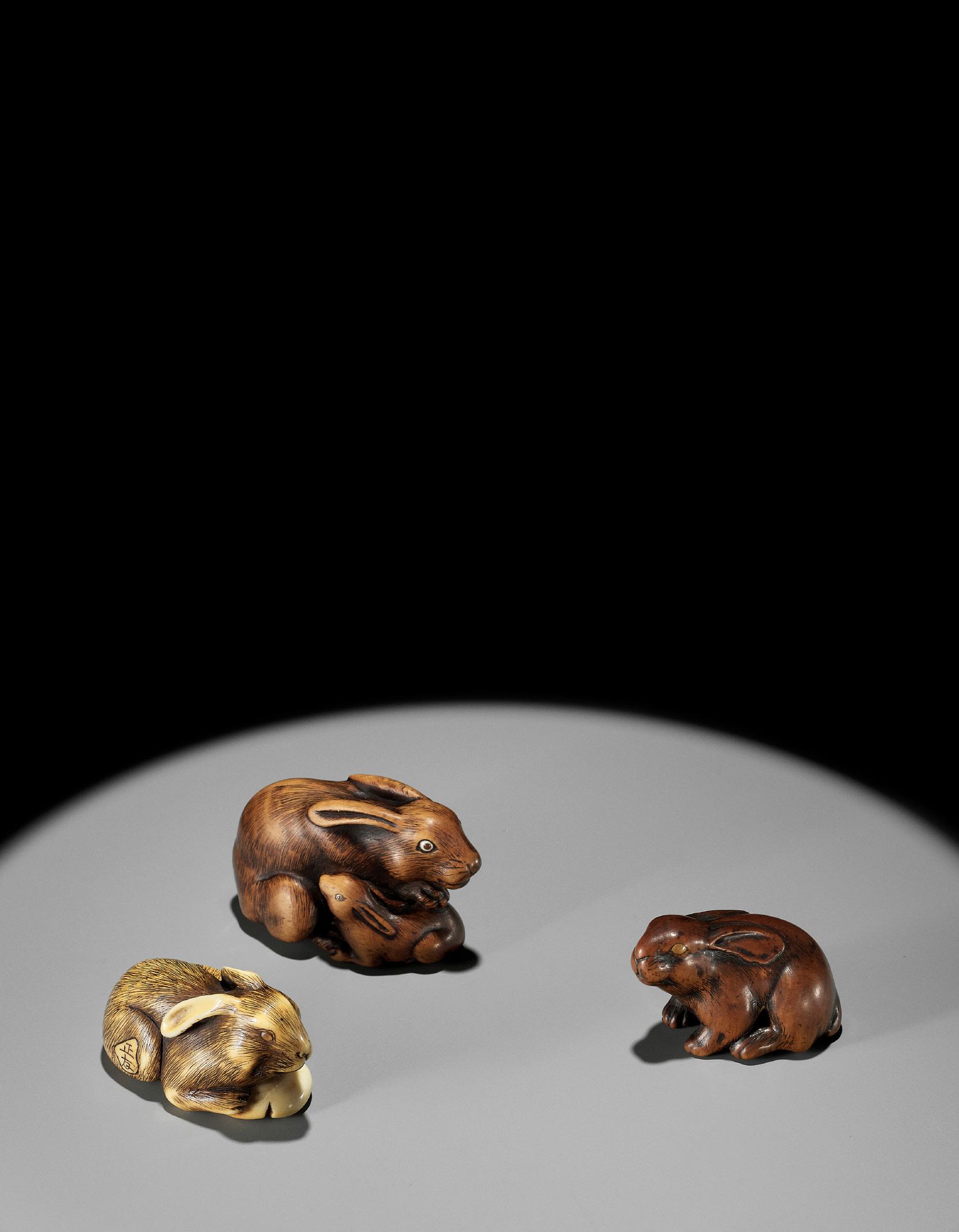
Hermann Kienesberger
Printing Print Alliance
HAV Produktions GmbH
Website www.zacke.at
© GALERIE ZACKE Reproduction forbidden
TERMS OF AUCTION
§ 1) The auction shall be carried out in accordance with the provisions of the rules of procedure of GALERIE ZACKE©, SZA VERSTEIGERUNGEN UND VERTRIEBS GMBH, Sterngasse 13, 1010 WIEN (hereinafter referred to as the company) as well as in accordance with sections 244-246 of the GEWERBEORDNUNG [Industrial Code] of 1994. The auction shall be carried out on commission. The auctioneer shall be entitled to withdraw lots exceptionally, to conduct the auction deviating from the order of the catalog numbers and to offer lots jointly. In the event of any dispute concerning a double bid or if the auctioneer has missed a bid, the auctioneer shall be entitled to revoke acceptance of a bid and to continue auctioning the item. The figures stated in the catalog shall be the highest bid in Euro (€) expected by the respective expert. As a rule, the bid shall be increased by 10% of the last bid. (See table of the bidding increments).
§ 2) The acceptance of a bid shall be granted to the highest bidder unless a hidden reserve has been agreed upon with the consignor of the item in question. Such a hidden reserve (also called limit or just reserve) shall be the minimum price under which the item will not be sold during the auction. This reserve will be disclosed upon request and after the auction only and may exceed the estimate. The auctioneer will in this case bid on behalf of the seller against all other bidders until the reserve has been reached. If a reserve is not reached during the auction, the auctioneer will knock down the item to the highest bidder at the final bid, but the sale will be conditional of the acceptance of this final bid by the seller. In this case the highest bidder shall be bound to his/her last bid for a term of 8 days starting with the day of the knockdown. If the winning bidder does not receive a written cancellation notice within this term of 8 days, the knockdown becomes unconditional and the sale is final. Typically, only a minority of all items in an auction have a hidden reserve.
§ 3) Most items shall be subject to differential taxation. A uniform surcharge of 25% plus the value added tax applicable to the surcharge to the amount of 20% shall be added to the achieved highest bid (final and highest bid). Thus, the surcharge shall be 30% of the final and highest bid in total. Items with added VAT are marked † in the online catalog.
§ 4) In the event of sales abroad, the value added tax will be repaid if the item is sold to a country which is not a member country of the European Union (third country), the legal requirements are met, and the proof of exportation is provided. The value added tax shall not be shown separately on the invoice.
§ 5) The auction buyer must pay the purchase price immediately upon acceptance of the bid (final and highest bid plus 25% surcharge, plus the value added tax applicable to the surcharge to the amount of 20%, or the added VAT on top of the final price, when a lot is highlighted accordingly in the auction catalog). The company may grant an auction buyer a term of payment for the purchase price in whole or in part when this has been formally applied for in writing before the auction.
§ 6) In the event of a term of payment, or any payment delay, in whole or in part, the company shall be entitled to charge default interest (12% p.a.) as well as storage charges (2.4% pf the final and highest bid per month commenced) after 14 days upon acceptance of the bid. The item purchased at auction shall be handed over exclusively upon full payment of the purchase price including all costs and charges accrued since the acceptance of the bid.
§ 7) The buyer should take acquired items into possession, as far as possible, immediately or after the end of the auction. Items which have been fully paid for shall be handed over in our show rooms in GALERIE ZACKE, Sterngasse 13, 1010 VIENNA. If a deferred purchase price is not paid within the set period, the company shall be entitled to auction the item again in order to recoup its claim from the defaulting auction buyer. In this case, the defaulting auction buyer shall be liable to the company for the total loss of commission incurred by the company due to the re-auctioning as well as for any default interest and storage charges.
§ 8) The company shall be entitled to a lien on all items of the buyer irrespective of whether the buyer bought them within the scope of an auction or in free sale or the company secured ownership of these items otherwise. This lien shall serve to secure all current and future, qualified, limited and unmatured claims to which the company is entitled and which result from all legal transactions concluded with the buyer.
§ 9) The items received for auction will be exhibited and may be viewed prior to the auction. In doing so, the company shall give everyone the opportunity to check the nature and the condition of the exhibited items to the extent deemed possible within the scope of the exhibition. Every bidder shall be deemed to act on its own behalf unless it provides a written confirmation saying that it acts as a representative or agent of a well-known principal. The company may refuse bids; this shall particularly apply if a bidder who is unknown to the company or with whom the company has no business connections yet does not provide a security deposit before the auction. However, in principle there shall be no claim to accept a bid. If a bid has been refused, the previous bid shall remain effective.
§ 10) The company’s experts evaluate and describe the items received for auction and determine the starting prices unless otherwise stated in the catalog or expert opinion. The information concerning production technique or material, state of preservation, origin, design and age of an item is based on published or otherwise generally accessible (scientific) findings concluded by the company’s expert with the necessary care and accuracy. The company shall warrant to the buyer according to §34-38 of the AGB (Terms and Conditions) that properties are correct provided that any complaints referring to this are made within 45 days after the auction day. Subsequent complaints shall be excluded in principle. The company shall not be liable for any further information in the catalog and expert opinion as well. This shall also apply to illustrations in the catalog. The purpose of these illustrations is to guide the potential buyer during the preview. They shall not be authoritative for the condition or the characteristics of the pictured item. The published condition reports shall only mention defects and damage affecting the artistic or commercial value significantly. Complaints concerning the price shall be excluded upon acceptance of the bid. The company reserves the right to amend the catalog online prior to the auction. These amendments shall also be made public orally by the auctioneer during the auction. In this case, the company shall be liable for the amendment only. All items offered may be checked prior to the auction. These items are used. Any claims for damages exceeding the liability named above and resulting from other material defects or other defects of the item shall be excluded. When making the bid, the bidder confirms that he/she has inspected the item prior to the auction and has made sure that the item corresponds to the description.
§ 11) If a customer is not able to participate in an auction personally, the company shall accept purchase orders. These orders may be placed in writing via mail, e-mail, fax, www.zacke.at or a third party bidding platform. In the case of a purchase order placed by phone or orally, the company shall reserve the right to make the performance dependent on a confirmation from the principal communicated in writing. Furthermore, the company shall not be liable for the performance of purchase orders. Equal purchase orders or live bids will be considered in the order of their receipt. Bids which below the estimate shall be exhausted completely. Bids which do not correspond to the increments determined by the company (see bidding increment table) will be rounded up to the next higher increment. The table of these increments can be sent upon request. The written bid (purchase order) must include the item, the catalog number and the offered top bid limit which is quoted as the amount of the acceptance of the bid without buyer’s commission and without taxes.
Ambiguities shall be carried by the bidder. A purchase order which has already been placed may only be cancelled if the written withdrawal is received by the company at least 72 hours prior to the beginning of the auction.
§ 12) The company may refuse a purchase order without explanation or make its execution dependent on payment of a security deposit. In the event of an unsuccessful order, such a deposit will be reimbursed by the company within 5 working days. Processing of purchase orders is free of charge.
§ 13) Every seller shall in principle be entitled to withdraw the items offered for auction until the start of the auction. Therefore, it is impossible to assume liability or to give warranty for the actual offering.
§ 14) Paid items must be collected within 30 days after payment. Items which have not been collected may be re-offered without further communication at the starting price from the recent auction reduced by 50%. Items which have not been collected within 30 days after the auction or for which the company does not receive any proper shipping instructions stating the type of shipping and the address of dispatch (independent of a possibly placed purchase order) shall be stored at the owner’s risk.
Furthermore, the company shall be entitled to store items which have been purchased at auction and paid but not collected at the buyer ś risk and expense, including the costs for an insurance, with a forwarding agency. It shall be understood that the provision concerning the re-auctioning of unpaid and paid but not collected items must also apply to items not exhibited or stored on the premises of the company. The ownership shall be transferred to the buyer at the time of handing over the issuing note.
§ 15) In the case of mixed lots with a starting price of less than EUR 350.00, the company shall not warrant for the completeness or correctness of the individual items within a mixed lot.
§ 16) A registration for a bid by telephone for one or several items shall automatically represent a bid at the estimate price of these items. If the company cannot reach a bidder by telephone, it will bid on behalf of this bidder up to the estimate price when the respective lot is up for auction.
§ 17) Payments made to the company by mistake (through the payer ś fault) (e. g. due to miscalculation of the exchange rate by the payer) or payments made to the company for the same invoice several times shall be compensated in form of a credit note for goods for an indefinite period of time. The repayment of such payments in cash shall be excluded.
§ 18) Certain auction lots may exist several times (multiples). In such a case, the auctioneer may accept a second, third or even more bids from the underbidder(s). In this case, the text in the catalog and not the illustration shall be exclusively binding with regard to the warranty.
§ 19) The company reserves the right to assign to the buyer all rights and obligations resulting from the contractual relationship between the company and the seller by way of a respective declaration, as well as to assign to the seller all rights and obligations resulting from the contractual relationship between the company and the buyer by way of a respective declaration, in each case in terms of a complete assignment of contract with the result that the contractual relationship - following the submission of the aforementioned declarations by the company – shall exclusively be between the seller and the buyer, all of which is in accordance with the basic model of the commission agreement. Buyers and sellers shall already now give their explicit consent to this contract assignment.
§ 20) The place of performance of the contract brought about between the company on the one hand and the seller as well as the buyer on the other hand shall be the place of business of the company. The legal relationships and contracts existing between the company, the sellers and the buyers shall be subject to Austrian law. The company, the sellers and the buyers shall agree to settle all disputes resulting from, concerning and in connection with this contract before the territorially competent court of Vienna.
§ 21) The export of certain art objects from Austria shall require a permit from the Bundesdenkmalamt [Federal Monuments Office]. The company will orally provide information about art objects for which such export permit will probably not be granted at the beginning of the auction.
§ 22) Whenever making a bid, whether personally or via an agent, in writing, online, telephone, or in any other way, the bidder fully and unconditionally accepts the Terms of Auction, the ‘Important Information’ section in the auction catalog, the Terms and Conditions (AGB) of Galerie Zacke, §1-50, the Fee Tariff, and the Bidding Increments table, all as published on www.zacke.at on the day of the auction.
396

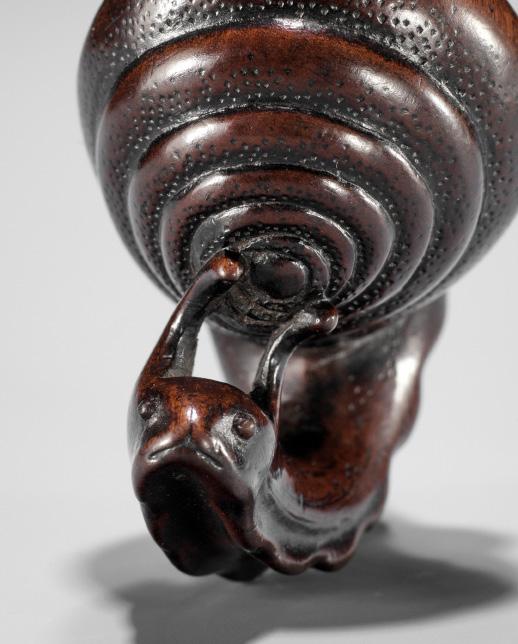





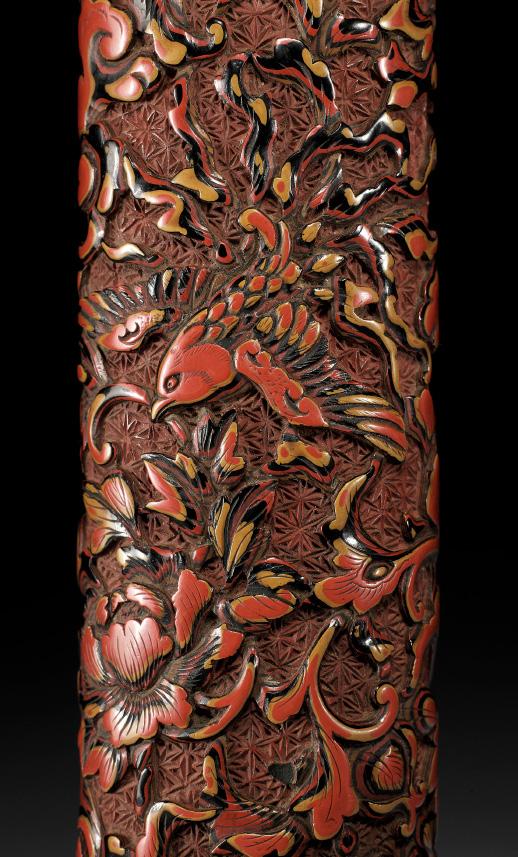




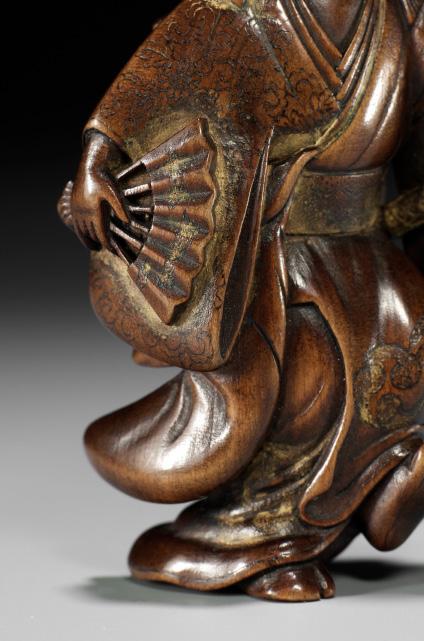


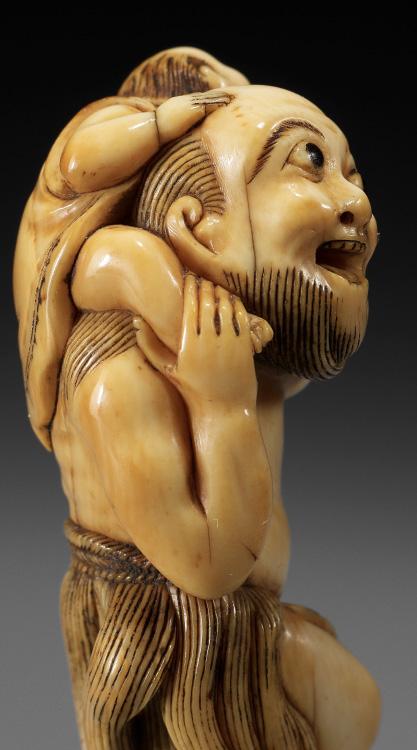





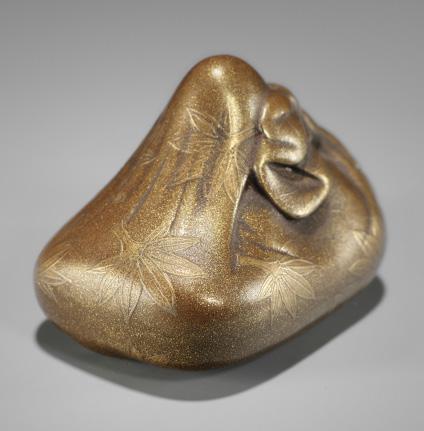



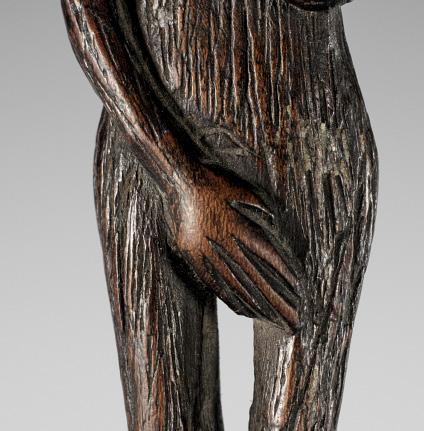


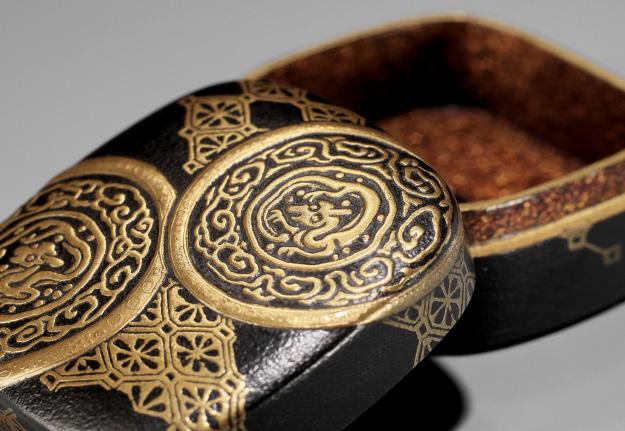



1010 VIENNA AUSTRIA STERNGASSE 13 www.zacke.at Tel +43 1 532 04 52 . Fax +20 E-mail office@zacke.at




























 By Ogawasara Issai, signed Issai 一齋 Japan, Wakayama, 18th century, Edo period (1615-1868)
By Ogawasara Issai, signed Issai 一齋 Japan, Wakayama, 18th century, Edo period (1615-1868)


















 By Gyokusen, signed Gyokusen 玉仙 Japan, 18th to early 19th century, Edo period (1615-1868)
By Gyokusen, signed Gyokusen 玉仙 Japan, 18th to early 19th century, Edo period (1615-1868)














































 By Issai, signed Issai 一哉 Japan, 19th century, Edo period (1615-1868)
By Issai, signed Issai 一哉 Japan, 19th century, Edo period (1615-1868)



 By Shuzan, signed Shuzan 周山 Japan, late 18th to early 19th century, Edo period (1615-1868)
By Shuzan, signed Shuzan 周山 Japan, late 18th to early 19th century, Edo period (1615-1868)














 By Gyokuzan, signed Gyokuzan 玉山 Japan, Kyoto, late 18th century, Edo period (1615-1868)
By Gyokuzan, signed Gyokuzan 玉山 Japan, Kyoto, late 18th century, Edo period (1615-1868)




 By Izumiya Tomotada, signed Tomotada 友忠 Japan, Kyoto, 18th century, Edo period (1615-1868)
By Izumiya Tomotada, signed Tomotada 友忠 Japan, Kyoto, 18th century, Edo period (1615-1868)










 By Masatomo, signed Masatomo 正友 Japan, Kyoto, c. 1800, Edo period (1615-1868)
By Masatomo, signed Masatomo 正友 Japan, Kyoto, c. 1800, Edo period (1615-1868)








 By Yamaguchi Okatomo, signed Okatomo Japan, Kyoto, late 18th century, Edo period (1615-1868)
By Yamaguchi Okatomo, signed Okatomo Japan, Kyoto, late 18th century, Edo period (1615-1868)


















 By Yamaguchi Okatomo, signed Okatomo 岡友 Japan, Kyoto, late 18th to early 19th century, Edo period (1615-1868)
By Yamaguchi Okatomo, signed Okatomo 岡友 Japan, Kyoto, late 18th to early 19th century, Edo period (1615-1868)















 By Yamaguchi Okatori, signed Okatori 岡隹 Japan, Kyoto, early 19th century, Edo period (1615-1868)
By Yamaguchi Okatori, signed Okatori 岡隹 Japan, Kyoto, early 19th century, Edo period (1615-1868)




 By Kaigyokusai Masatsugu (1813-1892), signed Kaigyoku 懐玉 with seal Masatsugu 正次 Japan, Osaka, second half of 19th century
By Kaigyokusai Masatsugu (1813-1892), signed Kaigyoku 懐玉 with seal Masatsugu 正次 Japan, Osaka, second half of 19th century





 By Dosho,
By Dosho,



 By Hidemasa, signed Hidemasa 秀正 Japan, Osaka, first half of 19th century, Edo period (1615-1868)
By Hidemasa, signed Hidemasa 秀正 Japan, Osaka, first half of 19th century, Edo period (1615-1868)

























 By Naito Toyomasa (1773-1857), signed Toyomasa 豊昌 Japan, Sasayama, Tanba Province, c. 1840, Edo period (1615-1868)
By Naito Toyomasa (1773-1857), signed Toyomasa 豊昌 Japan, Sasayama, Tanba Province, c. 1840, Edo period (1615-1868)










 By Naito Toyomasa (1773-1857), signed Toyomasa 豊昌 Japan, Sasayama, Tanba Province, c. 1840, Edo period (1615-1868)
By Naito Toyomasa (1773-1857), signed Toyomasa 豊昌 Japan, Sasayama, Tanba Province, c. 1840, Edo period (1615-1868)

 By Toyoshima, signed Toyoshima 豊嶋 Japan, Sasayama, Tanba Province, late 19th century
By Toyoshima, signed Toyoshima 豊嶋 Japan, Sasayama, Tanba Province, late 19th century

 By Naito Toyomasa (1773-1857), signed Toyomasa 豊昌 Japan, Sasayama, Tanba Province, 19th century, Edo period (1615-1868)
By Naito Toyomasa (1773-1857), signed Toyomasa 豊昌 Japan, Sasayama, Tanba Province, 19th century, Edo period (1615-1868)













 By Masasada (Masakazu), signed Masakazu 昌貞 Japan, probably Tanba, early 19th century, Edo period (1615-1868)
By Masasada (Masakazu), signed Masakazu 昌貞 Japan, probably Tanba, early 19th century, Edo period (1615-1868)








 By Masatoshi, signed Masatoshi 正利 Japan, Nagoya, first half of 19th century, Edo period (1615-1868)
By Masatoshi, signed Masatoshi 正利 Japan, Nagoya, first half of 19th century, Edo period (1615-1868)


 By Masakazu, signed Masakazu 正一 Japan, Nagoya, first half of 19th century, Edo period (1615-1868)
By Masakazu, signed Masakazu 正一 Japan, Nagoya, first half of 19th century, Edo period (1615-1868)


















 By Tametaka, signed Tametaka 爲隆 with kakihan Japan, Nagoya, late 18th century, Edo period (1615-1868)
By Tametaka, signed Tametaka 爲隆 with kakihan Japan, Nagoya, late 18th century, Edo period (1615-1868)


















 By Ichiyu, signed Ichiyu 一友 Japan, Nagoya, 19th century, Edo period (1615-1868)
By Ichiyu, signed Ichiyu 一友 Japan, Nagoya, 19th century, Edo period (1615-1868)





 By Masamaru, signed Masamaru 正丸 Japan, Nagoya, c. 1800, Edo period (1615-1868)
By Masamaru, signed Masamaru 正丸 Japan, Nagoya, c. 1800, Edo period (1615-1868)



 By Masayasu, signed Masayasu 正保 to 刀 Japan, Nagoya, 19th century, Edo period (1615-1868)
By Masayasu, signed Masayasu 正保 to 刀 Japan, Nagoya, 19th century, Edo period (1615-1868)







 By Ittan, signed Ittan 一旦 with kakihan Japan, Nagoya, c. 1840, Edo period (1615-1868)
By Ittan, signed Ittan 一旦 with kakihan Japan, Nagoya, c. 1840, Edo period (1615-1868)




 By Yoshihisa, signed Yoshihisa 義久 Japan, Nagoya, early 19th century, Edo period (1615-1868)
By Yoshihisa, signed Yoshihisa 義久 Japan, Nagoya, early 19th century, Edo period (1615-1868)








 By Ittan, signed Ittan sanjin 一旦山人 Japan, Nagoya, c. 1865
By Ittan, signed Ittan sanjin 一旦山人 Japan, Nagoya, c. 1865








 By Ittan, signed Ittan 一旦 with kakihan Japan, Nagoya, c. 1850, Edo period (1615-1868)
By Ittan, signed Ittan 一旦 with kakihan Japan, Nagoya, c. 1850, Edo period (1615-1868)


 By Ikkan, signed Ikkan 一貫 Japan, Nagoya, mid-19th century, Edo period (1615-1868)
By Ikkan, signed Ikkan 一貫 Japan, Nagoya, mid-19th century, Edo period (1615-1868)






 By Ikkan, signed Ikkan 一貫 Japan, Nagoya, early 19th century, Edo period (1615-1868)
By Ikkan, signed Ikkan 一貫 Japan, Nagoya, early 19th century, Edo period (1615-1868)














 By Kano Tomokazu, signed Tomokazu 友一 Japan, Gifu, c. 1820, Edo period (1615-1868)
By Kano Tomokazu, signed Tomokazu 友一 Japan, Gifu, c. 1820, Edo period (1615-1868)












 By Ikko, signed Ikko 一光 Japan, late 19th century
By Ikko, signed Ikko 一光 Japan, late 19th century











 By Masakazu, signed Masakazu 正一 Japan, Gifu or Nagoya, c. 1860
By Masakazu, signed Masakazu 正一 Japan, Gifu or Nagoya, c. 1860


















 By Arima Tomonobu, signed Tomonobu 友信 Japan, Nagoya, 19th century, Edo period (1615-1868)
By Arima Tomonobu, signed Tomonobu 友信 Japan, Nagoya, 19th century, Edo period (1615-1868)





 By Tadakuni, signed Tadakuni 忠國 Japan, Nagoya, mid-19th century, Edo period (1615-1868)
By Tadakuni, signed Tadakuni 忠國 Japan, Nagoya, mid-19th century, Edo period (1615-1868)

 By Tadakuni, signed Tadakuni 忠國 Japan, Nagoya, mid-19th century, Edo period (1615-1868)
By Tadakuni, signed Tadakuni 忠國 Japan, Nagoya, mid-19th century, Edo period (1615-1868)





 By Shigemasa,
By Shigemasa,




 By Gyokuryusai Tomoshige, signed Tomoshige 友重 Japan, Nagoya, c. 1820-1850, Edo period (1615-1868)
By Gyokuryusai Tomoshige, signed Tomoshige 友重 Japan, Nagoya, c. 1820-1850, Edo period (1615-1868)


 By Yasutada, signed Yasutada 安忠 Japan,
By Yasutada, signed Yasutada 安忠 Japan,


 By Sari, signed Sari 左里 Japan, Iwashiro, early 19th century, Edo period (1615-1868)
By Sari, signed Sari 左里 Japan, Iwashiro, early 19th century, Edo period (1615-1868)








 By Hideharu, signed Hideharu 秀晴 Japan, Nagoya, c. 1880
By Hideharu, signed Hideharu 秀晴 Japan, Nagoya, c. 1880

 By Hideharu, signed Hideharu 秀晴 Japan, Nagoya, mid to late 19th century
By Hideharu, signed Hideharu 秀晴 Japan, Nagoya, mid to late 19th century



 By Hogen Tadashige, signed Hogen Tadashige 法眼忠茂 Japan, Nagoya, 19th century, Edo period (1615-1868)
By Hogen Tadashige, signed Hogen Tadashige 法眼忠茂 Japan, Nagoya, 19th century, Edo period (1615-1868)





 By Tadakazu (Chuichi), signed Tadakazu 忠一 Japan, 19th century
By Tadakazu (Chuichi), signed Tadakazu 忠一 Japan, 19th century







 By Ransen, signed Ransen 蘭川 Japan, Kyoto, first half of 19th century, Edo period (1615-1868)
By Ransen, signed Ransen 蘭川 Japan, Kyoto, first half of 19th century, Edo period (1615-1868)








 By Nobukazu, signed Nobukazu 信一 to 刀 Japan, 19th century, Edo period (1615-1868)
By Nobukazu, signed Nobukazu 信一 to 刀 Japan, 19th century, Edo period (1615-1868)


 By Masatoshi, signed Masatoshi 正利 Japan, Nagoya, mid-19th century, Edo period (1615-1868)
By Masatoshi, signed Masatoshi 正利 Japan, Nagoya, mid-19th century, Edo period (1615-1868)












 By Chikuunsai,
By Chikuunsai,


 By Miyake Masanao II (1848-1922), signed Masanao 正直 Japan, Yamada, Ise Province, late 19th century
By Miyake Masanao II (1848-1922), signed Masanao 正直 Japan, Yamada, Ise Province, late 19th century


 By Suzuki Masakatsu, signed Masakatsu 正勝 with kakihan Japan, Yamada, Ise Province, mid to late 19th century, Edo period (1615-1868)
By Suzuki Masakatsu, signed Masakatsu 正勝 with kakihan Japan, Yamada, Ise Province, mid to late 19th century, Edo period (1615-1868)


















 By Kinichi Kawase (born 1926), signed Kinsui 欽 水 Japan, Mie prefecture, second half of 20th century
By Kinichi Kawase (born 1926), signed Kinsui 欽 水 Japan, Mie prefecture, second half of 20th century








 By Kokei, signed Kokei 虎溪 Japan, Kuwana, Ise Province, 19th century, Edo period (1615-1868)
By Kokei, signed Kokei 虎溪 Japan, Kuwana, Ise Province, 19th century, Edo period (1615-1868)










 By Tanaka Juntoku Minko (1735-1816), signed Minko 岷江 with kakihan
By Tanaka Juntoku Minko (1735-1816), signed Minko 岷江 with kakihan




 By Haritsu, signed Haritsu 破笠 Japan, 18th-19th century, Edo period (1615-1868)
By Haritsu, signed Haritsu 破笠 Japan, 18th-19th century, Edo period (1615-1868)





 By Kokei, signed Kokei 虎溪 Japan, Kuwana, Ise Province, c. 1800, Edo period (1615-1868)
By Kokei, signed Kokei 虎溪 Japan, Kuwana, Ise Province, c. 1800, Edo period (1615-1868)






 By Shigeyoshi, signed Shigeyoshi 重敬 to 刀 Japan, 19th century, Edo period (1615-1868)
By Shigeyoshi, signed Shigeyoshi 重敬 to 刀 Japan, 19th century, Edo period (1615-1868)






 By Kano Tomokazu, signed Tomokazu 友一 Japan, Gifu, 19th century, Edo period (1615-1868)
By Kano Tomokazu, signed Tomokazu 友一 Japan, Gifu, 19th century, Edo period (1615-1868)







 By Harumitsu (Shunko), signed Harumitsu 春光 Japan, Yamada, Ise
By Harumitsu (Shunko), signed Harumitsu 春光 Japan, Yamada, Ise





 By Hidari Issan, signed Hidari Issan 左一山 Japan, Iwashiro, c. 1840, Edo period (1615-1868)
By Hidari Issan, signed Hidari Issan 左一山 Japan, Iwashiro, c. 1840, Edo period (1615-1868)













 By Seimin, signed Seimin 晴民 Japan, Iwashiro Province, mid-19th century, Edo period (1615-1868)
By Seimin, signed Seimin 晴民 Japan, Iwashiro Province, mid-19th century, Edo period (1615-1868)





 By Suketada, signed Suketada
By Suketada, signed Suketada













 By Tachikawa Takusai (1817-1887), signed Takusai 啄齋 Japan, Suwa, Shinano Province, mid to late 19th century
By Tachikawa Takusai (1817-1887), signed Takusai 啄齋 Japan, Suwa, Shinano Province, mid to late 19th century


























 By Miwa Katsusuke, signed Miwa Katsusuke 三輪勝助 with kakihan Japan, Edo (Tokyo), c. 1800, Edo period (1615-1868)
By Miwa Katsusuke, signed Miwa Katsusuke 三輪勝助 with kakihan Japan, Edo (Tokyo), c. 1800, Edo period (1615-1868)



 By Jobun, signed Jobun 如文 Japan, Edo (Tokyo), c. 1780, Edo period (1615-1868)
By Jobun, signed Jobun 如文 Japan, Edo (Tokyo), c. 1780, Edo period (1615-1868)




 By Genryosai Minkoku I, signed Genryosai 玄了齋 Japan, Edo (Tokyo), 18th century, Edo period (1615-1868)
By Genryosai Minkoku I, signed Genryosai 玄了齋 Japan, Edo (Tokyo), 18th century, Edo period (1615-1868)




















 By Hokyudo Itsumin (active
By Hokyudo Itsumin (active

 By Hoshinsai,
By Hoshinsai,















 By Mugai, signed Mugai 夢外 Japan, late 18th to early 19th century, Edo period (1615-1868)
By Mugai, signed Mugai 夢外 Japan, late 18th to early 19th century, Edo period (1615-1868)

 By Shoko Sugonoya, signed Shoko 尚古 Japan, Hida-Takayama, second half of 19th century
By Shoko Sugonoya, signed Shoko 尚古 Japan, Hida-Takayama, second half of 19th century




 By Masatami (Shomin), signed Masatami 正民 Japan, Tokyo, mid to late 19th century
By Masatami (Shomin), signed Masatami 正民 Japan, Tokyo, mid to late 19th century



 By Shuyusai Minkoku (Minkoku III), signed Minkoku 民谷 Japan, Edo (Tokyo), mid-19th century, Edo period (1615-1868)
By Shuyusai Minkoku (Minkoku III), signed Minkoku 民谷 Japan, Edo (Tokyo), mid-19th century, Edo period (1615-1868)


 By Ikkosai Toun, signed Ikkosai 一光齋 Japan, Edo (Tokyo), mid-19th century, Edo period (1615-1868)
By Ikkosai Toun, signed Ikkosai 一光齋 Japan, Edo (Tokyo), mid-19th century, Edo period (1615-1868)


 By Ikkosai Saito Itaro, signed Ikkosai 一光斎 Japan, Edo (Tokyo), mid-19th century, Edo period (1615-1868)
By Ikkosai Saito Itaro, signed Ikkosai 一光斎 Japan, Edo (Tokyo), mid-19th century, Edo period (1615-1868)


 By Ikkosai Saito Itaro, signed Ikkosai 一光斎 Japan, Edo (Tokyo), mid-19th century, Edo period (1615-1868)
By Ikkosai Saito Itaro, signed Ikkosai 一光斎 Japan, Edo (Tokyo), mid-19th century, Edo period (1615-1868)




 By Gyokkosai, signed Gyokkosai 玉光齋 Japan, Edo (Tokyo), mid-19th century, Edo period (1615-1868)
By Gyokkosai, signed Gyokkosai 玉光齋 Japan, Edo (Tokyo), mid-19th century, Edo period (1615-1868)

 By Ono Ryoji, signed Ryoji 凌次 Japan,
By Ono Ryoji, signed Ryoji 凌次 Japan,
 By Ryukosai Jugyoku, signed Jugyoku 壽玉 Japan, Edo (Tokyo), mid-19th century, Edo period (1615-1868)
By Ryukosai Jugyoku, signed Jugyoku 壽玉 Japan, Edo (Tokyo), mid-19th century, Edo period (1615-1868)










 By Gyokusai, signed Gyokusai 玉哉 Japan, Tokyo, c. 1880
By Gyokusai, signed Gyokusai 玉哉 Japan, Tokyo, c. 1880






 By Ono Ryomin, signed Ryomin 陵民 Japan, Edo/Tokyo, second half of 19th century
By Ono Ryomin, signed Ryomin 陵民 Japan, Edo/Tokyo, second half of 19th century















 By Shounsai Joryu, signed Shounsai 升雲齋 Japan, Edo (Tokyo), early 19th century, Edo period (1868-1912)
By Shounsai Joryu, signed Shounsai 升雲齋 Japan, Edo (Tokyo), early 19th century, Edo period (1868-1912)


 By Jujo (Toshinori), signed Jujo 壽乗 and kakihan Japan, Tokyo, late 19th century
By Jujo (Toshinori), signed Jujo 壽乗 and kakihan Japan, Tokyo, late 19th century



 By Ryukosai Jugyoku, signed Jugyoku 壽玉 Japan, Edo (Tokyo), first half of 19th century, Edo period (1615-1868)
By Ryukosai Jugyoku, signed Jugyoku 壽玉 Japan, Edo (Tokyo), first half of 19th century, Edo period (1615-1868)


 By Ryukosai Jugyoku, signed Jugyoku 壽玉 with kakihan Japan, Edo (Tokyo), mid-19th century, Edo period (1615-1868)
By Ryukosai Jugyoku, signed Jugyoku 壽玉 with kakihan Japan, Edo (Tokyo), mid-19th century, Edo period (1615-1868)










 By Gyokuzan, signed Gyokuzan 玉山 Japan, Edo (Tokyo), mid-19th century, Edo period (1615-1868)
By Gyokuzan, signed Gyokuzan 玉山 Japan, Edo (Tokyo), mid-19th century, Edo period (1615-1868)












 By Suzuki Tokoku (1846-1913), signed Tokoku 東谷 with seal Bairyu
By Suzuki Tokoku (1846-1913), signed Tokoku 東谷 with seal Bairyu


 By Ouchi Gyokuso
By Ouchi Gyokuso



 By Sozan, signed Sozan 宗山 Japan, Tokyo, late 19th to early 20th century
By Sozan, signed Sozan 宗山 Japan, Tokyo, late 19th to early 20th century


 By Ouchi Gyokuso (1879-1944), signed Gyokuso玉藻 to 刀 Japan, Tokyo, early 20th century
By Ouchi Gyokuso (1879-1944), signed Gyokuso玉藻 to 刀 Japan, Tokyo, early 20th century



 By
By






























 By Ko, sealed Ko 光
By Ko, sealed Ko 光













 By Ishikawa Rensai, signed Rensai 蓮齋 Japan, Tokyo, Asakusa District, second half of 19th century
By Ishikawa Rensai, signed Rensai 蓮齋 Japan, Tokyo, Asakusa District, second half of 19th century


 By Hoshunsai Masayuki, signed Masayuki 正之 with kakihan Japan, Edo (Tokyo), mid-19th century, Edo period (1615-1868)
By Hoshunsai Masayuki, signed Masayuki 正之 with kakihan Japan, Edo (Tokyo), mid-19th century, Edo period (1615-1868)

 By Hoshunsai Masayuki, signed Masayuki 正之 with kakihan Japan, Edo (Tokyo), c. 1860
By Hoshunsai Masayuki, signed Masayuki 正之 with kakihan Japan, Edo (Tokyo), c. 1860




 By Hoshunsai Masayuki, signed with the artist’s kakihan Japan, Tokyo, late 19th century
By Hoshunsai Masayuki, signed with the artist’s kakihan Japan, Tokyo, late 19th century

























 By Kokeisai Sansho (1871-1936), signed
By Kokeisai Sansho (1871-1936), signed







 By Chikusai,
Chikusai
By Chikusai,
Chikusai



 By Ikko, signed Ikko 一光 Japan, 19th century
By Ikko, signed Ikko 一光 Japan, 19th century

 By Yamaguchi Okatomo, signed Okatomo 岡友 Japan, Kyoto, late 18th to early 19th century, Edo period (1615-1868)
By Yamaguchi Okatomo, signed Okatomo 岡友 Japan, Kyoto, late 18th to early 19th century, Edo period (1615-1868)












 By Kano Tessai (1845-1925), signed Tessai 銕哉 to 刀 and kakihan Japan, Nara, late 19th to early 20th century
By Kano Tessai (1845-1925), signed Tessai 銕哉 to 刀 and kakihan Japan, Nara, late 19th to early 20th century



 By Kano Tessai (1845-1925), signed signed Tessai 銕哉 to 刀 with kakihan
By Kano Tessai (1845-1925), signed signed Tessai 銕哉 to 刀 with kakihan








 By Tanaka Yozei (Yosei), signed Tanaka Yozei 田中陽成 with seal Tanaka 田中 Japan, dated
By Tanaka Yozei (Yosei), signed Tanaka Yozei 田中陽成 with seal Tanaka 田中 Japan, dated










 By Matsuki Hokei, signed Hokei 宝桂 Japan, Tokyo, late 19th century, Meiji period (1868-1912)
By Matsuki Hokei, signed Hokei 宝桂 Japan, Tokyo, late 19th century, Meiji period (1868-1912)




 By Joko, signed Joko 如光 Japan, Tokyo, second half of 19th century
By Joko, signed Joko 如光 Japan, Tokyo, second half of 19th century



 By Soshi, signed Soshi 藻之 to 刀 Japan, Tokyo, late 19th to early 20th century
By Soshi, signed Soshi 藻之 to 刀 Japan, Tokyo, late 19th to early 20th century





































































 By Ikeshima Yoshinori,
Ikeshima Yoshinori 池嶌義矩 with kakihan Japan, 19th century, Edo period (1615-1868)
By Ikeshima Yoshinori,
Ikeshima Yoshinori 池嶌義矩 with kakihan Japan, 19th century, Edo period (1615-1868)

 By
By


























 By Masakazu, signed Masakazu 政一 Japan, 19th century, Edo period (1615-1868)
By Masakazu, signed Masakazu 政一 Japan, 19th century, Edo period (1615-1868)


























 By Kajikawa Kyujiro, signed Kajikawa Kyujiro 梶川久次郎 with kakihan Japan, dated 1647, Edo period (1615-1868)
By Kajikawa Kyujiro, signed Kajikawa Kyujiro 梶川久次郎 with kakihan Japan, dated 1647, Edo period (1615-1868)











 By Zonsei, signed Zonsei 村靖 zo 造 Japan, 19th century, Edo period (1615-1868)
By Zonsei, signed Zonsei 村靖 zo 造 Japan, 19th century, Edo period (1615-1868)



 By Tatsuke Kokosai II, signed Tatsuke Kokosai 田附交々齋 Japan, 18th-19th century, Edo period (1615-1868)
By Tatsuke Kokosai II, signed Tatsuke Kokosai 田附交々齋 Japan, 18th-19th century, Edo period (1615-1868)

















 By Shiomi Masanari (1647-1722), signed Shiomi Masanari 鹽見政誠
By Shiomi Masanari (1647-1722), signed Shiomi Masanari 鹽見政誠


























 By Hara Yoyusai
By Hara Yoyusai


































 By Tosai, signed Tosai 匋斎 saku 作 with two seals Japan, Tokyo, Asakusa, late 19th century
By Tosai, signed Tosai 匋斎 saku 作 with two seals Japan, Tokyo, Asakusa, late 19th century






 By Isshosai Hakumin, sealed Hakumin 方印 Japan, Tokyo, Asakusa District, second half of 19th century
By Isshosai Hakumin, sealed Hakumin 方印 Japan, Tokyo, Asakusa District, second half of 19th century



























































































































































































































































 365 Tesshin 鉄真
366 Sen’yu 泉友
367 Ro 犂
368 Seisei 青々
369 Taisai 泰哉
365 Tesshin 鉄真
366 Sen’yu 泉友
367 Ro 犂
368 Seisei 青々
369 Taisai 泰哉
































